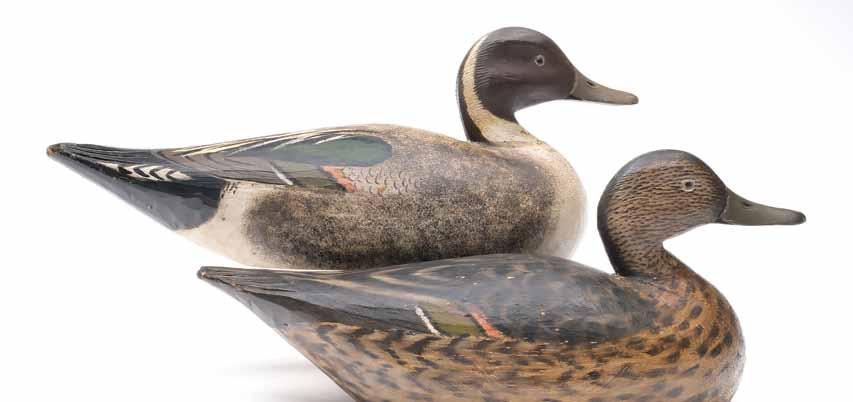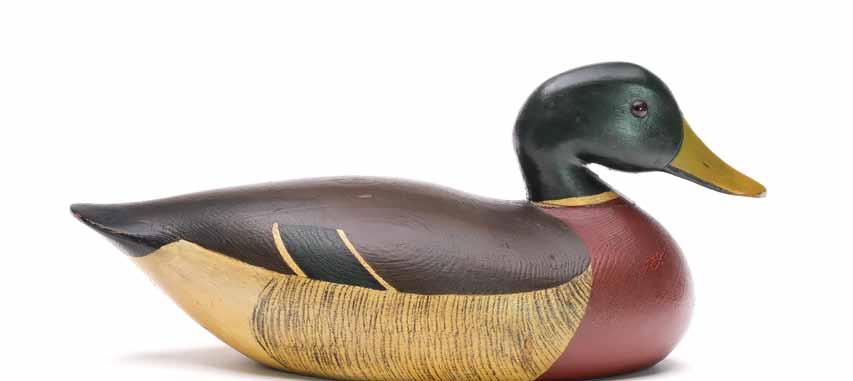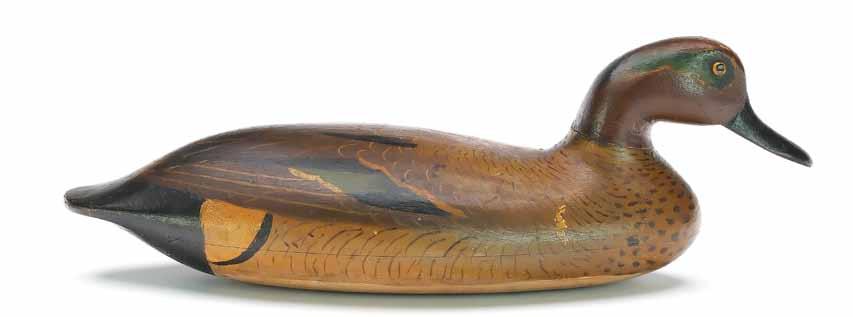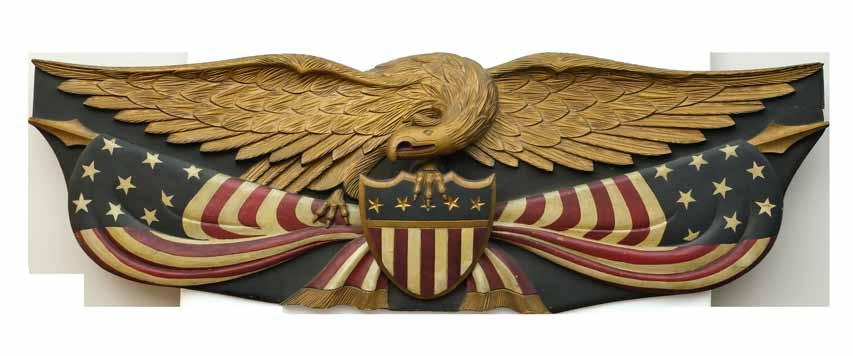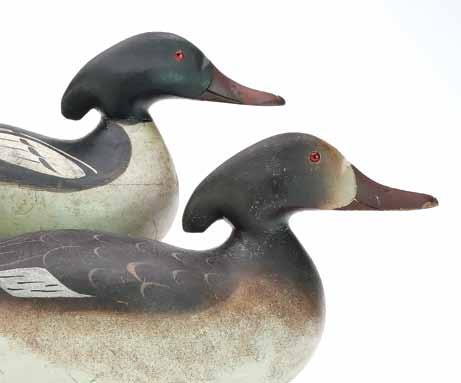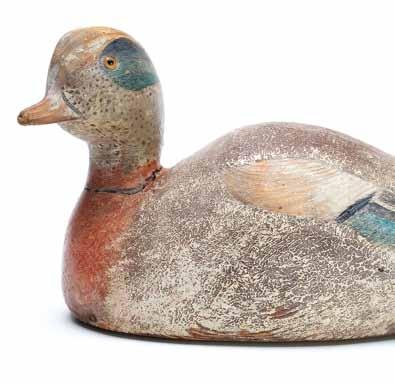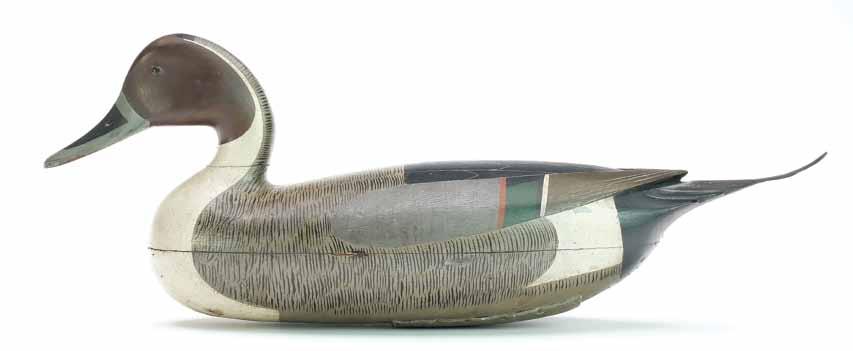Decoys and Sporting Art at Auction
November 15 & 16, 2025



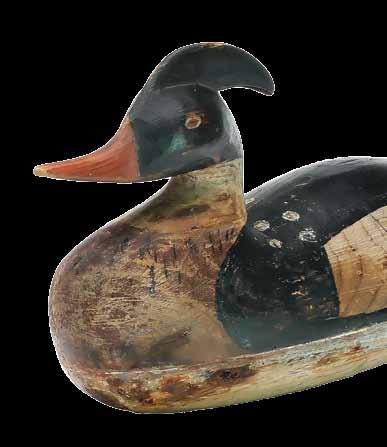
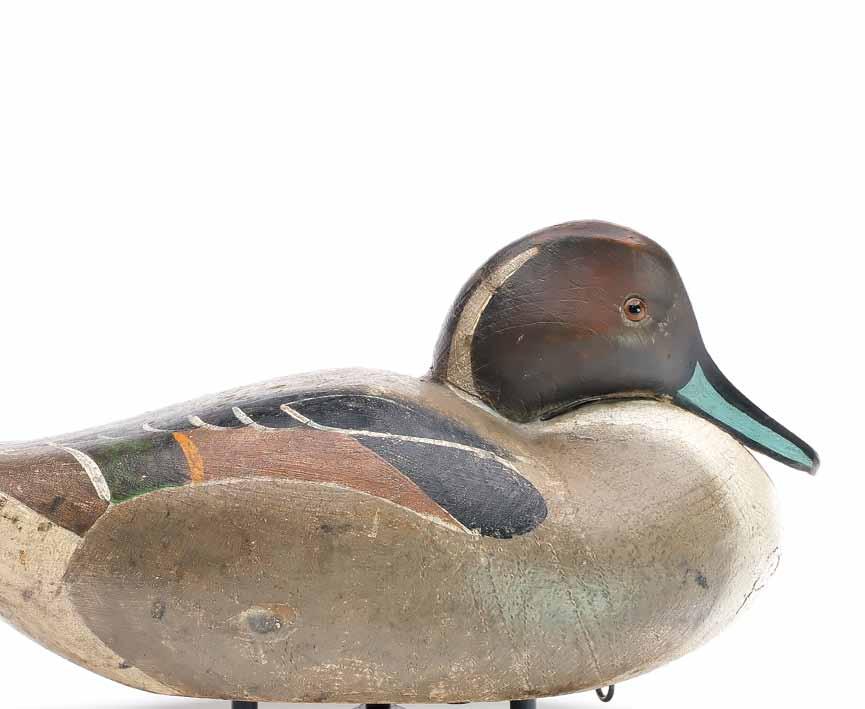



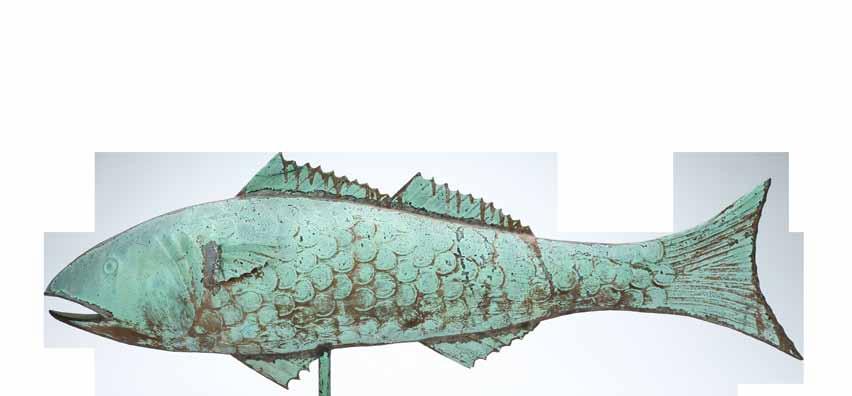
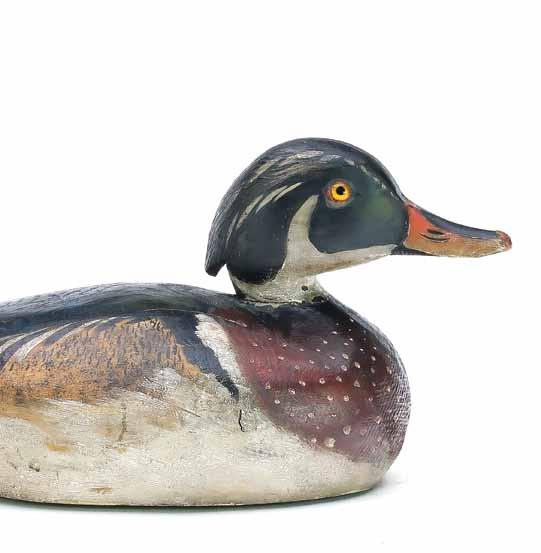
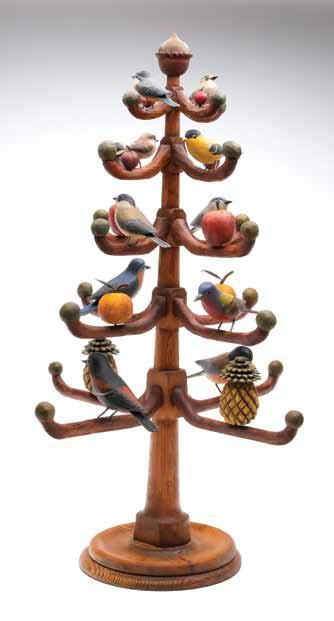
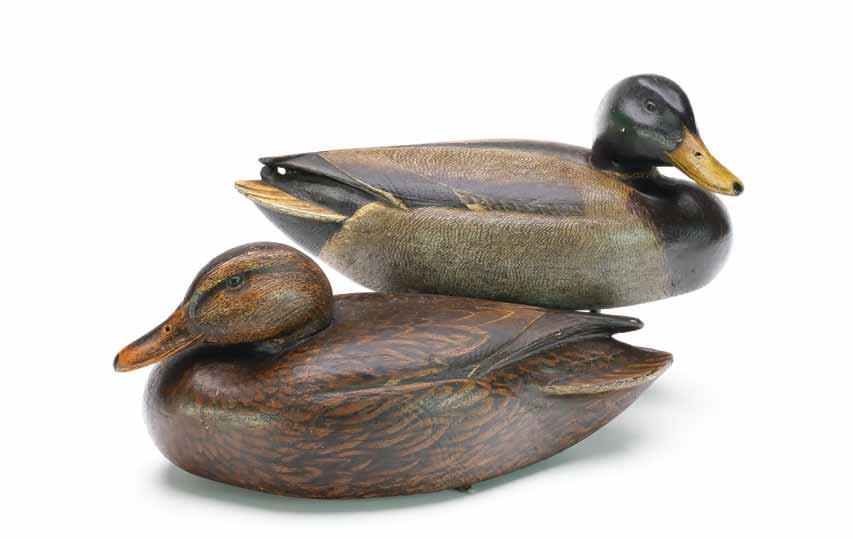
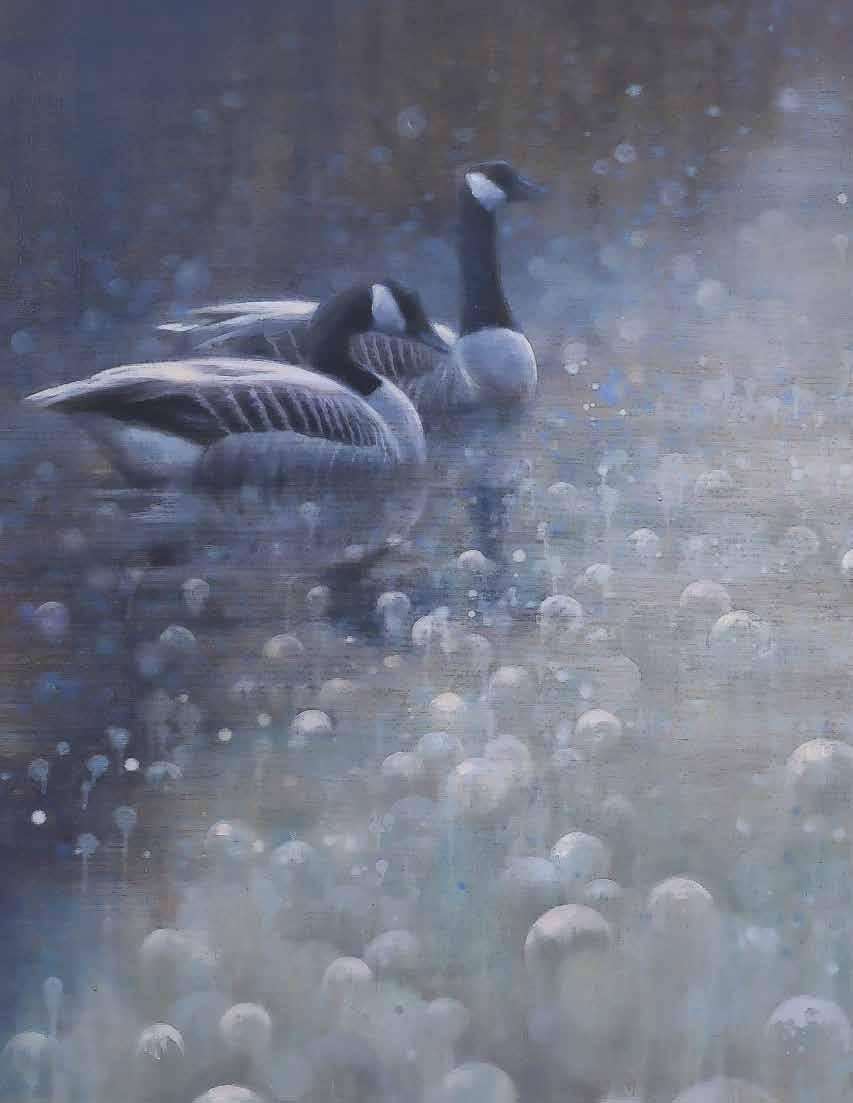

Decoys and Sporting Art at Auction
November 15 & 16, 2025













The live auction will be held at the
The Country School
716 Goldsborough St
Easton, Maryland 21601
Held in Partnership with the Easton Waterfowl Festival
Friday, November 14, 2025
Cocktail Reception and Preview
4:00 PM - 7:00 PM
Saturday, November 15, 2025
Preview 8:00 AM - 9:30 AM
Auction 10:00 AM
Sunday, November 16, 2025
Preview 8:00 AM - 9:30 AM
Auction 10:00 AM
For questions during the auction call 410-745-0485
If you are interested in viewing a particular piece at the office, please call to be sure it will be available there at the time you plan to visit. We may also be in your area, and so a private viewing may be available. Please contact us for our schedule.
Catalog $45. Out of Country $70
Absentee, Phone & Online Bidding accepted call 410-745-0485 for arrangements
For free decoy appraisal contact:
Jon Deeter | jdeeter@guyetteanddeeter.com | 440-610-1768
Zac Cote | zcote@guyetteanddeeter.com | 207-321-8091
Cooper Rossner | cooper@guyetteanddeeter.com | 609-560-8028
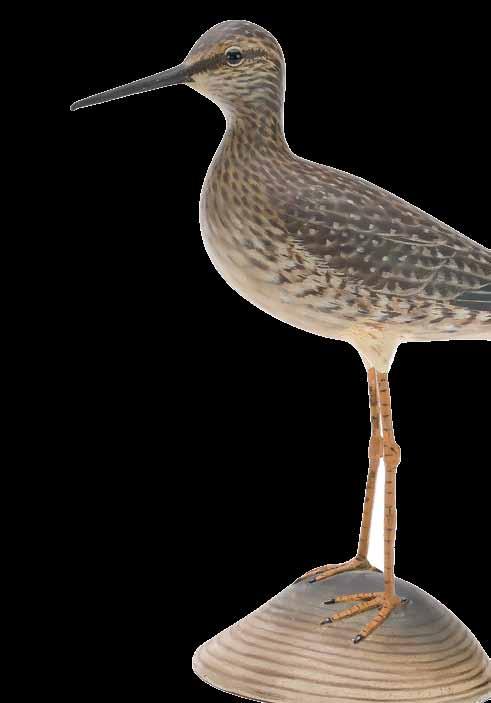
■ GUARANTEE - We have made a concerted effort to accurately catalog and describe the property to be sold. The decoys and paintings have guaranteed condition reports. Should the need arise, the auctioneer reserves the right to make verbal corrections and provide additional information from the block at the time of the sale. Absentee bids will not be executed on items that are found to be other than described in the catalog. Since opinions can differ, particularly in the matter of condition, the auctioneer will be sole judge in the matter of refunds. If we fail to identify a flaw that has an impact on the value, you can return the decoy.
■ DURATION OF GUARANTEE - Requests for a refund on an item purchased through a Guyette and Deeter, Inc. auction must be made within 3 days of the time you take physical possession of your purchases. Whether your items are shipped, delivered, or picked up at the auction site, it is still 3 days from date of possession. This guarantee is null and void if payment is received or mail is postmarked more than 30 days from the sale end date. The guarantee is also null and void if you choose to not take possession of your purchases within the 30 days. If you have paid for your purchases within the 30 days but Guyette and Deeter, Inc is unable to ship your item within the guarantee period, the guarantee will be extended until 3 days from the shipping delivery date. This policy protects our consignors by enabling us to make consignor payments in a timely manner.
■ Under no circumstances will we be responsible for damage to frames or glass, or damage caused by them. Paintings determined to be of high value or large size may be subject to special packaging at the buyers expense. Under no circumstances will we be responsible for damage to fragile decoratives. These items are marked in the catalog with an *.
■ Stands are not included with the decoys or weathervanes unless specified in catalog.
■ All duck calls have condition reports, but are sold “As Is”.
■ Trade Up Program - A limited number of decoys purchased may be paid for by consigning decoys. To participate, please contact our office ahead of time to discuss details.
■ Free appraisals are available with no obligation to consign and any correspondence is strictly confidential.
■ Pick up hours are 1pm – 5pm beginning November 19, or by appointment. Please call ahead so we can have your items ready.
February 26 & 27, 2026
Fine Sporting Arms
Chesapeake Bay Maritime Museum
St. Michaels, Maryland
April 23 & 24, 2026
Decoys, Sporting Art & Americana
The Westin Lombard, Illinois
In conjunction with the North American Vintage Decoy & Sporting Collectibles Show
July 2026
Decoys, Sporting Art & Americana
The Country School
Easton, Maryland


Josh Loewenstein er
F ine Sporting Arms Division Head
J. Wesley Dillon
Fir earms consultant
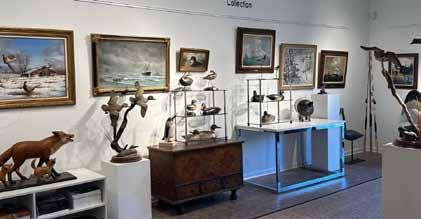
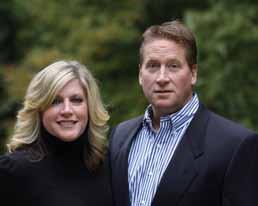
Jon & Leigh Ann Deeter
1210 S Talbot St, Unit A
St. Michaels, Md 21663
Tel: 440-610-1768
jdeeter@guyetteanddeeter.com






Lacey & Zac Cote PO Box 347
Freeport, ME 04032
Tel: 207-321-8091 zcote@guyetteanddeeter.com
Riley Deeter
Business Development
St. Michaels, Maryland
Tel: 440-708-4748 rdeeter@guyetteanddeeter.com
Mike Stevenson
Graphic Designer
St. Michaels, Maryland
Tel: 410-745-0485 michael@guyetteanddeeter.com


Stormi Lind
Auction Manager
St. Michaels, Maryland
Tel: 410-745-0485
auction@guyetteanddeeter.com

Mike Roberts
Shipping
St. Michaels, Maryland
Tel: 410-745-0485
Ed Kenney
Merchandise Manager & Shipping
St. Michaels, Maryland
Tel: 410-745-0485
shipping@guyetteanddeeter.com
Cooper Rossner
Weekly Auction Manager
St. Michaels, Maryland
Tel: 609-560-8028 cooper@guyetteanddeeter.com
Michael Geleta Finance Manager
St. Michaels, Maryland
Tel: 410-745-0485
billing@guyetteanddeeter.com

Noah Christopher Photography
St. Michaels, Maryland
Tel: 410-745-0485 photography@guyetteanddeeter.com

Baylee Saulsbury
Administrative Assistant
St. Michaels, Maryland
Tel: 410-745-0485 admin@guyetteanddeeter.com
Bill Lapointe
Decoy Consultant and Essayist
Swansea, Massachusetts
Tel: 774-644-9426
Weekly Online Auctions Ending Every Thursday Night at 7pm est
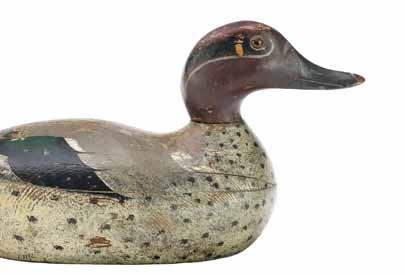
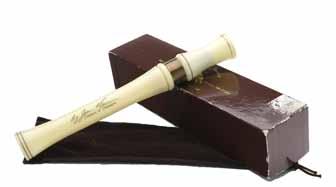
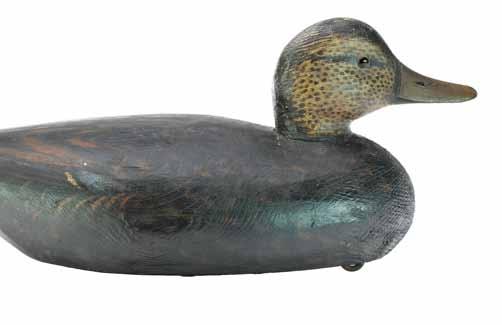
Guaranteed condition reports, multiple photos, quick shipping and quality items. Bid with confidence. calls, Billy Buice.
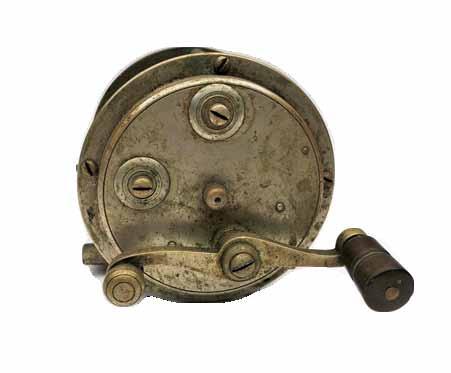
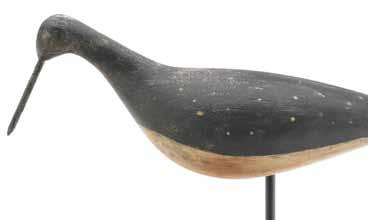

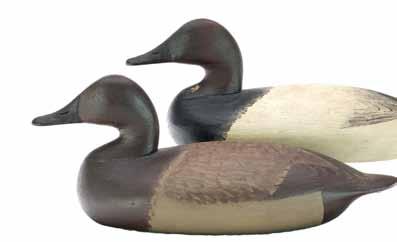

The best way to bid online at Guyette & Deeter auctions with the lowest platform fee availa ble : Sa ve up to 4% using our app!
Simply go to bid.guyetteanddeeter.com or use the QR code
Download the official Guyette & Deeter app:
• Bid on all of our live and online weekly sales.
• Search past sales in a large, ever growing prices realized database.
• Watch live streaming video from all of our live sales.
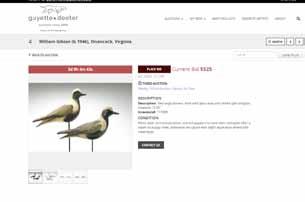
Bid in our live and online weekly auctions.
Search a huge, ever growing database of prices realized.

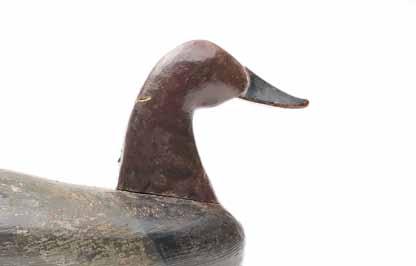


QR

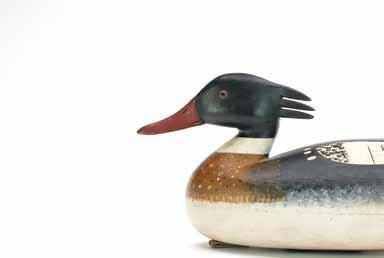
The days are shorter and the air is noticeably more crisp, which means once again, the annual flocks will descend on the charming Eastern Shore town of Easton, Maryland. This year’s schedule of events is as robust as ever, with something for every one of the approximately 20,000 weekend visitors. From the kids fishing derby and retriever demonstrations, to the World Waterfowl Calling Championships and multiple artist pavilions, it is a packed weekend celebrating nature, art, heritage, and of course food. If you have never attended the Easton Waterfowl Festival, we encourage you to do so.
Once again, the Guyette and Deeter team has put together an impressive offering and an outstanding catalog for the annual Waterfowl Weekend auction. Decoys from most regions across North America, excellent folk art, and attractive sporting art in many price points will cross the auction block and find new homes over the two-day sale.
Highlighted by the collections of Deborah and Martin Maloy, Bill and Alice Walsh, Ted and Judy Harmon, Dean and Susan Hyde, and Dr. Michael Shannahan, the opportunities to acquire never before offered or rarely available examples abound. We at Guyette and Deeter are truly honored to be chosen by long-time collectors and their families when the decision to let their beloved flocks fly has been made.
Study and enjoy this offering, highlight your favorites, and do not hesitate to contact us with questions or to set up to bid. Whether you are a new collector or a seasoned veteran of the hobby, we look forward to assisting you in your collecting journey.
See you all in Easton!

Saturday, November 15, 2025
10:00 am
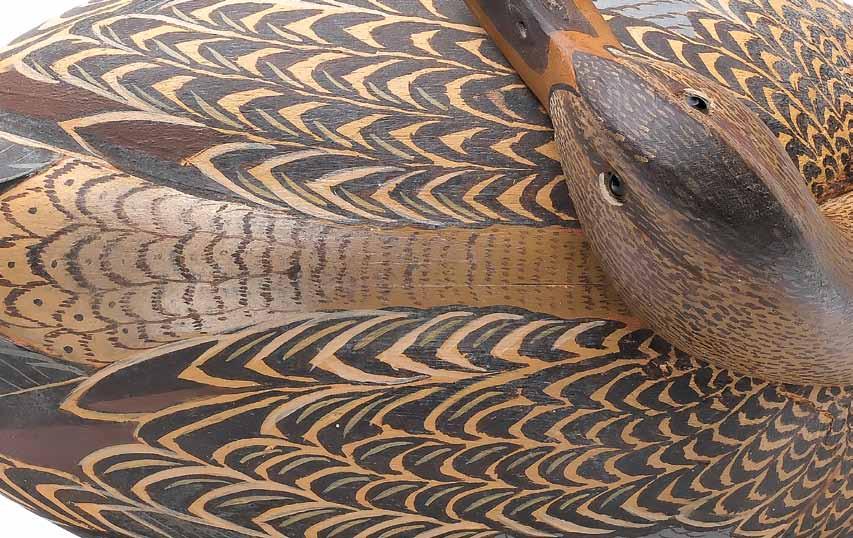
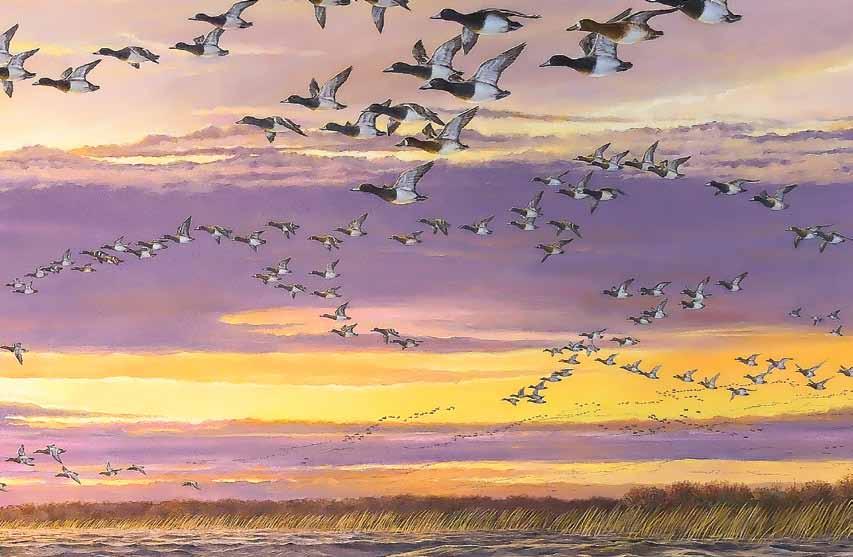
Sunday, November 16
10:00 am
Deborah and Martin Maloy were both born and raised in Brooklyn, New York, and both studied at City College. After Martin completed his master’s degree, he began working as a field service representative—supervising sales of sophisticated electronic products in the early days of the growing electronics industry. He made many trips to Silicon Valley and had the privilege of knowing many of the early pioneers in the field.
Even during his busy working years, Martin nurtured many interests. Not long after they married, the Maloy’s purchased a house in Wayne, New Jersey, where Deborah still resides. Around this time Martin rediscovered one of his greatest joys—model trains. It was at the Montclair Archive that he spotted a train that looked just like the one he had when he was six years old. He bought it, and that marked the beginning of a lifelong passion for collecting.
From early model trains and tin toys to American folk art, antique waterfowl decoys, and fine American art, the Maloy’s traveled to auctions and shows around the US and Europe to acquire new items, visit with other collectors, and learn about interesting pieces. Martin and Deborah were active at the first Mackey auctions in the 1970’s, the Hillman auction in 1996, the McCleery auction in 2000, the Rockefeller auction in 2018, and as recent as the Haid auctions in 2024.
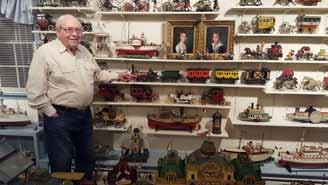

Deborah and Martin, the kindest couple in collecting, spent decades surrounding themselves with things they loved. From a Blue Comet toy replica or Harry V. Shourds curlew, to one of many beloved Labrador retriever rescue dogs, the Maloy’s shared their Wayne, New Jersey home with the things that brought them joy and they were always happy to share that joy with others.
That is why it is with great joy that we offer to the collecting community the lifelong decoy and folk art collection of Martin and Deborah Maloy.
“Martin was a true Renaissance man who had a contagious joie de vivre. He truly enjoyed life and whatever he was doing. He was a man of boundless curiosity, deep kindness, and remarkable skill. He was never bored—and never boring.”
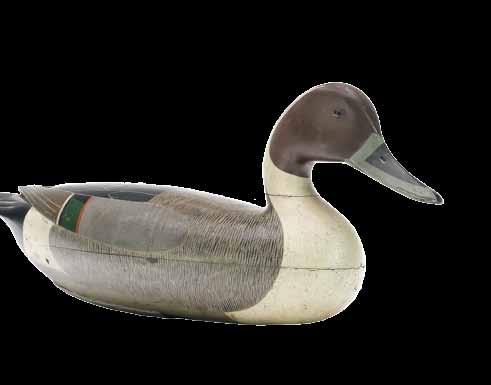
“One of the best parts of our collecting hobbies was the friends we made along the way.”
- Deborah Maloy

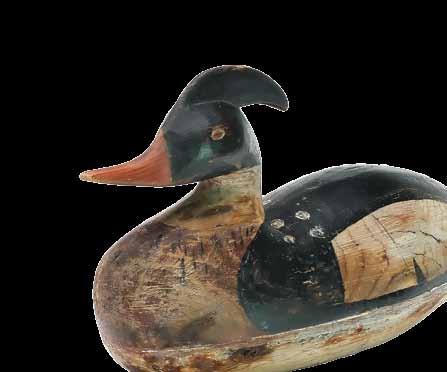
Bill Walsh began his decoy collection when he was eleven years old. He learned to hunt with his father, and often they would hunt in Back Bay. On one trip in 1945, at the end of every day as they were warming up around the stove, Bill would pick up the same decoy to hold in his lap, turning it over and looking at it. After a few days, their guide asked him if he really liked that decoy. When Bill said yes, the guide said he could have it. Later Bill would learn all about the maker of his decoy, Lee Dudley of Knotts Island and the distinctive decoys he had carved.
When Bill and Alice Walsh married, they had a verbal prenuptial agreement. For her part, Alice wanted her grandmother to spend her remaining days with them, she wanted to keep her piano, and she wanted to keep her cat – a big deal since Bill’s mother had a phobia of cats. Bill wanted the ability to go hunting whenever he wanted. Many a Thanksgiving dinner in the Walsh household did not start until the hunting party returned from the day’s activities. And if the outboard would not start or cut out, that meant after they had polled back across the Currituck Sound.
You might reach an incorrect conclusion about Bill knowing he loved hunting. To clarify, there is a story his children tell of when they were with their dad one day in the hunting blind. His boys were young at the time, in the 8-10 range, and not actually contributing to the hunt other than making noise and popping up and down in the blind. The drill was that when Dad saw something, he would say “Keep down” and that meant to be still, quiet, and keep your head down. On this particular day, after saying “Keep down”, a few seconds later Bill said “When I tell you to, look up”. A few seconds later he said “look up” and the boys did. They almost could not see sky for all of the ducks in flight right over the blind. After the crowd had passed, when asked why he did not shoot, Bill replied “Because I wanted to make sure you saw them.”
On another hunting trip, some years later, Bill was getting complaints about how we get up early in the cold, hunt all day, and there are no ducks. That evening after the legal quitting time, the boat was headed back from the blind, Bill cut the motor just before full dark to drift. After a few minutes, the ducks came flying in. “It’s not about what’s in the game bag, son.” Lesson learned.
Bill loved hunting because he loved spending time out in the wild, and appreciated the beauty of waterfowl in all their aspects. Decoy collecting let him continue to follow his passion in the warmer months, and it was something he could do with his Alice. Together they traveled all over the East Coast, meeting collectors, visiting out of the way antique and curio shops, and going to auctions. One

day under the guise of letting their teenage son get some highway driving experience, the whole family loaded into the station wagon and headed out from their home in Virginia Beach across the Chesapeake Bay Bridge Tunnel up to the little town of Crisfield, MD, where the whole family met Steve and Lem Ward.
As time went by Bill and Alice travelled less and spent more time with online auctions. They were both actively involved in the Mid-Atlantic Wildfowl Festival and Bill was its chairman for ten years. Bill was also a Board member of the Back Bay Wildfowl Guild and Curator for the Atlantic Wildfowl Heritage Museum. Their collection of more than 500 decoys was just one aspect of their love for the outdoors and for waterfowl in particular. Their home on the Lynnhaven River had an old galvanized trash can by the river where Bill kept dried corn to put out for his birds. It was a rare day when the shore and nearby river was not filled with Canada geese, mallards, buffleheads and whoever else happened to be coming by looking for a free lunch.
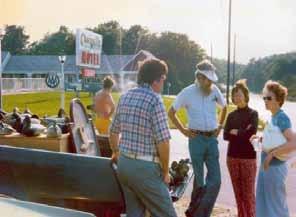
When he was getting started as a collector, Bill used to tell his boys that some of the best deals at the auction happened in the parking lot of the hotel. (Bill Walsh foreground left, Alice Walsh foreground right)
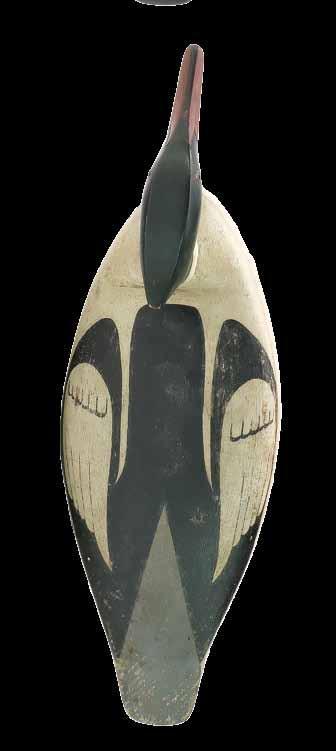
John Dawson is often described as one of the most talented makers of floating sculpture with a painting style strongly influenced b y the Art Nouveau movement. Despite this reputation, he never considered his decoys as anything more than necessary tools of the trade.
He was born in Trenton, NJ and spent all of his life there. His father died when he was very young and he was raised by his mother and two maiden aunts. When he was 23 he married Rose Sandor and the couple raised four daughters. Except for a brief period during WWII, he spent his life employed at the Scammel pottery as a kiln operator. It is felt that it was here that he developed an appreciation for the Art Nouveau style which was in vogue at the time. No one remembers when he actually began to make decoys but family members believe that he started shortly after his marriage. To supplement his income, he began to sell his decoys commercially through local hardware and sporting goods stores for two dollars apiece, which he split with the proprietors. He also trapped and sold the pelts to local furriers.

He loved to hunt and carved decoys for a variety of species but he had a particular passion and appreciation for mergansers. He carved them in a variety of styles and many were designed as “ice ducks” for use when the river and marshes began to freeze. He hunted primarily at the two mouths of Newbold Creek, the Four Shades, and possibly at Duck Island. Although he was an avid outdoorsman throughout his lifetime, he stopped making decoys and discontinued his duck hunting activities when the Army Corps of Engineers filled in some of his favorite meadows along the Delaware River. He then turned his attention to fishing and hunting small game with his favorite L.C. Smith shotgun. In his later life he became an active ecologist.
He was a trend setter in the region yet his stylized mergansers must have seemed radical to his contemporaries. Today they are considered to be among the most highly desirable examples of his work and are proudly included in the most prestigious collections across the country. They are nicely described by Robert Shaw: “Dawson’s mergansers achieved a perfect balance between realism and abstraction in both form and applied paint patterns”
Bruce Williams in “The Great Book of Decoys” states that Dawson’s total production of all decoys was probably 50 or fewer. Dawson never exhibited any of his carvings in his home and, after his death, his wife sold all of his remaining decoys.

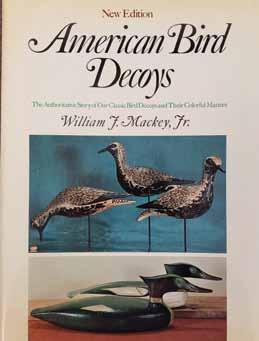
1 John Dawson (1889-1959), Duck Island, New Jersey. Rare rigmate pair of American mergansers. Hollow carved. Mackey collection stamp on underside. Measure 18” long. Original paint with fine detail and minor wear; structurally very good.
Provenance: Exhibited at the 1966 IBM Gallery of Arts and Sciences in New York City. Exhibited at the 1967 St. Paul Arts Center in St. Paul, Minnesota. Mackey collection. Martin and Deborah Maloy collection.
Literature: “American Bird Decoys” by William J. Mackey Jr., page 153, exact decoys pictured. “American Bird Decoys: New Edition” by William J. Mackey Jr., page 95, color plate 5 and front cover, exact decoys pictured. (100,000 - 150,000)
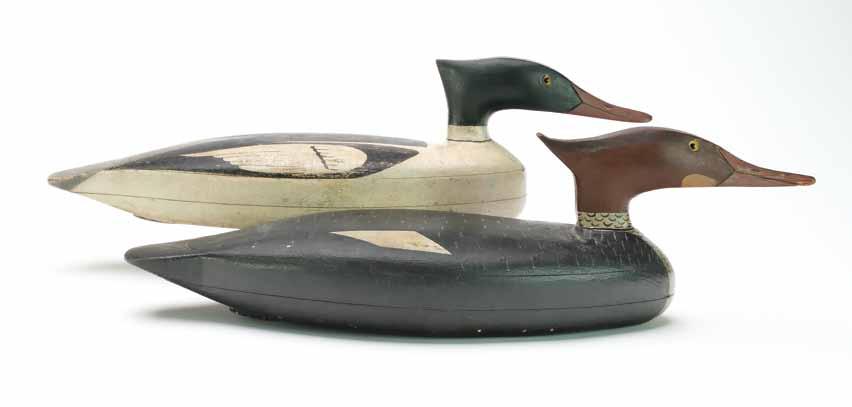
Cape May County, New Jersey

Located at the very southern tip of the New Jersey shore, Cape May County is, in many respects, a study in contrast. The city of Cape May at the mouth of Delaware Bay is famously known as one of the very earliest seaside resort areas in the country, reaching its peak during the Victorian era. The eastern shore of the peninsula, however, is framed with a long stretch of vast coastal marsh, dotted with small islands which, too, experienced early, albeit smaller scale, recreational development. In season, the region was (and is today) noted for its large and varied flights of shorebirds. In fact, Cape May is probably best known for its shorebird decoys. Once the tourists had left for the season, this shoreline and the associated marshland, bays and creeks, offered prime duck shooting for both the locals and any visiting sportsmen. One of these gunners was the unknown creator of the merganser pair being offered here (see note 1) . The anonymous artist did not follow local convention and, utilizing his own unique design concept, probably only created one small rig for his personal use. Other than one other single, worn, example, no other decoys by this maker are known and, apparently, most of his handiwork has been lost to time and the elements.
Compared to the rest of the Jersey shore, only a handful of “name” decoy makers are recognized from the area. Unfortunately, when speaking of Cape May decoys, practically all authors, tend to note that, as a group, they do not measure up to the standards set by Tuckerton and Barnegat makers and most describe them with terms such as “ blocky” (Gosner), “solid, heavy and clumsy” (Mackey), or “large and crude” (Fleckenstein).
Despite this less than stellar view, some truly outstanding decoys did emerge from Cape May, the merganser pair being offered here representing a prime example. With their graceful, hollow carved bodies, snakey, reared back heads and necks topped with wonderfully whimsical crests, they represent a distinct departure from the regional stereotype. From their introduction to the wider decoy community in Quintina Colio’s 1972 book, “American Decoys”, where she describes them as “ An extremely fine pair of red-breasted mergansers from south Jersey ”, the pair have received continuous widespread acclaim. In the inaugural auction of the Mackey collection in 1973, Richard Bourne cataloged them as “ A superb pair of very early hollow carved south Jersey redbreasted mergansers” and an “ - - - outstanding pair of birds (representing) a truly exceptional example of the American decoy as folk art ”. The decoys have always resided in the finest collections, including the extraordinary collection of David and Peggy Rockefeller, where they were described by noted collector Donald C O’Brien as being “ The best of the Rockefeller decoys ”. When that collection was sold in 2018, Christies’ auction house in New York noted that “ While the carver of this unique pair of decoys remains a mystery, these mergansers, with their symmetrical crests and geometric painted patterns, are truly a work of art. This pair lived in a place of honor on the Rockefeller’s dining room sideboard in their Ringing Point home ”. Most recently, the mergansers have been considered one of the prized highlights of the prestigious Martin and Deborah Maloy collection. Guyette and Deeter are proud to offer this incredible pair for auction.
Notes: 1.Recent research by NJ authority Russ Allen suggests that the carver may be a member of the Stites family of Cape May, NJ.
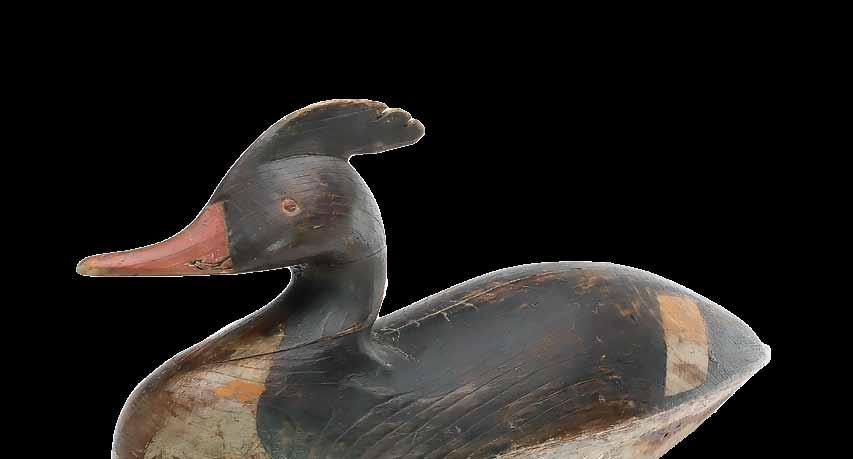
2
Unknown maker, Cape May County, New Jersey, late 19th century. Pair of hollow carved mergansers with carved eyes and thin extended crests. Inlayed lead weights on underside. Mackey collection ink stamp on underside. Measure 14.25” long. Original paint with moderate gunning wear; restoration around body seams where they had separated and were tightened with some filler and touchup added; tight crack through hen’s neck and along hen’s back; neck crack repair on drake.
Provenance: William Mackey, Jr. collection. David and Peggy Rockefeller collection. Martin and Deborah Maloy collection.
Literature: “American Bird Decoys” by William J. Mackey Jr., page 153, exact decoy pictured. “American Decoys” by Quintina Colio, page 20-21, exact decoys pictured. “Decoys: A North American Survey” by Gene and Linda Kangas, page 50, exact decoys pictured. (80,000 - 120,000)
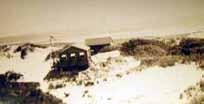
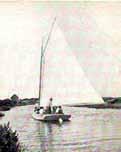
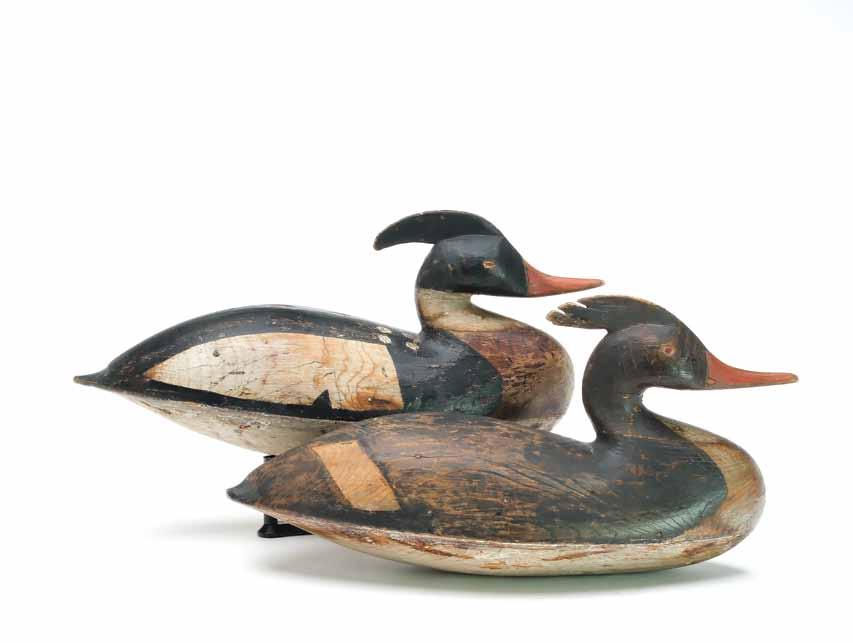
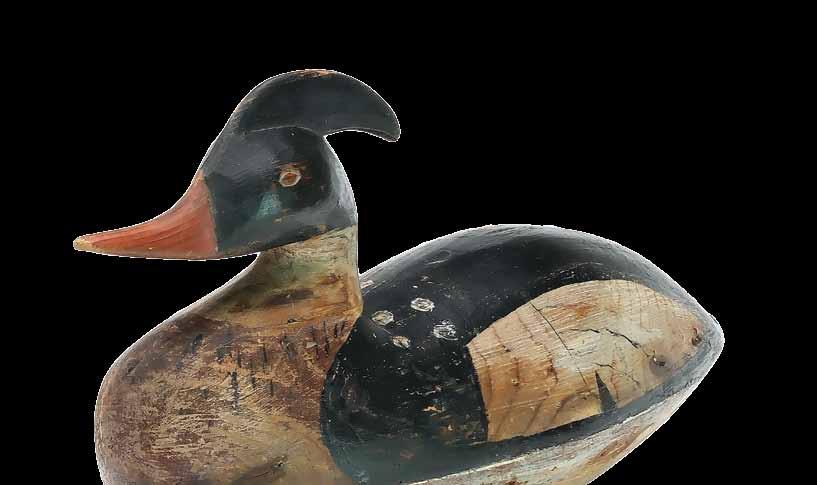
1848 - 1915 | Florence, New Jersey

Few collaborations in American decoy history have achieved the enduring respect and fascination commanded by the decoys of John English and John Dawson. Collectors have long placed a premium on these dual-effort works—decoys that combine the refined carving of English with the bold, stylized painting of Dawson. The result is a rare marriage of craftsmanship and artistry: two great makers, one great decoy.
John English was among the most talented and prolific carvers of the Delaware River school. His decoys are celebrated for their exceptional form, near-perfect proportions, and finely rendered detail. English was not only a master carver but also a gifted painter—his plumage patterns were applied with remarkable precision and subtlety, placing his work among the finest from the region.
English’s total lifetime output is estimated at roughly 500 decoys, representing a wide variety of species. Like many dedicated waterfowlers of his time, English regularly refreshed his hunting rig—selling used birds once they began to show wear and carving new ones for himself. As a result, many of his older decoys passed into the hands of other hunters who occasionally touched them up or repainted them.
After English’s death, a younger craftsman named John Dawson acquired a large portion of his rig. Rather than simply repairing the birds, Dawson reimagined them— bringing a new visual life to English’s already elegant forms. Around 1920, Dawson repainted roughly one hundred of English’s decoys, creating what collectors today recognize as the English/Dawson decoys—some of the most distinctive and desirable examples from the Delaware River tradition.
John Dawson was a remarkable talent in his own right—a craftsman, painter, and outdoorsman whose creative vision left a lasting mark on the American decoy tradition. Born into a family of early settlers in Trenton, Dawson spent most of his life working as a kiln operator for the Scammel Pottery Company. Like many who lived along the Delaware, he was an avid hunter and waterman, and it was this connection to the river that shaped his artistic sensibilities.
Continued
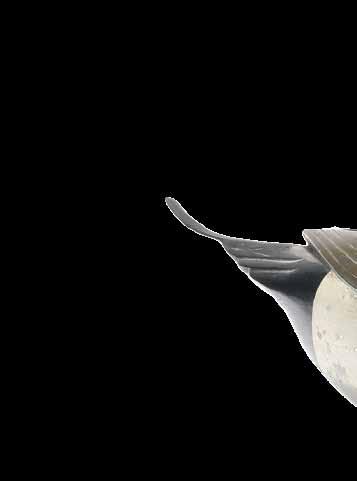
3 John English (1848-1915), Florence, New Jersey. Extremely rare English/Dawson pintail. One of only two known. Hollow carved with raised V wingtips and relief tail feather carving. Inlaid tail sprig. Mackey collection ink stamp on underside. Measures 17.75” long. Excellent early repaint by John Dawson with very minor wear; some shallow dents in body; tail sprig was professionally restored by Bob White.
Provenance: John Hillman collection. Martin and Deborah Maloy collection. (50,000 - 80,000)
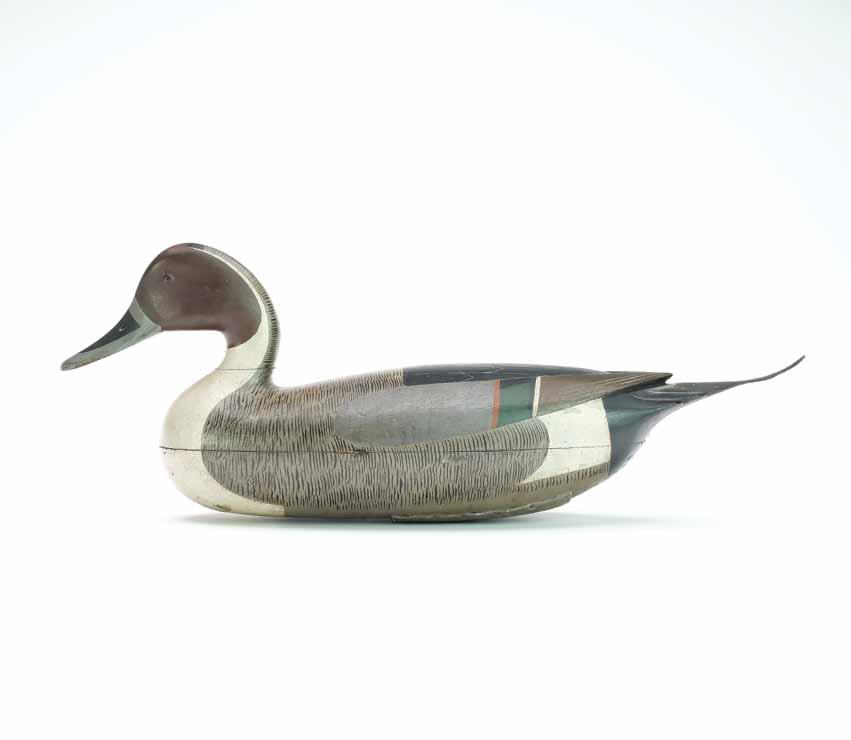
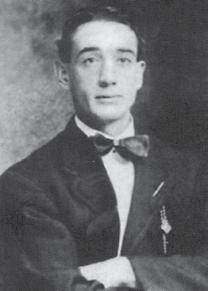
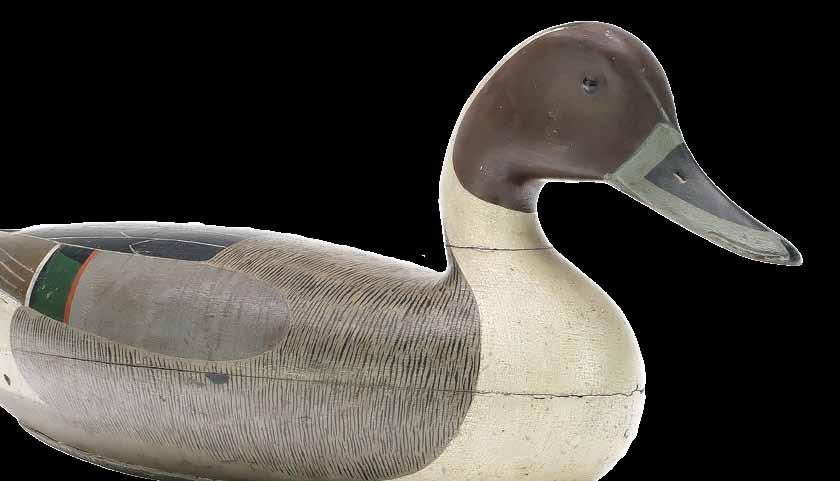
4

John English (1848-1915), Florence, New Jersey. Rare English/Dawson canvasback. Hollow carved with raised neck seat and incised tail feather carving. “DSC” stamped in underside for the collection of Dave Campbell. Measures 14” long. Early in use repaint by John Dawson; shows minor wear; under a thin coat of varnish; tiny chips on edge of tail and hairline crack near one eye, otherwise very good structurally.
Provenance: Dave Campbell collection. Martin and Deborah Maloy collection. (10,000 - 15,000)
Continued
Dawson’s painting style stood apart from his contemporaries. Strongly influenced by the Art Nouveau movement, his work was highly stylized and abstract, yet still evocative of the living bird. His brushwork transformed utilitarian hunting tools into objects of sculptural grace.
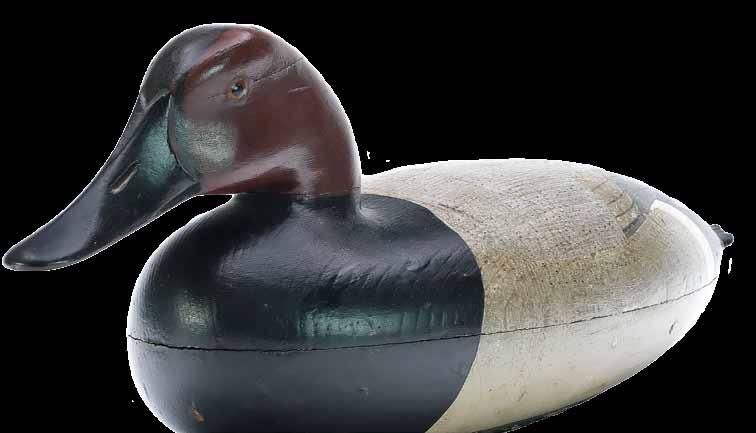
The collaboration between English and Dawson began when Dawson inherited or was gifted a rig of English decoys that needed “sprucing up.” Some of these birds were stripped and repainted entirely; others were painted directly over the original surfaces. In both cases, Dawson’s work brought renewed vitality to English’s masterful carving.
5 John English (1848-1915), Florence, New Jersey. Hollow carved English/Dawson goldeneye hen with tucked head and incised tail feather carving. “DSC” stamped in underside for the collection of Dave Campbell. Measures 11.75” long. Early second coat by John Dawson with very minor wear; some flaking and separation at body seam; otherwise very good structurally.
Provenance: Dave Campbell collection. Martin and Deborah Maloy collection. (8,000 - 12,000)

Later in life, Dawson carved and painted his own decoys—often s old through local hardware stores for just $2.00 each. These self-made examples, known as Dawson/Dawson decoys, include divers such as redheads, bluebills, canvasbacks, and mergansers, as well as a rare buffle head.
The English/Dawson decoys remain among the most compelling examples of artistic collaboration in American folk art. English’s balan ced, fluid forms provide the ideal foundation for Dawson’s expressive, flowing pa intwork. Together, they embody the transition between the purely functional working decoy and the emerging recognition of decoys as works of art.
To collectors, these birds represent more than just fine craftsm anship—they tell the story of two generations of New Jersey makers, united by the river, the hunt, and the timeless pursuit of beauty in utility.
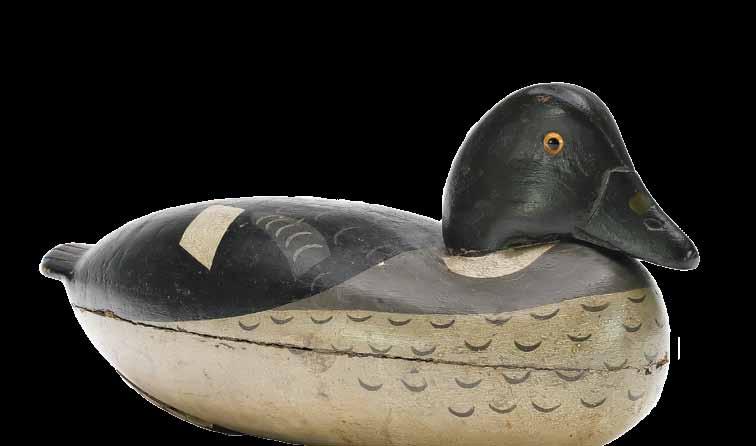
1889 - 1924 | Detroit, Michigan

Exact decoys pictured on cover of “Mason Decoys: A Complete Pictorial Guide,” Russ Goldberger and Alan Haid.
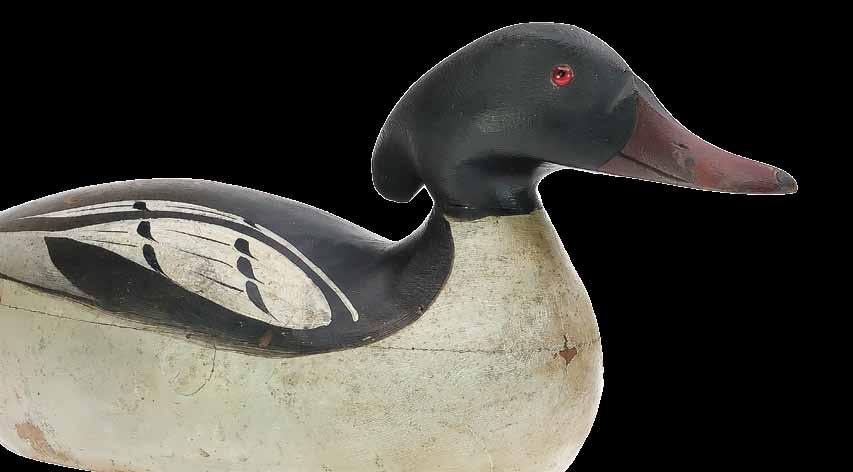

6 Mason Decoy Factory (1889-1924), Detroit, Michigan. Outstanding and very rare, rigmate pair of American mergansers. Hollow carved premier grade with extended crests and relief bill carving. Hen with detailed feather looping on back. Measure 18.25” long. Excellent original paint with very minor flaking and wear; each with ink print from being wrapped in newspaper on lower side; head is very slightly loose on drake; drake with spots on edge of underside where paint is missing and blunting on tip of tail.
Provenance: Alan and Elaine Haid collection. Martin and Deborah Maloy collection.
Literature: “Decoys of the Mississippi Flyway”, by Alan G. Haid, drake on page 72 and front cover, exact decoy pictured. “Mason Decoys”, Russ Goldberger and Alan Haid, pair on page 72 and front cover, exact decoys pictured.
(50,000 - 70,000)
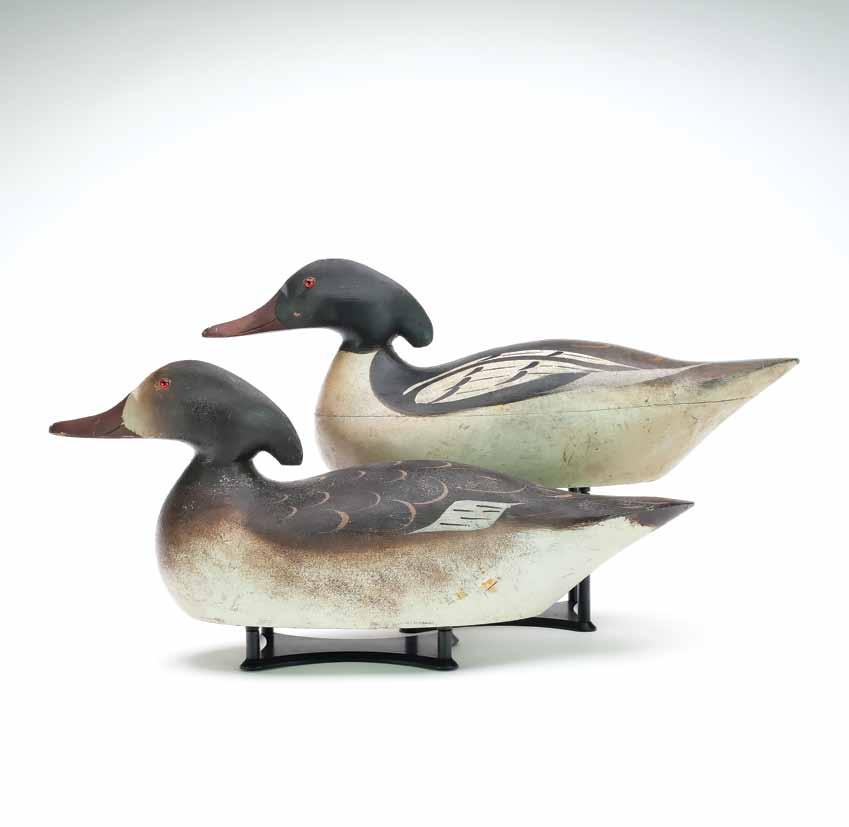
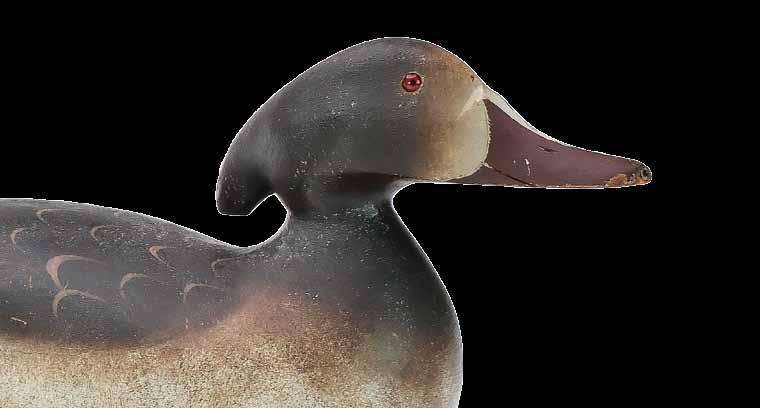
7 Mason Decoy Factory (1889-1924), Detroit, Michigan. Rigmate pair of bluewing teal. Premier grade with relief bill carving and snakey head style. Double blue paint pattern on drake. McCleery collection ink stamp and Sotheby’s auction stickers on underside. Measure 12” long. Original paint with very minor wear; protected under a thin coat of varnish; flaking to filler at hen’s neck seat; otherwise both excellent structurally.
Provenance: Dr. James McCleey collection. Martin and Deborah Maloy collection. (15,000 - 25,000)

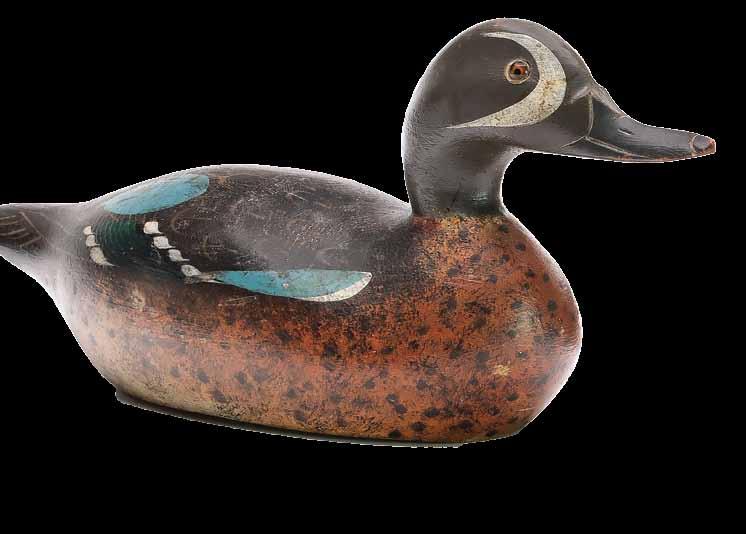

8 Mason Decoy Factory (1889-1924), Detroit, Michigan. Rare bufflehead. Challenge grade with snakey head style. ‘MR Bingham’ branded on underside. Measures 12.25” long. Original paint with moderate wear; early coat of varnish has darkened with age; filler missing and glue visible at neck seat; old chipping and roughness at edge of tail.
Provenance: Harold O’Connor collection. Martin and Deborah Maloy collection. (5,000 - 8,000)
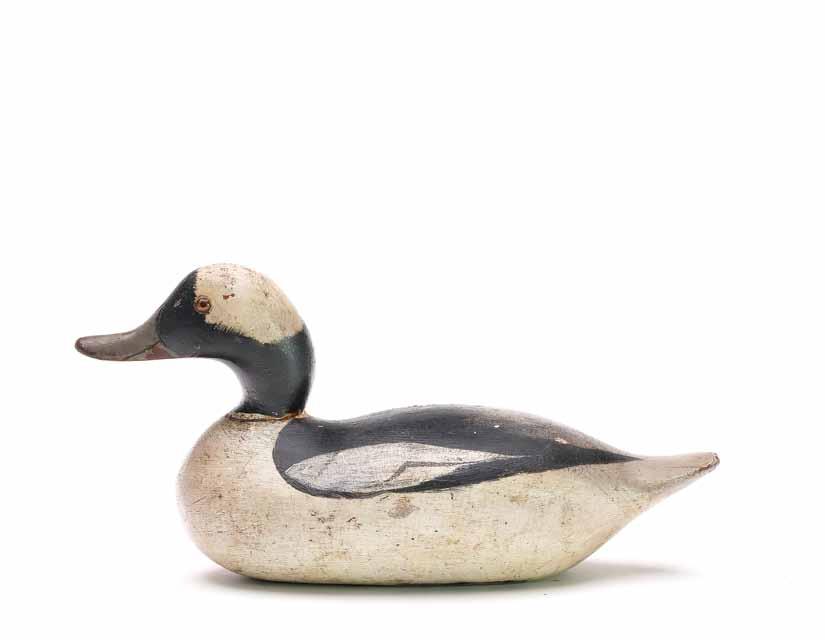
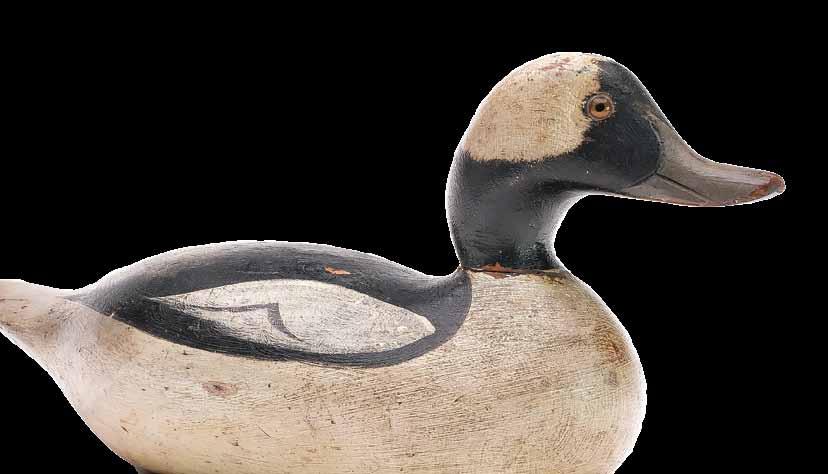
Maryland

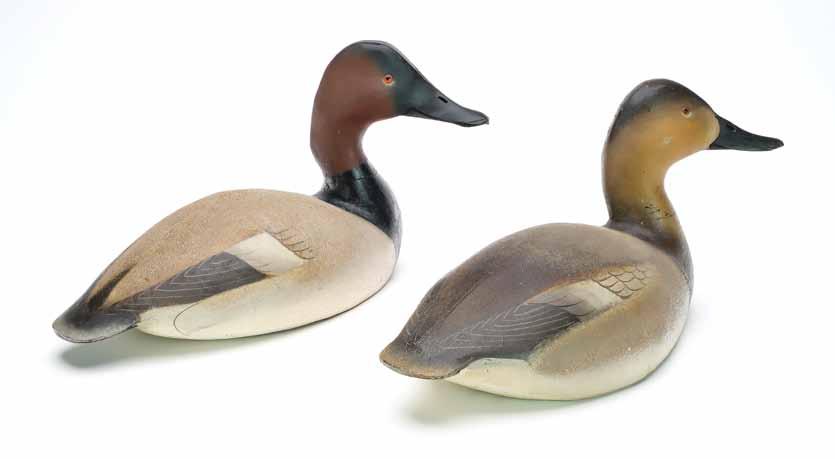
9 Ward Brothers, Crisfield, Maryland. Excellent pair of canvasbacks with thick stipple paint, slightly turned heads, and drake with high head style. Signed and dated 1936. Also stamped “DSC” for the collection of David Campbell. Measure 17” long. Excellent original paint with almost no wear; tight crazing near hen’s tail; slight separation at neck seat; very minor blunting at tip of drake’s bill; hen with tiny chips on one side of bill tip that were darkened.
Provenance: Martin and Deborah Maloy collection. (30,000 - 50,000)
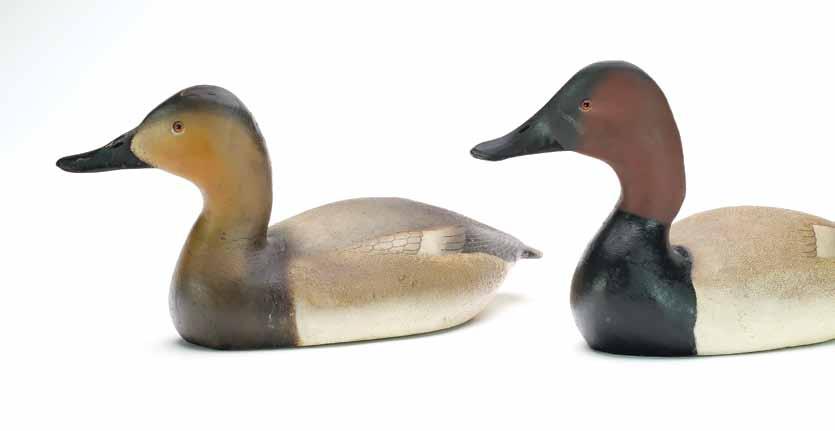

10 Ward Brothers, Crisfield, Maryland. Early pair of mallards. 1928 style with large bulbous heads. Measure 18.25” long. Original paint with minor gunning wear; hen was significantly shot on one side; drake with some shot scars in head and breast that were filled and touched up; drake’s bill is a professional replacement.
Provenance: Martin and Deborah Maloy collection. (20,000 - 30,000)
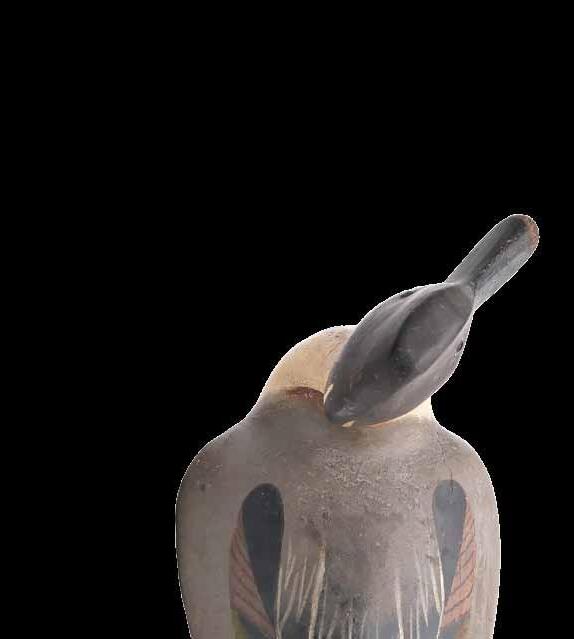
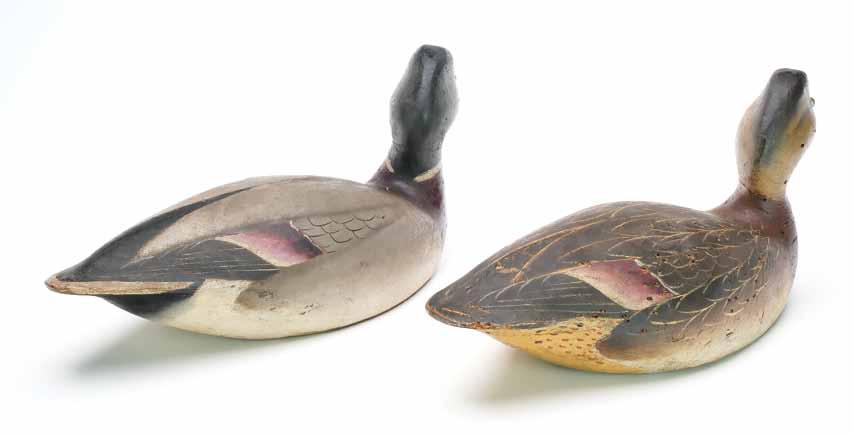

11 Ward Brothers, Crisfield, Maryland. Early pintail with slightly turned head. Pinch breast style with upswept tail. Signed and dated 1928 on the underside. Measures 17.5” long. Mix of original and early in use repaint by the Ward brothers, showing moderate flaking and wear; hairline drying cracks in back; crack through neck; minor roughness on tip of tail.
Provenance: From the Newcomb rig, Trappe, Maryland. Martin and Deborah Maloy collection. (12,000 - 18,000)
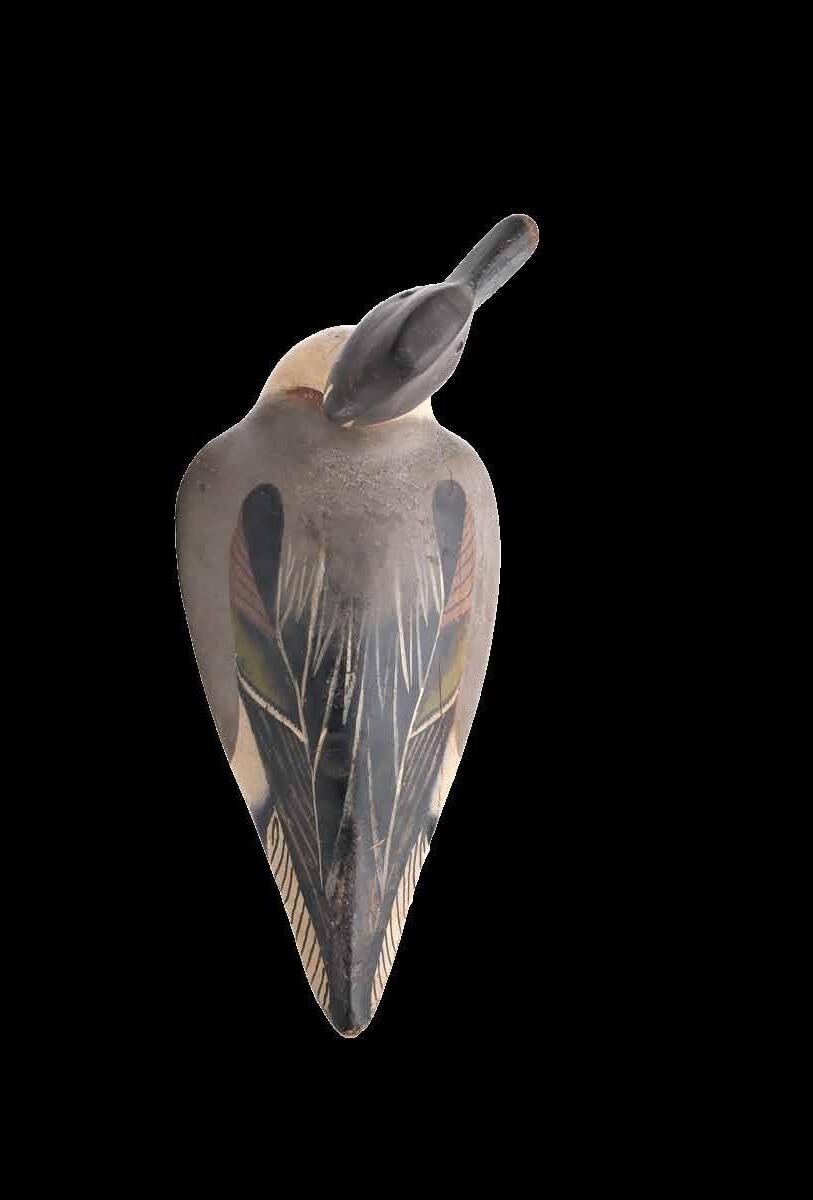
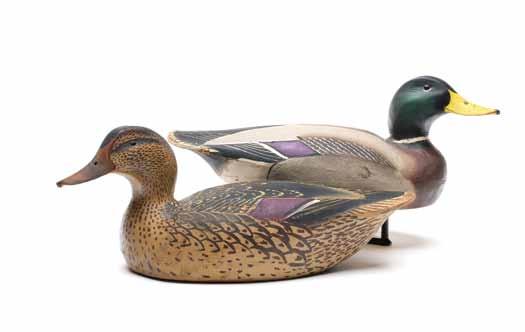
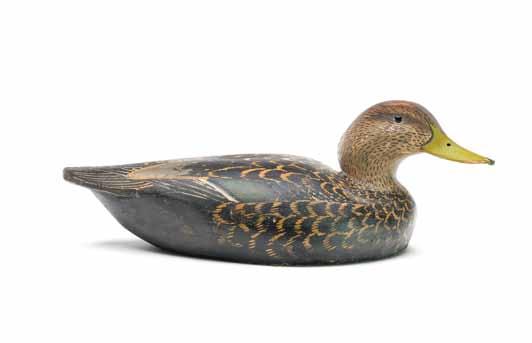
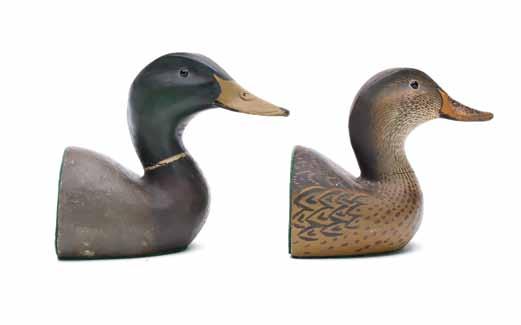
12 Ward Brothers, Crisfield, Maryland. Pair of mallards with slightly turned heads. Balsa body 1936 style. Measure 16” and 16.75” long. Original paint with minor wear; a few small dents in drake; crack in one side of drake’s neck.
Provenance: Martin and Deborah Maloy collection. (5,000 - 8,000)
13 Ward Brothers, Crisfield, Maryland. Balsa body black duck with slightly turned head. Measures 16.75” long. Excellent original paint on body; some flaking on sides of head with areas of flaking that were restored; excellent structurally.
Provenance: Martin and Deborah Maloy collection. (3,000 - 5,000)
14 Ward Brothers, Crisfield, Maryland. Pair of mallard bookends. 1936 style with slightly turned heads. Signed on the underside. Measure 7” and 8” long. Original paint with minor wear; slight separation and flaking to filler at neck seat; hen with filler used at bill tip appears to have been done by the makers.
Provenance: Martin and Deborah Maloy collection. (1,500 - 2,500)
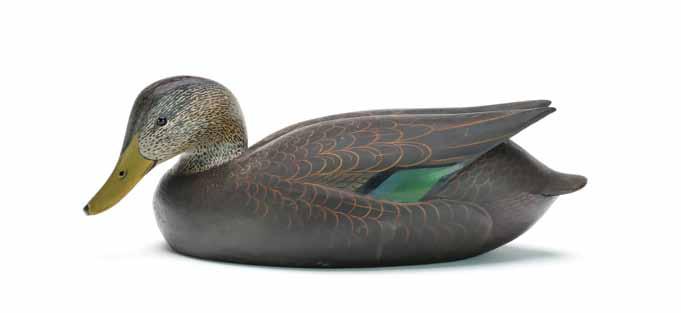
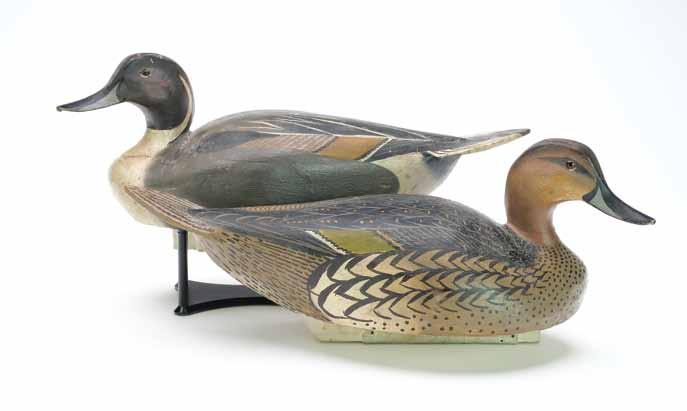
15 Ward Brothers, Crisfield, Maryland. Hollow carved cedar black duck. Slightly turned head and raised, extended wingtips. Signed and dated 1957. Also with Bobby Richardson collection ink stamp. Measures 15” long. Original paint with almost no wear; a few very shallow dents; otherwise excellent structurally.
Provenance: Martin and Deborah Maloy collection.
Literature: “Decoys of the mid-Atlantic Region” by Henry A. Fleckenstein Jr., page 180, exact decoy pictured. “Pioneer Decoy Carvers: A Biography of Lemuel and Steve Ward” by Berkey, Berkey, and
Berkey, page 81, exact decoy pictured. “The Ward Brothers Decoys: A Collector’s Guide” by Ronald J. Gard and Brian J. McGrath, page 80, exact decoy pictured.
(6,000 - 9,000)
16 Ward Brothers, Crisfield, Maryland. Rigmate pair of pintails. Balsa body, 1948 style with slightly turned head and applied cedar tails. Both are signed and dated on underside. Measure 18” long. Original paint with minor gunning wear; tight crack through base of hen’s neck; slight separation to filler at drake’s neck seat; white paint on underside is an early second coat.
Provenance: Martin and Deborah Maloy collection.
(8,000 - 12,000)
17 Ward Brothers, Crisfield, Maryland. Decorative Hutchins goose. Hollow carved with slightly turned head and relief wing and tail feather carving. Signed and dated 1967 on underside. Measures 18.75” long. Original paint with minor crazing and paint shrinkage; very good structurally.
Provenance: Martin and Deborah Maloy collection. (6,000 - 9,000)
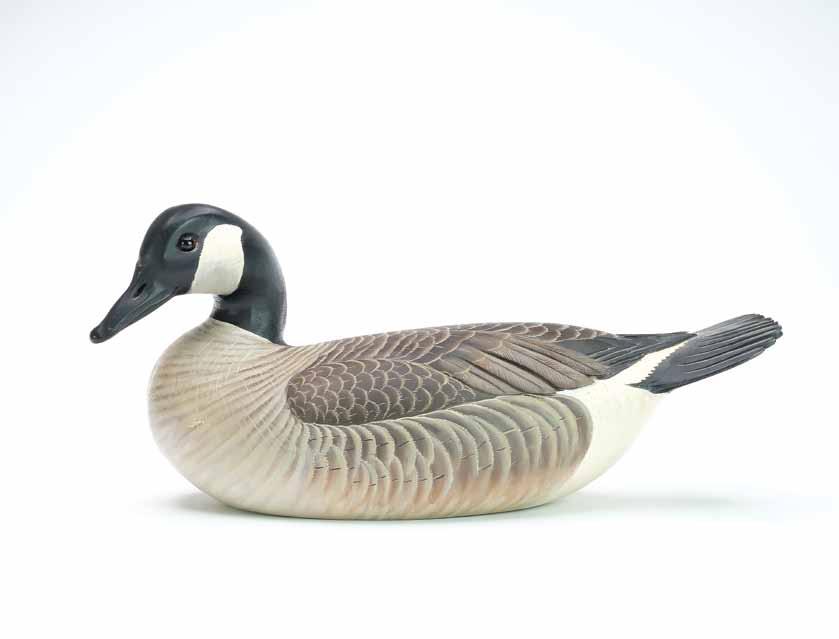
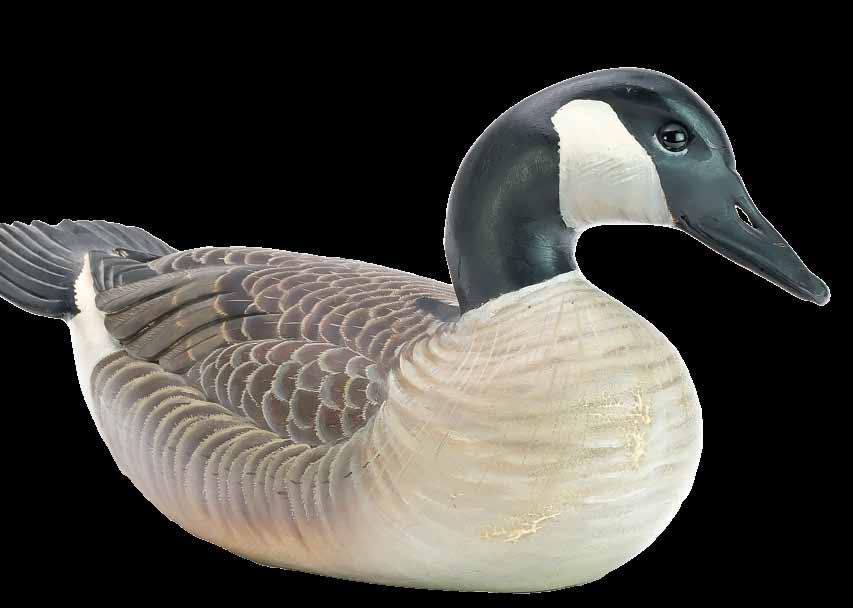

18 Ward Brothers, Crisfield, Maryland. Decorative brant. Hollow carved with slightly turned head and raised wingtips. Signed and dated 1967 on underside. Measures 18.25” long. Original paint with minor crazing and paint shrinkage; tightly reset chip in one wingtip.
Provenance: Martin and Deborah Maloy collection. (3,000 - 5,000)
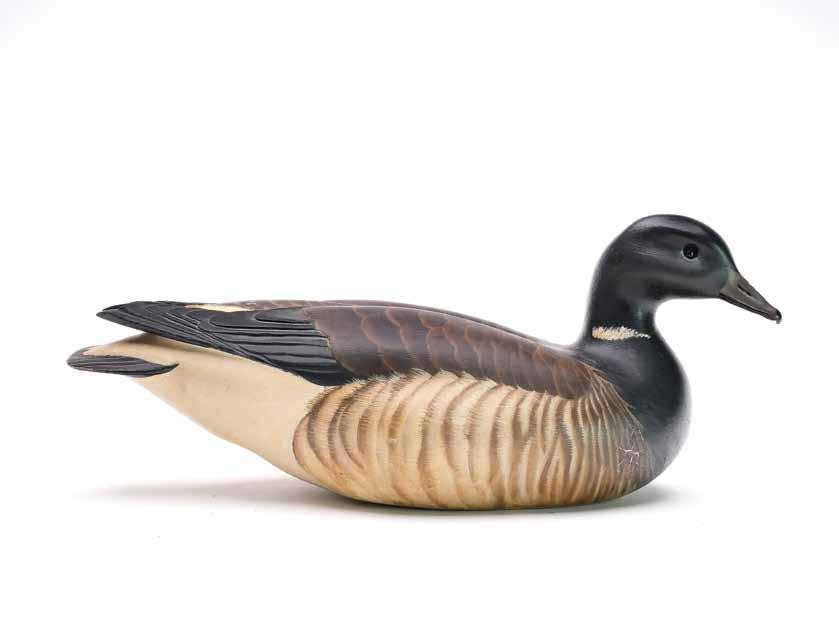


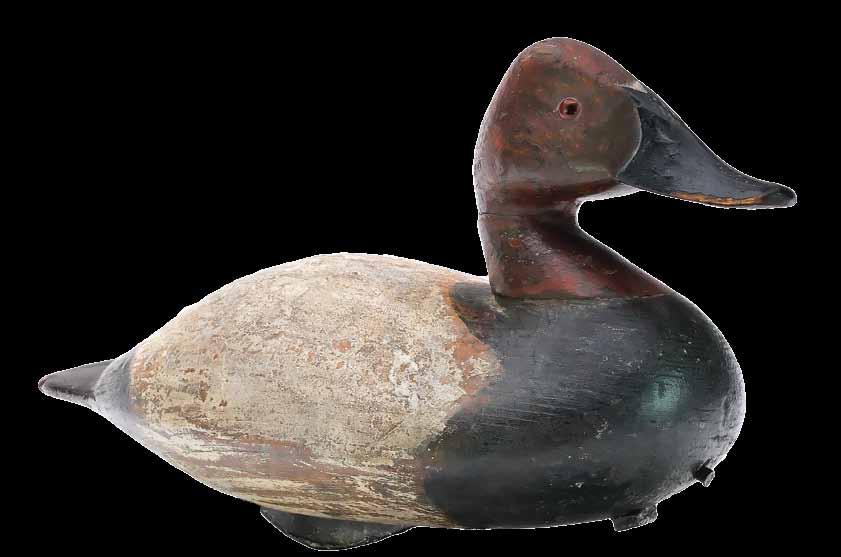
19 Lee Dudley (1860-1942), Knotts Island, North Carolina. Classic canvasback drake. A club bird. Unbranded, wide body style, and glass eyes. Measures 14” long. Old repaint; bill is a professional replacement; old neck crack repair; very small chip missing on one edge of tail.
Provenance: Martin and Deborah Maloy collection. (20,000 - 30,000)
Born in Chicago, Luedtke and his family moved to Walla Walla, Washington where John attended high school. Upon graduation, he began a long career in sales, beginning with a local meat and cold storage facility. By 1934 he had left his first wife, remarried, and moved to Stockton where he was, again, employed in the meat packing business. He made a major career change in 1946 when he and a partner began a boat building business. Just before his untimely death, he quit building boats and joined the firm of Stephens Brothers Marine Store, returning to his roots as a salesman and manager.
John was an enthusiastic outdoorsman, hunting and fishing throughout the west coast. Apparently, he was an accomplished marksman with a .22 rifle. Between 1945 and 46 he and two friends joined together to form a duck club near Stockton, where they flooded 400 acres to provide suitable habitat. The club required decoys and, even though he had limited expertise in woodworking, Luedtke set out to carve a rig of about 70 pintails. This singular attempt was his only venture into producing decoys yet his birds are considered to be some of the finest ever created in California.
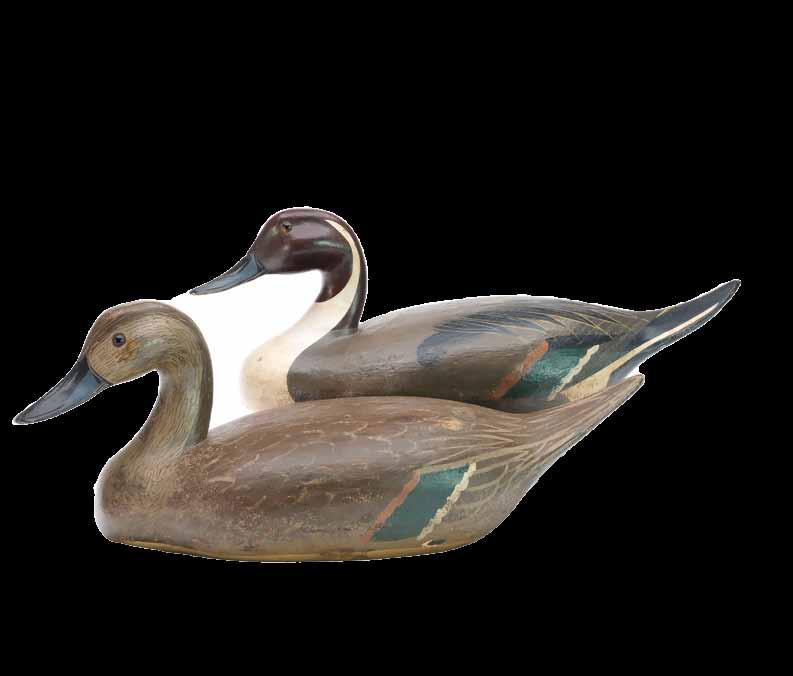
20 John Luedtke (1901-1958), Stockton, California. Rigmate pair of pintails. Balsa body with upswept tails. Hen with slightly turned head and scratch feather paint detail. Measure 15” long. Original paint with very minor wear; a few small dents; otherwise excellent structurally.
Provenance: Martin and Deborah Maloy collection. (10,000 - 15,000)
“John Luedtke -- - created the most refined and stylish pintails ever carved in California; they are exhilarating!” - Michael Miller – Wildfowl Decoys of California
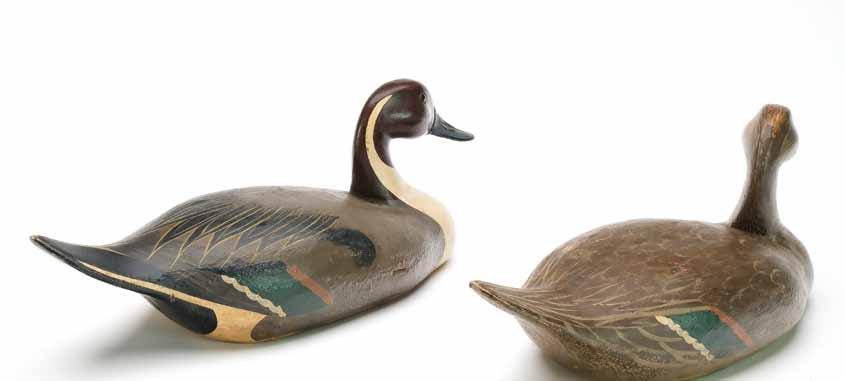
1888 - 1945 | Alexandria Bay, New York

Chauncey Wheeler (1888-1945), Alexandria Bay, New York. Extremely rare turned head brant. Two piece body with relief carved torn heart pattern on back. Measures 15.25” long. Original paint with very minor wear; under an early coat of varnish that has darkened with age; tight crack through neck was professionally reset; small chip in tail was tightly reset; hairline cracks in breast; underside was planned down at some point and green felt added; felt has been mostly removed.
Provenance: Martin and Deborah Maloy collection. (8,000 - 12,000)
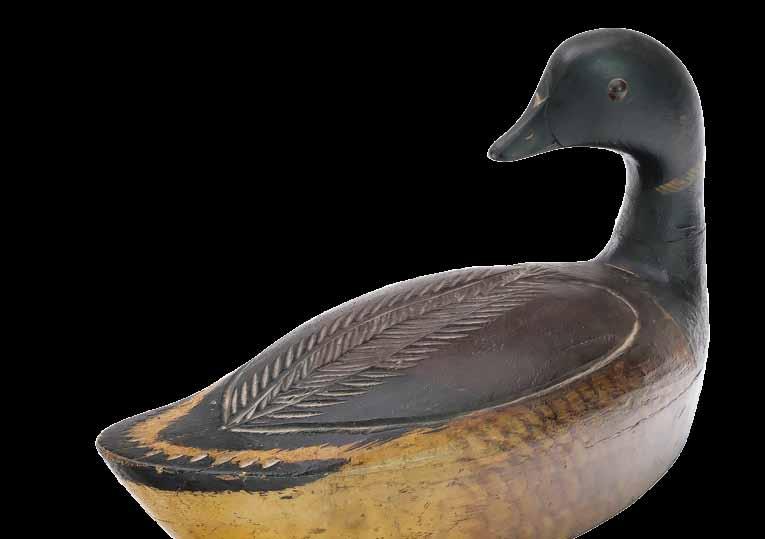
A number of decoys by Chauncy Wheeler (1862 – 1937) of Alexandria Bay, NY have been found with the “W.F.B.” brand. These initials have since been (erroneously) identified as being those of a Mr. William Francis Beal of Amityville on Long Island. This Mr. Beal has been described as being “ - - - a bootlegger and battery gunner during prohibition who later became a stockbroker” and that he “- - - owned an estate in Amityville - - - “. This attribution seems to have stemmed from a letter written in 1975 by George W Coombs Jr to Harold Herrick which stated that a Mr. Beal (no first or last name or initials given) of “Clocks Blvd in Amityville” placed an order for “geese, broadbill and whistler” decoys with Chauncy Wheeler “in 1919”. The letter goes on to note that Mr. Beal was “a sportsman who spent most of his gunning hours in a double battery box” and that his guide was a “Capt. Carl Chichester of Amityville who was among a family of well known market gunners”. Finally, among a few other unrelated observations concerning Beal’s hunting preferences, Coombs wrote that Beal’s wife “- - - was many years younger and very beautiful - - - “ and that Beal “- - - passed away in 1926”.
Digging into the story a little deeper, reveals that much of what both Mr. Coombs wrote in 1975 and what has since been disseminated appears to have been unintentionally based on misinformation, vague verbal history, or memories which had become tainted with time.
In reality, it seems that there never was an individual in Amityville during the period in question by the name of William Francis Beal. There was a William Fields Beal that resided there for a period beginning around the late 1920s to the time of his death in 1939 (not 1926). This W.F. Beal was born into wealth in 1870 in Boston, Massachusetts. His father was a bank president, and the family maintained summer homes in coastal Nahant, just north of the city. Beal was Harvard educated (class of 1893), and married his first wife, New York native Lillian Darrow, in 1897 while he was working as a real estate broker (not stock
broker – See note 1) in Nahant. By 1910, Beal had divorced Lillian, and, it seems that he was residing in Stratford, CT as a boarder in the home of C.D. Wicks. This was Charles Delancy (“Cappy”) Wicks who was a well-known oysterman and fishing guide who, according to his obituary, “- - - acted in this capacity for many wealthy New York and Boston sportsmen”(See note 2). Beal remained divorced and with the Wicks through the time of the 1920 census but, by 1930, he had remarried, and he and his second wife, Mary, were living on Clock Boulevard in West Amityville. His home at the time was valued at $100,000, a sum far above that of his neighbors whose properties were valued in the $8,000 – $18,000 range, a residence that could have easily been referred to by Coombs as “an estate”. Coombs, it should be remembered, also referred to Beal’s wife as “- - - being many years younger - - - “. Mary was, indeed, 28 years younger than her husband.
Finally, Beal has been described as being “a bootlegger and battery gunner during prohibition - - -“. In fact, it was Beal’s guide on Long Island, Carlton E (“Carl”) Chichester (1890 – 1982) who, according to his obituary, was the one who had participated in those practices as a young man, not Mr. Beal. After Beal’s passing, we can only assume that Coombs was correct when he stated that, after Beal’s death, “His wife sold everything and disappeared”.
Although not specifically mentioned in Coombs’ letter, Wheeler obviously did make a rig of brant for Beal. If the Coombs’ date of 1919 is correct, then Beal would have been living in Stratford CT and gunning with “Cappy” Wicks when he placed the order. It has been suggested that perhaps these were the “geese” referred to in the letter. It appears that the brant as well as a few old squaws are the only species by Wheeler that bear the “W.F.B.” brand. One is left to reflect on the presence of the broadbill and whistlers also mentioned in the Coombs’ letter. As noted in Harold Reiser’s excellent reference “Chance”, were they actually ever ordered, never carved, or are they either lost or “still out there”?
Notes:
1. Beals worked his entire career as a real estate broker with his fame resting on negotiating the sale of the Waldorf Astoria property in New York to make way for the construction of the Empire State building.
2. For additional information on Wicks see “Connecticut Decoys” by Chitwood.
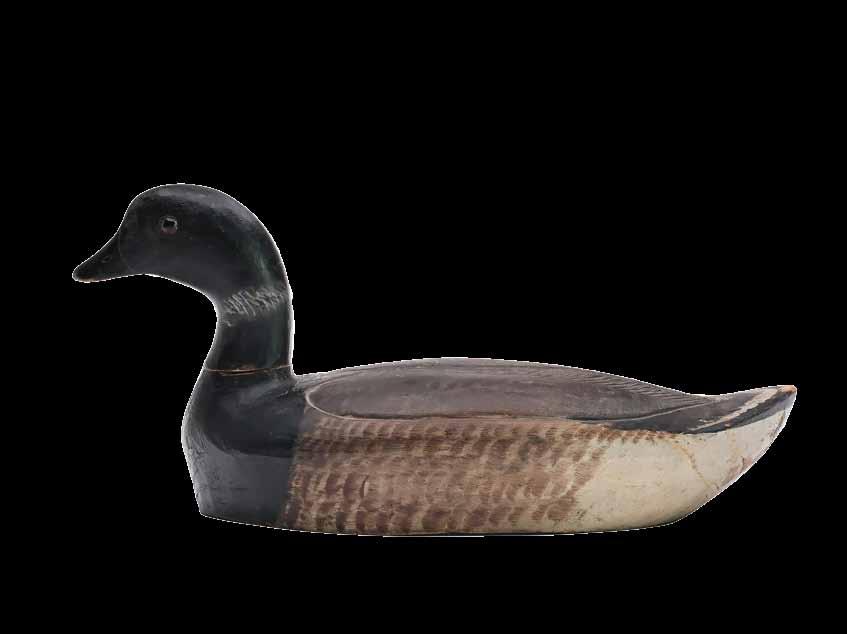

22 Chauncey Wheeler (1888-1945), Alexandria Bay, New York. Brant with incised heart wing carving. “W.F.B.” branded in underside. Measures 18.5” long. Original paint with minor wear; some filler added to minor chipping at tip of tail; hairline drying cracks in breast and under tail; area on one side of head and upper neck with filler paint restoration.
Provenance: Martin and Deborah Maloy collection. (5,000 - 8,000)
Louis Rathmell was born in 1898 to a relatively average family in New Jersey. However, his life would take a dramatic turn when he met and married Irene Parks Jennings, who happened to be from a very wealthy family in Danbury, Connecticut. As a result of this extraordinary good fortunate, Lou would spend the majority of his adult life living on their estate in ‘Hearthstone Castle’ and managing the expansive property named “Tarrywile Farm”.
Aside from his business acumen, Lou developed a passion for the outdoors and became an avid sportsman. According to renowned collector Donal C. O’Brien, “Rathmell was probably the best hunter of those who hunted the Stratford marshes. He not only made beautiful decoys, but stood alone as a wing shot and duck caller. His presence in the marsh was feared by the other hunters.”
Lou Rathmell apparently made fewer than 100 decoys, seemingly all for his own use or gifts to select friends. His early efforts were quite simplistic and bordered on crude. Fate again smiled on Lou, when he met and befriended an older and much more accomplished Charles ‘Shang’ Wheeler. Lou was soon emulating his work and undoubtedly copying his patterns. It was not an unusual circumstance for ‘Shang’ to encourage and mentor young carvers from the Stratford area. Due to Shang’s guidance, Rathmell would greatly improve both his carving and his painting. On one occasion Louis bested his tutor by winning the National Decoy Show in New York. In 1951, at the same New York show, Rathmell took the “Best of Show” honors under the discriminating panel of prestigious judges; Bill Mackey, Joel Barber, and Lynn Bogue Hunt.
23 Louis C. Rathmell (1898-1974), Danbury, Connecticut. Very rare working mallard with comb feather paint detail. Mallards by Rathmell are much more rare than his black ducks, only two are known. Hollow carved cedar body with slightly turned head. Stamped “1943” on underside. Applied copper tail sprig. Measures 17.5” long. Original paint with very minor wear; some flaking to paint on tail area; otherwise excellent and original.
Provenance: Martin and Deborah Maloy collection.
Literature: “Connecticut Decoys” by Henry C. Chitwood, page 100-101, exact decoy pictured. (8,000 - 12,000)
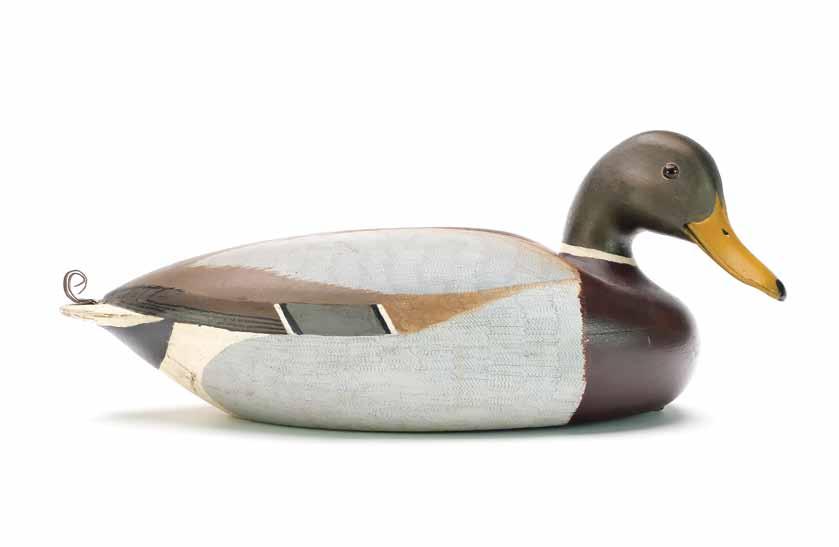
Perhaps his crowning achievement was a rig of 55 phenomenal Black Ducks that he made in 1941. Each was unique, having slightly different head heights and positions. Dixon Merkt, in his chapter on Connecticut decoys in “The Great Book of Decoys,” states that this “must be considered one of the best gunning rigs ever made.” Ironically, this was the same year that Shang Wheeler made an almost identical cork Black Duck as a wedding present for the daughter of his friend. Dixon also relates the common belief that “There are those collectors that believe Rathmell’s work is equal to or possibly better than (that of) his mentor.” The two Makers’ works are very similar and often hard to differentiate at first glance. The most obvious difference is that Wheeler used applied teardrop weights while Rathmell normally inlet his weights on his working decoys, and these are usually stamped with his name.
Rathmell and Wheeler also shared a love of fishing. A little known fact is that in addition to fishing in Maine (Wheeler) and Connecticut (Rathmell and Wheeler), both men spent a considerable amount of time plying
the waters off Westport, Massachusetts, and both men utilized the guiding services of Captain Bill Head of Westport Point. In appreciation for his guiding services, Wheeler gave the good Captain a sleeping Black Duck as a gift, and is also known to have given a number of small sketches to neighborhood children outside a local ice cream shop. Rathmell spent many summer mornings at ‘the point’, “rowing about the harbor in the morning in his little blue skiff.” In the article on Rathmell in Decoy Magazine, Cliff Alexander shows a page from Rathmell’s 1945 hunting journal where, across the top of the page, is written “Jerry Lougganes – Mgr. Moby Dick.” The Moby Dick, now the “Back Eddy,” was a popular seafood restaurant on the opposite side of the harbor and directly across the bridge from the docks on the Point. The picture of Rathmell holding a striper in Cliff’s article was almost certainly taken at Westport Point.
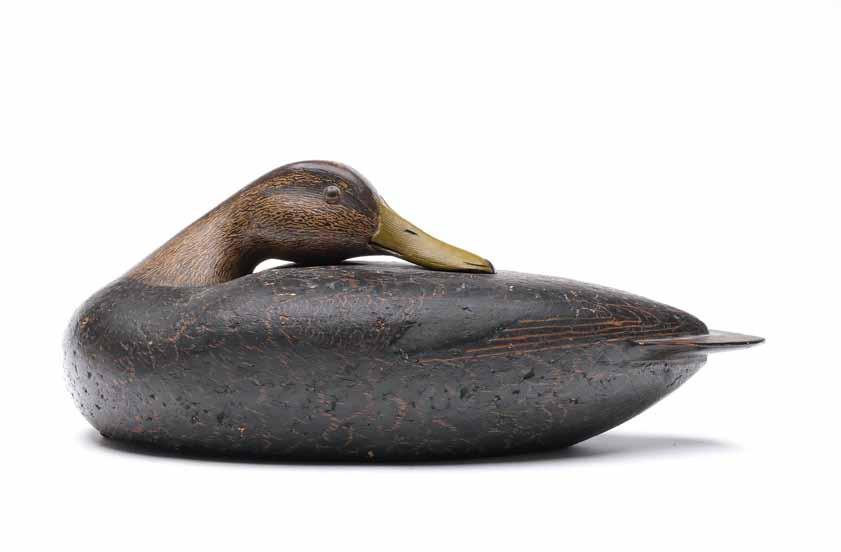
24 Louis C. Rathmell (1898-1974), Danbury, Connecticut. Rare sleeping black duck. Cork body with finely carved head and inserted cedar tail. Appealing scratch feather paint detail on head. Measures 16.5” long. Original paint with minor flaking; a few tiny spots of touchup; old paint over inlaid weight on underside.
Provenance: Martin and Deborah Maloy collection. (12,000 - 18,000)
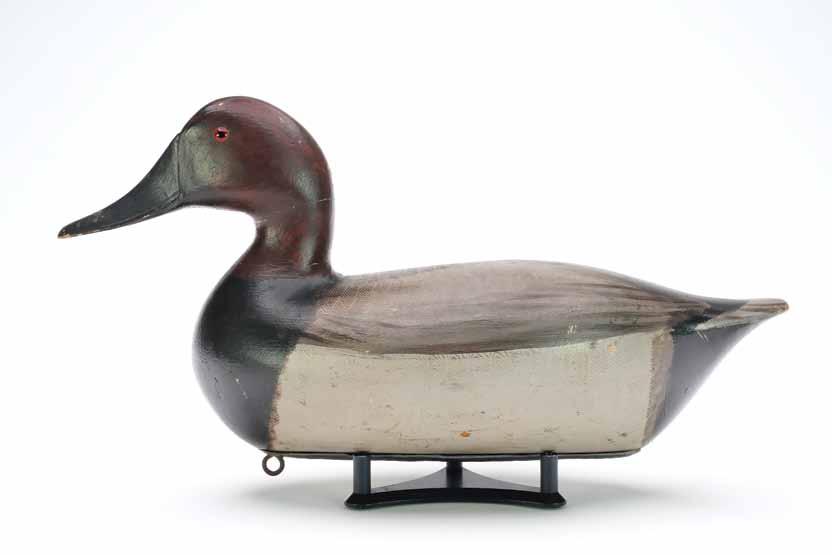
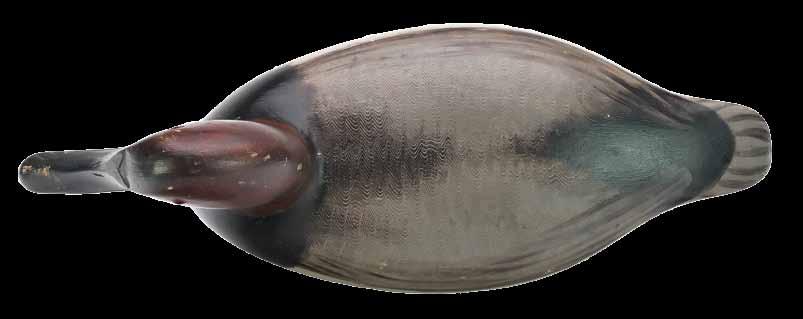
25 Charles Perdew (1874-1963), Henry, Illinois. Hollow carved canvasback with fine comb feather paint detail. Retains the original lead weight. Measures 15.75” long. Original paint with minor rubs and wear; fine crack through neck with some flaking at front of neck.
Provenance: Martin and Deborah Maloy collection. (8,000 - 12,000)
26 Hiram Hotze (1886-1977), Peoria, Illinois. Rigmate pair of mallards. Hollow carved with “L.J.R.” branded in undersides. Drake retains the original lead weight. Measure 16.5” long. Original paint with minor gunning wear; under an early coat of varnish that has darkened with age; professional tail chip repair on hen; small dents and shot marks in drake; a few spots where varnish was not applied shows under UV light, but is not touchup.
Provenance: Martin and Deborah Maloy collection.
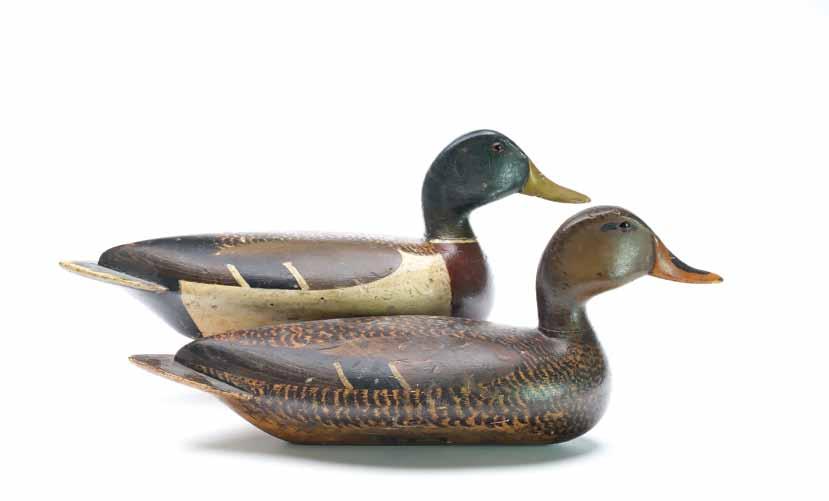
26A George Sibley (1861-1938), Chicago, Illinois. Bluewing teal hen. Hollow carved with slightly turned head and inlayed bill typical of the maker. Measures 10” long. Original paint with moderate flaking and wear; minor roughness on tip of tail; head swivels slightly; small hole drilled near underside.
Provenance: Martin and Deborah Maloy collection. (4,000 - 6,000)
(5,000 - 8,000)
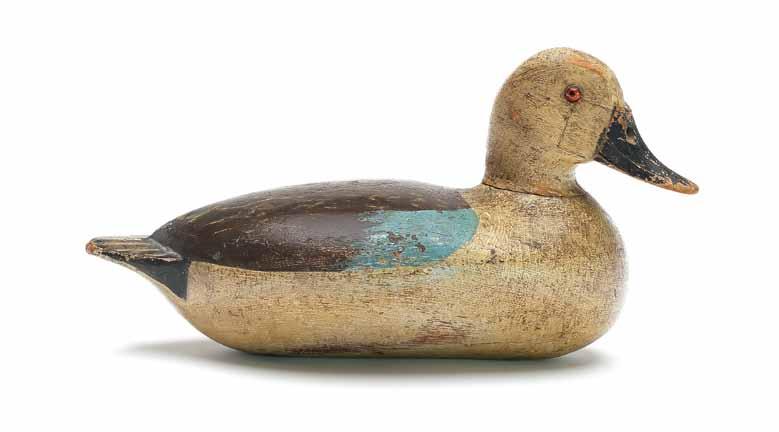

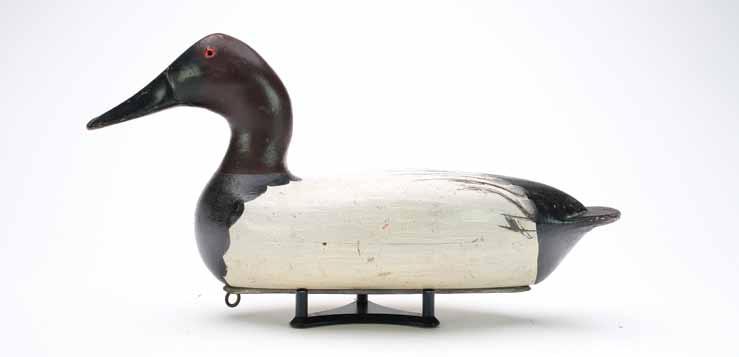
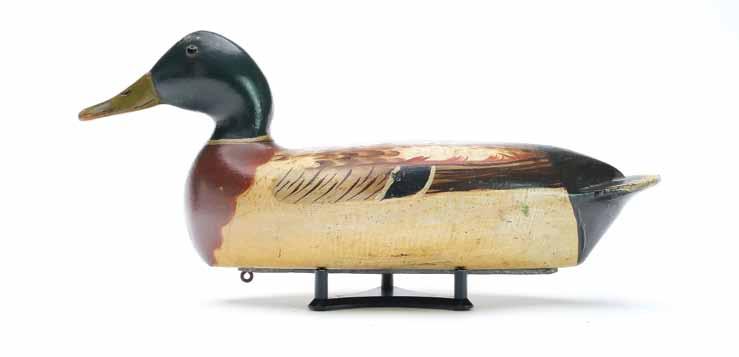
Bert Graves (1880-1956), Peoria, Illinois. Excellent canvasback. Hollow carved with fine comb feather paint detail. Retains the maker’s original weight. Measures 16.75” long. Original paint with very minor wear; excellent structurally.
Provenance: Martin and Deborah Maloy collection. (3,000 - 5,000)
28 Bert Graves (1880-1956), Peoria, Illinois. Hollow carved mallard with comb feather paint detail. Retains the maker’s original lead weight. Measures 17” long. Original paint with minor wear; early coat of varnish has darkened with age; lightly hit by shot in tail area; spot of flaking to bare wood on one lower side near tail; old chip near one eye with touchup.
Provenance: Martin and Deborah Maloy collection. (3,000 - 5,000)
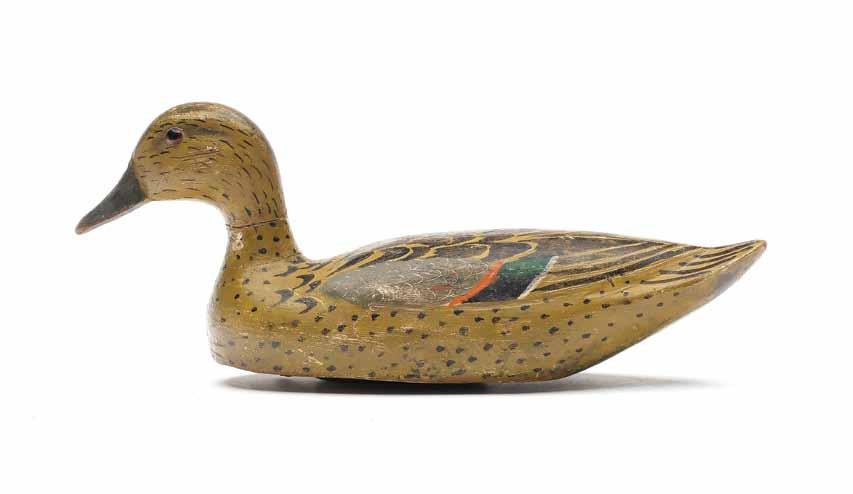
29 Mitchell Lafrance (1882-1979), New Orleans, Louisiana. Greenwing teal hen with relief wing carving and scratch feather paint detail. Measures 11.75” long. Original paint with minor wear; a few minor dents; old glue visible at a neck crack repair.
Provenance: Martin and Deborah Maloy collection. (5,000 - 8,000)
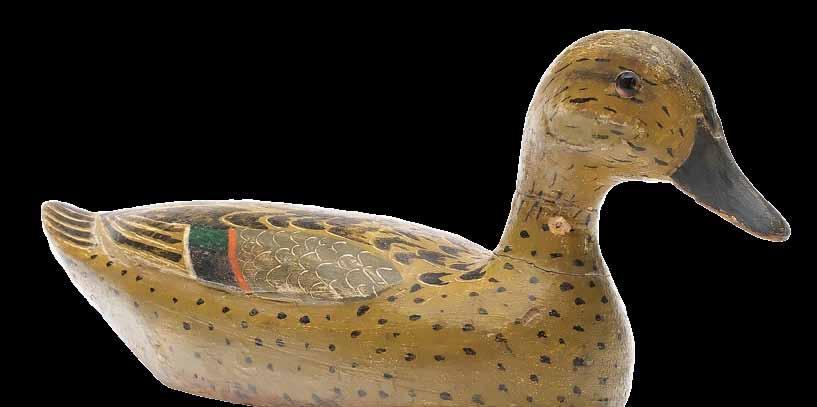
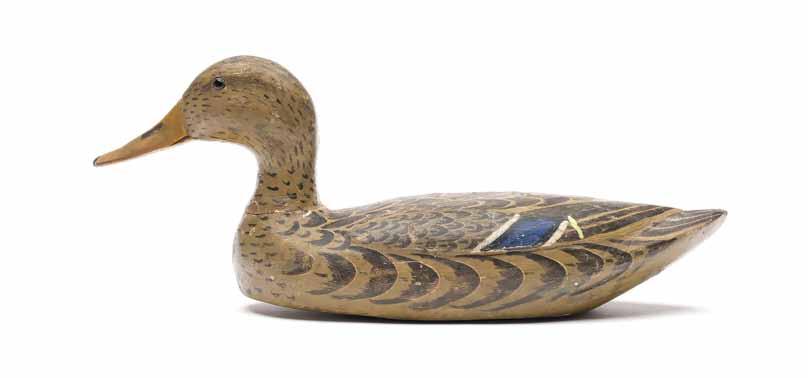
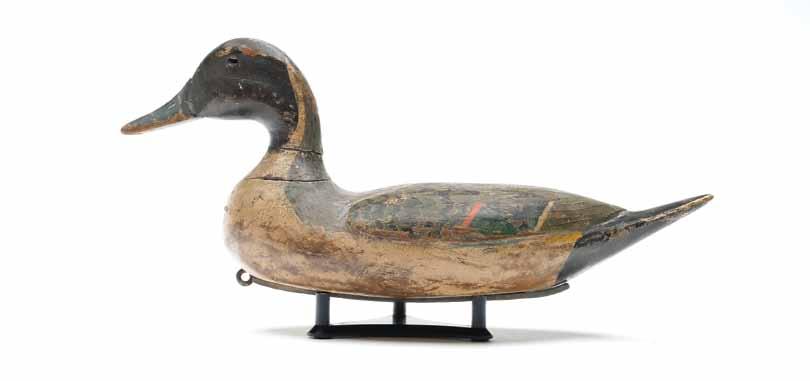
30 Mitchell Lafrance (1882-1979), New Orleans, Louisiana. Mallard hen with relief wing carving and scratch feather paint detail. Measures 16.5” long. Original paint with minor gunning wear; professional bill chip and tail chip repair; tight crack in one side of neck; head appears to have been off and redowled through bottom with some of the neck seat being shaved down.
Provenance: Martin and Deborah Maloy collection. (1,500 - 2,500)
31 Mitchell Lafrance (1882-1979), New Orleans, Louisiana. Pintail with relief wing carving. Measures 15.75” long. Original paint with moderate flaking and wear; under an old coat of varnish that has darkened with age; tight crazing on much of the decoy; heavily hit by shot; reglued crack through neck; hairline crack in bill and a small chip on underside of bill tip; professional tail chip repair.
Provenance: Martin and Deborah Maloy collection. (3,000 - 4,000)

32 Fred Nickerson (1902-1980), Falmouth, Massachusetts and Villagedale, Nova Scotia.. Pair of red-breasted mergansers. Hollow carved with relief wing carving and applied horse hair crest. Hen with slightly turned head. Measure 19” and 19.5” long. Original paint with minor gunning wear; lightly hit by shot; tight crack in drake’s neck; an early coat of varnish has darkened slightly.
Provenance: Martin and Deborah Maloy collection. (5,000 - 8,000)
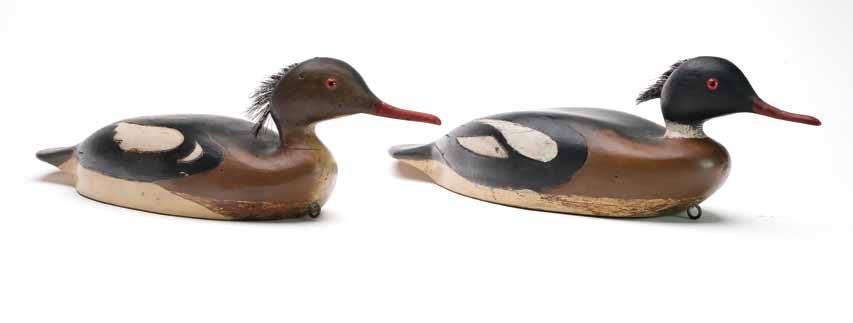
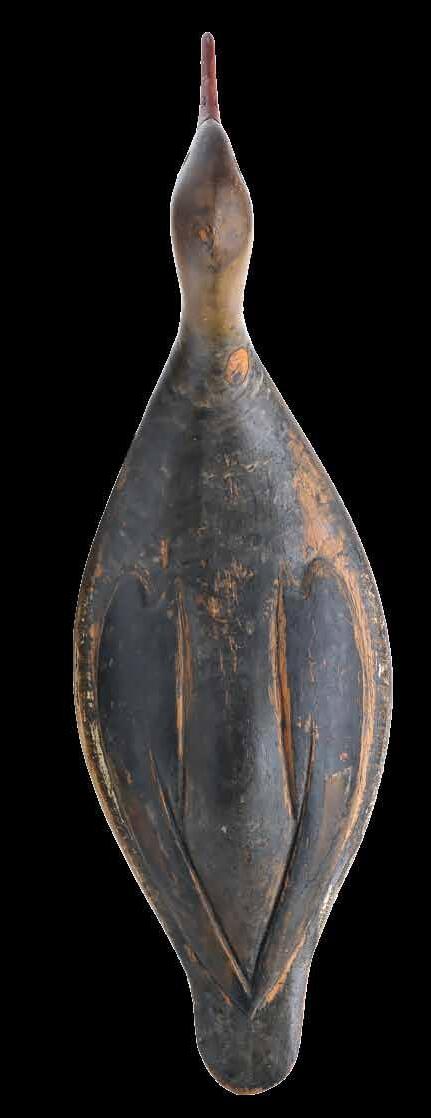
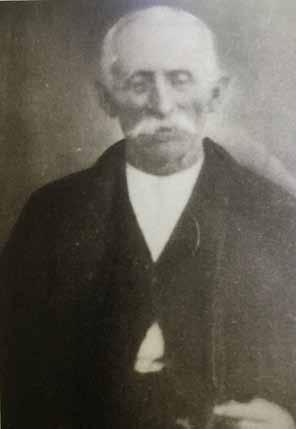
Franklin Wright was born on the Cape in Sandwich but, by 1885, he had moved to West Barnstable where he wed Dulcina Crocker. While in Barnstable, he worked his small farm but also held a variety of other occupations, ranging from whaler to mason and carpenter. He also gunned for the market, and his home near the town’s 3700 acre Great Marsh afforded him ample opportunity to take advantage of its abundant waterfowl. Obviously, to be successful, he would have needed decoys, and in true frugal Yankee fashion, he used his carpentry skills to fashion a small rig. Because the individual birds were solely for his own use, he could lavish whatever time and effort he deemed necessary to produce some truly exceptional, lifelike, creations. Today, very few examples of his craftsmanship have survived intact. The swimming merganser, as well as the diminutive whistler hen of comparable quality being offered here are among them (see lot 265) . Years after the death of Mr. Wright, both of these extraordinary decoys were found at a small gunning camp on Sandy Neck, a seven-mile-long barrier beach protecting the Great Marsh.
The camp had long been the retreat of the Swift family of Barnstable. When the decoys were first introduced to anyone outside the family, the camp was owned by Joseph Larkin (“Larkin”) Swift (1911 – 1966) of Osterville Village. It is unlikely that Larkin ever seriously gunned with Wright, but it is conceivable that his father Joseph (1887 – 1960) may have. The most likely family member, however, that would have known and perhaps hunted with Wright would have been his grandfather, Edgar (1852 –1945). This gentleman would have been contemporaneous with
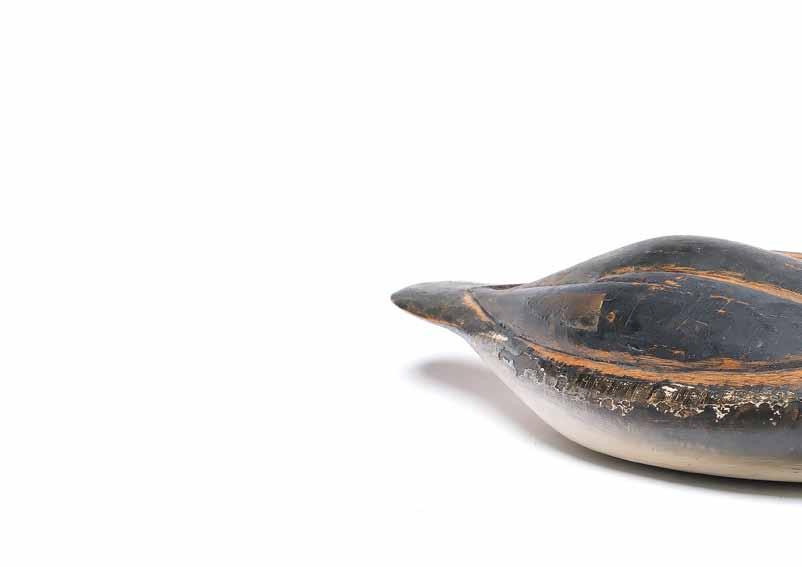
“The snakiest, raciest merganser ever found”
- Gigi Hopkins 2016
33 Franklin Pierce Wright (1854-1939) attributed, West Barnstable, Massachusetts. Important swimming merganser hen with carved eyes and relief wing carving. Griffith collection ink stamp on underside. Measures 17.5” long. Original paint that had been covered in a very thick coat of varnish; varnish was cleaned off of much of the decoy, with paint on back and sides taken down to some bare wood; decoy remains in excellent structural condition.
Provenance: Dr. Lloyd Griffith collection. Martin and Deborah Maloy collection.
Literature: “Decoys” by Gene and Linda Kangas, page 210, exact decoy pictured before varnish removal. “Massachusetts Masterpieces: The Decoy as Art” by Gwladys Hopkins, page 85, exact decoy pictured. (20,000 - 30,000)

Franklin Wright and the Swift family was involved with the meat and provision business in Barnstable. Edgar may have even purchased game from Wright when he was shooting for the market.
At some point, the two decoys were retired from active service and found homes as mementos of the hunt at the family camp. The merganser, unfortunately, must have resided too near the stove or fireplace and, over time, the surface became blistered from the heat. Although now battle scarred, its unquestionably beautiful form can still be enjoyed, as one imagines the numerous sportsmen over the years who appreciated it while at the small camp on Sandy Neck.
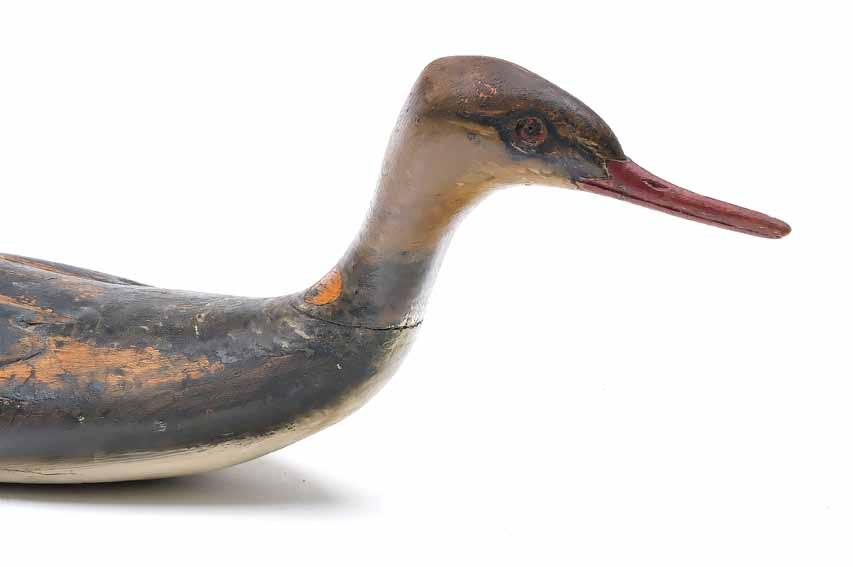
“One of the finest expressions of decoy artistry ever to have been discovered on Cape Cod or anywhere in North America” - Ted Harmon, 2011
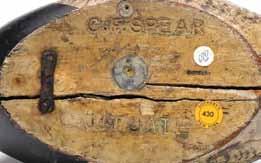
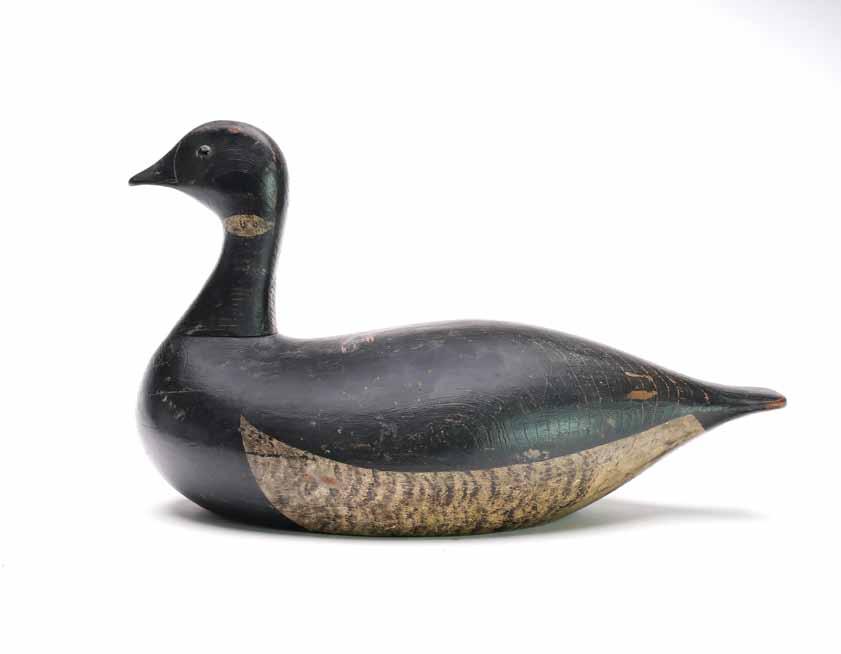
Joseph Lincoln (1859-1938), Accord, Massachusetts. Classic brant. Branded “C.F. Spear, Scituate” on the underside. Round inlayed weight on underside. Also with McCleery collection ink stamp and Sotheby’s auction sticker on underside. Measures 18” long. Original paint with moderate gunning wear; hairline crack at one side of neck base; hairline crack along back; typical split along the underside.
Provenance: Dr. James McCleery collection. Martin and Deborah Maloy collection.
Literature: “Call to the Sky: The Decoy Collection of Dr. James McCleery, MD”, page 31, exact decoy pictured.
(6,000 - 9,000)
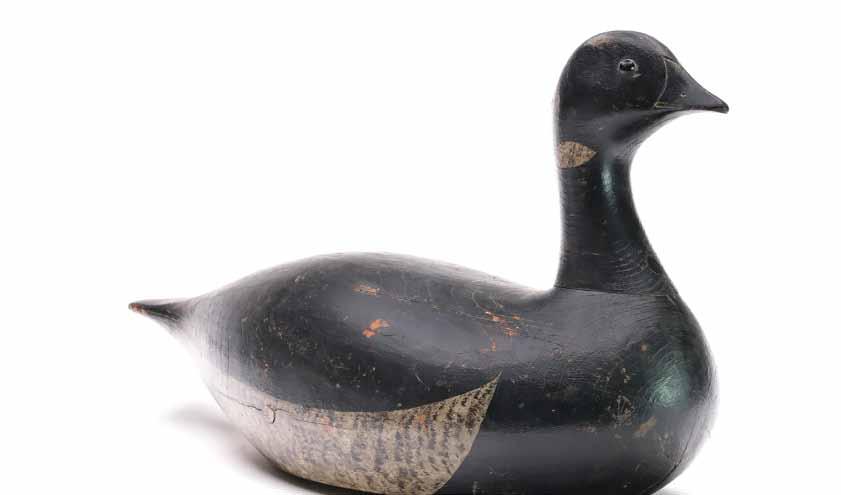
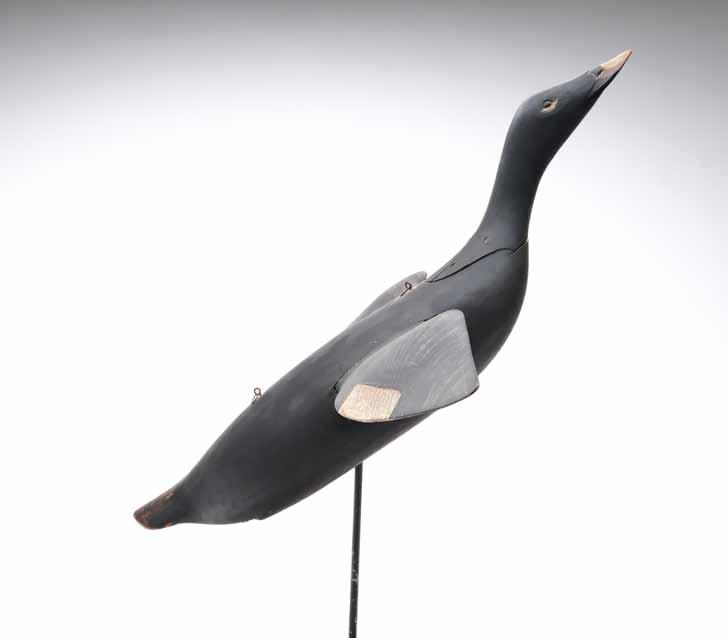

35 Augustus “Gus” Wilson (1864-1950), South Portland, Maine. Extremely rare and early flying scoter with inset wooden wings and rounded inlayed neck seat. Detailed bill carving and carved eyes. These earlier Wilson flyers feature curved wing carving and applied real duck feet. Measures 24.5” long, with a 29” wingspan. Original paint with minor to moderate wear; slight separation and tight cracks at neck seat; tight drying crack in breast; some separation and flaking to filler where wings are inlayed in to body; real duck legs were either removed or broke off and filler was added at the holes; hole drilled in underside to also be displayed as a stickup.
Provenance: Martin and Deborah Maloy collection. (6,000 - 9,000)
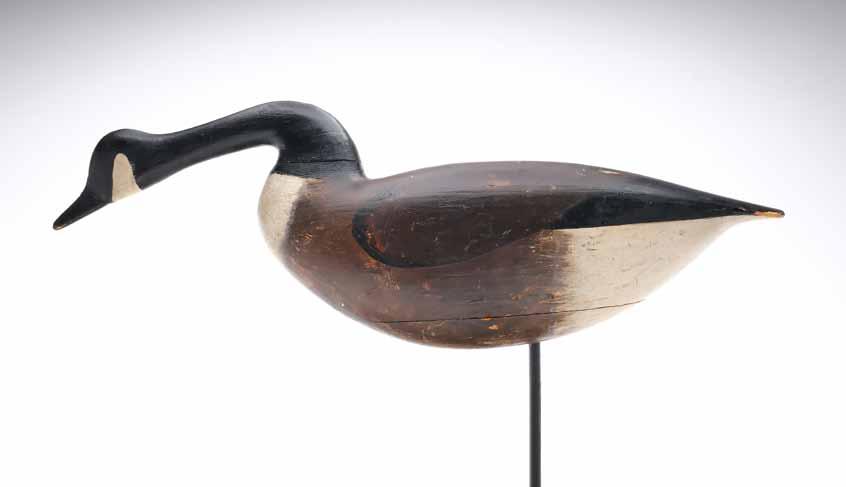
Samuel Soper (1863-1943), Barnegat, New Jersey. Rare feeding Canada goose. Hollow carved with outstretched neck. Made for use as a stickup decoy. Measures 30.5” long. Original paint with minor flaking and wear; restored crack through base of neck; minor roughness on sides of tail and one side of bill; old over paint was cleaned off of white areas on body.
Provenance: Martin and Deborah Maloy collection. (12,000 - 18,000)
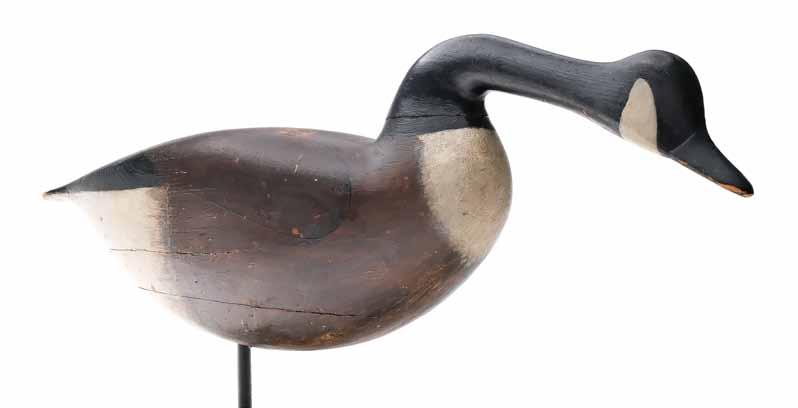
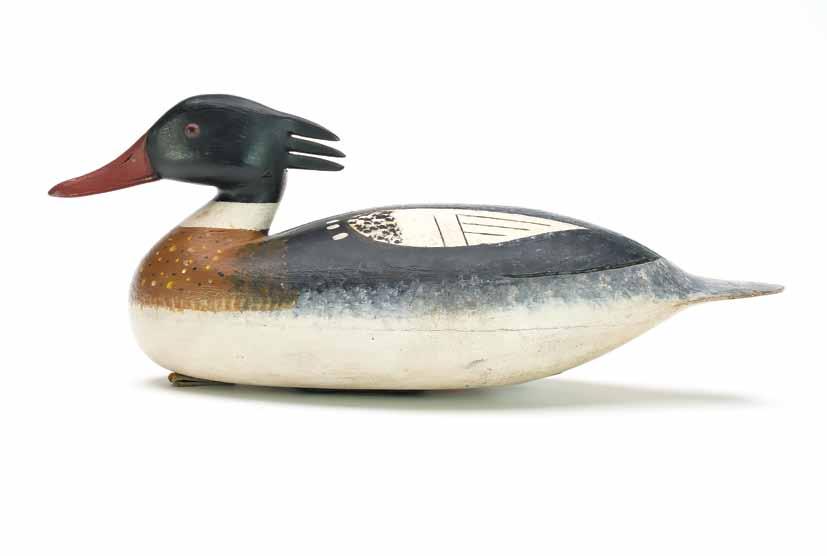
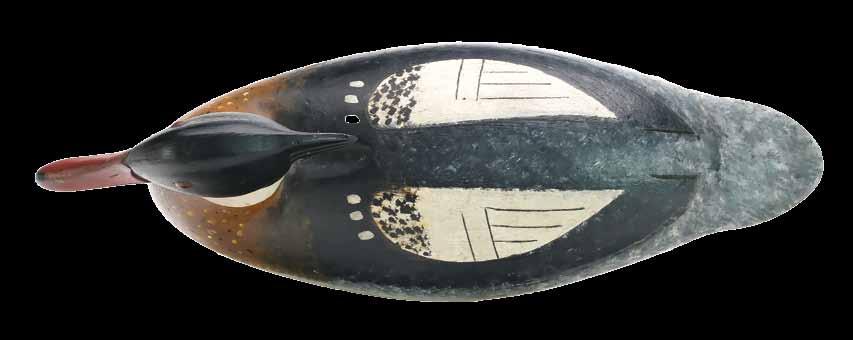
37 Nathan Rowley Horner (1882-1942), West Creek, New Jersey. Red-breasted merganser. Hollow carved with tack eyes and extended crest. Incised wingtip carving and slight ice groove behind neck seat. “JAH” branded in underside and Hillman collection ink stamp on underside. Measures 16.5” long. Original paint by Chris Sprague with very minor wear; a few very shallow dents, otherwise very good structurally.
Provenance: John Hillman collection. Martin and Deborah Maloy collection.
Literature: “Decoys of the Mid Atlantic Region,” Henry Fleckenstein, Jr., p. 25, exact decoy. “Decoys of the Jersey Coast and Delaware Valley,” Ken Gosner, p. 154, exact decoy. “Decoys: A North American Survey,” Gene and Linda Kangas, p. 199, exact decoy pictured. (6,000 - 9,000)
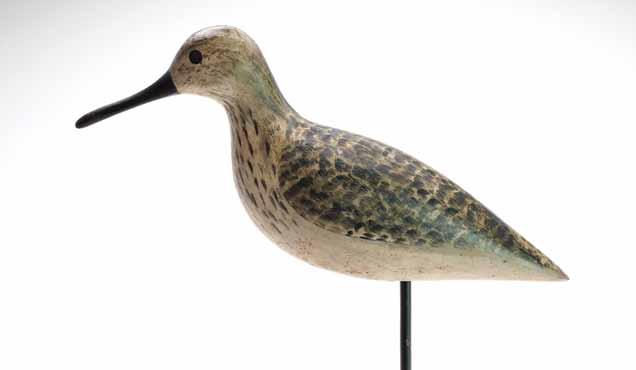
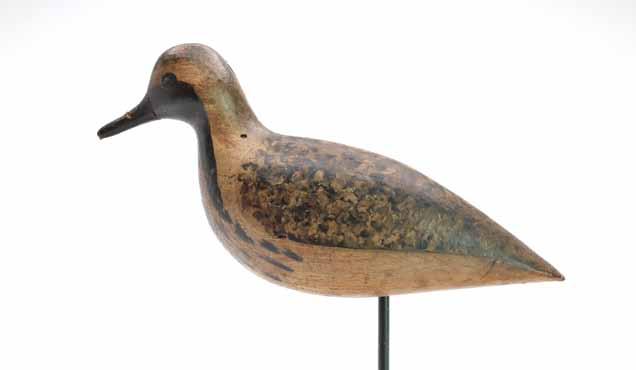
37A Harry V. Shourds (1861-1920), Tuckerton, New Jersey. Excellent yellowlegs. Mackey collection ink stamp on the underside. Measures 10.25” long. Original paint with very minor gunning wear; excellent structurally
Provenance: Martin and Deborah Maloy collection. (7,000 - 10,000)
37B Harry V. Shourds (1861-1920), Tuckerton, New Jersey. Black bellied plover in emerging plumage. Measures 10” long. Original paint with minor wear; under an early coat of varnish that has darkened with age; lightly hit by shot; the original bill was cracked down and reset with some roughness at bill tip.
Provenance: Martin and Deborah Maloy collection. (4,000 - 6,000)
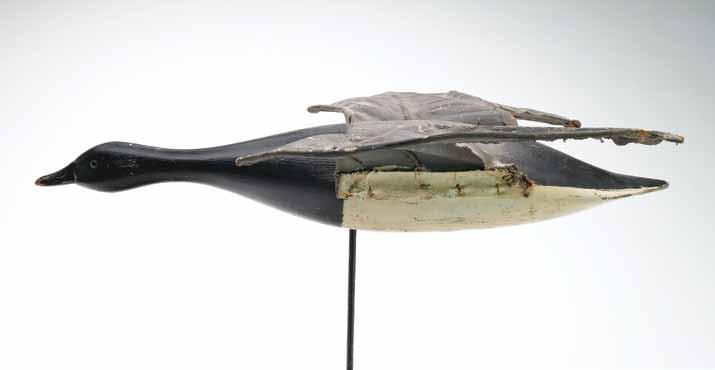
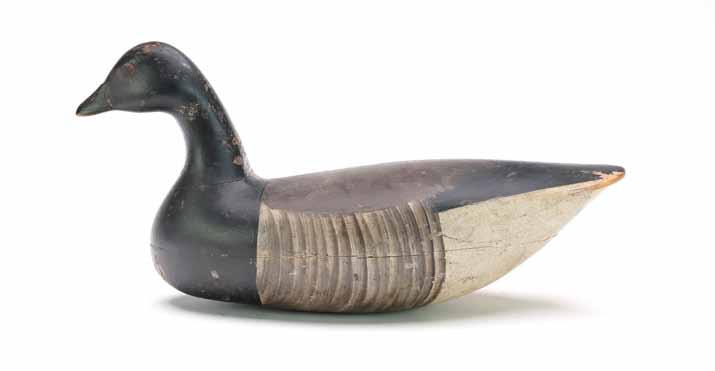
Harry V. Shourds (1861-1920), Tuckerton, New Jersey. Flying or stickup brant. Mackey collection stamp on underside. Wire and canvas wings mounted to sleek body as part of a rare gunning rig made for brant hunting. Measures 23” long. Original paint with some scratches; wear around the tail; tiny areas of flaking; several small spots of inpainting around the head area; and lower side of breast.
Provenance: Martin and Deborah Maloy collection.
Literature: “American Decoys” by Quintina Colio, foreword, exact decoy pictured. (3,000 - 5,000)
37D Harry V. Shourds (1861-1920), Tuckerton, New Jersey. Hollow carved brant with tack eyes and inlayed lead weight. Measures 16.5” long. Original paint with moderate flaking and wear; early coat of varnish has caused some tight crazing; flaking to filler at body seam; professional repair to a chip in lower part of bill.
Provenance: Martin and Deborah Maloy collection. (5,000 - 8,000)
38 Harry M. Shourds (1890-1943), Ocean City, New Jersey. Merganser hen. Hollow carved with extended crest feathers and inlaid lead weight. “0146” and “DSC” stamped in underside. Measures 16.5” long. Original paint with minor discoloration and wear; hairline cracks in one side of neck seat; a few tiny dents in tip of bill; slight separation at body seam.
Provenance: David Campbell collection. Ron and Carole Rezetko collection. Deborah and Martin Maloy collection.
Literature: “Classic New Jersey Decoys” by James R. Doherty, page 83, exact decoy pictured. (8,000 - 12,000)
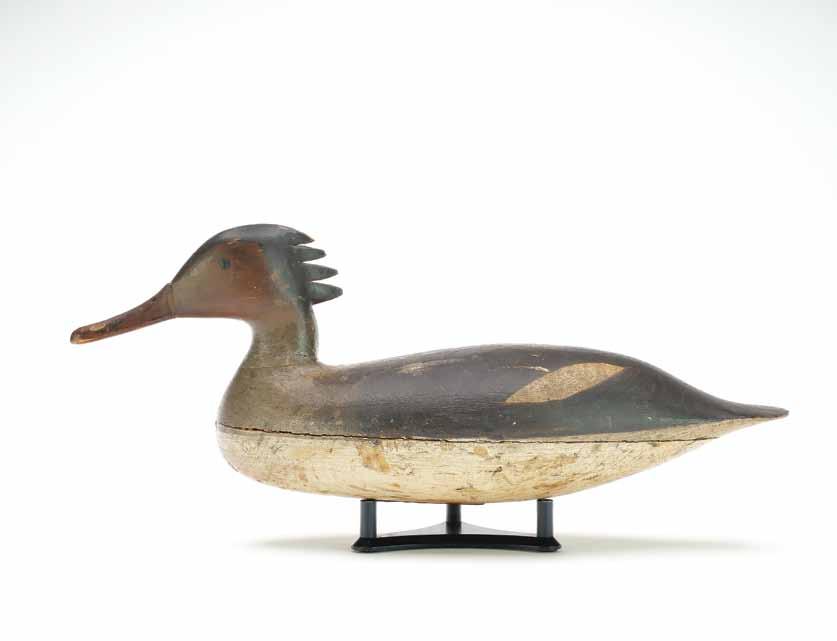
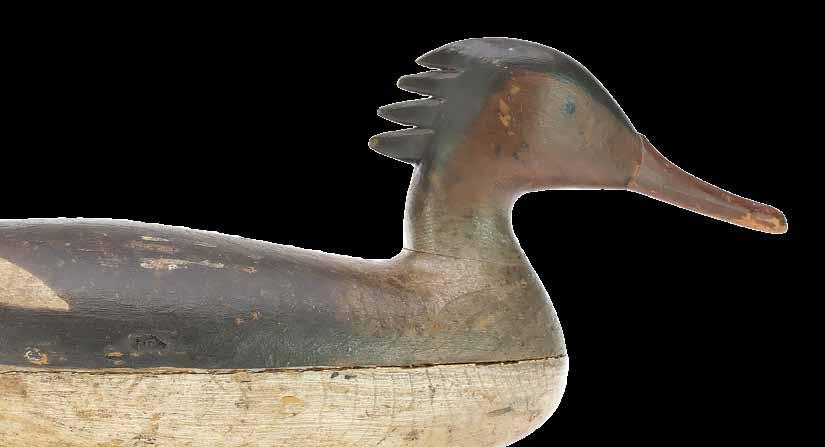
39 William Quinn (1915-1969), Yardley, Pennsylvania. Rare mallard hen. Hollow carved two piece body with tucked head and raised V wingtip carving. From Quinn’s personal rig with his name painted on underside. Measures 16.25” long. Original paint with very minor wear; a few minor dents; professional bill chip repair.
Provenance: Martin and Deborah Maloy collection.
(5,000 - 8,000)

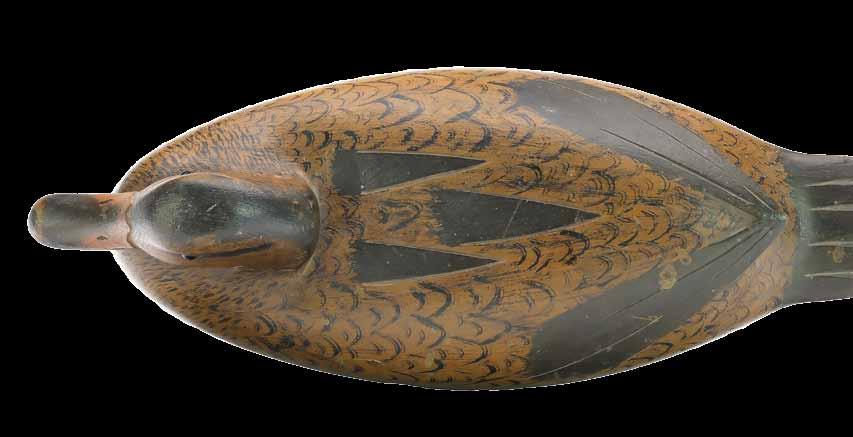

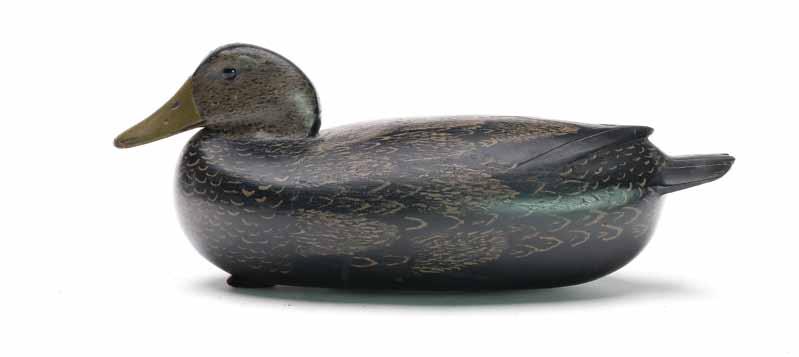
40 William Quinn (1915-1969), Yardley, Pennsylvania. Hollow carved black duck with raised “V” wingtip carving. Measures 16” long. Original paint with very minor wear; under a thin coat of varnish; hairline crack in one side of neck; professional tail chip repair with touchup in that area.
Provenance: Martin and Deborah Maloy collection. (3,000 - 4,000)
41 Dan English (1883-1962), Florence, New Jersey. Low head black duck. Hollow carved with raised V wingtips. Measures 14.75” long. Original paint with very minor wear; tight crazing and flaking on head; thin coat of varnish has flaked in areas.
Provenance: Martin and Deborah Maloy collection. (2,500 - 3,500)


42 Lloyd Johnson (1910-1965), Bay Head, New Jersey. Outstanding pair of greenwing teal. Hollow carved with turned heads and raised wingtips. Relief wing and tail feather carving. Fine comb feather paint detail on drake. Both branded and signed by the maker. Both stamped “Penn” and drake numbered 101, hen 102. Measure 10.25” long. A few very minor paint rubs and scratches, mostly on drake, otherwise both near mint.
Provenance: Martin and Deborah Maloy collection. (3,000 - 5,000)
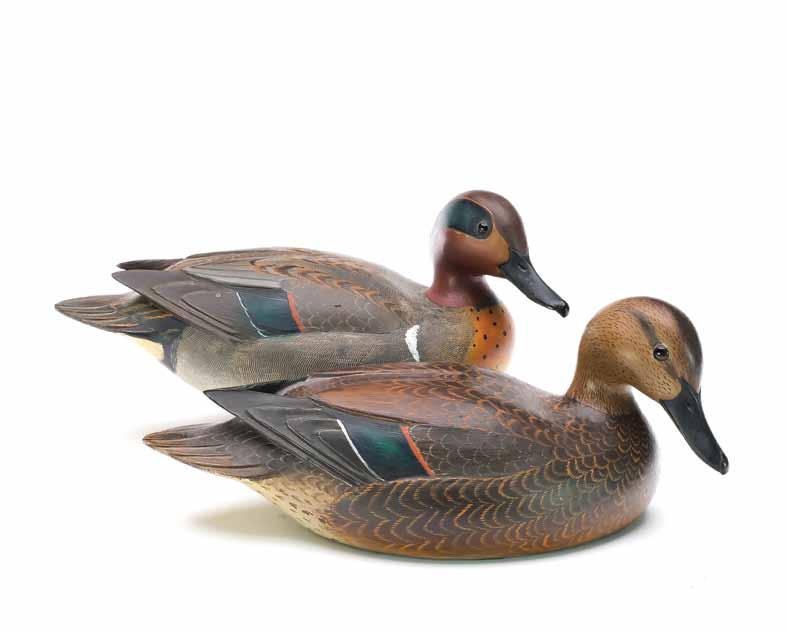
Certain events in the decoy world are universally viewed as benchmarks. In 1934, Joel Barber first drew widespread attention to the decoy as something far beyond a simple tool when he published his seminal “Wildfowl Decoys”. Other early references followed, and in 1965, auctioneer Richard Bourne on Cape Cod first tested the decoy auction market with his inaugural sale focused purely on decoys. In 1973/74, and again in 1986, Bourne drew the attention of the collecting world when he first sold the collection of noted author and authority William Mackey, then that of Dr George Ross Starr. It was at the sale of the Mackey collection that the wider decoy community first took notice of a gentleman whom Bourne simply referred to as “The distinguished Doctor from Texas” . At that auction Jim McCleery shocked the audience when he paid the astonishing and then unheard of price of $10,500 for a New York shorebird.
James Merida McCleery (1924 – 1999) was born in Oklahoma and enjoyed his youth hunting, fishing and trapping. He served proudly in the Navy during WWII and then entered medical school where he, unfortunately, contracted a rare spinal disease that confined him to a wheelchair for the remainder of his life. Undeterred, he became a practicing pathologist at the Pasadena Bayshore Hospital outside of Houston,
Texas. He had always been a collector, first of stamps and coins, then in the early 1960s he became mildly interested in decoys. After his daughters were grown and had “moved out of the house” his interest intensified, and he began to collect in earnest. Ultimately, he would amass what many consider the very finest collection ever assembled. His focus was laser sharp, zeroing in on the best examples of the decoy from Maine to California and from Canada to Louisiana. His was a collection of masterworks. As noted by Robert Shaw in the introduction to his exhibition book on the collection, “Call to the Sky”; “He (McCleery) did not reject a piece out of hand if it showed some legitimate wear”. “His criteria were quality of expression and the craftsman’s ability to capture an impression of life in wood – the hallmarks of the subtle and deceptively simple art of the decoy” . His close friend Ron Gard has remarked “He had a true instinct for form, surface and condition, as well as a keen sense of history”.
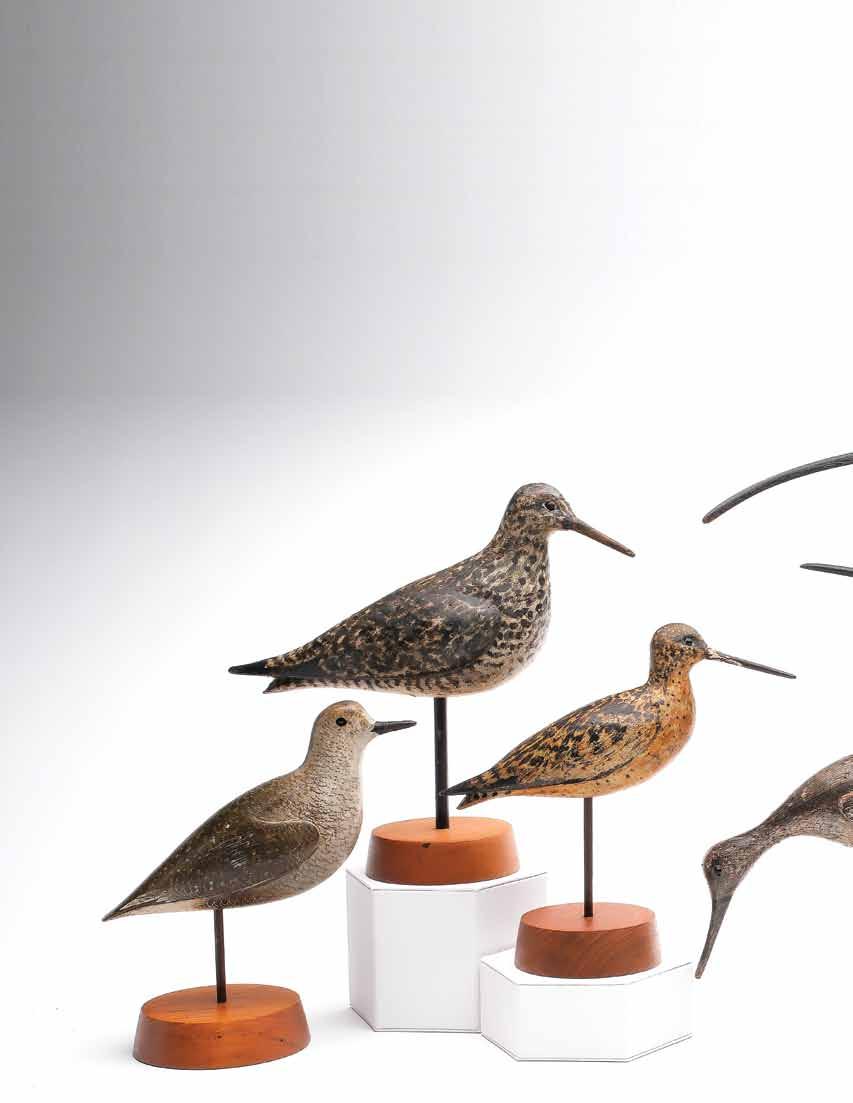
“Dr
McCleery and his collection are the soul and substance of which legends are made”.
- Nancy Druckman, Sotherby’s, NY, 2000
When his collection was sold in New York in January of 2000 by the team of Sotheby’s and Guyette and Schmidt (now Guyette and Deeter), the decoy community, as well as the larger antique and art world in general, once again gazed in awe at the collection of the “distinguished Doctor from Texas”. The auction was widely reported in trade publications as well as larger, more mainstream newspapers, such as The New York Times. Grossing just under eleven million dollars, it was, and remains, the most valuable decoy collection ever sold. His astute eye and connoisseurship were respected by all, and this was reflected in the astounding prices realized. At the time of the sale, the highest price for an individual decoy was realized, 62 new
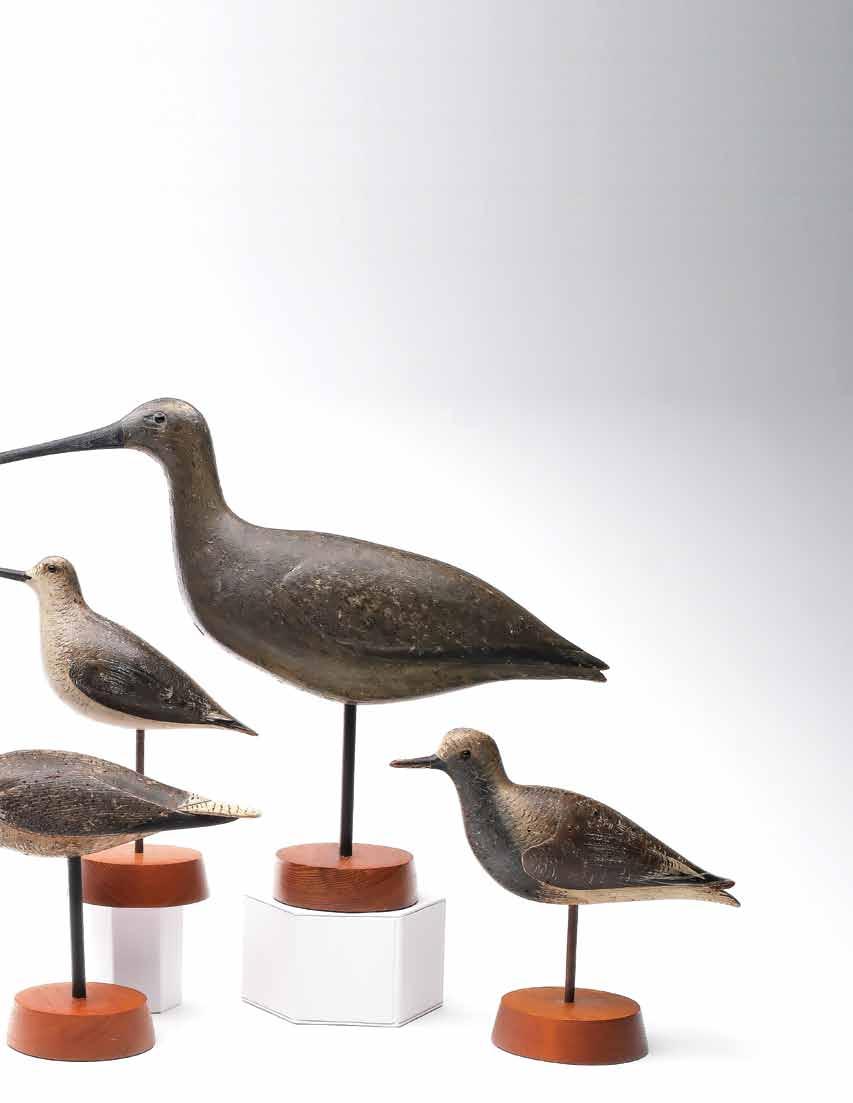
auction records were established for individual carvers, and the total sales were four times that of the next highest grossing decoy auction to date and one-anda- half times higher than the total sales for all decoy auctions in any individual year.
As noted in the introduction to the New York sale, “He saw the art of the gunning decoy whole and with greater clarity than anyone before him, and his extraordinary collection represents the very best of what the decoy has to offer” . Decoys carrying his provenance display a certain pedigree that will live with future collectors fortunate enough to acquire one.
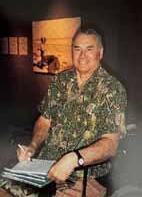
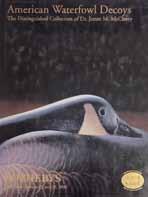

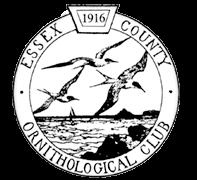
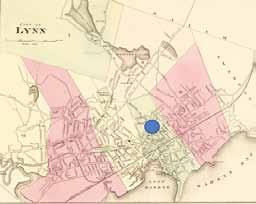
For many years, Boston and its suburbs had been the hub of nature study in the State, particularly the early study of ornithology. Random records of birds appear in the Massachusetts literature dating to as early as the founding colonists, but these, understandably, centered around their relative availability as a source of necessary food or feathers. Soon, these accounts indicated an interest in birdlife beyond these basic needs. By 1799, Salem ship captains banded together to form the East India Society with one of the goals being “to establish a cabinet of natural and artificial curiosities”. These formed the basis f or today’s Peabody Essex Museum’s natural history collections. In 1854, Concord resident, transcendentalist, and naturalist Henry David Thoreau, penned his popular “Walden” or “A Life in The Woods”. Harvard University had long played a leading role in nature study and, in 1859, based on his collection of birds acquired in the Boston markets a few years earlier, Professor Louis Agassiz founded the Museum of Comparative Zoology. In 1873, William Brewster and a group of young fellow naturalists in Cambridge formed the Nuttall Ornithological Club, the first o f its kind in the country. 1896 saw the founding of the extremely influential Massachusetts Audubon Society. All of these early organizations were the forerunners and inspiration for the organization of the Essex County Ornithological Club in 1916, with Nichols as an early and enthusiastic member. His membership was something that surely did not just happen on a whim and he must have been deeply interested in ornithology for some time previous.
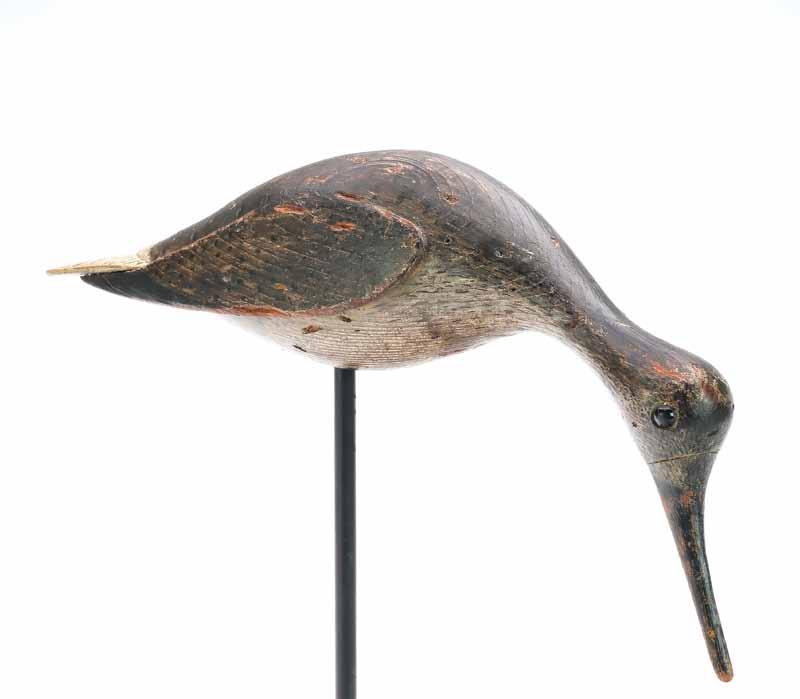
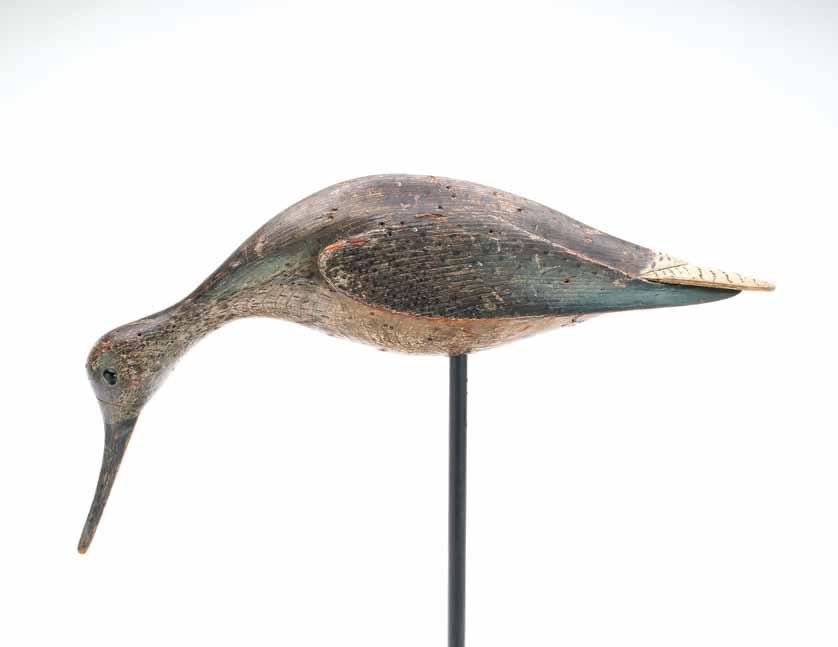
42A Fredrick Melville Nichols (1854-1924), Lynn, Massachusetts. Very rare feeding yellowlegs with deep relief wing carving and inserted cedar tail. “N” branded in underside near metal lined stick hole. Measures 12” long. Original paint with moderate gunning wear; hit by shot in each side; bill and lower part of face is a very well done professional replacement; tail and tips of dropped wings were also professionally replaced at some point, with a fine hairline crack in tail.
Until the late 1800s, ornithology was a far different pursuit than it is today. This was a time before the widespread availability of quality binoculars and cameras and the study of birds tended to center around identifying and physically amassing collections of as many different species as possible, including examples of their nest and eggs. In 1874 Dr Elliott L Coues, one of the founders of the American Ornithologist Union wrote an influential and widely read book titled “Field Ornithology – Manuel of Instruction and a Check List of North American Birds”. The first five lines of the first chapter read :
“THE DOUBLE BARRELLED SHOT GUN is your main reliance. Under some circumstances you may trap or snare birds, catch them with bird lime, or use other devices; but such cases are exceptions to the rule that you will shoot birds, and for this purpose no weapon compares with the one just mentioned”.
Provenance: Dr. James McCleery collection. Martin and Deborah Maloy collection.
Literature: “Decoys” by Gene and Linda Kangas, page 311, exact decoy pictured.
“Bird Decoys of North America” by Robert Shaw, page 169, exact decoy pictured.
“Call to the Sky: The Decoy Collection of Dr. James McCleery, MD”, page 9, exact decoy pictured. (60,000 - 90,000)
This was the mindset of many of those interested in birds during Fred Nichols’ lifetime. At this late date, no one can say with certainty if Fred was shooting primarily for sport, food, or collecting purposes. Whatever his reason, the best decoys he could procure would enhance his chances of success. We do know he was very interested in ornithology and his membership in the Essex County Bird Club brought him into contact with others with similar interests, such as Dr John C Phillips and Frank Benson. If he maintained his own ornithological “cabinet” (collection) or he simply took advantage of his access to those at the Peabody Essex Museum or those of other hobbyists for use as models is uncertain. What is certain is that he created some of the most sculpturally magnificent working shorebird decoys of his day. Animated and anatomically accurate in all respects, his carvings would have been the envy of his peers and would have ensured him the greatest success in the marsh and moors.
All researchers who have tried to elaborate on the life of the carver of these exquisite shorebirds have met with defeat. Originally identified as the work of Capt. Jess Birdsall by Bill Mackey, th ey are now conceded to be the effort of John Dilley of Quogue, Long Island, New York c. 1900. This attribution stems from the fact that an early box containing some of the carvings had that name written on it and many examples found in different parts of the country have that name written under the tail in the same handwriting. They are best described by Robert Shaw in “Call to the Sky”: “Whoever he was, Dilley had intimate and detailed knowledge of the complex and often confusing seasonal plumage phases of shorebird species. No other painter depicted as many different plumage phases, and no one else lavished such attention to deta il. Dilley’s paint was applied layer upon layer in thin strokes with an extremely fine brush to create an extravagantly complex surface. ”
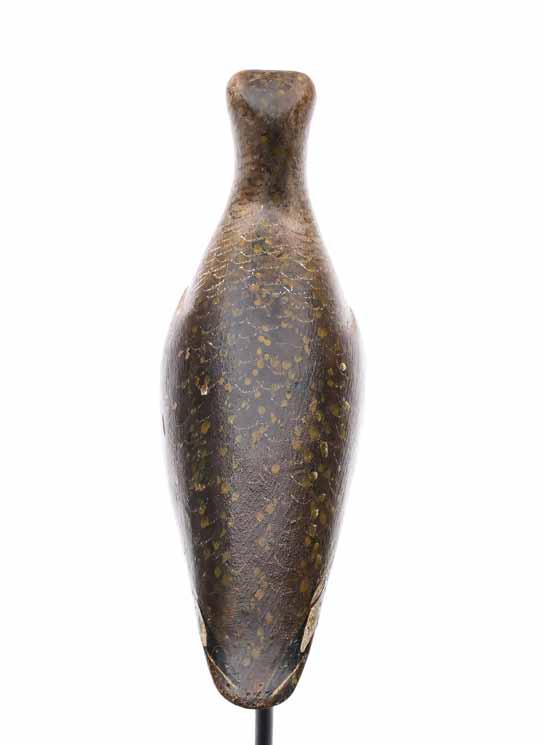

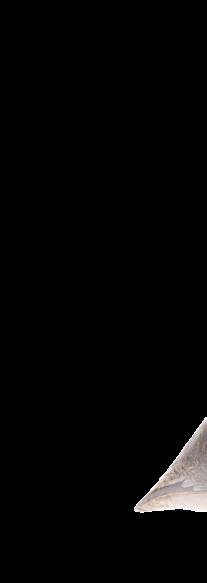
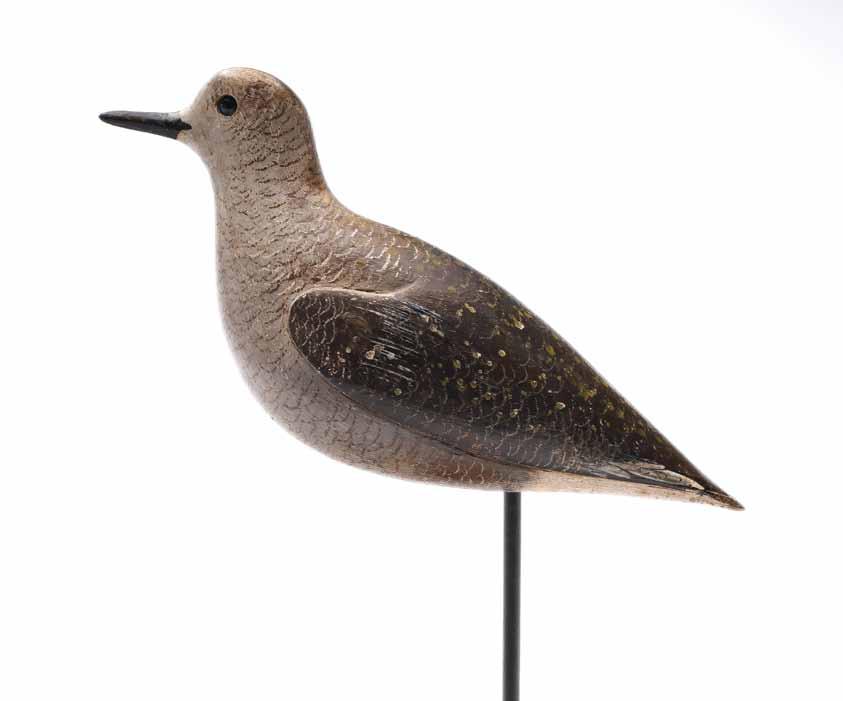

43 John Dilley (late 19th century), Quogue, Long Island, New York. Golden plover with deep relief wing carving. McCleery collection ink stamp on underside. Measures 10.25” long. Original paint with very minor wear; under multiple thin coats of varnish; appears to have had small spots of touchup on the widest parts of head.
Provenance: Dr. James McCleery collection. Martin and Deborah Maloy collection.
Literature: “Call to the Sky: The Decoy Collection of Dr. James McCleery, MD”, page 41, exact decoy pictured. (20,000 - 30,000)
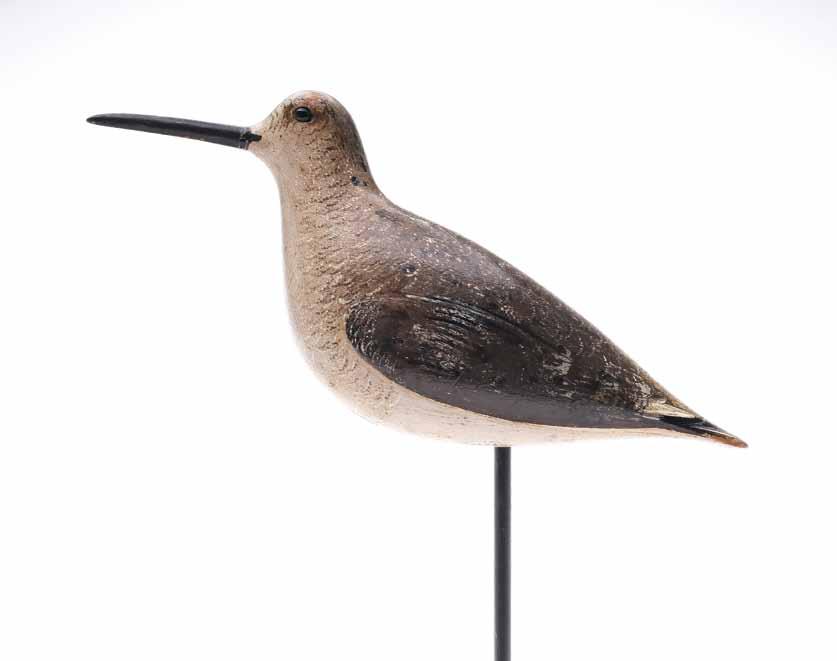
44 John Dilley (late 19th century), Quogue, Long Island, New York. Dowitcher in winter plumage. Slight relief wing carving. McCleery and Mackey collection ink stamps on underside. Measures 10.25” long. Original paint with minor wear; under an early coat of varnish; a second stickup hole drilled in underside; some touchup to flaking on bill.
Provenance: Dr. James McCleery collection. Martin and Deborah Maloy collection.
Literature: “Call to the Sky: The Decoy Collection of Dr. James McCleery, MD”, page 41, exact decoy pictured. (10,000 - 14,000)
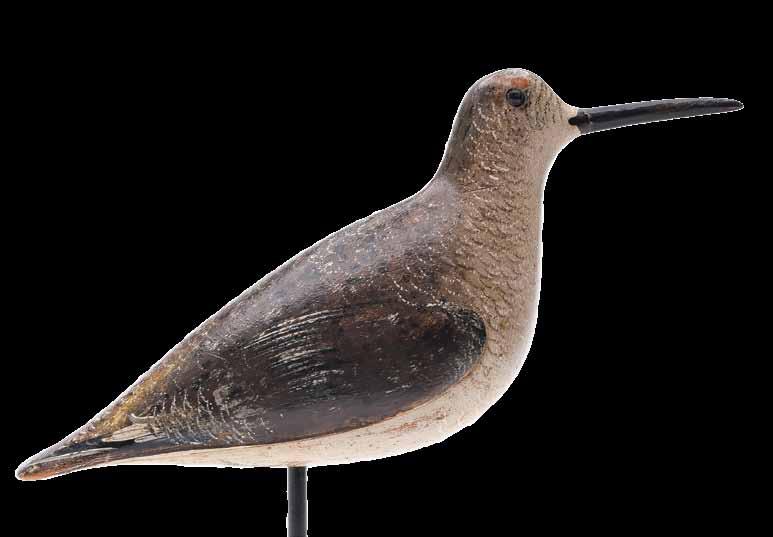
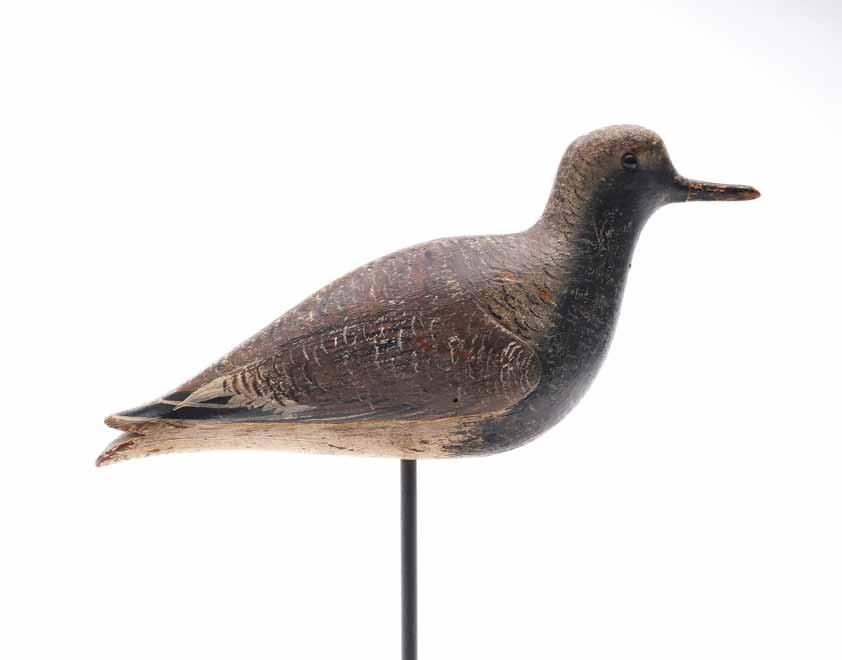

45 John Dilley (late 19th century), Quogue, Long Island, New York. Rare black bellied plover with relief wing and split tail carving. “Dilley” written in pencil on underside. Also with the McCleery collection ink stamp on underside. Measures 10.5” long. Original paint with minor to moderate wear; roughness around stick hole; lightly hit by shot.
Provenance: Dr. James McCleery collection. Martin and Deborah Maloy collection.
Literature: “The Great Book of Waterfowl Decoys”, Joe Engers, editor, page 108, exact decoy pictured. (8,000 - 12,000)

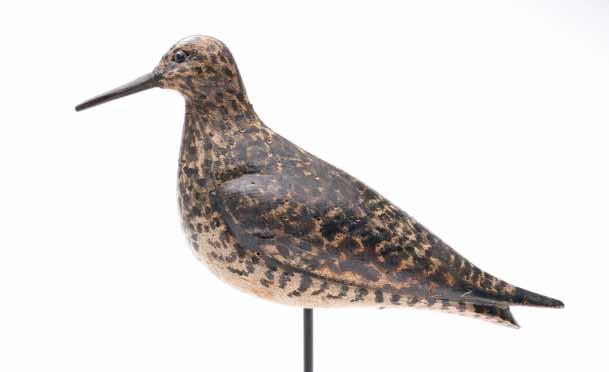
46 William Bowman (1824-1906), Lawrence, Long Island. Dowitcher with relief wing carving and raised wingtips. McCleery collection ink stamp on underside. Measures 10.25” long. Original paint with moderate wear; chipping at stick hole and at wingtips, with some touchup at wingtips; bill is a professional replacement; a chip in the bill was tightly reset.
Provenance: Dr. James McCleery collection. Martin and Deborah Maloy collection.
(6,000 - 9,000)
47 William Bowman (1824-1906), Lawrence, Long Island. Willet with relief wing carving and raised wingtips. McCleery collection ink stamp on underside. Measures 12.5” long. Original paint with minor to moderate wear under an early coat of varnish; crack through neck with a small nail added to secure; bill is an early replacement.
Provenance: Dr. James McCleery collection. Martin and Deborah Maloy collection.
(8,000 - 12,000)

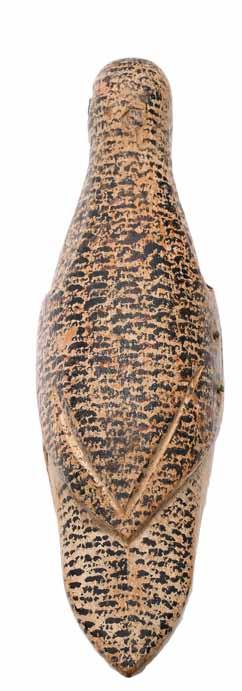
48 Obediah Verity (1813-1901), Seaford, Long Island, New York. Running peep with relief wing carving and carved eyes. Measures 7.25” long. Original paint with minor gunning wear; two tiny nails added to one side; dent in one side and a small defect in wood in underside of tail.
Provenance: Martin and Deborah Maloy collection. (8,000 - 12,000)
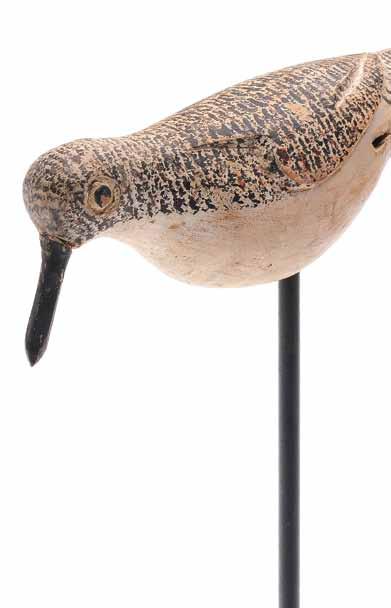

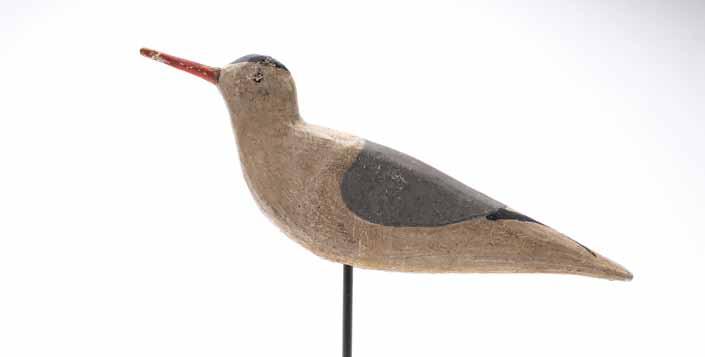
49 John Henry Verity (1788-1866), Seaford, Long Island, New York. Large curlew with carved eyes. Measures 14.75” long. Early in use repaint with moderate flaking and wear; many dents and shot marks; bill is an early replacement; cracks along top and back of head with an old screw added at one eye to secure.
Provenance: Martin and Deborah Maloy collection. (4,000 - 6,000)
50 Unknown maker, Long Island, late 19th century. Glass eye tern in running pose. Measures 13.25” long. Very old paint with moderate crazing and wear; very good structurally.
Provenance: Martin and Deborah Maloy collection. (1,500 - 2,500)
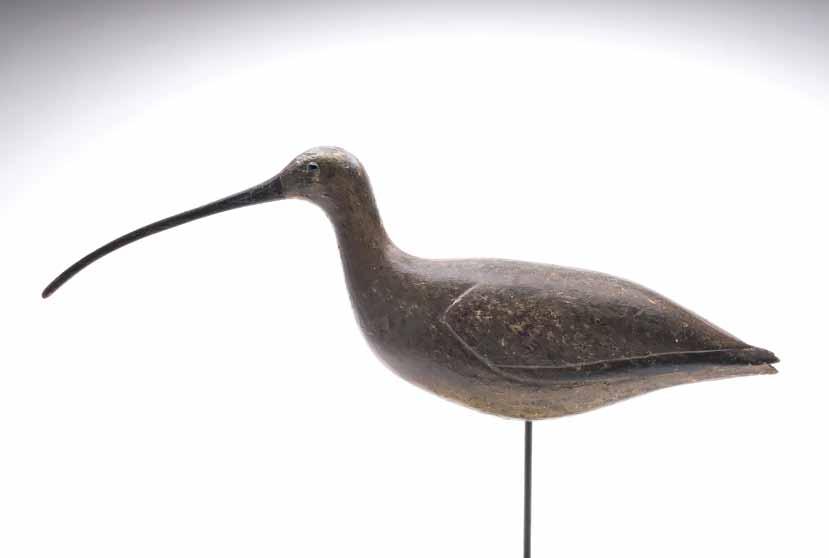
51

Unknown maker, New Jersey, late 19th century. Very large curlew with two piece laminate body. Relief wing carving with raised wingtips. Small “P” branded on underside. McCleery collection ink stamp on underside. Measures 22.5” long. Thick original paint with moderate crazing and wear; under an early coat of varnish; small dents and shot marks; old chipping at wingtips; bill is a very well done professional replacement.
Provenance: Dr. James McCleery collection. Martin and Deborah Maloy collection. (10,000 - 14,000)
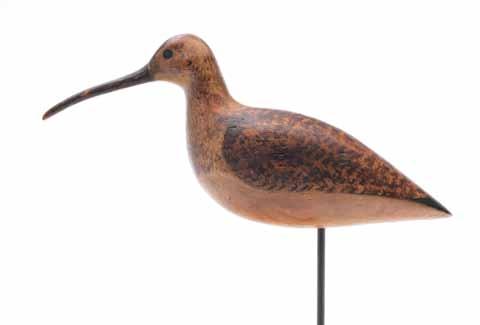
53 Daniel Lake Leeds, (1852-1922), Pleasantville, New Jersey. Robin snipe with relief wing carving. Measures 9” long. Original paint with moderate flaking and wear; some roughness on tip of tail; bill is an early replacement.
Provenance: Martin and Deborah Maloy collection. (4,000 - 6,000)
52 Harry V. Shourds (1861-1920), Tuckerton, New Jersey. Curlew. “JB French” ink stamp on underside. Measures 12.75” long. Original paint with moderate wear; small dents and shot marks; retains the original bill.
Provenance: Joe French collection. Martin and Deborah Maloy collection. (4,000 - 6,000)
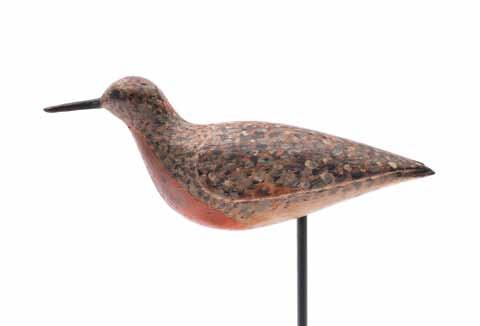

54 Daniel Lake Leeds, (1852-1922), Pleasantville, New Jersey. Black bellied plover with relief wing carving and wide beetle style head. Original baleen bill. Measures 9.25” long. Original paint with minor to moderate wear; under a thin coat of varnish; some separation to baleen on tip of bill; otherwise very good structurally.
Provenance: Martin and Deborah Maloy collection. (2,500 - 3,500)
55 A. Elmer Crowell (1862-1952), East Harwich, Massachusetts. Golden plover with brass tack eyes and split tail carving. Measures 9.5” long. Original paint with very minor wear; two spots of restoration on underside where wire legs were removed.
Provenance: Martin and Deborah Maloy collection. (10,000 - 14,000)
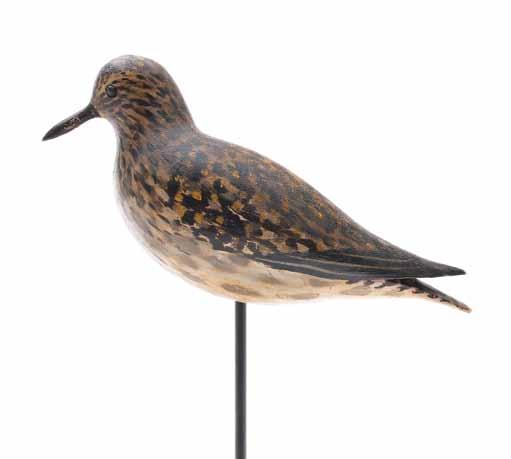
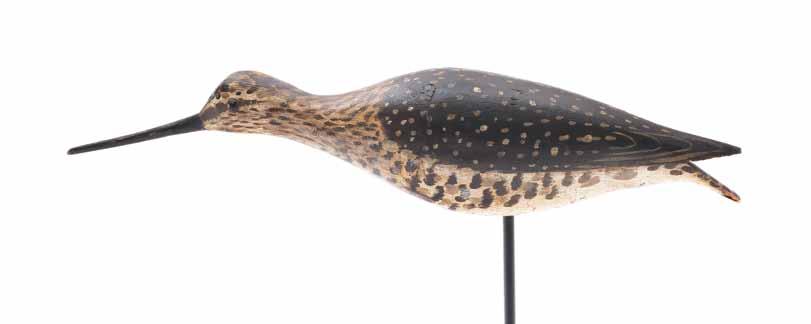
56 A. Elmer Crowell (1862-1952), East Harwich, Massachusetts. Running yellowlegs with tack eyes and split tail carving. Measures 14” long. Original paint with minor gunning wear; heavily hit by shot in one side; small spot on back with some touchup; tiny chip in wingtips; half of the bill is a professional replacement.
Provenance: Martin and Deborah Maloy collection. (7,000 - 10,000)

57 Elisha Burr (1839-1909), Hingham, Massachusetts. Greater yellowlegs with relief wing carving and extended wingtips. Measures 14.25” long. Excellent original paint with very minor wear; some blunting at tip of tail; drying crack in one side; bill is a professional replacement with restoration where it meets the face.
Provenance: Martin and Deborah Maloy collection. (7,000 - 10,000)
58 Elisha Burr (1839-1909), Hingham, Massachusetts. Feeding yellowlegs. Deep relief wing carving with extended wingtips. Muller collection ink stamp on underside. Measures 13.5” long. Original paint with moderate flaking and wear; under an early coat of varnish that has darkened with age; very lightly hit by shot; one bead eye is missing; some chipping where the original bill meets the face.
Provenance: Martin and Deborah Maloy collection. (6,000 - 9,000)
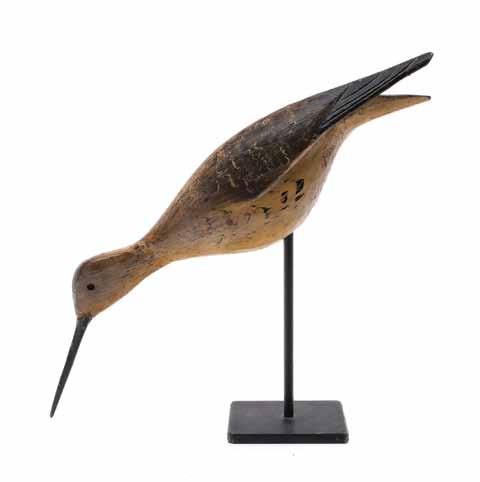
59 William Southard (1874-1940), Seaford, Long Island, New York. Running yellowlegs with relief wing carving and carved eyes. Measures 12.25” long. Original paint with minor to moderate wear; moderately hit by shot in one side; bill is a professional replacement.
Provenance: Martin and Deborah Maloy collection. (4,000 - 6,000)
60 Obediah Verity (1813-1901), Seaford, Long Island, New York. Plump black bellied plover with relief wing carving and carved eyes. Measures 11.5” long. Early in use repaint with minor crazing and wear; heavily hit by shot; bill is an early replacement.
Provenance: Martin and Deborah Maloy collection. (2,000 - 3,000)
61 Captain Al Ketcham (1845-1926), Long Island, New York. Rare ruddy turnstone with relief wing carving and carved eyes. Measures 7.75” long. Original paint with moderate wear; early coat of varnish; bill is an early replacement.
Provenance: Martin and Deborah Maloy collection. (1,500 - 2,500)
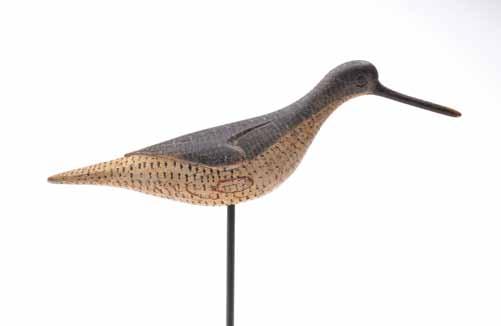
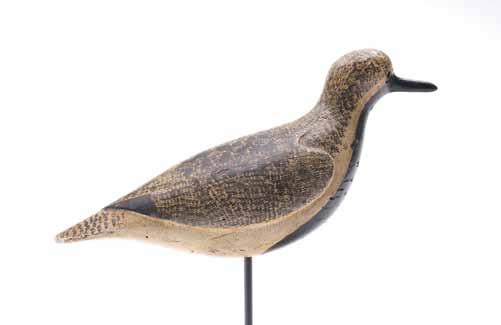

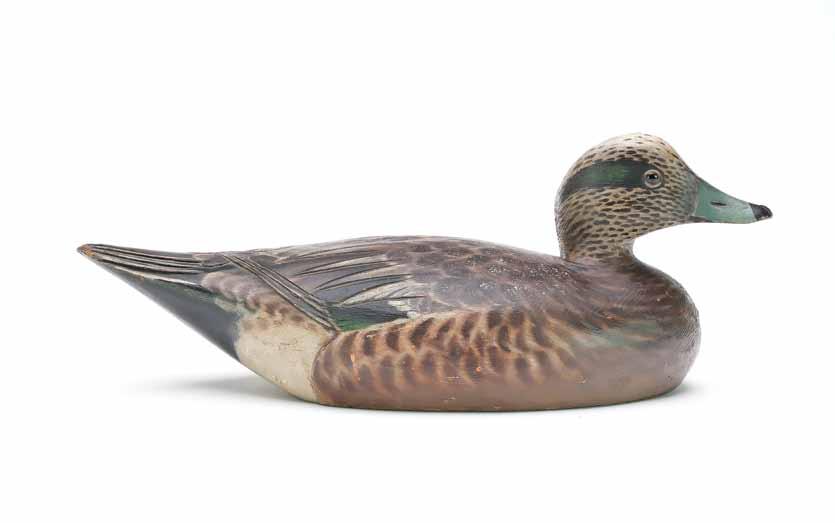
62 A. Elmer Crowell (1862-1952), East Harwich, Massachusetts. Widgeon with slightly turned head. Slightly raised, crossed wingtips. Deep relief tail carving and extra incised wing feather carving. Maker’s signature and rectangle stamp on underside. Measures 14.75” long. Original paint with very minor flaking and wear; small chip was shaved down on tip of tail; small amount of filler restoration at front of neck seat.
Provenance: Martin and Deborah Maloy collection. (10,000 - 14,000)
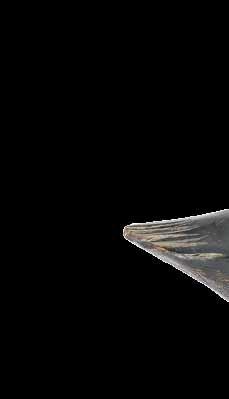


63
A. Elmer Crowell (1862-1952), East Harwich, Massachusetts. Mallard with slightly turned head. Raised wingtips and relief tail feather carving. Maker’s rectangle stamp on the unpainted underside. Measures 16.75” long. Original paint with very minor wear; thin coat of varnish has caused some tight paint crazing on breast and under tail area; tight crack through neck; small knot with sap bleed visible on one side.

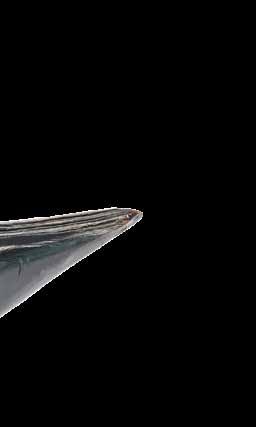
Provenance: Martin and Deborah Maloy collection.
(6,000 - 9,000)
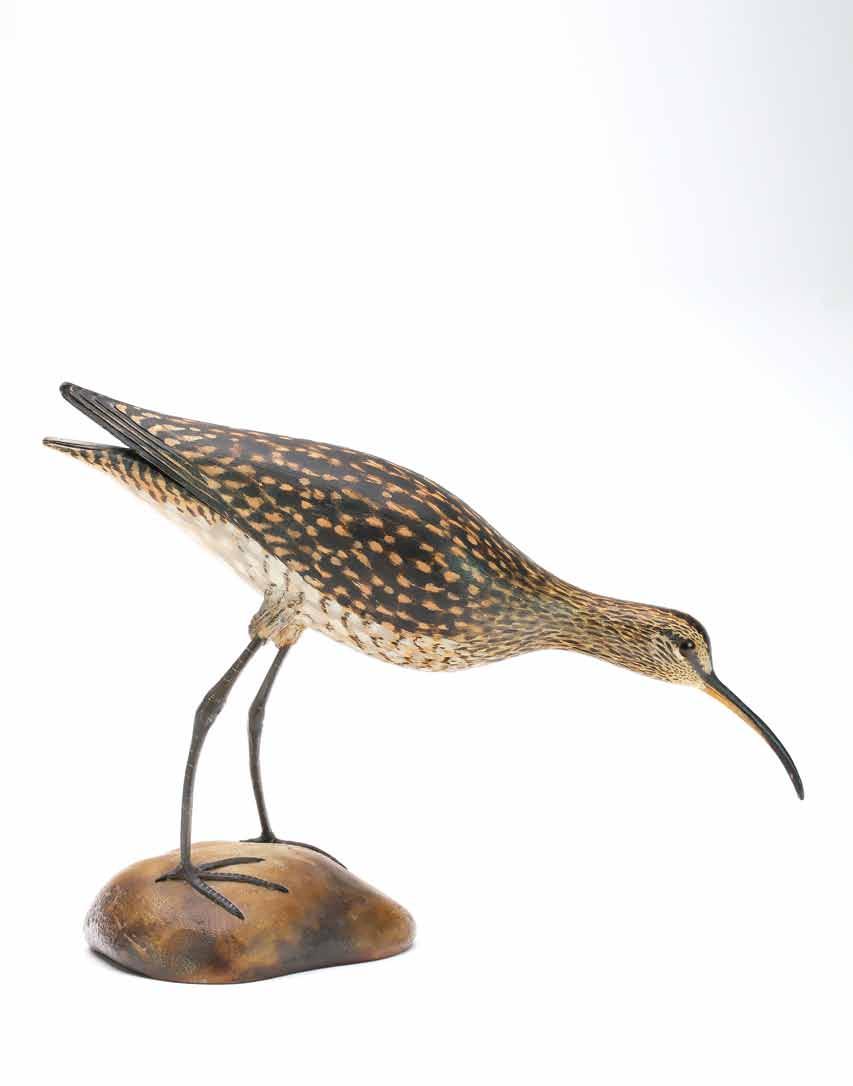
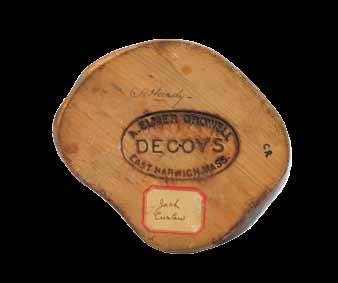
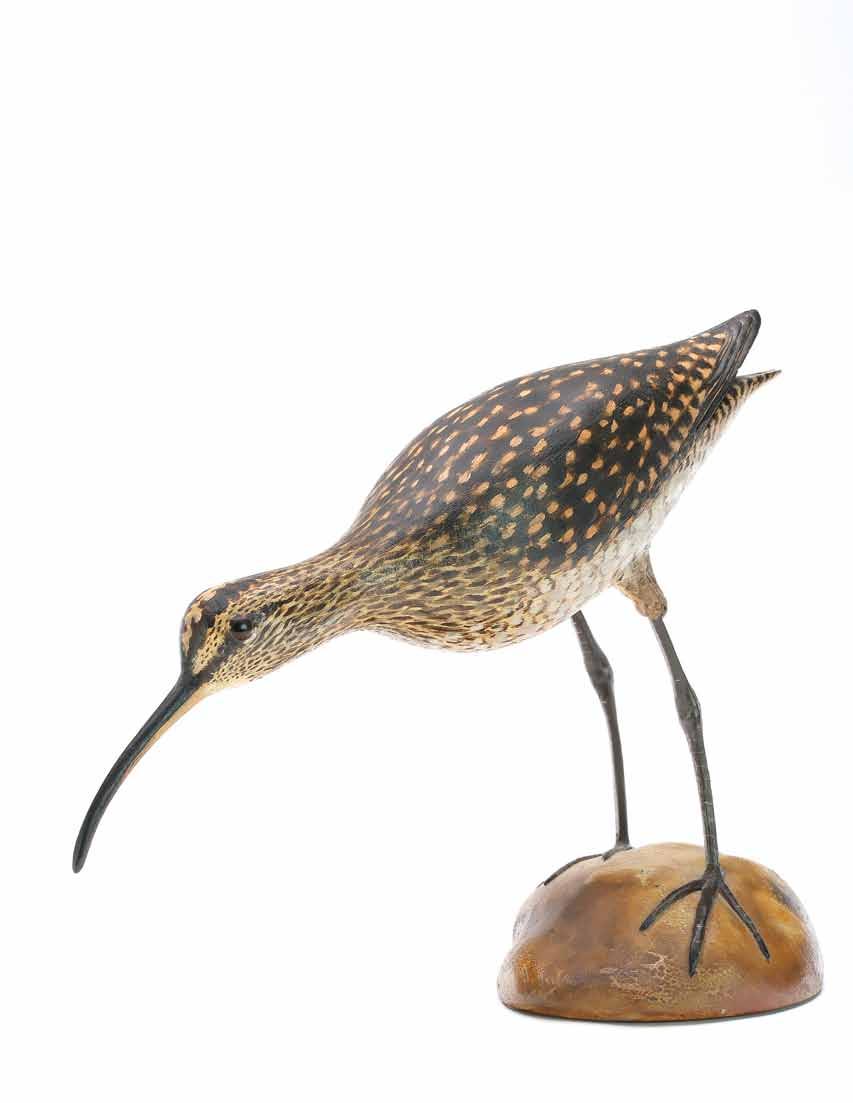
64 A. Elmer Crowell (1862-1952), East Harwich, Massachusetts. Important decorative jack curlew. In feeding pose with raised wingtips and relief wing and tail feather carving. Maker’s crisp oval brand in underside of base. Also signed “C.A. Hardy”.
Measures 16.75” long, stands 11.5” tall. Excellent original paint with a few tiny rubs on bill that were touched up; early restoration to gesso thighs and legs; area of paint shrinkage on each side of base.
Provenance: This carving was a gift from Elmer Crowell to Charles Hardy. Carolyn Rowland collection. Martin and Deborah Maloy collection.
(70,000 - 100,000)

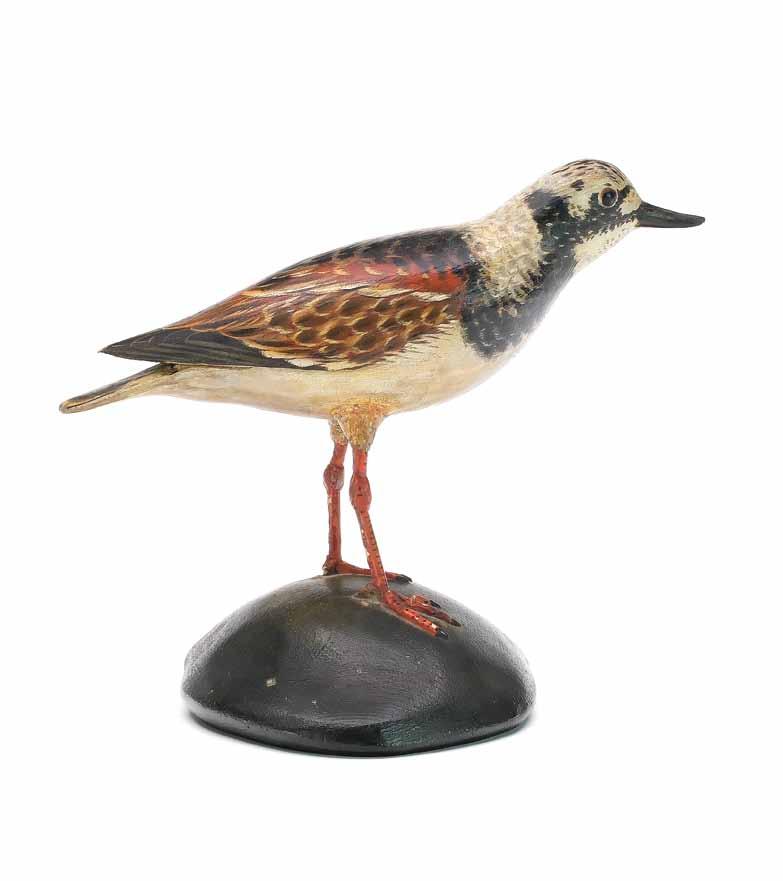
65 A. Elmer Crowell (1862-1952), East Harwich, Massachusetts. Outstanding decorative ruddy turnstone with split tail carving and tack eyes. Maker’s oval brand on underside. Also identified by the maker in pencil as a chicken plover. Excellent wet on wet feather blending. Measures 8” long. Original paint protected under a thin coat of varnish; early restoration to gesso on legs; small losses to gesso toes and a few paint flakes on legs; professional restoration ot a small chip at tip of bill.
Provenance: Deboarah and Martin Maloy collection. (40,000 - 60,000)
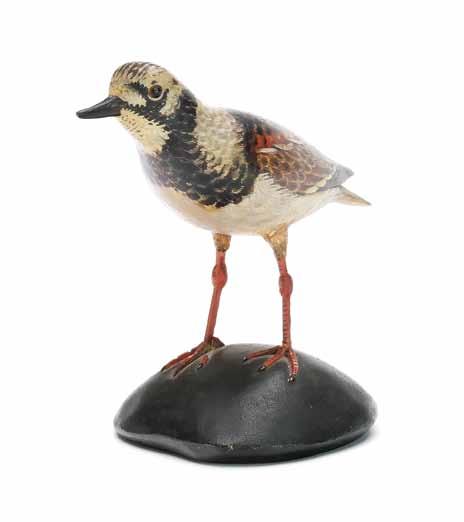
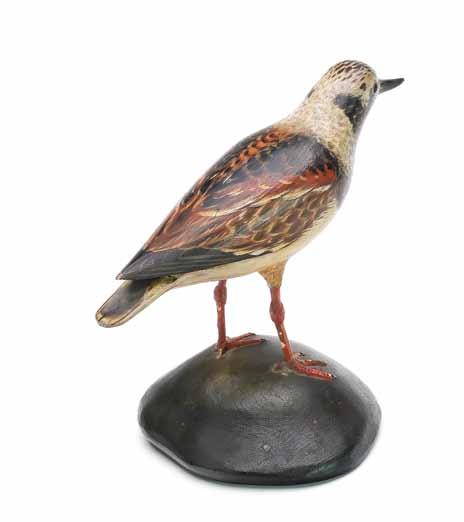
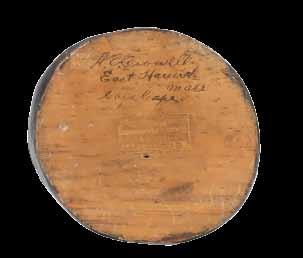
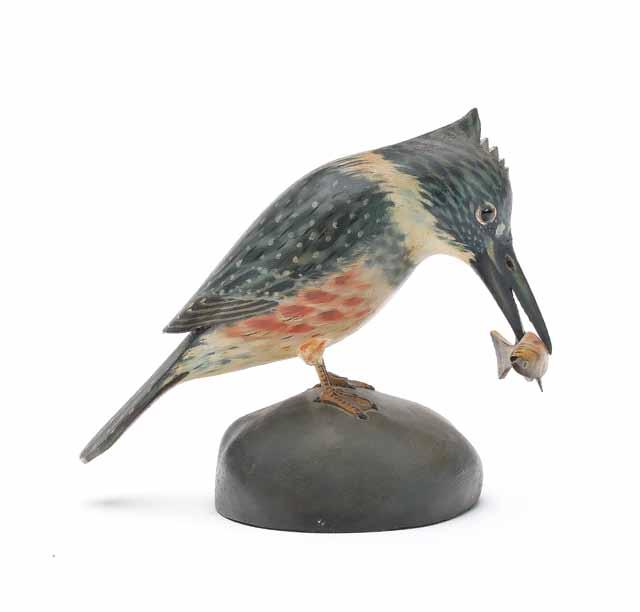
66 A. Elmer Crowell (1862-1952), East Harwich, Massachusetts. Decorative king fisher with carved perch in its beak. Signed by the maker on the underside. Also with maker’s rectangle stamp. Measures 8” long. Original paint that has darkened slightly with age; small amount of restoration to one foot; glue visible on back of fish where it meets the beak.
Provenance: Martin and Deborah Maloy collection. (15,000 - 20,000)



67
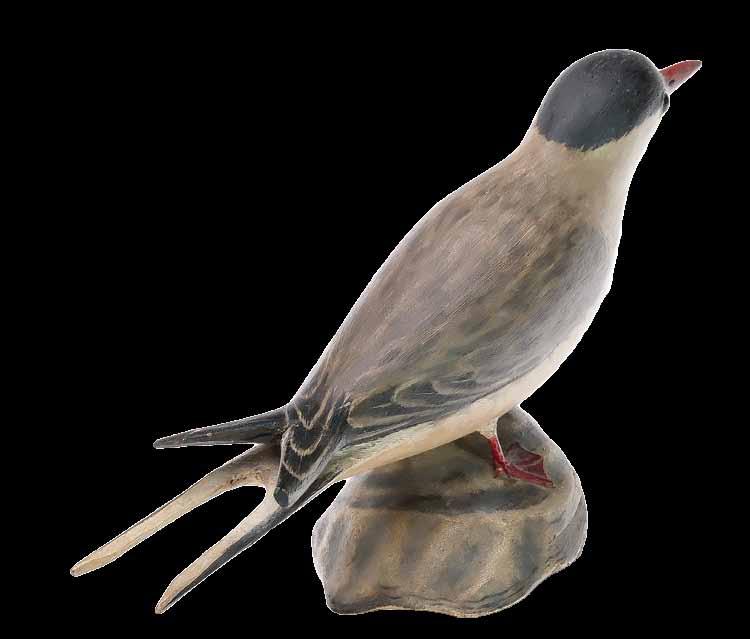
A. Elmer Crowell (1862-1952), East Harwich, Massachusetts. Decorative Wilson’s tern with extended crossed wingtips. Maker’s oval brand on the underside of carved oyster shell base. ‘AE Hardy’ on underside for Alice Eliza Hardy, wife of Charles Ashley Hardy, owner of the Chatham Bars Inn and early patron of the maker. Measures 12” long. Original paint with a few very minor rubs; reglued chip in one wingtip and one tail feather; older restoration to one gesso thigh.
Provenance: Martin and Deborah Maloy collection. (8,000 - 12,000)
67A A. Elmer Crowell (1862-1952), East Harwich, Massachusetts. Decorative killdeer with relief tail feather carving and maker’s oval brand on underside of base. Measures 8” long. Original paint under a thin coat of varnish that has darkened somewhat with age; restoration to gesso toes; tiny chip in bill tip with small amount of touchup in that area; spot of flaking on top of head and tip of raised wingtips; chip in underside of tail was reset with some filler and touch up by Russ Allen.
Provenance: Deborah and Martin Maloy collection. (8,000 - 12,000)
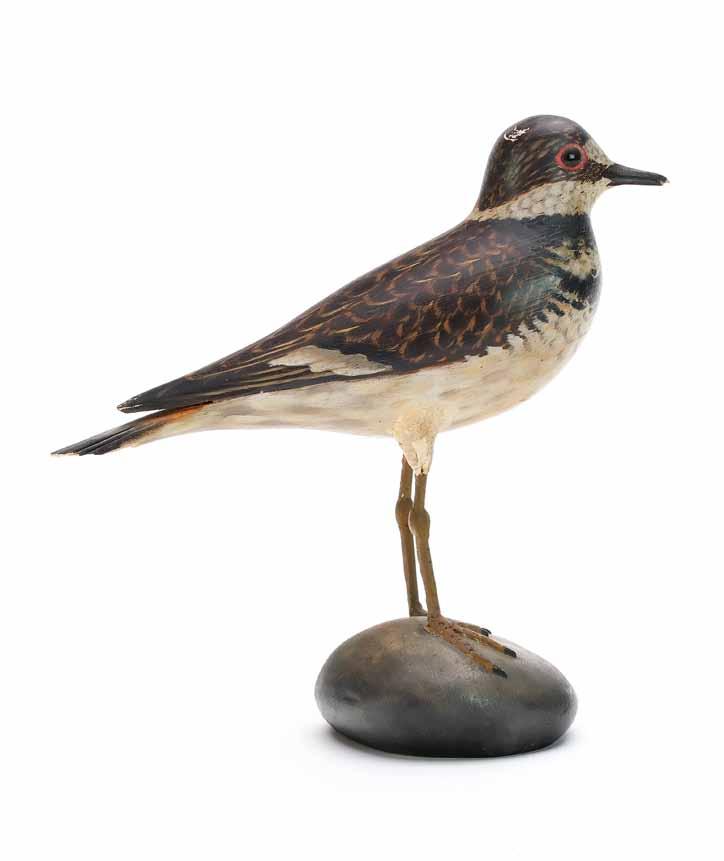
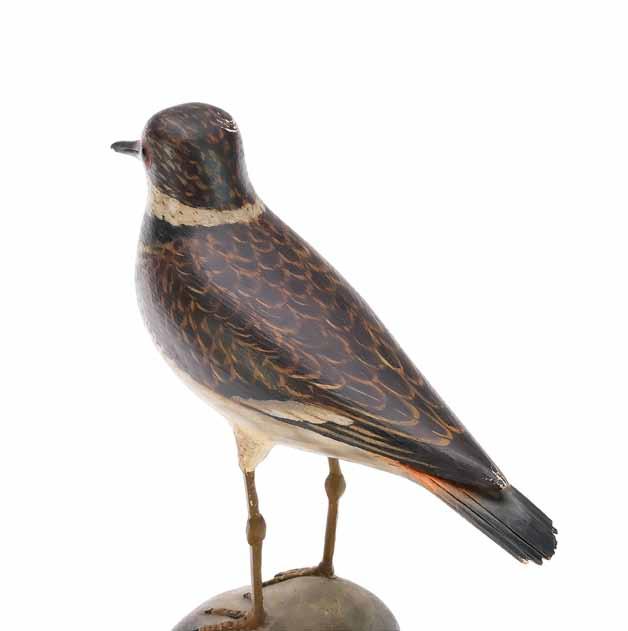

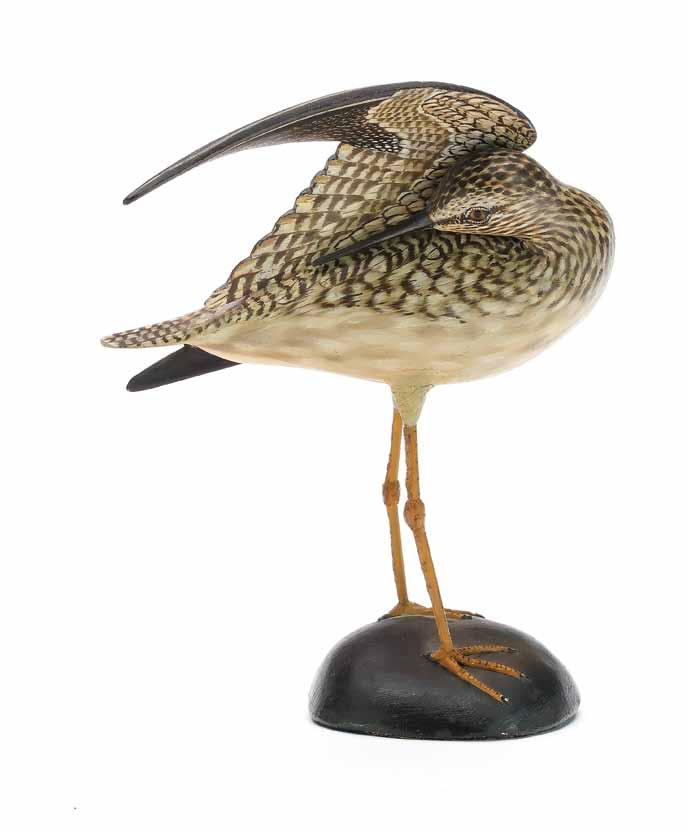
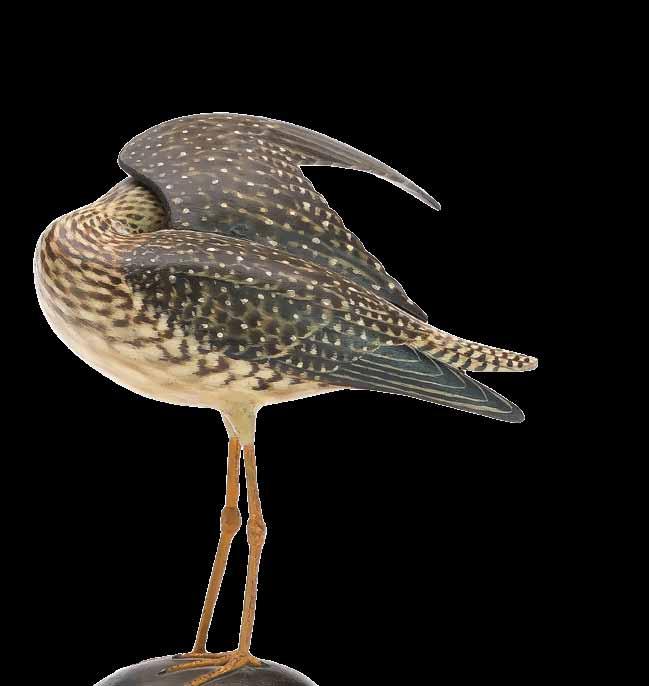
68 A. Elmer Crowell (1862-1952), East Harwich, Massachusetts. Decorative preening lesser yellowlegs. One outstretched wing with head turned in preening pose. Maker’s rectangle stamp on underside. Measures 7” long, stands 8.25” tall. Original paint under a thin coat of varnish; restoration to gesso thighs and where wing attaches to body; a few scattered tiny spots of touchup; professional chip repair at tip of wing.
Provenance: Martin and Deborah Maloy collection. (10,000 - 15,000)

A.
Massachusetts.
walking
and painted tack eyes. Maker’s oval brand on underside. Measures 13” long. Original paint with almost no wear; two spots of paint shrinkage on one side; tight cracks in the original gesso thighs.
Provenance: Martin and Deborah Maloy collection. (10,000 - 14,000)
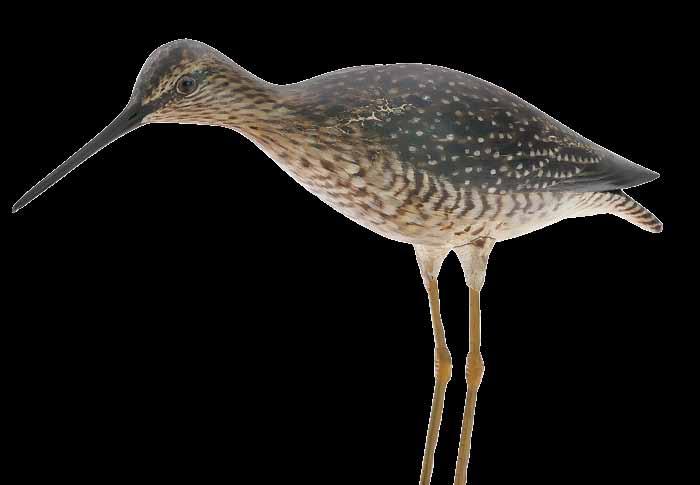

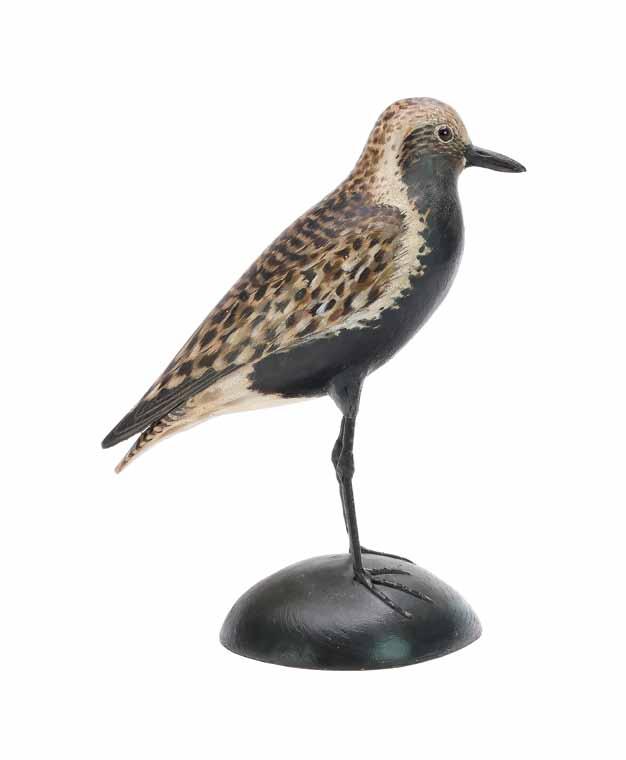

70 A. Elmer Crowell (1862-1952), East Harwich, Massachusetts. Decorative black bellied plover. Unmarked underside of base. Measures 9” long. Original paint with moderate flaking on one side; a thin coat of varnish has caused a tight crazing to paint on breast and under tail; some restoration to gesso thighs.
Provenance: Martin and Deborah Maloy collection. (6,000 - 9,000)
71 A. Elmer Crowell (1862-1952), East Harwich, Massachusetts. Decorative lesser yellowlegs standing on carved quahog base. Maker’s rectangle stamp on underside. Measures 8.5” long. Original paint with no wear; restoration to gesso thighs and feet.
Provenance: Martin and Deborah Maloy collection. (6,000 - 9,000)
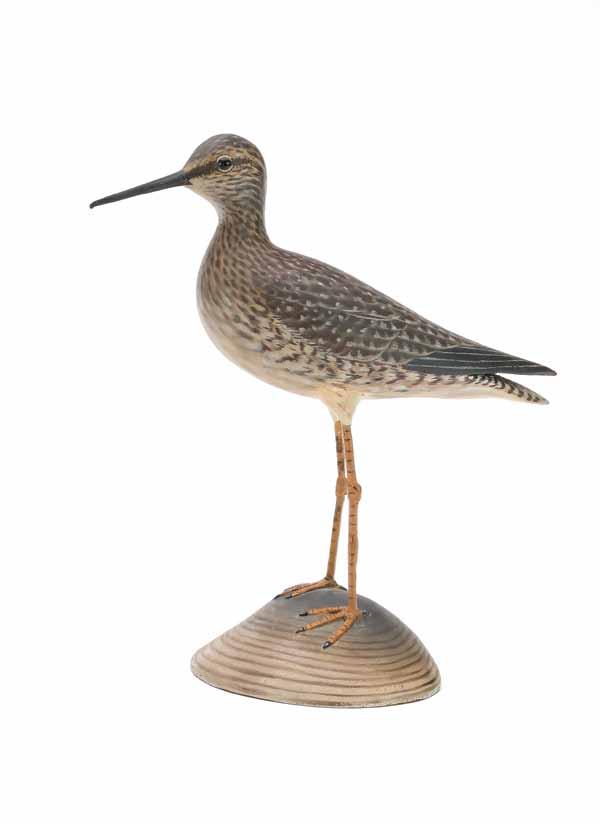
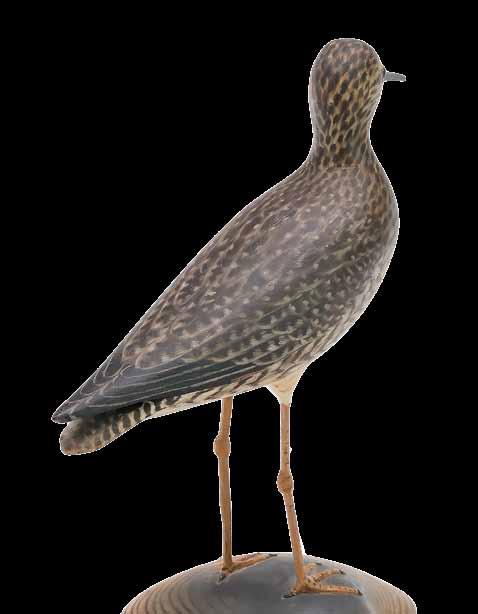
72 A. Elmer Crowell (1862-1952), East Harwich, Massachusetts. Miniature godwit. Maker’s rectangle stamp and the number 14 on underside. Measures 4.25” long. Tightly reglued crack through neck, otherwise excellent.
Provenance: Martin and Deborah Maloy collection. (1,200 - 1,800)
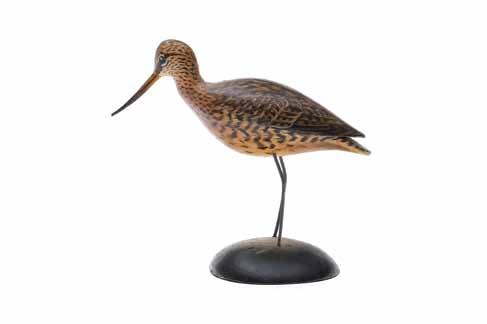
73 A. Elmer Crowell (1862-1952), East Harwich, Massachusetts. Miniature ruddy turnstone. Maker’s rectangle stamp on underside. Measures 3.25” long. Excellent and original.
Provenance: Martin and Deborah Maloy collection. (1,200 - 1,800)
74 A. Elmer Crowell (1862-1952), East Harwich, Massachusetts. Miniature sanderling. Maker’s rectangle stamp on underside. Measures 2.5” long. Excellent and original.
Provenance: Martin and Deborah Maloy collection. (1,200 - 1,800)
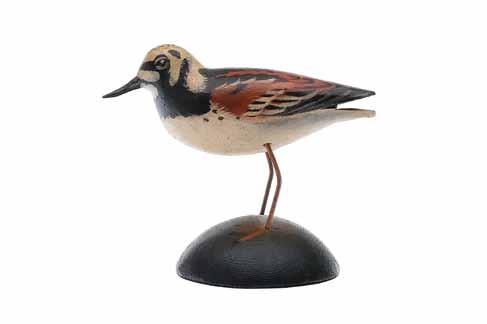
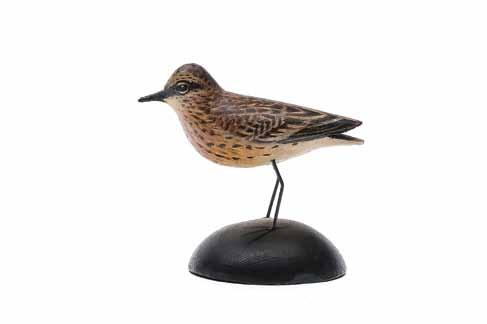

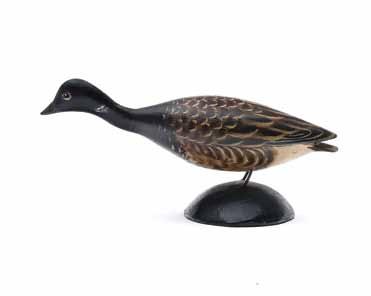
75 A. Elmer Crowell (1862-1952), East Harwich, Massachusetts. Miniature low head wood duck with extended crest carving. Old sticker on underside with “wood duck 23”. Measures 4” long. A few tiny paint flakes on edge of tail; otherwise excellent and original.
Provenance: Martin and Deborah Maloy collection. (1,500 - 2,500)
76 A. Elmer Crowell (1862-1952), East Harwich, Massachusetts. Miniature running brant. Remnants of maker’s ink stamp on underside. Measures 5.5” long. Tiny paint rub on tip of bill, otherwise excellent and original.
Provenance: Martin and Deborah Maloy collection. (1,000 - 1,400)
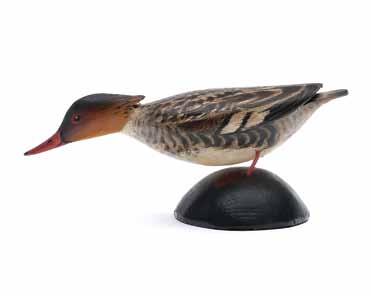
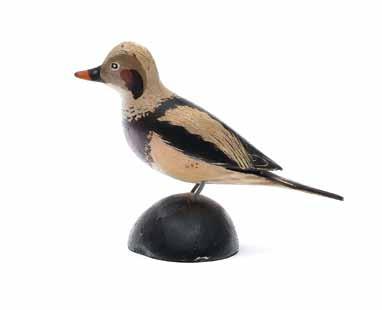
77 A. Elmer Crowell (1862-1952), East Harwich, Massachusetts. Miniature running merganser hen. Extended crest feathers. Remnants of maker’s ink stamp on underside. Measures 4.75” long. Excellent and original.
Provenance: Martin and Deborah Maloy collection. (800 - 1,200)
78 A. Elmer Crowell (1862-1952), East Harwich, Massachusetts. Miniature long-tailed duck. Remnants of maker’s ink stamp on underside. Measures 4” long. Original paint under a thin coat of varnish that has darkened with age; a few tiny spots of discoloration; some minor flaking on lower edge of base.
Provenance: Martin and Deborah Maloy collection. (800 - 1,200)
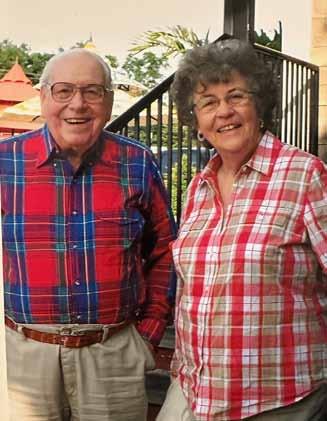

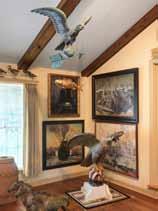


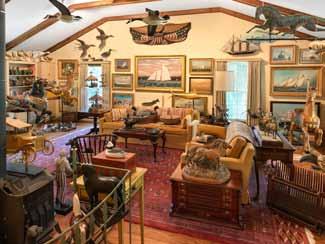
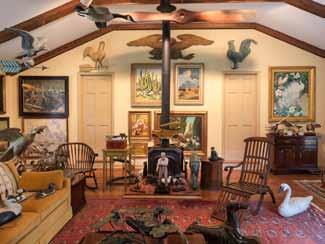

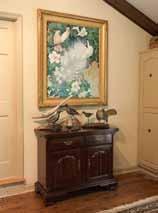
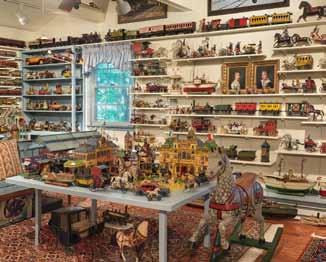
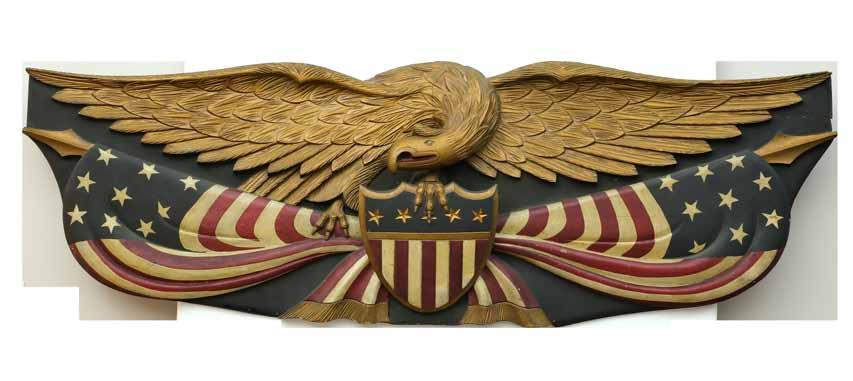
79 Important patriotic carved wooden eagle. With two American flags and a five star shield. Measuring 70” wide x 24” tall. This incredible piece remains in excellent original paint with fine crazing to white and red areas of the flags; only small amounts of paint loss mostly at lower edge and to one side of flag; back of carving has oxidized nicely and has pencil writing that is hard to decipher, but says something about President Harrison, who was president during the first American Centennial of 1876. There is a “property of A.E. Clark_____” stamp, but the end is illegible. This is one of the finest patriotic, probably Centennial eagles we have ever handled.
Provenance: Martin and Deborah Maloy collection. (20,000 - 40,000)
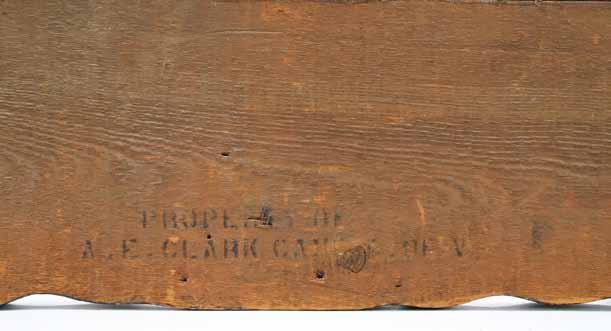

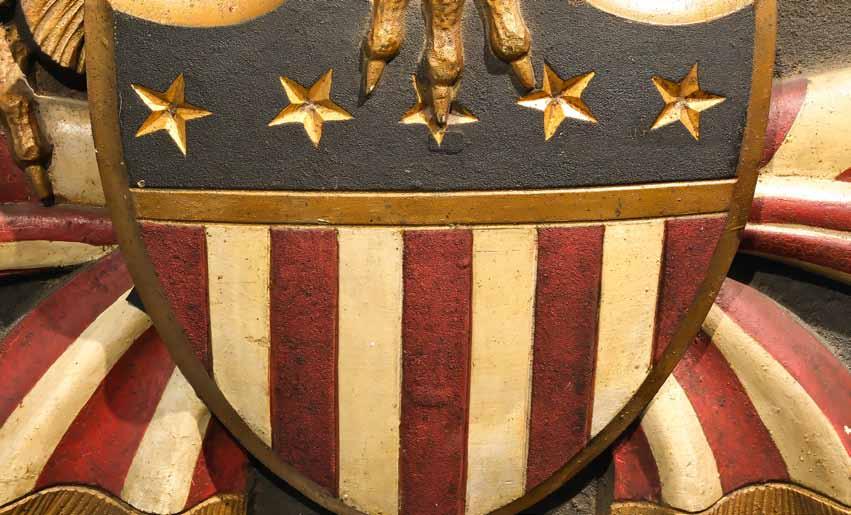
1836 – 1914 | Kittery, Maine & Portsmouth, New Hampshire
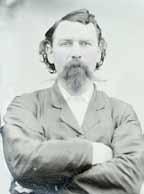
John’s father was a housewright, boatbuilder and inspector of timber in Kittery, Maine. This surely must have had an influence on his son for, at age 15, the young man began his training with ship carver Samuel Dockum in Portsmouth, New Hampshire on the opposite shore of the Piscataqua River. His apprenticeship lasted six years, ending in 1857. By 1859, he was successful enough to open his own carving shop at 17 Daniel St in Portsmouth where he worked primarily on figureheads for the local shipbuilders. As his business card from the time indicates, however, he did not confine himself to carving purely for the nautical market. In 1859 he relocated to the area of East Boston, MA where he found employment in the naval shipyards, and he remained there through the close of the Civil War. Returning to Portsmouth in 1872, he began to focus on carving eagle sculptures for the rapidly growing commercial tourist market. His plaques, most measuring about two feet long, are widely known today simply as “Bellamy Eagles”. As noted by his biographer, James Craig, these were “ - - - easily transportable, affordably priced - - - and sport(ed) any number of political, fraternal, religious, holiday, and personal sentiments, from “Don’t Give Up the Ship,” to “Merry Christmas!”. The Bellamy eagle easily appealed to a wide and diverse clientele” and the motto’s would change with the times reflecting the current mood of the country. These smaller works became extremely popular and, priced at only $1.00 to $2.00 dollars apiece (approximately $27.00 today), he could fill orders for as many as 500 to 700 at a time. Request for larger carvings were handled on an individual basis as special orders, and surviving examples of these are considered much rarer today.
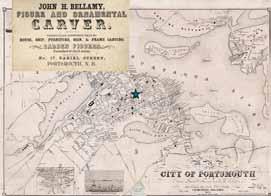
Many of the earlier references on Bellamy are often fraught with errors. Contrary to what many would consider the image of a reclusive, drunken folk artist, Bellamy was a businessman, poet and raconteur who formed close friendships with many of the well-known artists and authors of his day, such as Winslow Homer and Mark Twain. Advancing age, crippling arthritis in his hands, and his mind deteriorating, by 1911 he was deemed legally incompetent and forced to live out his life with a cousin, dying of a stroke three years later.
In death, the artistry of his work has received widespread recognition and acclaim. His carvings are included in the most discriminating private collections as well as at prestigious public institutions such as The Smithsonian American Art Museum, The Art Institute of Chicago and The Farnsworth Art Museum.
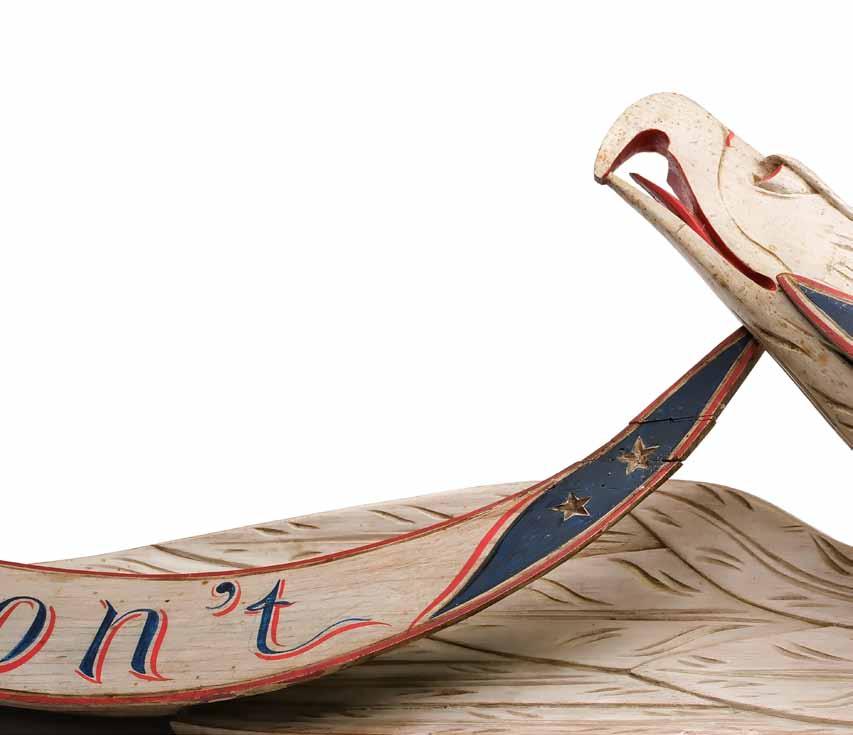
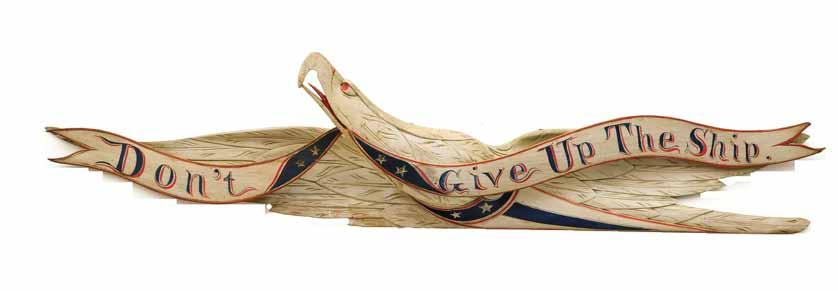
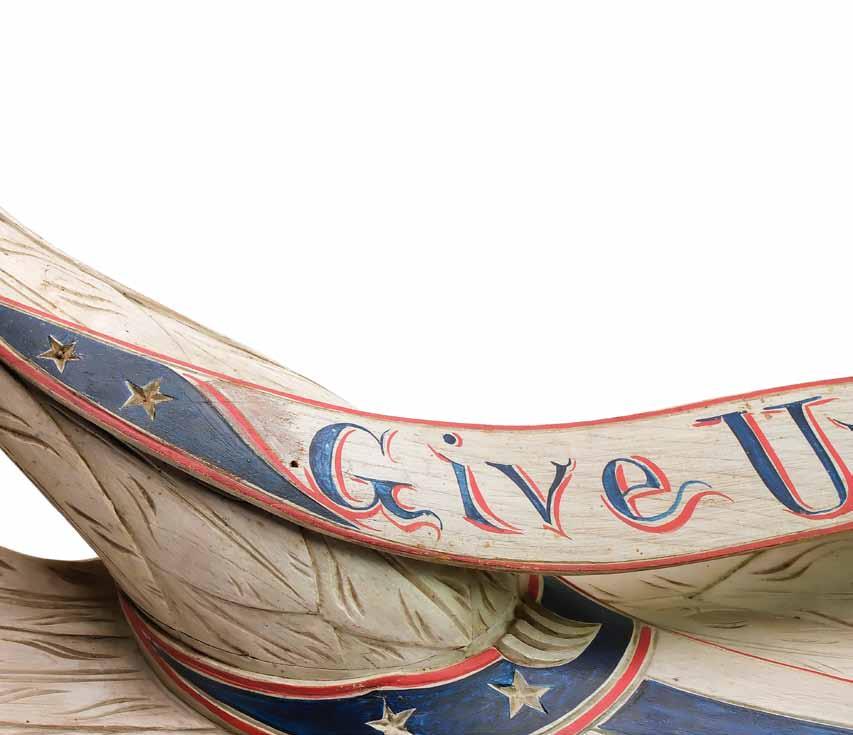
80 John Bellamy (1836-1914), Portsmouth, New Hampshire. Important carved eagle banner. Banner reads “Don’t Give Up the Ship.” 38” long. Excellent original paint; small break to a narrow part of the banner which was repaired a long time ago; tiny areas of discoloration, otherwise very good and original.
Provenance: Ginny and Gordy Hayes. Martin and Deborah Maloy collection. (20,000 - 40,000)
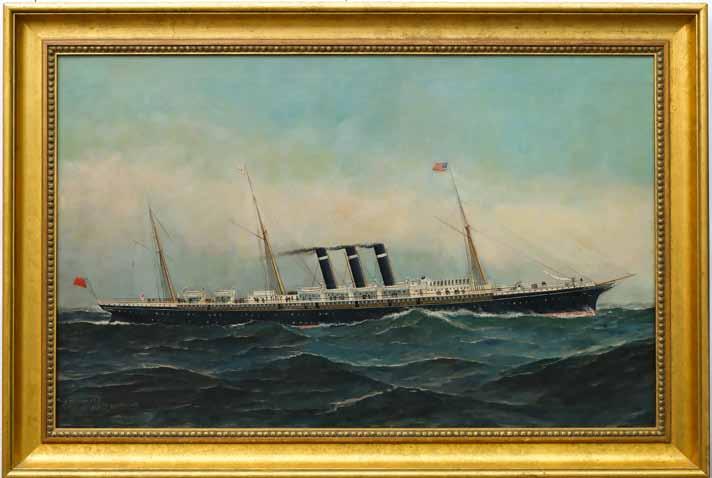
81 Antonio Nicolo Gasparo Jacobsen (1850-1921), oil on canvas. Image measures 21.5” x 34.5”. Signed and dated 1891. Steamship with American and British flags. Bow of boat reads city of New York. Below signature possibly reads FW Palisads Hoboken New York. Canvas has been relined. 1.5” tear in water on right hand side is visible; one area of inpainting in sky along right hand side; as otherwise been conserved and is in very good condition.
Provenance: Martin and Deborah Maloy collection. (8,000 - 12,000)
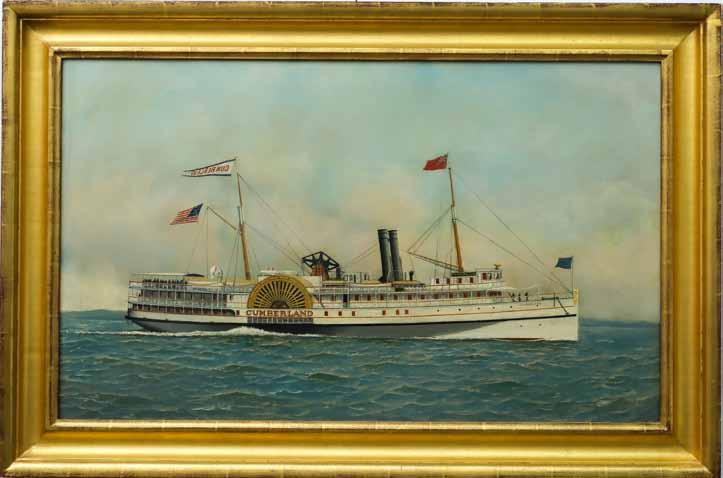
82 Antonio Nicolo Gasparo Jacobsen (1850-1921), oil on canvas. Image measures 21” x 35”. Steam paddle ship named Cumberland. American and British flags. Unsigned. As viewed under uv light inpainting has been stabilized; mostly above the ship and between the two masts; small area on rigth hand side in front of boat; a few small spots in the sky; canvas has been waxed.
Provenance: Martin and Deborah Maloy collection. (4,000 - 6,000)
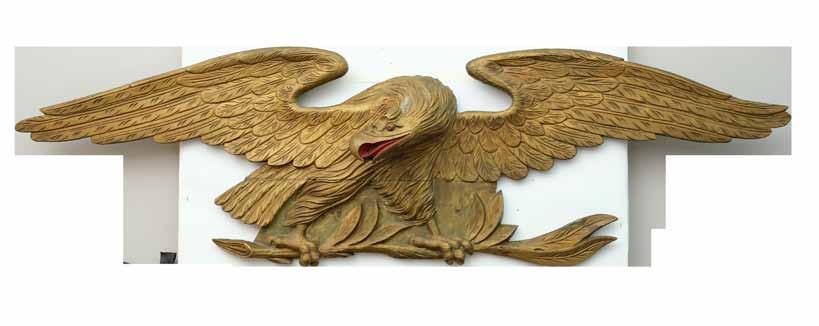
83 Carved wooden eagle. With wings spread and talons clutching a branch. Old gold paint. Reinforced backing. Measures 83” long. Seam separation with filler at top of legs and one wing.
Provenance: Martin and Deborah Maloy collection. (3,000 - 5,000)
84 Carved wooden pilot house eagle, circa 19th century. Perched on patriotic liberty or Phyrygian cap. Measures 36” tall. Wingspan is 35”.Carved feather detail on backs of wings as well as front. Traces of old gold gilding and polychrome paint; metal strap on back of wings has been removed; the original beak must have been broken and replaced but appears to be the original piece; feet and patriotic cap surface have been strengthened over time but shows good age.
Provenance: Martin and Deborah Maloy collection. (3,000 - 5,000)
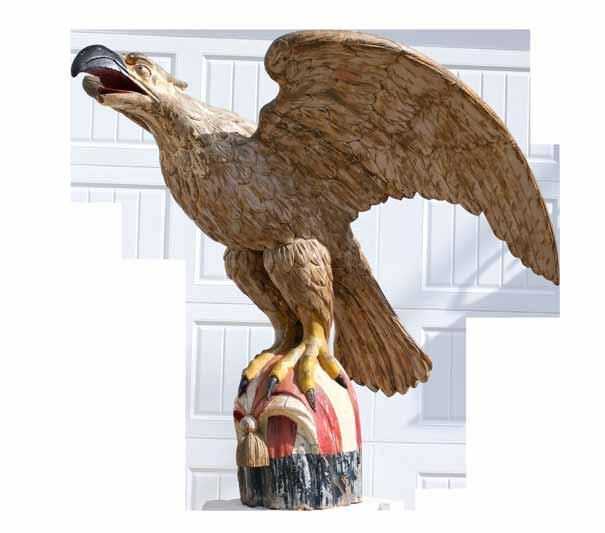
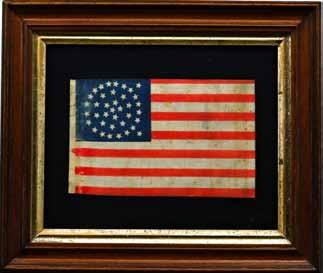
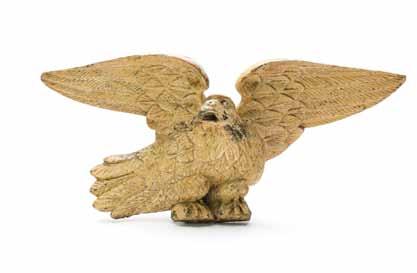
85 38 star colorado statehood flag. Medallion configuration with two outliers. 1876-1889. Flag has been hand stitched to a black cotton backing. Background fabric was washed and treated to reduce dye. It has been mounted in a period frame which dates to 1860-1890. Flag measures 6” x 9”.
Provenance: Martin and Deborah Maloy collection. (800 - 1,200)

86 Carved wooden patriotic eagle, 2nd half 19th century. 19” in length. Numerous coats of paint with the last being white, which has aged and mellowed nicely; Structurally good with paint worn to a few bare spots on edges.
Provenance: Martin and Deborah Maloy collection. Maloys purchased from Robin Hardy a dealer in Louisiana. (400 - 600)
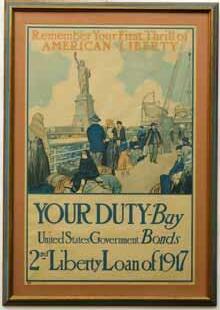
87 Vintage Air Service Poster. Professionally framed and matted. Framed dimensions 39” x 27.5”. Crease marks and tears but no material is missing; appears to have been laid down on paper board.
Provenance: Martin and Deborah Maloy collection. (600 - 900)
88 Patriotic poster. For government war bonds. In frame measures 34.5” x 24”. One tear a third of the way down on right size measures about 7”; slight discoloration.

Provenance: Martin and Deborah Maloy collection. (400 - 600)
89 Cunard vintage travel poster. Has been folded in quarters with seams showing the fold lines. One small tear with piece missing below the word tickets. Frame measures 43” x 30.5”.
Provenance: Martin and Deborah Maloy collection. (800 - 1,200)
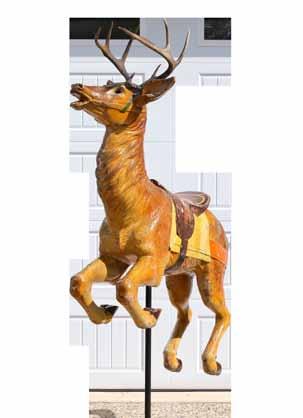
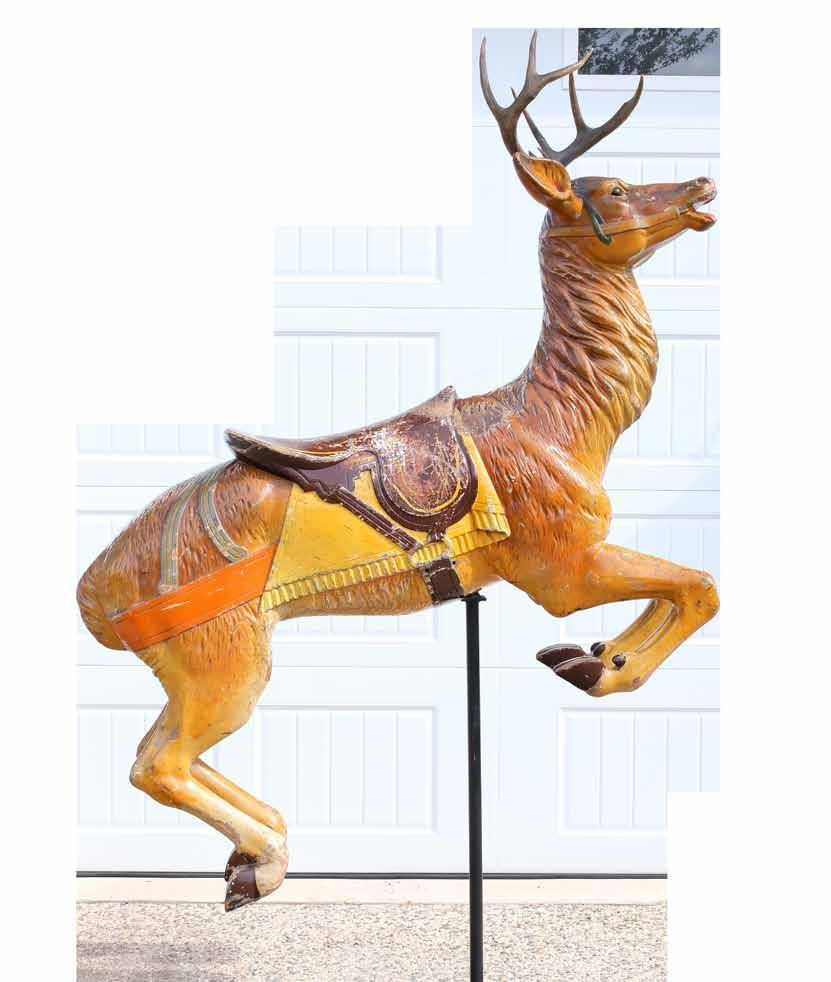
90 Denzel Carousel Company, Philadelphia, Pennsylvania, circa 1900. Rare leaping stag. Approximately 58” in length, 50” to top of antlers. Appears to be all original; flaking and crazing with anticipated wear for figure that has not been restored; structurally good. Please review online photos for a better idea of condition.
Provenance: Martin and Deborah Maloy collection. (10,000 - 15,000)
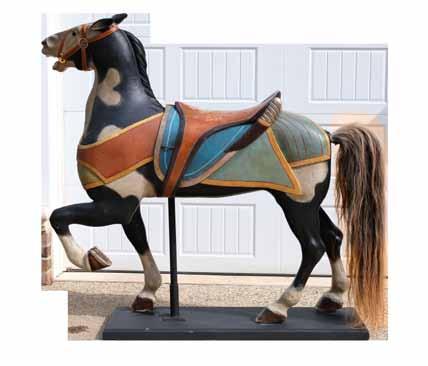
91 Soloman Stein and Harry Goldstein, Brooklyn, New York, circa 1915. Rare and outstanding carousel horse with relief carved Arabian sword. Tail is removable. From back foot to tip of saddle 43” to top of head 57”. Approximately 56” long. In mostly original paint with some inpainting to areas that flaked; natural wear on seats; structurally good. Please review online photos for a better idea of condition.
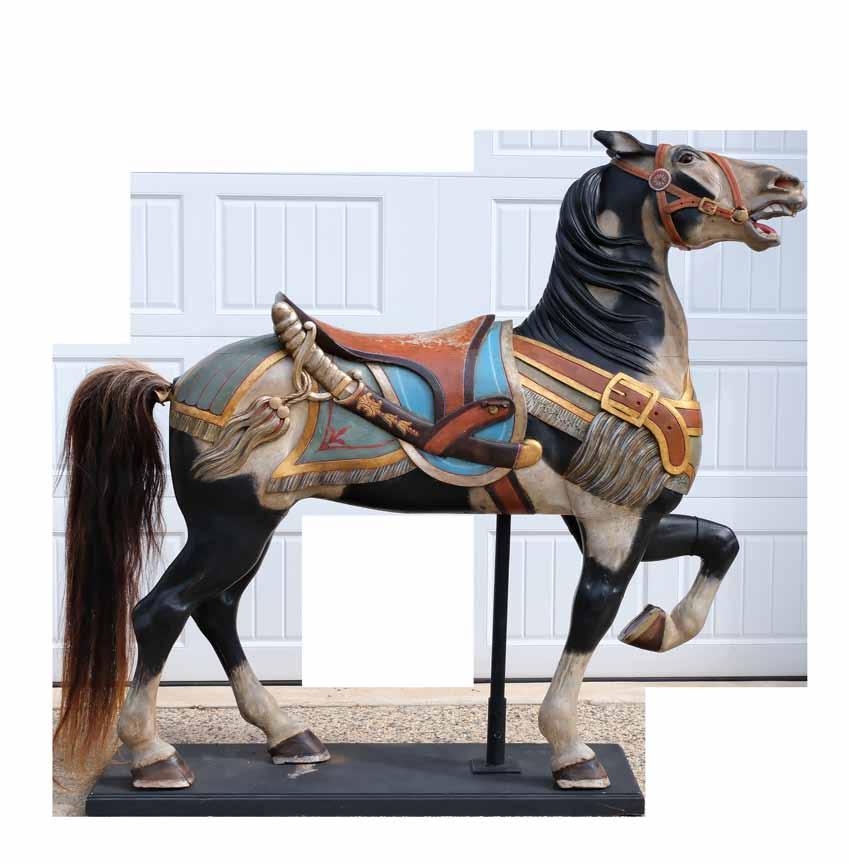
Provenance: Martin and Deborah Maloy collection. (8,000 - 12,000)

92 Denzel Carousel Company, Philadelphia, Pennsylvania, circa 1900. Prancing carousel horse. Measures 53” tall, approximately 50” long. In old park paint with some park restoration to areas that have flaked; good surface crazing. Please review online photos for a better idea of condition.
Provenance: Martin and Deborah Maloy collection. (3,000 - 5,000)
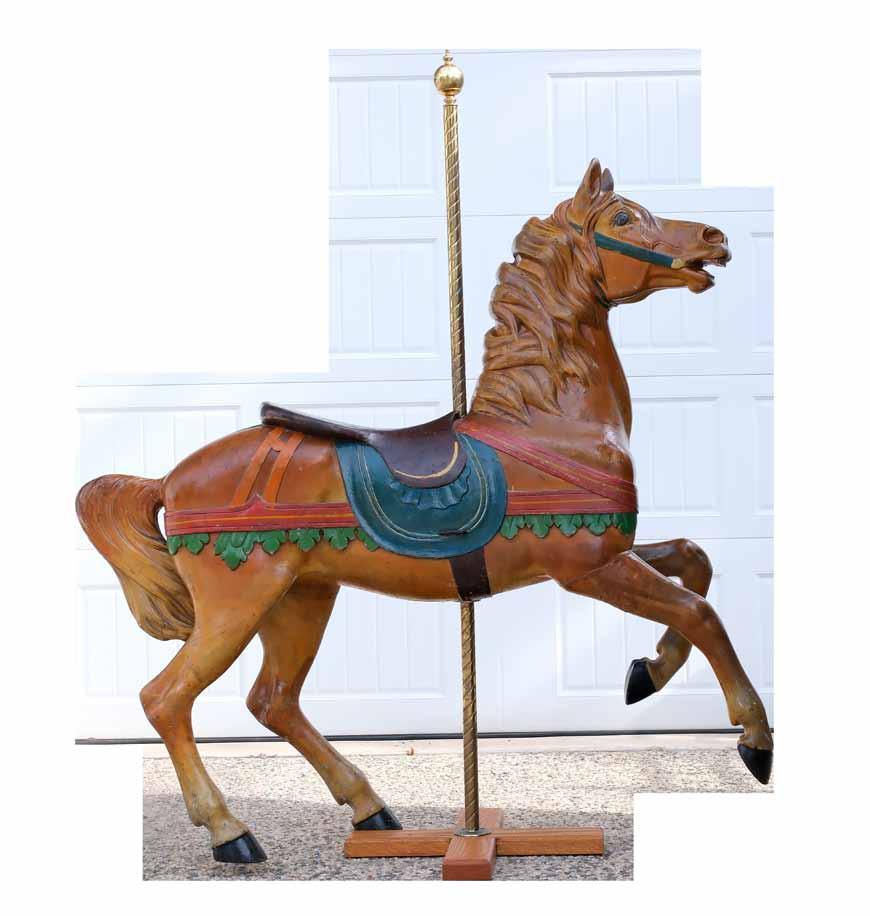

93 Large carousel horse. Jeweled side. Measures 59” tall and approximately 65” long. Completely restored. Please review online photos for a better idea of condition.
Provenance: Martin and Deborah Maloy collection. (2,500 - 3,500)
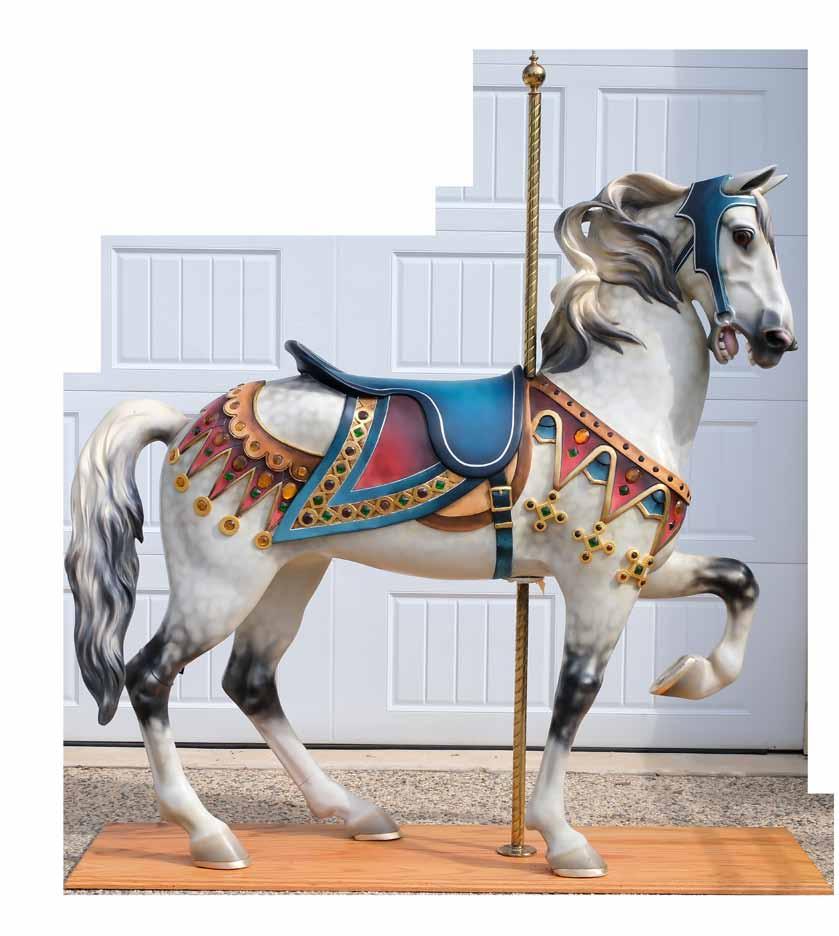

94 Full body copper fish weathervane. Probably Fisk & Company. Shows a mix of verdigris and a nicely worn and weathered surface. Brown may be old paint that has mostly worn away. Dents on both sides of head. otherwise structurally good.

Provenance: Martin and Deborah Maloy collection. (8,000 - 12,000)
95 Full body copper weathervane. Of horse and jockey. Both of which have zinc heads. Small traces of gold guilding with old verdigrised surface. Vertical bar measures 32” in length. Several shot holes are visible; and a couple have been patched with lead; cross bar is broken at the vertical bar.
Provenance: Martin and Deborah Maloy collection.
(4,000 - 6,000)
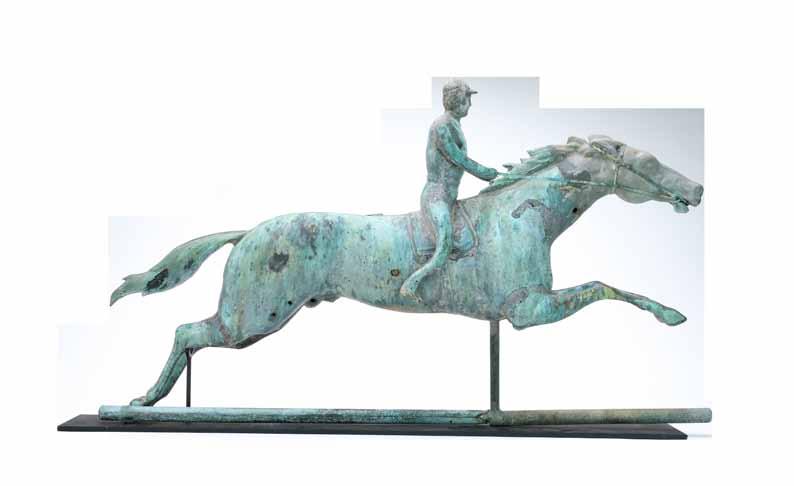
96 Large cow weathervane circa 1900. Full body copper with zinc ears. Measures 32” long x 20” tall. Dent in one side of body; surface looks to be honest and verdigrised; showing good natural age.
Provenance: Martin and Deborah Maloy collection. (4,000 - 6,000)
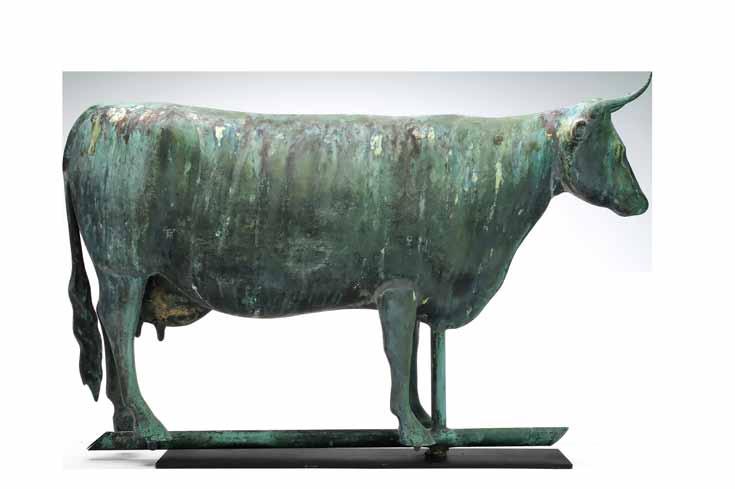
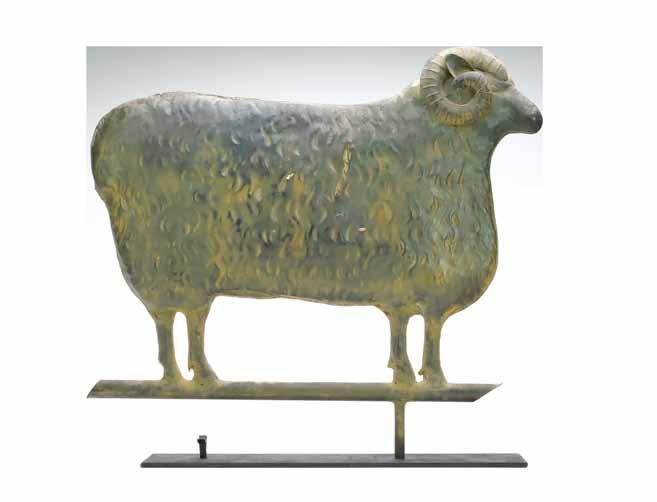
97 Copper full body weathervane, circa 1900. In the shape of a ram. Applied copper horns. Measures 26” long x 19” tall from the base of the bar. Appears to have old repairs to small areas of the seam.
Provenance: Martin and Deborah Maloy collection. (4,000 - 6,000)

98 Horse weathervane by the Harris Factory, last quarter 19th century. Known as Black Hawk, a famous Morgan stallion in the mid19th century. Surface is a mix of gold guild and verdigris. Measures 28” in length x 19” tall. A few small dents.
Provenance: Martin and Deborah Maloy collection. (3,000 - 5,000)
99 Weathervane of a Irish setter. Probably Washburn Company, Massachusetts. Full body copper. Measures 34” in length x 16” tall. Traces of gold gilding surface is mostly verdigris gold copper. Insert on lower bar where post enters appears to be a a later replacement; small seam split at one foot on leg; small dents and seam splitting along top of dog; probably some solder strengthening as well.
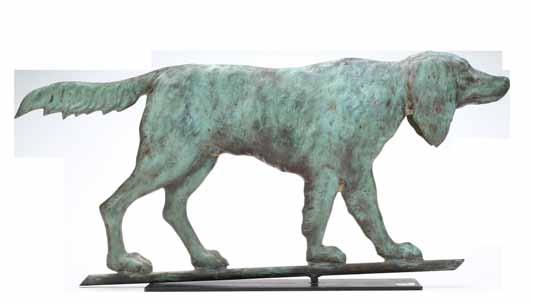
Provenance: Martin and Deborah Maloy collection. (3,000 - 5,000)
100 Full body copper rooster weathervane. With an excellent surface with a mix of gold guild and natural verdigris. Measures 26” tall x 28” wide. Structurally good.
Provenance: Martin and Deborah Maloy collection. (2,000 - 3,000)
101 Full body copper weathervane. In the shape of a horse. A larger version than the more common size, with a 42” bar. Zinc head. Traces of gold guilding in the lower areas with a verdigrised surface. Bullet hole shown on both sides; otherwise structurally good.
Provenance: Martin and Deborah Maloy collection. (2,000 - 3,000)
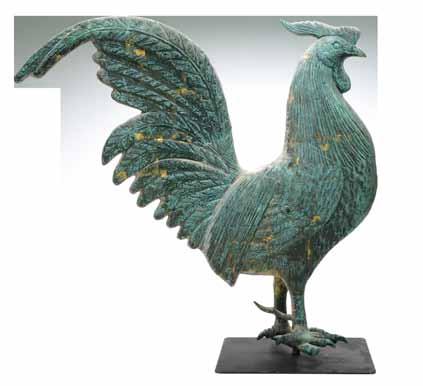
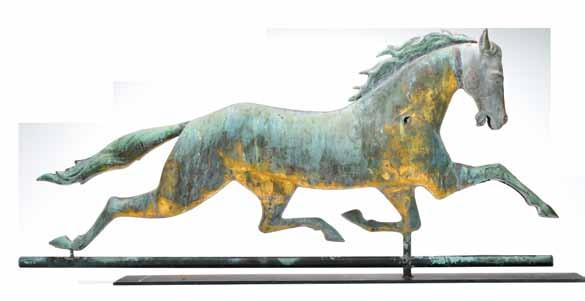
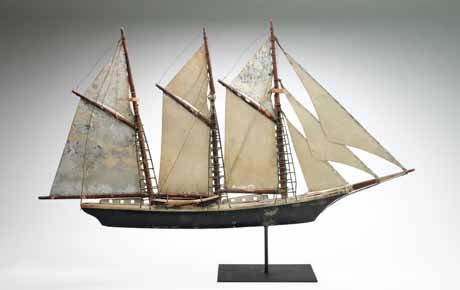

102 Early vintage weathervane. Sailing vessel with nine sails. Made by Frank Adams, Martha’s Vineyard, Massachusetts. Sheet metal sails. Boat made from wood and polychrome paint. Measures 39” long x 21” tall. Center mast has been broken; paint flaking on sails; two of the cross bars on the front and rear mast are replaced.
Provenance: Martin and Deborah Maloy collection. (1,000 - 2,000)
103 Full body copper weathervane. A rooster. Remains in original gold guild. Some vertegris showing through. Comb and crest are painted red. Measures 30” wide x 26” tall. Small areas of feet and legs have been strengthened over time; Vertical bar has partially worn away below cross bar.
Provenance: Martin and Deborah Maloy collection. (1,500 - 2,500)
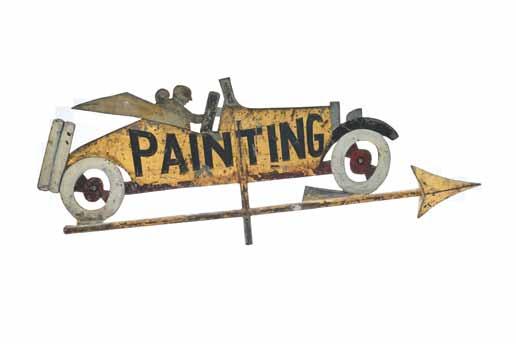
104 Rare and early trade sign weathervane. Painted and guilded sheet metal on copper arrow. Two sided with the word “Painting” on both. Shows great age, probably 1st quarter 20th century. Measures 32” in length. Rear tire is dislodged from copper bar; part of car is dislodged from north/ south bar; original surface shows flaking that has stablized.
Provenance: Martin and Deborah Maloy collection. (2,000 - 3,000)
105 Vintage car weathervane. Depicting a vehicle from the 1st quarter 20th century. Weathervane was purchased at a Sotheby’s sale and retains the sticker with lot 762. Car is made from metal and has yellow paint. Measures 23” long x is approximately 18” tall. Some paint flaking to edge spots; structurally good.
Provenance: Martin and Deborah Maloy collection. (2,000 - 4,000)
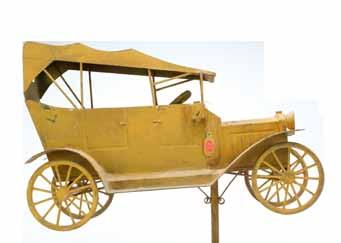
106 A rare figure weathervane. A horse pulling a sled. Man in sled has zinc head. Horse and sleigh are full body copper. Cross bar measures 44” in length. Horse has old patina with probably a second gold surface; small split near tail; iron connecting horse sleigh and sleigh wheels is pitted; but structurally good.
Provenance: Martin and Deborah Maloy collection. (7,000 - 10,000)
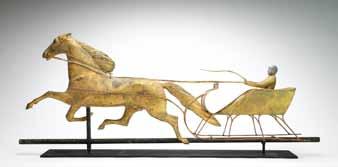
107 Full body spring wing eagle on ball top of arrow. Wingspan is 39”. Verdigrised surface with damage to one side of ball.
Provenance: Martin and Deborah Maloy collection. (1,000 - 2,000)
108 Rare vintage weathervane, circa 1900. Full body swell beaver. Probably made from tin, painted a very long time ago. Measures 34” long. Some dents and tiny shot holes.
Provenance: Martin and Deborah Maloy collection. (1,000 - 1,500)
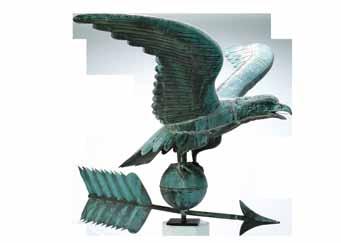


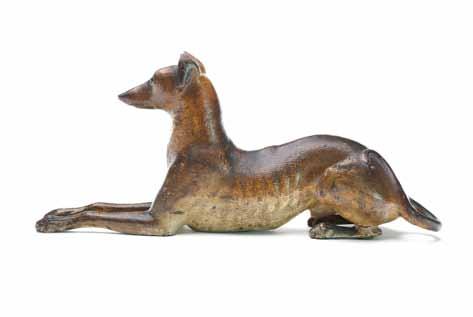
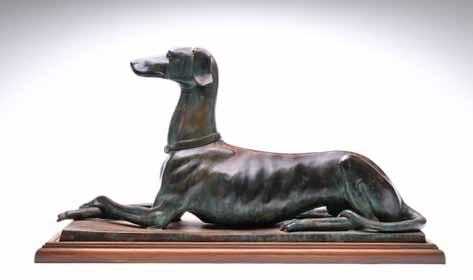
109 George Claxton, horse and jockey bronze. Measures 14.5” tall x 15” long. Nice aged patina. mounted on marble base. Maker’s last name in turf near horse’s feet.
Provenance: Martin and Deborah Maloy collection. (2,500 - 3,500)
110 Very rare whippet iron doorstop. In original paint with glass eyes. Measures 17” long and 7.5” tall. Circa 1900. Paint is worn at edges, like tops of ears, nose, and tail area; has a very wonderful patina reflecting good age. Weighs approximately 10-15 lbs.
Provenance: Martin and Deborah Maloy collection. (3,000 - 5,000)
111 Large, nearly full size, bronze of a whippet. Measures 36” long x 18.5” tall. Appealing patina indicates this piece has good age. Sits on wooden base. Vertiigrised surface; structurally good with exception of one small hole in dog’s right foot.
Provenance: Martin and Deborah Maloy collection. (4,000 - 6,000)

112 Hollis Williford, bronze sculpture. Depicting an otter. Titled “Chasing Rainbows”. 8/25. Mounted on wooden base. Measures 25” x 13” x 14” tall. Very good and original.
Provenance: Martin and Deborah Maloy collection. (1,000 - 1,500)
113 Uncle Sam figure. Professionally mounted to base. Measures 24” in height. Made from plaster with a more recent paint job. Of an undetermined age, possibly 1st quater 20th century. Repairs to small area of damage.
Provenance: Martin and Deborah Maloy collection. (800 - 1,200)
114 Sandy Scott, bronze sculpture. Titled “Cougar at Ease”. 4” tall x 19” wide x 10” deep. Number 19/100. Sold by Jackson Hole Trailside Galleries. Painted surface remains excellent and original.

Provenance: Martin and Deborah Maloy collection. (400 - 600)


Rare Mi’kmaq Indian brides box with lid, circa mid-19th century, Nova Scotia. Incised pine top with bentwood sides. Measures 21.75” x 14.5” x 7.5”.
Original finish with expected wear and patina on surface; one small break to the bent wrapped birch, approximately .25” strip that is 7” long.
Provenance: Martin and Deborah Maloy collection. For a similar example, possibly by the same maker, see lot 433, New England Auctions, July 17, 2025 auction. (500 - 800)

Provenance: Martin and Deborah Maloy collection. (300 - 500)
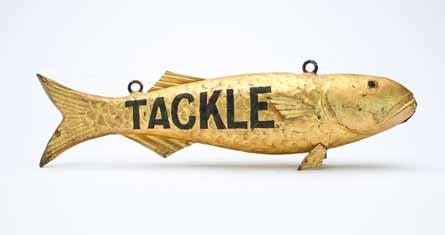
Trade sign. Full body copper fish. In
with the word “Tackle” on both sides. Circa 1900. Excellent crazing in black paint and eye. Measures 18” long. A dent on one side; small areas of rubs and separation near fish’s mouth.
Provenance: Martin and Deborah Maloy collection. (1,000 - 1,500)
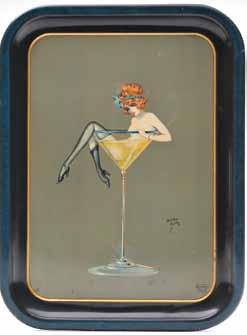
119
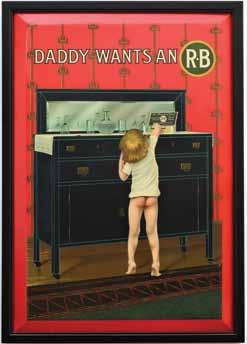
Two pieces of vintage advertising. One for RB Cigars, which is framed. Original paint on tin remains in very good to excellent condition with one very small dent at bottom edge. Other is a champagne advertising with artwork done by Henry Clive. Brand may be BEAUTBEOX canco. Both appear to be first half 20th century. Largest measures 18.5” x 13”, tray measures 13.5” 10.5”.
Provenance: Martin and Deborah Maloy collection. (400 - 600)
120 Carved wooden full size poodle. Measures 30” tall x 10” wide. Circa 1950. Well carved surface made from several pieces of wood. A few scratches, rub marks, and wear as to be expected of its age.
Provenance: Martin and Deborah Maloy collection. (800 - 1,200)
121 Vintage carved wooden full size cat. Assembled from five pieces of wood. With heavily carved fur and nicely carved face. Appears to be circa 1950 or earlier. There is a darkened varnish over natural wood with wear and some seam splits. Measures 15.5” tall.
Provenance: Martin and Deborah Maloy collection. (300 - 400)
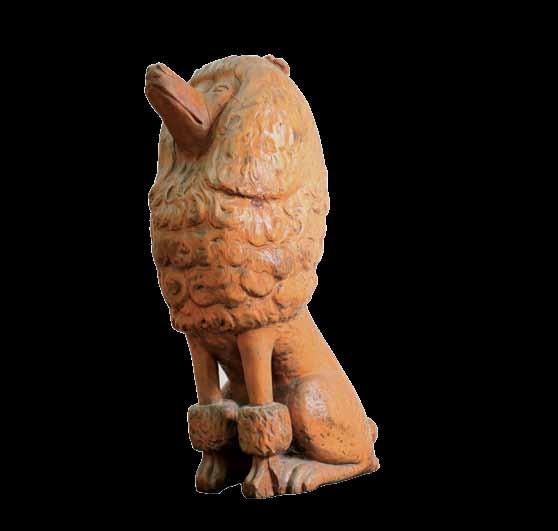


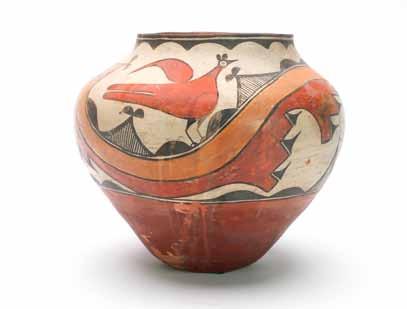
123 A large plate or charger by Maria and Santana Martinez. Signed “Maria & Santana” on bottom. Retains original price sticker on back of $22.50. Charger with feather pattern. Measures 10.75”. Very good and original; a few small scratches to surface.
Provenance: Martin and Deborah Maloy collection.
(5,000 - 8,000)
124 Pueblo pottery. Probably Zea. Fully decorated. Opening measures 6.75”. Full pot is 13” round and stands 10.5” tall. Some paint flaking, mostly on lower half.
Provenance: Martin and Deborah Maloy collection.
(1,000 - 1,500)
125 Three baskets. All with lids. Appear to be Macah, circa 1915. One has flag motif, and measures 5” long x 3.5” wide x 2.5” deep. Remains structurally good. Largest round basket is 4” wide x 1.5” deep. Smallest is 3.5 wide and 2.5” deep and has interesting motif of fish good luck sign and a boat.
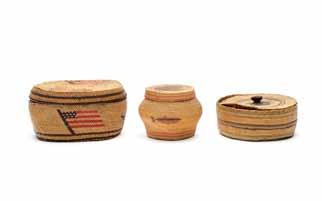

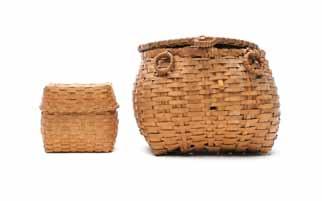
Provenance: Martin and Deborah Maloy collection.
(800 - 1,000)
126 Northwest Coast woven basket. With whale motif and the words Alaska Indian DVE. Multi-color design that measures 7” tall x 8” wide. Carefully view online pictures to see damaged areas.
Provenance: Martin and Deborah Maloy collection.
(400 - 800)
127 A small lid top woven basket and small Maine creel. Measuring 4” tall x 5” wide x 3” deep. Two piece basket with faint red and blue coloration. Remains structurally good. And a small fishing creel with center hole, which is 7” tall x 9” wide x 6” deep. Creel has good age and is structurally good. one small break to weave at front of basket and a crack to the birch bark top along the backside.
Provenance: Martin and Deborah Maloy collection.
(300 - 400)
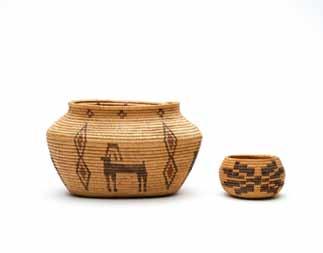
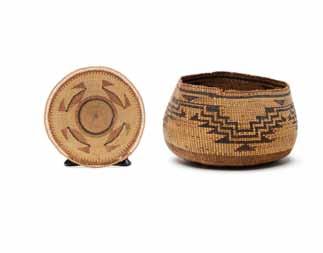



128 Two woven baskets. Probably Northwest. Deer motif on the larger, which measures 5.5” deep x 9” long x 6.5” wide. Other measures 4” wide x 2” deep. A Sotheby’s, Washington DC sticker remains on the bottom.
Provenance: Martin and Deborah Maloy collection. A tribal arts sale. One is possibly work of Santini James.
(400 - 600)
129 Two Northwest coast items. One basket which measures 7” wide x 4” deep. And another dish that measures 5.25” and is slightly concave. Both remain structurally good.
Provenance: Martin and Deborah Maloy collection.
(400 - 600)
130 Two baskets. Notes on inside indicate made by Makah Neah Bay Washington, circa 1900. Largest measures 5.5” x 3”. other is 4” x 2.5”. Both remain structurally good. One is lidded and other is not.
Provenance: Martin and Deborah Maloy collection.
(400 - 600)
131 Nantucket purse basket. With bone lock pin and bone decoration at swivel handle. Basket measures 6.5” tall x 10” wide x 7” deep. No maker’s marks are visible but does appear to have good age; structurally basket remains very good.
Provenance: Martin and Deborah Maloy collection.
(200 - 400)
132 Three Nantucket swing handle baskets. All three appear to show good age and none of them have maker’s marks. Largest is 1’ wide x 1’ tall. Basket remains structurally very good with only one woven piece damaged but not broken all the way through. Second tallest at 9” to top of handle has two very small areas of damage where one woven piece is missing over three over the spars in one area, and over one spar in another area. Basket is 6.75” wide. Third basket is 7” to top of handle. 6.25” wide. Structurally does not have any breaks in the weave.
Provenance: Martin and Deborah Maloy collection.
(800 - 1,200)
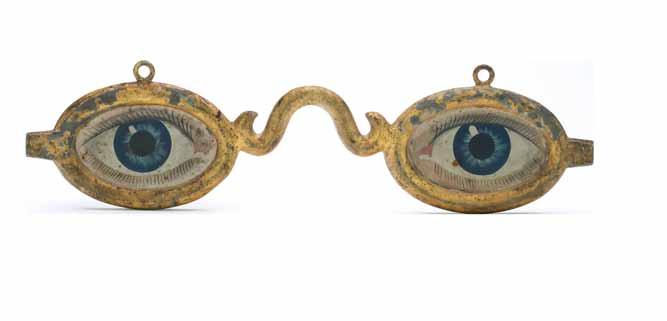
132A Optometrist trade sign, circa 1900. Two sided, in original paint. Measures 18” x 4.75”. Flaking and discoloration.
Provenance: Martin and Deborah Maloy collection. (2,000 - 3,000)
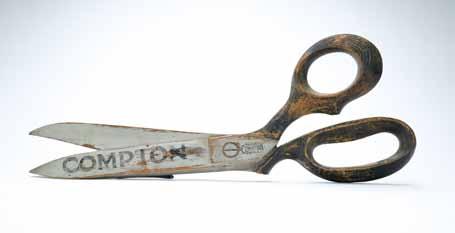
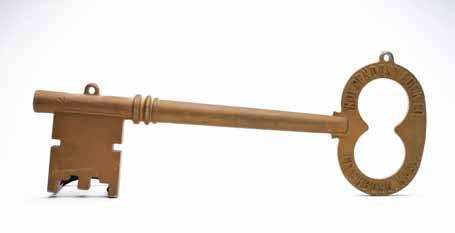
132B Trade sign. A large wooden pair of scissors with the word “Compton” on the blade. and also “Reliance Compton Newark New Jersey”. Measures 30.5” long. Original paint; with wear and flaking as would be expected with age.
Provenance: Martin and Deborah Maloy collection. (800 - 1,200)
132C Locksmith trade sign. Independent lock company, Fitchburg, Massachusetts. Metal with original gold surface. Two sided. Key measures 28” x 13”. Some paint loss;otherwise very good and original.
Provenance: Martin and Deborah Maloy collection. (400 - 600)

132D Paint decorated four legged stand. With one drawer. Stands 28.75” tall x 18” x 18’ square top. Original paint with excellent surface; light wear rubs and scratches to both surface and legs.
Provenance: Martin and Deborah Maloy collection. (800 - 1,200)
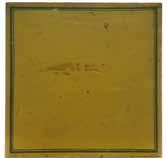
132E Vintage cranberry scoop, circa 1900. With wooden tongs that measure 21”. 22” wide x 7” deep. Stand included.
Provenance: Martin and Deborah Maloy collection. (500 - 800)
132F Painted lift top box. With decorative design; yellow and red with a Pennsylvania style looking bird on front panel. Box measures 8” x 12” x 6”. Original condition; some chips and flaking on top of box; light crazing in paint; rough edges in front area near lock.
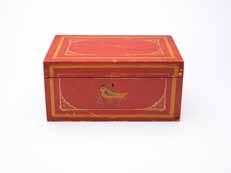
Provenance: Martin and Deborah Maloy collection. (500 - 800)
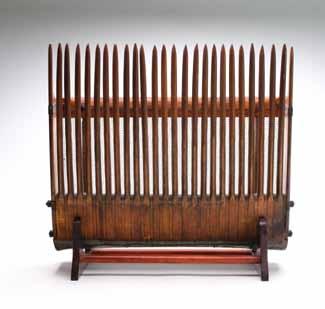
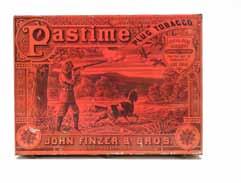
132G Tobacco tin, Past Time Plug Tobacco. Excellent graphics of hunter snipe hunting with dog. From the John Finzer and Brothers Company, Louisville, Kentucky. Folding lid tin box measures 9.25” x 12.5” x 4”. Very good overall condition; a few small areas of flaking.
Provenance: Martin and Deborah Maloy collection. (300 - 600)
132H Vintage sleigh, circa 1900 or earlier. Made from wood and bent iron. Cloth seats and old red paint that is probably a second coat. Carriage measures 58” long and 38” wide. Please review online photos for a better idea of condition.
Provenance: Martin and Deborah Maloy collection. (1,500 - 2,500)
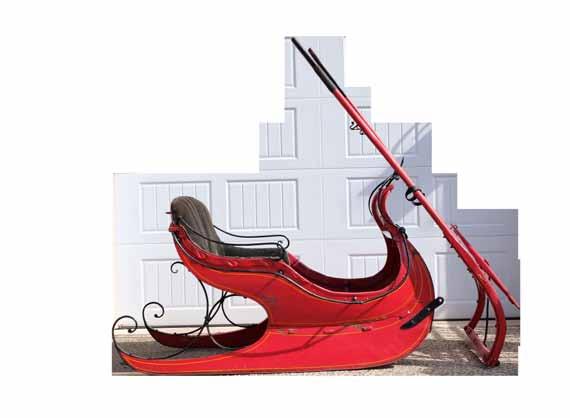
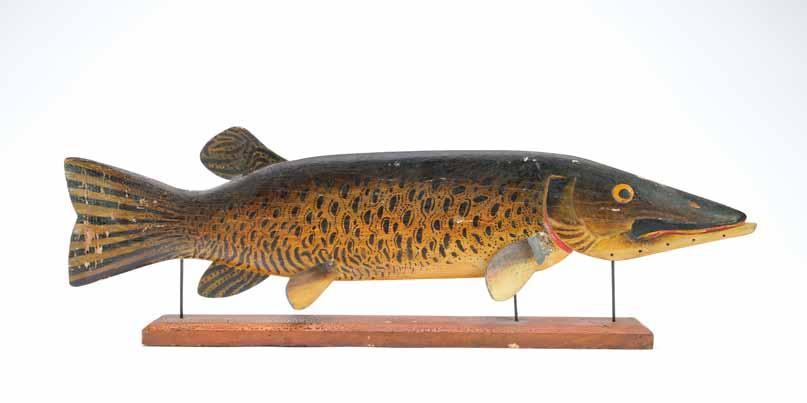
132I Oscar Peterson (1887-1951), Cadillac, Michigan. Rare two sided trade sign of a carved eye musky. Applied and inserted metal fins. Measures 25” in length. Fish is mounted a very long time ago on a board that has crazed surface. Two earlier holes one in top of head and one at top of tail were probably used to hang the fish. Also has an early holed drilled through back. Strong original paint protected by a coat of varnish that has crazed; some paint loss at fins and tail; a few small areas where paint flakes have been darkened.
Provenance: Martin and Deborah Maloy collection. (15,000 - 20,000)
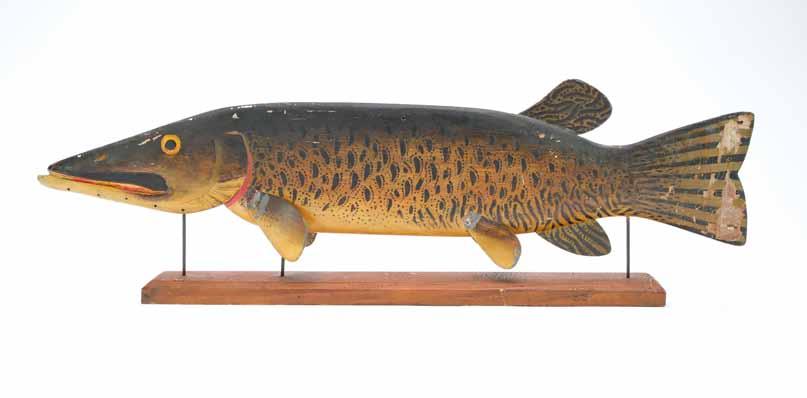

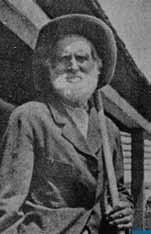
A barrier island off the coast of Virginia, Cobb Island was probably first called Sand Shoals (Island). This was to change with the arrival of an ambitious, hard-working and prolific family.
The patriarch of this clan, Nathan Cobb Sr., was born on December 15, 1797 in Eastham on Cape Cod, Massachusetts. He arrived in Northampton County, Virginia with his family in October of 1837. He soon opened a “Yankee sore” (original spelling). In 1838, he purchased what was to become Cobb Island from “hard time Fitchett” for $100 dollars and a two-horse wagon load of salt. There were no buildings on the island and Nathan had a structure framed in Massachusetts and transported there. He was married three times and lived to see 62 children, grandchildren and great grandchildren.

Continued

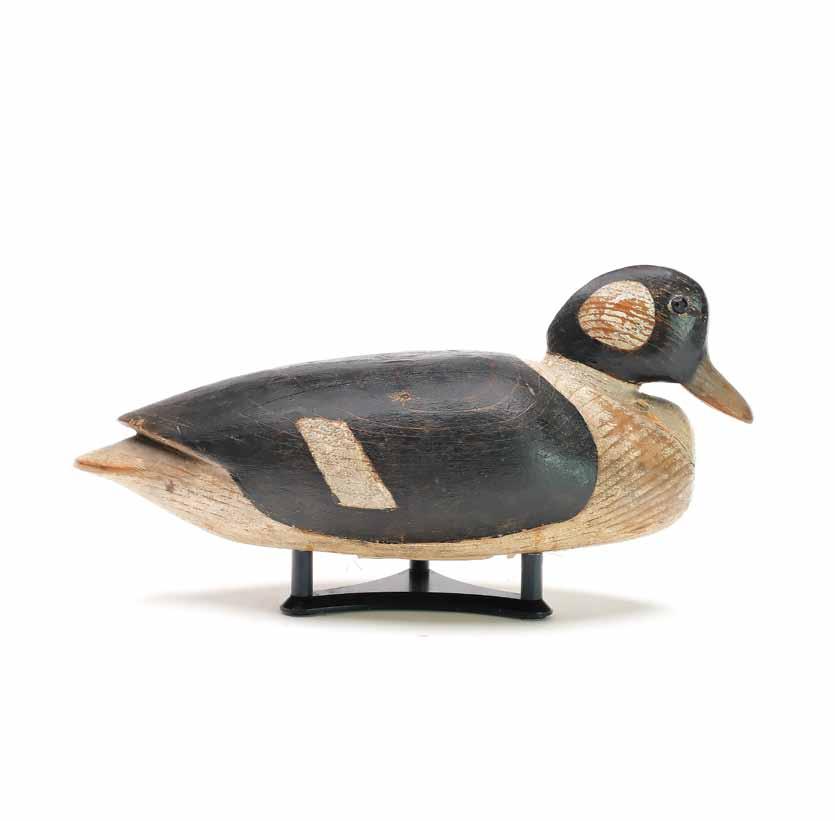
133 Nathan Cobb, Jr. (1825-1905), Cobb Island, Virginia. Rare bufflehead. Inlet neck seat and relief wingtip carving. Serif “N” carved in underside. Measures 12” long. Original paint with moderate flaking and wear; thin coat of varnish or wax; drying cracks along back and one side that were tightened by small nails; tight crack through neck and one side of head near eye; tiny chip in one eye and wood near the same eye; tiny spot of touchup to chip.
Provenance: Private collection, purchases at an antique shop in Ocean City, MD in the early 1970s. (50,000 - 80,000)
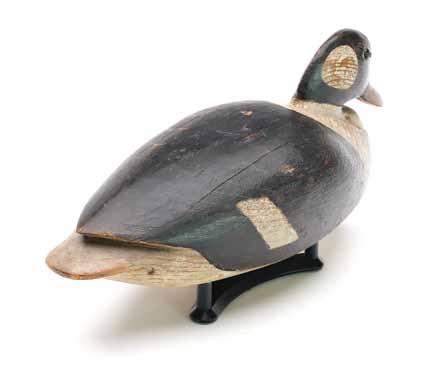
The extended family eventually established a successful hotel on the tiny island which hosted visiting sportsman. In addition, they gunned for the market, raised their own vegetables, and guided. The hotel was well received and did a very good business as noted by one visiting guest in 1874.
“The main hotel is surrounded by grand old willows, and a large grape arbor is in front, where boarders sit and smoke after gathering figs from the trees around the house and watermelons and cantaloupes from the vines.
A few rods from the house the beach is seen, where the surf bathing, for which the island is famous, can be had at all hours.
The fishing and yachting is splendid here, but the gunning is the wonder of our party. Duck, snipe, plover, willets and a new bird, the “bost” was shot by our young nimrods. We live on game shot the same day, fish just out of the water, soft crabs and oysters pulled from their briny homes an hour before they are cooked”
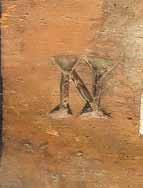
In addition to this prosperous venture, the family eagerly participated in the lucrative wrecking business. Numerous vessels were lost off the barrier islands and the Cobbs were quick to respond to any possible rescue of the crews and salvage of the cargos. This was the predecessor to the Life Saving Station that was eventually located on the island.
Unfortunately, all of this was to succumb to an inevitable fate. A series of storms swept the Island and all of the buildings were eventually lost as the land was reclaimed by the sea. The Island today is a bird sanctuary.
A few artifacts from the hotel and the life saving station remain as mementos of the Cobb’s rich history but it is the artful decoys carved by the family that serve as a fitting tribute to their lives on the Island. Although these decoys often contain the brand of various family members, many believe that they all may have been carved by Nathan Cobb Jr. (1825 – 1905).
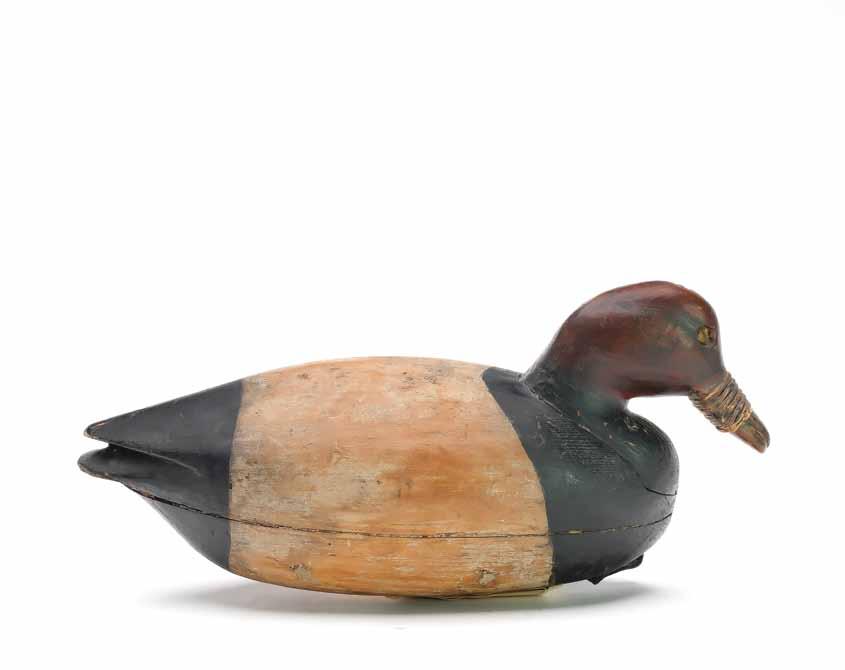

134 Nathan Cobb, Jr. (1825-1905), Cobb Island, Virginia. Rare hollow carved redhead. Inlet neck seat, carved eyes, and raised wingtips. Serif “N” carved in underside. Slight eye groove carving. Measures 14” long. Original paint with moderate wear; very early and thin wash to black areas; an old chip in bill was reset with tightly wrapped twine; tight drying cracks near tail and breast; very lightly hit by shot.
Provenance: Private collection, purchases at an antique shop in Ocean City, MD in the early 1970s. (30,000 - 40,000)

135 Doug Jester (1876-1961), Chincoteague, Virginia. Rigmate pair of pintails. With raised neck seats and scratch feather paint detail. Measure 19” long. Original paint with minor discoloration and wear; excellent structurally.
Provenance: Bill and Alice Walsh Collection. Obtained from Arthur Addison, Cape Charles, VA 1976.
Literature: “Decoys of the mid-Atlantic Region” by Henry A. Fleckenstein Jr., page 200, exact decoys pictured.
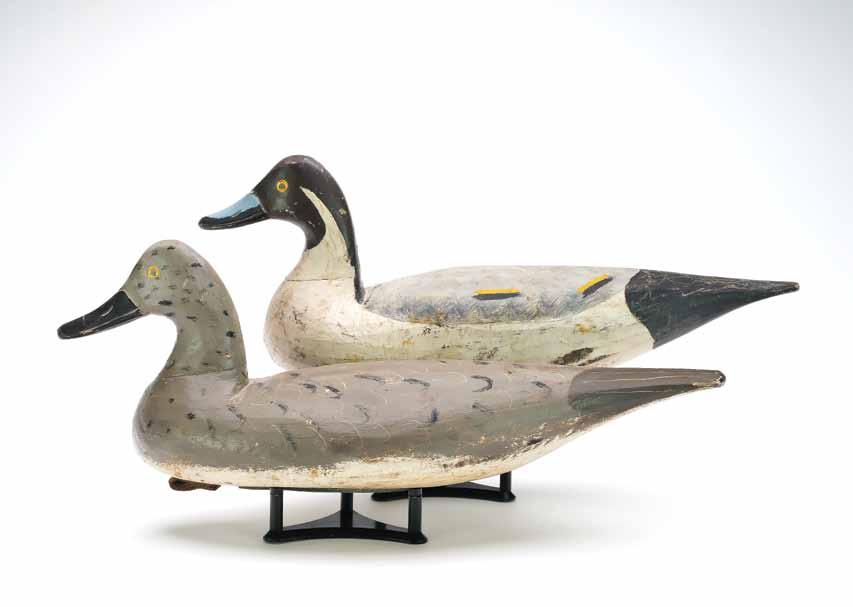

136 Doug Jester (1876-1961), Chincoteague, Virginia. Red-breasted merganser with raised neck seat and extended crest. Measures 15.75” long. Original paint with moderate flaking and wear; small chip to one extended tine of crest; another that was cracked and tightly rest.
Provenance: Bill and Alice Walsh Collection. (2,000 - 3,000)
137 Doug Jester (1876-1961), Chincoteague, Virginia. Excellent redhead with raised neck seat. Measures 15.75” long. A few very minor paint rubs, otherwise excellent and original.
Provenance: Bill and Alice Walsh Collection. Obtained at the Bourne Auction, July 1976 #255. (1,000 - 1,400)

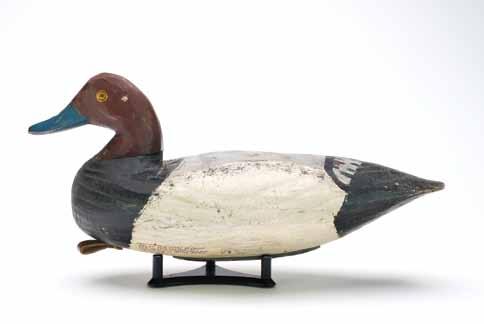
138 Doug Jester (1876-1961), Chincoteague, Virginia. Near mint black duck. Scratch feather paint detail on body and head. Decoy was rigged and weighted but doesn’t appear to have been used. Measures 14.25” long. Excellent and original.
Provenance: Bill and Alice Walsh Collection. Obtained from Don Howes of Brewster, MA who bought it at the Bourne Auction 1975, item 672. Winner 1981 Greater Snow Goose Decoy Contest, Best Doug Jester Black Duck. (800 - 1,200)
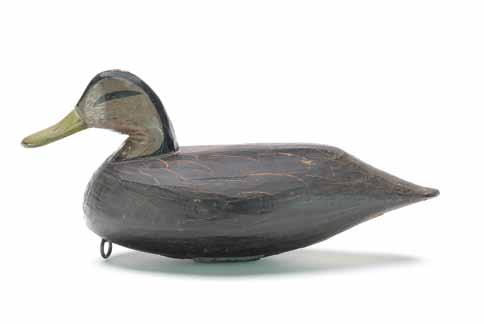
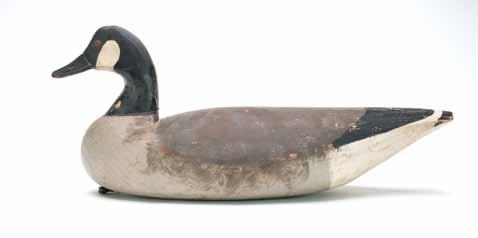
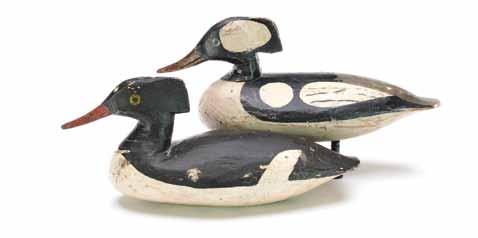
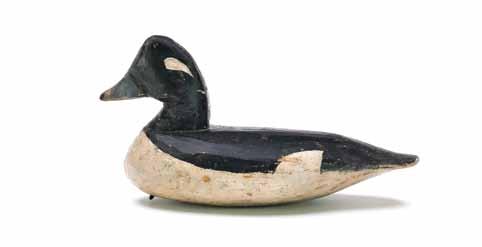

139 Doug Jester (1876-1961), Chincoteague, Virginia. Canada goose with raised neck seat and tack eyes. Hole drilled in underside for use as a stick up. Measures 24.25” long. Original paint with minor gunning wear; fine drips of white paint over back and tail area; crack through neck and tight cracks at nails in neck.
Provenance: Bill and Alice Walsh Collection. Obtained from Brooks Taylor, Mappsville, VA.. Winner Best Doug Jester Goose 1981 Greater Snow Goose Decoy Contest.
Literature: “Decoys of the mid-Atlantic Region” by Henry A. Fleckenstein Jr., page 215, exact decoy pictured. (3,000 - 5,000)
140 Doug Jester (1876-1961), Chincoteague, Virginia. Pair of hooded mergansers with extended crests. Both stamped “DWS” for the Don Snyder collection. Also with the Peter Muller collection ink stamp. Measure 11.75” and 12.25” long. Original paint with moderate wear; tight crack through drake’s neck; hen’s bill was cracked down and reglued with an old chip at one side of tip; some white paint added to underside of each.
Provenance: Don Snyder collection. Peter Muller collection. Martin and Deborah Maloy collection. (3,000 - 5,000)
141 Doug Jester (1876-1961), Chincoteague, Virginia. Bufflehead hen. Measures 10” long. Original paint with very minor wear; very good structurally.
Provenance: Bill and Alice Walsh Collection. Obtained at Doyle Auction 1981.
(700 - 1,000)
142 Doug Jester (1876-1961), Chincoteague, Virginia. Unused bufflehead with slightly raised neck seat. Decoy was never rigged or weighted. Measures 11.25” long. Original paint with minor paint rubs; some paint shrinkage on tail; drying split along the underside; defect in top of wood from when the decoy was made.
Provenance: Bill and Alice Walsh Collection.
Obtained from Somers Headley, Wilmington, DE who bought from SDN Jester 1950.
(800 - 1,200)
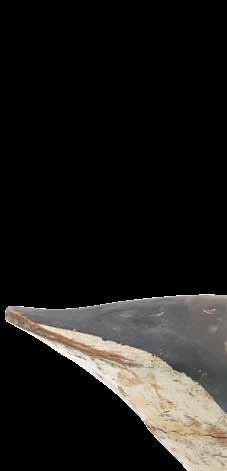
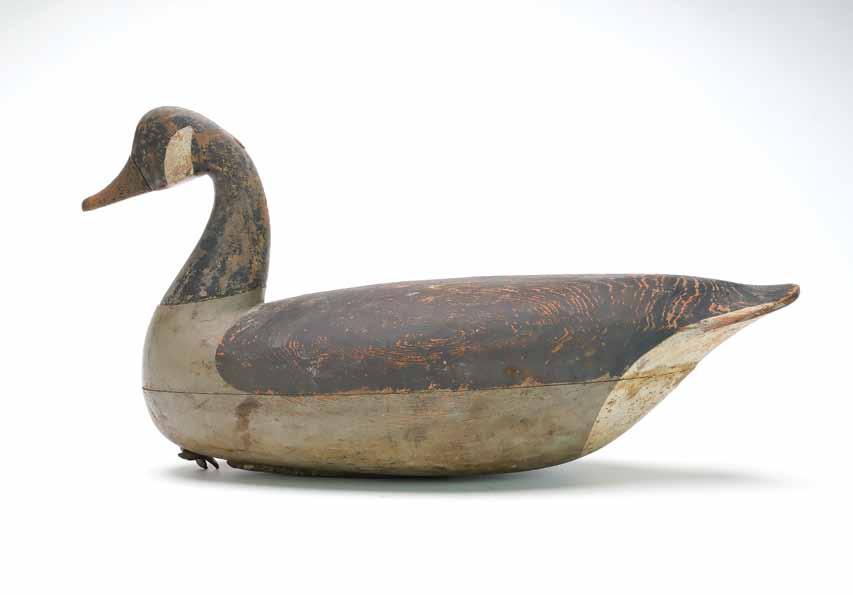
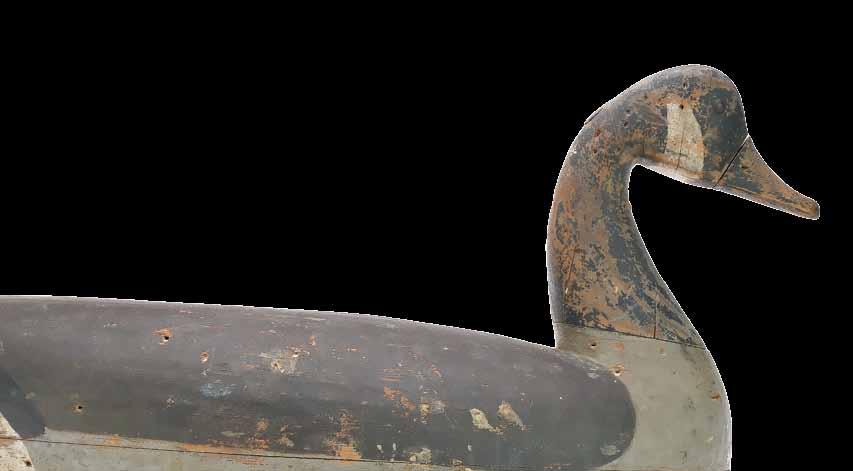
143 Charles Birch (1867-1956), Willis Wharf, Virginia. Hollow carved Canada goose with tack eyes and splined bill. Measures 23.5” long. Original paint with moderate to significant flaking and wear; moderately hit by shot; old glue added to separation at body seam near tail; fine cracks in head and at neck seat.
Provenance: Martin and Deborah Maloy collection. (6,000 - 9,000)
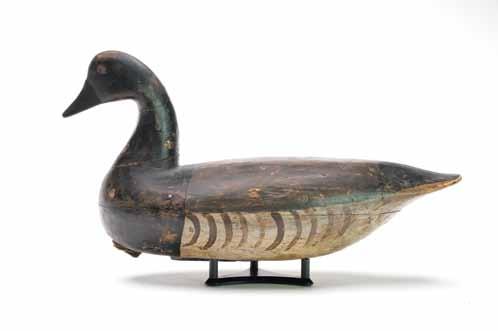
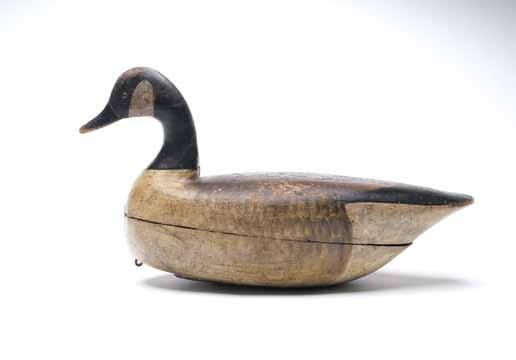
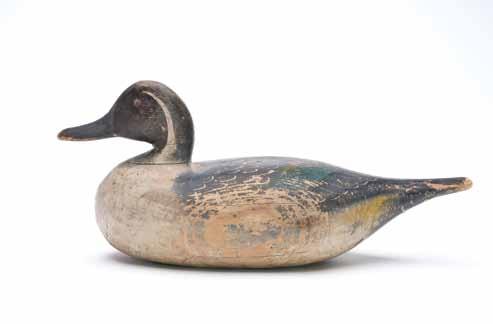
144 Charles Birch (1867-1956), Willis Wharf, Virginia. Hollow carved brant with tack eyes. Measures 17.5” long. Original paint with moderate gunning wear; small dents and shot marks; tight crack through neck; bill was cracked down and tightly reset.
Provenance: Martin and Deborah Maloy collection. (5,000 - 8,000)
145 Ira Hudson (1873-1949), Chincoteague, Virginia. Hollow carved Canada goose with raised neck seat and tack eyes. Measures 23” long. Original paint with moderate flaking and wear; separation at body seam; two cracks in neck were professionally restored; many small dents and scratches on back; drying cracks in breast and under tail area; bill was cracked down and professionally reset. (2,500 - 3,500)
146 Norman Hudson (1898-1980), Chincoteague, Virginia. Pintail with scratch feather paint detail and tack eyes. Measures 17.75” long. Original paint with moderate flaking and wear; significant flaking on one side; hairline crack through neck; tight drying cracks along sides.
Literature: “Ira D. Hudson and Family” by Henry H. Stansbury, page 125, exact decoy pictured. (2,000 - 3,000)
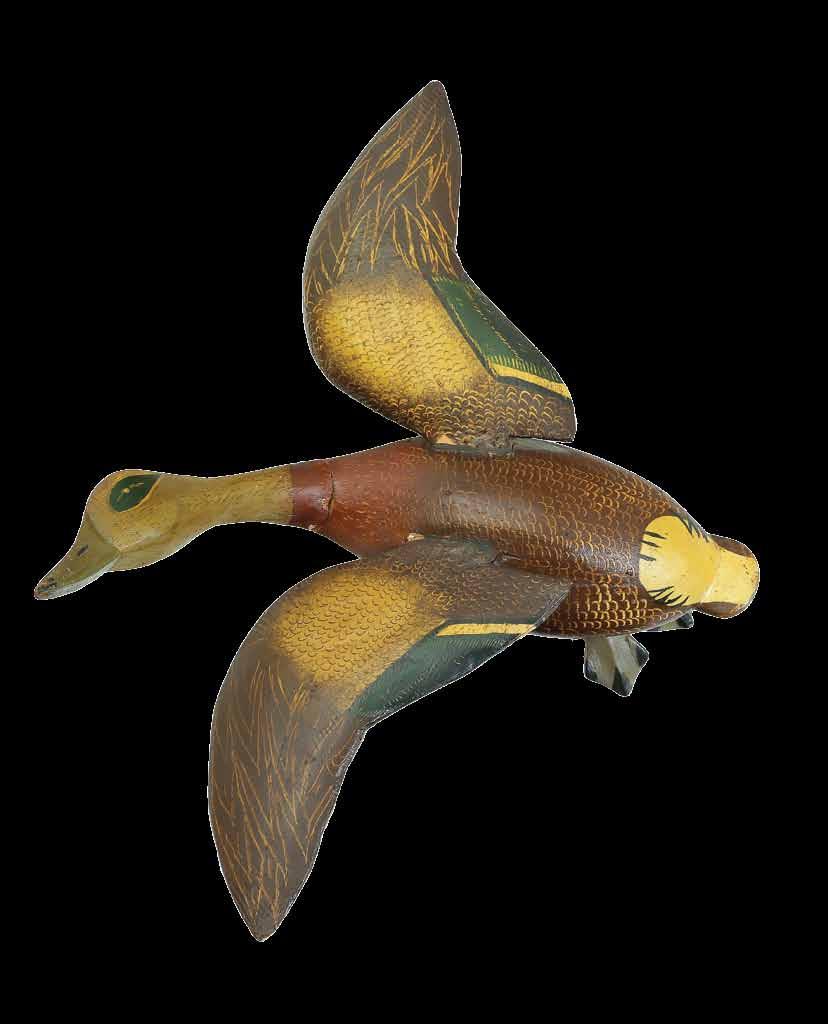
147 Delbert Hudson (1928-1980), Chincoteague, Virginia. 2/3 size flying widgeon. Applied wings and feet. Outstretched head that is slightly turned. Scratch feather paint detail. Signed and dated 1949 on underside of wing. Measures 14.25” long, with a 18.5” wingspan. Original paint under a thick coat of varnish that has darkened with age; flaking to filler at neck seat and where wings join to body; some touchup where wings join to body; small chew marks and roughness on tip of bill. (5,000 - 8,000)
Some names in the world of decoys need no introduction. So it is with the Ward Brothers. Influenced by their environment on the eastern shore and the hunting and carving traditions of their father, Travis, and the various members of the Sterling family, they began to carve very early in their lives. Each had been hunting since their teens and Steve is said to have made his first crude decoy at the age of 12. By the time of WWI, they had begun to carve in earnest, following in the broadly defined parameters of the established Crisfield School.
In 1918, Lem made and sold his first rig of decoys with their now well known “fat jaws” expression. Hunters and keen observers of nature, the brothers realized that if they wanted to shoot more ducks, they would need the most attractive and realistic decoys. Thus, always seeking perfection, their early styles
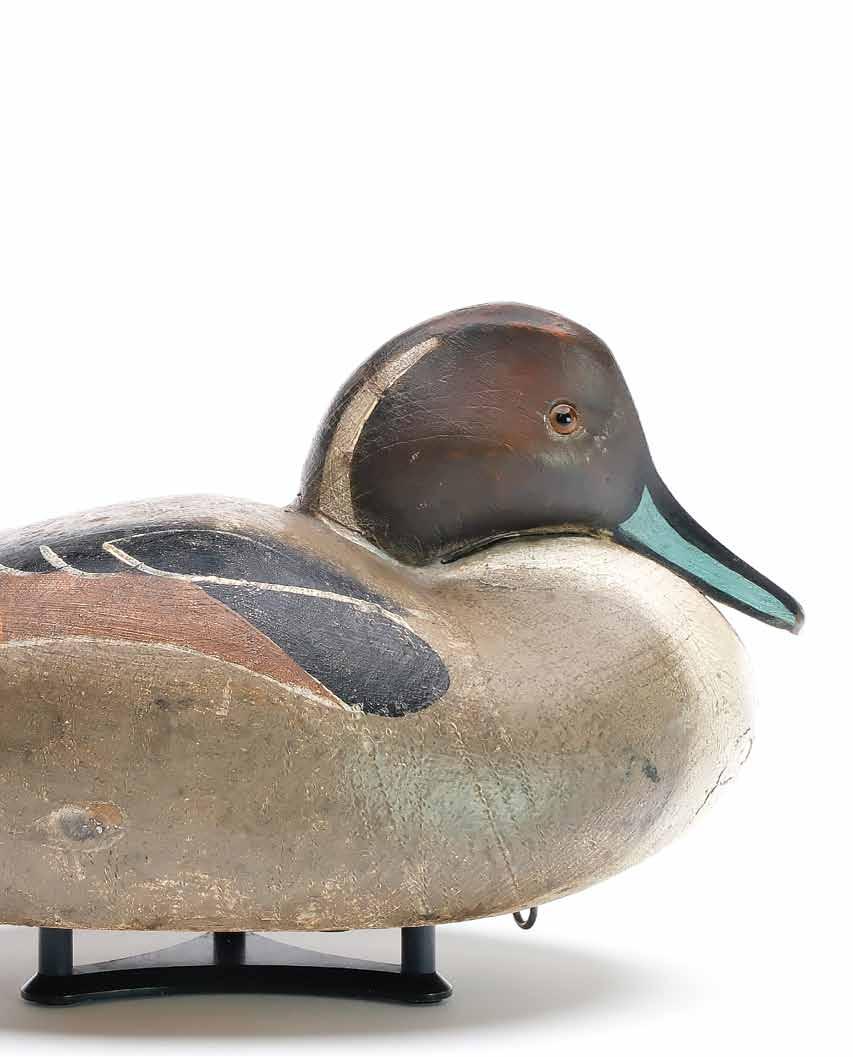
rapidly went through a staggering evolution of design changes. The fat jaws model gave way to their early 1920s “raised wing” design and then, arguably their most artistic concept, the “hump backs”, entered the repertoire around 1925. Even within this broadly defined timeline, subtle alterations were made to the basic plan. Heads were positioned in various poses and heights, and in the pintails, the tails themselves saw experimentation. As noted in a recent 2024 article by Joe Engers, “Many of the most dramatic designs were utilized on their pintail decoys, which possess a variety of sizes of wide paddle tails, often referred to as ‘beaver tails’ - - - “.

In terms of species and sheer numbers of decoys produced early in their careers, one needs to understand the environment of Crisfield at the time. Life was intimately tied to the Bay and so called “sport hunting” was still somewhat in its infancy. The local gunners were men who had, until fairly recently, hunted for the market or, to simply place food on the table. The most desirable duck was the canvasback and probably more decoys for that species were carved than any other. Pintails were also popular but surely, they were outnumbered by decoys for the “king of ducks”. Until about 1950, the brothers’ primary occupation was that of barbers, with decoys being, basically, a sideline. They did not acquire their first band saw until the 1930s so
their beavertail designs were an entirely handmade product and timely to produce. Steve once stated that prior to 1930, he and Steve had only made a total of about 500 decoys. Of these it is safe to assume that most would have been for canvasbacks with fewer representing blackheads (bluebills), goldeneye, widgeon and, finally, pintails. Couple this with the brothers’ changing styles during the period and it would seem safe to assume that the hump back, beaver tail pintails were quite few in number and the deeply tucked, snugglehead example being offered here, is very likely unique.
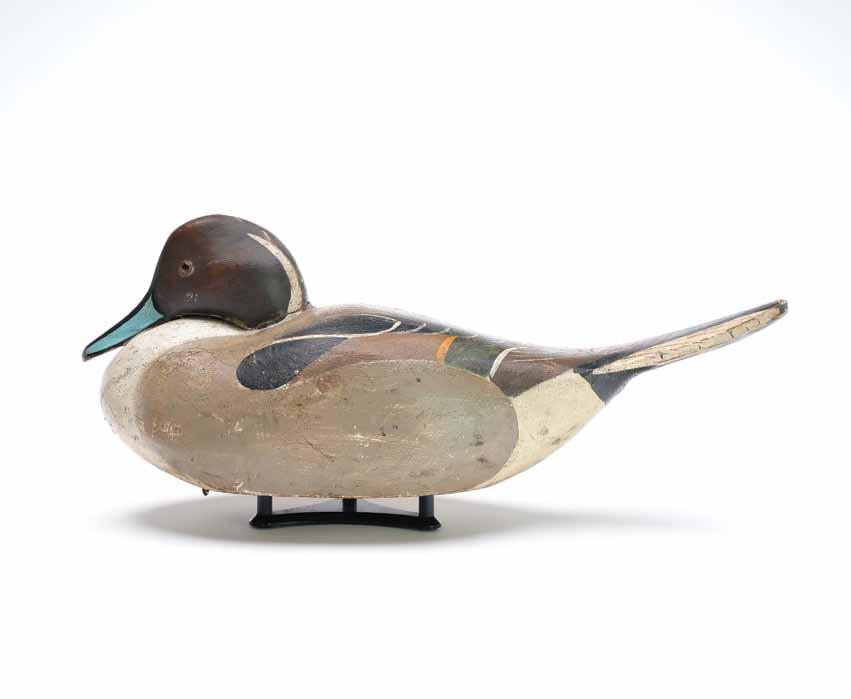
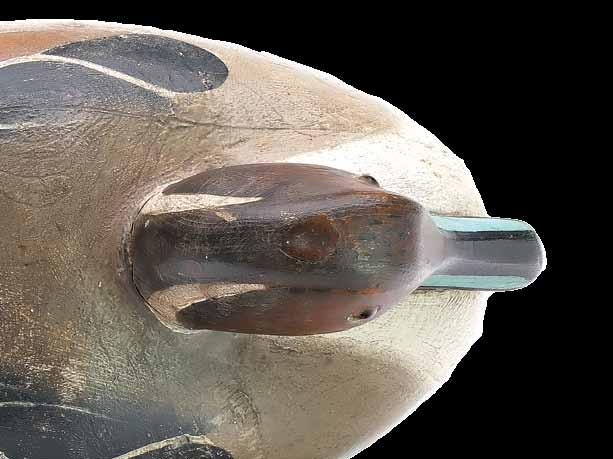
148 Ward Brothers, Crisfield, Maryland. Pintail drake in the beaver tail style and the only bird in this rig with a resting pose. Three other drakes with high necks are known, but this is the only one like this. The nestled head and puffed breast accompanied with the slightly raised back and flat beaver tail, combine to make this one of the Ward’s true masterpieces. Measures 18” long. Excellent original paint with a few small dents discoloration spots, and tiny areas of edge wear.
Provenance: Ron Gard collection, author of “The Ward Brothers’ Decoys: A Collector’s Guide”.
(150,000 - 250,000)
149 Ward Brothers, Crisfield, Maryland. Excellent sleeping mallard hen. Slight relief wing carving and raised wingtips. Identified and signed on underside. “SGH” stamped on underside for collection of Somers Headly. Measures 15” long. Excellent and original.
Literature: “The Ward Brothers Decoys: A Collector’s Guide” by Ronald J. Gard and Brian J. McGrath, page 87, exact decoy pictured. (10,000 - 14,000)

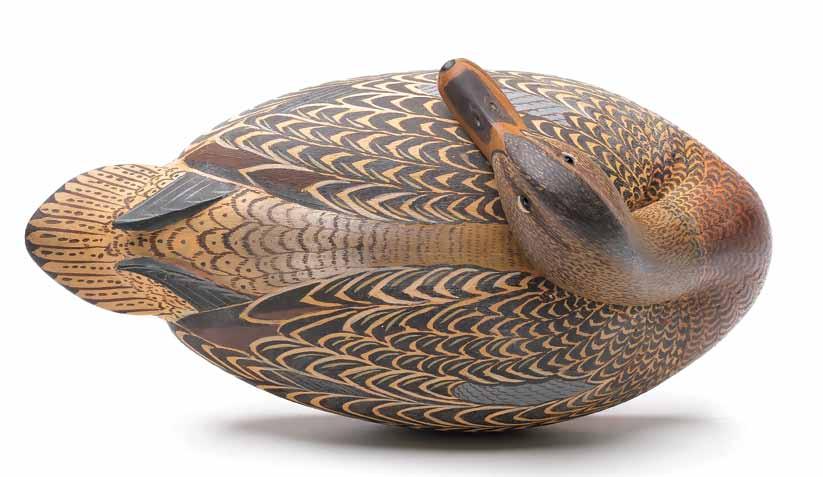
150 Ward Brothers, Crisfield, Maryland. Knot head style canvasback with thick stipple paint and wide head carving. Measures 17.25” long. Original paint with moderate flaking and wear; crack through upper part of neck; some whittling and filler restoration at neck seat with touchup in that area; small chip in one side of bill tip. (5,000 - 8,000)
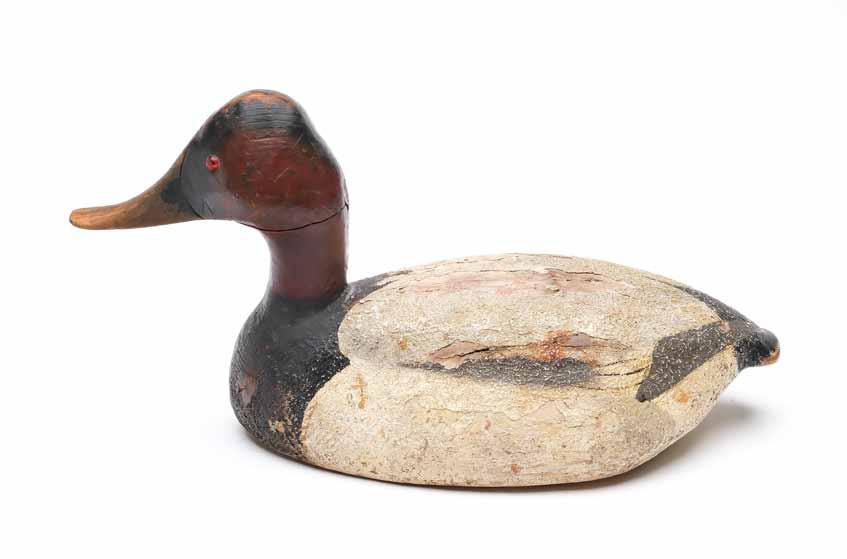
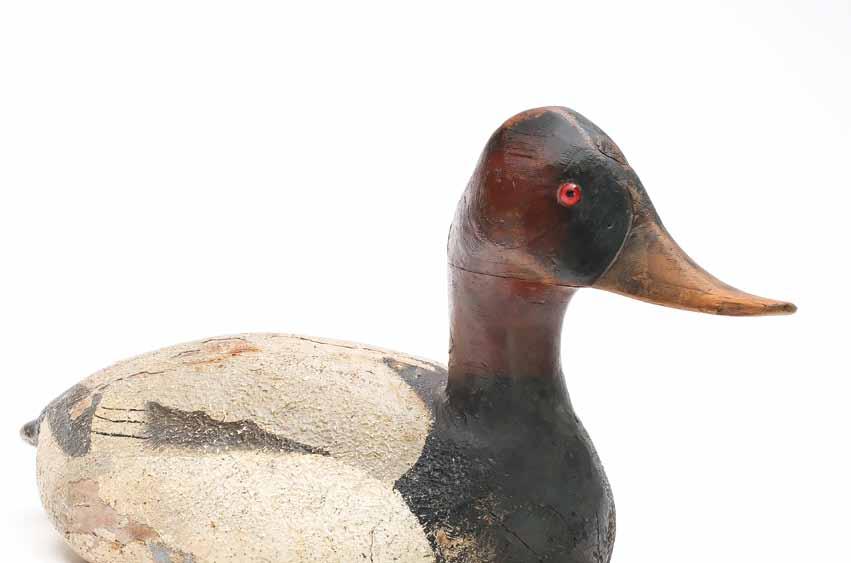


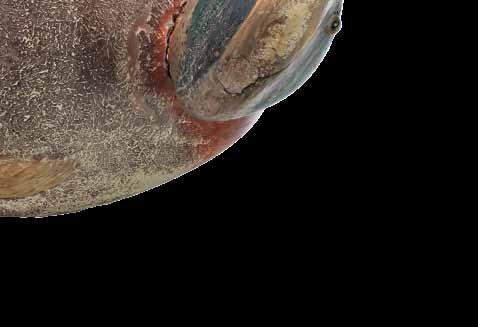
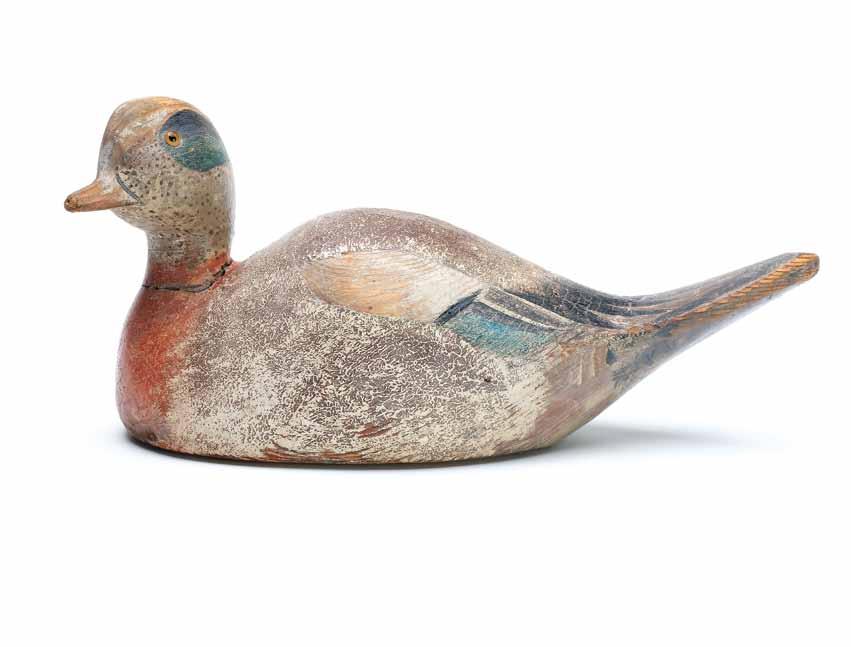
150A Ward Brothers, Crisfield, Maryland. Very rare hump back style widgeon drake, circa 1925. With turned head, extended, upswept tail and stipple paint on back and sides. This important decoy was used on a print of Ward Brothers decoys by Milt Weiler. And is the only humpback widgeon we have offered in the last two decades. Measures 15” long. Original paint with a light cleaning to the wing patches where a white wash was removed; paint strengthening to the head, mostly to one side of face, done by Milt Weiler prior to creating the illustration work for his Ward Brothers print.
Literature: “American Decoys” by Quintina Colio, page 3, exact decoy pictured in reverse. “Bird Decoys of North America” by Robert Shaw, page 205 and back cover, exact decoy pictured. (80,000 - 120,000)
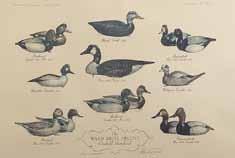
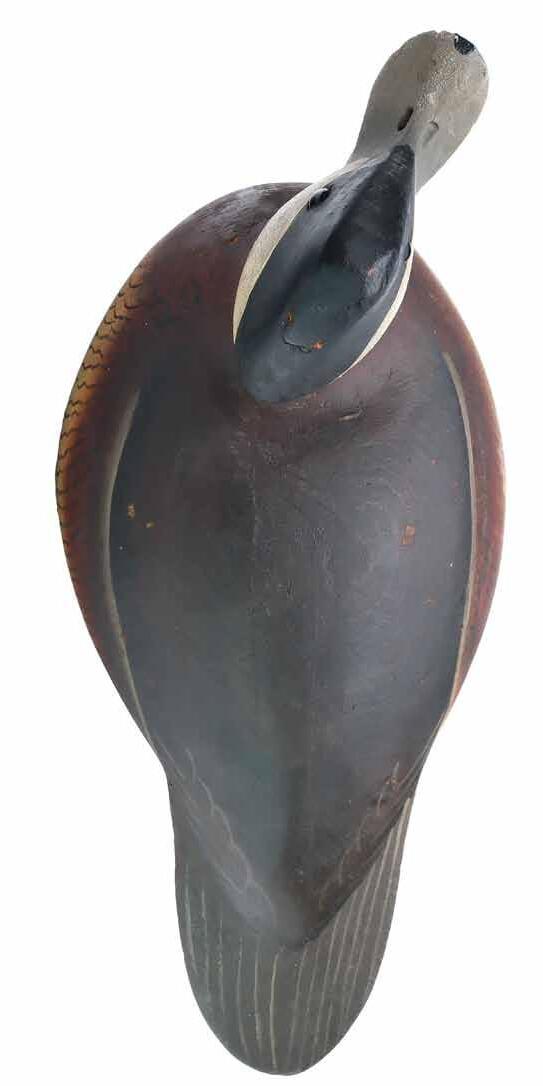

To the best of our knowledge, the “Prescott collection” name first appeared in a Richard Bourne auction in July of 1981. Nineteen lots were offered, all with the same provenance – “Prescott Collection.” Fifteen of the of the decoys were working but unrigged cedar gunners, dated to the early 1930s. The identifying link on all of them is the white painted underside with the species of each painted within the black banner. The decoys offered in the Bourne sale included pintail pair, shoveler pair, canvasback pair, redhead pair, bluebill pair, and a goldeneye drake.
Several years later, in Loy Harrell’s book, “The Hundred Greatest,” the owner of a widgeon drake pictured on page 160, with the same painted underside banner adds that it was ordered by a Connecticut collector directly from the Wards in 1928. He also states that, included in the order was a goldeneye hen and the only known working brant. One can easily assume that the Connecticut collector that ordered the decoys was Mr. Prescott. Since that time, other decoys with the same species marking and quality characteristics have surfaced. To our knowledge, this is the only ruddy duck from that group of decoys and it remains the only 1936 style cedar ruddy duck known.
150B Ward Brothers, Crisfield, Maryland. Possibly the only known cedar body ruddy duck, circa 1940. Made in the 1936 gunning style. Retains Ward Brothers stamp on underside with the words “Male Ruddy Duck.” Carved, extended dropped tail with slightly turned head and splayed bill. Measures 14” long. Excellent original paint with a few small rubs and tiny wear spots.
(60,000 - 80,000)
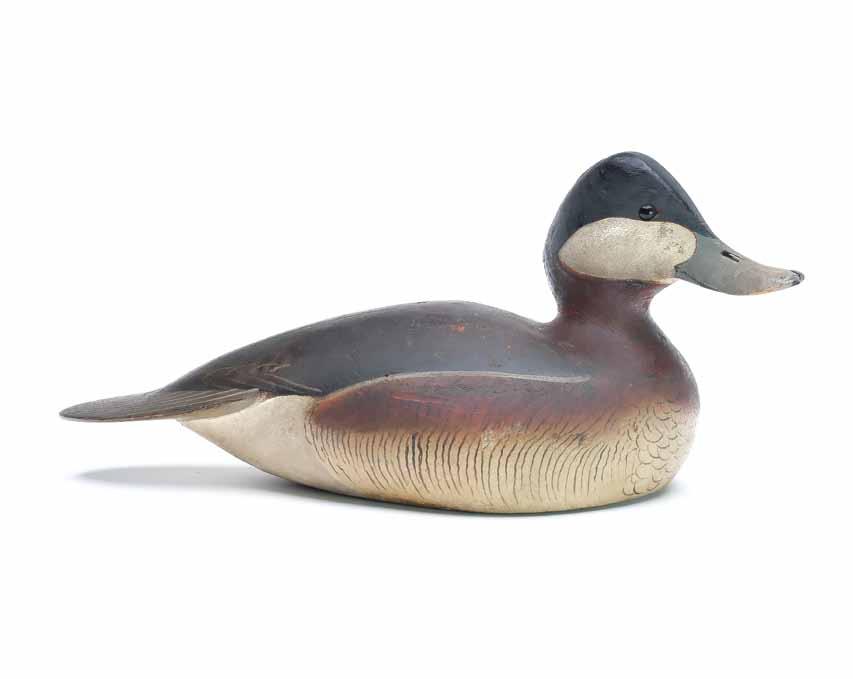
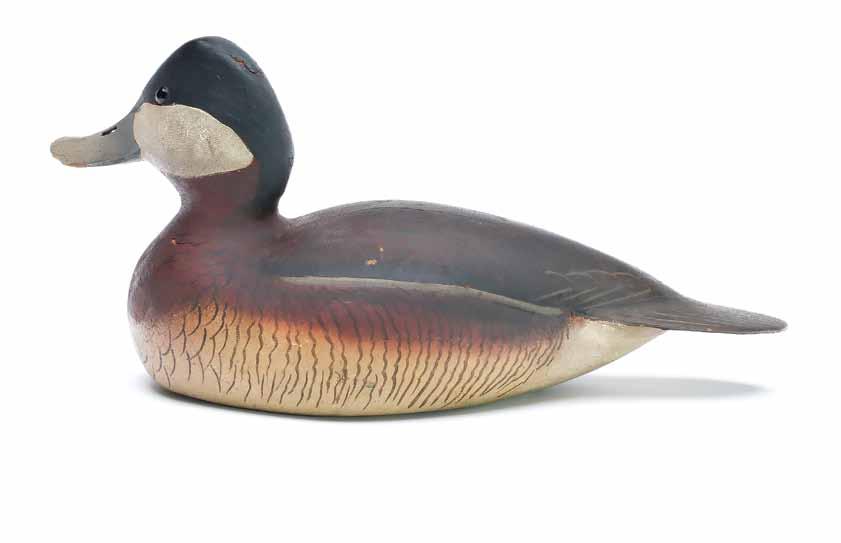
151 Ward Brothers, Crisfield, Maryland. 1932 model broadbill with wide bill carving and thick stipple paint on back. Signed and dated 1930 on underside of tail. Measures 16.25” long. Original paint with moderate gunning wear; early thin wash of black on breast and head; old chip in one side of tail, otherwise excellent structurally. (10,000 - 14,000)

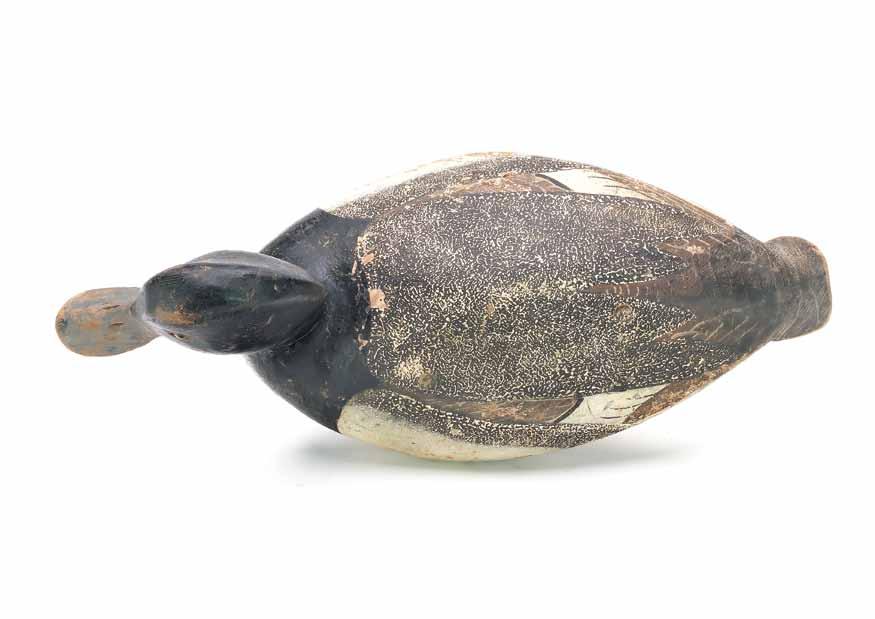

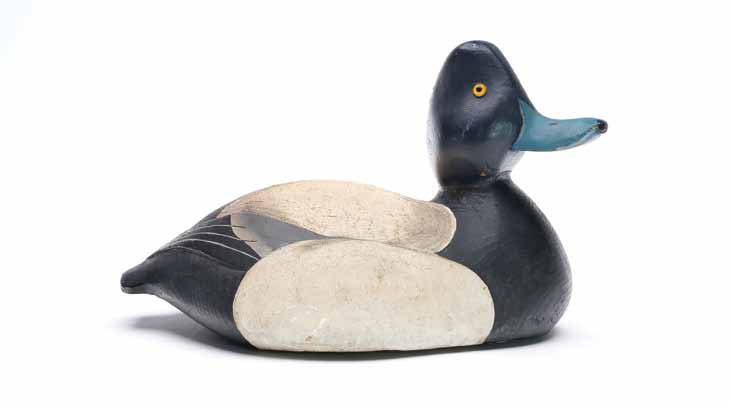
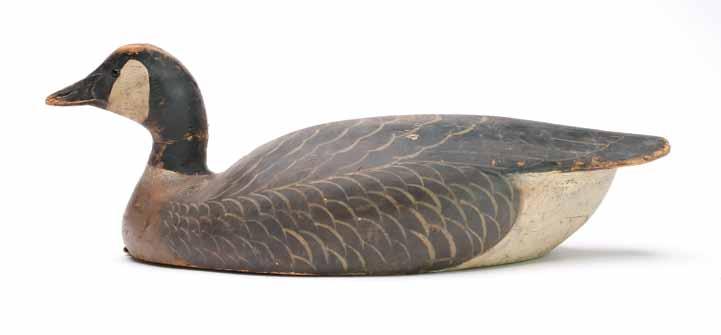
Ward Brothers,
Maryland.
fat jaw style bluebill. Relief wingtip carving and slightly turned bulbous head. Signed and dated 1932 at a later date. Measures 13.75” long. Second coat of paint by the makers with minor wear; hairline cracks in back and breast; small dent in back.
(2,000 - 3,000)
Ward Brothers,
Maryland. Canada
with slightly turned head. Signed and dated 1936 on the underside. Measures 24” long. Original paint with moderate gunning wear; tight drying cracks in back; split along the underside runs up breast and tail area; old chipping and roughness on tip of bill; crack through neck with an old nail added to secure.
Provenance: Martin and Deborah Maloy collection. (4,000 - 6,000)
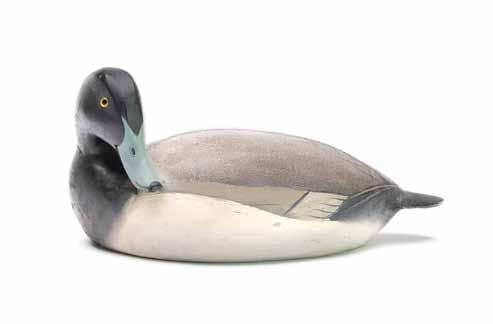


154 Ward Brothers, Crisfield, Maryland. Rare side preening bluebill. Balsa body with thick stipple paint on back. Signed and dated 1947 on underside. Measures 13.5” long. Original paint with very minor wear; hairline separations at balsa seems; hairline cracks near base of neck.
(5,000 - 7,000)
155 Ward Brothers, Crisfield, Maryland. Greenwing teal hen with slightly turned head. Measures 12” long. Original paint with very minor wear; bill is a professional replacement; professional tail chip repair.
Provenance: Martin and Deborah Maloy collection. (3,000 - 5,000)
156 Ward Brothers, Crisfield, Maryland. Greenwing teal. Slightly turned head and extended crest. Measure 12” long. Original paint with minor to moderate flaking and wear; filler and touchup above nail hole on top of head; drying crack along the underside; bill is a professional replacement.
Provenance: Martin and Deborah Maloy collection. (5,000 - 8,000)
157 Ward Brothers, Crisfield, Maryland. Pair of widgeon with slightly turned heads. Balsa bodies are signed and dated 1948 on the underside. “P” branded on the underside of each. Measure 14.5” long. Original paint; with moderate gunning wear; many small dents and shot marks; rough area on each side of drake; roughness on edge of hen’s bill. (3,000 - 4,000)
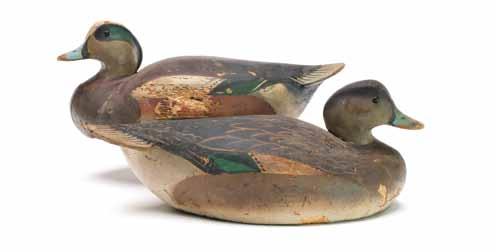
158 Ward Brothers, Crisfield, Maryland. Appealing pintail with slightly turned, reared back head. Thick stipple paint and wide cheek carving. Measures 16.25” long. Original paint with significant flaking and wear; hairline crack in one side of neck; minor roughness on tip of tail. (3,000 - 5,000)

159 Ward Brothers, Crisfield, Maryland. Hollow carved bluebill with relief wing carving and head turned 45 degrees. Signed and dated 1972 on underside. Also stamped “GTH”. Measures 15” long. Original paint that has darkened slightly with age; very minor wear; some filler restoration around neck seat.
(1,500 - 2,500)

159A Ward Brothers, Crisfield, Maryland. Excellent pair of 1/3 size pintails. Both with slightly turned heads, raised wingtips, and relief carved side pockets. Each is signed and dated 1965 and with the Ward’s best grade miniature ink stamp. Measure 9.5” and 11” long. Excellent and original.
(2,000 - 3,000)
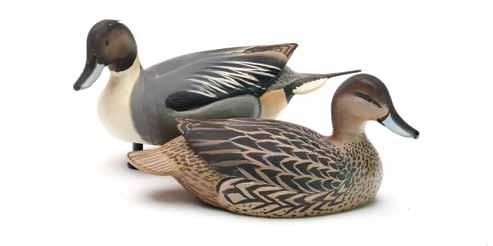
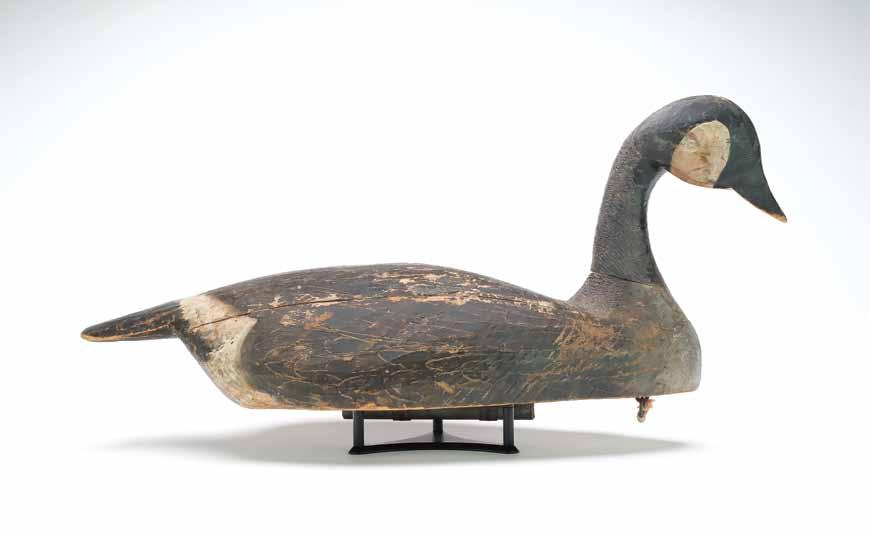
160 Lloyd Tyler (1898-1971), Crisfield, Maryland. Canada goose, 1st half 20th century. Extraordinary example of Tyler’s work. Slightly turned and downlooking head with one of the fattest jowls we have seen on a Tyler piece. Carved ice groove behind the neck. Extended, slightly dropped tail. Measures 25” long. Strong original paint; fine scratch painting; natural cracks in length of body; in the making filler area with rubs to bare wood all from light in use wear.
Provenance: Bill and Alice Walsh Collection. Obtained from Vernon Berg 6/19/1982. (5,000 - 8,000)

Although he is known to have been a very accomplished decoy carver and close friend and associate of the Ward brothers, the decoy literature is almost devoid of any biographical information concerning the man known as “Lloyd Sterling”. He is recorded variously as being one Lloyd B Sterling or Lloyd Aaron Sterling (1880 – 1964). Unfortunately, neither individual can be found as ever living in Crisfield, Maryland. The puzzle was finally solved in a recent phone conversation with Oliver (“Tuts”) Lawson (1938 – present). Mr. Lawson knew Sterling personally and he was a member of the small, intimate group of local carvers, including Sterling, that would meet on a regular basis, either at the Ward’s shop or at Ed Thorton’s store in Crisfield.
Tuts vividly remembers Sterling as always being called “Mr. Lloyd Aaron” . Lawson clearly recalled that Sterling’s brother was Clinton Sterling and that his wife’s name was Mariah and his son’s, Maurice (aka “Chuck”). He remembers Lloyd Aaron as being quite elderly (“in his 90s”) when he died. With that information, the carver’s true identity was finally revealed.
Possibly due to the fact that the Sterling’s were a very large family in town, many members of the group would often use nicknames to differentiate themselves from others with similar names. Lloyd, the carver, would use his given name (“James Lloyd” or, more commonly, “J Lloyd”) on all official documents but, either by choice or circumstance, he was known locally as “Mr. Lloyd Aaron” . Lloyd was born into a family of oystermen and, like many in Crisfield, he would spend his entire life in the
seafood industry. After 7th grade, he began to oyster and, in 1902, he married Mary Marie Lawson (aka “Miss Mariah”, aka “Maria”). Apparently, he was an enterprising young man and by age 30, he had become a wholesale seafood dealer. A 1952 article in an Easton (MD) newspaper lists a James Lloyd Sterling as owning one of the larger oyster houses in Crisfield. His wife died in 1962 and she and Lloyd (who died at age 84, not 90) are buried in the Asbury cemetery in Crisfield.
As noted by early author and collector “Bobby” Richardson: “Prior to 1900, most decoys in the area were black ducks and a few widgeon. Goldeneyes were favored as the diving species with some scaup and buffleheads. It was not until about 1917, when large concentrations of pintails showed up in the bay area, that pintail decoys (in numbers) begin to be made”.
The pintail drake offered here clearly demonstrates the influence that the Ward’s had on the Crisfield school and many feel that Sterling’s work rivals that of the best of the early Ward’s.
NOTE: Guyette and Deeter would like to thank Oliver Lawson and Cameron McIntyre for their invaluable assistance.
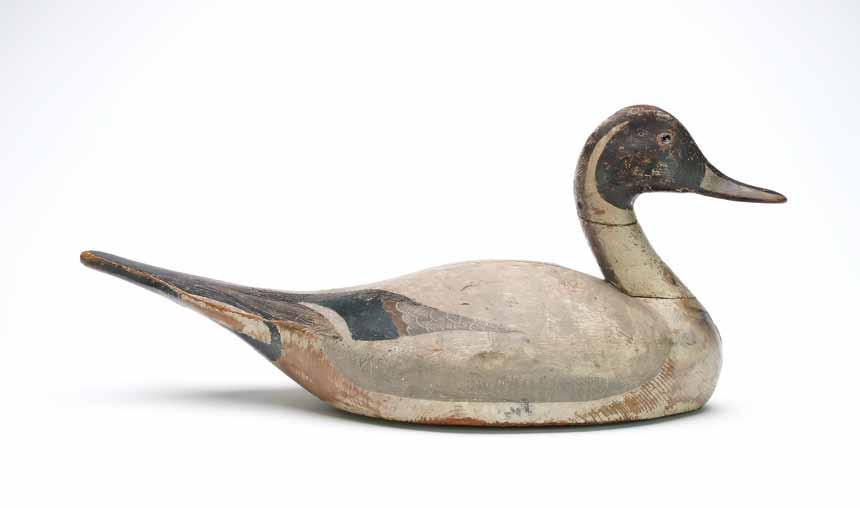
back head and wide extended tail. Scratch feather paint detail on wings. Mackey collection ink stamp on underside. Measures 19.5” long. Original paint with moderate wear; small dents and shot marks; tight drying crack in back; split along the underside runs up the breast and under tail area; old glue and touchup added to that split; repair to a chip in one side of bill tip; old crack through upper part of neck; thin wash of white to flaking on breast and front part of neck seat.
Provenance: Martin and Deborah Maloy collection.

15,000)
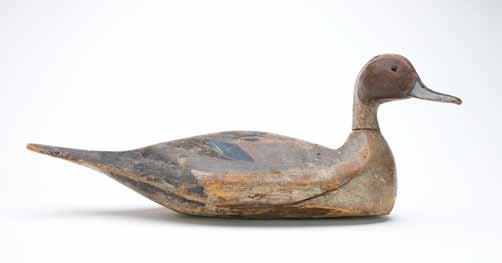
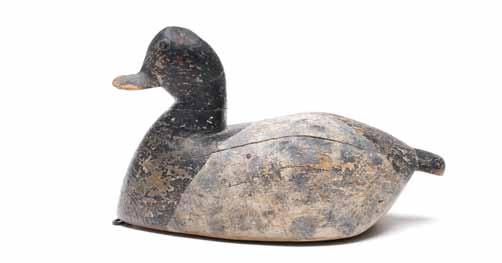
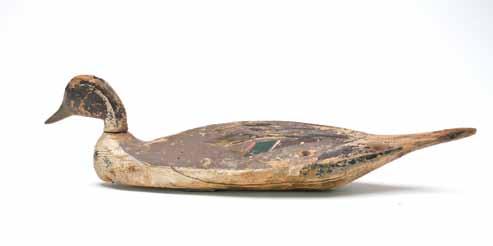
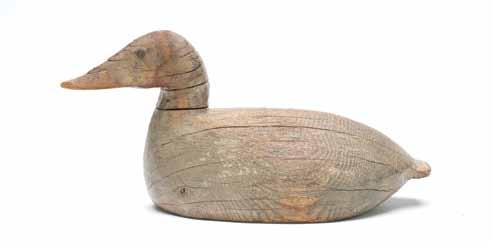
162 Lloyd Tyler (1898-1971), Crisfield, Maryland. Oversized pintail with slightly turned head. Measures 22” long. Original paint with significant flaking and wear; small dents and shot marks; drying cracks along underside and one lower side; small knot missing from edge of tail; old glue visible at neck seat with an old nail added at back of neck.
Provenance: Martin and Deborah Maloy collection. (2,000 - 3,000)
163 Noah Sterling (1884-1954), Crisfield, Maryland. Bluebill with wide body and paddle tail. “SGH” stamped in underside for the collection of Somers Headly. Measures 13.25” long. Mix of original and very early in use repaint; with significant flaking and wear; tight drying cracks in head and one side of body; the other side with a drying split; underside of bill was chipped down and reset long ago with a small nail from the underside.
Provenance: Bill and Alice Walsh Collection. Obtained from Somers Headley, Wilmington, DE in 1980, who obtained it from Ralph Nelson 2/54. (3,000 - 4,000)
164 Lloyd Tyler (1898-1971), Crisfield, Maryland. Early pintail with very long and narrow body. Measures 22” long. Original paint with significant wear; drying cracks and splits in wood with old nails to secure; areas of dry rot on underside; minor separation at neck seat; bill is a professional replacement.
Provenance: Bill and Alice Walsh Collection. Obtained from R.H. Richardson at 1977 Richmond Show. (800 - 1,200)
165 Ward Brothers, Crisfield, Maryland. Early canvasback with textured tack eyes. signed and dated 1930 at a later date on the underside. Measures 16.5” long. Most of the paint has flaked to bare wood; many tight drying cracks in body and head; many tiny nails added along center of head and bill to secure drying cracks.
Provenance: Bill and Alice Walsh Collection. Note on bottom by Bill Doeckel who owned the decoy prior to Larry Lambert. Obtained from Lambert May 1983. (800 - 1,200)

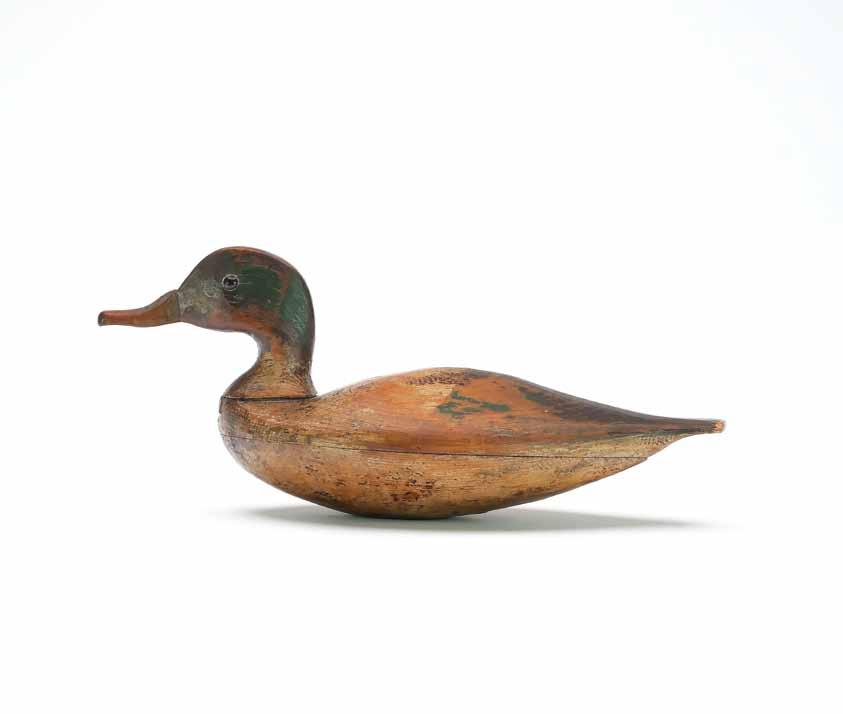
166 Attributed to Edward Cabot, Principio, Maryland.
Thinly hollowed greenwing teal with dovetailed removable head. Measures 10.5” long. Original paint with significant wear under a thin coat of varnish; tightly reglued crack through neck; bottom piece of dovetail is likely an early replacement by the maker, and is made as a separate piece with a small screw and nail attaching to neck seat.
Provenance: Bill and Alice Walsh Collection. Obtained at antique shop in Norfolk, VA, 1948.
Literature: “Decoys of the Mid-Atlantic Region,” Henry A. Fleckenstein, Jr., p. 119, exact decoy pictured.
(5,000 - 8,000)

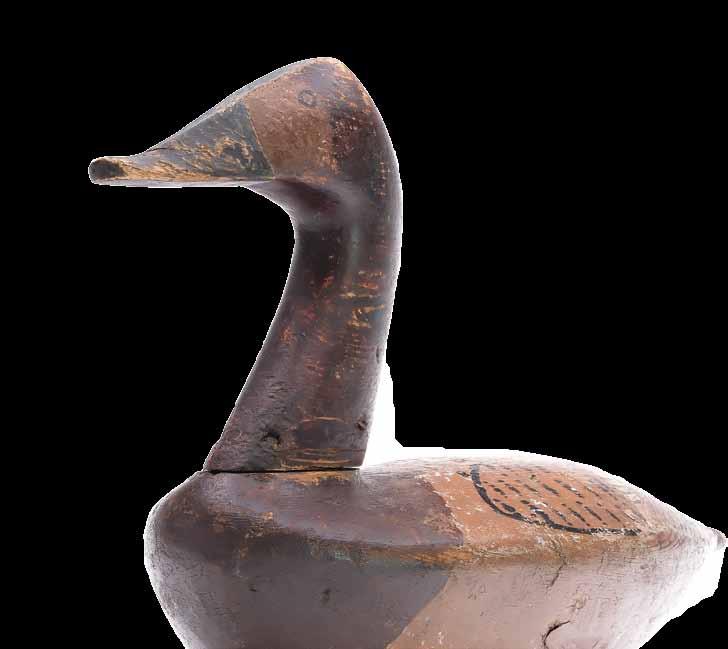
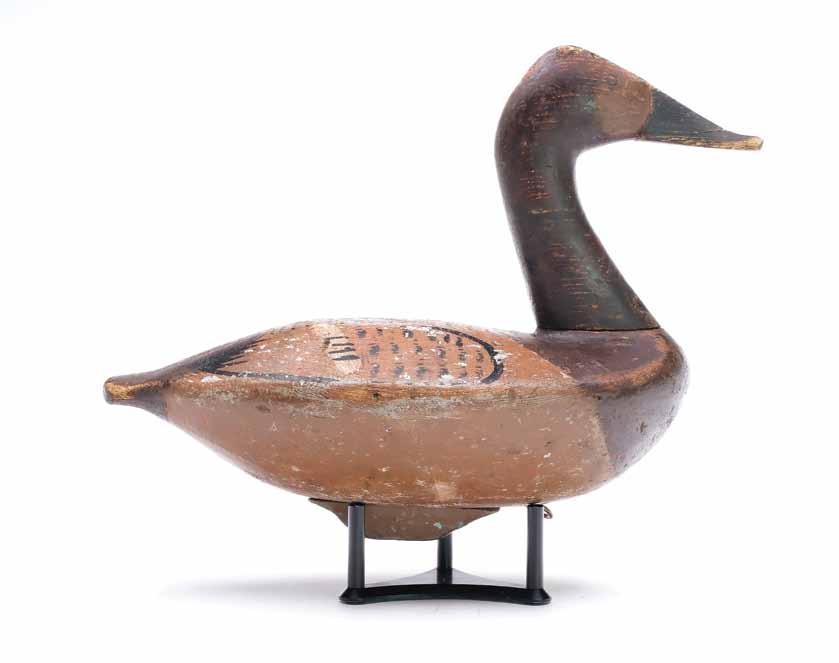
167 Charles Nelson Barnard (1876-1958), Havre de Grace, Maryland. High head canvasback hen. Branded “JP” on the underside for the rig of James Pusey. Measures 15.25” long. Original paint with moderate flaking and wear down to the primer coat; moderately hit by shot; professional neck crack repair; bill was cracked down and tightly reset; old nails added at neck seat with some touchup in that area.
(7,000 - 10,000)
168 Unknown maker, Maryland, early 20th century. So-called “Pancake” style canvasback. With wide body and very hard chine line on sides. Tiny paddle tail and slightly turned head. Measures 12.5” long. Original paint with moderate wear; some roughness on one side, top of head, and edge of bill; hairline crack through neck.
Provenance: Ex Henry Stansbury collection. (2,000 - 3,000)
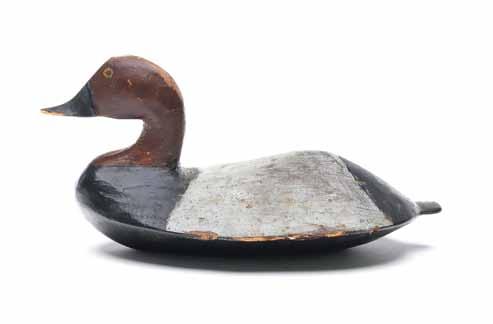
169 Ben Dye (1827-1896), Perryville, Maryland. Rare greenwing teal. Measures 11.75” long. Old bluebill over paint was cleaned down; lightly hit by shot; tight crack through neck. (1,500 - 2,500)

170 Unknown maker, Maryland, early 20th century. Goldeneye with raised neck seat and tack eyes. “JEB” branded three times in the underside. Iron keel weight on underside. Measures 13” long. Original paint with minor wear; an early coat of varnish has darkened with age; fine hairline crack in one side of neck.
Provenance: Bill and Alice Walsh Collection. (800 - 1,200)


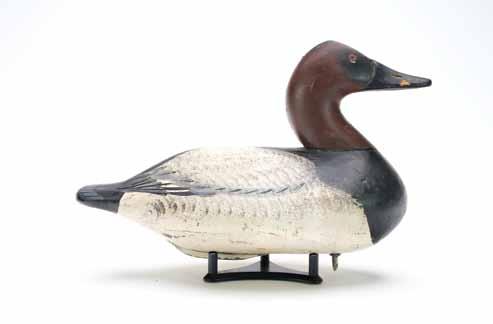
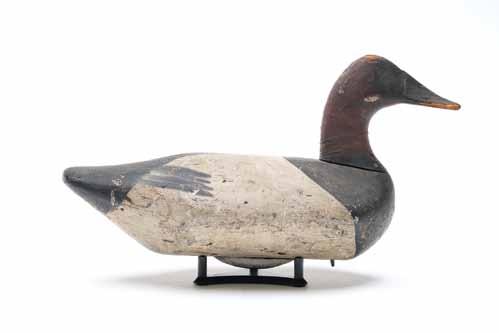
171 Charles Nelson Barnard (18761958), Havre de Grace, Maryland. Canvasback hen with raised neck seat and slightly raised head pose. Measures 15.25” long. Early in use repaint with moderate flaking and wear; minor roughness on edge of bill; slight separation at neck seat. (2,000 - 3,000)
172 Henry Lockard (1868 - 1944), Elk Neck, Maryland. Canvasback with reared back head. Measures 14.5” long. In use repaint by Severn Hall shows moderate wear; separation at wood grain on one side was tightened by old nails before the repaint; hairline cracks in breast and underside.
Provenance: Bill and Alice Walsh Collection. Obtained at Salisbury Show in October 1977 from Paul Shertz of Newark, DE. (600 - 900)
173 Sam Barnes (1851-1926), Havre de Grace, Maryland. Canvasback with slightly raised head pose. Illegible brand on underside. Measures 16.5” long. Early in use repaint with moderate flaking and wear; an appealing crazing on much of the decoy; two small chips in top of head; roughness on edge of bill; hairline crack in bill; crack in front of neck seat. (600 - 900)
174 John Glenn (1876-1954), Rock Hall, Maryland. Pair of pintails. Measure 16” long. Original paint with moderate gunning wear; filler above nail hole on top of hen’s head was replaced; filler on top of drake’s is missing; an old nail added to separation in wood grain on one side of hen; drake with a tight drying crack along one side and a split along the underside; small chip in tip of tail.
(800 - 1,200)
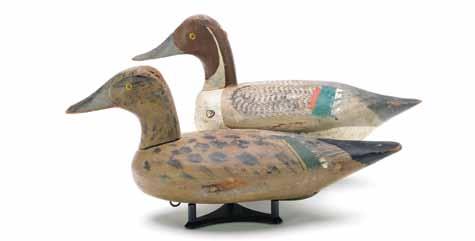
175 John Glenn (1876-1954), Rock Hall, Maryland. Rare widgeon. Measures 13” long. Original paint with minor gunning wear; shot strike has caused a small chip on top of head, otherwise very good structurally.
(600 - 900)
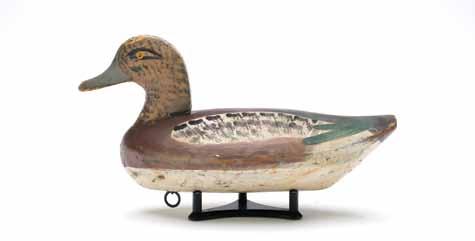
176 John Glenn (1876-1954), Rock Hall, Maryland. Gadwall hen from the Sweetwater rig. Measures 15.75” long. Original paint with minor wear; discoloration at a knot in one side of breast; hairline crack in one side of neck; otherwise excellent structurally.
(600 - 900)

177 John Glenn (1876-1954), Rock Hall, Maryland. Black duck from the Sweetwater rig with metal tack with number “22” in breast. Measures 15.25” long. Original paint with minor to moderate wear; crack through neck; some filler has flaked above nail hole on top of head and at neck seat.
(600 - 900)

One of the earliest documented carvers from the Delaware River region, John Blair and John English (1852 – 1915) are widely considered to be the originators of what was to become known as the “Delaware River style”. His birds are distinguished by their extremely fine, hollow carved, craftsmanship with heads mounted atop delicate neck seats. Many of his birds have a subtle, yet realistic, swimming posture. What clearly set them apart from any of the other decoys of the period (and many of those to follow), however, was their exquisite paint application.
As fine as his birds are, much of the life of John Blair remained an enigma for many years. He was first identified by pioneer collector and writer, Joel Barber (1876 – 1952). This early documentation was based largely on Barber’s acquaintance with Blair’s son, John Jr (1881 –1953). The original story was repeated and elaborated upon by subsequent early historians/collectors such as Bill Mackey and Hal Sorenson in the 1960s. Unfortunately, much of this information was based on vague memories or third-party recollections. Initially, Blair was referred to, variously, as a “wheelwright”, a “banker” and a “portrait painter”. Eventually (although much still needs to be done) continued research has led to a clearer picture of the man.
It is now known that Blair immigrated to the United States from Scotland in 1864. He married Susan A Cook in Red Bank Township, NJ in 1875 and the couple had three children, two sons and a daughter. In the 1900 federal census, he is listed as a “Master Mechanic”, living on Franklin St in Philadelphia. While in PA, he was a member of the exclusive Bridesburg and Frankford Hunting Clubs near Fishtown and Andalusia. By about 1905, he had retired and was living in Elkton, MD and, ultimately, was to own the large “Henderson Point Farm” on the shore of the Elk River where he lived out his life as a gentleman farmer and sportsman. The generally agreed upon
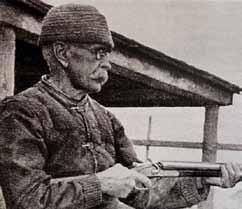

consensus today indicates that Blair was, most likely, involved in the lucrative carriage and sleigh business in Philadelphia, but in a much higher (yet unknown) capacity than merely a maker or repairer of wooden wheels. In some form of a managerial or ownership position, he would have had the funds necessary to belong to the two expensive hunt clubs and he would have been in contact with other successful businessmen who could afford to purchase his decoys. The artistic ability needed to produce the fine paint applications on the decoys would have been readily available to Blair in the talents of those associated with him that were involved in the elaborate painting of the expensive horse drawn vehicles.
The quality of the many decoys produced by Blair speaks for itself. His decoys have surfaced in the rigs of prominent sportsmen throughout the Northeast and Canada. That his work was emulated by others is, again, a tribute to his outstanding craftsmanship.
178 John Blair, Sr. (1843-1929), Philadelphia, Pennsylvania. Outstanding and very rare greenwing teal. Hollow carved with painted tack eyes. Head in slightly forward swimming pose. Measures 13.25” long. Near mint original paint with a few spots of flaking on head and back of neck seat; an early coat of varnish has darkened with age; tiny spot of filler at body seam nail near tail has flaked; weight was removed at some point; the original bill was cracked down and professionally reset with a thin coat of touchup to much of the bill.
Literature: “Floating Sculpture” by H. Harrison Huster and Doug Knight, page 33, rigmate pictured. “Decoys: North America’s One Hundred Greatest” by Loy S. Harrell Jr., page 28-29, rigmate pictured. “The Great Book of Waterfowl Decoys”, Joe Engers, editor, page 125, rigmate pictured. (60,000 - 90,000)
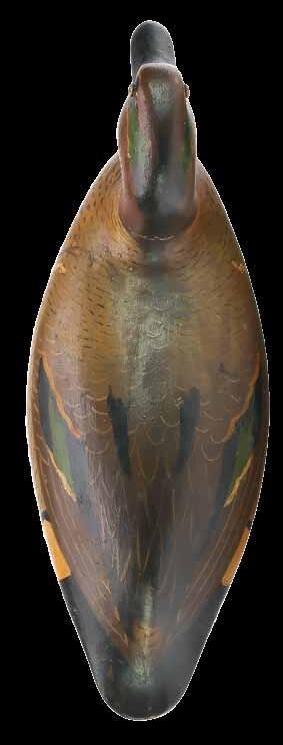
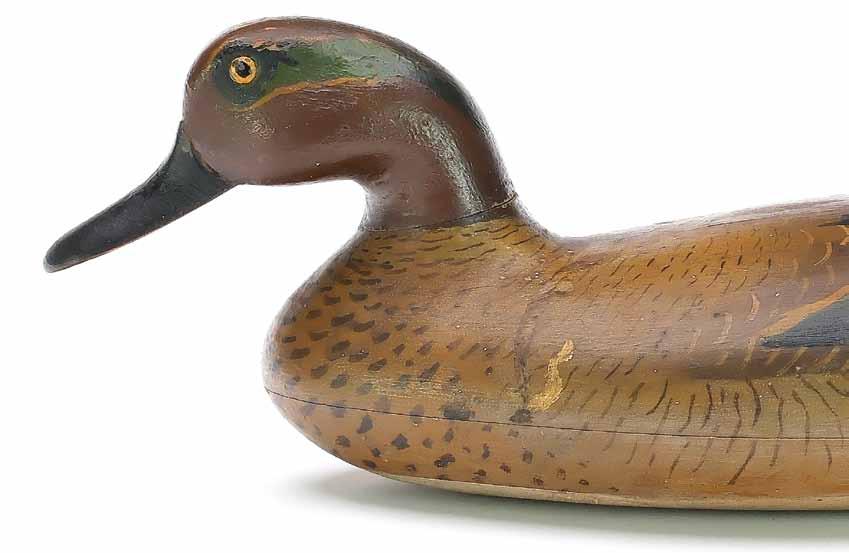
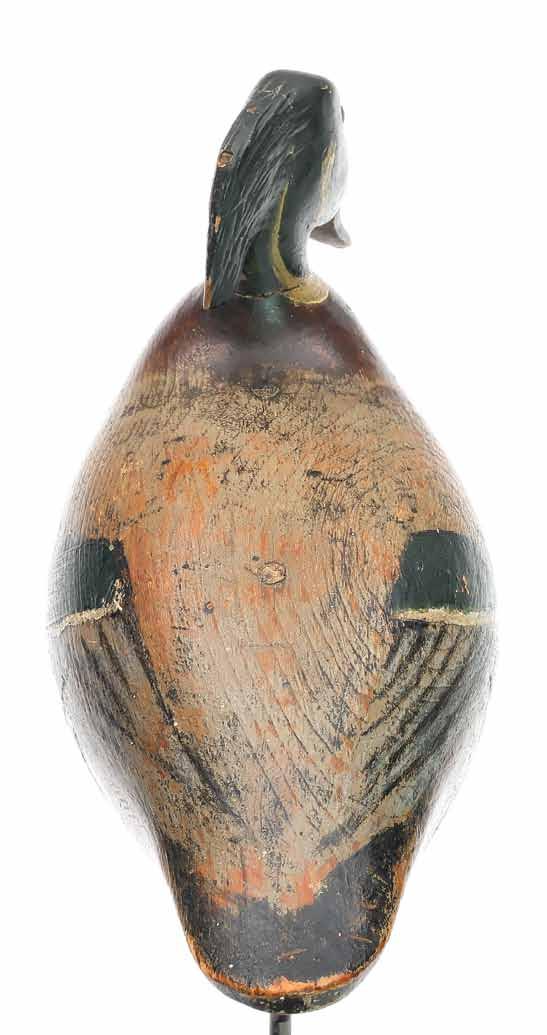
In the early 1800s, Philadelphia was home to a variety of accomplished pattern makers, ships carvers and painters. It was also home to some of the earliest documented decoy carvers. John Blair (1843 – 1929) is a name commonly associated with the area but there were men still earlier. Arthur Bartholomew Vance (1818 – 1889) is now established as carving some extremely fine decoys and Andrew John Tull (c1841-1915), a pattern maker by age 19, has birds attributed to him bearing an early date of 1856. While not specifically assigned to any single maker, regional authorities acknowledge that the wood duck offered here is definitely from this Philadelphia lineage and a very fine, early example. Not only is the wood duck a rare species to be depicted in a working decoy, but carvings specifically made as stickups are practically unheard of.
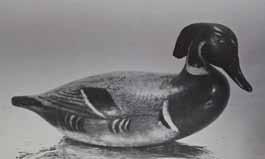

179 Rare and important working wood duck from the Philadelphia School. Made as a stickup decoy, not a floater. Three piece body construction with applied carved crest held with square cut nails. Tack eyes. Early peg construction. This in all likelyhood the oldest or one of the oldest working wood ducks we have ever offered. A black wash has been removed to expose original paint; Ken Delong repaired a deteriorated spot on the underside and added paint in that area.
Provenance: William J. Mackey collection. Quintina Colio collection. Ted and Judy Harmon collection Harmon.
Literature: “American Bird Decoys,” Wlliam J Mackey, p. 138, exact decoy. “American Decoys,” Quintina Colio, p.6 exact decoy.
(25,000 - 35,000)

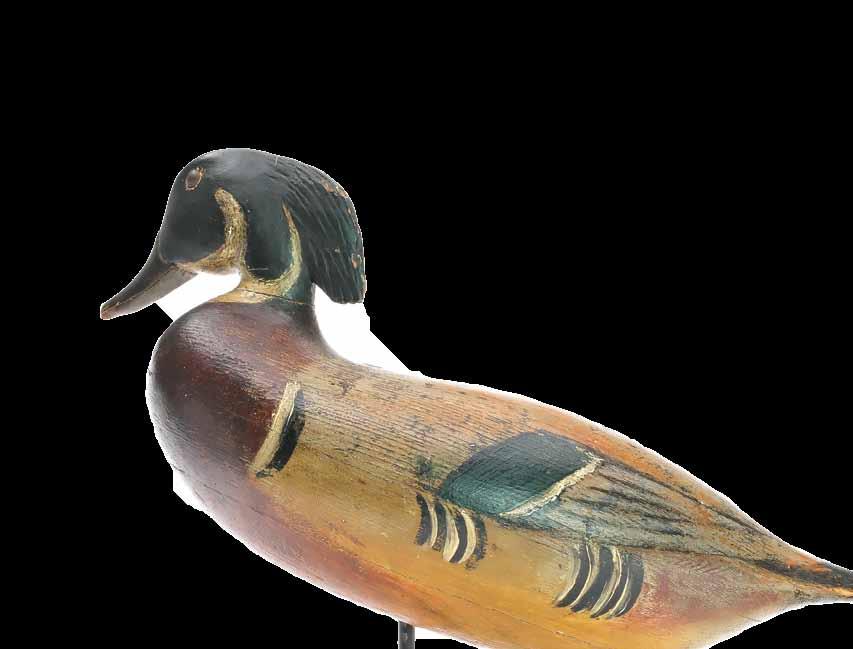
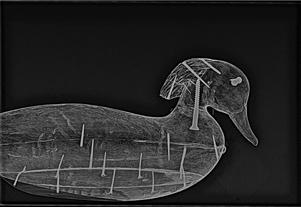
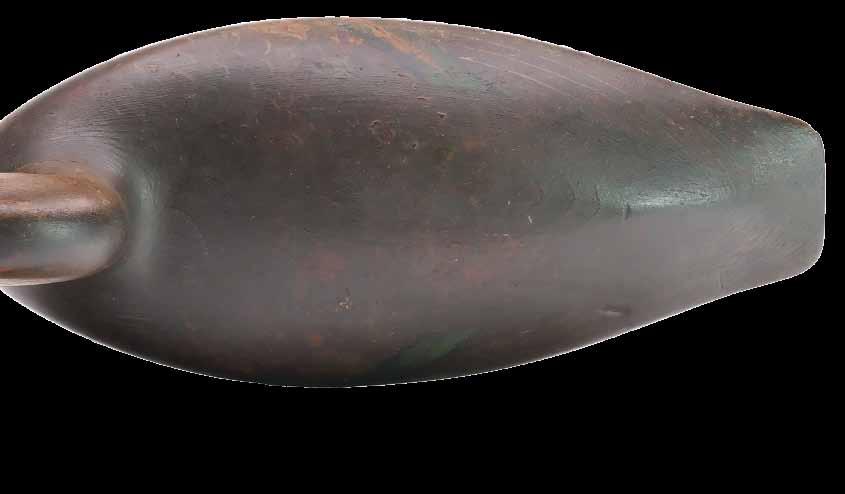
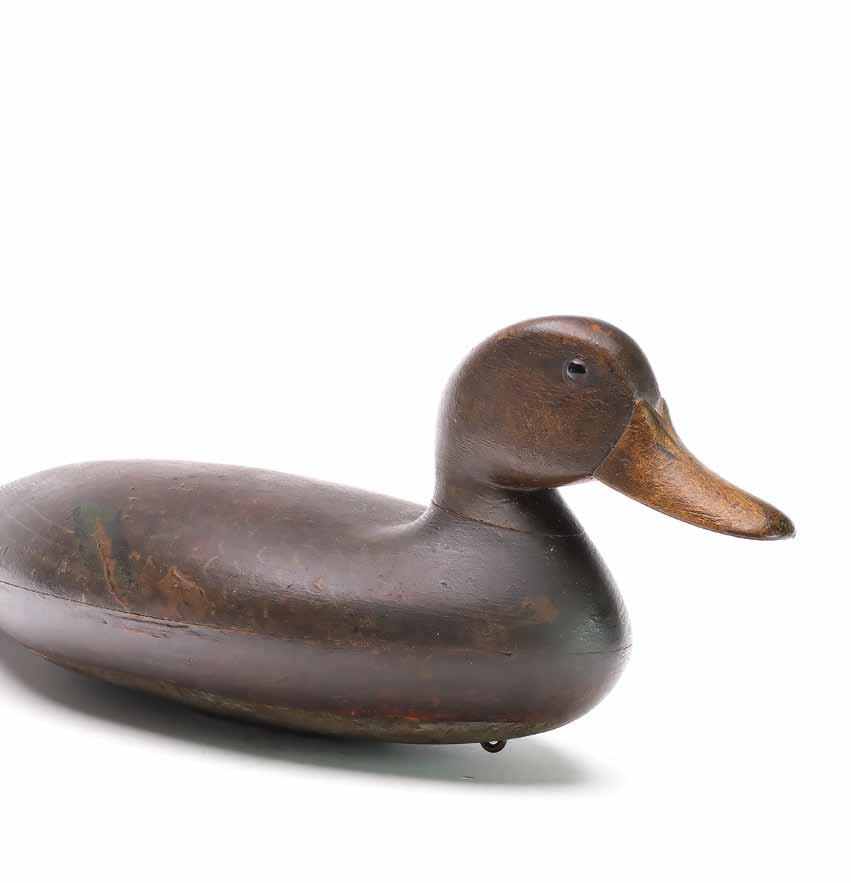

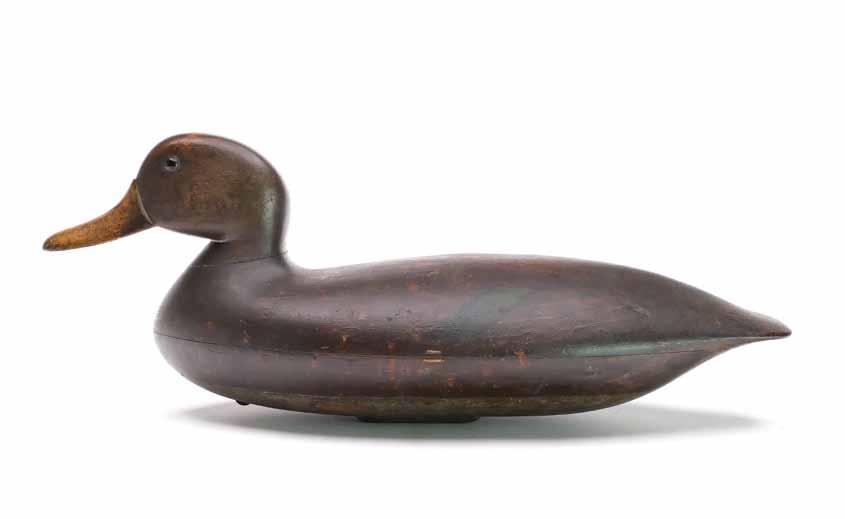
180 John Blair, Sr. (1843-1929), Philadelphia, Pennsylvania. Classic black duck, 2nd half 19th century. With collectors “DSC” stamped in underside. Gray oval painted on underside which is typical of Blair’s classic decoys. Slightly raised neck seat with two piece body. Measures 17” long. Fine delicate original paint; covered by an early coat of lacquer, the lacquer has separate slightly and partially flaked away, and really only visible under UV light; two very small spots of darkening to flaked area immediately behind neck seat; otherwise very good and original with a few light rubs.
(30,000 - 40,000)
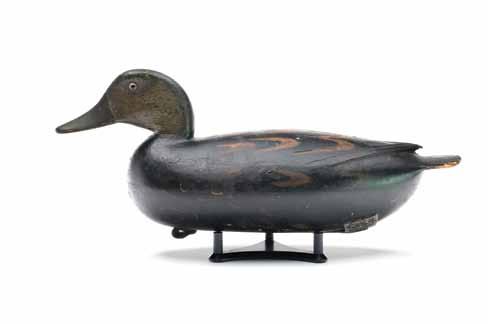
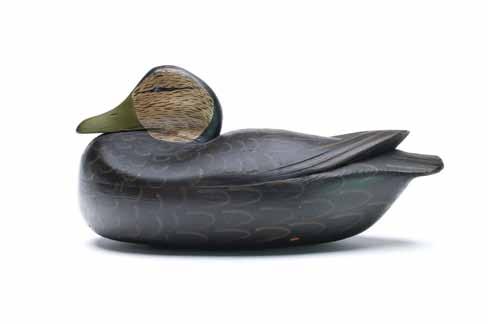

180A Dan English (1883-1962), Florence, New Jersey. Black duck, circa 1900. Raised, carved wings with carved tail. Two piece hollow body. “D English New Jersey, circa 1888” carved in underside. Measures 16” long. Head appears to be original paint; body is in old working repaint; rough area at one side of tail; a few small nicks and scratches from in use wear.
(1,500 - 2,000)
180B Jess Heisler (1891-1943), Burlington, New Jersey. Black duck, 1st half 20th century. Three piece hollow body with raised wingtips and carved tail. Tack eyes. Measures 14” long. Very good and original; only a few small rubs at edges.
(800 - 1,200)
180C Lawrence McLoughlin (1911-1984), Edgely, Pennsylvania. Black duck, 2nd half 20th century. Owned by both Johnny Hillman and Somers Headly and so stamped. Measures 16” long. Strong original paint with only very light wear; protected by a light coat of varnish; some paint crazing mostly on the breast and tail areas.
Provenance: Somers Headley collection. John and Isabelle Hillman collection. (800 - 1,200)
180D Caleb Ridgway “Ridge” Marter (18931977), Burlington, New Jersey. Bluewing teal drake. Retains Marter’s personal gunning rig tag on underside. Measures 12” long. Bill may have been rest with touchup to white area on face around bill, possibly done by Marter himself. (800 - 1,200)

180E Caleb Ridgway “Ridge” Marter (18931977), Burlington, New Jersey. Black duck with raised, carved wingtips and tail. Two piece hollow body. Marter’s ownership tag on underside. Thin original paint protected by a coat of varnish; professional neck crack repair visible under uv light. (800 - 1,200)
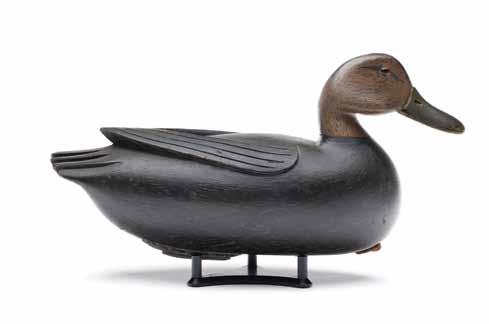
180F John McLoughlin (1911-1985), Bordentown, New Jersey. Rigmate pair of high head canvasbacks, 1st quarter 20th century. Two piece hollow body. Considered to be some of McLoughlin’s earliest work. Measures 16” long. Old working over paint on both birds; hen has neck crack.
Provenance: Bill and Alice Walsh Collection. Obtained at Bourne Auction 1981. (2,000 - 3,000)
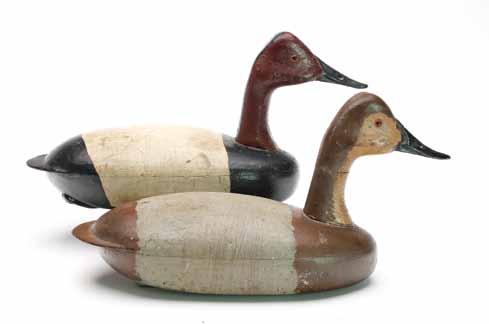
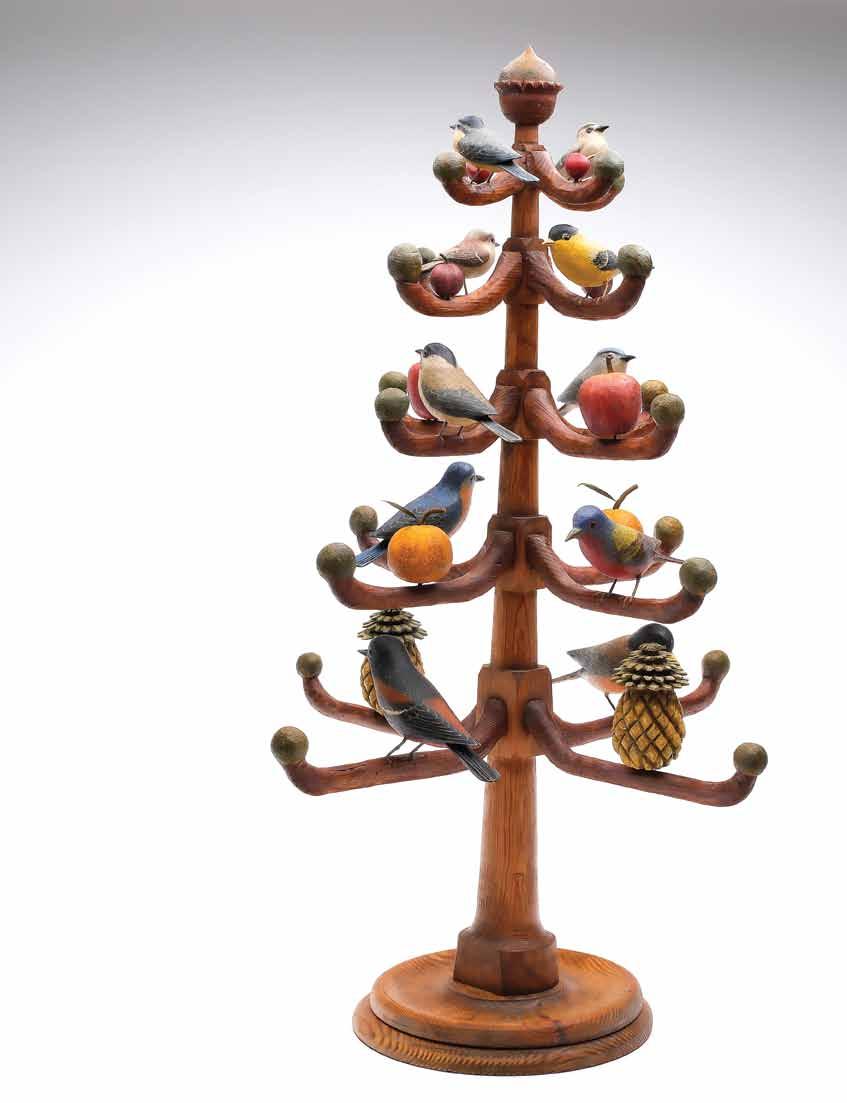
181 Frank Finney (b.1947), Cape Charles, Virginia. A magnificent holiday tree.
Constructed on an early piece of pine with strong grain pattern. With five tiered layers of branches with alternating fruit and full size birds. Fruit includes, Pineapples, oranges, apples, cranberries and cherries. All birds are North American species. Serifed “F” carved in underside of base. Measures 30” tall. Excellent and original. (15,000 - 25,000)
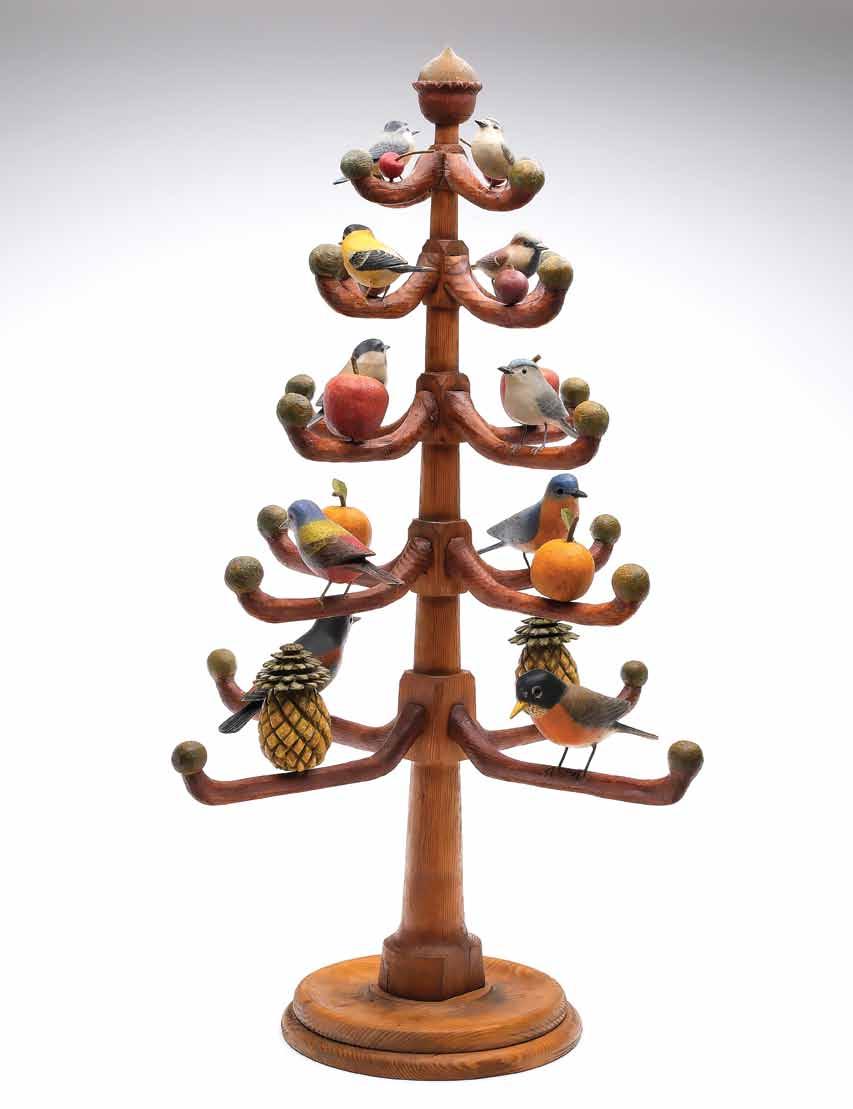
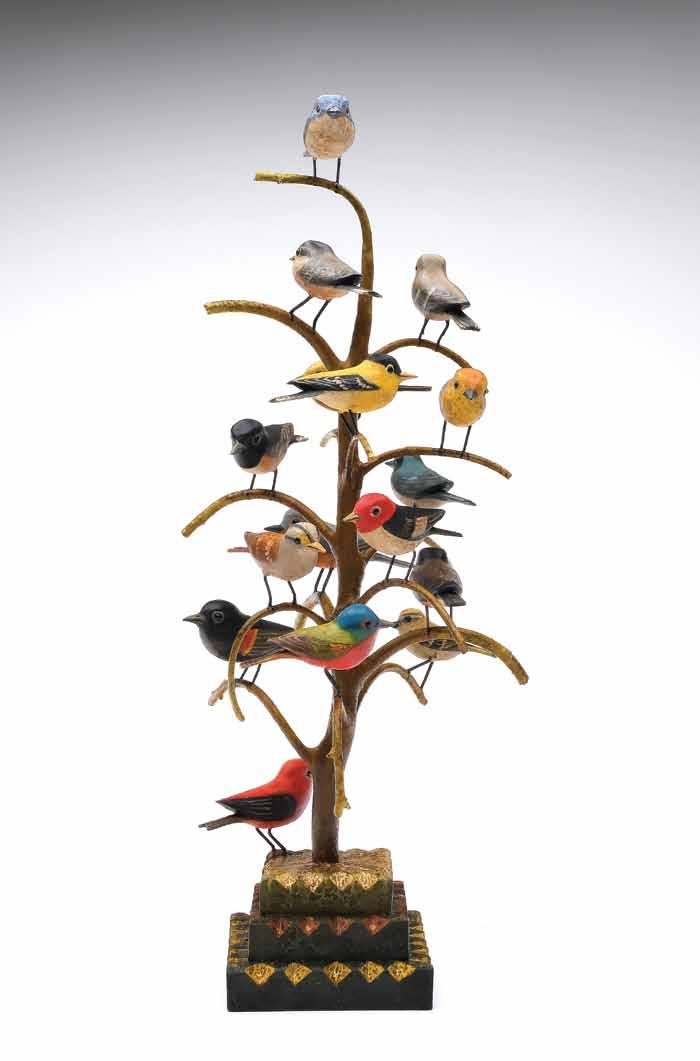
182 Frank Finney (b.1947), Cape Charles, Virginia. Bird tree with 15 North American bird species. Mounted to a chip carved, painted base. Stands 19” tall. Remains excellent and original. (10,000 - 15,000)


185 Frank Finney (b.1947), Cape Charles, Virginia. Large mechanical whirligig of an English wing shooter. When arms turn the hunter’s head turns and his eyes move up and down. Hunter sports a carved game pouch and shotgun. Holds his downed red grouse in each hand. Maker’s serifed “F” in underside. Measures 43” tall with arm raised. Tightly reglued seem on one hand; otherwise excellent and original. (10,000 - 15,000)


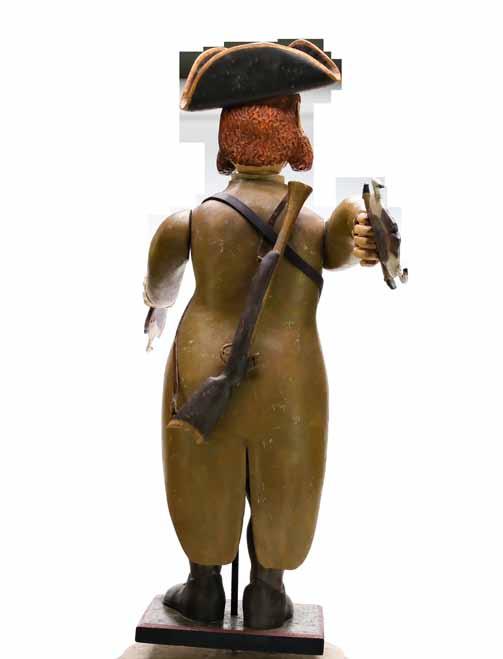
186 Frank Finney (b.1947), Cape Charles, Virginia. Outstanding pair of hummingbirds. One is perched on branch with slightly turned head. The other is flying and feeding from open flower with the rest of its body suspended in air. Both with relief feather carving. Feeding hummingbird’s bill is mounted to flower. Maker’s initials carved in underside. Stands 12.5” tall. Excellent and original.
(12,000 - 18,000)
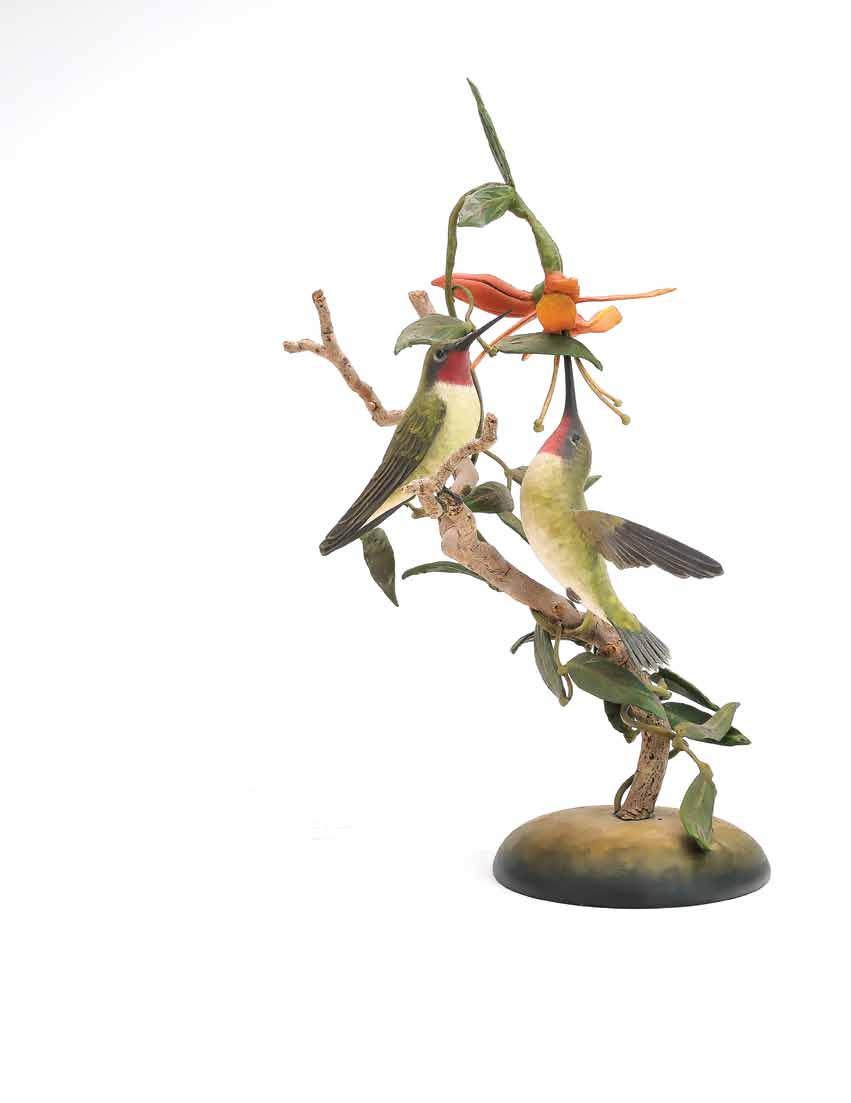
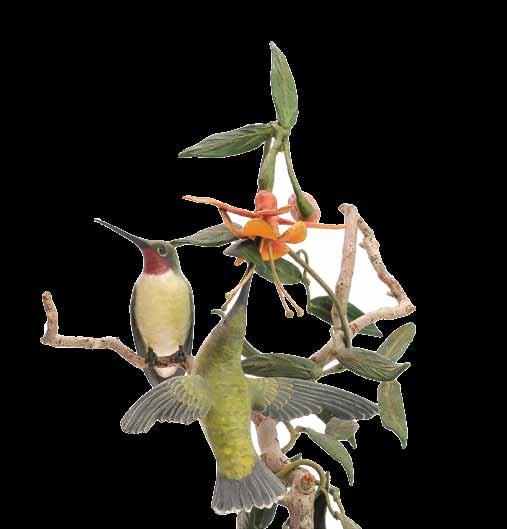
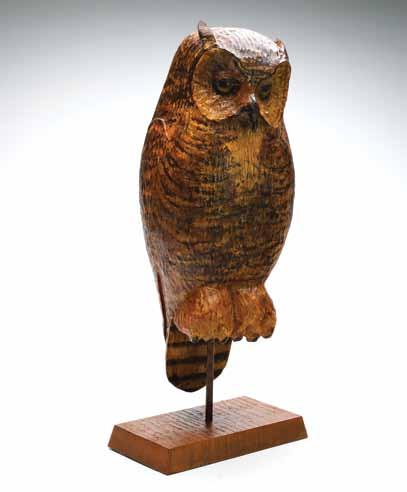
187 Frank Finney (b.1947), Cape Charles, Virginia. Large hollow carved owl. Relief wing carving and feather gouging throughout. Comb feather paint detail on base. Stands 25” tall including base. Excellent and original. (3,000 - 5,000)
188 Frank Finney (b.1947), Cape Charles, Virginia. Full size grouse with dropped wing carving. Relief wing and tail feather carving. Maker’s initials carved in base. Measures 15” long, stands 14.75” tall. Body seam has opened very slightly under tail; some restoration where legs meet base.
Provenance: Dean Hyde collection. (3,000 - 4,000)
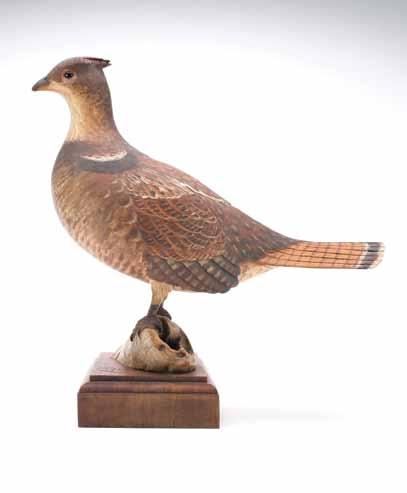
189 Frank Finney (b.1947), Cape Charles, Virginia. Pair of standing wood ducks. Drake with slightly turned head and extended crest. Hen with head turned over back. Both with raised, crossed wingtips and relief tail feather carving. Measures 13.75” and 16.75” long. Very good and original. (5,000 - 7,000)
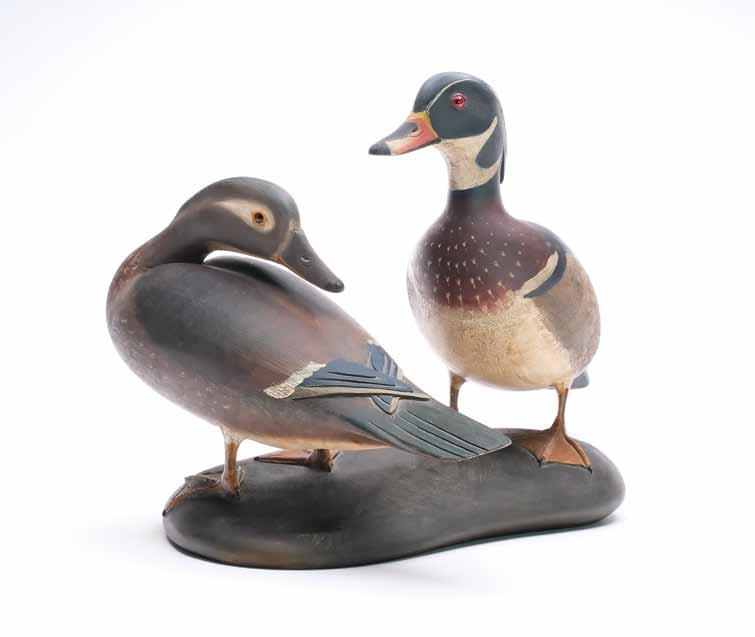


190 Frank Finney (b.1947), Cape Charles, Virginia. Pair of flying orioles on painted back board. Outstretched wings with deep relief feather carving. Slightly turned heads with open beaks. “Finney” signed lower right and with the maker’s initials carved on backboard. Backboard measures 21” x 13”. Excellent and original. (3,000 - 5,000)

191 Frank Finney (b.1947), Cape Charles, Virginia. Standing kingfisher. Deep relief wing carving and extended crest feathers. “F” carved in the underside. Measures 13.5” long. Excellent and original. (2,000 - 3,000)
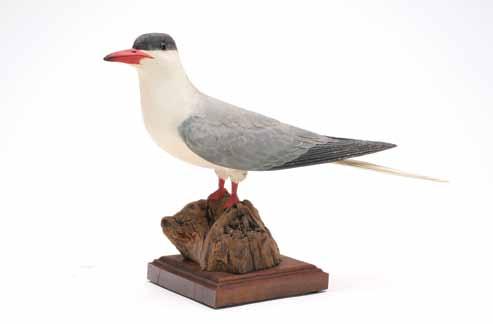
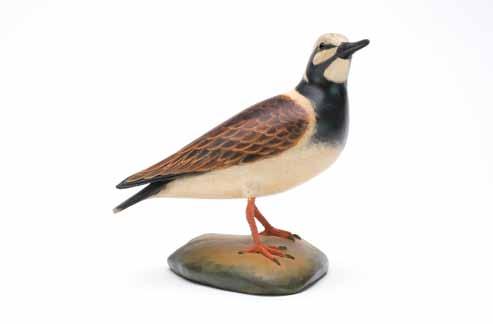

192 Frank Finney (b.1947), Cape Charles, Virginia. Standing tern with raised wingtips and extended split tail. “F” carved in driftwood part of base. Measures 14.5” long. Very good and original.
Provenance: Dean Hyde collection (1,500 - 2,500)
193 Frank Finney (b.1947), Cape Charles, Virginia. Ruddy turnstone with head turned almost 90 degrees. Raised wingtips and relief carved wing feathers. Signed on underside. Measures 9.25” long. Excellent and original.
Provenance: Martin and Deborah Maloy collection. (1,000 - 1,400)
194 Frank Finney (b.1947), Cape Charles, Virginia. Ruddy turnstone with slightly turned head and relief wingtip feather carving. “FRS Finney” carved in underside. Measures 9.5” long. Excellent and original.
Provenance: Martin and Deborah Maloy collection. (1,000 - 1,400)

195 Frank Finney (b.1947), Cape Charles, Virginia.
An early and rare bird tree, but with birds that are nearly full size. Seven colorful birds with carved eyes, perched on decorative base. Each bird is mounted with wire legs. Measures 15” tall. Excellent original paint; the green bird has a break near the thigh on one leg. (6,500 - 7,500)
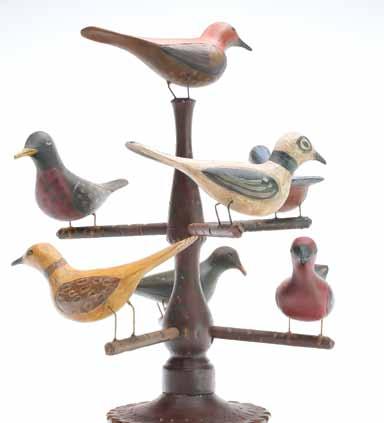
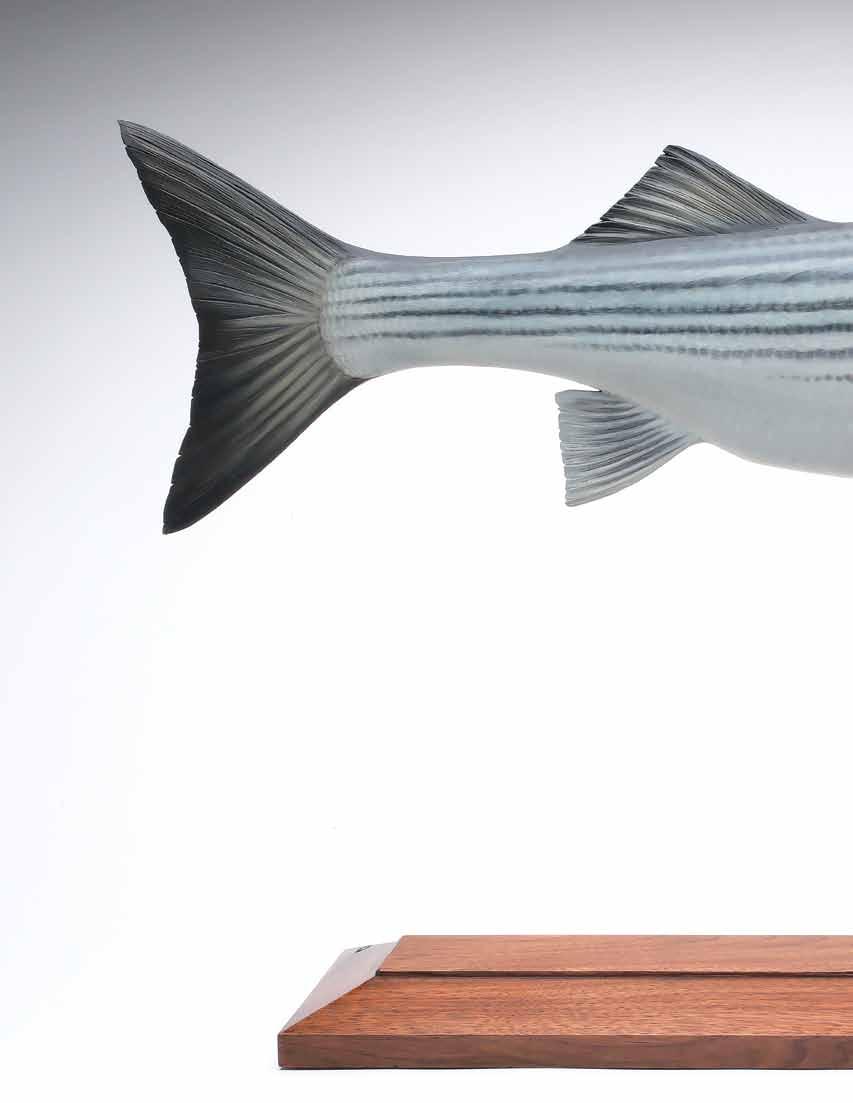
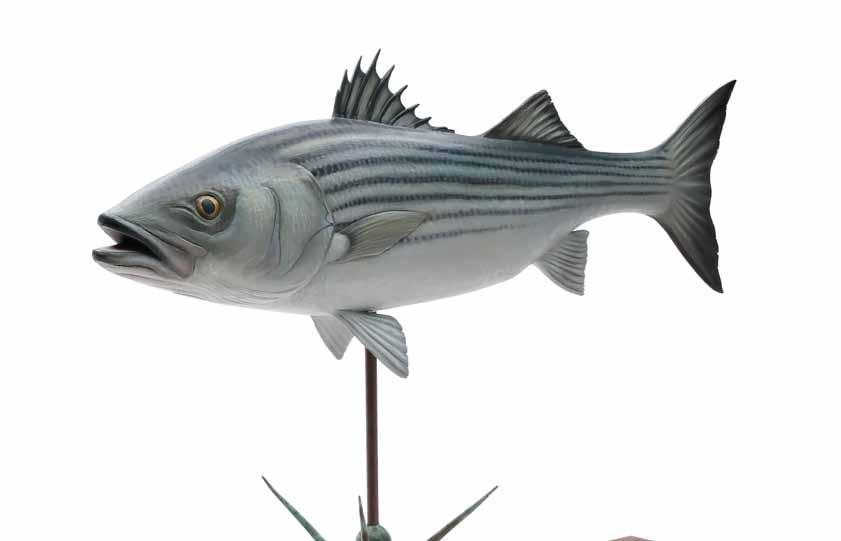
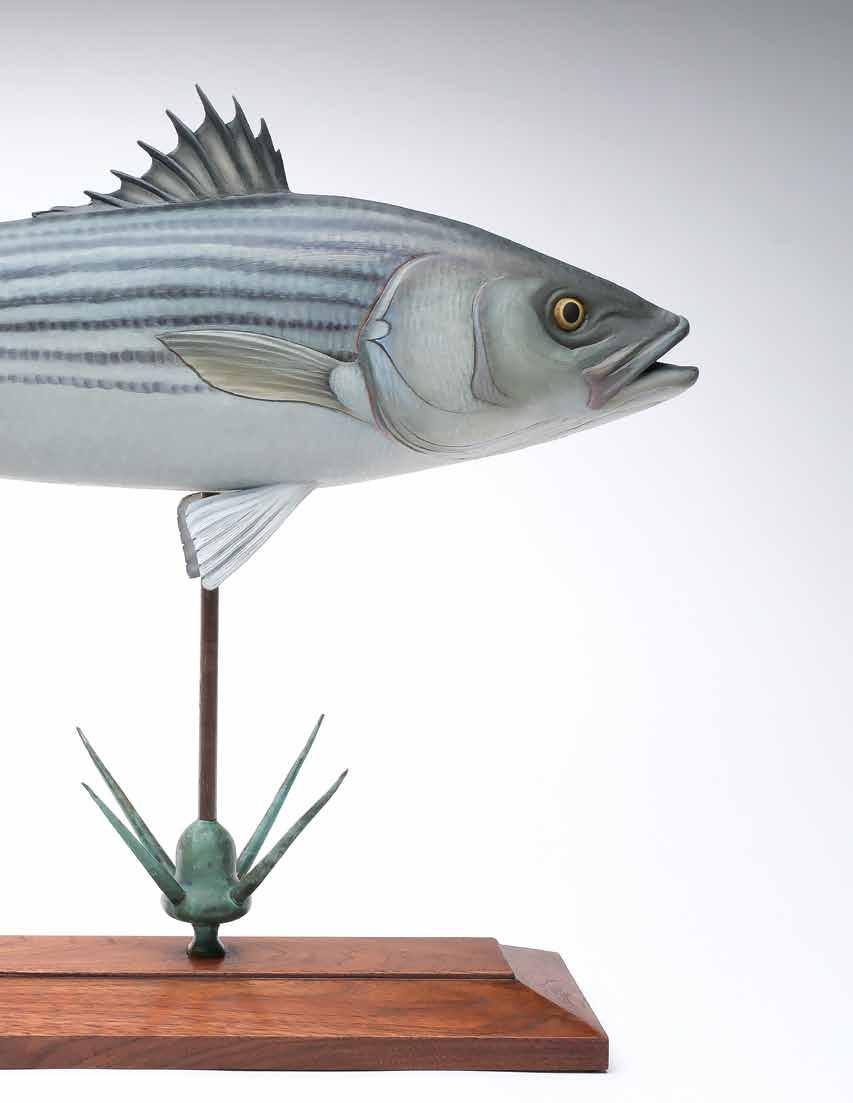
196 Josh Brewer, Little Deer Isle, Maine. Impressive 32” striped bass. Finely detailed carving on gills, open mouth, eyes, and inset hardwood mahogany fins. Mounted atop a 1920s vintage lightning rod that is secured to a beveled finished walnut base.. Fish measure 22” tall from bottom of base. Excellent and original. (5,000 - 8,000)
For decoy carvers, inside every block of wood there is a bird. What kind of bird, its attitude and plumage, a diver or a shorebird, can all be known as the wood is carved away. On the Chesapeake, this act of discovery is an old and traditional one. For over 300 years, sturdy canvasbacks and redheads, mallards and mergansers have revealed themselves to the drawknife as decoy artisans shaped the wood into tools designed to lure waterfowl from the sky to shotgun range. Historically, these are roughand-ready working decoys, V-bottomed to ride the waves and just lifelike enough to suggest the birds they represent. Arranged by the dozens on the water or in a field and accompanied by a corresponding call, decoys were an essential part of any waterfowler’s rig. Art is not the purpose of a good decoy—though it is sometimes a happy byproduct.
By Kate Livie, Chesapeake Bay Magazine
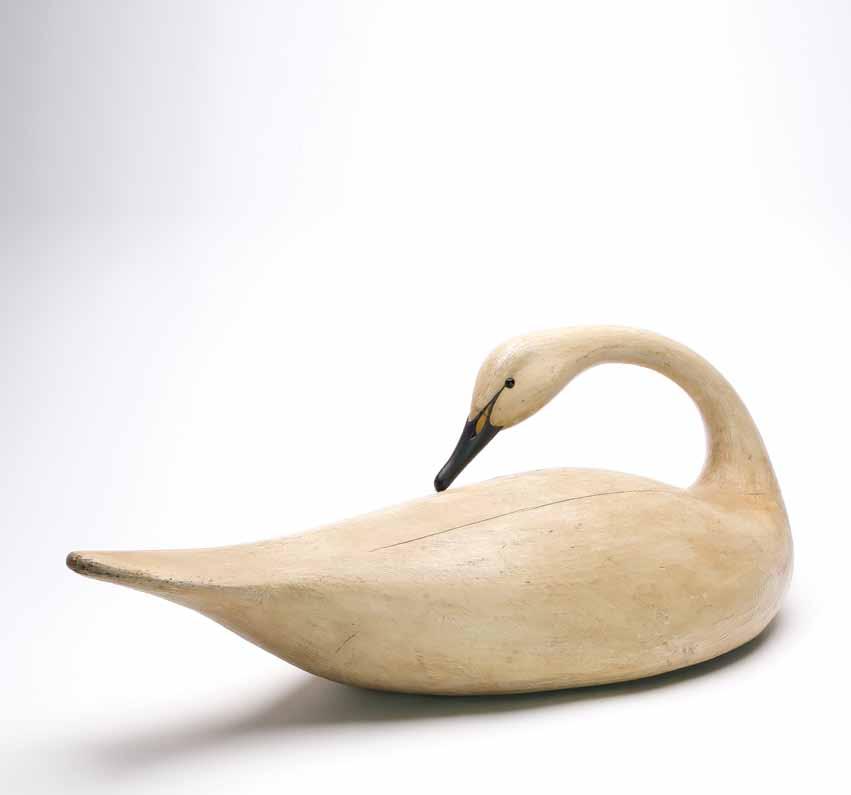

197 Mark McNair (b.1950), Craddockville, Virginia. Very rare preening swan. “MS McNair” carved in underside. Measures 31” long. A few hairline drying cracks along back, otherwise excellent and original.
(30,000 - 50,000)
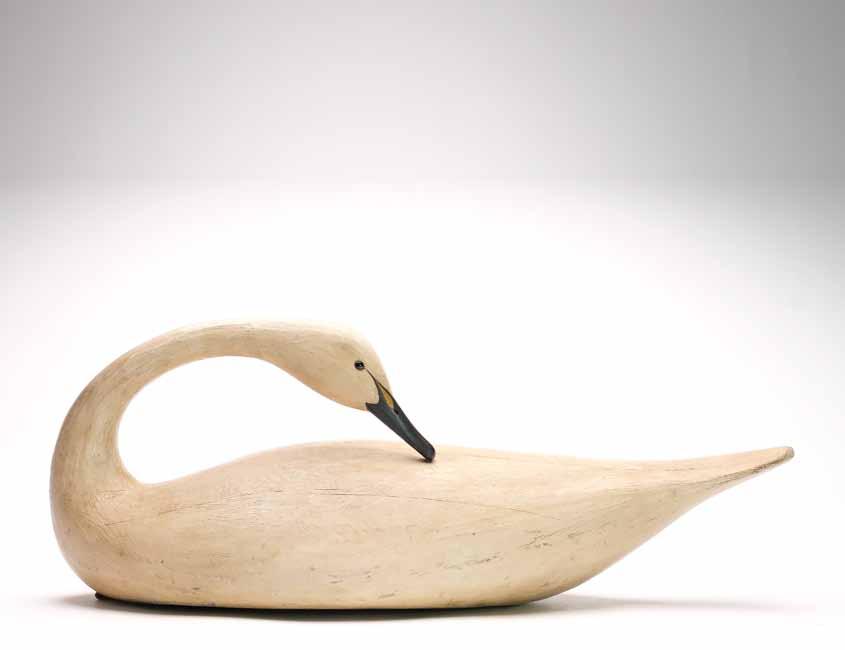
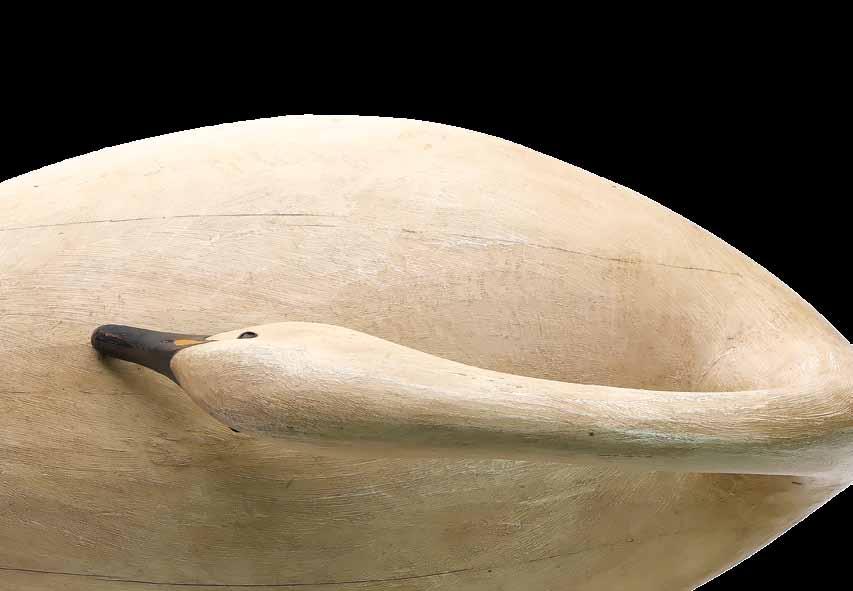
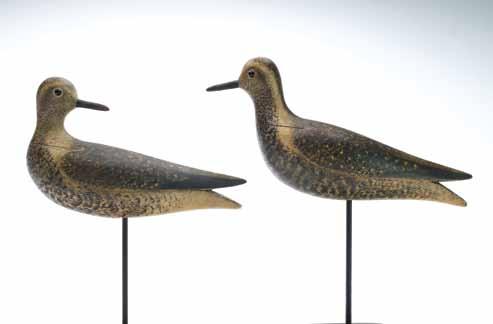
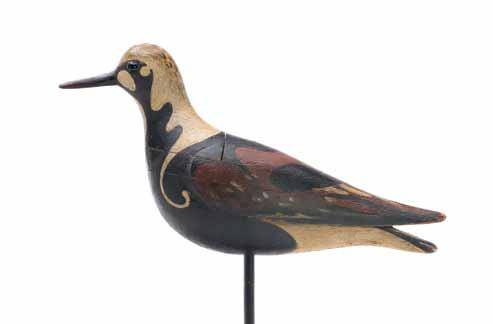
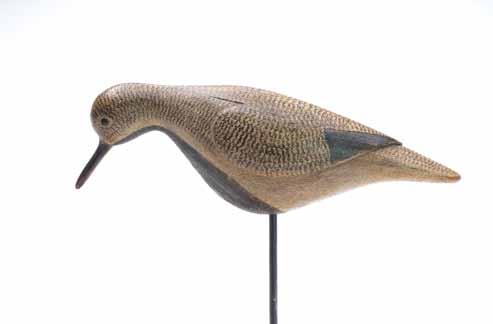
198 Mark McNair (b.1950), Craddockville, Virginia. Pair of hollow carved plover with dovetailed removable heads and relief wing carving. Both with inlayed bone escuthen at stick hole. Both with “McNair” carved in underside. Measure 9.5” and 12.25” long. Both excellent and original.
Provenance: Martin and Deborah Maloy collection. (2,500 - 3,500)
199 Mark McNair (b.1950), Craddockville, Virginia. Hollow carved ruddy turnstone with removable dovetail neck seat and relief wing carving. “McNair” carved in underside. Also with the Joe French collection ink stamp. Measures 8.5” long. Excellent and original.
Provenance: Joe French collection. Martin and Deborah Maloy collection. (1,000 - 1,400)
200 Mark McNair (b.1950), Craddockville, Virginia. Feeding black bellied plover in the style of Obediah Verity. With carved eyes and relief wing carving. “McNair” carved in underside. Measures 10.75” long. Excellent and original.
Provenance: Martin and Deborah Maloy collection. (600 - 900)
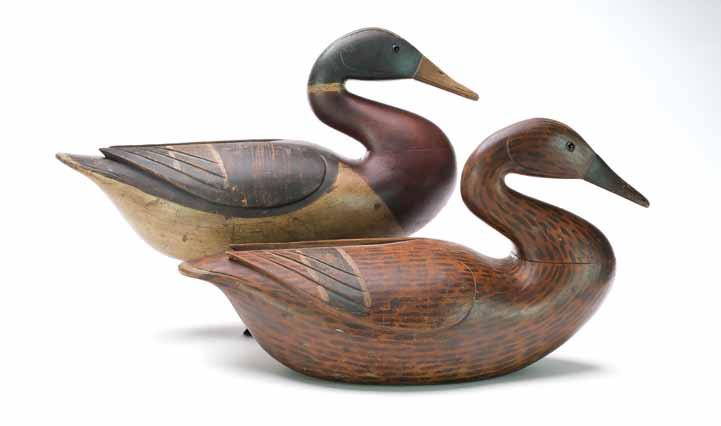
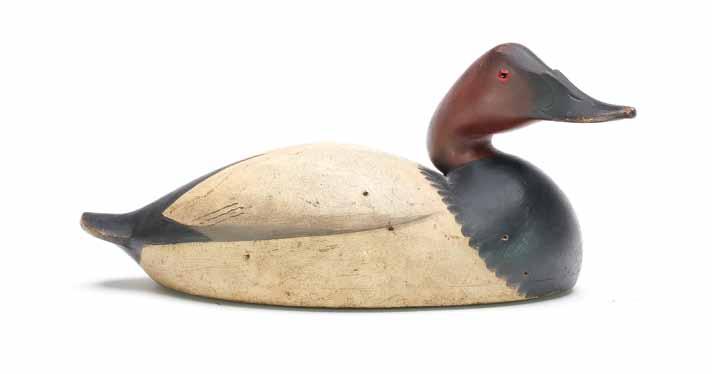
201 Cameron McIntyre (b.1968), New Church, Virginia. Excellent pair of mallards carved in the style of the Caines Brothers, with reared back heads and deep relief wing carving. Identified, signed, and dated 2001 on undersides. Also with “CTM” carved in underside. Measure 17.75” long. Made to look older like only Cameron can; excellent and original. (4,000 - 6,000)
202 Cameron McIntyre (b.1968), New Church, Virginia. Hollow carved canvasback with heavy influence from the Mason Decoy Factory. Slightly turned and reared back head. Premier ink stamp on underside. Also with the maker’s initials carved in underside. “DSC” stamped on underside for collection of David Campbell. Measures 14.5” long. Made to look older with shot strikes in one side; excellent and original.
Provenance: Dave Campbell collection. Martin and Deborah Maloy collection. (2,500 - 3,500)
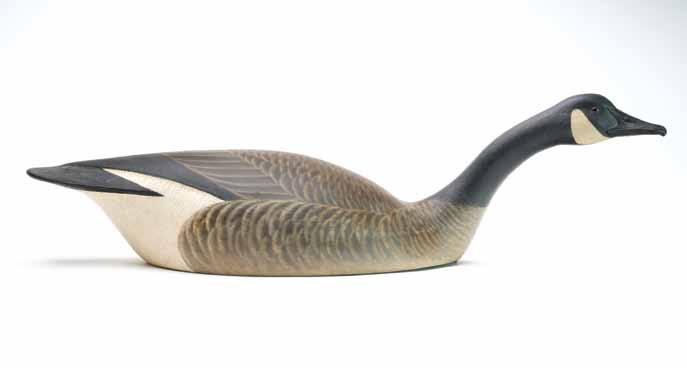
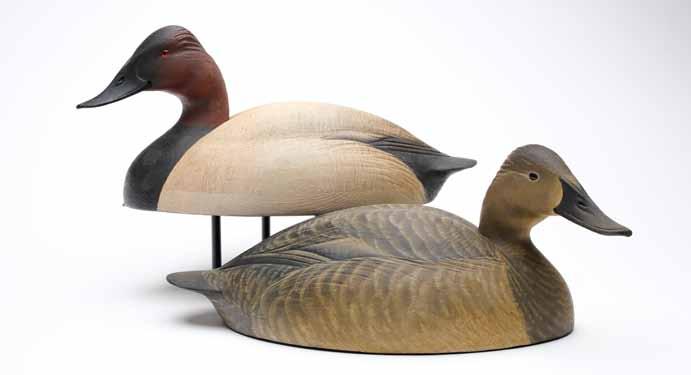
203 Marty Hanson (b. 1965), Hayward, Wisconsin. Swimming Canada goose. Hollow carved with slightly turned and elevated head. “MH” carved in underside, as well as “H” carved under bill. Maker’s ink stamp on bottom board. Measures 30.75” long. Excellent and original.
Provenance: Dean Hyde collection. (2,000 - 3,000)
204 Marty Hanson (b. 1965), Hayward, Wisconsin. Excellent pair of canvasbacks with slightly turned heads and relief wingtip carving. Hollow carved with makers intitial’s carved in underside. Maker’s name signed in wet paint under tails. Measure 15.5” long. Very minor discoloration, otherwise excellent and original.
Provenance: Dean Hyde collection. (2,000 - 3,000)
205 Marty Hanson (b. 1965), Hayward, Wisconsin. Excellent hollow carved black duck. Tucked head and relief wingtip carving. Scratch feather paint detail on head. “MH” carved on rounded underside. Measures 17” long. Tiny paint rub on tip of wingtips, otherwise mint.
Provenance: Dean Hyde collection. (1,200 - 1,800)
206 Marty Hanson (b. 1965), Hayward, Wisconsin. Large hollow carved curlew with relief wing carving, splined hardwood bill, and scratch feather paint detail. Maker’s initials carved in underside.
Measures 19.5” long. Excellent and original.
Provenance: Martin and Deborah Maloy collection. (800 - 1,200)
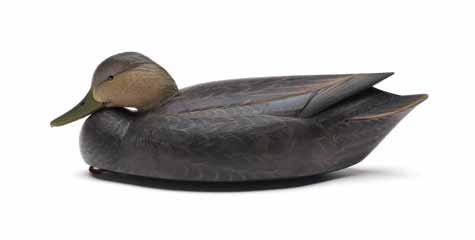

207 Grayson Chesser (b. 1947), Sanford, Virginia. Tucked head white heron with relief wing carving. “C” carved in underside. Measures 30.5” long. Very good and original.
Provenance: Bill and Alice Walsh Collection. (800 - 1,200)

208 Grayson Chesser (b. 1947), Sanford, Virginia. Pair of greenwing teal. Hen in sleeping pose, drake with tucked head and comb feather paint detail. Both signed and with “C” carved on the underside. Measure 10.25” and 11.5” long. Original paint with only a few rubs; sap bleed on breast and under tail of drake.
Provenance: Bill and Alice Walsh Collection. (600 - 900)

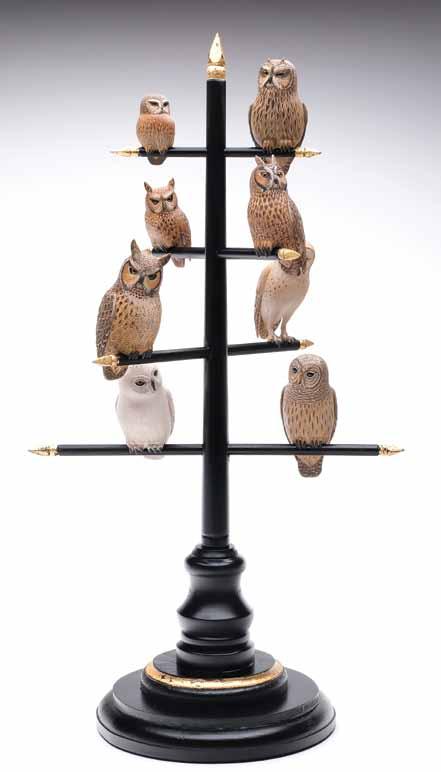
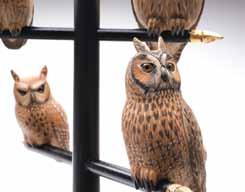
209 Eddie Wozny (b.1959), Cambridge, Maryland.
“Parliament of North American Owls.” Contemporary style bird tree with eight miniature owls of different species. All with relief wing feather carving and raised wingtips. All with slightly turned heads. Signed and titled on the underside, also with the species of each owl. Owls measures from 2.25” - 4.75” long. Perch measures 23.25” tall. Excellent and original.
(4,000 - 6,000)
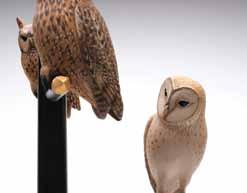

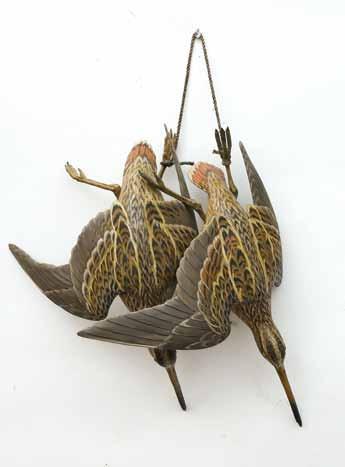
210 Eddie Wozny (b.1959), Cambridge, Maryland. Pair of hanging snipe. Outstretched wings and applied legs. One with open beak. One is signed and dated 1993. Snipe measure 11.5” and 13” long. Excellent and original. (3,000 - 4,000)
211 Eddie Wozny (b.1959), Cambridge, Maryland. Preening decorative ruddy turnstone. Both wings outstretched and turned head. Relief feather carving. Identified, signed, and dated 2022 on underside. Stands 9” tall. Excellent and original.
Provenance: Dean Hyde collection.
(1,200 - 1,800)
212 Eddie Wozny (b.1959), Cambridge, Maryland. Preening decorative willet. One outstretched wing and open beak. Relief feather carving. Identified, signed, and dated 2015 on underside. Stands 11.75” tall. Excellent and original.
Provenance: Dean Hyde collection.
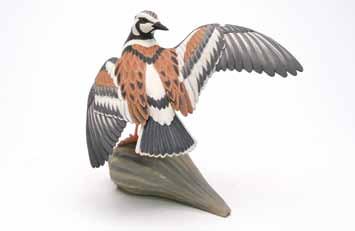
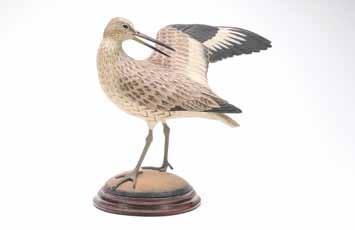
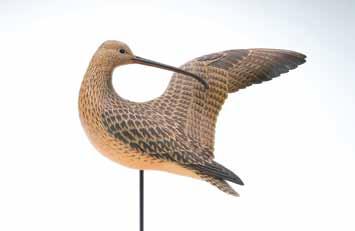
(1,000 - 1,400)
213 Eddie Wozny (b.1959), Cambridge, Maryland. Preening curlew. One outstretched wing and turned head. Relief feather carving. Signed and dated 2002 on underside. Measures 13” long. Excellent and original.
(1,500 - 2,500)
214 Eddie Wozny (b.1959), Cambridge, Maryland. Native American whirligig. Signed and dated 1995 on underside. Stands 25” tall with arm raised. Head feather was tightly reset with small amount of glue visible, otherwise excellent and original.
(1,500 - 2,500)
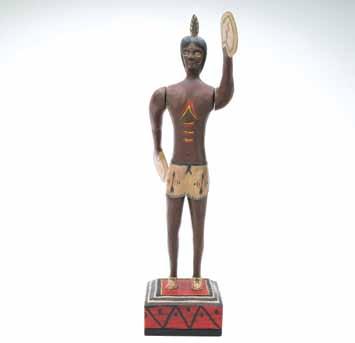
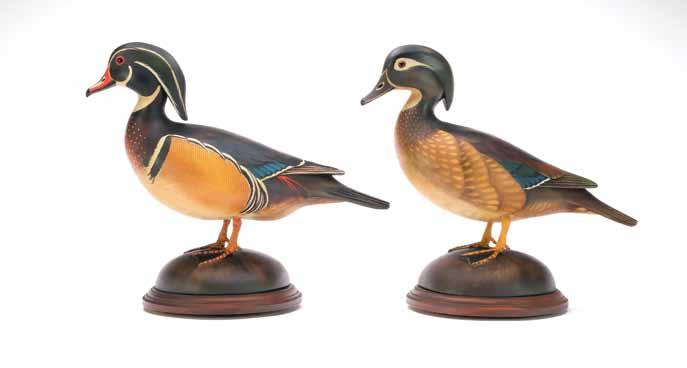

215 William Gibian (b.1946), Onancock, Virginia. Pair of standing wood ducks with extended crests and raised wingtips. Relief wing and tail feather carving. “Gibian” carved in the undersides. Measure 15” and 16” long. Excellent and original.
Provenance: Dean Hyde collection. (3,000 - 5,000)
216 William Gibian (b.1946), Onancock, Virginia. Pair of hollow carved mallards in the style of the Caines brothers. Deep relief wing carving and incised feather detail. Drake in preening pose. “Gibian” carved on the undersides. Measure 15.5” long. Excellent and original. (2,000 - 3,000)
217 William Gibian (b.1946), Onancock, Virginia. Large preening curlew. One raised wing and turned head. Relief wing and tail feather carving. “Gibian” carved in the underside. Stands 18” tall. Excellent and original.
Provenance: Dean Hyde collection. (2,000 - 3,000)
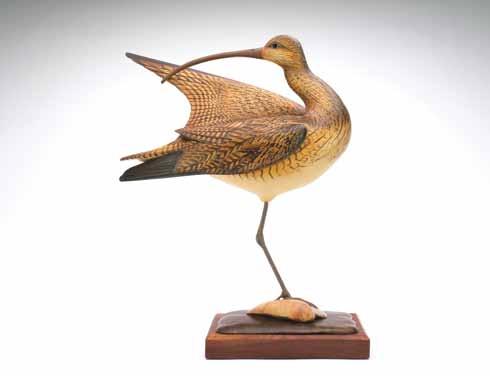
218 William Gibian (b.1946), Onancock, Virginia. Walking eskimo curlew with relief wing carving. Identified and dated 7/95 on underside. Stands 12.75” tall.
Some paint flaking on feet, otherwise very good and original.
Provenance: Dean Hyde collection. (800 - 1,200)
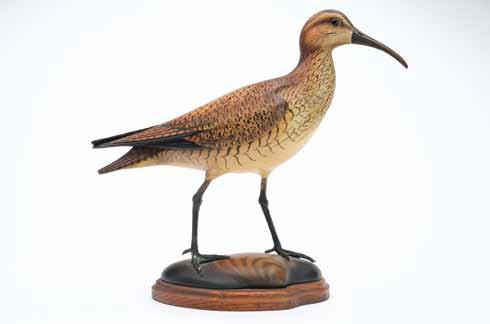
219 William Gibian (b.1946), Onancock, Virginia. Pair of mallards. Thinly hollowed with relief wingtip carving and slightly turned heads. Drake with curly metal tail sprig and high head pose. “Gibian” carved in underside. Measures 16.5” long. Excellent and original.
Provenance: Dr. Michael Shannahan collection. (2,500 - 3,500)

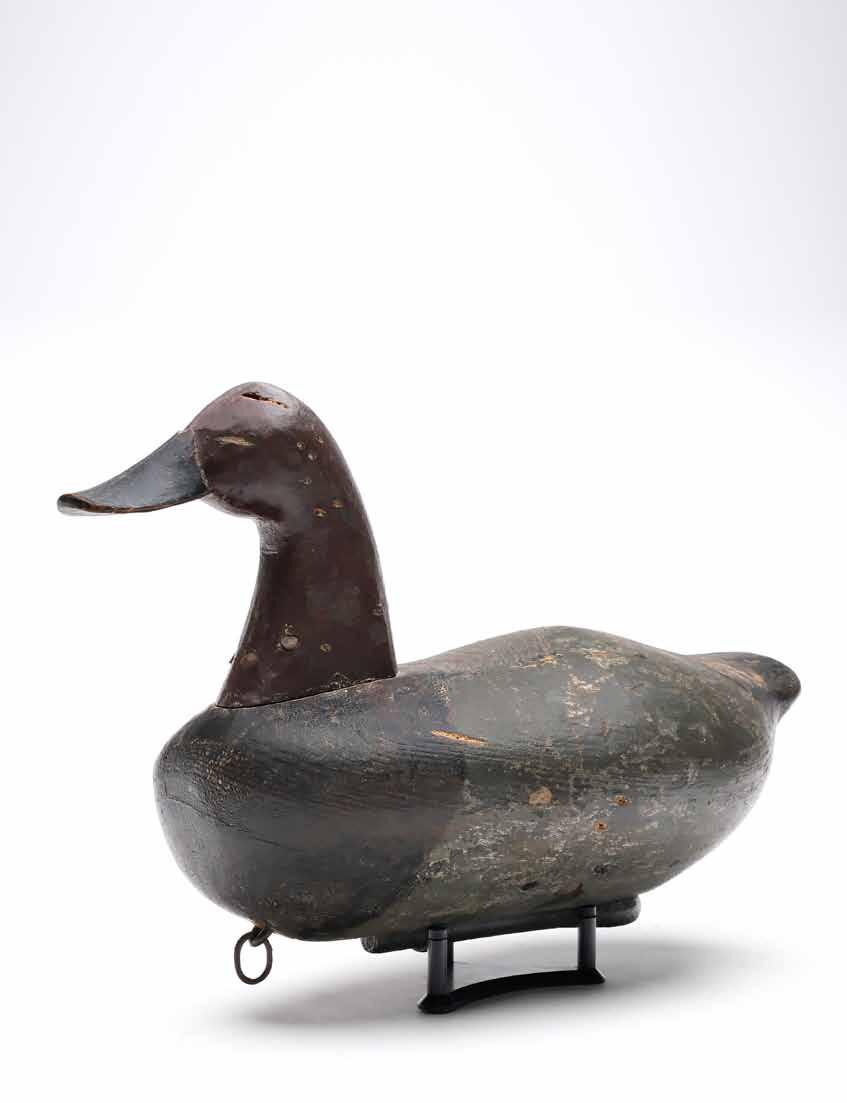
Alvirah Wright was born and raised in the small community of Old Trap in the eastern part of Camden County near the Pasquotank River and, like so many men in his community, he made his living on the water. He followed in his father’s footsteps and became a tugboat captain by trade. In about 1906, he moved to the Martin’s Point area of Dare County where he married Amy Rogers, set up a logging operation, and built a two-story logging mill. Apparently, neither the timber nor the marriage proved sustainable causing him to move back to Old Trap and, in 1914, he married his second wife, Sally Forbes. He was also an accomplished boat builder, and he developed quite a reputation for his skill in that trade.
It is reported that Wright only made 300 - 500 decoys in his lifetime. He made mostly large battery canvasbacks, a few redheads and scaup, and a small number of ruddy ducks. He is justly considered one of North Carolina’s finest decoy makers, and many collectors have long thought this redhead drake to be the finest Wright redhead known.
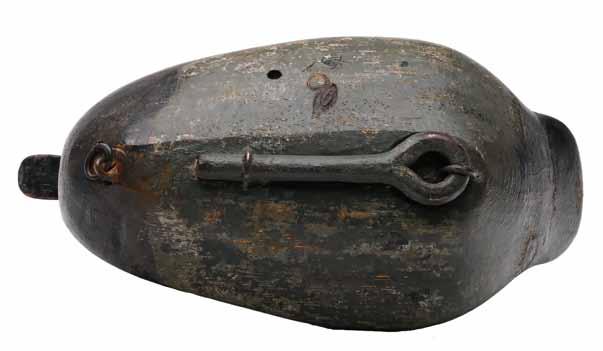
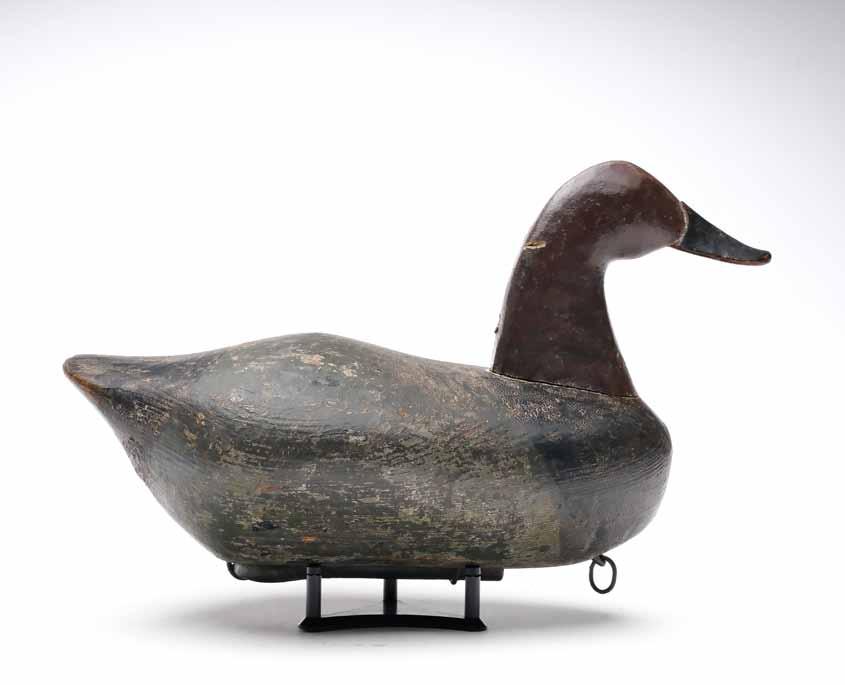
220 Alvirah Wright (1872-1951), Knotts Island, North Carolina. Excellent canvasback hen. Large decoy with excellent sculptural form. Scrap iron weight on underside. Measures 17.75” long. Original paint on much of the decoy; gray area around body appears to have an early second coat; moderate flaking and wear; moderately hit by shot; head is very slightly loose.
Provenance: Bill and Alice Walsh Collection. One of 250 used in Dexter Snow’s market gunning rig in Currituck Sound. Obtained from Vernon Berg, Nags Head, NC in July 1979.
Literature: “Southern Decoys of Virginia and the Carolinas” by Henry A. Fleckenstein Jr, page 224, exact decoy pictured.
(30,000 - 50,000)
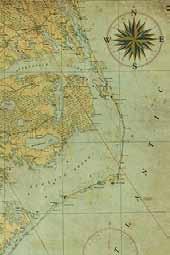
For the majority of George’s life, Ocracoke was a remote outpost at the southern end of the outer banks. Often battered by storms at any time of the year, life was hard on the Island. The relatively few residents earned a living according to the seasons, either as fishermen or sailors. The O’ Neal’s were a large clan in the small village and George’s parents, Simon and Ann (Annie), did their part to carry on the family name, having eight children of their own. Simon died in 1879, and George’s mother was left to raise their four children still at home at the time. George received only a 5th grade education and quickly entered the work force, By 1895, he was working as a sailor and married Alvalina (Allie) Spencer, a native Ocracoke girl. The couple had two sons and George continued to work either as a fisherman or sailo r for the remainder of his productive years. Allie became sickly and died in 1939, partly due to the fact that, according to her death certificate, “ The physician had not attended her for nine years and was gone (from the island) at the time of death”. By the following year, George was living with his eldest son and is recorded in the census as “old age asst” (presumably disabled)
During his lifetime, O’Neal supplemented his income by producing a large number of high quality decoys in a variety of species for use both on Ocracoke, and at clubs off the Island. One of the most important of these was the Gooseville Gun Club.
By the turn of the 19th century, both Ocracoke and Hatteras Islands were well known destinations for sportsmen from further north. Frequent visitors to Ocracoke included artist, writer, and decoy carver, Dr Edgar Burke, and Rex Beach, whose book “Oh-Shoot”, described Ocracoke as “ the center of the goose- hunting industry”. In the early 1920s, wealthy automotive parts designer and entrepreneur George Albert Lyons (1882 – 1961) of Asbury Park, NJ and Detroit, MI, began to visit Hatteras to enjoy the many shooting and fishing opportunities the area afforded. By 1927, he decided that it was time for him to own a portion of this outdoor paradise for himself, and he purchased 1500 acres at the southern tip of the Island from local merchant, Andrew S Austin (see note 1) . The following year, Austin helped to build a hunting lodge on the property, later named the Gooseville Gun Club. The relatively simple structure was not as pretentious as other clubs in the State, but it comfortably met the needs of it’s members and their guests, such as author Van Campen Heilner and artist, Lynn Bogue Hunt. The Club utilized large numbers of decoys and many of the very best were purchased locally from George W O’Neal of Ocracoke.
Note: 1. Dates of origin vary between 1914 and 1927 and area varies between 735 and 1500 acres.

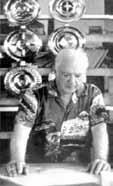
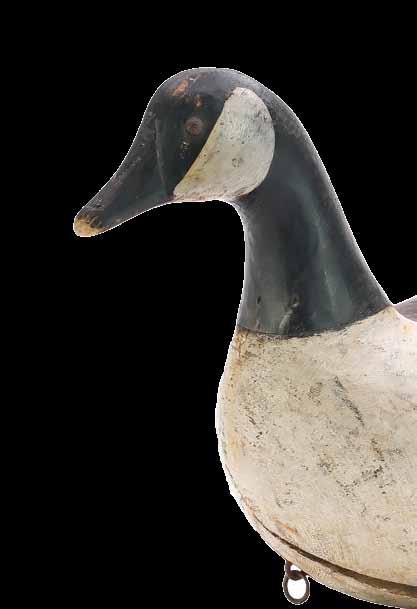

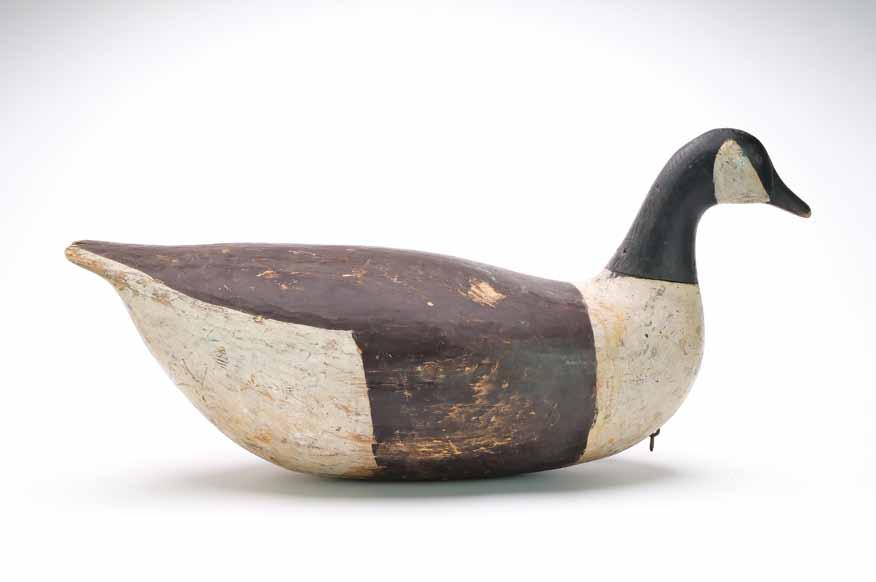
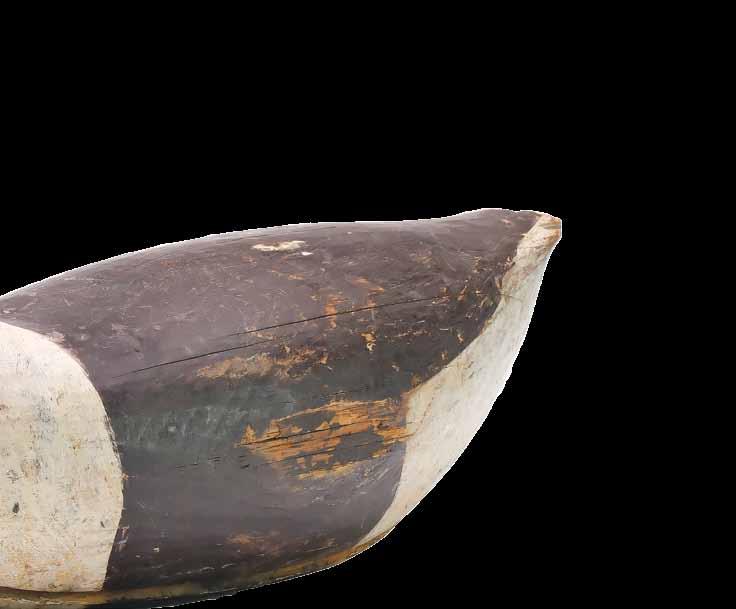
221 Attributed George O’Neil (18691948), Ocracoke, North Carolina. Large swimming Canada goose from the Gooseville Gun Club. Raised neck seat with slightly forward head pose and tack eyes. Mackey collection ink stamp and Gooseville Gun Club brand on underside. Measures 26” long. Mix of original and very early in use touchup; showing moderate flaking and wear; tight drying cracks in back; large split along the underside; minor chipping at tip of tail; large iron nail head on one side.
Provenance: Ex Mackey collection.
Literature:: Bourne catalog, August 24, 1974, lot 243. (8,000 - 12,000)
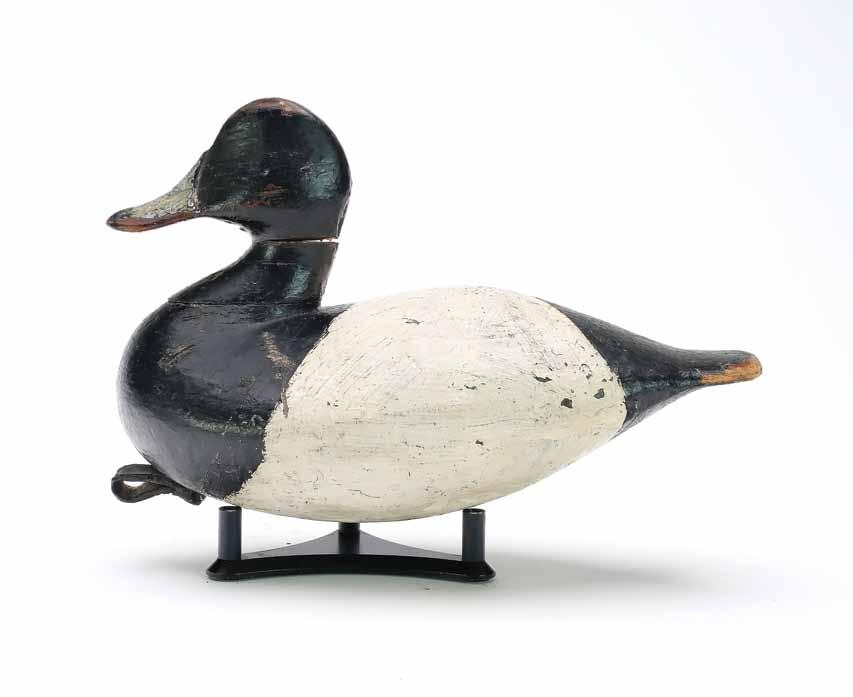
222 Lee Dudley (1860-1942), Knotts Island, North Carolina. Bluebill with reared back head and “LD” brand in underside. Measures 10.75” long. Old in use repaint with moderate wear; small dents and shot marks; crack through neck; small chip in one side of bill and top of head; initials were mostly gouged out at some point.
Provenance: Bill and Alice Walsh Collection. Obtained from Jesse Riggs, a guide in Back Bay in 1945.
(7,000 - 10,000)

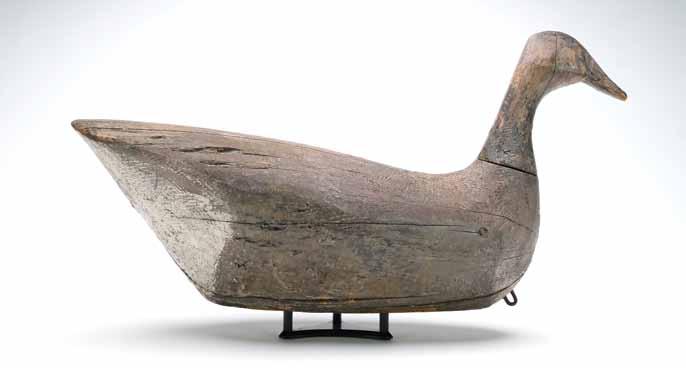
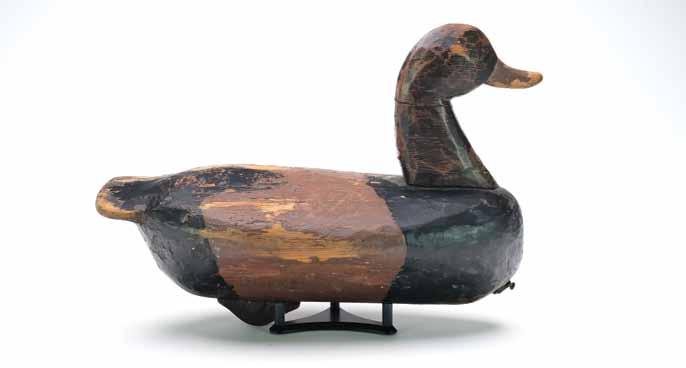
223 Ike O’Neil (1885-1968), Ocracoke Island, North Carolina. Swimming root head Canada goose. Measures 23” long. Old paint was worn down to much bare wood; many drying cracks and a large split in one lower side; drill hole on underside.
Provenance: Bill and Alice Walsh Collection. Obtained from Somers Headley in May, 1980 who obtained from Carter Smith in 1972. Exhibited by Somers Headley at the Philadelphia Exhibition. (4,000 - 6,000)
224 Alvirah Wright (1872-1951), Knotts Island, North Carolina. Redhead in slightly high head pose. Measures 16” long. Repaint with moderate flaking and wear; under a thin coat of wax; roughness on one edge of bill; crack through upper part of neck and along back.
Provenance: Bill and Alice Walsh Collection. Obtained from Harrell Grimstead, July 1979. (5,000 - 8,000)
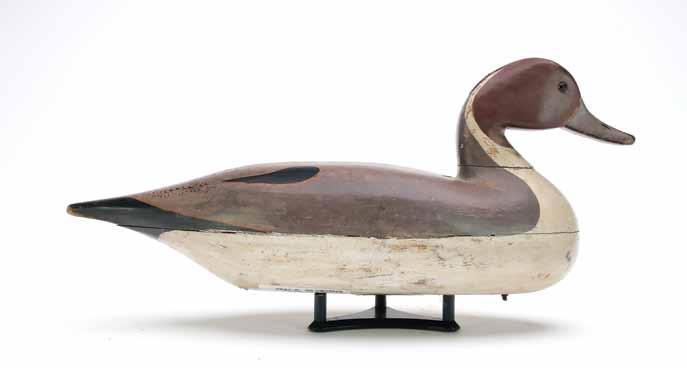
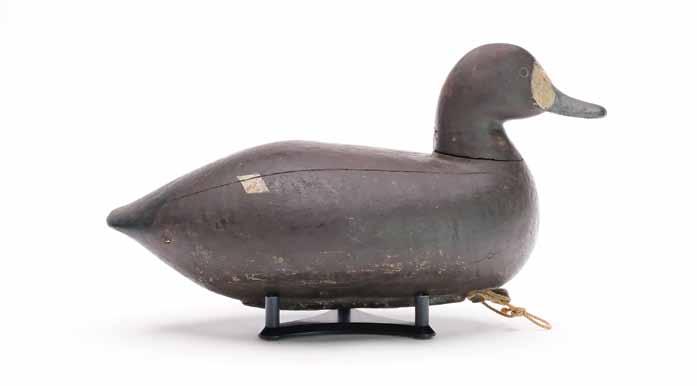
225 Alvin Harris (1904 - 1975), Atlantic, North Carolina. Excellent hollow carved pintail. “SGH” stamped in underside. Measures 17.75” long. Original paint with moderate wear; tight vertical drying crack on back of neck; slight separation at body seam.
Provenance: Bill and Alice Walsh Collection. Obtained from Somers G. Headley March, 1983 who bought it in NC many years ago.
(5,000 - 8,000)
226 Mitchell Fulcher (1869-1950), North Carolina. Bluebill hen with slightly raised neck seat, carved eyes, and “MF” carved in underside. Measures 14” long. Early in use repaint, likely by the maker, with minor flaking and wear; tight drying crack along back; drying split along underside; tight cracks at nails in neck seat; loss to wood near knot in back with small amount of filler added. (2,500 - 3,500)
227 Callie O’Neal (1910-1970), Currituck County, North Carolina. Bluebill hen. Measures 17.75” long. Original paint with minor gunning wear; very good structurally.
(1,000 - 1,500)
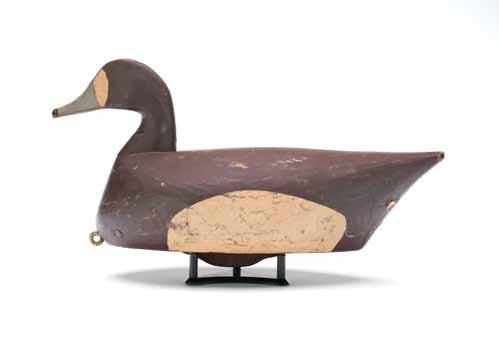
228 Attributed to Bob Morris (1881-1971), Church’s Island, North Carolina. Small bufflehead. Measures 9.5” long. Mostly original paint that has worn to much bare wood; black paint on head has flaked to a green under coat which may have all been done by the maker; hairline drying cracks in breast and one side.
(3,500 - 4,500)

229 Ned Burgess (1868-1958), Churches Island, North Carolina. Rare redhead hen, 1st quarter 20th century. Measures 16” long. With light to moderate gunning wear; original paint; rubs on body, head, bill. and tail; crack at neck; crack at bill has been reset; tip of bill is slightly blunted.
Provenance: Recently found at a Long Island estate. (2,000 - 3,000)
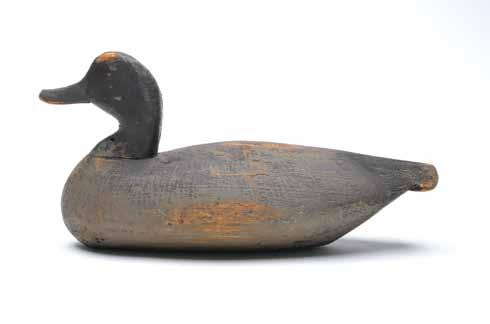



230 Dexter Snow (1893-1976), Powell’s Point, North Carolina. Redhead. Measures 16.5” long. Old paint has worn down to much bare wood; hairline drying cracks in breast and underside of tail; crack through neck; hairline cracks in one side of head and bill; small hole drilled in back near tail.
Provenance: Bill and Alice Walsh Collection. Obtained from Somers G. Headley, March 1986. (1,200 - 1,800)
231 Unknown maker, North Carolina, early 20th century. Canvasback hen. Measures 17” long. Old in use repaint with significant flaking and wear; tight drying crack along back; head is very slightly loose.
Provenance: Bill and Alice Walsh Collection. (800 - 1,200)
232 Unknown maker, North Carolina. Root head coot with applied canvas bill. Measures 11.5” long. Old in use repaint with moderate flaking and wear; loss to wood on back.
Provenance: Bill and Alice Walsh Collection. Found on shore of the sound. (600 - 900)
Joe Lincoln (1859 – 1938) of Accord Village in Hingham, MA. is well known for his extraordinary working decoys. These were made in a variety of species utilizing a host of construction methods. He was adaptable and resourceful as his limited advertisements clearly state, using terms such as “Made to Order” and “Of All Kinds” A 1918 article in the Boston Sunday Globe records that “Joe does all of his (work for) sportsmen who want decoys made according to their own particular vanity” . These were, clearly, special orders. There are a number of reports that he did, indeed, make carvings of birds other than what could be termed his standard lines of ducks and geese. Capt. Ellery Clark, whose family owned a large rig of Lincoln decoys, reported that his uncle, “Preston Clark, had swallows made by Lincoln on the stairway of his home in Cohasset” . Early collector Winsor White, who knew Lincoln, once stated that “I learned from an old gunner, many years ago, that Joe made three loons- - - .” He continued with; “He made at least one swan, ordered by a Canton woman to float in her pond”. Donna Tonelli wrote in 1999 that “ While Lincoln never made decorative decoys, he carved special order decoys for well-to-do gunning stand owners and others who admired his talents”.
Ted Harmon always thought that if Lincoln made shorebirds, then why not egrets or herons? He strongly believed that the egret offered here was carved by Lincoln. It was acquired from an estate in Easton, MA, just south of Canton. Both towns are in the immediate vicinity of Lincoln’s home in Hingham. The family was related to the Ames’ of shovel manufacturing fame and fortune and they also owned a small number of Lincoln decoys. The owner related to Ted that the original owner ordered it for use in her garden, but it was rarely actually used there. The egret clearly has Lincoln’s commonly used “plugs” where knots were drilled out, and the paint, although certainly not elaborate, conforms to Lincoln’s minimalistic pattern. Regardless of who actually made the carving, it is a fine representation of the live bird and a worthy addition to any collection.
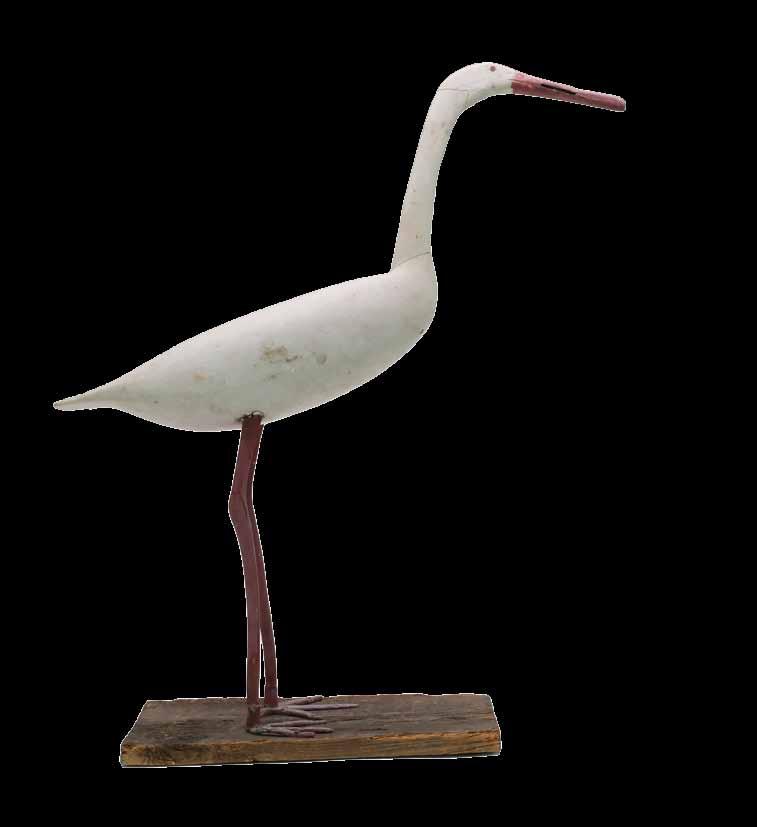
233 Egret, 1st half 20th century. Attributed by Ted Harmon to Joseph Lincoln of Accord, Massachusetts. Leaded feet with carved wooden legs, inserted in to body that is secured with wooden peg construction. Bill has cutout, presumably to insert reeds or something indicating that the egret is having a meal. Stands 31” tall. Old original paint that is discolored and stained slightly; tight crack at neck; tight crack in underside of body; small areas of paint loss where thighs insert into body.
Provenance: Ted and Judy Harmon collection. (5,000 - 8,000)
“Lincoln was a laconic man, a consummate Yankee craftsman whose solid body decoys are reflections of their makers personality – direct and spare, with not a gesture wasted.”
- Bob Shaw
Mention the word “Massachusetts decoy” to anyone interested in carved working birds and two names will inevitably be mentioned first – Elmer Crowell and Joe Lincoln. Opinions are about evenly split as to which of the two men deserve the title of “The Best”.
Joe was born the son of sailmaker George Lincoln and his wife Salome Whiting at the family home on Gardner St., in the Accord section of Hingham. The house was located on the shore of Accord Pond and afforded a lovely view out over the water as well as any passing wildlife. Sadly, his biological father passed away when he was only 9 and his brother, Wilbur, was 4. His Uncle, Joe Whiting, a cooper, moved into the home and helped to raise the two young boys. As a young man through 1894, Joe, typical for many in the area, worked in a shoe factory. By 1900 he was working as a poultry farmer with his brother. Joe was talented in anything requiring the use of his hands. He made and upholstered furniture, carved gunstocks and was reputed to be able to repair just about anything, including clocks and cameras. From at least 1908 through the 1920 census, he lists his occupation as “carpenter”. It is no surprise then that he also constructed a number of excellent lapstrake boats which he kept on the shore of the pond. If he had a passion, it was raising award winning dahlias (a flower). He also loved to hunt! There is no record as to
exactly when he made his first decoy, but it is a safe assumption that it was at an early date. By 1918, his fame in carving a very high-quality decoy, resulted in a lengthy article in a Boston newspaper where he is recorded as saying:
“You’ve got to make them good enough to fool the sharp eyes of a duck or goose - - - - and you just bet that those birds have the sharpest eyes and the cunningest brains that there are in the bird family. A turn of the knife the wrong way, a peculiar tilt to the head, such as is not affected by the duck or goose family, and your work is spoiled.”
Orders poured in, allowing him to concentrate on carving as his primary occupation. By 1928, his production had grown to the point where he lists his occupation in the Hingham City directory as “decoy mfg”. Most of the orders were obtained through the mail but many hunters would drive directly to Joe’s tiny shop to place an order for the upcoming season. Occasionally he would stage an elaborate exhibit at the Boston Sportsman’s show.

Joe was a member of the North Shore Gun Club located on the pond below his home. This was one of the celebrated and unique “Massachusetts Shooting Stands”. These were complex arrangements of clubhouses, runways, and lengthy breastworks (blinds) as well as live decoy pens, and storage sheds. In addition to the live birds, these “stands” required large numbers of wooden decoys. Joe was responsible for most of the wooden birds at the North Shore Club, as well as numerous other similar operations stretching from southern New Hampshire to northeast Rhode Island. He was also often called upon to repair and/or repaint damaged or worn birds in addition to carving custom orders. As one would expect, the bulk of his production was of species most in demand by the stands, thus black ducks and geese comprise a good percentage of his work, with much smaller numbers of other species. The mallard being offered here is the only full-size Lincoln mallard known to exist. The lack of mallards in the Massachusetts area during this time can account for its rarity.
“Lincoln’s work is characterized by clean and crisp lines and a stylized plumage painting which is as precise as an engraving.”
- Dr George Ross Starr
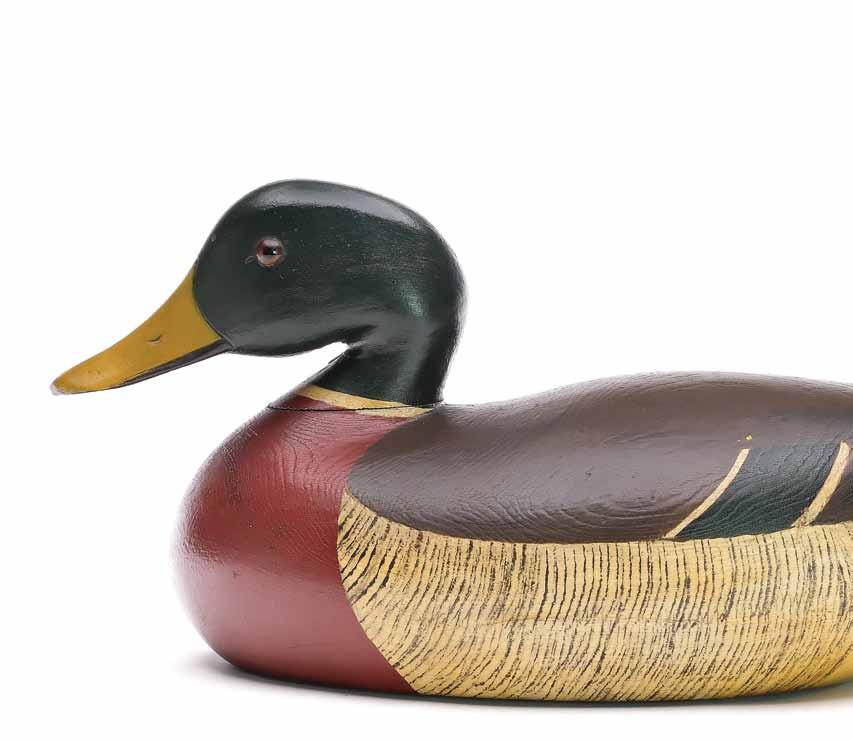
234 Joseph Lincoln (1859-1938), Accord, Massachusetts. Exceedingly rare mallard. Excellent form. Decoy was never rigged or weighted. Measures 16” long. Near mint original paint under an early coat of varnish that has darkened with age; a few tiny dents and paint rubs; a thin crack through neck was tightly reset with thin line of touchup. (60,000 - 90,000)

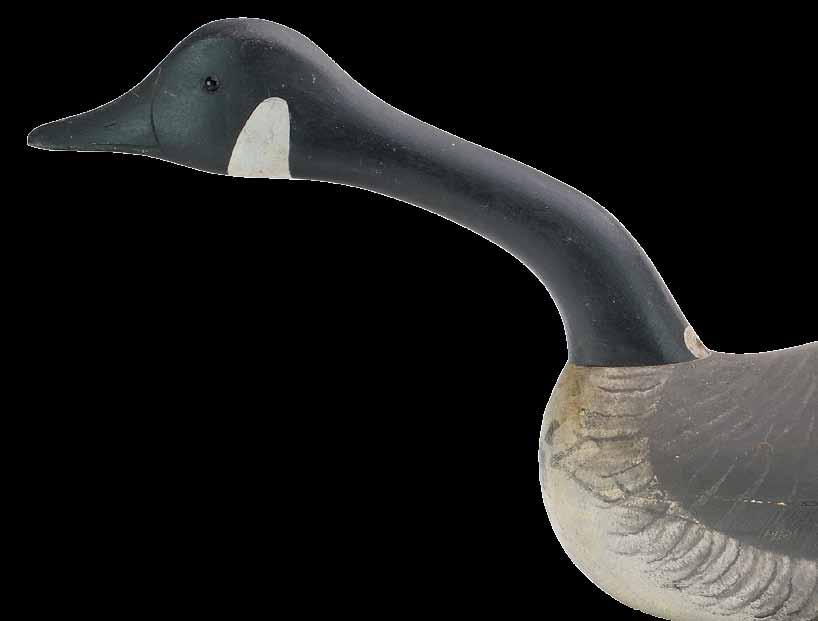
235 Joseph Lincoln (1859-1938), Accord, Massachusetts. Extremely rare and important swimming Canada goose with outstretched and slightly raised head pose. Measures 32.5” long. Excellent original paint with almost no wear; fine drips of white along the back; large split along one side was filled and touched up and has separated since then; smaller crack along the other side was filled in the making and has opened slightly with a few small spots of touchup; some flaking to filler at a tight drying crack in back; black paint around nail head at back of neck seat is down to bare wood; an x-ray shows that the head by Lincoln and the body by Lincoln were from two separate decoys and brought together; a chip in one side of the neck seat was professional restored.
Provenance: Ted and Judy Harmon collection.
Literature: “Joseph W. Lincoln” by Cap Vinal, page 28, exact decoy pictured. (15,000 - 25,000)

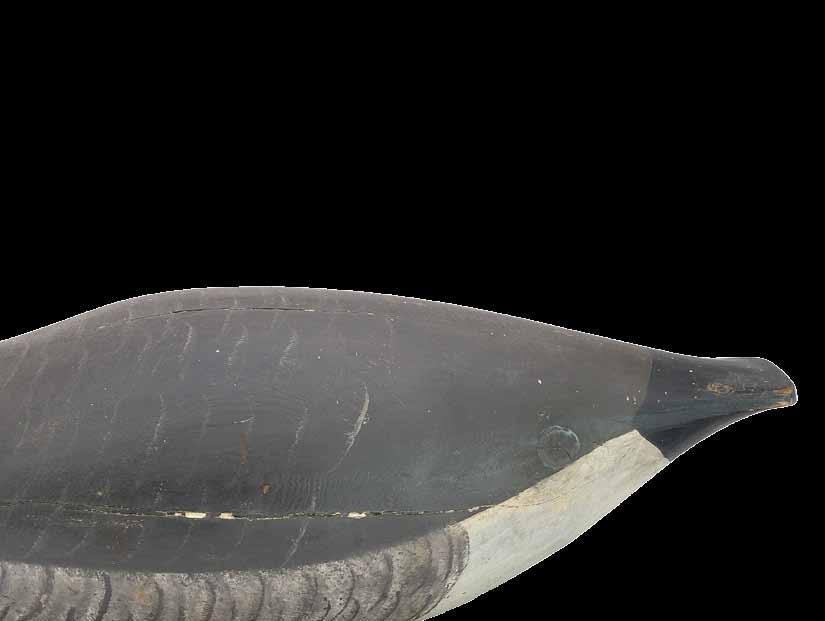
1862 - 1952 | East Harwich, Massachusetts
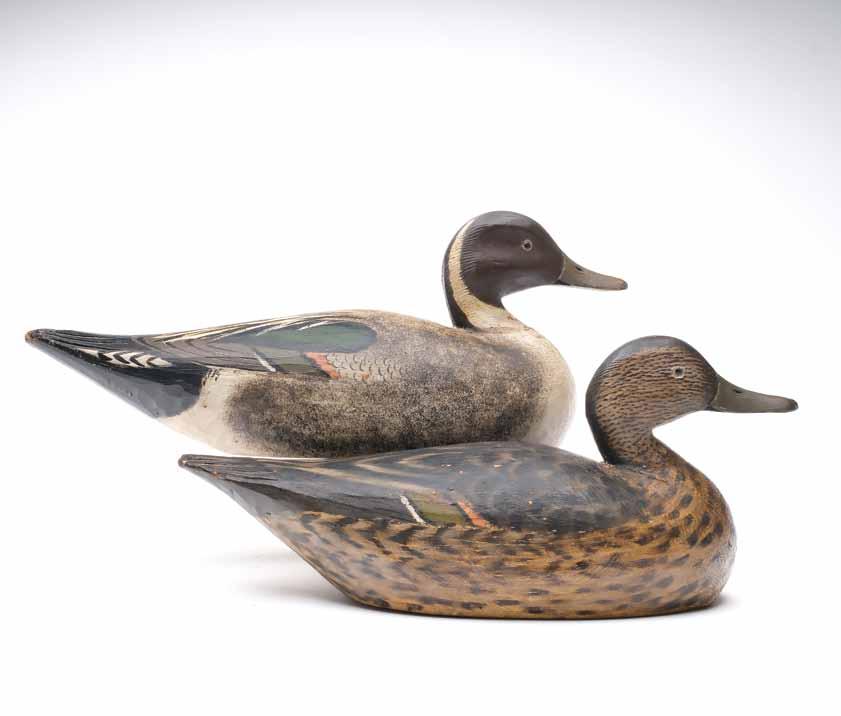
236 A. Elmer Crowell (1862-1952), East Harwich, Massachusetts. Exceptional pair of oversized pintails. Both have Crowell’s oval brand in the underside. Both have Crowell’s oval brand on the underside. Both have relief tail feather carving and chip carving on bodies under the tail. Characteristics of Crowell’s earlier work. Drake has slightly turned head. Hen has slightly lifted head. Measure 18” long. Original paint with very minor wear; chip missing from end of drake’s tail that was touched up a long time ago; a few tiny paint flakes. (50,000 - 80,000)
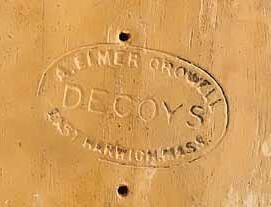

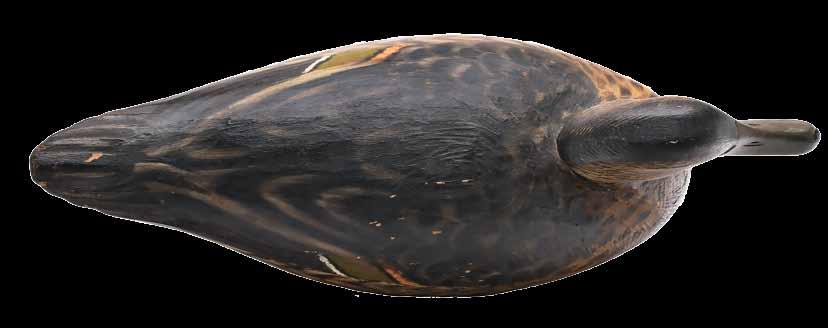
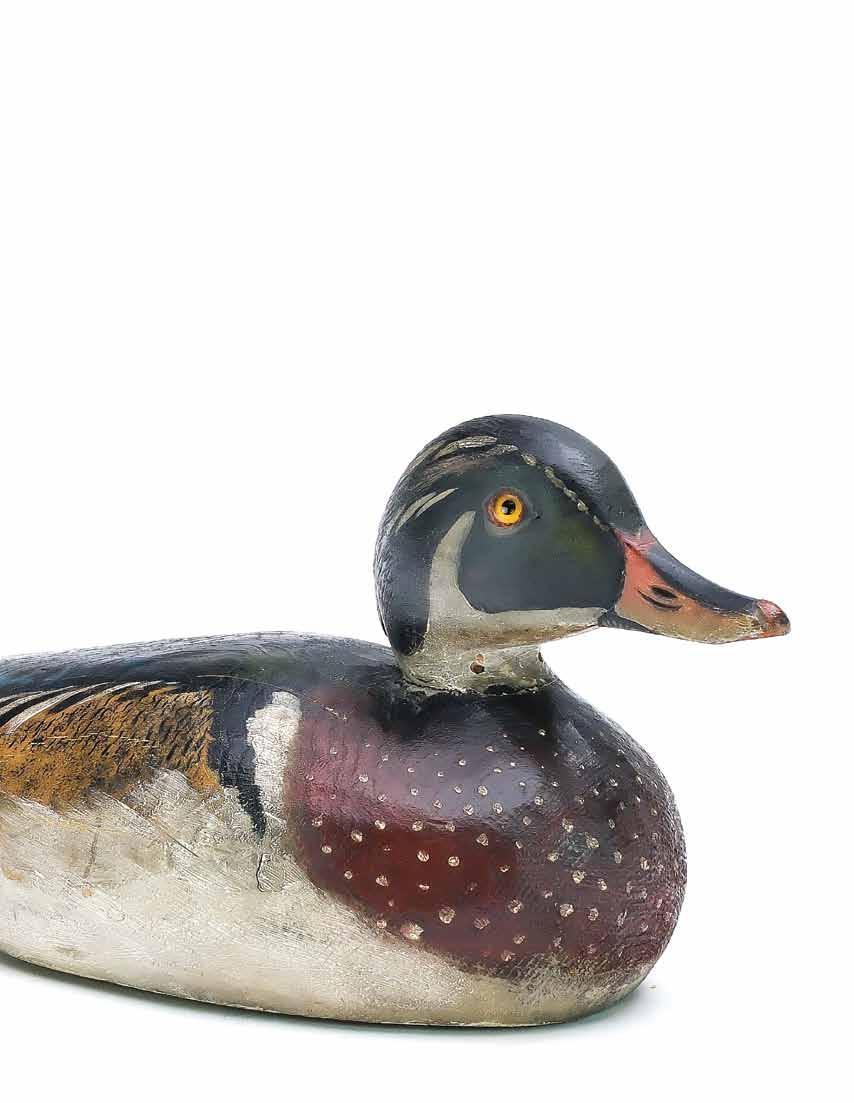
237 A. Elmer Crowell (1862-1952), East Harwich, Massachusetts. Excellent wood duck with slightly turned head and extended crest carving. Maker’s oval brand and blue paper label on underside. Round inlaid lead weight in underside. Measures 13.5” long. Very appealing original paint with very minor wear; a thin coat of varnish has darkened slightly with age; fine hairline crack in tail; slight separation on one side of neck seat with small amount of glue visible. (30,000 - 40,000)
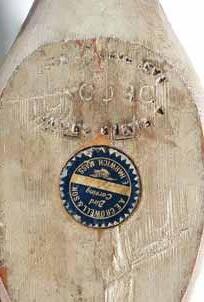
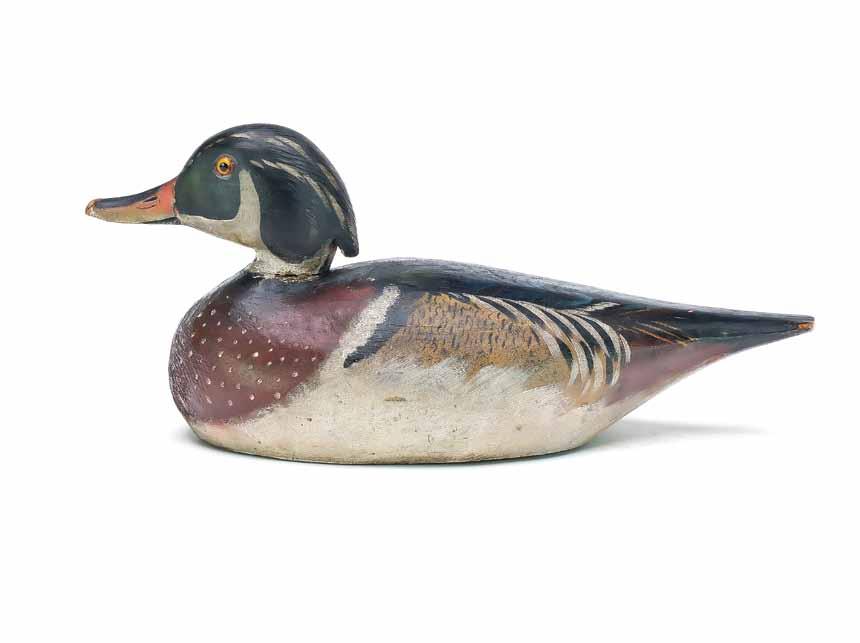

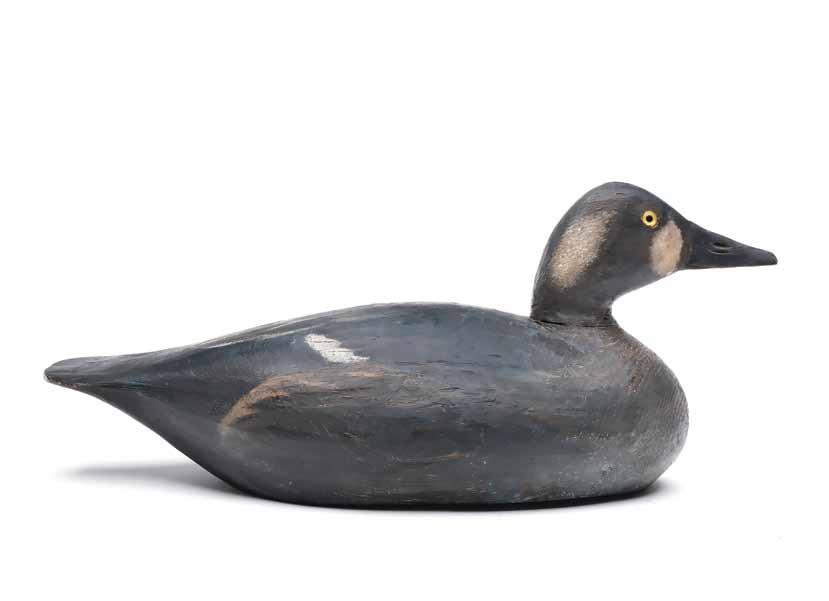
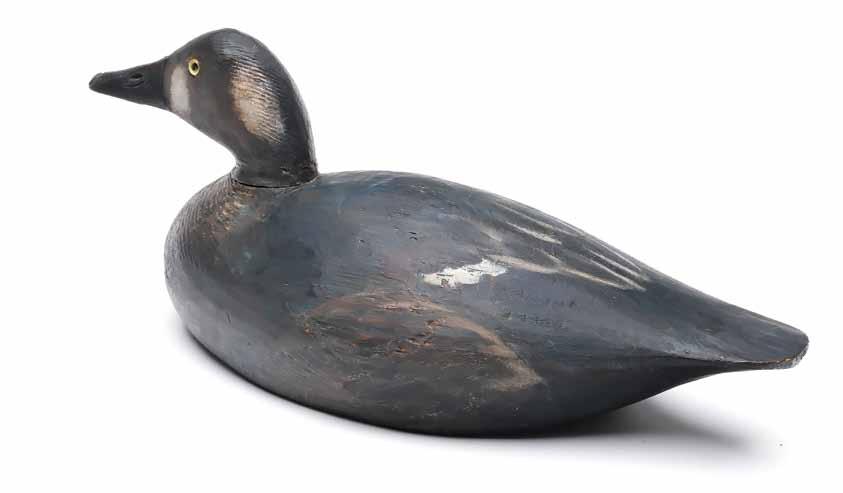
238 A. Elmer Crowell (1862-1952), East Harwich, Massachusetts. Rare white wing scoter hen with makers oval brand on the underside and “C.M.” branded for Clinton Mayo. Measures 17” long. Original paint with very minor wear; small amount of neck filler restoration, otherwise very good structurally. (20,000 - 25,000)
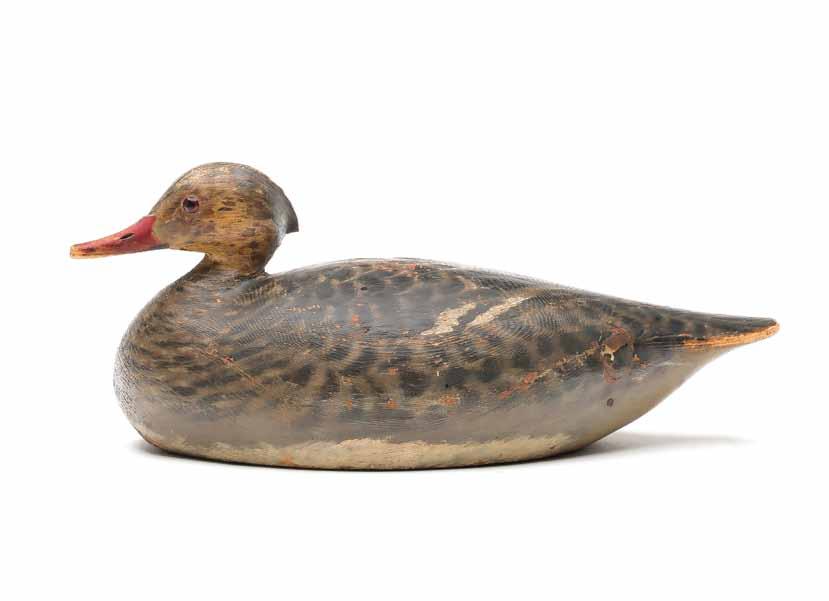
239 A. Elmer Crowell (1862-1952), East Harwich, Massachusetts. Extremely rare merganser hen with slightly turned head. Maker’s oval brand in underside. The only Elmer Crowell merganser we have seen with carved extended crest feathers. Decoy was purchased from Alan Haid, who also said it was the only one he had ever seen. Measures 16” long. Original paint with minor to moderate gunning wear; hairline crack through neck; minor blunting at tip of bill and tail; chip in bottom part of crest which would have come to a point.
Provenance: Purchased from Alan Haid. Private southern collection. (12,000 - 18,000)
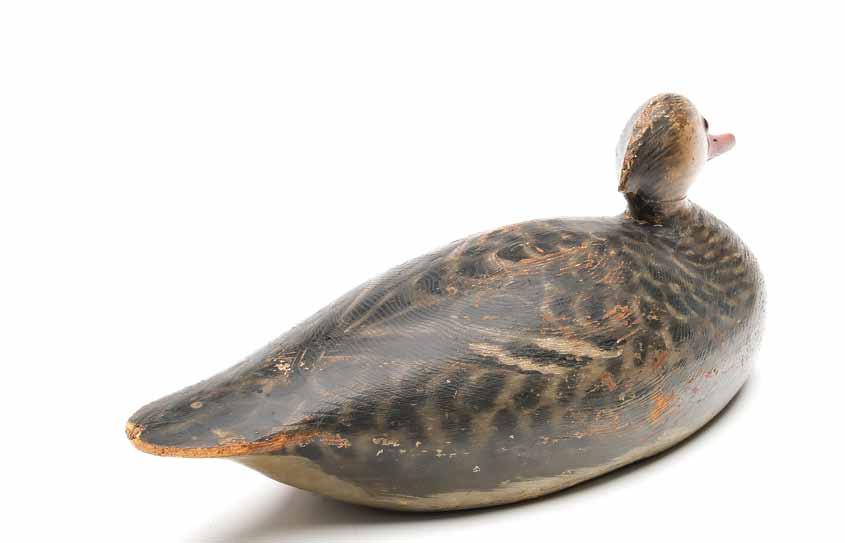

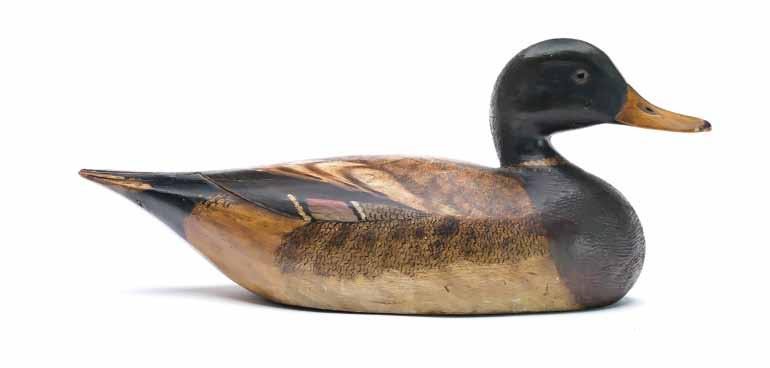
239A A. Elmer Crowell (1862-1952), East Harwich, Massachusetts. Mallard drake with tack eyes and relief tail feather carving. Maker’s oval brand on underside. Also with maker’s signature on underside. Decoy was never rigged or weighted. Measures 17” long. Original paint with very minor wear; an early coat of varnish has crazed and caused areas of paint shrinkage; small dent in one edge of bill; otherwise very good structurally. (6,000 - 9,000)
240 A. Elmer Crowell (1862-1952), East Harwich, Massachusetts. Mallard with slightly turned head. Relief wing tip and tail feather carving. Maker’s rectangle stamp on underside. Measures 17” long. Original paint under a thick coat of varnish that has darkened with age; hairline crack through neck; some old glue visible at neck seat. (4,000 - 6,000)
241 A. Elmer Crowell (1862-1952), East Harwich, Massachusetts. Goldeneye hen with tucked and slightly turned head. Maker’s oval brand on the underside. Measures 14” long. Original paint with moderate gunning wear; hit by shot in one side; slight separation at neck seat.
(3,000 - 4,000)

242 A. Elmer Crowell (1862-1952), East Harwich, Massachusetts. Goldeneye with slightly turned head. Maker’s rectangle stamp on underside. Round inlaid weight on underside. Measures 14.5” long. Original paint with very minor wear, mostly on edge of tail; very minor blunting at tip of bill; three small dents in back were filled and touched up.
(3,000 - 4,000)

243 A. Elmer Crowell (1862-1952), East Harwich, Massachusetts. Classic black duck. Maker’s oval brand on the underside. Measures 17.75” long. Original paint with minor flaking and wear under a thin coat of varnish; lightly hit by shot; some replaced filler at neck seat and to a small knot at tip of tail.
(2,500 - 3,500)


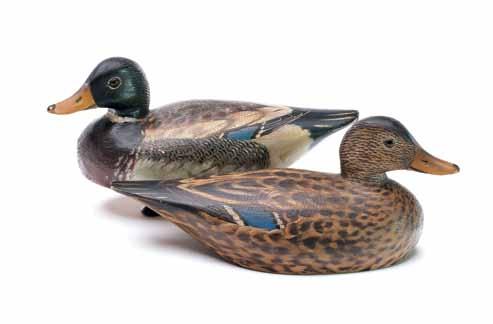
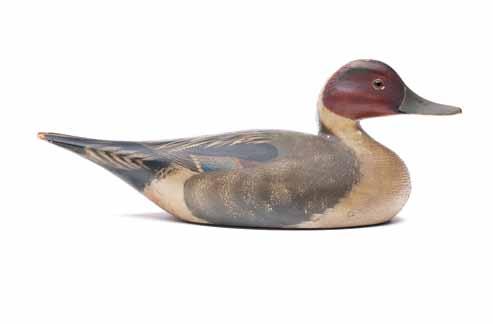
244 A. Elmer Crowell (1862-1952), East Harwich, Massachusetts. Bluebill with tucked and slightly turned head. Relief wingtip and tail feather carving. Maker’s rectangle stamp twice on painted underside. Measure 12.75” long. Original paint with very minor wear, mostly on edge of tail; small spot of newspaper on one lower side. (5,000 - 8,000)
245 A. Elmer Crowell (1862-1952), East Harwich, Massachusetts. Pair of 1/3 size mallards. With slightly turned heads. Maker’s rectangle stamp on underside. Measure 10.5” long. Original paint protected under a thin coat of varnish; very minor flakes and wear; very good structurally. (4,000 - 6,000)
246 A. Elmer Crowell (1862-1952), East Harwich, Massachusetts. Half size pintail with slightly turned head. Maker’s rectangle stamp on underside. Measures 13.75” long. Original paint protected under a thin coat of varnish that has darkened with age; a few flakes at neck seat; and above a knot in one lower side; minor flaking at hairline separation to wood grain on top of head; minor roughness with a small reglued chip at top of tail. (2,000 - 3,000)
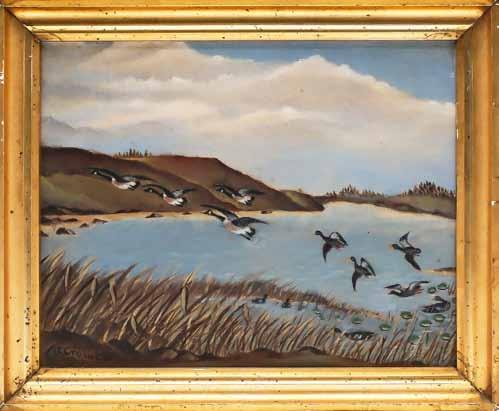
247 A. Elmer Crowell (18621952), East Harwich, Massachusetts. Oil on artist board of flying Canada geese and mallards over a salt water pond. Signed “AE Crowell” lower left. Image measures 7.5” x 9.5”. Excellent and original. (6,000 - 9,000)
248 A. Elmer Crowell (1862-1951), East Harwich, Massachusetts. Half size tern. split tail feather carving. Maker’s rectangle stamp on underside of base that is chip carved and painted like water. Tern measures 6.5” long, base measures 7” across. Tiny chip at tip of one tail feather was professionally restored, otherwise excellent and original.
Provenance: Ted and Judy Harmon collection. (3,000 - 5,000)
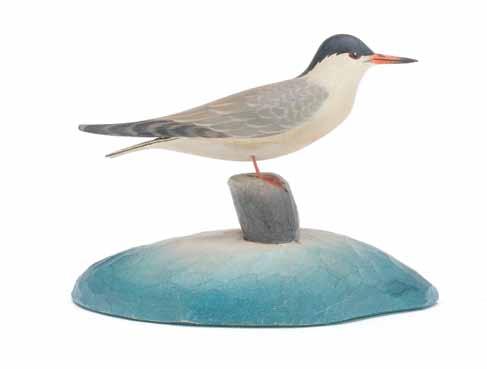
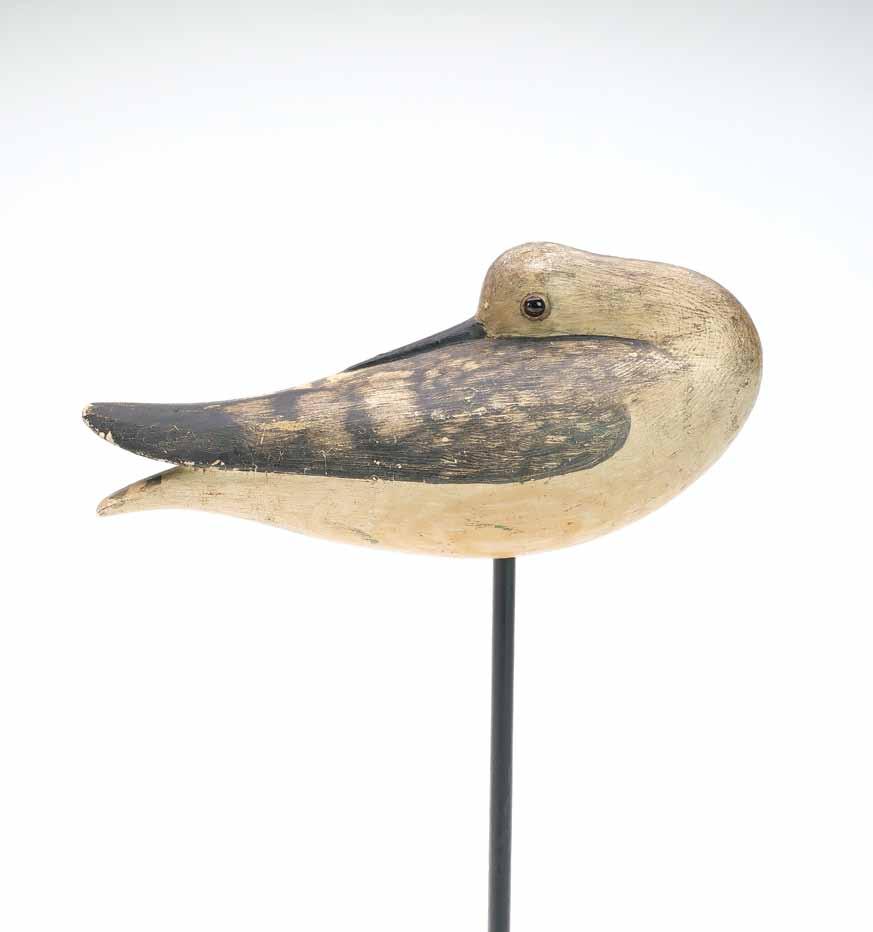

249
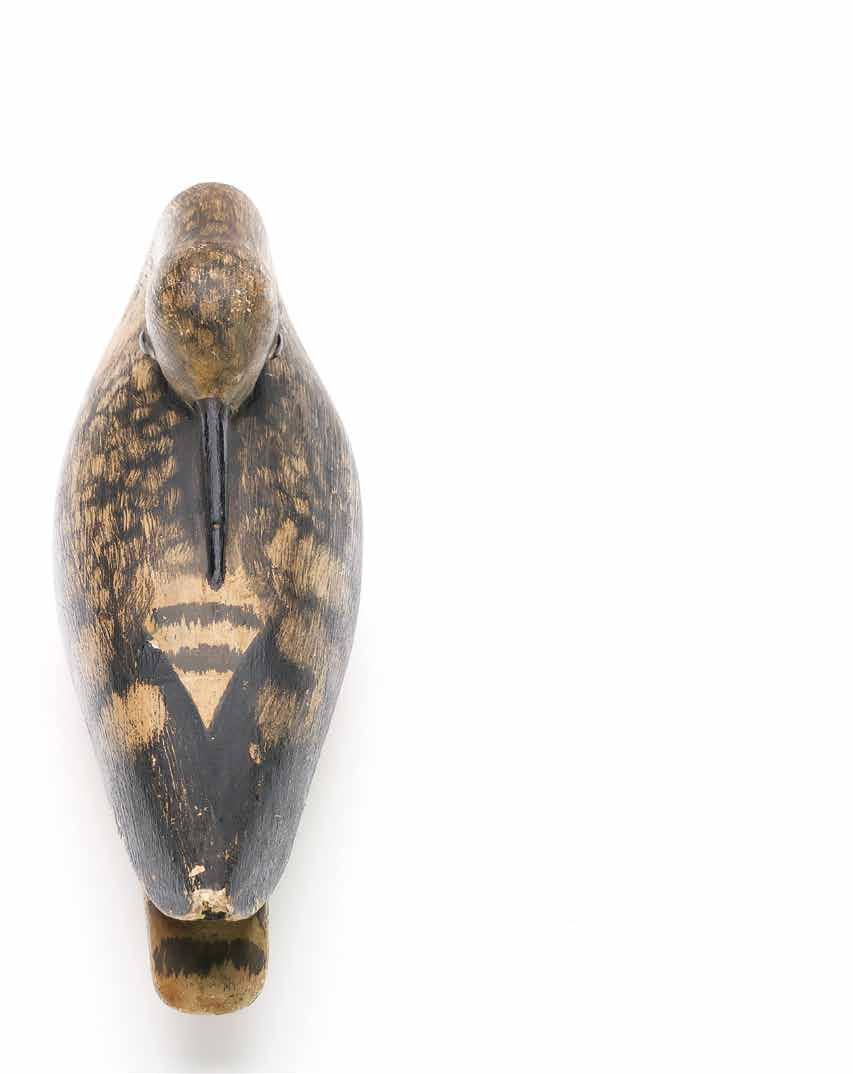
Melvin Gardner Lawrence (1880-1930), Revere, Massachusetts. Sleeping yellowlegs with glass eyes and split tail carving. Two different George Ross Starr collection ink stamps on the underside. Measures 9.25” long. Original paint with minor flaking and wear; area of discoloration on one lower side; very good structurally.
Provenance: Ted and Judy Harmon collection.
Literature: “The Bird Decoy: an American Folk Art Form” by Paul A. Johnsgard, page 166, exact decoy pictured. “Decoys of the Atlantic Flyway” by Dr. George Ross Starr Jr., page 84, exact decoy pictured. “Bird Decoys of North America” by Robert Shaw, page 168, exact decoy pictured. “American Vernacular” by Frank Maresca and Roger Ricco, page 34, exact decoy pictured. (25,000 - 35,000)
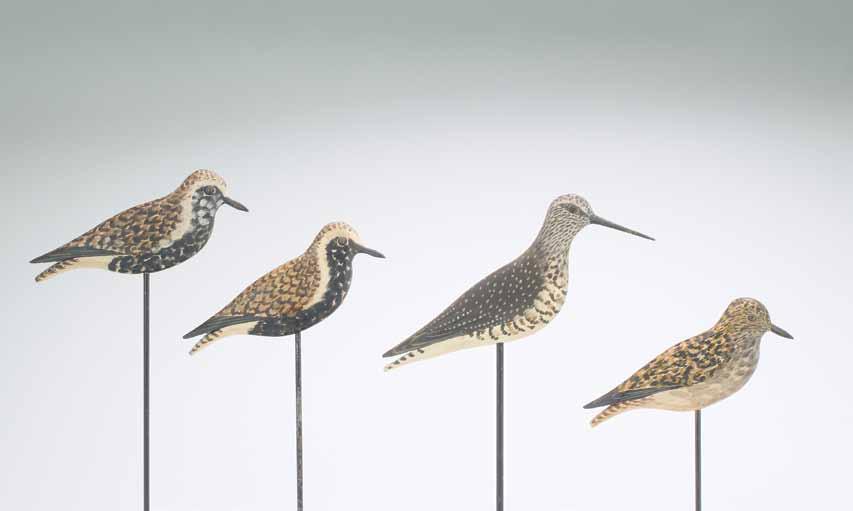

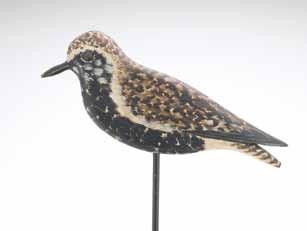
250 A. Elmer Crowell (1862-1951), East Harwich, Massachusetts. Group of four flattie shorebirds. With brass tack eys and split tail carving. Includes three plover and a yellowlegs. Measure from 9” - 12.5” long. Tiny paint rubs at wingtips and flaking to painted tack eyes, otherwise excellent.
Provenance: Ted and Judy Harmon collection.
(14,000 - 20,000)
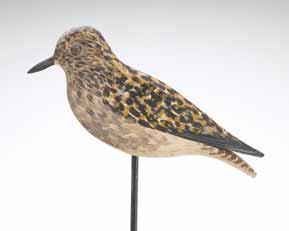
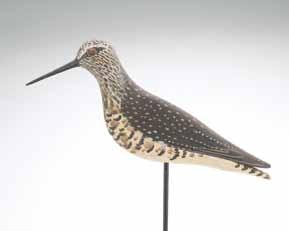

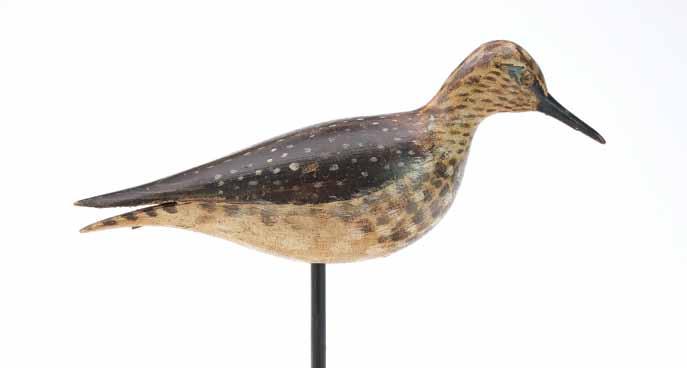
251 Chipman Family, Sandwich, Massachusetts. Hollow carved yellowlegs with glass eyes and metal insert at stick hole. Measures 10.75” long. Original paint with very minor wear; under an old coat of varnish that has darkened with age; restoration around neck area; tight cracks in face with small amount of filler added near one eye; small piece of filler missing where bill meets face.
Provenance: Ted and Judy Harmon collection. (3,000 - 5,000)
252 A. Elmer Crowell (1862-1951), East Harwich, Massachusetts. Working sanderling or lesser yellowlegs. With tack eyes and split tail carving. Measures 9” long. Original paint with minor wear under a thin coat of varnish; heavily hit by shot in one side; small piece of filler missing where bill meets face; some filler and touchup added to a crack on underside of where bill meets the face.
Provenance: Ted and Judy Harmon collection. (7,000 - 10,000)
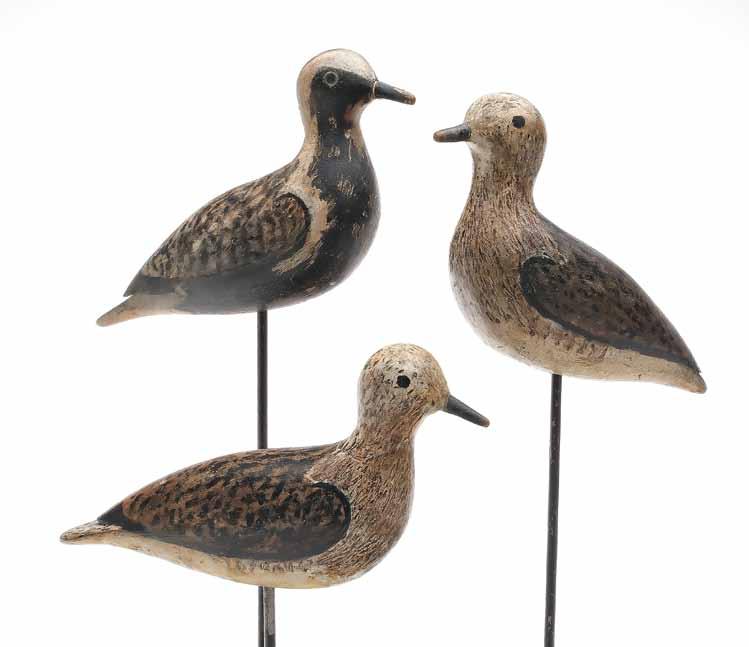
253 Unknown maker, Massachusetts, early 20th century. Black bellied plover in winter plumage. Attributed by Ted Harmon to Tom Wilson. Measures 9.25” long. Small chip at back side of stick hole, otherwise excellent and original.
Provenance: Ted and Judy Harmon collection.
(3,000 - 5,000)
254 Unknown maker, Massachusetts, early 20th century. Black bellied plover in winter plumage. Attributed by Ted Harmon to Tom Wilson. Measures 10” long. Minor discoloration on underside, otherwise excellent and original.
Provenance: Ted and Judy Harmon collection.
(3,000 - 5,000)
255 Unknown maker, Massachusetts, early 20th century. Black bellied plover in winter plumage. Attributed by Ted Harmon to Tom Wilson. Measures 10” long. Original paint with even gunning wear; hole drilled through lower portion of tail for string carry; bill shows wear, mostly on one side and top of bill exposing bare wood.
Provenance: Ted and Judy Harmon collection.
(3,000 - 5,000)

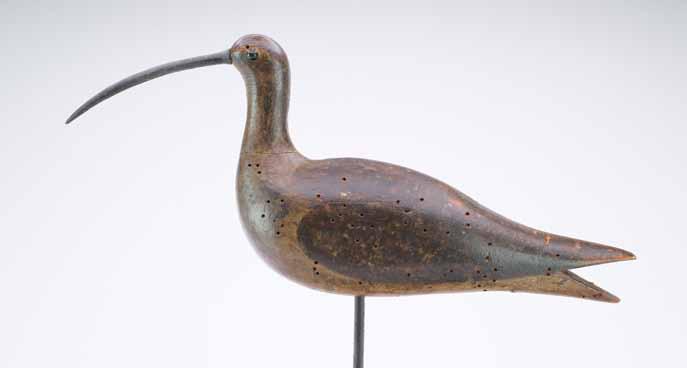
257
256 Unknown maker, Massachusetts, early 20th century. So called Fox rig curlew with split tail carving and painted eyes. This example does not have the Fox rig brand and appears to be unused. Measures 14.5” long. Near mint original paint; shallow dent in one side; bill is a professional replacement.
Provenance: Ted and Judy Harmon collection. (5,000 - 8,000)
257 Unknown maker, Massachusetts, late 19th century. Curlew with split tail carving, two piece head and body, and glass bead eyes. Measures 14” long. Original paint with minor wear under a thin coat of varnish that has darkened with age; heavily hit by shot in one side; tiny chip in wingtip; bill is a professional replacement.
Provenance: Ted and Judy Harmon collection.
Literature: “Joseph W. Lincoln” by Cap Vinal, page 70, exact decoy pictured. (5,000 - 8,000)

258 Elisha Burr (1839-1909), Hingham, Massachusetts.
Greater yellowlegs with deep relief wing carving and raised wingtips. Measures 13” long. Original paint with minor wear under a coat of varnish that has darkened slightly; two small spots of touchup near stick hole, possibly where wire legs had been added at some point; small chip in underside of tail; tiny chip at tip of one wing that was darkened; bill is a professional replacement; large chip in one side of face and top of head professionally restored.
Provenance: Ted and Judy Harmon collection.
(4,000 - 6,000)
259 Elisha Burr (1839-1909), Hingham, Massachusetts.
Feeding yellowlegs. Relief wing carved and raised wingtips. Measures 13.25” long. Original paint with moderate flaking and wear; old chip at stick hole; bill is very slightly loose.
Provenance: Ted and Judy Harmon collection.
(6,000 - 9,000)
260 Elisha Burr (1839-1909), Hingham, Massachusetts.
Feeding black bellied plover with relief wing carving and extended wingtips. “E Burr” branded in underside. Two different George Ross Starr collection ink stamps on underside. Measures 11” long. Mix of original and early in use touchup with moderate flaking and wear; bill and front area of face professionally restored; applied wingtips appear original, but may be early replacement by the maker; minor chipping at stick hole.
Provenance: Ted and Judy Harmon collection.
Literature: “Decoys of the Atlantic Flyway” by Dr. George Ross Starr Jr, page 24, exact decoy pictured. “The Bird Decoy” by Paul A. Johnsgard, page 170, exact decoy pictured. (2,500 - 3,500)
261 Unknown maker, Massachusetts, early 20th century. Small semi palmated plover and sanderling by the same maker. Relief wing and detailed bill carving. Measure 5.5” and 6.5” long. Original paint with minor flaking and wear; both are very good structurally.
Provenance: Ted and Judy Harmon collection. (3,000 - 5,000)
262 Unknown maker, Nantucket, Massachusetts, late 19th century. Golden plover with deep relief wing carving and extended wingtips. Carved wooden thighs that originally had wire legs inserted. Measures 10.5” long. Original paint with very minor wear; half of one extended wingtip is professionally restored.
Provenance: Ted and Judy Harmon collection. (5,000 - 8,000)
263 Unknown maker, Massachusetts, late 19th century. Black bellied plover with relief wing carving and raised wingtips. “87 Garland” carved in underside. Carrying hole drilled through tail. Measures 11.5” long. Original paint with moderate wear under an early coat of varnish; lightly hit by shot; bill is a professional replacement; old second coat of white on sides of neck and breast were taken down.
Provenance: Ted and Judy Harmon collection. (2,000 - 3,000)



264 Unknown maker, Massachusetts, late 19th century. Golden plover with applied metal wings and tack eyes. Holes in underside where metal legs may have been used. Also with a hole drilled through body for flapping wing mechanism. Measures 11.5” long. Original paint with very minor wear; one small metal staple missing on one flapping wing.
Provenance: Ted and Judy Harmon collection. (2,500 - 3,500)

265 Franklin Pierce Wright (1854-1939) attributed, West Barnstable, Massachusetts. Appealing goldeneye hen with slightly turned head and relief wing carving. Tack eyes and nicely carved bill. Seven small lead weights drilled in to the underside. Measures 12.25” long. Very early paint appears to be a mix of original and early in use repaint; a coat of varnish has darkened with age; area on underside was shaved down likely to remove a brand.
Provenance: Ted and Judy Harmon collection.
Literature: “The Great Book of Waterfowl Decoys”, Joe Engers, editor, page 57, exact decoy pictured. “Decoys: A North American Survey” by Gene and Linda Kangas, page 96, exact decoy pictured. “Massachusetts Masterpieces: The Decoy as Art” by Gwladys Hopkins, page 26, 27, and 85, exact decoy pictured. (8,000 - 12,000)




266 Keyes Chadwick (1865-1958), Oaks Bluff, Massachusetts. Pair of mergansers from the Foote rig. Slightly turned heads. Both are branded “Foote” on the underside. Measure 17.5” and 18” long. Original paint with minor gunning wear; a few small dents hairline crack in one side of hen’s neck; minor separation on one side of drake’s neck seat; drying cracks along the undersides.

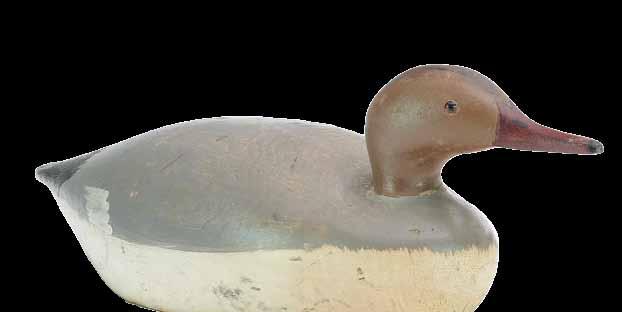
Provenance: Ted and Judy Harmon collection. (10,000 - 15,000)
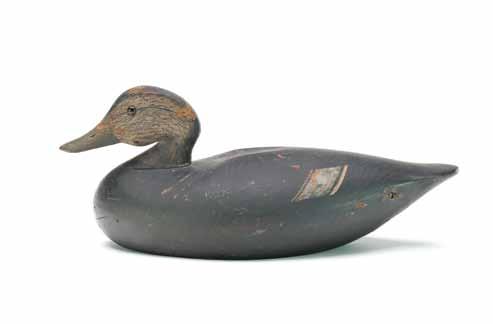
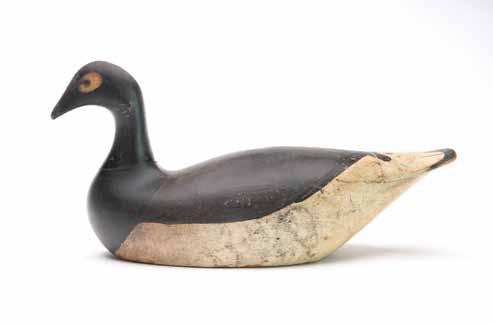

267 Joseph Lincoln (1859-1938), Accord, Massachusetts. Stylized black duck. Ice groove carved at back of neck. Well executed head carving has deep jowl and is reared back. 18” long. Strong original paint; crack in one side of back and typical Lincoln crack in underside; rough area at one side of tail; some paint flaking in both body and head where wood is exposed.
Literature: “New England Decoys” by Shirley and John Delph, page 98, exact decoy pictured. (5,000 - 8,000)
268 Frank Richardson, Oak Bluffs, Martha’s Vineyard. Important brant with brass tack eyes and inlet tail. Stanley Murphy collection ink stamp on underside. Measures 18.75” long. Original paint with moderate wear; surface has darkened slightly with age; paint around tack eyes has faded to bare wood; filler above brass screws on original inlet tail has flaked away.
Provenance: Martin and Deborah Maloy collection.
Literature: “Martha’s Vineyard Decoys” by Stanley Murphy, page 94, exact decoy pictured. (1,200 - 1,800)
269 Unknown maker, Massachusetts, circa 1900. Pair of red-breasted mergansers in slightly forward head pose. Measure 17.5” long. Original paint with moderate flaking and wear; hairline crack in each neck otherwise very good structurally.
Provenance: Martin and Deborah Maloy collection. (3,000 - 5,000)
270 Unknown maker, Massachusetts, circa 1900. Pair of hollow carved long-tailed ducks. Attributed by Ted Harmon to Clarence Bailey. Measure 15.5” long. Dry original paint with moderate flaking and wear; flaking to neck filler; slight separation at each body seam.
Provenance: Ted and Judy Harmon collection. (3,000 - 5,000)
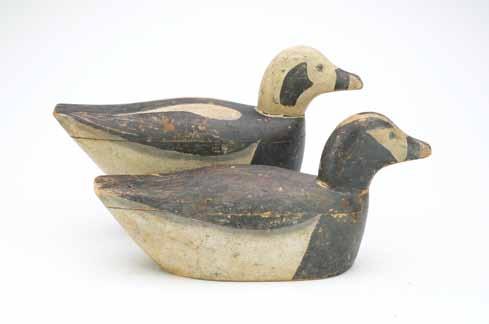
271 Keyes Chadwick (1865-1958), Oaks Bluff, Massachusetts. Early redhead hen with tucked head and round inlaid lead weight. Measures 16” long. Original paint with moderate flaking and wear; hit by shot in one side of body and head; one eye is missing.
Provenance: Ted and Judy Harmon collection. (2,000 - 3,000)
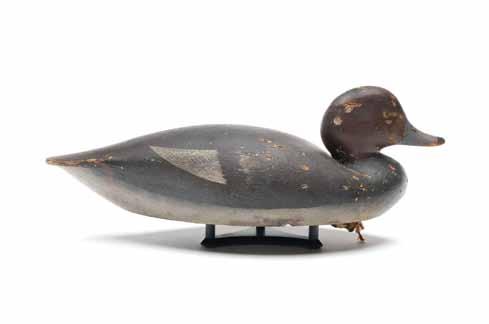
272 Unknown maker, Marble Head, Massachusetts, late 19th century. Merganser hen very similar to the work of Captain Samuel Fabens. Solid body with inlaid lead weight. Measures 17.75” long. Original paint with minor wear; protected under a coat of varnish that has darkened with age; scattered small dents; small spot of touchup on one upper side; tight crack through neck; bill is a professional replacement.
Provenance: Ted and Judy Harmon collection. (4,000 - 6,000)
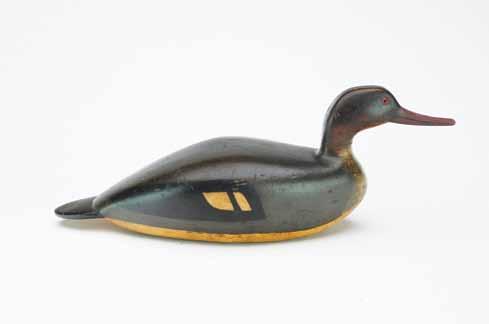
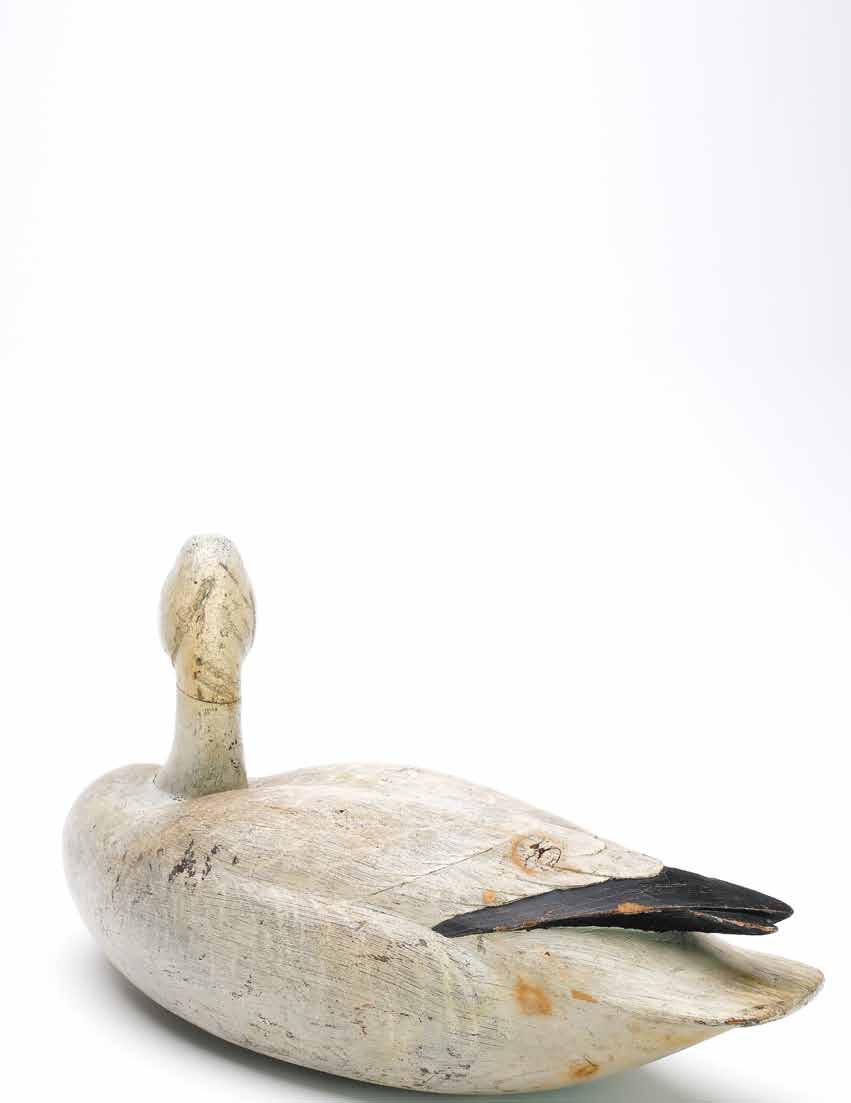
Reindahl’s parents, Nels (Nils) and Elsie, emigrated to Wisconsin from Norway in 1868 and began to raise their family. They had three sons, and a daughter with Enoch being their youngest child. Initially the father worked as a tenant farmer but eventually saved enough money to purchase his own farm in Dunkirk, a small, rural, agricultural suburb of nearby Stoughton. In 1915, the father built a home in Stoughton and Enoch graduated from high school there in 1921. The family maintained the farm in Dunkirk through the early 1940s and the young man worked alongside his father and brothers on the property.
As the years progressed, Stoughton evolved from a small town into a large urban center. This did not change Reindahl’s perception of the world, and he continued to live a simple, single life in the family home. He had a garden and apple trees where he grew much of his fruit and produce, he pumped his water from a well or rain barrels and lived without the luxury of indoor plumbing. He never drove a car and did not have a phone until the 1960s, and only then upon his doctor’s request.

He began to carve in the 1920s. Initially, he made his decoys exclusively for his own use but, over the years, a small number of close friends or acquaintances convinced him to produce a few birds for them. He was very friendly with his Stoughton neighbors, the Homme brothers, “Ferd” (1900 – 1963) and Mandt (1905 – 1964) and the three men undoubtedly traded carving and painting ideas with one another. Reindahl’s total output is estimated to only be about 100 decoys.
Frugal and resourceful, at one point c1952, he was hunting, and a large number of snow geese were seen overhead but they would not respond to his Canada goose decoys. That evening, he took three of the Canadas home, recarved their bills and repainted them as snows. It is unknown if he actually managed to harvest any of the large white birds the following day but, on a positive note, the decoy community can now enjoy a few limited examples of a very rare species by Reindahl.
He was never wealthy but remained a self-sufficient, independent, and proud individual who left a legacy of some of the very finest decoys ever to emerge from Wisconsin.

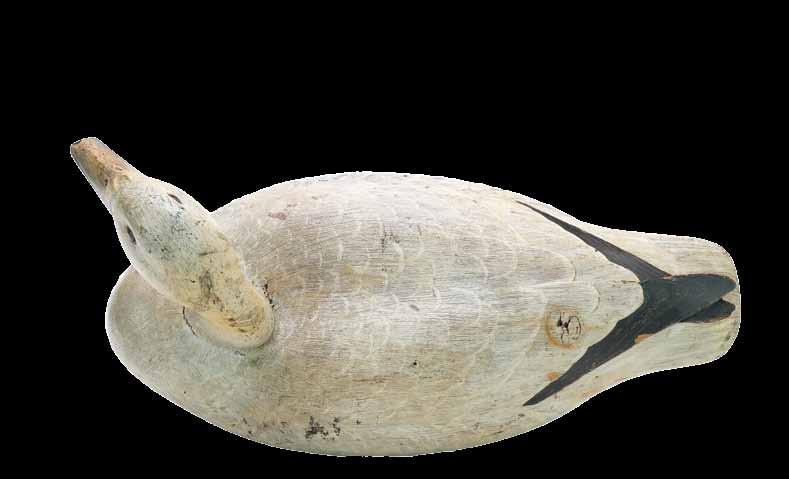
272A Enoch Reindahl (1904-2000), Stoughton, Wisconsin. Exceedingly rare snow goose. Hollow carved with slightly turned head and raised, crossed wingtips. Maker’s name painted on underside. One of only two known in this style. Measures 19” long. Originally made as a Canada goose and reworked by the maker for use as a snow goose; paint with moderate flaking and wear; slight separation at seam in neck and at neck seat; old chip in bill tip.
Provenance: Dr. Michael Shannahan collection. . Dr. Shannahan knew Reindahl personally and was an early collector of his work.
(25,000 - 35,000)
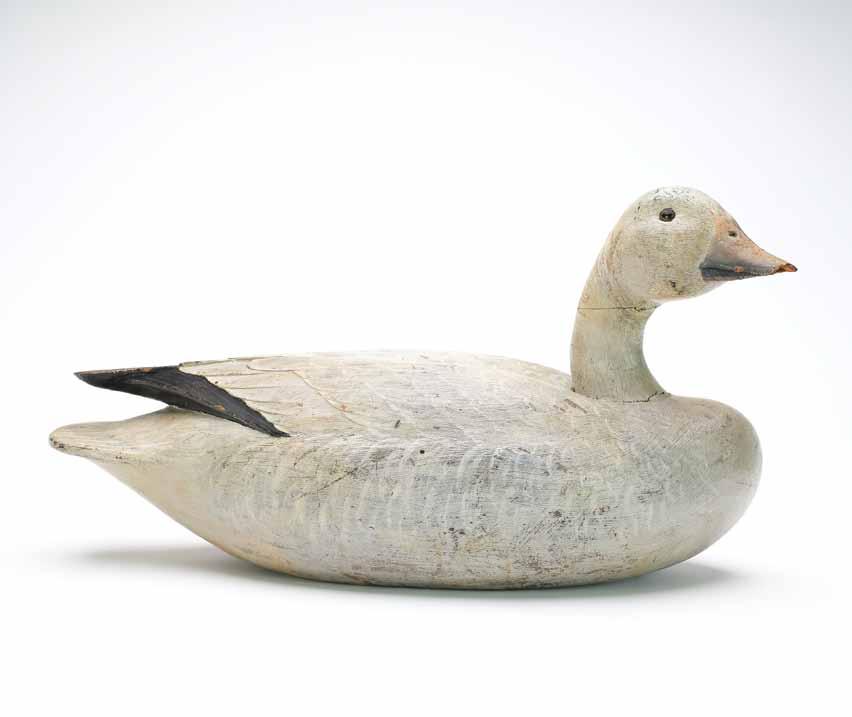
272B Enoch Reindahl (1904-2000), Stoughton, Wisconsin. Excellent rigmate pair of mallards. Hollow carved with slightly turned and tucked heads. Relief wing carving with raised, crossed wingtips. Maker’s name painted on undersides. Measure 14.75” long. Original paint with minor gunning wear; under an early coat of varnish that has darkened with age; two small spots of touchup on one side of drake’s head.
Provenance: Dr. Michael Shannahan collection. Dr. Shannahan knew Reindahl personally and was an early collector of his work. (30,000 - 50,000)
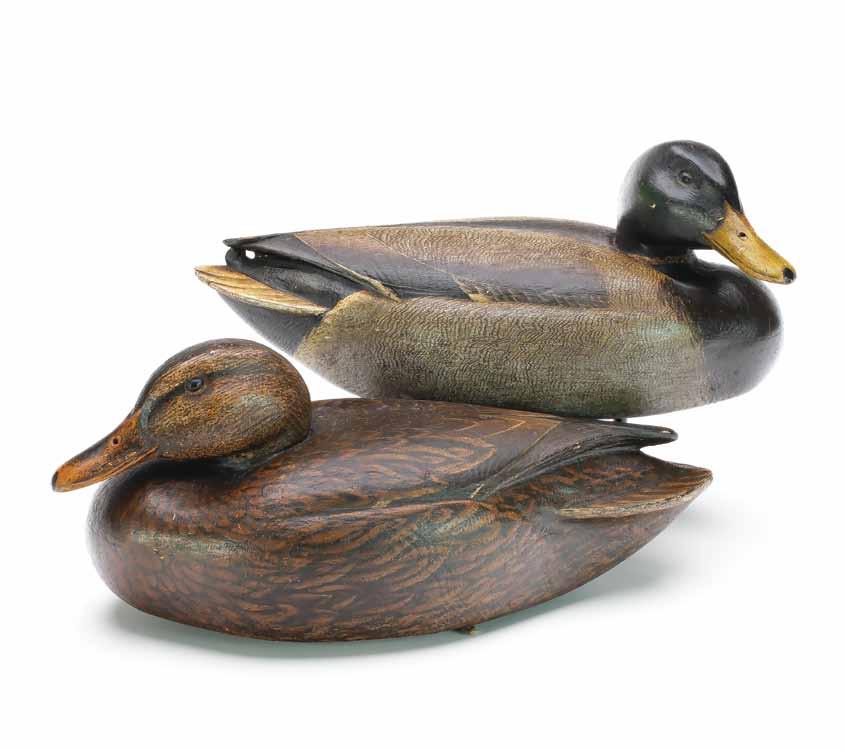
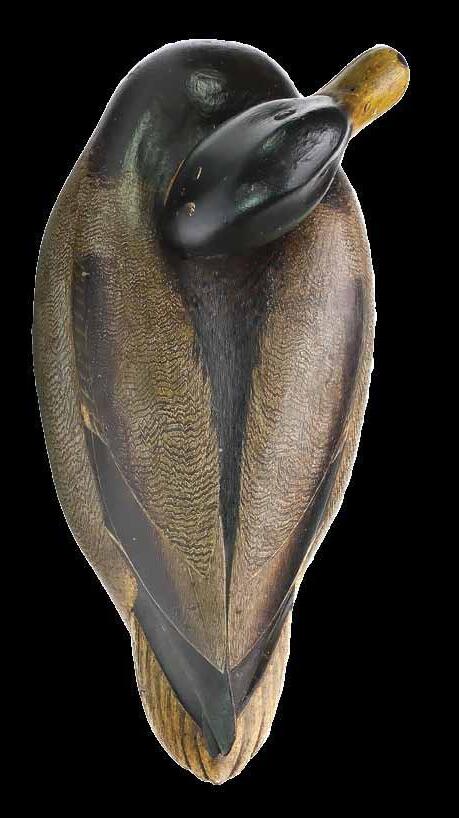
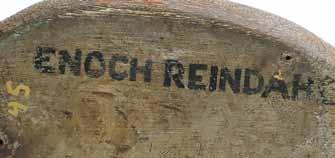


272C Enoch Reindahl (1904-2000), Stoughton, Wisconsin. Mallard with slightly turned head and relief wingtip carving. Measures 15.75” long. Original paint with minor gunning wear; tight crazing on head with some touch up on each side; split in underside was filled and touched up.
Provenance: Dr. Michael Shannahan collection. Dr. Shannahan knew Reindahl personally and was an early collector of his work. (6,000 - 9,000)

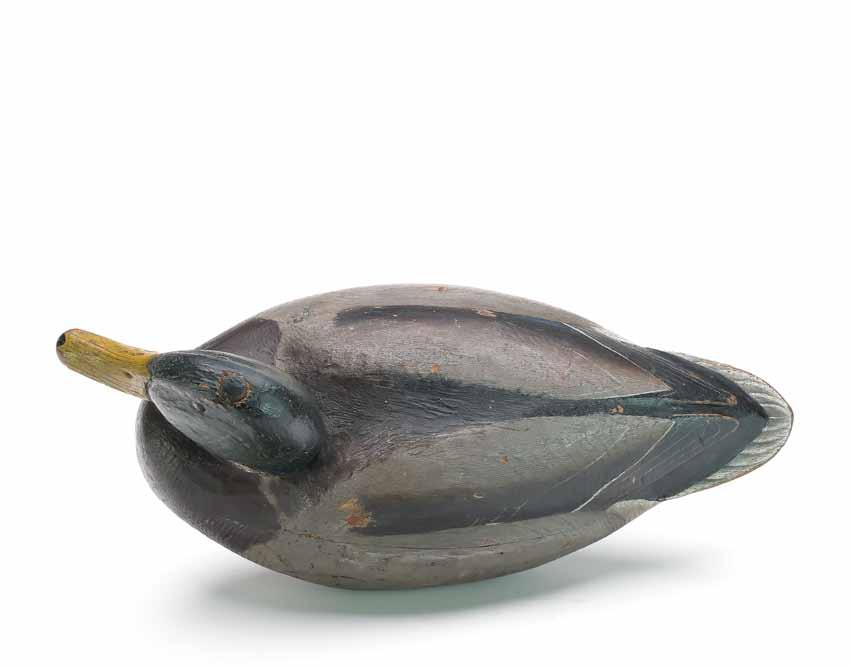
272D Owen Gromme (1896-1991), Milwaukee, Wisconsin. Rigmate pair of bluebills with deep relief wing carving. Measure 12” and 13” long. Original paint with moderate flaking and wear; some strengthening to black on drake and brown of hen; separation at wood grain on top of hen’s head, with a small nail added.
Provenance: Dr. Michael Shannahan collection. (4,000 - 6,000)
272E Ferd Homme (1901-1963)
Stoughton, Wisconsin. Hollow carved bluebill with head turned almost 90 degrees. Relief carved, crossed wingtips and comb feather paint detail. Measures 11.25” long. Original paint with moderate discoloration from an early coat of varnish; some touchup to black areas; filler and touchup at body seam; hairline crack in each eye and along one side of bill.
Provenance: Dr. Michael Shannahan collection. (2,000 - 3,000)
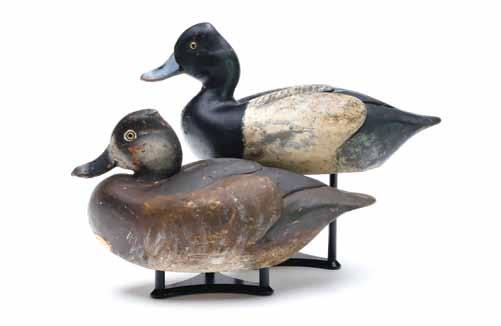

272F John Beisenstein (1887-1978), Neenah, Wisconsin. Rare pair of bluewing teal, circa 1920. Incised bill carving and tack eyes. Measure 12.5” long. Original paint with minor wear; an appealing crazed surface on both; hairline crack around neck seat of drake; otherwise very good structurally.
Literature: “Decoys of the Winnebago Lakes” by Ronald M. Koch, page 23, exact decoy pictured. (2,000 - 3,000)

1888 - 1945 | Alexandria Bay, New York
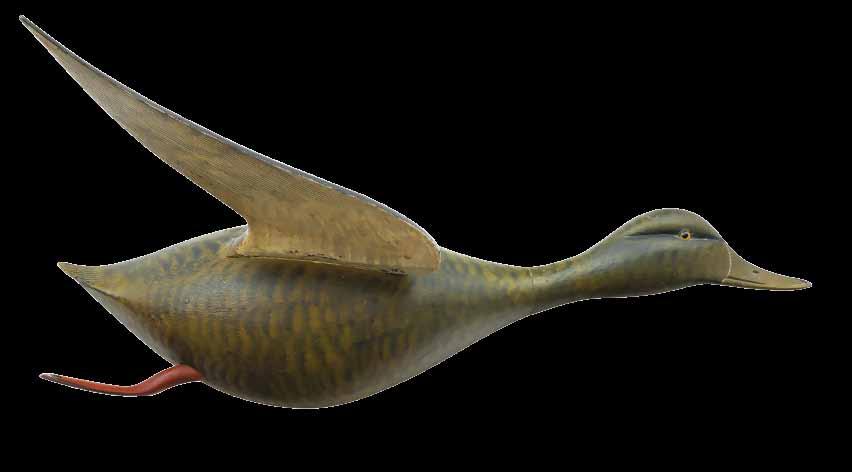
273
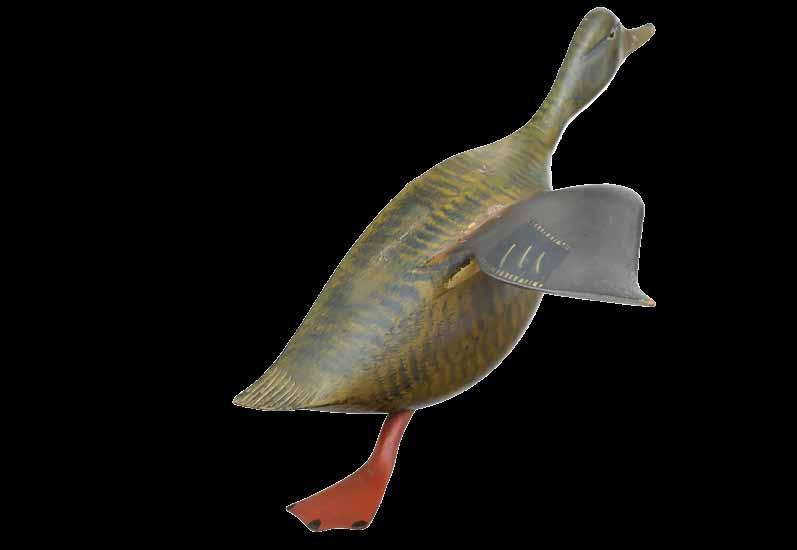
Chauncey Wheeler (1888-1945), Alexandria Bay, New York. Excellent pair of flying mallard wall plaques. Applied wings and feet. Comb feather paint detail on tops of wings. Measure 22” long. Original paint under an early coat of varnish that has darkened with age; some flaking to filler where wings attach to body.
Provenance: Dean Hyde collection. (15,000 - 25,000)
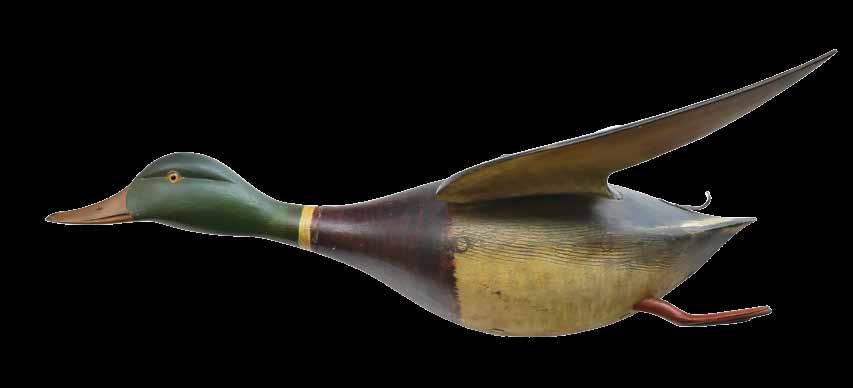
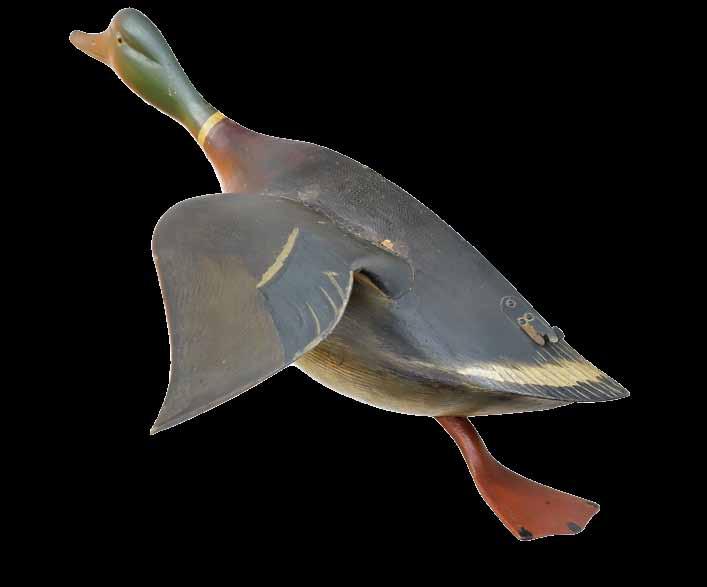
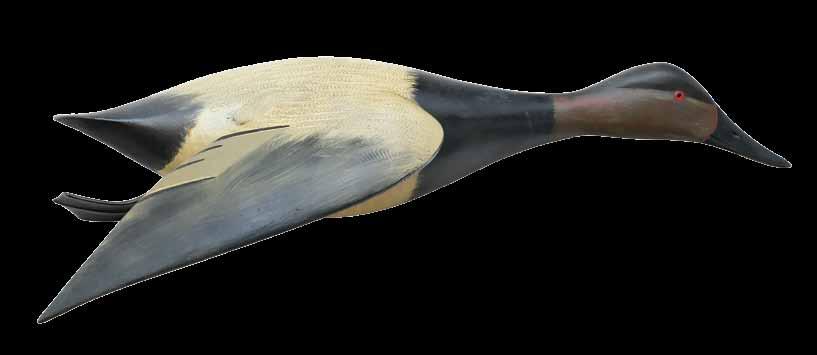
274
Chauncey Wheeler (1888-1945), Alexandria Bay, New York. Flying canvasback wall plaque. With applied wing and foot. Comb feather paint detail on back and wing. Measures 22” long. Original paint under an early coat of varnish that has darkened with age; very good structurally.
Provenance: Dean Hyde collection. (12,000 - 18,000)
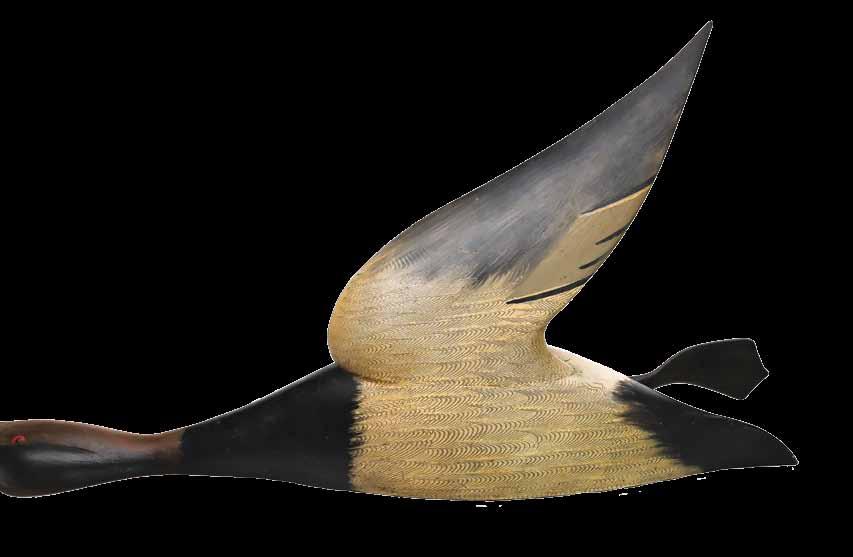
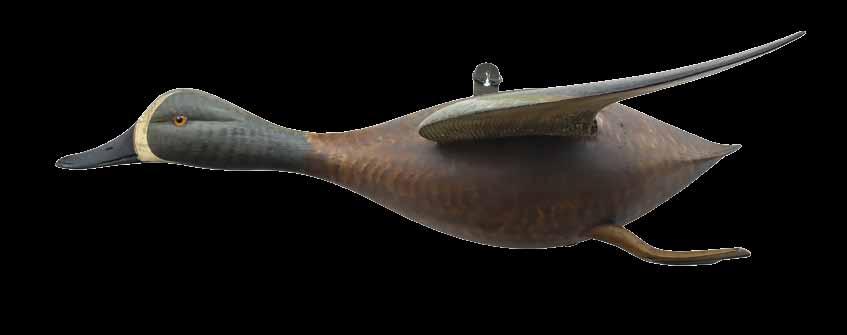
275 Chauncey Wheeler (1888-1945), Alexandria Bay, New York. Flying bluewing teal wall plaque with applied wing and foot. Scratch feather paint detail on underside of wing. Measures 18” long. Original paint under an early coat of varnish; some flaking to filler were wing attaches to body; otherwise very good structurally.
Provenance: Dean Hyde collection. (8,000 - 12,000)
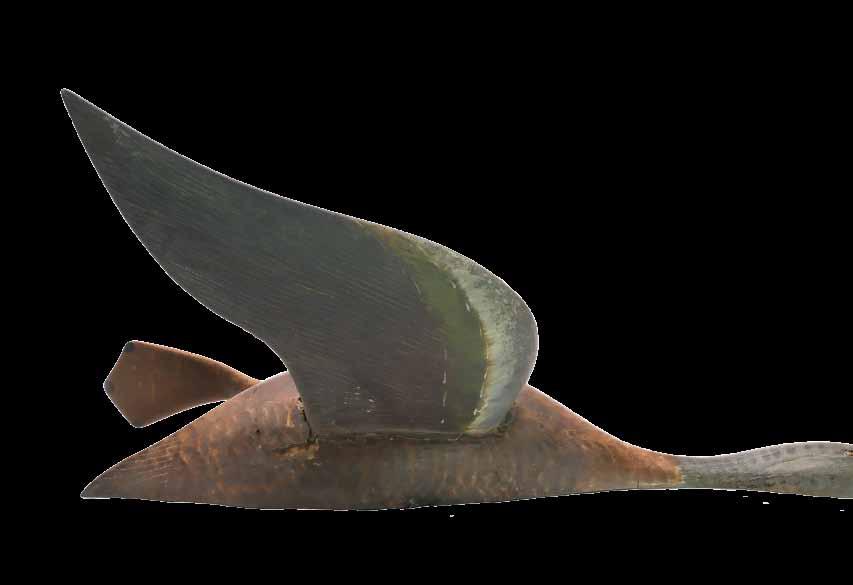


276 Chauncey Wheeler (1888-1945), Alexandria Bay, New York. Extremely rare pair of miniature canvasbacks. Relief wing and feather carving. Measure 10.5” long. Original paint protected under an early coat of varnish; that has darkened with age; the black paint on both bills was done after the varnish layer.
Provenance: Dean Hyde collection. (6,000 - 9,000)
277 Chauncey Wheeler (1888-1945), Alexandria Bay, New York. Rigmate pair of bluebills, 1st quarter 20th century. With triangle brand and “J.J.R.” stamped in underside. Drake has quality comb painting on sides and back. Measure 16” long. Drake has original paint with light gunning wear; rough edge one side of bill; some small rubs; small area of discoloration on two small areas at side of head; hen has original paint with a few shot scars, rubs, and light gunning wear; right eye is missing.
Provenance: Chris Pitman collection. (3,500 - 4,500)
278 Chauncey Wheeler (1888-1945), Alexandria Bay, New York. Black duck. Measures 17.5” long. Original paint with very minor wear; slight separation at neck seat; flaking at a hairline crack in breast.
Provenance: Dean Hyde collection. (3,000 - 4,000)
279 Chauncey Wheeler (1888-1945), Alexandria Bay, New York. Large canvasback with comb feather paint detail. Stamped “FCD” four times on underside. Measures 19.25” long. Original paint with moderate wear; under a thin coat of varnish that has darkened with age; hairline crack along back and a drying split along one side; minor blunting at tip of tail.
Provenance: Dean Hyde collection. (2,000 - 3,000)
280 Chauncey Wheeler (1888-1945), Alexandria Bay, New York. Bluebill hen. Measures 17” long. Original paint with minor gunning wear; lightly hit by shot; slight separation at seam on underside where a separate piece of wood was used in the making along one lower side.
Provenance: Dean Hyde collection. (2,000 - 3,000)
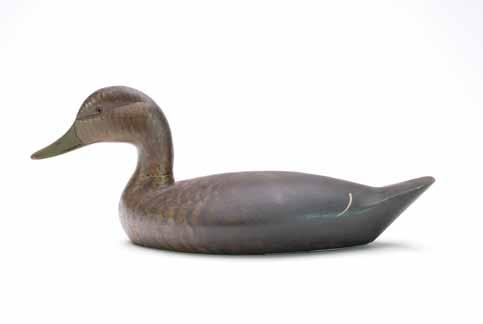
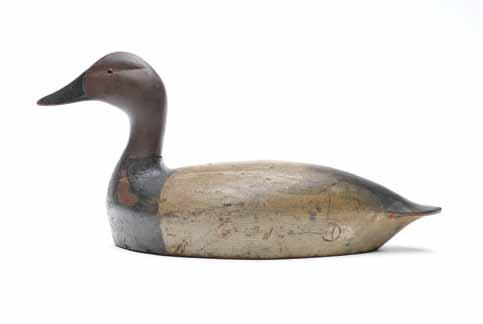
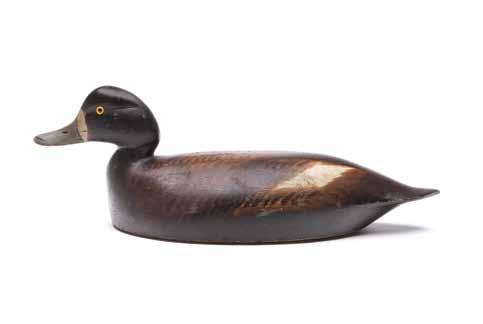
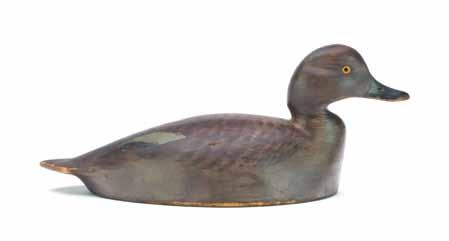
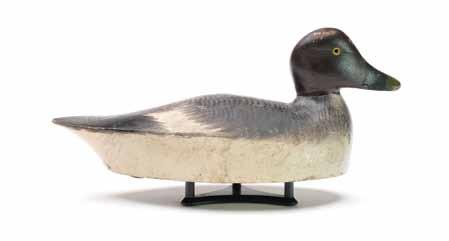
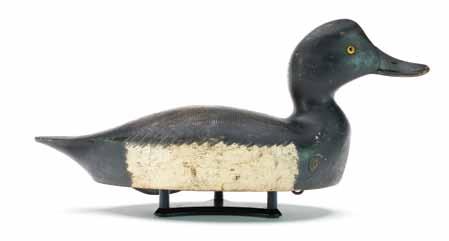
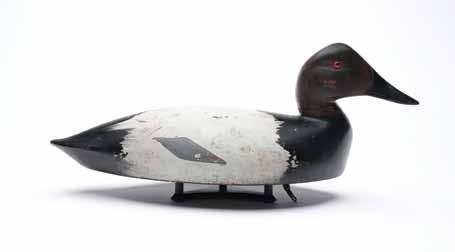
281 Chauncey Wheeler (1888-1945), Alexandria Bay, New York. Redhead hen. Measures 14.5” long. Original paint with minor wear; mostly around lower edge of body, tail, and bill; filled drying crack along the back and breast that has opened slightly appears to have been from when the decoy was made.
Provenance: Bill and Alice Walsh Collection. Obtained at Bourne Auction in Monterey, CA, August 1988 #118.
(1,500 - 2,500)
282 Gus Rogers (1892-1938), Alexandria Bay, New York. Goldeneye hen from the Triangle rig. Red triangle painted on underside. Measure 14.25” long. Original paint with minor to moderate wear; tight cracks in neck.
Provenance: Chris Pitman collection. (800 - 1,200)
283 Gus Rogers (1892-1938), Alexandria Bay, New York. Bluebill drake, 1st quarter 20th century. Strong comb painting. Copper tag on underside reads “Donald B Baxter, Syracuse New York.” . Measures 15” long. Excellent original paint; light gunning wear; rubs mostly at head and tail.
Provenance: Dean Hyde collection. (1,800 - 2,200)
284 Sam Denny (1874-1953) Alexandria Bay, New York. Canvasback. “OLS” painted on underside. Measures 16.75” long. Original paint with minor to moderate wear; lightly hit by shot; minor blunt at tip of tail.
Provenance: Bill and Alice Walsh Collection. Bought at Bourne Auction, July 1987. (800 - 1,200)
285 Chauncey Wheeler (1888-1945), Alexandria Bay, New York. Black duck. Measures 18” long. Original paint with minor gunning wear; lightly hit by shot; professional tail chip repair; small amount of touchup at neck seat.
Provenance: Bill and Alice Walsh Collection. Bought from RJG Antiques at Chicago Show, April 1988. (1,500 - 2,500)
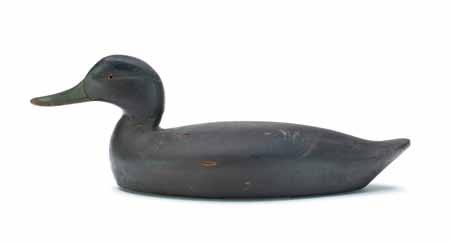
286 Roy Conklin (1909-1967) attributed, Alexandria Bay, New York. Early working bluebill with slightly turned and raised head pose. Appealing comb feather paint detail. From the rig of Donald Baxter, with metal rig tag on underside. Measures 16” long. Original paint with minor gunning wear; lightly hit by shot; some flaking at one side of neck seat was filled and touched up.
Provenance: Bill and Alice Walsh Collection. Obtained at the Richard W. Oliver auction, Lot 270, July 1988.
(1,000 - 1,500)
287 Sam Denny (1874-1953) Alexandria Bay, New York. Black duck. “Montroy” painted on underside. Measures 17.25” long. Original paint with minor wear; lightly hit by shot; tiny chip in one side of tail; small amount of restoration near each eye.
Provenance: Dean Hyde collection. (1,000 - 1,400)
288 Gus Rogers (1892-1938), Alexandria Bay, New York. Bluebill hen with slightly raised and turned head. Measures 15.5” long. Original paint with very minor wear; tiny spot of touchup on one side; decoy was never rigged or weighted.
Provenance: Dean Hyde collection. (1,500 - 2,500)
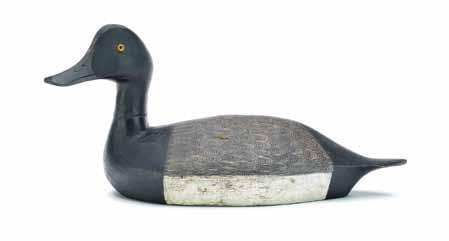

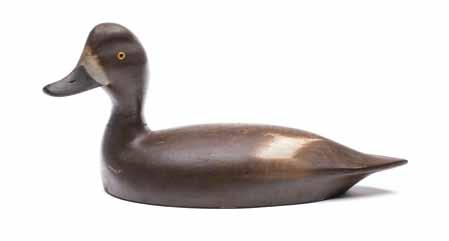
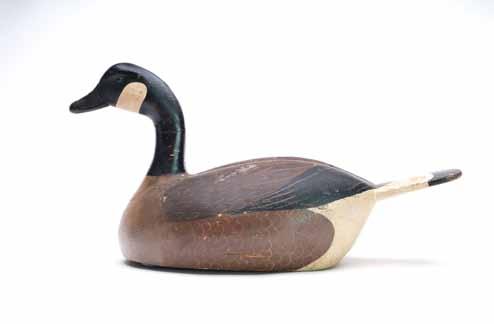
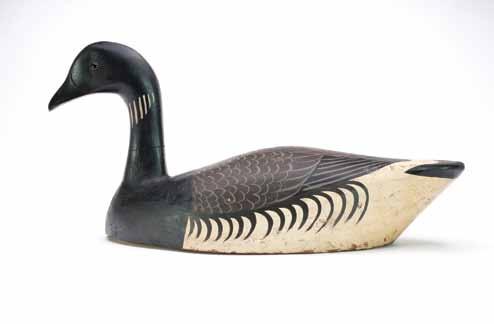

289 Roy Conklin, Alexandria Bay, New York. Canada goose with inlet neck seat and long paddle tail. Measures 21.5” long. Mix of original and early in use repaint with moderate flaking and wear; small dents and shot marks; tight drying cracks in body; repaired crack through neck with some flaking to filler.
Provenance: Martin and Deborah Maloy collection.
Literature: “Decoys: A North American Survey” by Gene and Linda Kangas, page 162, exact decoy pictured. (1,500 - 2,500)
290 Roy Conklin (1909-1967), Alexandria Bay, New York. Large working brant. Measures 22.75” long. Original paint with minor flaking and wear; a few shot strikes; hairline crack at one side of raised neck seat; tight crack in upper part of neck was reset long ago.
Provenance: Dean Hyde collection. (1,000 - 1,400)
291 Roy Conklin (1909-1967), Alexandria Bay, New York. Rare pair of cinnamon teal. Measure 13” and 13.5” long. Shallow dent in one side of drake’s breast, otherwise excellent and original.
Provenance: Dean Hyde collection. (1,200 - 1,800)
292 Roy Conklin (1909-1967), Alexandria Bay, New York. Rare owl on perch. Stands 10” tall. Very good and original.
Provenance: Dean Hyde collection. (800 - 1,200)
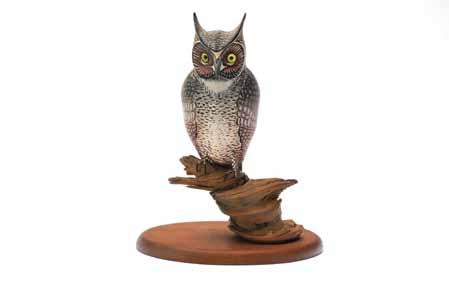
293 Roy Conklin (1909-1967), Alexandria Bay, New York. Decorative gull with relief wingtip carving and deep eye grooves. Identified and signed on underside of base. Measures 16” long, stands 12.75” tall. Tight cracks in paint along each lower side; otherwise excellent and original.
Provenance: Dean Hyde collection. (800 - 1,200)
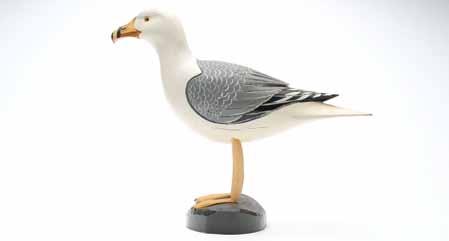
294 Roy Conklin (1909-1967), Alexandria Bay, New York. 1/3 size flying bluebill on plaque. “Roy Conklin WB Aiken 1951” written on back of plaque. Plaque measures 11.5” long. Excellent and original.
Provenance: Dean Hyde collection. (500 - 800)
295 Roy Conklin (1909-1967), Alexandria Bay, New York. Miniature flying eagle. With outstretched legs and open talons. “RAC” in pencil on underside. Measures 5.75” long, stands 6.75” tall. Original paint with minor wear on base; chip in one side of tail was professionally restored.
Provenance: Dean Hyde collection. (600 - 900)
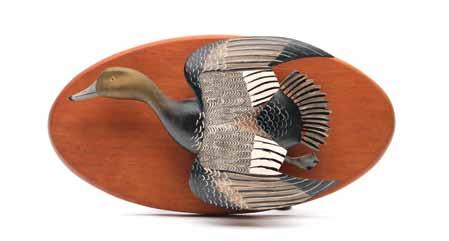
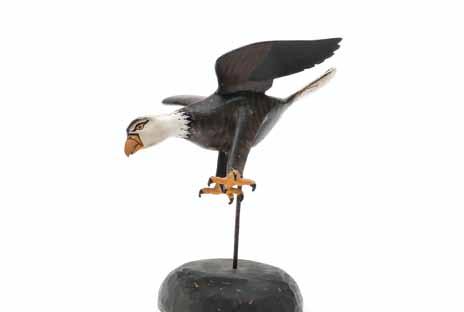
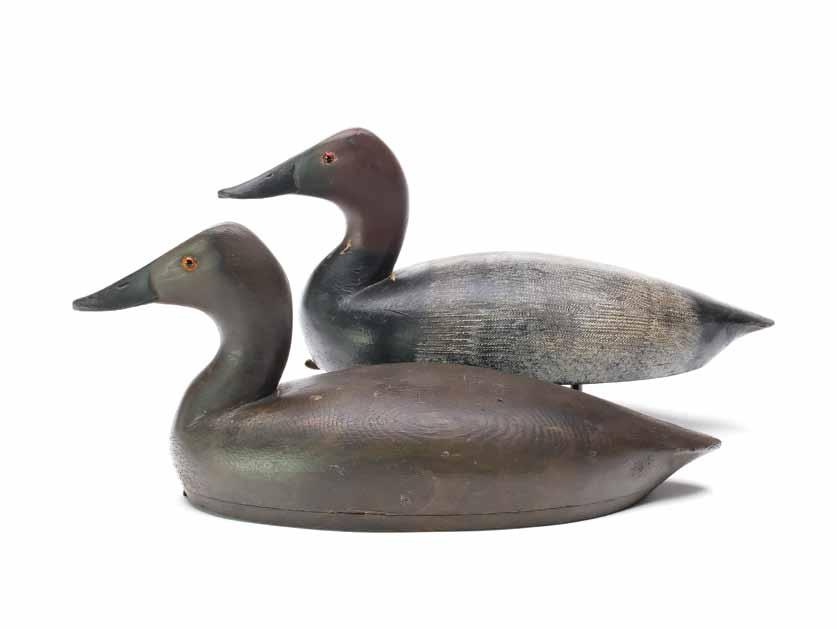
296 Thomas Chambers (1860-1948), Toronto, Ontario. Pair of hollow carved canvasbacks. Long body style with fine comb feather paint detail. Measure 17” long. Original paint with minor flaking and wear; a few spots where filler has flaked on drake’s body; one of hen’s eyes is a professional replacement.
Provenance: Dean Hyde collection.
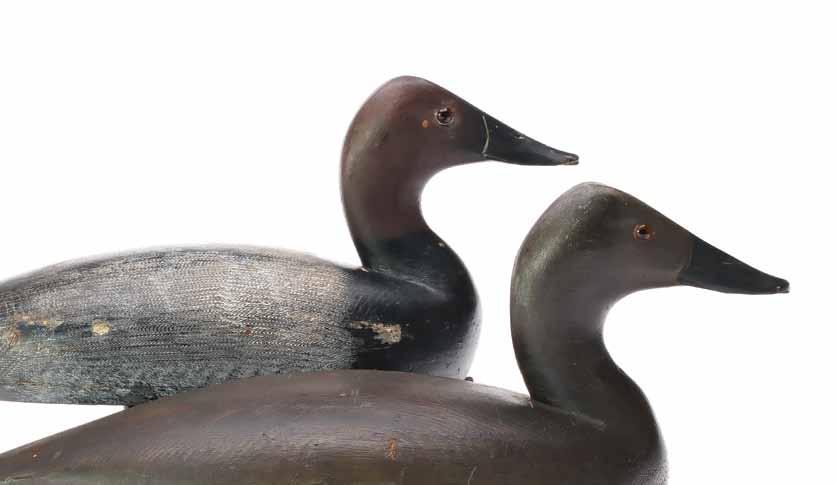
(8,000 - 12,000)
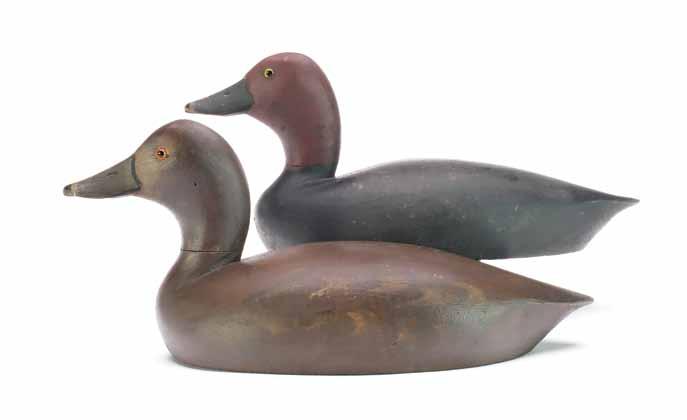
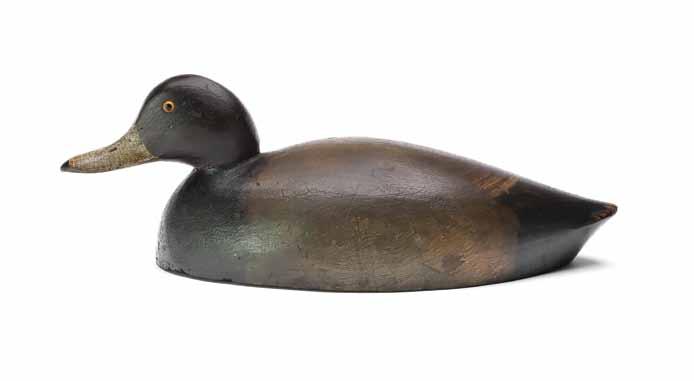
297 Thomas Chambers (1860-1948), Toronto, Ontario. Pair of hollow carved redheads. “AH Buhl” branded in undersides. Measures 15.75” long. Original paint with minor wear; tight crack in one side of hen’s neck seat.
Provenance: Dean Hyde collection. (3,000 - 5,000)
298 George Warin (1830-1904), Toronto, Ontario. Solid body redhead. Branded “FH Walker”, “AH Buhl”, and “Hendrie” on underside. Measures 14.75” long. Original paint with minor crazing under a thick coat of varnish; filled defect in wood on one side of back from when the decoy was made; slight separation at neck seat.
Provenance: Dean Hyde collection. (1,500 - 2,500)
299
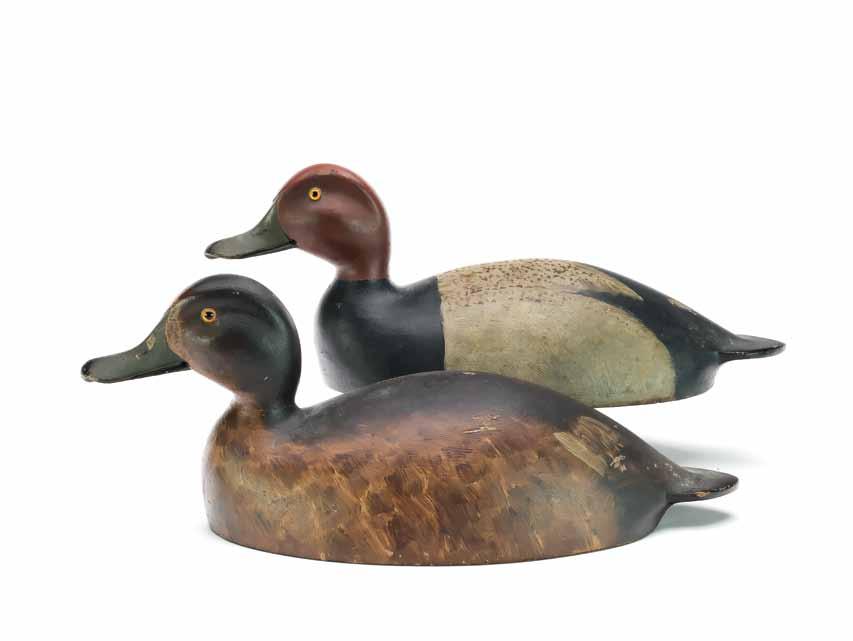
Unknown maker, Markham, Ontario, circa 1900. Pair of redheads from the Markham rig. Thinly hollowed with .25” bottom boards. Excellent head carving with wide bills. Decoys were never rigged or weighted. Measure 16.5” long. Original paint with scattered rubs and minor flaking; under a thin coat of varnish; excellent structurally.
Provenance: Dean Hyde collection. (12,000 - 16,000)

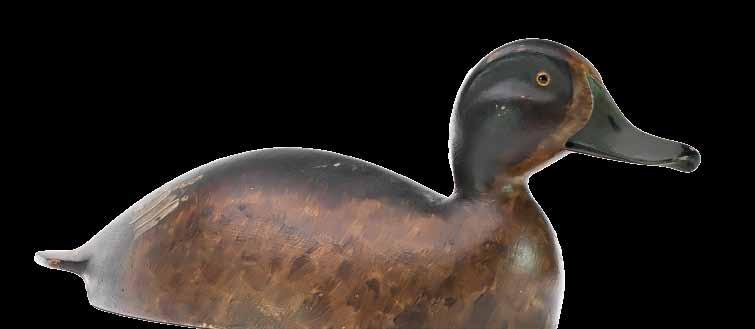
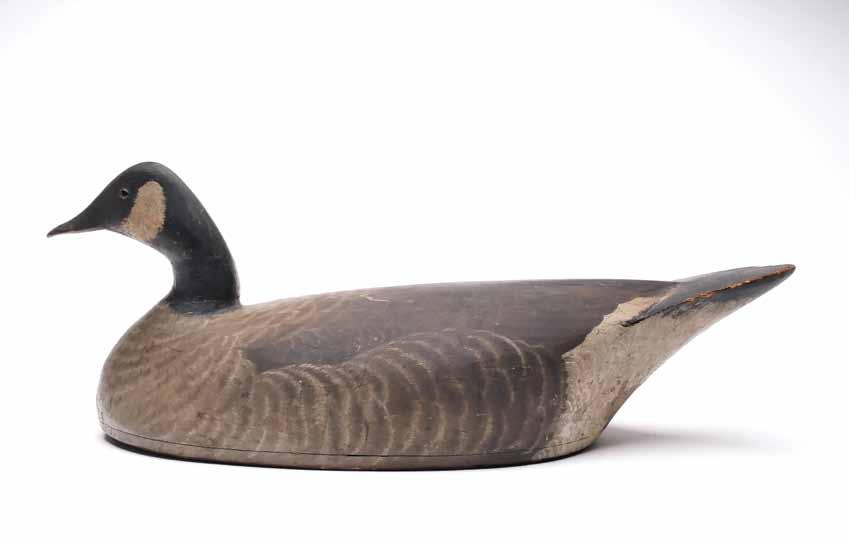
300 George Warin (1830-1904), Toronto, Ontario. Hollow carved Canada goose with .5” bottom board. “MCC” stamped in underside. Measures 24.25” long. Original paint with moderate flaking and wear; chip in tail; chip in bill and a crack through neck were professionally restored; drying cracks along one side and underside of tail area.
Provenance: Dean Hyde collection.
(6,000 - 9,000)
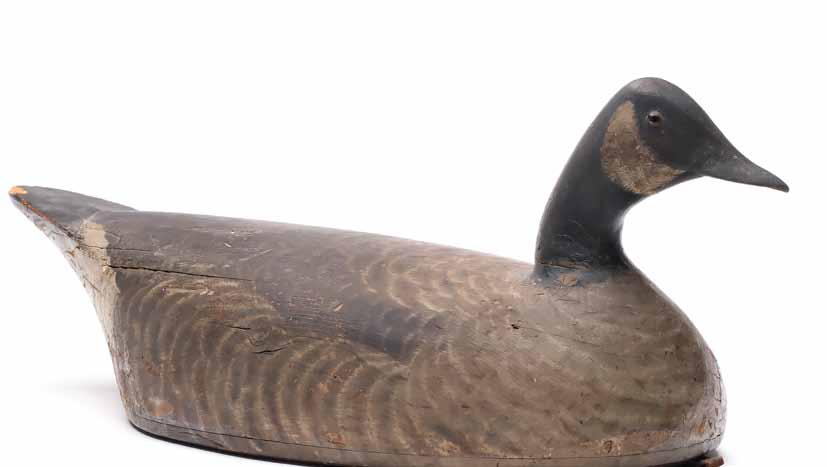
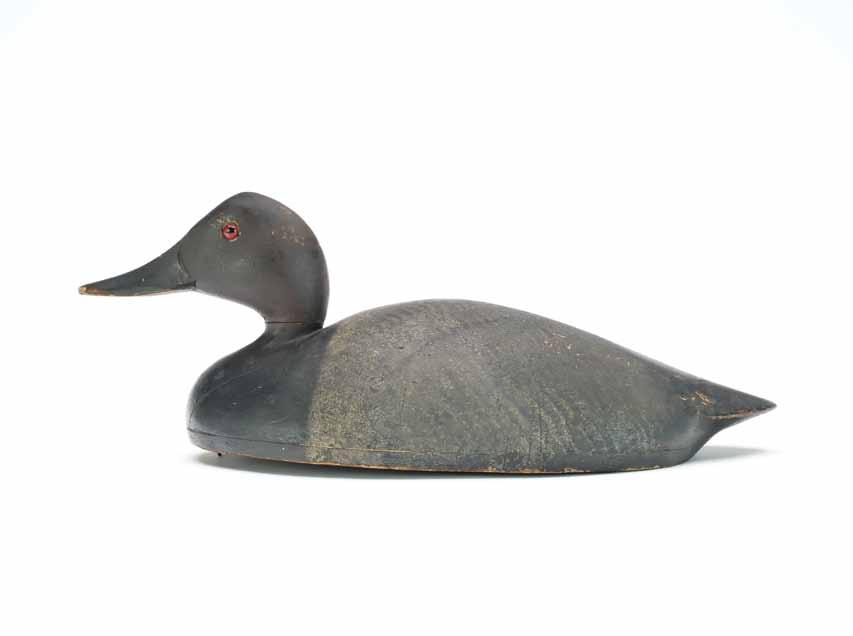
300A John R. Wells (1861-1953), Toronto, Ontario. Hollow carved canvasback. Branded “Meredith” and “H.N.T.” on underside. Measures 15.75” long. Original paint with minor to moderate flaking and wear; lightly hit by shot; hairline crack in one side of neck seat and in breast; tin wash of paint on parts of head.
Provenance: Dean Hyde collection. (4,000 - 6,000)

300B Unknown maker, Toronto Harbor, late 19th century. Black bellied plover with iron legs. Measures 11.75” long. Original paint with minor wear; under a thick coat of varnish that has darkened with age; flaking at each gesso thigh with some touchup in that area.
Provenance: Dean Hyde collection.
(3,000 - 5,000)
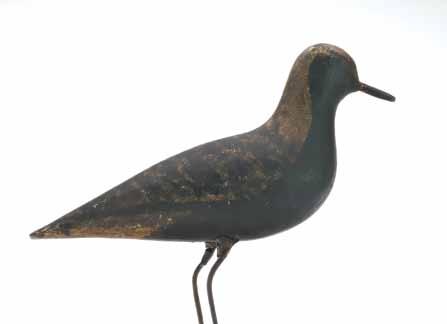
300C Unknown maker, Toronto Harbor, late 19th century. Yellowlegs with tack eyes and iron legs. Scratch feather paint detail on head and neck. Measures 13.25” long. A wash of brown paint was cleaned off of much of the decoy, with some remaining; a coat of varnish has darkened with age; bill is a professional replacement.
Provenance: Dean Hyde collection.
(2,000 - 4,000)
300D Unknown maker, Toronto Harbor, late 19th century. Black bellied plover with metal legs. Slightly flat sided. Measures 10” long. Original paint with very minor wear; lightly hit by shot; area of roughness on top of head; surface has darkened with age.
Provenance: Dean Hyde collection.
(2,000 - 3,000)
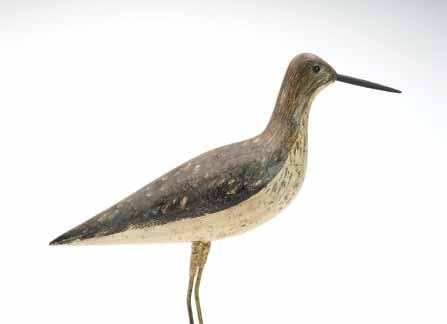
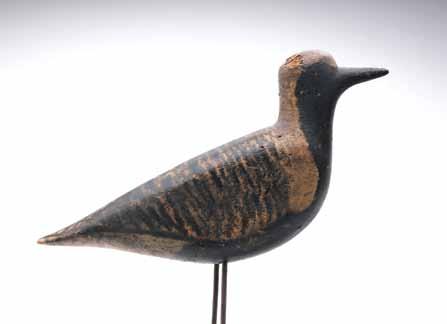
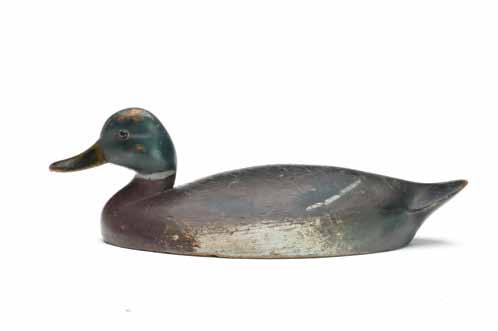
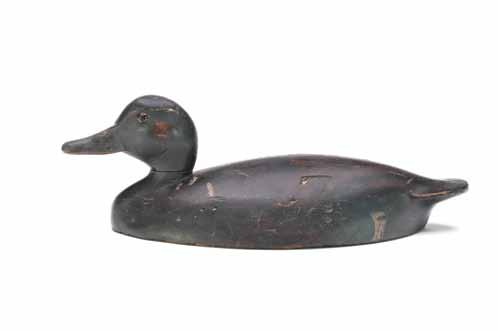
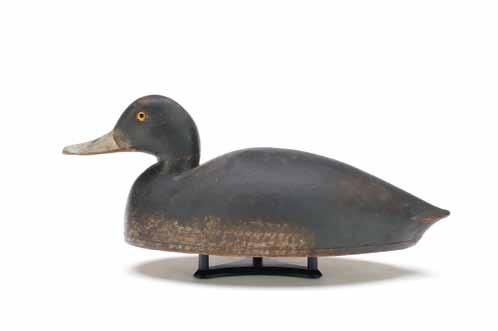
301 John R. Wells (1861-1953), Toronto, Ontario. Mallard drake. Thinly carved hollow body with bottom board. Fine scratch painting over back. Raised neck seat and upswept tail. Original paint with some rubs and small dents; small tight crack near neck seat; bill has a varnish over 3/4 of it that floresces orange under uv light but is structurally sound.
(3,500 - 4,500)
302
Unknown maker, Toronto, Ontario, circa 1900. Rare greenwing teal hen similar to the work of John R. Wells. Solid body with glass eyes. Kangas and TL7 branded in underside. Measures 12” long. Original paint with moderate wear; under a thin coat of varnish; professional tail and bill chip repairs; chip in top of head was restored; many dent and shot marks.
Provenance: Bill and Alice Walsh Collection. Bought from Kangas’ July 1986. (1,200 - 1,800)
303 George Warin (1830-1904), Toronto, Ontario. Hollow carved bluebill hen. Maker’s brand on underside. Measures 15” long. Mostly original paint with moderate flaking and wear; thin wash of paint added to areas of back and head; hairline crack on one side of neck seat; touchup to one side of bill tip.
Provenance: Dean Hyde collection. (1,500 - 2,500)
304 Unknown maker, Markham, Ontario, circa 1900. Hollow carved bluebill hen from the Markham rig. Wide bill carving. Measures 14.75” long. Original paint with minor flaking and a few small dents; a few spots where the wet paint was rubbed; typical of this rig; fine hairline crack extends from eyes around back of head.
Provenance: Dean Hyde collection.
(4,000 - 6,000)
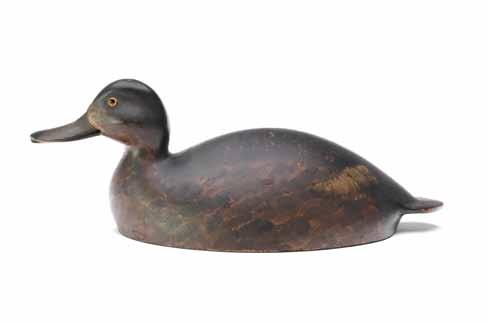
305 Thomas Chambers (1860-1948), Toronto, Ontario. Hollow carved redhead with .25” bottom board. Branded “B.S. Warren”. Used at the St. Clarir Flats Club. Measures 16” long. Original paint with minor to moderate wear; an early coat of crazed varnish has darkened with age; lightly hit by shot; otherwise excellent structurally.
(1,750 - 2,250)
306 Unknown maker, Toronto, Ontario, circa 1900. Thinly hollowed black duck. Similar to the work of J.R. Wells. Measures 17.25” long. Original paint with moderate flaking and wear; under a thick coat of varnish; old chip in each side of tail with touchup; small chip and minor roughness on edge of bill.
Provenance: Martin and Deborah Maloy collection. (800 - 1,200)

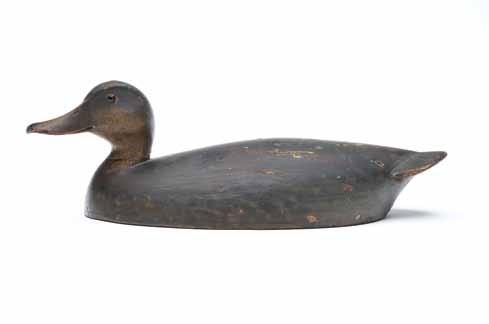
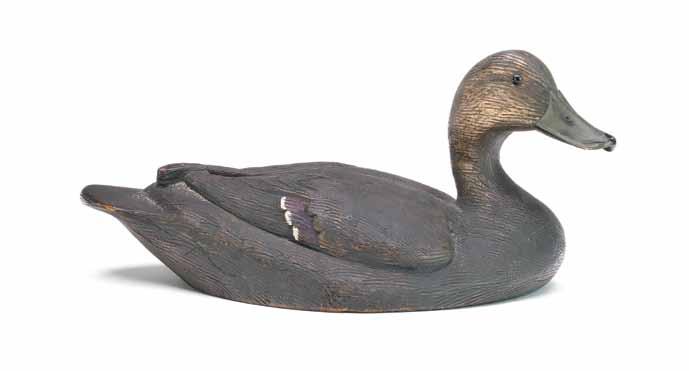
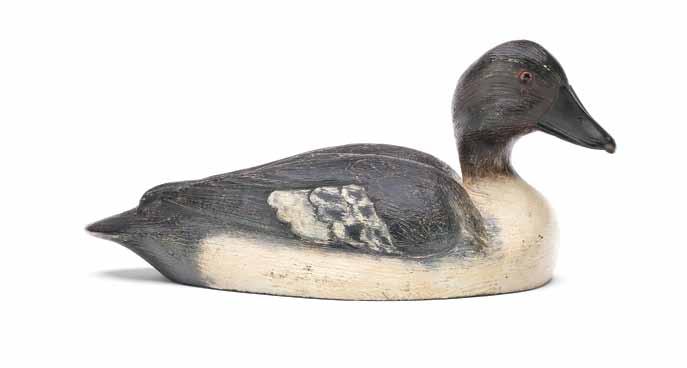
307 Bud Tully (1918-1973), Peterborough, Ontario. Excellent black duck with slightly turned head and deep relief wing carving. Hollowed from the underside. Two large bore holes. Measures 15.25” long. Original paint with very minor wear; a crack in bill was tightly reset with a nail from the underside.
Provenance: Dean Hyde collection. (4,000 - 6,000)
308 Bud Tully (1918-1973), Peterborough, Ontario. Goldeneye hen with deep relief wing carving. Crossed wingtips and slightly turned head. Hollowed from the underside with two large bore holes.
“J.D.Tully” carved in underside. Measures 12.5” long. Original paint with very minor wear; an early coat of varnish has darkened slightly with age.
Provenance: Dean Hyde collection. (2,000 - 3,000)
309 Bud Tully (1918-1973), Peterborough, Ontario. Very rare pair of miniature goldeneye. Slightly turned heads and deep relief wing carving. Feather rasping on heads and body. Bodies are hollowed from the underside with bore holes. Measure 7” long. Drake’s bill was cracked down and tightly reset with some touchup to that area; otherwise both are excellent.
Provenance: Dean Hyde collection. (2,500 - 3,500)
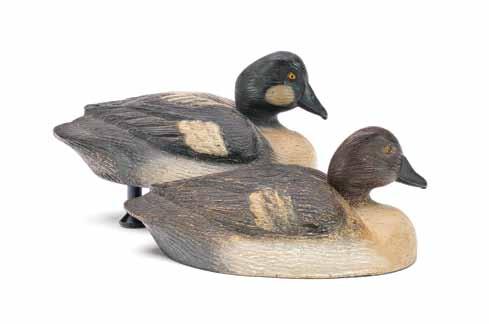
310 Buck Crawford (1897-1958), Smiths Falls, Ontario. Hollow carved redhead with slightly turned head and relief wing carving. Measures 13.5” long. Original paint with moderate wear under an early coat of varnish that has darkened with age; crack through neck secured with two old nails; minor roughness on edge of bill.
Provenance: Dean Hyde collection. (1,200 - 1,800)
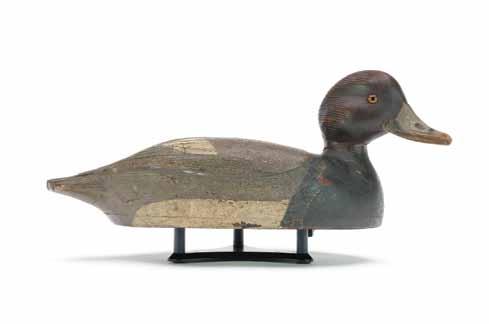
311 William Buck Crawford (18971958), Smith Falls, Ontario. Hollow carved bluebill with slightly turned head and relief wing feather carving. “WJC” branded on underside. “PN” branded backwards on underside. Measures 13” long. Original paint with moderate wear under a thick coat of varnish; lightly hit by shot; hairline crack in one side of neck seat.
Provenance: Martin and Deborah Maloy collection. (700 - 1,000)
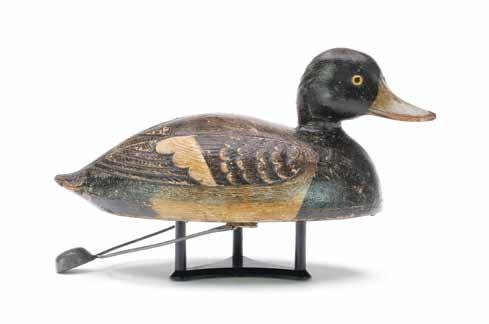

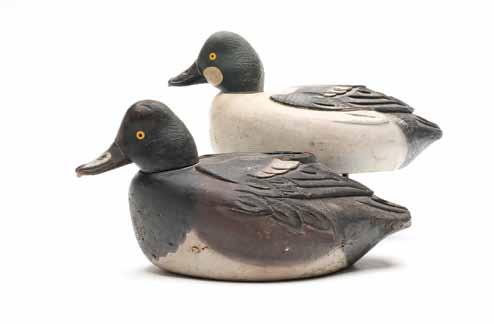

312 Orel Leboeuf, (1886-1968), St. Anicet, Quebec. Rigmate pair of bluebills. Deep relief wing and tail feather carving. Measure 15.25” long. Tight crack along the back of drake’s neck and a small chip on one side of neck seat; otherwise very good and original.
Provenance: Dean Hyde collection. (3,000 - 4,000)
313 Orel Leboeuf, (1886-1968), St. Anicet, Quebec. Pair of goldeneye with slightly turned heads and deep relief feather carving. Measures 14” long. Original paint with very minor wear; hairline drying cracks in each side; bill was cracked down and professionally reset with some touchup in that area.
Provenance: Bill and Alice Walsh Collection. Obtained from George Thompson at July, 1982 Bourne Auction.
(1,200 - 1,800)
314 Joseph Paquette, Verdun, Quebec. Excellent bluebill hen with slightly turned head and deep relief wing feather carving. “DD Andurand” branded on underside. 10 small bore holes drilled in underside and filled with cork. “DD” carved under tail and a single “D” carved in breast. Measures 13.25” long. Original paint with very minor wear; small drips of white paint on back; lightly hit by shot in one side.
Provenance: Bill and Alice Walsh Collection. Bought at Chicago JuliaGuyette Auction, April 1989 #660.
(1,200 - 1,800)
315 Fred Croft (1880-1963), Belleville, Ontario. Hollow carved black duck with fine scratch feather paint detail. “FC” stamped four times on underside. Measures 15.75” long. Original paint with very minor wear; small spots of roughness on edge of tail and a few tiny shot marks, otherwise excellent structurally.
Provenance: Dean Hyde collection. (1,500 - 2,500)

316 William Chrysler (1870-1940), Bellville, Ontario. Hollow carved black duck with slightly raised and reared back head. Scratch feather paint detail. “FA” stamped in underside. Measures 17.5” long. Original paint with minor to moderate wear; lightly hit by shot, including three in bill; hairline drying crack along back that was secured in the making with small nails.
Provenance: Martin and Deborah Maloy collection. (1,200 - 1,800)
317 David W. Nichol (1890-1977), Smith Falls, Ontario. Excellent hollow carved black duck. With deep relief wingtip carving. Measures 17.75” long. Original paint with very minor wear under a thin coat of varnish; a few tiny dents otherwise very good structurally.
Provenance: Dean Hyde collection. (1,000 - 1,400)

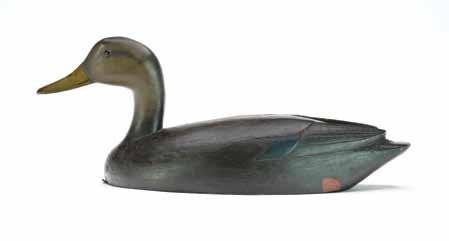
318 William Chrysler (1870-1940), Bellville, Ontario. Solid body black duck with scratch feather paint detail. Measures 17.25” long. Original paint with minor wear; some small dents otherwise very good structurally.
Provenance: Dean Hyde collection. (1,000 - 1,400)

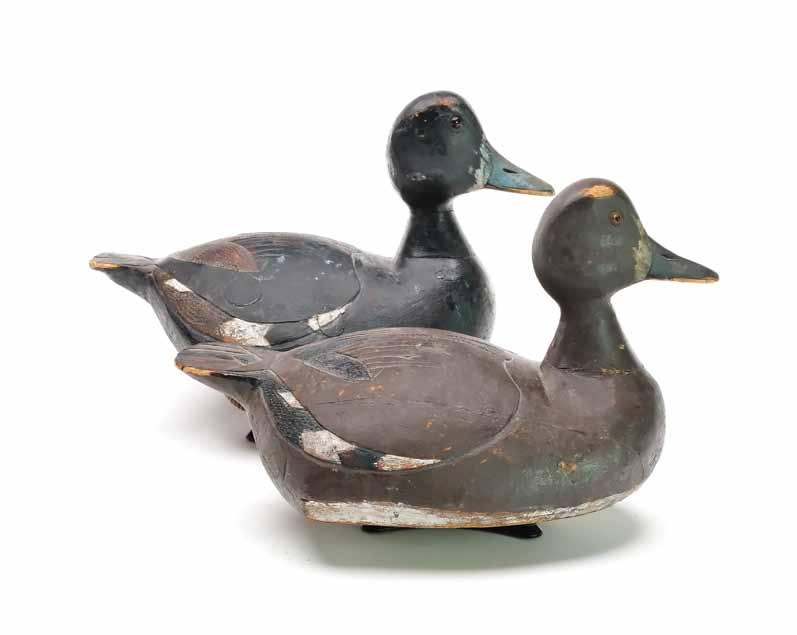
318A Frank Buchner (1871-1947), Erie, Pennsylvania. His best style rigmate pair of bluebills, 1st quarter 20th century. With classic anchor carving in back. Perky high heads. Owner’s tag on underside reads “J.F. Buchner 318 Shenley Drive, Erie PA”. Measure 14” long. Original paint with moderate gunning wear; minor roughness on edges of tails; reglued crack through drake’s neck; some filler and touchup added to a defect in wood on one side of drake’s head. (5,000 - 8,000)
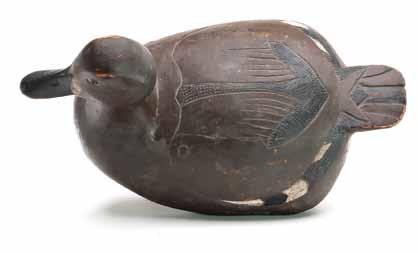
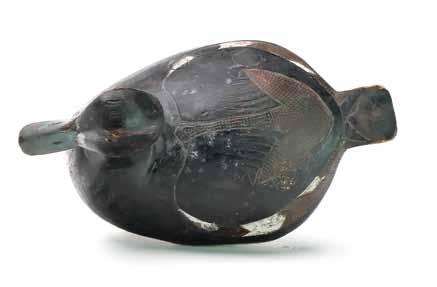

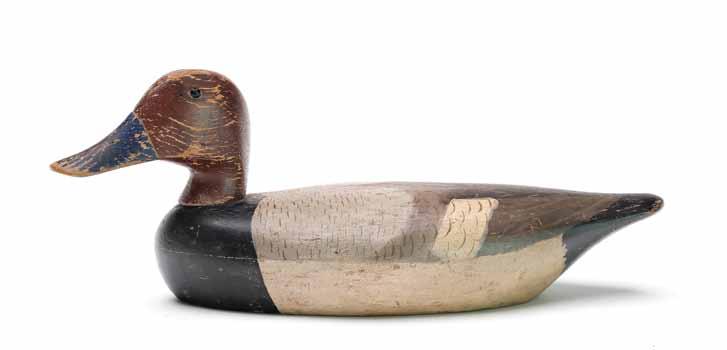

318B Unknown maker, Ohio, late 19th century. Hollow carved redhead with slightly turned head. Branded “L.H. Beers”, L.Edwards”, and F.H.M” on underside. Also with the Mackey collection and Walsh collection ink stamps on underside. Measures 15” long. Original paint with moderate flaking; head appears to have been off and reglued slightly forward of neck seat.
Provenance: Bill and Alice Walsh Collection. Obtained at Mackey Auction, the Bourne, August 1974. (1,200 - 1,800)
318C Harvey Stevens (1847-1894), Weedsport, New York. Mallard drake with fine comb feather paint detail and applied metal tail sprig. “JM” carved in underside. Also with remnants of maker’s ink stamps on underside. Measures 17.5” long. Original paint with moderate gunning wear; old chip in one side of tail; loss to wood near knot in underside; area of paint restoration near one wing patch and on underside near that area; head swivels as it should.
Provenance: Deborah and Martin Maloy collection. (4,000 - 6,000)
Tom Schroeder was born in East Detroit and spent much of his youth outdoors, quickly becoming an accomplished hunter and fisherman. It is unknown if he had any formal training in art but by 1905, and continuing through 1920, he worked as staff sport cartoonist for the Detroit Free Press. Through the early 1930s he became active in the local boxing clubs and between 1925 and 1931, he was the manager of local boxer, Mickey Goldberg. He became a well-known figure in Detroit’s journalistic, artistic and shooting fraternities and was one of the original members of the local cultural center, the Scarab Club (established in 1928).
He first attempts at carving were executed in bars of soap “borrowed” from his mother. He began to duck hunt by the age of twelve and it is believed that he carved his first decoy shortly thereafter, but the earliest decoys that can be positively identified as being carved by him date to between 1910 and 1920. This was the beginning of a hobby/pastime that would stretch over a 50 year period.
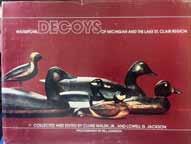

The turning point in his carving career occurred in 1948-49 when he became aware of the International Decoy Makers Contest held in New York City. He became infuriated when Joel Barber informed him that, in his opinion, the best decoys ever created came from the knife of “Shang” Wheeler. He promptly sent off multiple entries for the 1949 New York competition and took a number of first, “Best Amateur” and in later shows, “Best of Show”. He continued to compete through 1956. He never sold a decoy but is recorded as gifting a few to friends or hunting partners. He was friendly with a number of well-known Michigan carvers such as Ben Schmidt, Ferdinand Bach, Jim Kelson and Ralph Reghi and his influence can be seen in their work. In his later years, he entered the realm of decorative and miniature carving as well as producing fish decoys. His decorative career lasted until just two years prior to his death. At one point, he painted the murals for the Detroit Zoological Park.
319 Tom Schroeder (1886-1976), Detroit, Michigan. Important pair of working ruddy ducks. Hollow carved with slightly turned heads and relief wingtip carving. drake with upswept, fanned out tail. Maker’s paper label dated 1948 varnished to the underside. Measure 7.75” and 9” long. Original paint with moderate flaking and wear; chip in each side of drake’s tail was reglued.
Literature: “Waterfowl Decoys of Michigan and the Lake St. Clair Region” by Clune Walsh Jr. and Lowell G. Jackson, color plate 5, exact pair pictured, front cover, exact drake pictured.
(8,000 - 12,000)
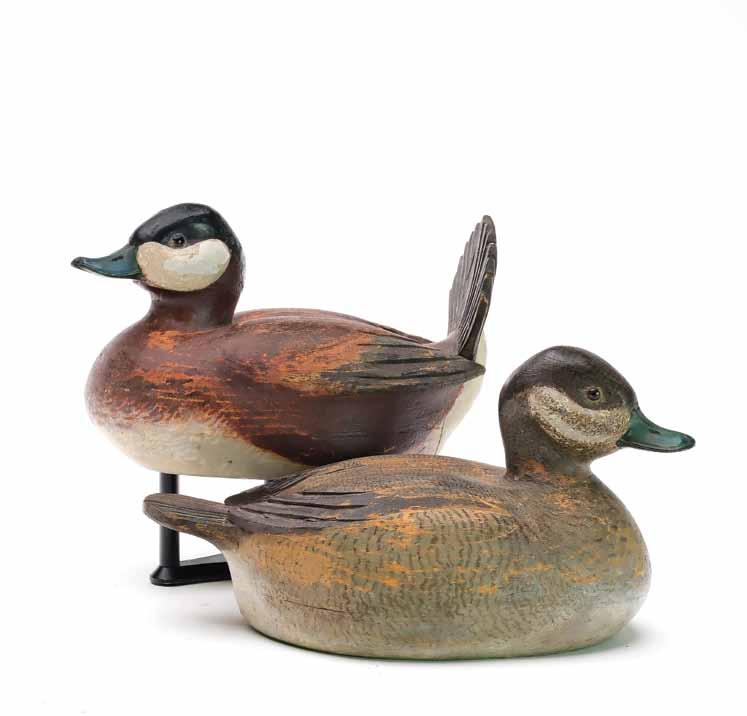
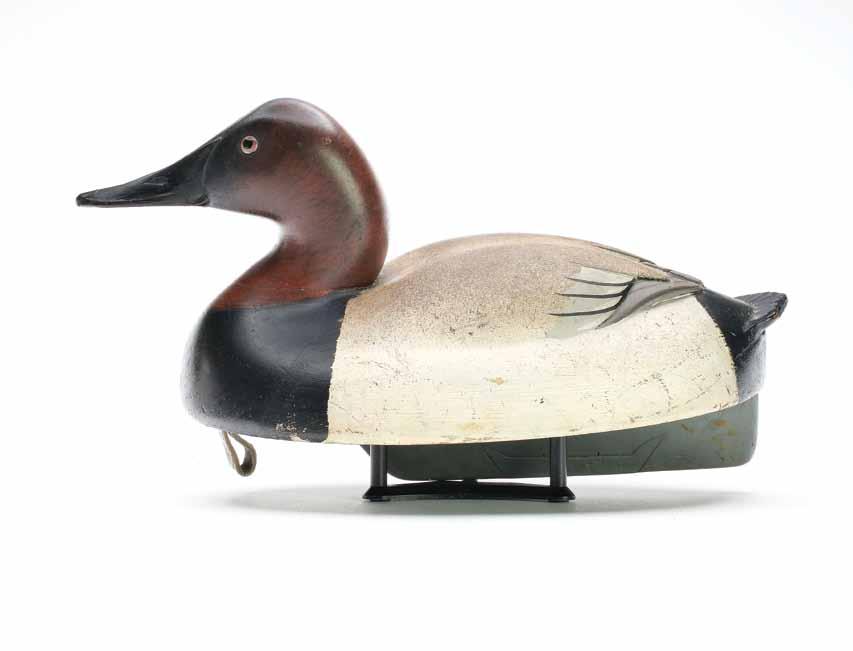

320 Ferdinand Bach (1888-1967), Detroit, Michigan. Canvasback with relief wingtip and fluted tail carving. “F.Bach” carved in underside. Measures 16” long. Original paint with minor wear; the original bill was cracked down and tightly reset with small amount of touchup.
Provenance: Dick Brust collection. (15,000 - 25,000)
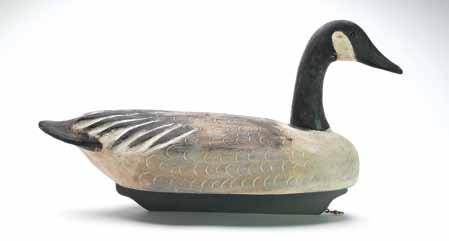
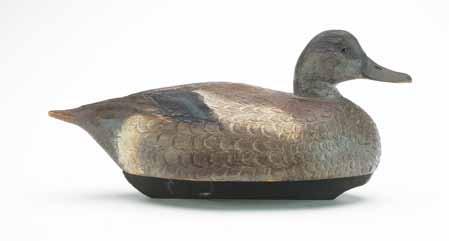
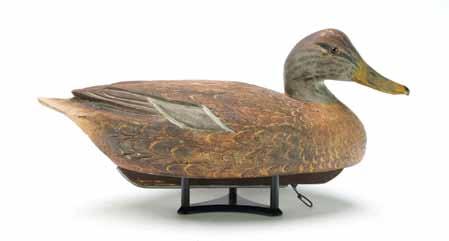
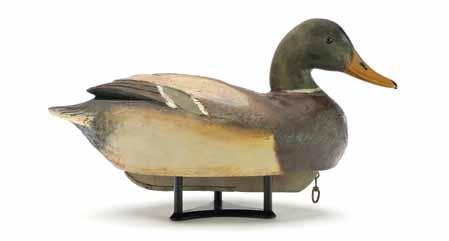
321 Benjamin Schmidt (1884-1968), Detroit, Michigan. Hollow carved Canada goose with incised feather carving. Hollowed out from the underside with deep wooden keel. Measures 24.5” long. Excellent and original.
Provenance: Jim and Patti Aikin collection. (2,000 - 3,000)
322 Benjamin Schmidt (1884-1968), Detroit, Michigan. Widgeon hen with extensive feather stamping and relief wingtip carving. “FB” stamped four times on underside. Measures 15.5” long. Original paint with minor wear; old repair to one side of neck seat; otherwise very good structurally.
Provenance: Jim and Patti Aikin collection. (800 - 1,200)
323 Benjamin Schmidt (1884-1968), Detroit, Michigan. Mallard hen with relief wingtip carving and extensive feather stamping. Measures 16.5” long. Very minor rubs on top of head and tip of bill, otherwise excellent and original.
Provenance: Len Carnaghi collection. (600 - 900)
324 Benjamin Schmidt (1884-1968), Detroit, Michigan. Mallard with raised wingtips. Measures 16” long. Hairline crack in one side of neck; otherwise excellent and original.
Provenance: Len Carnaghi collection. (1,200 - 1,800)
325 Benjamin Schmidt (1884-1968), Detroit, Michigan. Redhead hen with slightly turned head and extensive feather stamping. Identified, signed, and dated 1964 on underside. Measures 14.5” long. A few tiny paint flakes on edge of tail; tight drying crack on underside, otherwise excellent and original. (600 - 900)
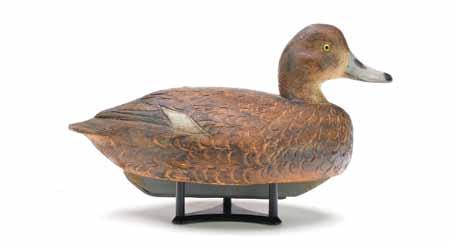
326 Benjamin Schmidt (1884-1968), Detroit, Michigan. Black duck with raised wingtips and feather stamping. Measures 17” long. Original paint with minor to moderate wear; a few shot strikes; otherwise very good structurally.
Provenance: Len Carnaghi collection. (600 - 900)
327 Frank Schmidt (1879 - 1960), Detroit, Michigan. Rare working ruddy duck. “Hy” Dahlka. Measures 12.25” long. Original paint with moderate flaking and wear; long chip in back; hairline drying cracks in breast.
Provenance: Len Carnaghi collection. (800 - 1,200)
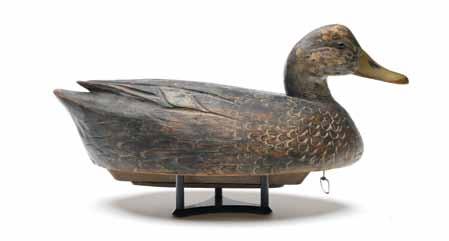

328 William Finch (20th century), Port Huron, Michigan. Rare oversize mallard. Hollow carved with .75” bottom board. Measures 19.25” long. Original paint with moderate flaking and wear; under thin coat fo varnish that has darkened; lightly hit by shot; hairline crack in top of head and in one eye; separation at body seam; tight drying cracks along wood grain on one side; tightened with small nails.
Provenance: Bill and Alice Walsh Collection. Gift from Somers Headley, Wilmington, DE. (1,500 - 2,500)
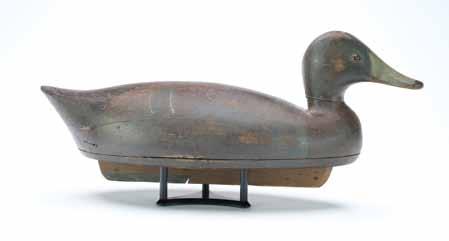
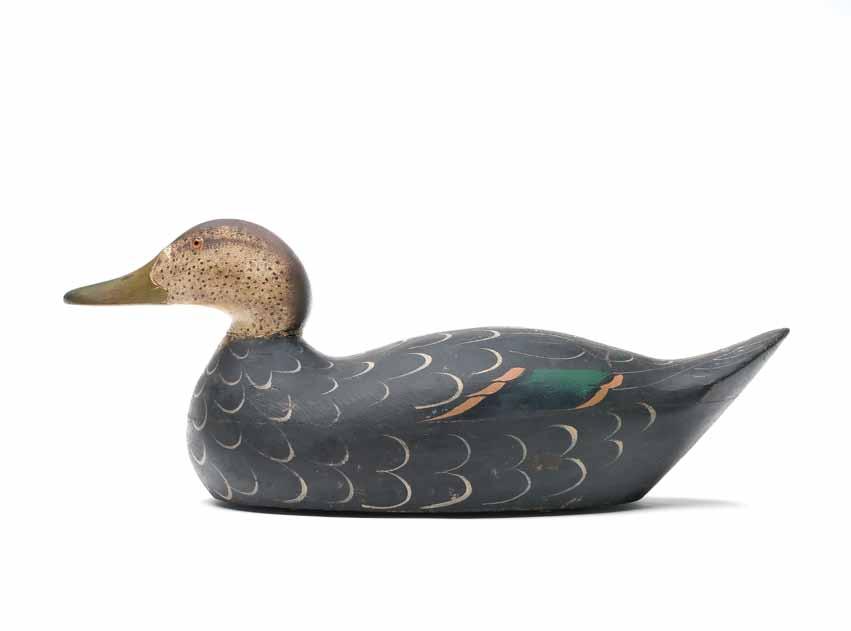
329 Mason Decoy Factory (1889-1924), Detroit, Michigan. Outstanding black duck. Premier grade with bright feather looping. Premier ink stamp on underside. Decoy was never rigged or weighted. Measures 17.75” long. Dry original paint with very minor scattered paint rubs; slight separation at neck seat with small amount of flaking to filler at back of neck seat.
Provenance: Len Carnaghi collection. (7,000 - 10,000)
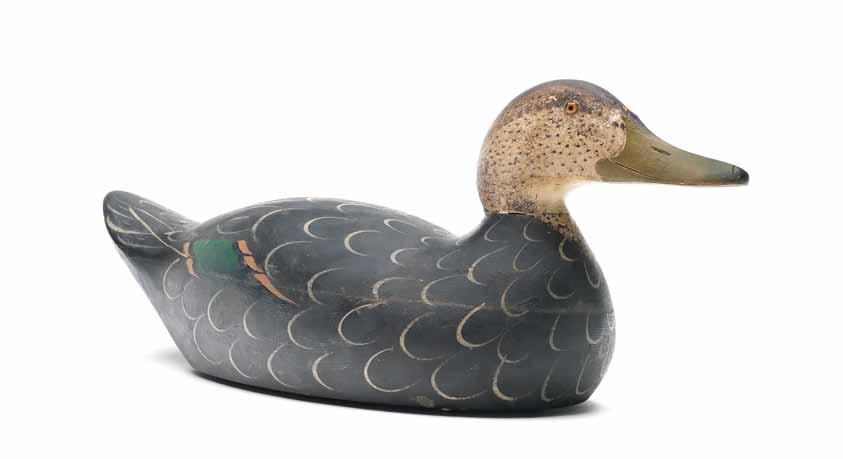
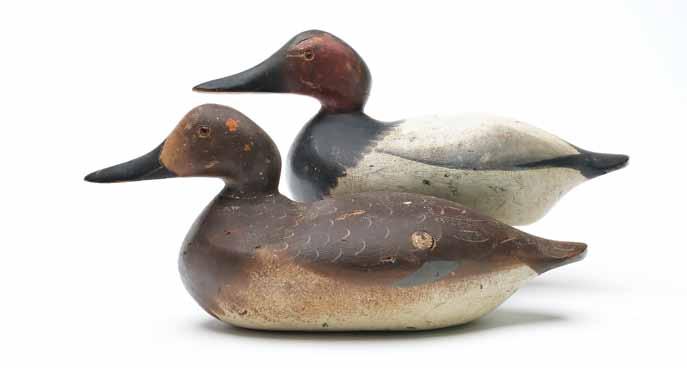
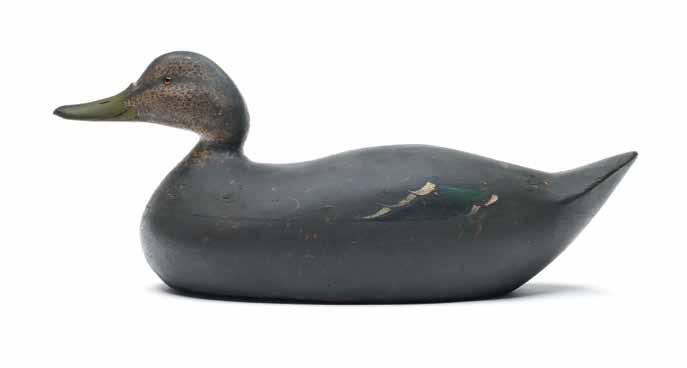
330 Mason Decoy Factory (1889-1924), Detroit, Michigan. Pair of early canvasbacks. Challenge grade. Tight scalloping on drake’s breast. Measure 15” long. Original paint with minor to moderate wear; small dents and shot marks; drying split along the underside of drake; tight crack on one side of drake’s head; professional neck filler restoration on both with an area of touchup on one side of hens breast. (3,000 - 5,000)
331 Mason Decoy Factory (1889-1924), Detroit, Michigan. Black duck. Early premier grade model. Hollow carved. Measures 17.5” long. Original paint with very minor wear; some flaking along one side; thin line of filler restoration around neck seat. (3,000 - 5,000)

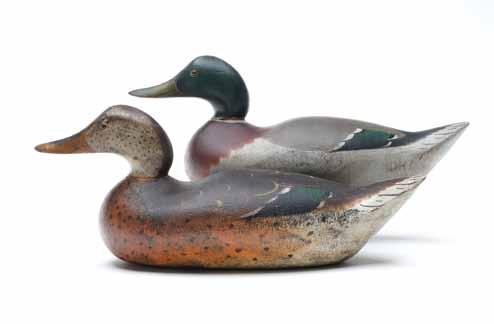

332 Mason Decoy Factory (1889-1924), Detroit, Michigan. Two piece whimbrel with iron bill and glass eyes. Measures 16.5” long. Original paint with moderate wear; under an early coat of varnish; minor roughness on tip of tail; much of the head is a professional replacement.
Provenance: Martin and Deborah Maloy collection. (4,000 - 6,000)
333 Mason Decoy Factory (1889-1924), Detroit, Michigan. Rigmate pair of mallards. Challenge grade. Hen with very nice paint detail. Measure 16.5” long. Original paint with very minor wear; a few scattered dents; hen with a tiny tail chip repair; some neck filler restored on one side of drake’s seat. (3,000 - 4,000)
334 Mason Decoy Factory (1889-1924), Detroit, Michigan. Rare rigmate pair of buffleheads. Standard grade glass eye models. Hen with scallop paint detail at breast, rare for a standard grade decoy. Measure 12” long. Original paint with moderate flaking and wear on drake; minor wear on hen; both in an early coat of varnish that has darkened with age; most of the original neck filler is missing; tight drying crack in drake’s back; defect in wood at a knot on back and one side of hen’s head.
Provenance: Dr. Michael Shannahan collection. (3,000 - 5,000)
335 Mason Decoy Factory (1889-1924), Detroit, Michigan. Rigmate pair of bluebills. Hollow carved premier grade. Measure 14” long. Original paint with minor gunning wear; each is lightly hit by shot; a few shot marks on one side of hen were filled but not touched up; tight drying cracks in drake’s breast; hairline crack in one side of drake’s head and body; small amount of touchup to edge of drakes tail.
(3,000 - 5,000)
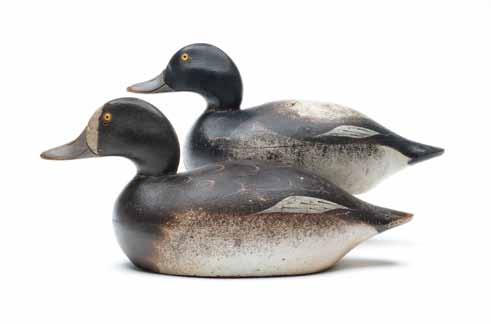
336 Mason Decoy Factory (1889-1924), Detroit, Michigan. Black duck. Hollow premier grade. With snakey head style and premier ink stamp on underside. Decoy was rigged but never weighted. Measures 17.5” long. Original paint with very minor wear; a few minor dents; very slight separation at raised neck seat; hairline crack in back. (3,000 - 5,000)
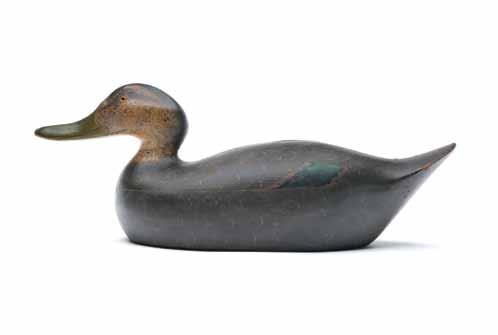
337 Mason Decoy Factory (1889-1924), Detroit, Michigan. Excellent hollow carved mallard. Challenge grade with snakey head style. Decoy was never rigged or weighted. Measures 16.5” long. Original paint with very minor wear; very minor roughness on tip of bill; hairline crack in one side of lower neck; two spots of touchup on one side of neck seat.
(2,000 - 3,000)
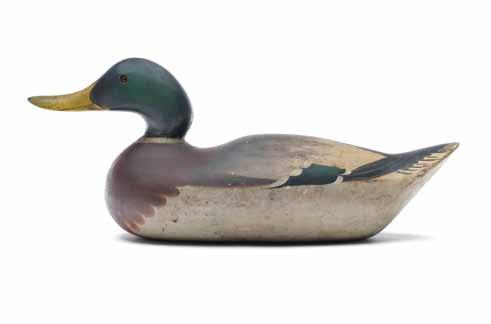
338 Mason Decoy Factory (1889-1924), Detroit, Michigan. Rigmate pair of pintails. Hollow carved premier grade. Branded “ELC” on the undersides. Measure 16” and 18” long. Original paint with moderate wear; under a thin coat of varnish; small dents and shot marks; minor roughness on one edge of hen’s bill; hairline crack on one side of hen’s neck seat; tight cracks in the underside of each; bottom inch and a half around drake was cleaned down.
Provenance: Len Carnaghi collection. (5,000 - 8,000)
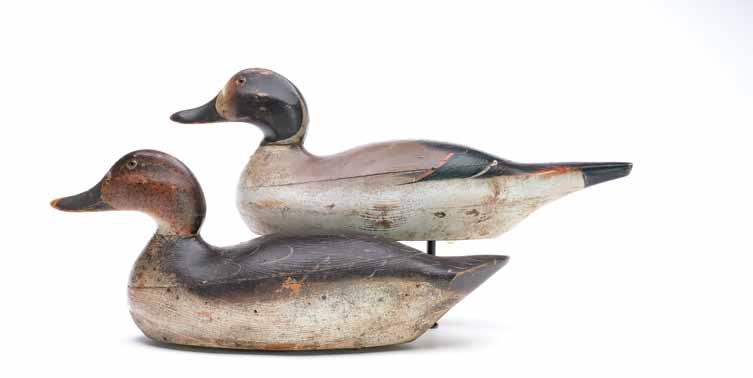
339 Mason Decoy Factory (1889-1924), Detroit, Michigan. Hollow carved premier grade mallard. Slightly turned head. Branded “D.B. Day” on the underside. Measures 15.75” long. Decoy is in mostly original paint that has crazed and worn throughout; some scattered inpainting; loss off filler at nail holes; older tail chip repair with touchup along edge of tail; neck filler restoration; tight drying crack in face.
(3,000 - 4,000)
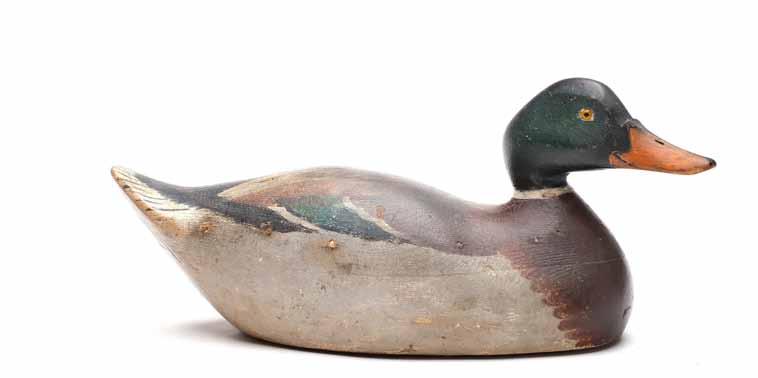
D.B. Day
David B. Day was a duck hunter and conservationist who could afford the finer things the sport had to offer as evidenced by his being accepted into the membership of the selective Toussaint Shooting Club in 1905. The Toussaint Shooting Club was formed in 1885 by a group of wealthy and prominent businessmen from the Cleveland area. At its height, this club managed approximately 1,350 acres within the “Great Black Swamp.” There were seven original members of the club and, as one would expect, memberships changed over time. By 1932, membership averaged 12 members. Self-imposed conservation measures were strict. Members were only allowed to shoot for a maximum of fourteen days per year and even with this limitation, members actually averaged only six or seven days afield. Most days of the week were reserved as “rest days” and members had to pay the club
a $5.00 surcharge for every duck shot. Water levels were carefully managed, and vast amounts of feed were distributed within the grounds annually. A portion of the club’s lands was sold to the federal government and, in 1919, the clubhouse was moved nearly two miles over the frozen marsh. The former club lands are, today, part of the Toussaint Wildlife area under the jurisdiction of the Ohio Division of Wildlife.
He is remembered for his ability as a duck caller and especially for his special-order Mason Challenge and Premier decoys with exceptional paint and some with slightly thicker than normal, or slightly longer than normal bills. All of his rig was of the highest quality. One can chuckle at the reasoning behind the thicker than normal bills when, in reading his shooting journal, he notes that some of the club’s dogs had the occasional aggravating habit of retrieving the wooden decoys rather than the downed ducks.
340 Mason Decoy Factory (1889-1924), Detroit, Michigan. Early redhead hen. Hollow carved premier grade. Writing from factory on underside reads “Premier female RH $-- doz”. Measures 14.5” long. Original paint with minor to moderate wear; scattered dents and shot marks; roughness on edge of tail and bill tip; retains most of the original neck filler.
Provenance: Len Carnaghi collection. (2,500 - 3,500)
341 Mason Decoy Factory (1889-1924), Detroit, Michigan. Bluebill hen and drake. Early challenge grade models. Measure 13.75” long. Original paint with minor wear on drake, moderate wear on hen; hen’s neck filler is restored; drake’s neck filler is mostly missing with that area touched up; one of drake’s eyes is replaced; hairline cracks in bodies; two defects in wood on underside of hen.
Provenance: Len Carnaghi collection. (1,200 - 1,800)
342 Mason Decoy Factory (1889-1924), Detroit, Michigan. Early black duck. Incised bill carving and glass eys. Measures 15.25” long. Original paint with moderate crazing and wear; split in underside was filled and the underside repainted; most of the neck filler is missing; filled defect in wood on one side from when the decoy was made.
Provenance: Len Carnaghi collection. (600 - 900)
343 Mason Decoy Factory (1889-1924), Detroit, Michigan. Early rigmate pair of redheads. Hollow carved, slope breasted style. “DW Rust” branded on undersides. Measure 13” long. Mostly original paint with moderate flaking and wear; black paint taken off of hen’s head; paint on drake’s head and breast were strengthened; white over paint cleaned off of the underside of each; both with neck filler restoration.
Provenance: Len Carnaghi collection. (2,000 - 3,000)
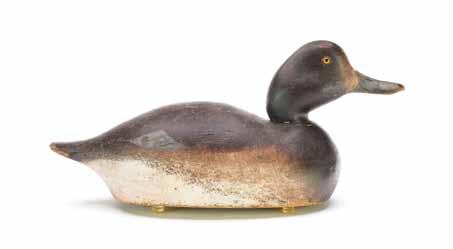

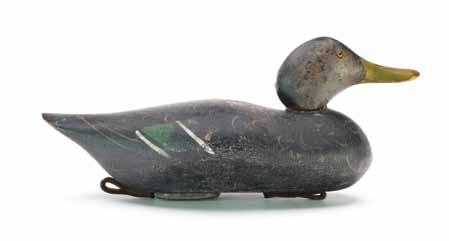
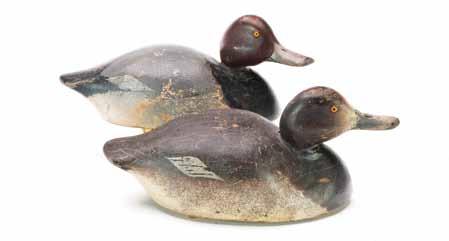

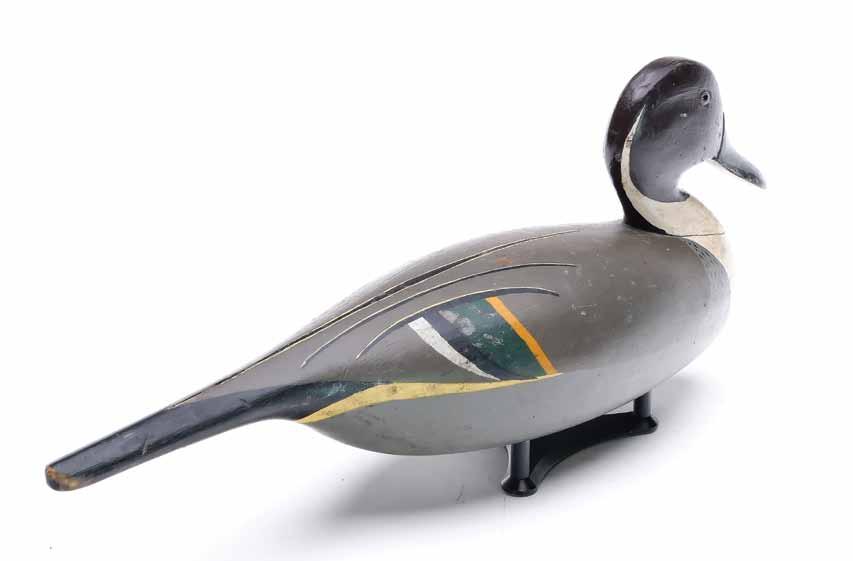
344 Mark Whipple (1888 - 1961) Bourg, Louisiana. Impressive pintail. “Broomstick” style tail. Branded “Hall” on underside, Dave Hall was a game warden and decoy collector from Louisiana. Well executed back paint. Measures 18” long. Original paint with minor flaking and wear under a thin coat of varnish; hairline crack in one eye; hairline crack in bill was reset, with a small amount of touchup in that area.
Provenance: Dave Hall collection. Rusty and Diana Johnson collection. Private Southern collection.
(7,000 - 10,000)
345 Mitchell Lafrance (1882-1979), New Orleans, Louisiana. Mallard hen with relief wing carving and scratch feather paint detail. “FSP” painted on underside. Measures 16.75” long. Original paint with very minor wear; professional tail chip restoration; cracks in neck and roughness around neck seat were professionally restored; 3/4 of bill is a professional replacement.
(1,000 - 1,500)
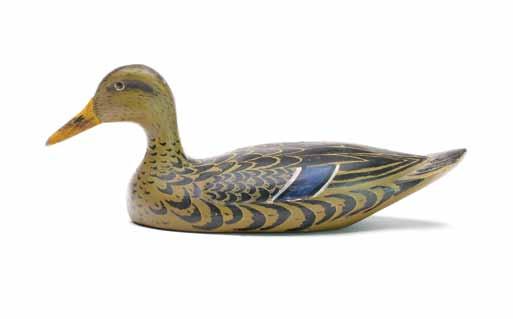
346 Xavier Bourg (1901 - ), Larose, Louisiana. Rare mottled duck with turned and down-looking head. Relief wing carving and painted eyes. Measures 12.5” long. Original paint with moderate wear; small dents in body; crack through neck; some filler touchup at base of neck.
Provenance: Tom O’Key collection. Private Southern collection.
(1,000 - 1,500)
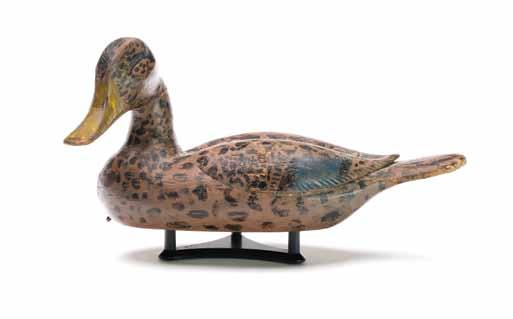
347 Attributed to Earnst Vidocovich, Avondale, Louisiana. Coot in swimming position with upswept tail. Measures 11.5”. Original paint with moderate gunning wear.
(1,500 - 2,500)


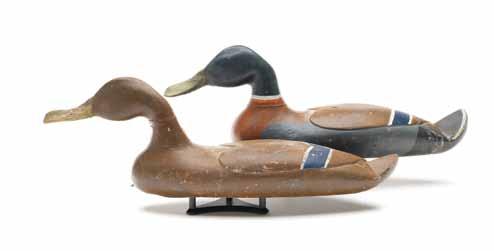


347A Marc Alcide Carmadelle (1885-1958), Des Allemands, Louisiana. Early mallard with reared back head and upswept tail. Measures 16” long. Mix of original paint and in use repaint with moderate wear and discoloration; slight separation at neck seat; bill is an early replacement; tail chip with touch up.
Provenance: Made for the Lake Arthur Club, from the Durapau Rig. Richard Lablanc collection. Private Southern collection.
Literature: Hunting & Fishing Collectibles magazine, Volume 16, Number 1 (Jan/ Feb 2016), pages 20-23, exact decoy pictured on pg. 22 with rigmates.
(500 - 800)
348 Unknown maker, Louisiana, early 20th century. Folky pair of mallards with long narrow bodies, upswept tails, and relief carved heart shaped wings with crossed wingtips. Measure 19” and 19.75” long. Original paint with moderate flaking and wear; reglued crack through hen’s neck; hen’s bill was cracked off and reattached with two small nails; drake’s bill was also reattached with old filler and touchup; spots of touchup on hen; drake’s head appears to be repainted.
Provenance: Martin and Deborah Maloy collection. (1,500 - 2,500)
349 Unknown maker, Louisiana, 2nd quarter 20th century. Bluewing teal hen with raised wingtips and tack eyes. Measures 9.75” long. Appealing in use repaint with minor gunning wear; small dents and shot marks; professional neck crack repair; bill is a professional replacement.
Provenance: Martin and Deborah Maloy collection. (400 - 500)
350 Earl Pierce, Houma, Louisiana, mid20th century. Pair of bluewing teal with metal keels and raised wingtips. Measure 10.75” long. Original paint with minor wear; lightly hit by shot; otherwise very good structurally.
Provenance: Martin and Deborah Maloy collection. (800 - 1,200)

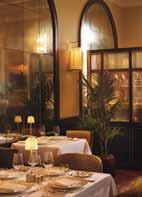
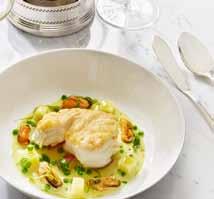
An intimate bar-and-restaurant with an unparalleled focus on the very finest of single malt Scotch whiskeys, vintage Champagnes, and elegant cuisine.
Wed & Thur 5 - 10pm | Fri & Sat 5pm - 12am thestewart.com | @thestewartbar 3 Federal Street, Easton (410) 793-4128
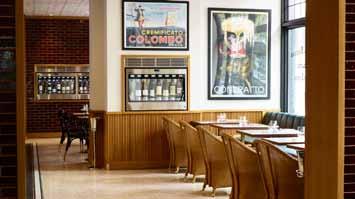
Authentic Roman style pizza for takeaway by the slice or whole pie with fresh, prime ingredients. Outdoor seating available on a first come, first serve basis.
Mon - Wed 11am - 8pm romaeaston.com | @romaeaston (410) 770-9701
Timeless design meets innovative cuisine and an award-winning wine program for a world-class dining experience.
In 2024, Executive Chef Harley Peet became the first chef on the Eastern Shore of Maryland to be named Best Chef: Mid-Atlantic by the James Beard Foundation.
Lunch Thurs & Fri 11am - 1:30pm | Dinner Wed - Sat 5 - 9pm basrougeeaston.com | @bas_rouge 19 Federal Street, Easton (410) 822-1637
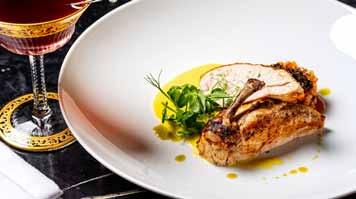
Epicurean market, wine shop, and bistro featuring delicious sandwiches by day; pasta and wine in the evenings; and Sunday brunch.
Tues - Thurs 11am - 9pm | Fri & Sat 11am - 10pm Sunday Brunch 10am - 2pm thewardroom.com | @_thewardroom
103 N. Washington Street, Easton (410) 826-5489

View the full list of Bluepoint properties and special Waterfowl Weekend event schedule at bluepointhospitality.com | @bluepointhospitality
Session Two
Sunday, November 16, 2025
10:00am
351 Jim Schmiedlin (1945-2015), Bradfordwoods, Pennsylvania. Working wood duck with slightly turned head and extended crest. Hollow carved with .25” bottom board that is branded “JAS” and with maker’s Reward for Return label. Signed 10/93. Measures 15.5” long. Original paint with very minor wear; very good structurally. (10,000 - 15,000)
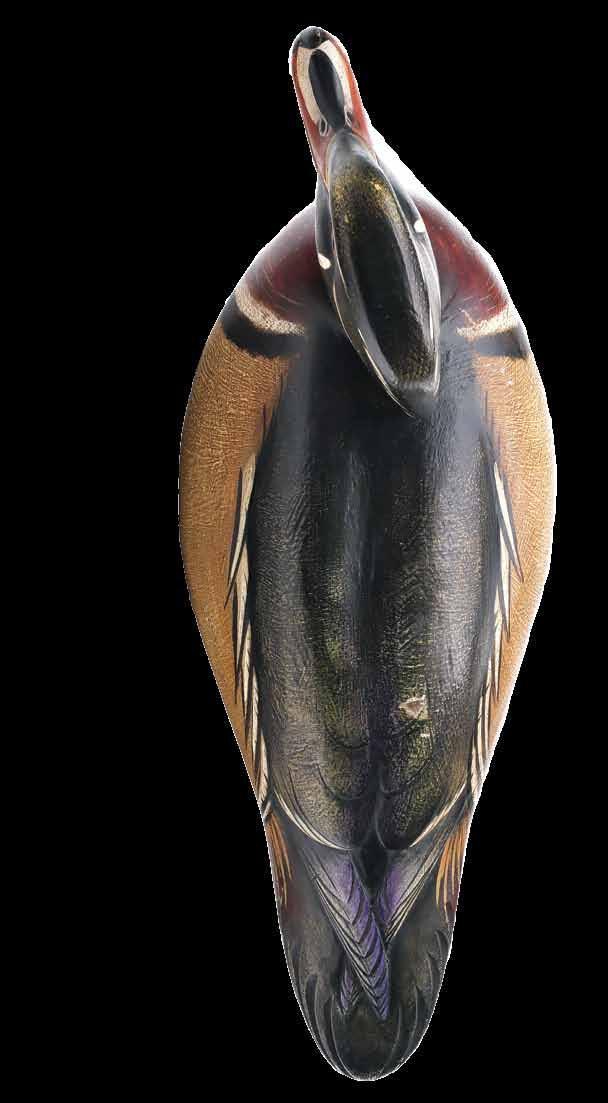
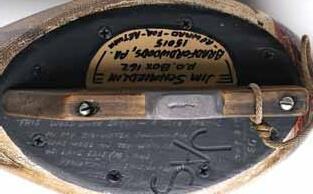
Underside reads, “This wood duck decoy –A rare species in my big-water gunning rig, was used on the waters of Lake Erie (PA) and Pymatuning Lake (PA & OH) - 1993”
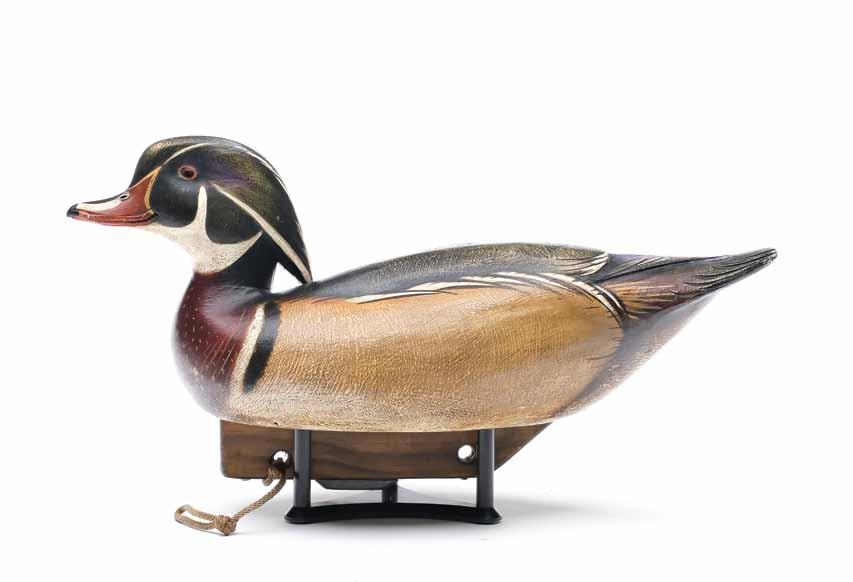
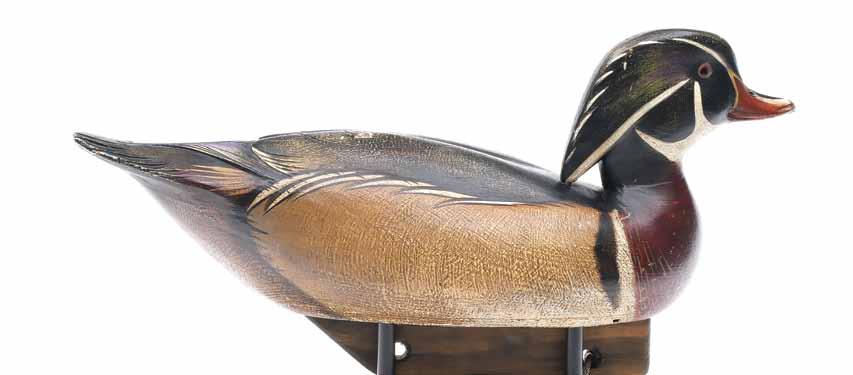
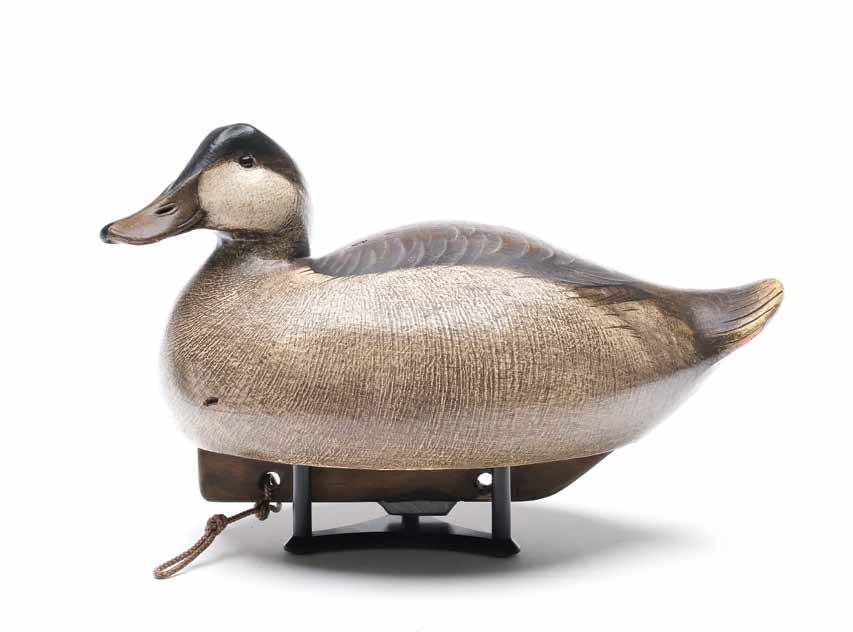
351A Jim Schmiedlin (1945-2015), Bradfordwoods, Pennsylvania. Hollow carved ruddy duck with wide body and slightly turned head. “JAS” and maker’s Reward for Return label on underside. Also dated 10/2003. Measures 13.5” long. Original paint with minor wear; a few large shot strikes; some spots of flaking were touched up by the maker. (5,000 - 8,000)
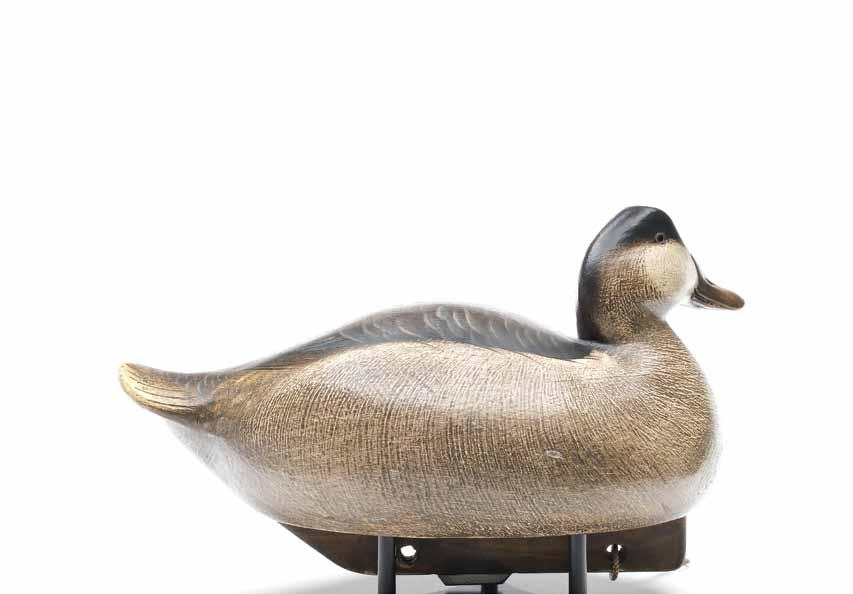
352 Jim Schmiedlin (1945-2015), Bradfordwoods, Pennsylvania. Preening mallard. Hollow carved with deep relief wing carving. Maker’s Reward for Return label and “JAS” brand on the underside. Dated 2004. Schmiedlin collection ink stamp on underside. Measures 15” long. Original paint with minor gunning wear; some areas of flaking were touched up by the maker; slight separation at body seam; otherwise excellent structurally.
Provenance: Dr. Michael Shannahan collection. (6,000 - 9,000)
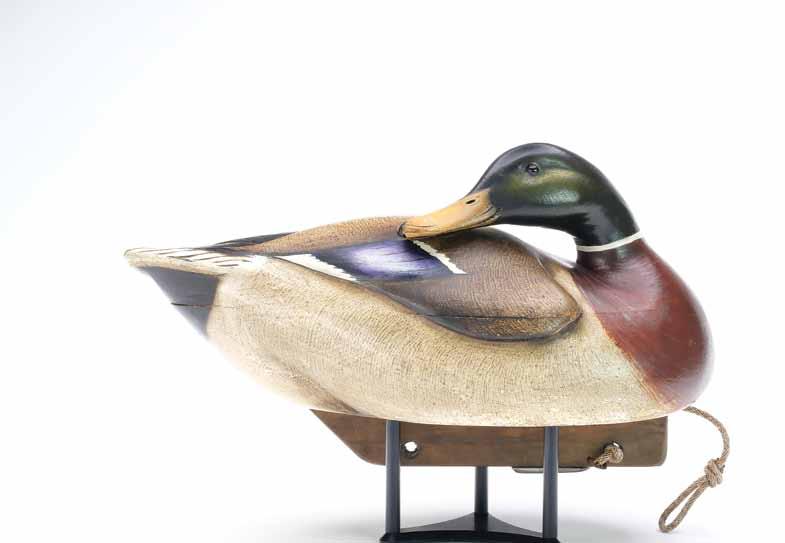
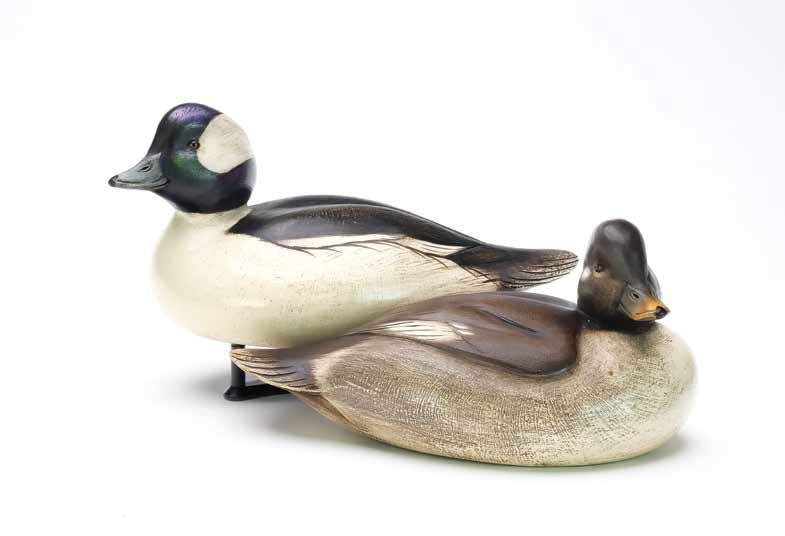
353 Jim Schmiedlin (1945-2015), Bradfordwoods, Pennsylvania. Pair of bufflehead. Drake with slightly turned head and hen with head tucked and turned almost 90 degrees. Both are dated ‘94. Maker’s “JAS” brand on underside. Also with the Schmiedlin collection ink stamp. Measure 11.5” and 12.25” long. Excellent and original.
Provenance: Dr. Michael Shannahan collection. (6,000 - 9,000)
354 Jim Schmiedlin (1945-2015), Bradfordwoods, Pennsylvania. Hollow carved bluewing teal with slightly turned head and relief wingtip carving. Signed and dated 12/2000. “JAS” brand and maker’s Reward for Return label on underside. Measures 14” long. Excellent and original.
(4,000 - 6,000)
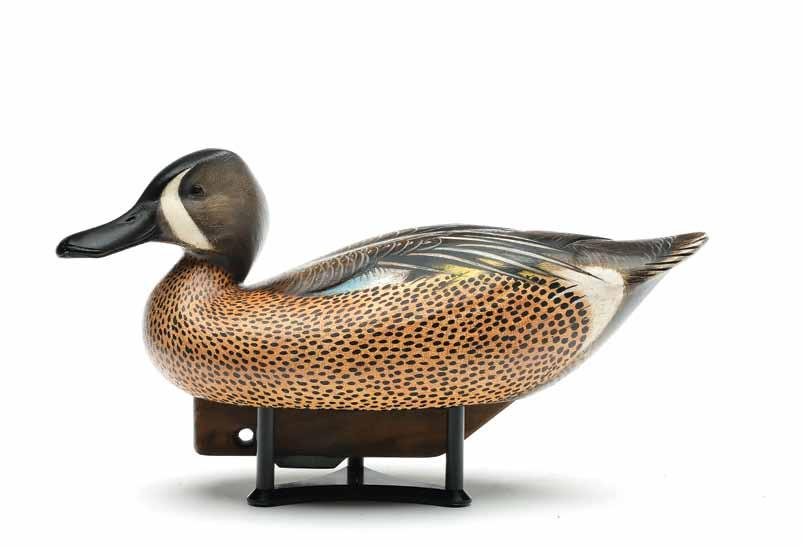
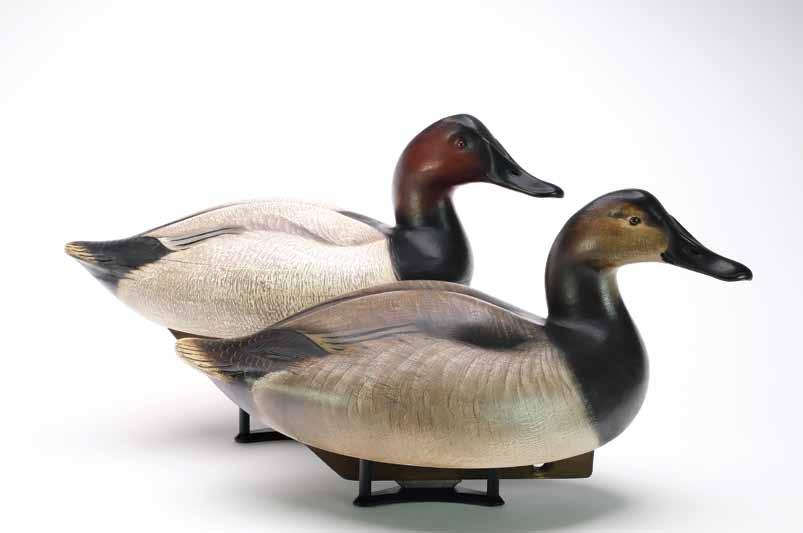
355 Jim Schmiedlin (1945-2015), Bradfordwoods, Pennsylvania. Pair of canvasbacks. Hollow carved with slightly turned heads. Maker’s Reward for Return label and “JAS” brand on underside. Both are dated ‘99. Measure 17.75” long. Mix of original and second coat of paint by the artist; hen is excellent structurally; drake has slight separation at body seam with some filled cracks in breast.
Provenance: Dean Hyde collection. (5,000 - 8,000)
356 Jim Schmiedlin (1945-2015), Bradfordwoods, Pennsylvania. Hollow carved surf scoter with slightly turned head and relief wing carving. “JAS” and maker’s Reward for Return label on underside. Decoy is dated 1982 with its hunting history on underside. Measures 16” long. Original paint with minor gunning wear; keel was replaced by the maker in 2000, otherwise good structurally. (3,500 - 5,500)
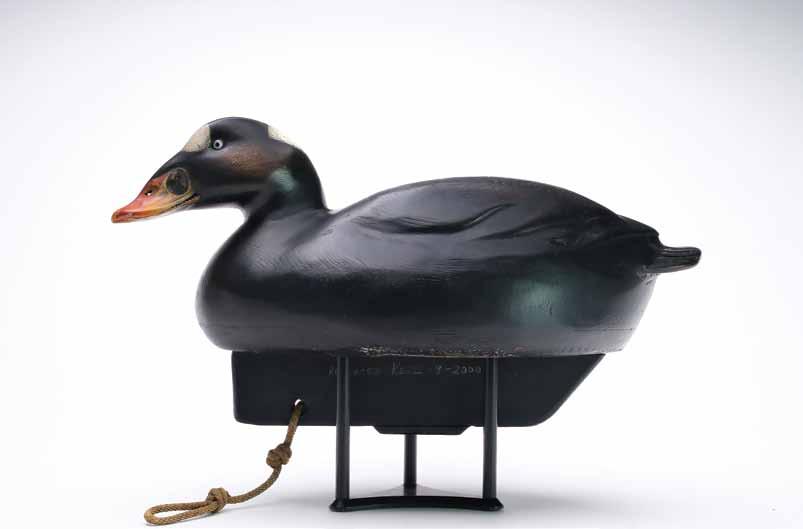
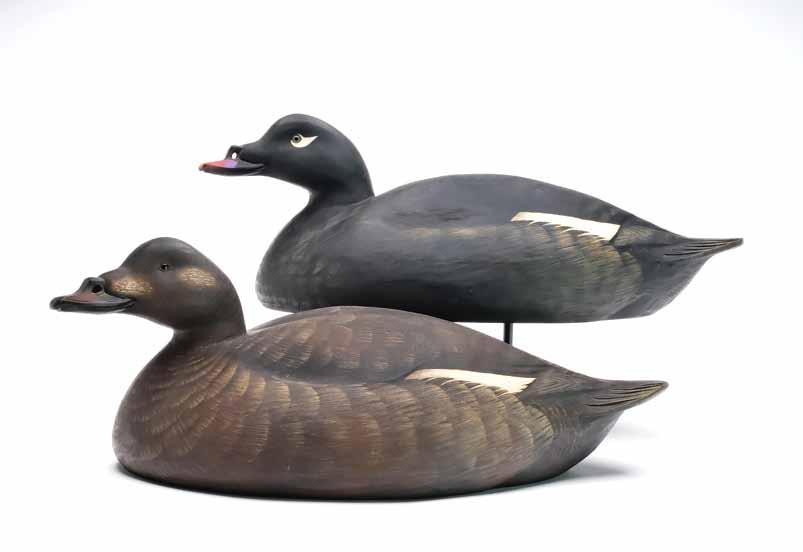
357 Jim Schmiedlin (1945-2015), Bradfordwoods, Pennsylvania. Pair of oversize white-winged scoters. Hollow carved with thin bottom boards. Identified, signed, and dated 1986. Also branded “JAS” on undersides. Measure 19.5” long. Near mint.
Provenance: Dean Hyde collection (5,000 - 8,000)
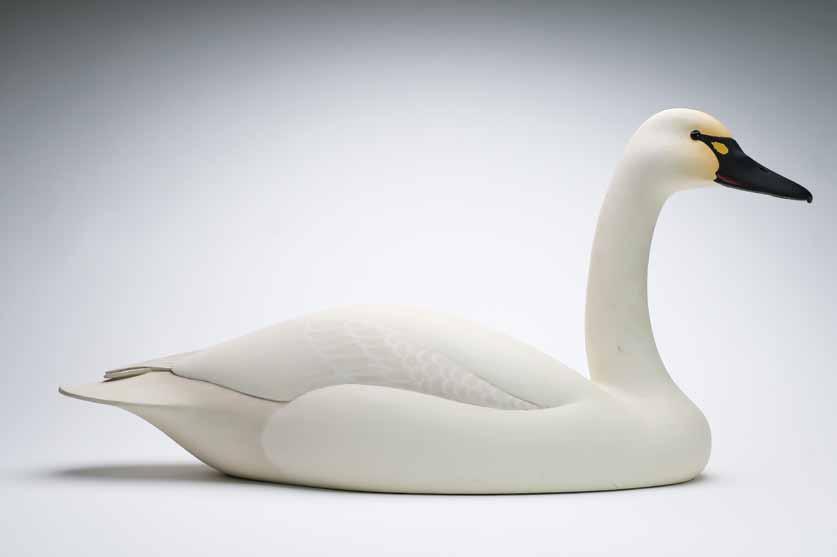
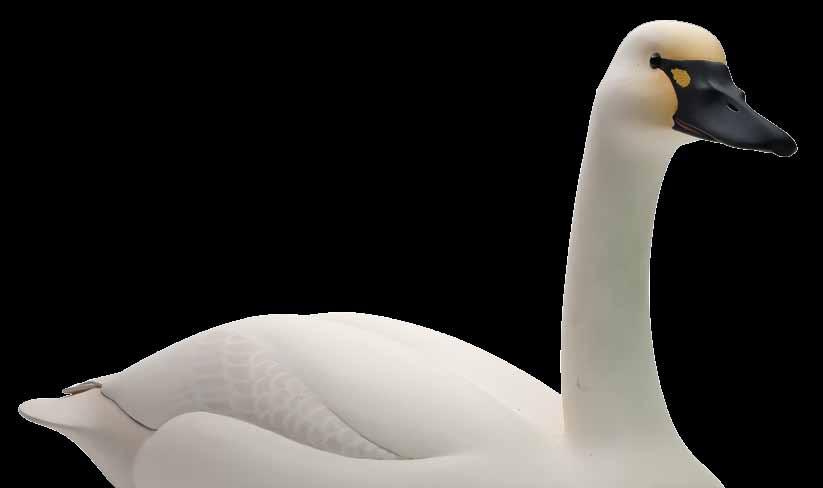
357A Oliver Lawson (b.1938), Crisfield, Maryland. Hollow carved whistling swan with slightly turned head and relief wing carving. Raised, crossed wingtips. Signed and dated 1993 on underside.
Measures 32.5” long. Excellent and original.
(8,000 - 12,000)

358 Oliver Lawson (b.1938), Crisfield, Maryland.
Outstanding pair of decorative quail with relief wing and tail feather carving. Both with slightly turned heads and excellent paint detail. Each is signed and dated 1969 on base. Measure 7” and 8” long. Very fine hairline separation at male’s neck seat otherwise both mint.
Provenance: Martin and Deborah Maloy collection.
(3,000 - 5,000)
359 Oliver Lawson (b.1938), Crisfield, Maryland.
Decorative common yellowthroat and lady’s slipper. Bird is standing on natural wood perch and looking at a ladybug on stem of flower. Signed on perch. Bird measures 4” long, stands 13” tall. Very tightly reset crack through top part of stem, otherwise excellent and original.
(3,000 - 4,000)


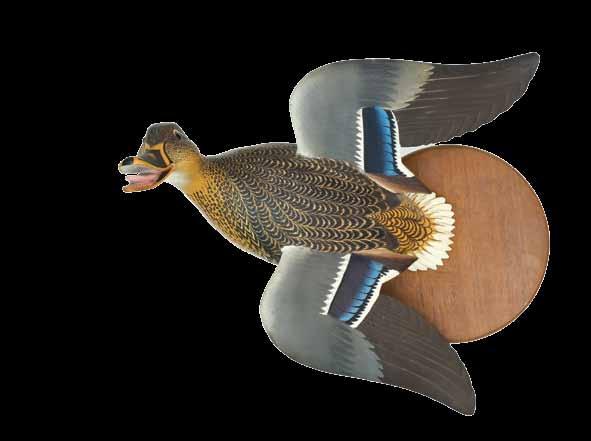
360 Ward Brothers, Crisfield, Maryland. Pair of 2/3 size flying mallards. Balsa bodies with applied wings and slightly turned heads. Relief wing and tail feather carving. Hen’s bill is open with carved wooden tongue. Both signed and dated 1948 on back of top wing. Measure 15.5” long, with a 15” wingspan. Very minor crazing to paint on drake; otherwise excellent and original.
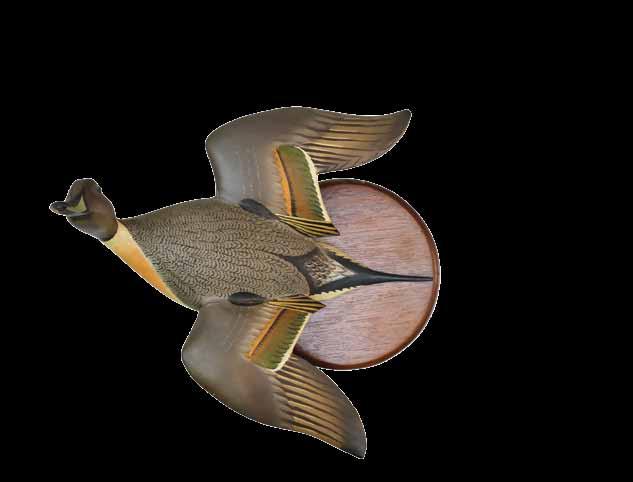
361 Ward Brothers, Crisfield, Maryland. Pair of 3/4 size flying pintails. Balsa bodies with applied wings and slightly turned heads. Signed and dated 1957 on back of plaques. Measure 15.5” and 13.5” long, with a 13.25” wingspan. Very minor roughness on tip of hen’s lower wing, otherwise both excellent and original.
Provenance: Dean Hyde collection. (10,000 - 14,000)
Provenance: Dean Hyde collection. (8,000 - 12,000)


362 Ward Brothers, Crisfield, Maryland.
Hollow carved decorative widgeon. Slightly turned head and relief feather carving. Signed and dated 1969 on the underside. Measures 15” long. Original paint with a few tiny rubs; varnish on unpainted underside overlaps on to very bottom edge of carving; excellent structurally.
(3,000 - 5,000)

363 Ward Brothers, Crisfield, Maryland.
Pair of hollow carved redheads with slightly turned heads and thick stipple paint on back. Both are signed and dated 1967 on the underside. Measure 14.5” long. Original paint with a few very minor rubs; fine paint shrinkage on hen’s breast; some of which has been touched up; both are excellent structurally.
(4,000 - 6,000)

364 Ward Brothers, Crisfield, Maryland.
Pair of bluebills with slightly turned heads. Shooting stool models that are signed and dated 1972. Poem by Lem Ward on the underside of each. Measure 15.25” long. Excellent and original.
(3,000 - 5,000)
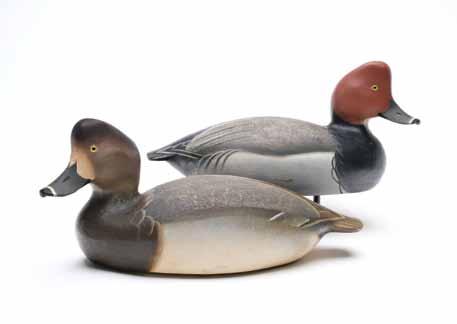
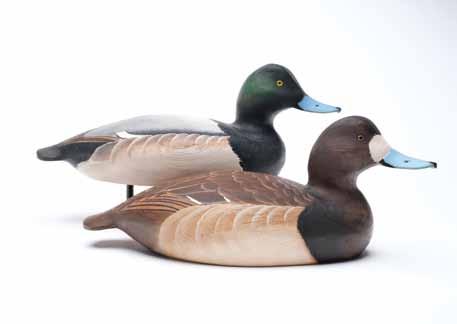
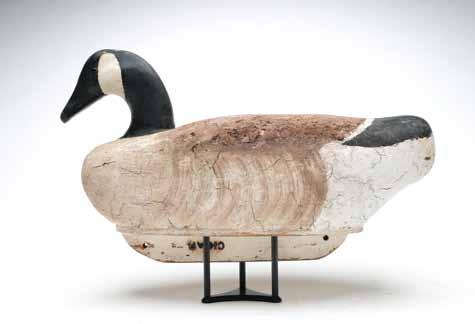
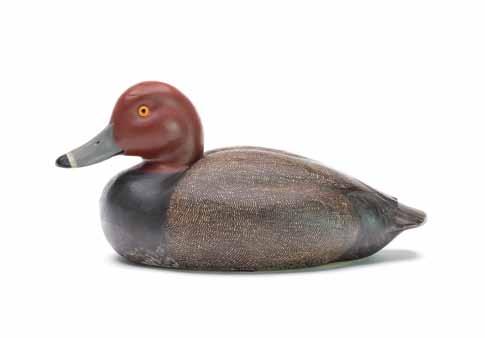
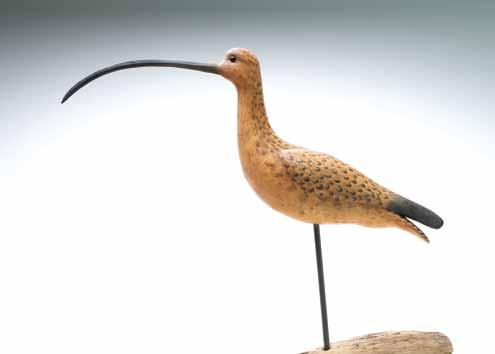
365 Delbert “Cigar” Daisey (1928-2017), Chincoteague, Virginia. Working cork body Canada goose from the maker’s personal rig. Signed and dated 1965. Branded “Cigar” on underside and in one side of keel. Measures 22” long. Mostly original paint with minor wear; second coat of white on underside of tail and on head; some shallow losses to cork. (1,500 - 2,000)
366 Delbert “Cigar” Daisey (1928-2017), Chincoteague, Virginia. Rare hollow carved redhead. With relief carved, crossed wingtips and comb feather paint detail. Signed and branded “Cigar” on the underside. Measures 12.75” long. Very good and original. (2,000 - 3,000)
367 Delbert “Cigar” Daisey (1928-2017), Chincoteague, Virginia. Large curlew with relief wing carving. Signed and dated 1962. “Cigar” branded on underside of driftwood base. Measures 21” long. A few small spots of sap bleed with some paint shrinkage near stick hole; filled drying crack in breast has opened slightly with touchup in that area.
Provenance: Chincoteague Refuge Museum. (1,200 - 1,800)
368 Delbert “Cigar” Daisey (1928-2017), Chincoteague, Virginia. Ruddy duck with relief wing and tail feather carving. Signed, identified, and branded “Cigar” on the underside. Measures 10.5” long. Area of sap bleed on breast and under tail, otherwise excellent and original. (700 - 1,000)
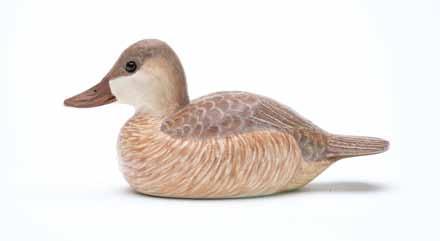
369 Delbert “Cigar” Daisey (1928-2017), Chincoteague, Virginia. Golden plover with extended wingtips. Branded “Cigar” in underside. Measures 9.25” long. Some areas of sap bleed, otherwise very good and original. (800 - 1,200)
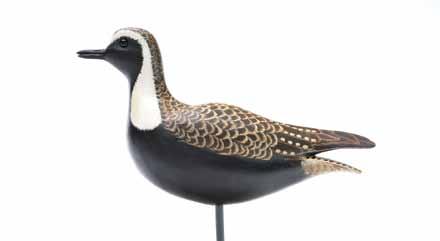
370 Delbert “Cigar” Daisey (1928-2017), Chincoteague, Virginia. Yellowlegs with relief wing carving and extended wingtips. Signed and branded “Cigar” on underside. Stand included. Measures 11” long. Surface has darkened slightly; excellent and original. (800 - 1,200)
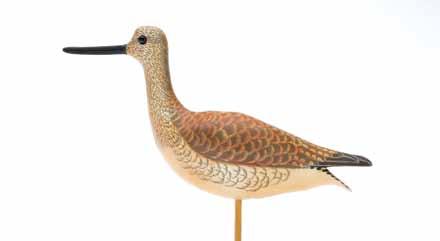
371 Delbert “Cigar” Daisey (1928-2017), Chincoteague, Virginia. Half size grebe with relief wing and tail feather carving. Signed, identified, and branded “Cigar” on the underside. Measures 7.25” long. Very good and original. (500 - 800)
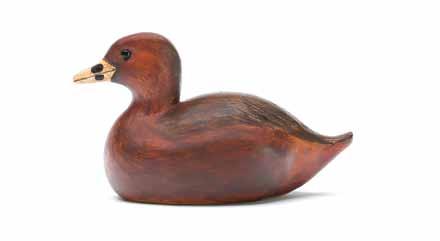


372 Eli Doughty (1844-1923), Hog Island, Virginia. Bluebill with long inlet neck seat, narrow breast, and eye groove carving. Tommy O’Conner collection ink stamp on underside. Measures 12.75” long. Early in use repaint with moderate wear; hairline crack in underside; hairline drying cracks in breast and neck seat.
Provenance: Bill and Alice Walsh Collection. Obtained from Tom O’Connor January, 1978.
Literature: “Decoys of the mid-Atlantic Region” by Henry A. Fleckenstein Jr., page 221, exact decoy pictured. (3,000 - 5,000)
373 Ike Phillips (1858-1954), Wachapreague, Virginia. Large black duck with long neck seat and carved ridge down back. “Kangas” and “BB13” stamped in underside. Measures 16.5” long. Mix of original and very early repaint most of which has flaked to the original surface; crack through neck with old nails to secure; large separation to wood on one side with many old nails and filler to secure.
Provenance: Bill and Alice Walsh Collection. Bought from Gary Guyette at Easton, MD, November 1986. (3,000 - 5,000)
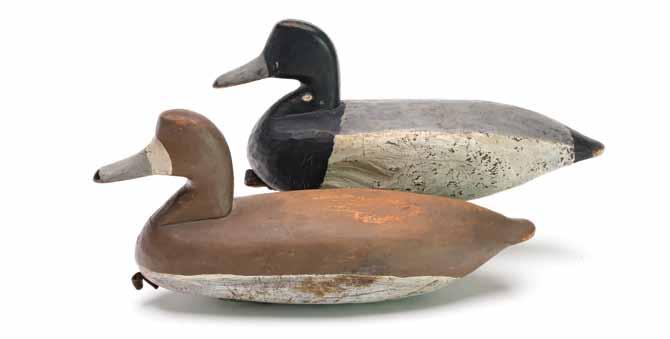
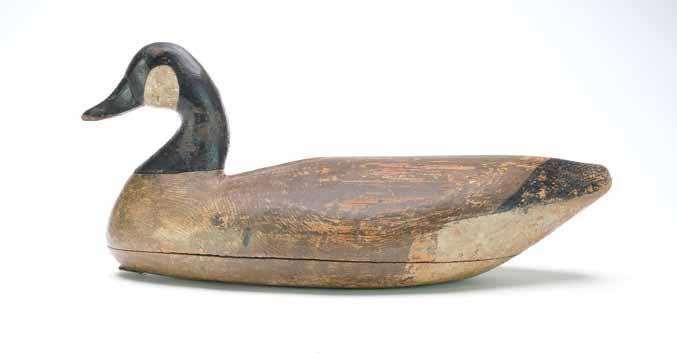
374 Ike Phillips (1858-1954), Wachapreague, Virginia. Pair of bluebills. Measure 14” long. Original paint with moderate wear; white areas with an early second coat; defects in wood used for drake’s body are from the making. (1,200 - 1,800)
375 Joseph Crumb, Oyster, Virginia, circa 1900. Rare hollow carved Canada goose. With raised neck seat and ice groove carving. Tommy O’Conner collection ink stamp on underside. Measures 24.75” long. Early working repaint with moderate flaking and wear; slight separation at body seam; hairline drying cracks in back; bill was cracked down and reset; many cracks in neck with old filler and touchup.
Provenance: Bill and Alice Walsh Collection. Obtained from Tom O’Conner of Suffolk, VA.
Literature: “Decoys of the mid-Atlantic Region” by Henry A. Fleckenstein Jr., page 214, exact decoy pictured. (3,000 - 5,000)
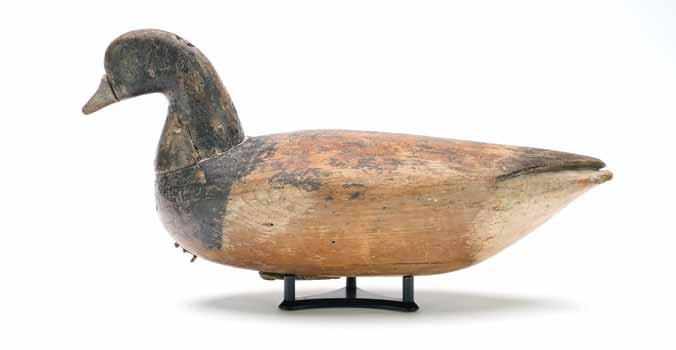
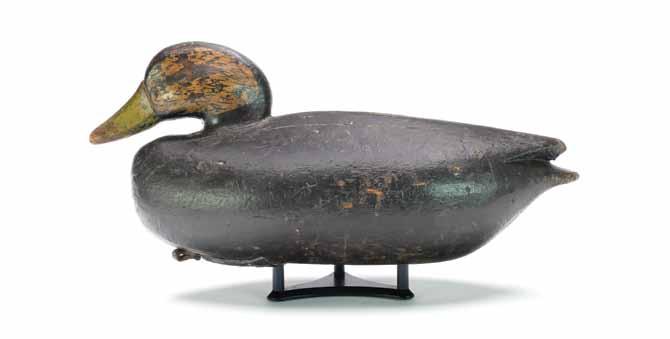
376 Unknown maker, Cobb Island, Virginia, late 19th century. Slightly forward head pose with inserted hardwood bill. Measures 18” long. Old in use repaint with significant wear down to bare wood; moderately hit by shot; chipping and roughness on tail; cracks and chipping at base of neck; where head was reattached and nails added; chipping and roughness where bill meets face.
Provenance: Bill and Alice Walsh Collection. Obtained from Arthur Addison, Cape Charles, VA. (3,000 - 4,000)
377 Elkanah Cobb (1852-1943), Cobb Island, Virginia. Black duck with inlaid neck seat and raised wingtips. “E” carved in underside. Measures 15.75” long. Old in use repaint with moderate flaking and wear; tight drying cracks along back; split in underside where an old nail was added; lightly hit by shot.
Provenance: Bill and Alice Walsh Collection. Obtained from Larry Lambert.
Literature: “Decoys of the mid-Atlantic Region” by Henry A. Fleckenstein Jr., page 217, exact decoy pictured. (3,000 - 5,000)
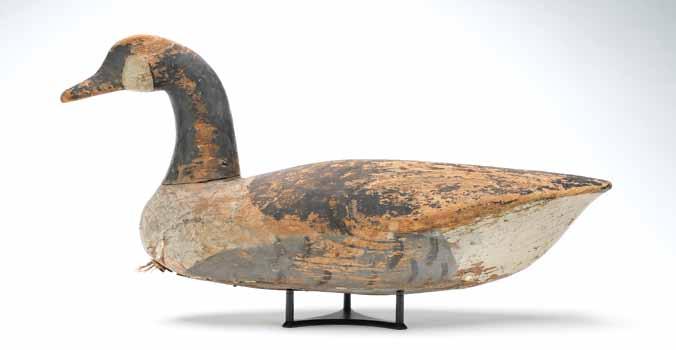
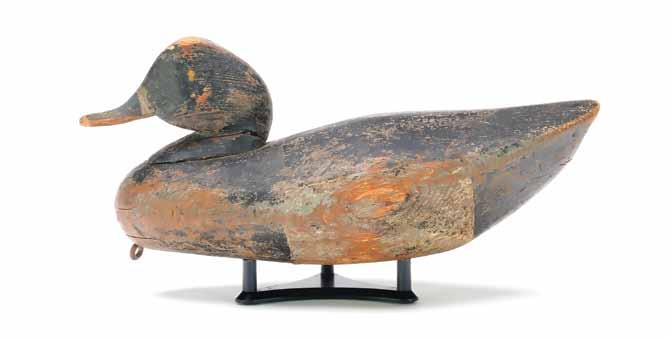
378 Unknown maker, Eastern Shore of Virginia, circa 1900. Canada goose with cotton wood head and body. Measures 26.5” long. Original paint with significant gunning wear; tight drying cracks in body; roughness on edge of tail; drying split along the underside.
Provenance: Bill and Alice Walsh Collection. (1,500 - 2,500)
379 Unknown maker, Eastern shore of Virginia, circa 1900. Bluebill. “36” and “301” stamped in to underside. Measures 13.5” long. Old in use repaint; significant flaking and wear; hairline drying cracks in breast; shallow chips on top of head and one side of bill; crack along one side of neck seat where an old nail was added.
Provenance: Bill and Alice Walsh Collection. (700 - 1,000)
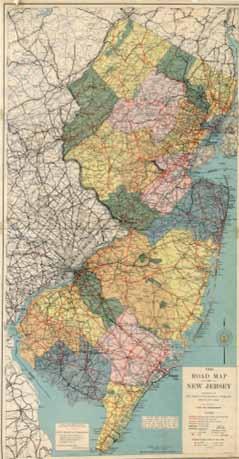
Although he was somewhat prolific, not a great deal has been written about Clark Madara. He was born in Petersburg, Cape May County, NJ but, in 1899, his father, Charles, a farmer, relocated to Mantua, a portion of which would become Pitman in 1905. Charles died in 1909, and Clark began working as a house painter to help support his mother, Sarah (aka Sallie). Around the time of WWI, he formed a partnership under the name of Madara and Haines in Pitman, but apparently that was a brief venture, and he remained a self-employed painter until the time of his death. A long-time bachelor, he did not marry until 1947 when, at age 64, he wed 46-year-old Florence Whitlock. The Madara family had long lived on Evergreen Ave in the vibrant community of Pitman and, since at least 1920, Clark resided at number 49. Although not listed in any formal record, Clark’s obituary carefully notes that, in addition to being a painter, he was also a “- - - gunsmith and one of the last living men to construct Barnegat Bay sneak boxes”
Since his obituary uses the term sneak boxes in the plural, it would suggest that he made these specialized craft, not only for his own use, but also for sale to others. In fact, there is one reference that states that “A boat of exceptional workmanship bearing a penciled notation reading: ‘ Built by Clark Madara for WM Hazelton 11/13/47’ has been identi fied” . Over his lifetime, Madara constructed a number of decoys in a wide variety of species and, logically, he may have offered some of these for sale as well. Stylistically, his birds are a departure from the classic Delaware River School and, with thei r smooth, flowing bodies, they more closely resemble those carved either around the Philadelphia area or on the eastern half of the State. In fact, although he lived near the Delaware River, he is said to have hunted mostly at the Beesleys Point area at the mouth of the Tuckahoe River where it empties into Great Egg Harbor Bay and the Atlantic.
His work was known and appreciated by the early collector/historian Joel Barber who, in his 1934 reference, illustrates a bronze decoy head he fashioned from a derelict decoy he discovered. He notes in his text that he “- - - considered the maker a real artist, even though he lived and worked, unknown on the Jersey barrens- - - “ . That decoy is now known to have been carved by Madara. New Jersey author Jim Doherty considered Madara one of the State’s better carvers of the period and devoted four pages in his reference, “Classic New Jersey Decoys”, to photographs of his work.
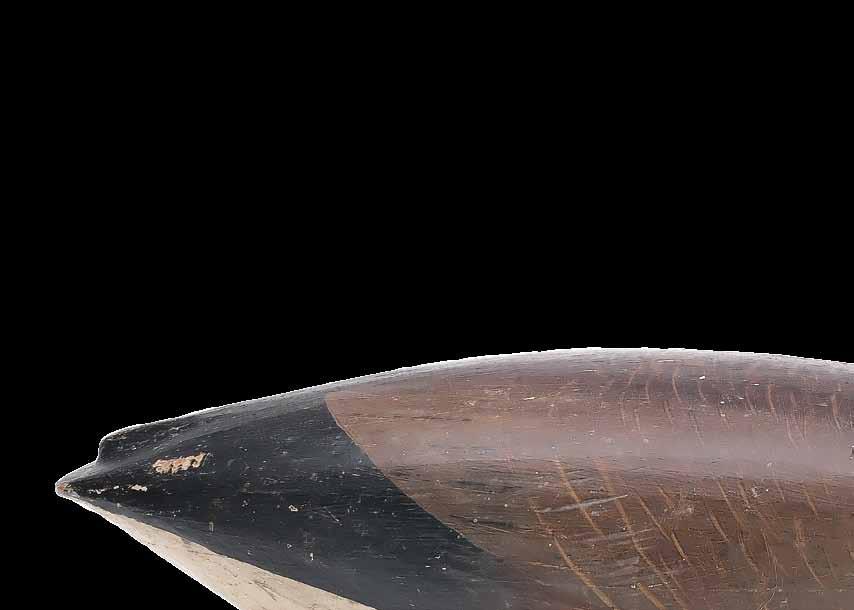
379A Clark Madara (1883-1953), Pitman, New Jersey. Excellent Canada goose, circa 1910. Madara’s most desirable style. Hollow carved with prenounced breast. and “fin” tail carving. Appealing scratch feather paint detail on sides and back. one of only six known in original paint. Measures 23.5” long. Original paint with minor gunning wear; a few small dents, otherwise excellent structurally.
(15,000 - 25,000)
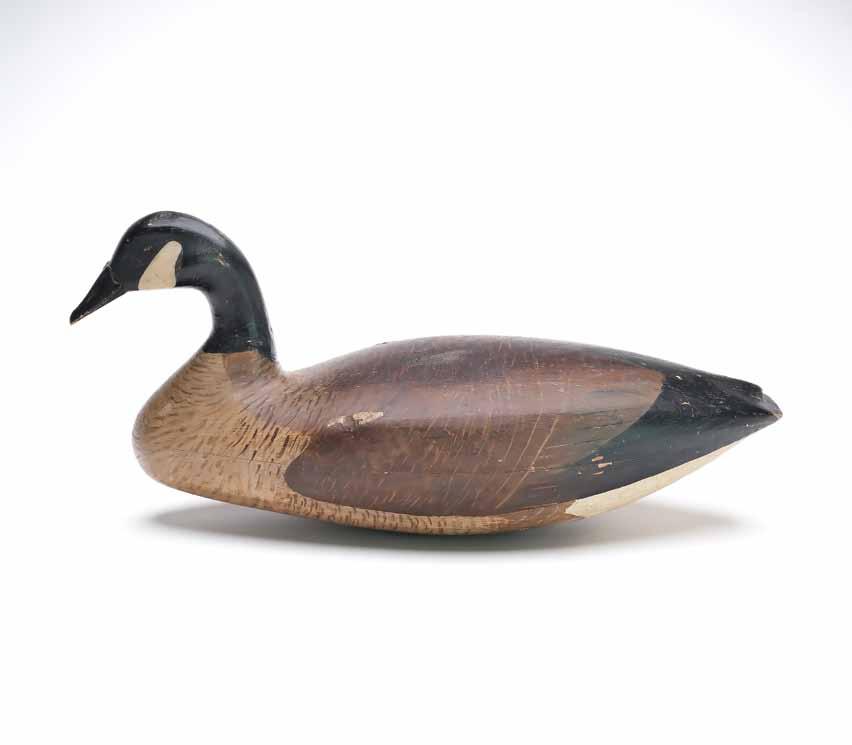
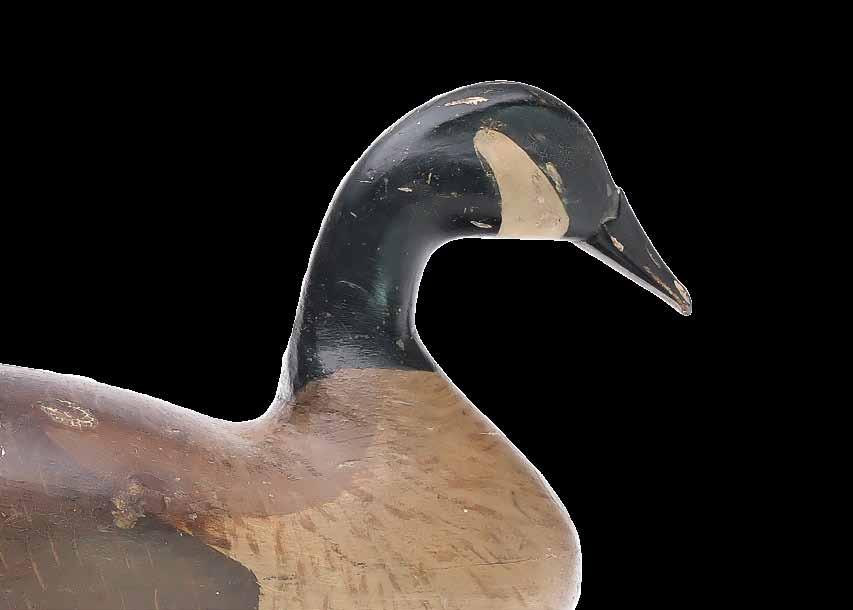
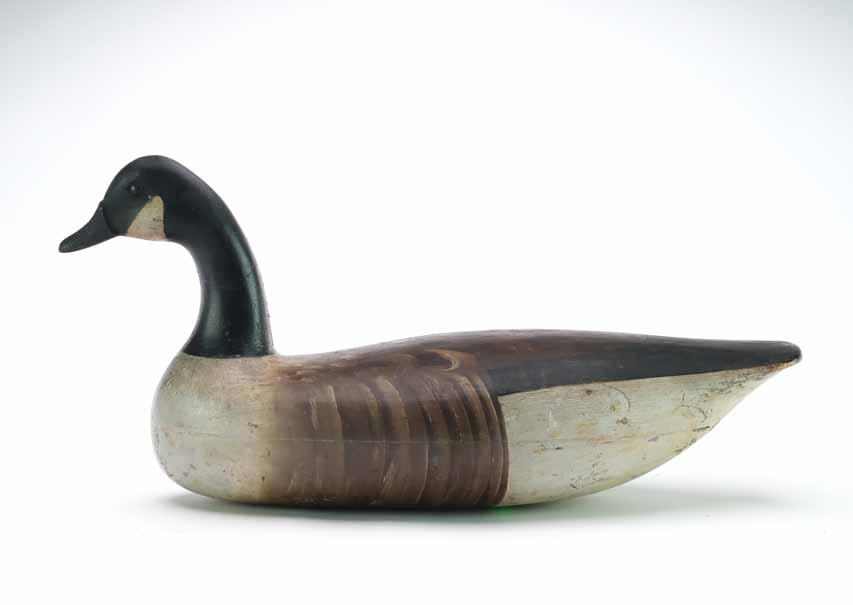
380 Harry M. Shourds (1890-1943), Ocean City, New Jersey. Extremely rare, hollow carved Canada goose with excellent paint detail. Mackey collection ink stamp on the underside. This decoy was part of the Mackey family collection, which were not sold at the Mackey sales in the 1970s, but retained by the family until 2007. Measures 23.75” long. Original paint with minor gunning wear; moderate flaking under tail area and underside; tight crack in bill; cracks in neck were tightened long
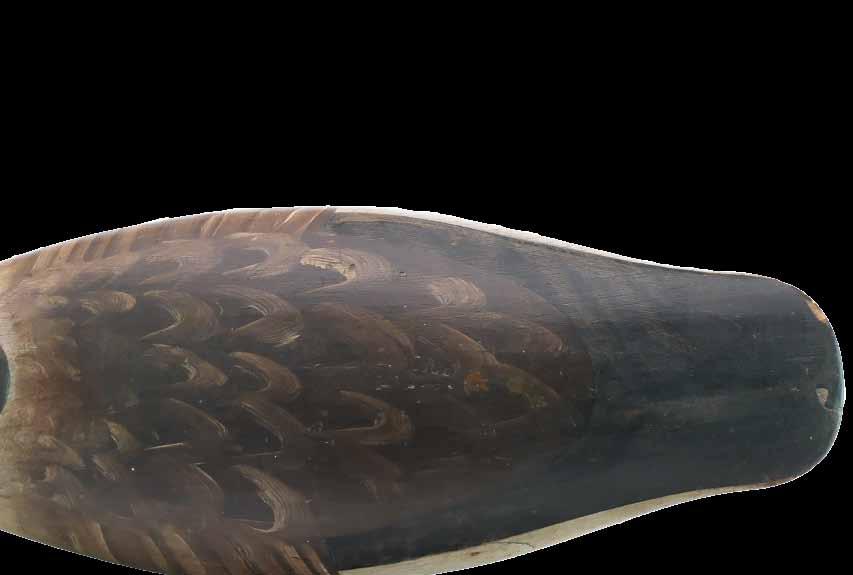
ago with small amount of touch up; among the best known examples.
Provenance: William J. Mackey Jr collection. Mackey family collection. Private southwest collection.
Literature: “Classic New Jersey Decoys”, by James Doherty Jr, page 77, exact decoy pictured.
(20,000 - 40,000)
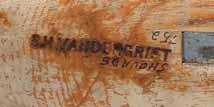
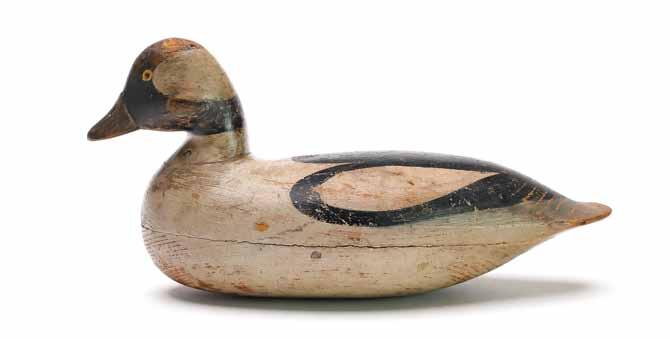

381 Harry V. Shourds (1861-1920), Tuckerton, New Jersey. Rare bufflehead. Hollow carved with inlaid lead weight. Branded “S.H. Vandergrift” on underside. Noyes Museum exhibition stamp on underside. Measures 12.25” long. Original paint with moderate flaking and wear; significant wear to bare wood on underside; half of the bill is a professional replacement; restoration to the neck with paint touchup on neck and area below neck seat.
Provenance: Martin and Deborah Maloy collection. (3,000 - 5,000)
382 Harry M. Shourds (1890-1943), Ocean City, New Jersey. Pair of goldeneye with inlaid lead weights. Measure 13.5” long. Original paint with moderate wear; drying crack in one side of drake’s head; and a tight crack on one side of neck seat; area on underside of drake shaved down long ago, probably to remove a brand; hen with an early tail chip repair; tight drying crack along the back; and a chip in bill that was tightly reset and paint strengthened.
Provenance: Martin and Deborah Maloy collection. (5,000 - 8,000)
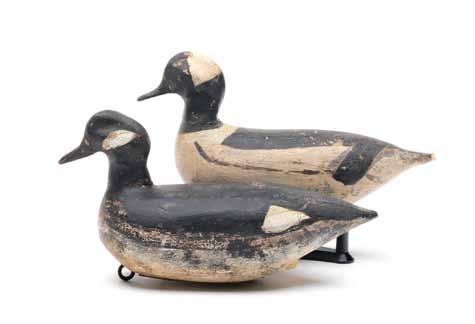

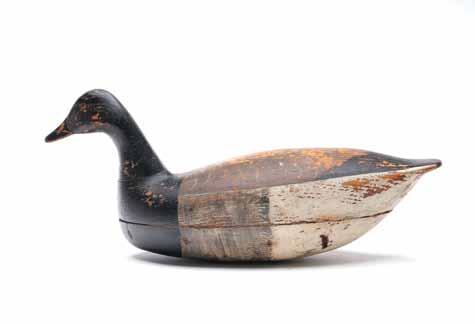
383 Unknown maker, New Jersey, early 20th century. Pair of working bufflehead. Used at the Bonnet Club, Surf City, New Jersey. Balsa bodies. Heads with slight eye groove carving. Measure 9” long. Early in use repaint with moderate flaking and wear; a few dents in bodies; hairline crack at hen’s neck seat; drake’s bill cracked and reset.
Provenance: Bill and Alice Walsh Collection. Obtained from Shirley Hooker, Berryville, VA. (1,200 - 1,800)
384 Nathan Rowley Horner (1882-1942), West Creek, New Jersey. Swimming brant. Hollow carved . Mackey collection ink stamp on lead weight. Measures 17.5” long. Early in use repaint with moderate flaking and wear; slight separation at body seam; tip of bill was chipped off and reglued; area of sap bleed bubbling under tail.
Provenance: William J. Mackey Jr Mackey collection. Martin and Deborah Maloy collection. (1,000 - 1,500)
385 Levi Rhodes Truex (1860-1934), Atlantic City, New Jersey. Swimming brant. Hollow carved with inlayed lead weight and carved eyes. Measures 18.5” long. Original paint with moderate flaking and wear; significant flaking on back; separation to body seam; tight cracks in tail and breast.
Provenance: Martin and Deborah Maloy collection. (1,200 - 1,800)
386 Dude Crane, Tuckerton, New Jersey, circa 1930. Hollow carved brant with tack eyes and inserted, splined bill. “1554” stamped in underside. Measures 20” long. Original paint with minor wear; slight separation at body seam; small ring of touchup where bill meets face. (1,200 - 1,800)
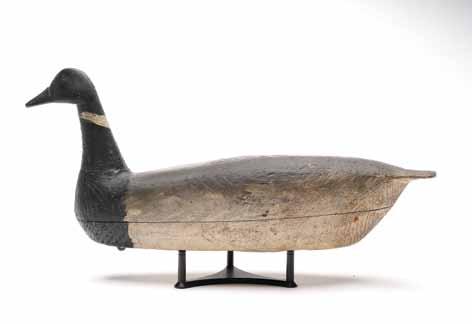
387 Birdsall Ridgeway (1880-1952), Barnegat, New Jersey. Pair of swimming brant. Hollow carved with raised neck seats. Measure 20.5” and 21.5” long. Appealing in use repaint with moderate flaking and wear; small chip on one tail; fine hairline crack in one neck; both lightly hit by shot.
Provenance: Martin and Deborah Maloy collection. (1,500 - 2,500)
388 Walter Bush, New Jersey. Pair of hollow carved black ducks. One in sleeping pose, the other in swimming. Both with inlayed weights and metal number markers. “WLB” carved in underside of each. Measure 15.25” and 19.75” long. Original paint with moderate flaking and wear; some scattered touchups on bodies; hairline crack in swimmers neck, otherwise very good structurally.
Provenance: Rig of Walter Bush. John and Isabelle Hillman collection. Martin and Deborah Maloy collection.
Literature: “The Bird Decoy: an American Folk Art Form” by Paul A. Johnsgard, page 39, exact decoys pictured. (1,200 - 1,800)


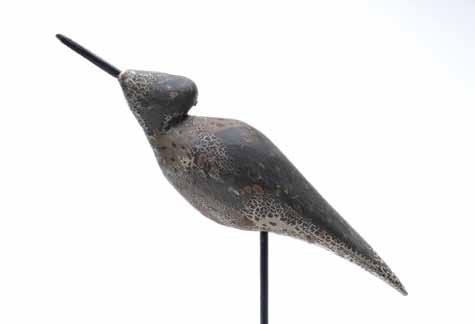


389 Unknown maker, New Jersey, early 20th century. Folky running dowitcher. Measures 11.5” long. Original paint with significant paint shrinkage; some old glue visible where early replaced bill inserts in to face. (800 - 1,200)
390 Unknown maker, New Jersey, early 20th century. Folky running peep. Measures 9” long. Mix of original and early second coat of white on underside; moderate flaking and wear. (800 - 1,200)
391 Unknown maker, New Jersey, late 19th century. Black neck stilt with two piece head and body. Measures 12.5” long. Old in use repaint under an early coat of varnish; nail added in breast to secure the doweled head; iron bill with leather wrapping appears to be original.
Provenance: Martin and Deborah Maloy collection. (1,500 - 2,500)
392 Ephraim Hildreth (1835 - 1915), Rio Grande, New Jersey. Curlew with dropped tail and metal tack eyes. Maker’s brand multiple times on underside. Measures 14.5” long. Very old paint appears mostly original with significant wear; tight crack along body; head was cracked off and reattached with old nails; bill is a professional replacement.
Provenance: Martin and Deborah Maloy collection. (1,200 - 1,800)
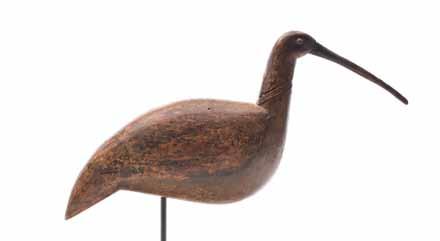
393 Joe King (1835-1913), Manahawkin, New Jersey. Curlew. Measures 13.5” long. Original paint with moderate flaking and wear; thin second coat on white areas; most of the bill is a professional replacement.
Provenance: Martin and Deborah Maloy collection. (1,000 - 2,000)
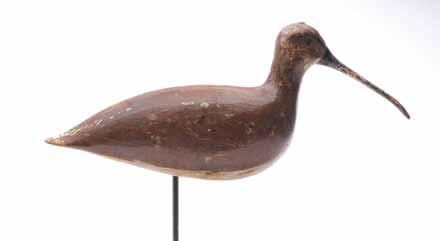
394 Unknown maker, New Jersey, circa 1900. Ruddy turnstone. Measures 9.25” long. Original paint with minor wear; the piece of wood that was used has a piece missing at one side that was not reshaped.
Provenance: Martin and Deborah Maloy collection. (800 - 1,200)

395 Harry V. Shourds (1861-1920), Tuckerton, New Jersey. Black bellied plover in emerging plumage. “JB French” ink stamp in underside. Measures 10” long. Mix of original and very early in use repaint with moderate wear; early coat of varnish has flaked some; professional neck crack repair; bill is an early replacement.
Provenance: Martin and Deborah Maloy collection. (2,000 - 3,000)
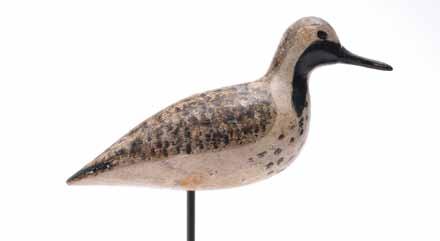
Decoy carver, sportsman, oysterman, artist, politician, naturalist, and conservationist are just a few of those life experiences that identify Charles “Shang” Wheeler. Born in Westport, Connecticut, Wheeler grew up and spent his life hunting and fishing along the Housatonic River and other Connecticut rivers flowing into Long Island Sound.
His achievements in all of the aforementioned fields are far too numerous to mention here, but suffice it to say that he lived life to the fullest and made significant contributions to each of his life’s endeavors. Wheeler’s decoys evolved from the works of Albert
Laing and Benjamin Holmes, the earliest of the Stratford, Connecticut School carvers. He carved a wide variety of decoys, but his output of blackducks far exceeded his production of the other species which included bluebills and scoters and, even to a lesser extent, pintails, goldeneye, canvasback, teal, widgeon, geese, oldsquaw, redheads. “The rarest are wood duck, merganser, ruddy duck, and swans.”
Wheeler achieved national recognition after he started competing in carving contests, and decoy shows. The largest was the first American decoy show held in 1923 in Bellport, Long Island, where he won the “Grand Prize”. Wheeler also exhibited a display of over fifty of his decoys at the National Sportsman’s Show in New York City during the 1940s. Ultimately, after Shang’s death, this display was housed at the Audubon’s Birdcraft Museum in Fairfield, Connecticut where they remained until the collection was sold privately in the early 1980s.
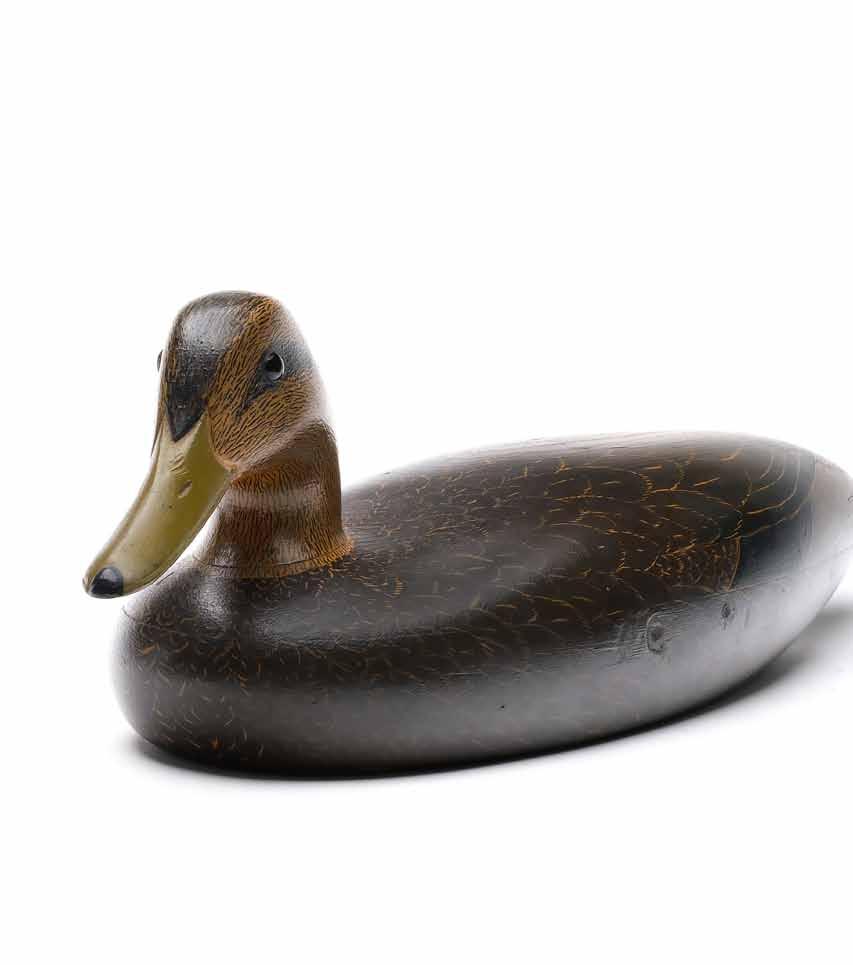
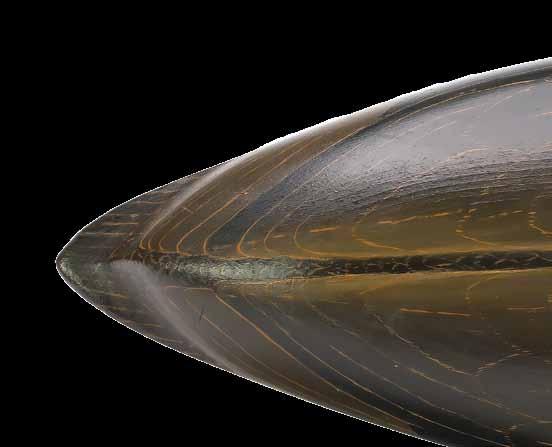
396 Charles E. Shang Wheeler (1872-1949), Stratford, Connecticut. Excellent hollow carved black duck with slightly turned head. Scratch feather paint detail on head and neck. Decoy was never rigged or weighted. Measures 18” long. Excellent original paint protected under an early coat of varnish; shallow dent in bill; a few dents and small scratches were touched up on one side; also with tiny splatters of black paint under tail that are visible under UV light.
Provenance: Madden collection. Private Southern collection. (20,000 - 30,000)
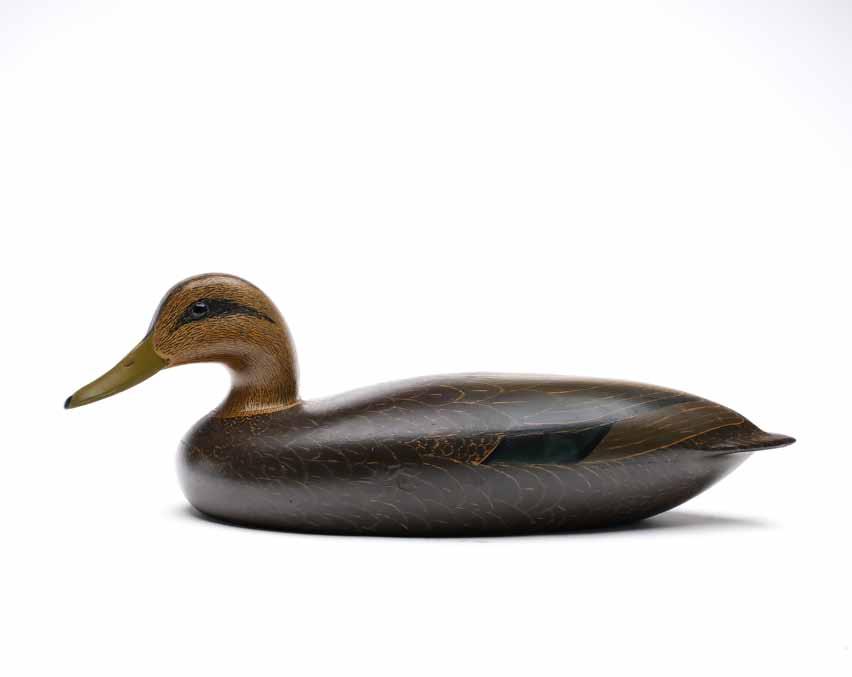
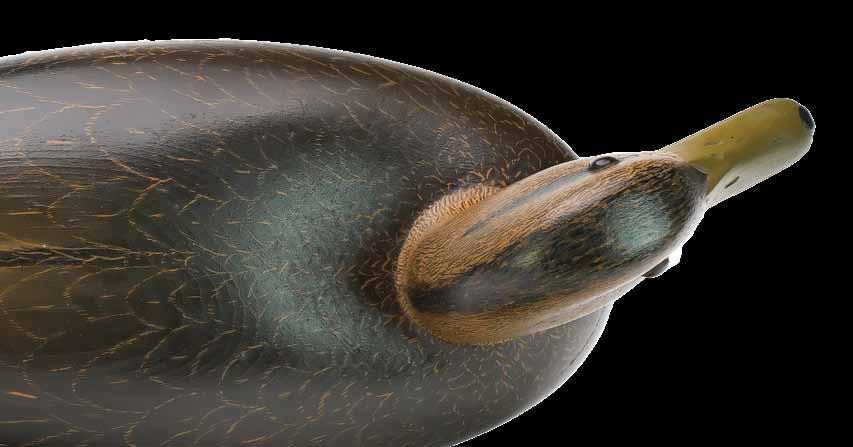
397 Charles E. Shang Wheeler (1872-1949), Stratford, Connecticut. Rare working canvasback. Hollow carved with comb feather paint detail on back. Measures 17.75” long. Original paint with minor wear; a thin wash of white to wear on one side; tight cracks in breast; bill was cracked down and reset with the seam still visible. (5,000 - 8,000)
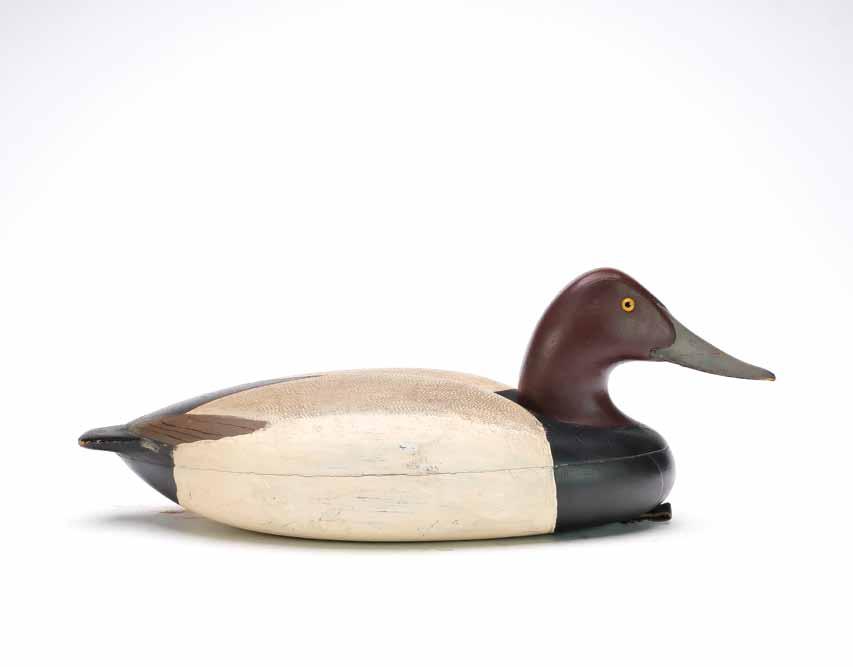

398 Albert Laing (1811-1886), Stratford, Connecticut. Preening surf scoter. Hollow carved with slanted neck seat and relief bill carving. Measures 13.25” long. Old in use repaint with minor wear; drying crack along back, with some filler added near knot; separation at neck seat with small amount of glue and filler visible; long chip along one lower edge; like most Laing scoters the bill has been professionally restored after being carved down for use as a black duck.
Provenance: Martin and Deborah Maloy collection.
(6,000 - 9,000)

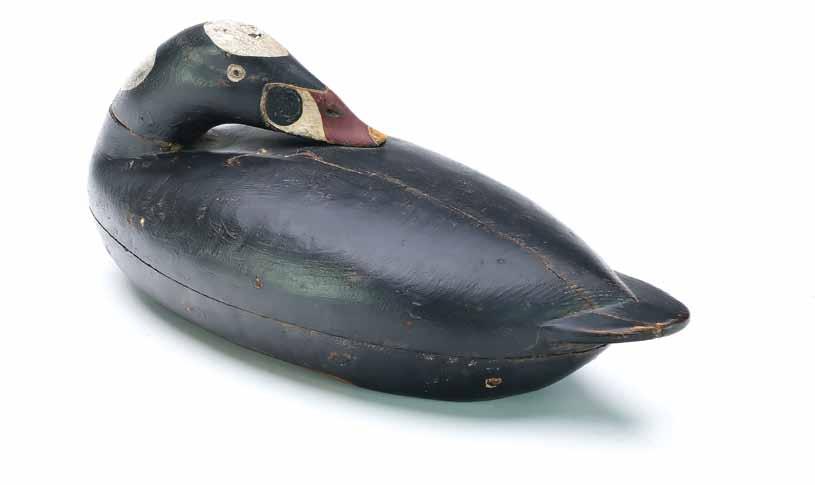
“As a road to final exit, I shall make a decoy myself” - Joel Barber, 1934
Born in upstate NY, Barber was a Cornell University trained architect, practicing at the firm of Delano and Aldrich in New York City during the height of the Art Deco period. After his initial decoy find in 1918, he became thoroughly infatuated with the wooden bird and went on to travel the length of the Atlantic coast, assembling one of the first, and certainly the most famous, early decoy collections. He not only collected for his personal pleasure but documented his finds and promoted their history and study through numerous exhibitions and articles, culminating in publishing his magnum opus, “Wild Fowl Decoys” in 1934.
The book ends with the chapter, “The Modern Decoy” in which Barber, not a hunter himself, attempts to foster the continuance of the tradition of handmade decoys with his own concepts of what he felt would represent the perfect decoy. Drawing on his architectural background, he published the designs for both puddle duck and diver species. These drew upon the combined strengths of all the decoys in his collection from the various regions of the coast and incorporated all the features he felt were needed in a decoy. His birds should float well at anchor being “ a perfect buoy of species” . Their “Material, Construction and portraiture should be of such a nature as to stand up under the hard usage to which decoys are subject ”, and the finished product should give “ The impression of plumage (which) should be obtained by painted patterns that clearly convey species and sex, and are capable of easy repainting ”. In summary, they should be “ - - - economical, practical and showy” .
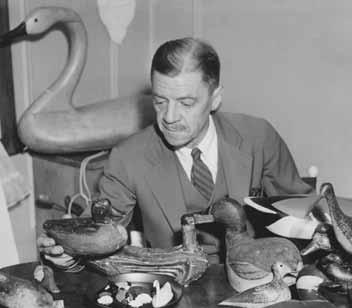
His initial designs were certainly practical but otherwise quite austere, and they were not met with much enthusiasm by fellow collectors, such as Dr Starr, who described them in not quite glowing terms. In 1939, he attempted to address the concerns and, in Van Campen Heilner’s, “A Book On Duck Shooting”, he published updated versions of the plans which met with far greater acclaim.
In later years, there was a failed attempt at starting the “Joel Barber Decoy Company” and, in 1946, he rejected a request from the The Animal Trap Company to design a decoy for them. Ultimately, he did work with his friend Ted Mulligan to design a black duck for Mulligan’s, ‘Wildfowler Decoys’ in Old Saybrook, CT.
In discussing his own efforts, Barber would lament “Many of the old makers have passed out of the picture and with them their knowledge and skill “. “Confronted now with much more difficult problems, I like to think that the experience of these men will not be lost but used as a point of departure in our efforts to improve”.
Barber’s collection now resides in the Shelburne Museum in Vermont. Both in his lifetime and beyond, Joel Barber did, indeed, make many lasting contributions to the decoy and larger folk-art communities, including his designs for “The Modern Decoy”.
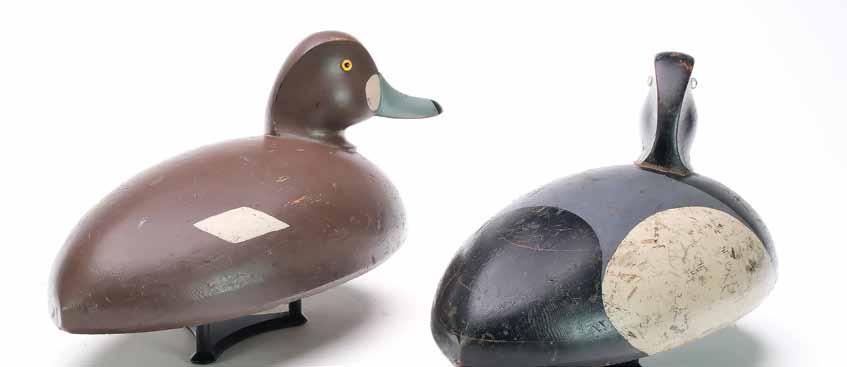

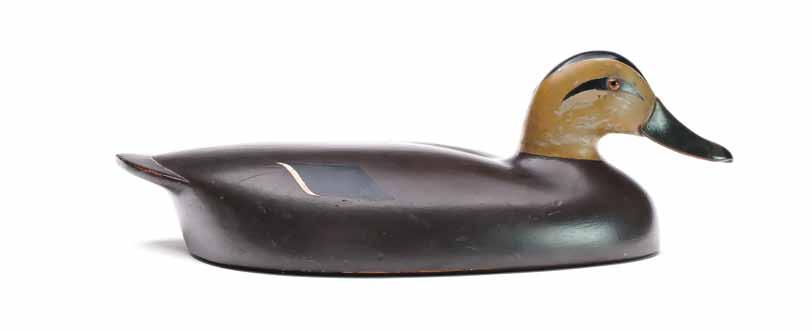
399 Joel Barber (1877 - 1952), Wilton, Connecticut. Rigmate pair of bluebills with inlet neck seats and slightly turned heads. Both with wooden keels and maker’s brand in underside. Measure 14.5” and 15” long. Original paint with minor gunning wear; scattered dents and paint rubs; some separation at drake’s neck seat with a tight crack at front left corner of neck seat.
Provenance: Bill and Alice Walsh Collection. One obtained at July 1982 Bourne Auction. Came from Tim Eastland to Dixon Merkt to Phyllis Elliston to Quandy Collection (Bob Creighton, Harwich). Other obtained from Dixon Merkt who obtained from Hal Sorenson. Date obtained September 25, 1982.
Literature: “New England Decoys” by Shirley and John Delph, page 76, exact drake pictured. (4,000 - 6,000)
400 Joel Barber (1877 - 1952), Wilton, Connecticut. Black duck. Slight relief wingtip carving. Maker’s brand on the underside. Measures 16.5” long. Original paint with minor wear, under a coat of varnish; varnish on sides of head has flaked some; shallow dents otherwise excellent structurally.
Provenance: Bill and Alice Walsh Collection. Obtained at July 1983 Bourne Auction, Hyannis, MA, #601 in catalog. (1,500 - 2,500)
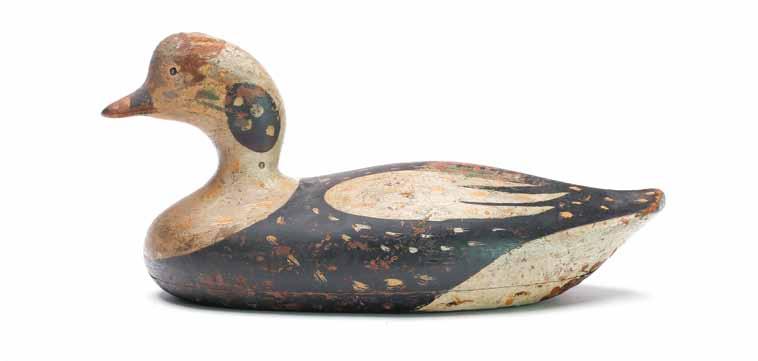

401 William Bowman (1824-1906), Lawrence, Long Island. Long-tail duck. Thinly hollowed with .75” bottom board, inlayed neck seat, and carved eyes. Measures 16” long. Mix of original and very early in use repaint with significant flaking and wear; dents and shot marks; drying crack along one side with old glue added; fine crack through neck; wooden patch to bottom board under tail.
Provenance: Martin and Deborah Maloy collection. (3,000 - 5,000)
402 William Bowman (1824-1906), Lawrence, Long Island. Brant. Hollow carved with inlet neck seat and large glass eyes. “Edgar” branded on underside. Measures 17” long. Original paint with significant flaking and wear; hairline cracks near eyes; tight drying crack under tail; tightly reglued crack through neck.
Provenance: Martin and Deborah Maloy collection.
Literature: “Decoys: A North American Survey” by Gene and Linda Kangas, page 203, exact decoy pictured. (4,000 - 6,000)
403 Smith Clinton Verity (1845-1920), Seaford, Long Island, New York. Root head brant. Measures 16” long. Original paint with moderate flaking and wear; minor roughness on edge of tail; vertical drying crack at back of neck; lightly hit by shot.
Provenance: Deborah and Martin Maloy collection. (1,500 - 2,500)
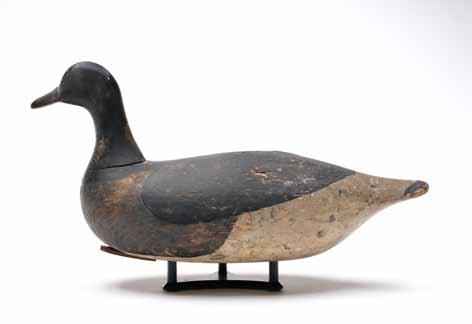
404 Unknown maker, Long Island, New York, early 20th century. Folky hollow carved brant, with head turned preening back feathers. “H.O. Kruger Patchagoue area 1920s” written on underside. Measures 15.5” long. Original paint with moderate flaking and wear; lightly hit by shot; hairline cracks in one side of neck; tight crack in underside of tail area.
(3,000 - 5,000)
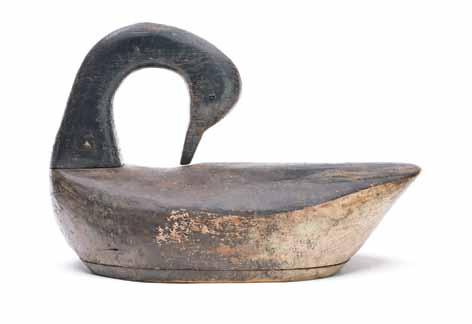
405 David Cochran, Blue Point, Long Island, New York, circa 1900. Plump body brant with slightly swimming root head. From the WL Suydam rig, and so branded. Measures 19” long. Original paint with very minor wear; drying split in underside; wooden keel was removed at some point; hairline vertical crack on one side of neck seat.
Provenance: Martin and Deborah Maloy collection. (1,000 - 1,500)
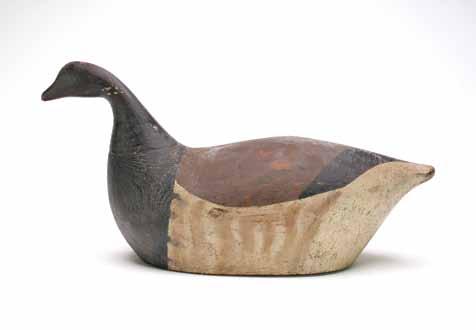
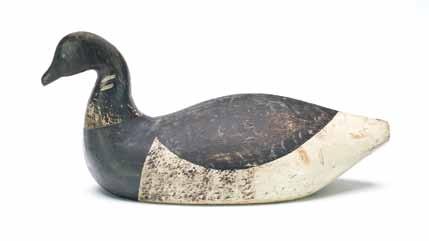
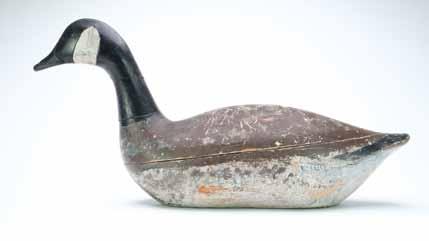
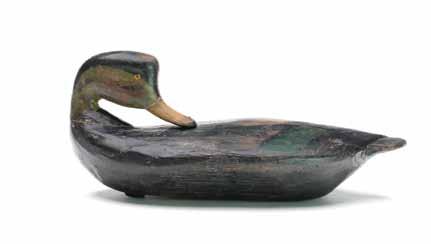
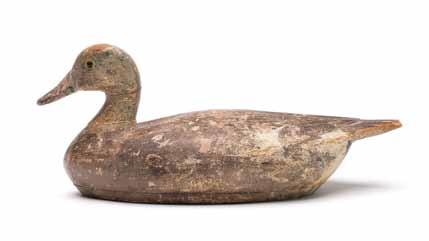
406 Lemuel Ackerly (1873-1940), Patchogue, Long Island. Brant with distinctive ridge along center of back. “E.Thorne” branded on underside. Also with Mackey collection ink stamp. Measures 16” long. Original paint with moderate flaking and wear, mostly at neck seat; flaking on head was darkened at some point; vertical cracks at base of neck.
Provenance: Martin and Deborah Maloy collection. (1,200 - 1,800)
407 William Bowman (1824-1906), Lawrence, Long Island. Rare hollow carved Canada goose. Slightly forward head pose with carved eyes and hole drilled in underside for use as a stickup. Mackey collection ink stamp on underside. Believed by many to be the work of Charles Sumner Bunn. Measures 28.5” long. Early working repaint with significant flaking and wear to body; crack through neck; tip of bill is an early replacement; separation at body seam; drying cracks and loss to wood on one side.
Provenance: Bill and Alice Walsh Collection. (2,000 - 3,000)
408 Albert Terry (1838-1931), Riverhead, Long Island, New York. Very rare preening black duck. “AT” carved in underside. Measures 15.5” long. Original paint with moderate to significant flaking and wear; under an early coat of varnish or wax; loss to wood near knot in back; some filler added to a defect in wood on one side; tight cracks in neck and body.
Provenance: Martin and Deborah Maloy collection. (4,000 - 6,000)
409 Stephen Verity (1865-1950), Seaford, Long Island. Hollow carved widgeon with slight relief wingtip carving. Branded “J.H. Purdy” on underside. With two other brands that are mostly illedgible. Mackey collection ink stamp on underside. Measures 14.5” long. Original paint with significant wear; tight crack through neck; old chip at tip of tail; head swivels.
Provenance: Bill and Alice Walsh Collection. Obtained from Rita Spitzli in 1986. (600 - 900)
410 New Jersey, blue heron, 19th century. Unknown maker. Two piece body construction with an extended and slightly turned head position, likely made from a root or branch. Hollow carved, which is very rare for heron decoys. Muller stamped on underside. Measures 33” long. Old working paint has been strengthened to most areas over time; flaking to bare wood; a few cracks.
Provenance: William J. Mackey Jr. Collection. William H. Purnell Jr. Collection. Dr. Peter J. Muller Jr. Collection. Martin and Deborah Maloy collection. (5,000 - 8,000)

410
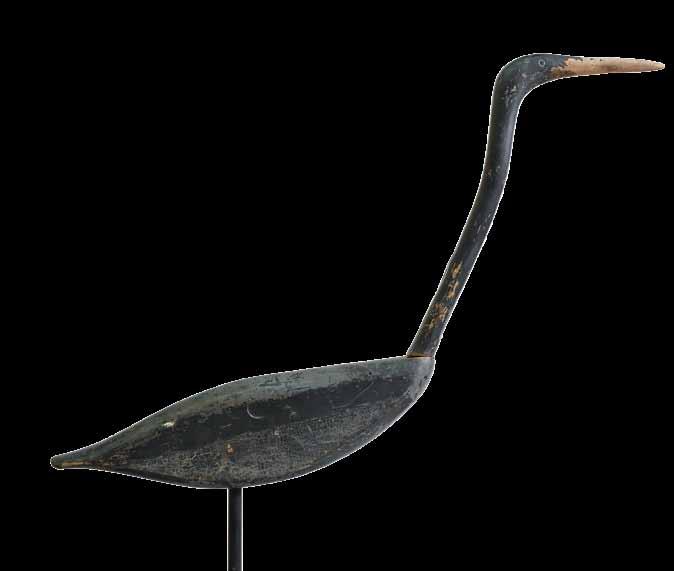
411 Unknown maker, Long Island, New York, late 19th century. Root head heron with carved eyes and removable head. Body is made from a 2.25” wide board. Adele Earnest collection ink stamp on underside and on dowel that inserts in to neck seat. Measures 32” long. Stand included. Early in use repaint with moderate flaking and wear; lightly hit by shot; small chip at neck seat; round dent in one side.
Provenance: Martin and Deborah Maloy collection. (4,000 - 6,000)
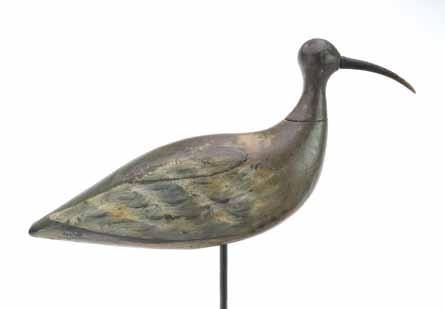
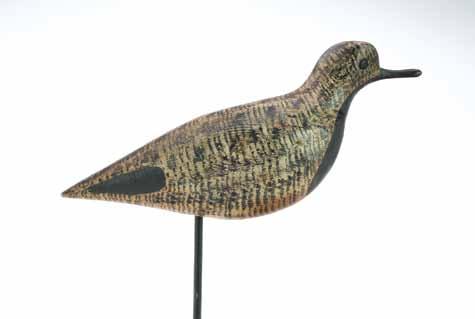
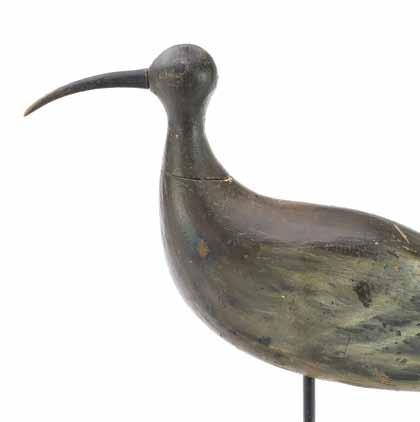
412 Alonzo Foster (1841-1913), Hampton Bays, Long Island, New York. Two piece curlew with bulbous head and appealing paint detail. Museum inventory number in red paint on underside. Measures 11.5” long. Original paint with very minor gunning wear; under a thin coat of varnish that has darkened with age; separation at wood grain on one side had nails and small amount of filler added long ago; bill is a professional replacement with old touchup where bill meets face.
Provenance: Mike and Ginger Raffia collection. (6,000 - 9,000)
413 Daniel Demott (1847-1930), East Rockaway, New York. A plump, carved-eye model black bellied plover. Measures 10.5” long. Original paint with very minor discoloration and wear; tight crack along one side of neck; imperfection in wood on the other side of neck from when the decoy was made.
Provenance: Davison Hawthorne collection. Mike and Ginger Raffia collection. (4,000 - 6,000)
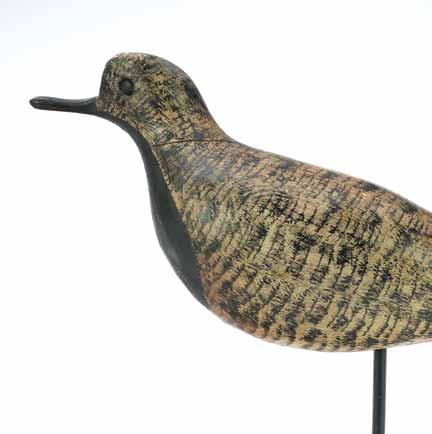
414 Thomas Gelston (1850-1924), Quogue, Long Island, New York. Rare dowitcher or lesser yellowlegs with relief wing carving and small bead eyes. Measures 8.5” long. Original paint with moderate gunning wear under a early coat of varnish; heavily hit by shot; bill is an early replacement; professional tail chip repair.
(2,000 - 3,000)
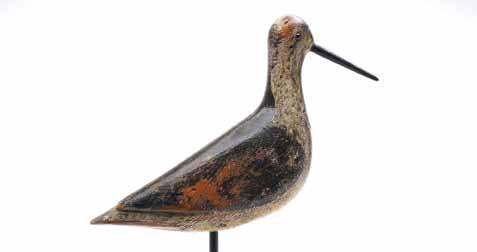
415 Obediah Verity (1813-1901), Seaford, Long Island, New York. Black bellied plover with relief wing carving and carved eyes. Measures 10.75” long. Original paint with moderate flaking and wear; early coat of varnish has darkened with age; second coat to black on breast and wingtips; heavily hit by shot. (2,000 - 4,000)
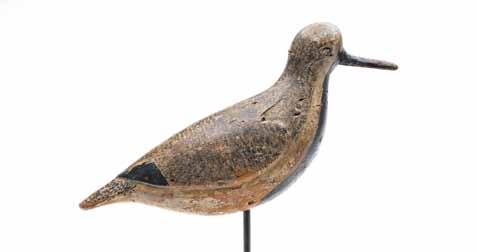
416 Valentine Watts, Lawrence, New York. Yellowlegs with relief wing carving and raised wingtips. “W” carved in underside. Measures 12.5” long. Original paint on back and sides with minor wear; tight drying cracks and shot marks on breast were filled and the breast and underside repainted; chip out of one eye and hairline crack in the other; area on underside near stick hole was carved down possibly to remove a brand. (1,000 - 1,400)
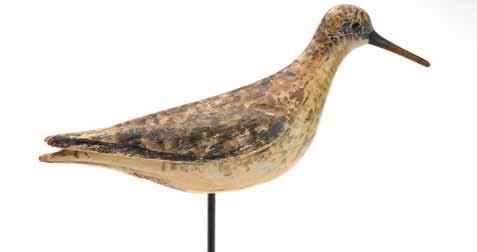
417 Chief Eugene Cuffee (1861-1941), East Hampton, New York. Curlew with bone bill and applied dropped wings. Measures 14.5” long. Original paint with moderate crazing and minor wear; professional repair to a chip in each wingtip; small amount of touchup where bill meets face.
Provenance: Dean Hyde collection. (800 - 1,200)
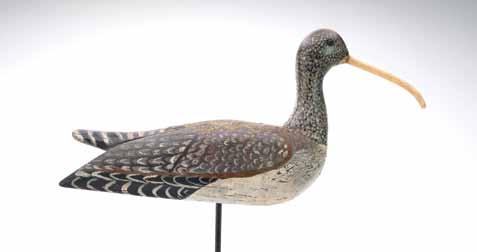
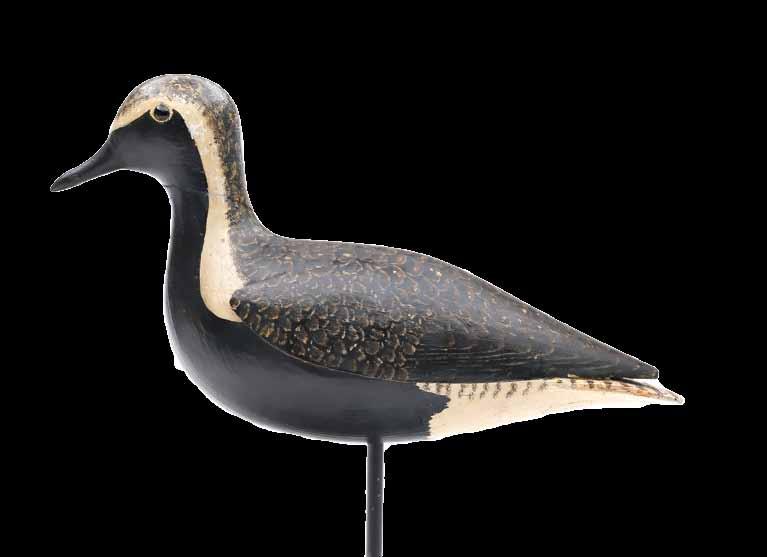
418 Thomas Wilson (1865-1936), Ipswich, Massachusetts. Black bellied plover with deep relief wing carving and wide tail. Measures 12” long. Original paint with very minor wear; under an early coat of varnish; cracks through neck were reset and touched up; two spots of white paint on underside possibly to cover writing.
Provenance: Ted and Judy Harmon collection. (12,000 - 18,000)
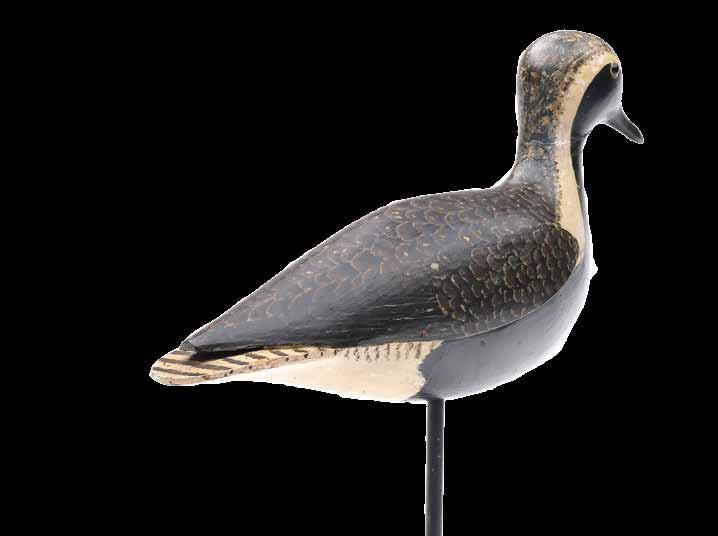
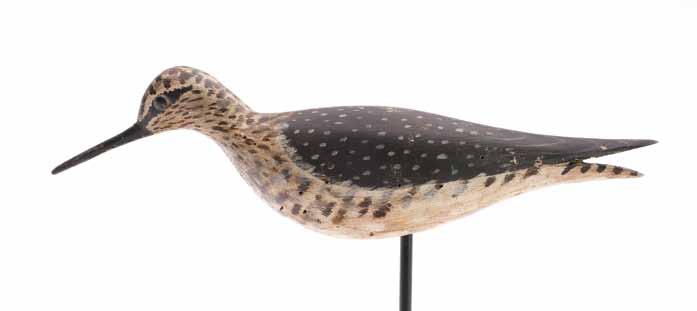

419 A. Elmer Crowell (1862-1952), East Harwich, Massachusetts. Running yellowlegs with split tail carving and tack eyes. Measures 12” long. Original paint with very minor wear; lightly hit by shot; small wingtip repair; bill is a professional replacement; area of filler and touchup on one side.
Provenance: Tom Karras collection. (4,000 - 6,000)
420 Joseph Lincoln (1859-1938), Accord, Massachusetts. Extremely rare ruddy turnstone with raised wingtips and large tack eyes. Measures 9” long. Original paint with moderate wear; tiny chip and roughness on raised wingtips, otherwise very good structurally.
Provenance: Ted and Judy Harmon collection.
Literature: “Joseph W. Lincoln” by Cap Vinal, page 61, exact decoy pictured. (4,000 - 6,000)
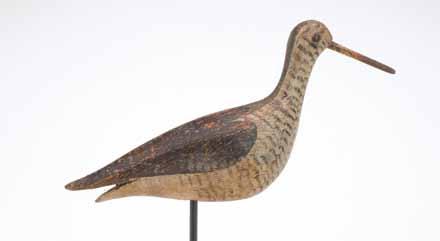
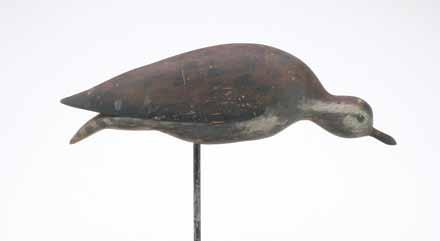

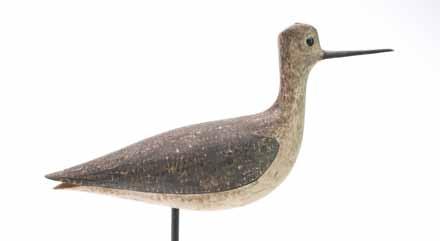
421 Joseph Lincoln (1859-1938), Accord, Massachusetts. Yellowlegs with split tail carving and tack eyes. Measures 10.75” long. Original paint with moderate flaking and wear; very good structurally.
Provenance: Ted and Judy Harmon collection. (1,500 - 2,500)
422 Unknown maker, Massachusetts, late 19th century. Feeding golden plover with relief wing carving and painted eyes. Measures 11.5” long. Original paint with minor to moderate wear; bill is a professional replacement.
Provenance: Ted and Judy Harmon collection. (2,000 - 3,000)
423 Unknown maker, Massachusetts, early 20th century. Yellowlegs with scratch feather paint detail. “F.M.Nichols” branded on underside. Measures 11.75” long. Original paint with moderate wear; reglued crack through neck; oak dowel is glued in to stick hole.
Provenance: Ted and Judy Harmon collection. (2,000 - 3,000)
424 George Boyd (1873-1941), Seabrook, New Hampshire. Classic yellowlegs with split tail carving and shoe button eyes. Measures 11” long. Original paint with minor wear; fine and stable crazing on much of the decoy; very fine hairline crack in one side of neck; otherwise excellent structurally. (3,000 - 5,000)
425 Elisha Burr (1839-1909), Hingham, Massachusetts. Black bellied plover with deep relief wing carving and extended wingtips. Measures 10.75” long. Original paint with moderate wear; under an early coat of varnish; small spot of touchup to a dent in one side of breast; small chip at one wingtip was tightly reset; bill is professional replacement; hairline crack in one side of neck.
Provenance: Tom Karras collection. (3,000 - 4,000)
426 Walter Savary (1855-1936), Wareham, Massachusetts. Feeding dowitcher with carved eyes and split tail carving. Measures 10.5” long. Original paint with moderate to significant flaking and wear; lightly hit by shot; bill is a professional replacement.
Provenance: Ted and Judy Harmon collection. (4,000 - 6,000)
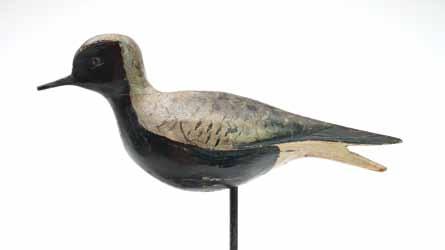
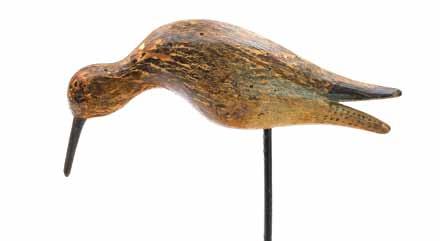
427 Unknown maker, Massachusetts, late 19th century. Black bellied plover with split tail carving and brass tack eyes. Measures 11.25” long. Original paint with minor flaking and wear; an old coat of varnish has darkened with age; bill appears original.
Provenance: Dean Hyde collection. (800 - 1,200)
428 Unknown maker, 19th century, Massachusetts. Black bellied plover with raised wingtips and large bead eyes. Grant Nelson ink stamp on the underside. Measures 11.25” long. Original paint with moderate flaking and wear; small chip in one edge of tail; shallow chips on top of each raised wingtip were shaved down long ago and left unpainted; bill is a professional replacement.
Provenance: Grant Nelson collection. Tom Karras collection. (1,500 - 2,500)
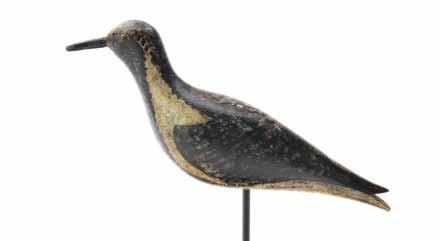
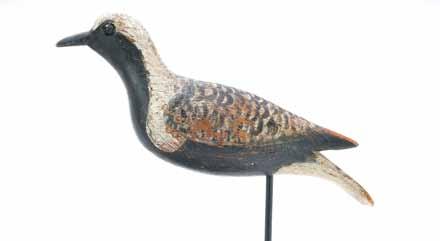
429 Lothrop Holmes (1821-1899), Kingston, Massachusetts. Yellowlegs with tack eyes with split tail. Measures 13” long. Original paint that has worn down through moderate use; several shot scars; very small amount of old restoration around shoulder groove on each side; small amount of touch up near one eye; bill appears to have been replaced. (3,000 - 4,000)
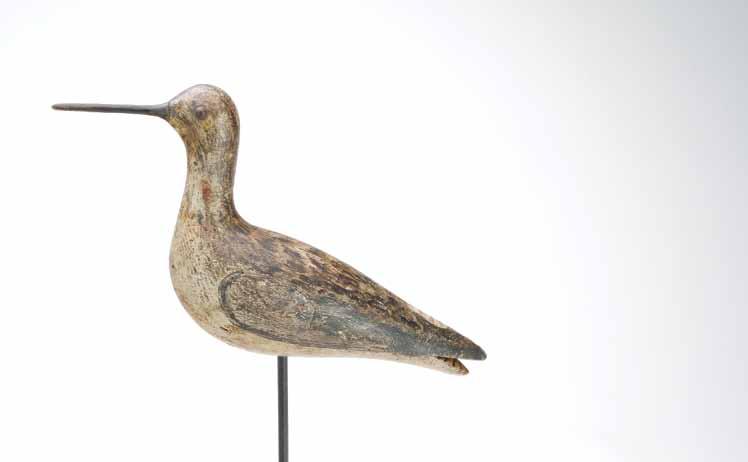
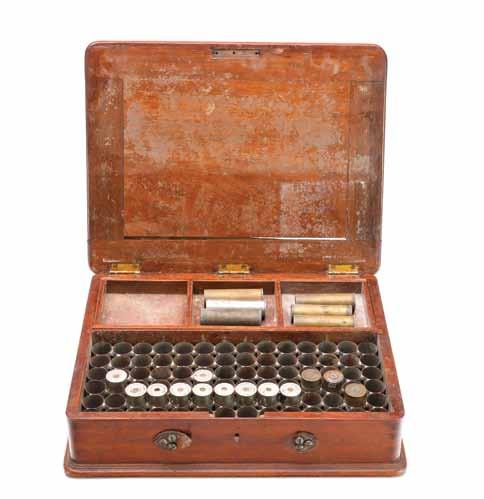
430 Lothrop Holmes (1824-1899), Kingston, Massachusetts. Last quarter 19th century. Personal gunning box of Lothop Holmes. With “LT Holmes” engraved brass plate embedded in the lid of the box which is hinged and opens up in to two compartments. One with a removable three compartment tray. Other with metal shell holder, which retains 20 brass shells, most of which are 10 gauge. Two are Winchester 8 gauge. Box measures 11.5” x 14.5”, and is 4” tall. Probably made from mahogany. Structurally there is some separation at joints; leather handle and lock mechanism are both missing.
Literature: “Massachusetts Masterpieces: The Decoy as Art” by Gwladys Hopkins, page 102, exact box pictured. (1,000 - 2,000)
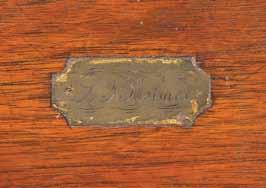
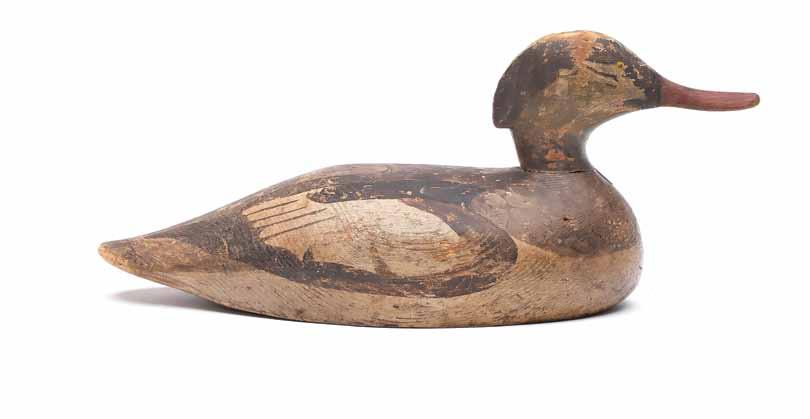
431 Lothrop Holmes (1824-1899), Kingston, Massachusetts. Rare merganser hen with extended crest. Flat bottom style. Measures 14.5” long. Thin original paint with moderate to significant wear; small dents and shot marks; dowel above nail on top of head is missing; bill is a professional replacement.
Provenance: Ted and Judy Harmon collection. (2,500 - 3,500)

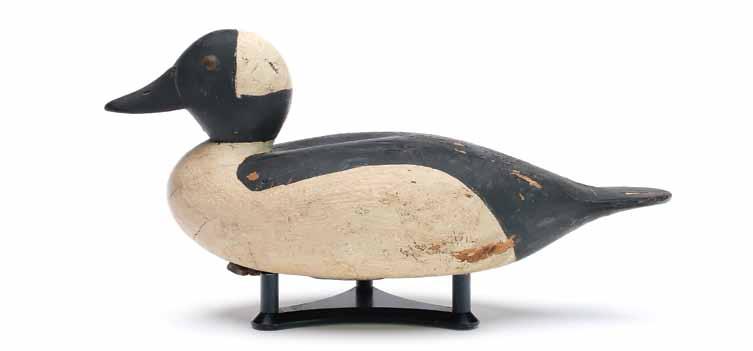
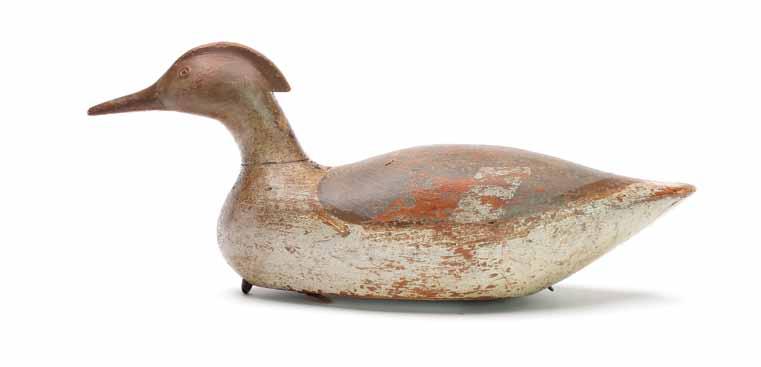
432 Joseph Lincoln (1859-1938), Accord, Massachusetts. Rare bufflehead. Raised neck seat and tack eyes. “LLS” branded twice on underside. Measures 12” long. Early second coat of paint with minor flaking; a few small dents and tight drying cracks. (2,500 - 3,500)
433 Gordon Mann (1871-1958), Rockland, Massachusetts. Swimming merganser hen with extended crest carving and metal eyes. Measures 17.25” long. Original paint with moderate to significant flaking and wear; lightly hit by shot; hairline cracks at tail; chip in tip of bill was professionally restored.
Provenance: Adele Earnest collection. R.O. Coyle collection. Private New England collection.
Literature: “The Bird Decoy: an American Folk Art Form” by Paul A. Johnsgard, page 81, exact decoy pictured. (3,000 - 5,000)
434 David Goodspeed (1863-1943), Duxbury, Massachusetts. Pair of mergansers. Hen with slightly turned head. Drake with relief carved feet on sides of body. Measure 17.25” long. Original paint with moderate wear; some restoration at both neck seats; undersides were planned down.
Provenance: Ted and Judy Harmon collection. (5,000 - 8,000)
435 Unknown maker, Cape Cod, Massachusetts, circa 1900. American merganser. Excellent form with raised neck seat, deep relief wing carving, and thin paddle tail. “Kangas” and “MR35” stamped under tail. Measures 19” long. Original paint with moderate wear; tight crack through neck; lightly hit by shot; some of the flaking on head was darkened; bill is a very well done professional replacement.
Provenance: Ted and Judy Harmon collection. (3,000 - 5,000)

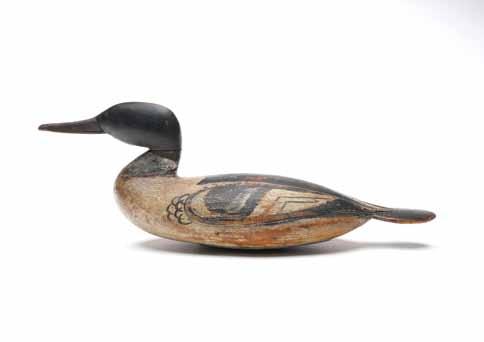
436 Unknown maker, Maine, early 20th century. Breast preening goldeneye with inlet neck seat. Five bore holes drilled in underside. Measures 13” long. Mix of original and early in use repaint with moderate flaking and wear; small patches to defects in wood; tight crack through neck; old repair to tip of bill; dents and shot marks on back.
Provenance: Ted and Judy Harmon collection.
Literature: “American Vernacular” by Frank Maresca and Roger Ricco, page 36, exact decoy pictured. (1,000 - 2,000)
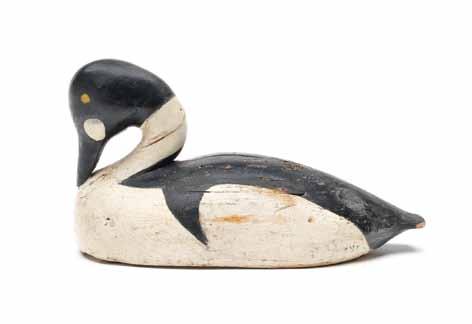
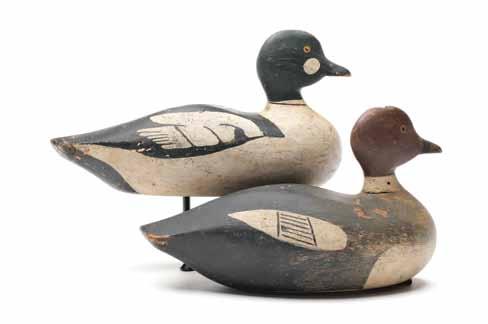
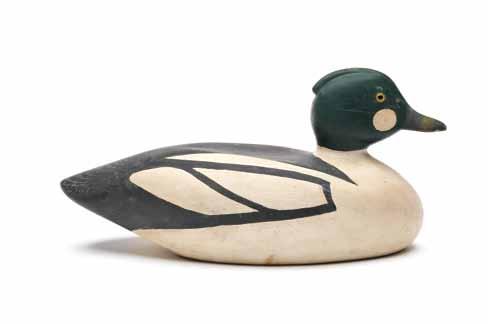

437 Lothrop Holmes (1821-1899) or Clinton Keith (1887-1975), Kingston, Massachusetts. Pair of goldeneye. Drake with the Dr. George Ross Starr collection ink stamp on the underside. Measure 12.5” and 13.5” long. Hen in original paint with moderate flaking and wear; lightly hit by shot; drake in early working repaint; with flaking and wear; head swivels; small knot visible at edge of tail.
Provenance: Dr. George Ross Starr collection. Ted and Judy Harmon collection. (1,500 - 2,500)
438 Clinton Keith (19th century), Kingston, Massachusetts. Goldeneye with relief carved head feathers. “C.T. Keith” branded on underside. Decoy was never rigged or weighted. Measures 13.5” long. Original paint with very minor wear; hairline cracks in neck and one side of head.
Provenance: Ted and Judy Harmon collection. (500 - 800)
439 Charles Hart (1862-1960), Gloucester, Massachusetts. Rare decorative bluewing teal. With relief wing and tail feather carving. Measures 11” long. Excellent original paint under the original coat of varnish; hairline crack in tail; otherwise excellent structurally.
Provenance: Ted and Judy Harmon collection. (3,000 - 5,000)
440 Keyes Chadwick (1865-1958), Oaks Bluff, Massachusetts. Preening black duck from the Foote rig. “Foote” branded in underside. “TH” stamped in underside. Measures 16.5” long. Original paint with moderate wear; drying crack along the back; filled split along one side that has opened; a few spots on back were filled and touched up likely where nails were added to secure drying cracks; slight separation at neck seat.
Provenance: Ted and Judy Harmon collection. (1,200 - 1,800)
441 Keyes Chadwick (1865-1958), Oaks Bluff, Massachusetts. Redhead. Inlaid lead weight in underside. Measures 15.5” long. Original paint with very minor wear under an early coat of varnish that has darkened with age; drying crack in back was filled with thin line of touchup and has opened slightly. (1,500 - 2,500)

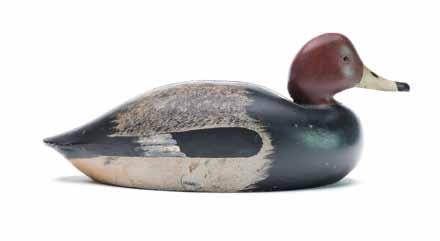
442 Keyes Chadwick (1865-1958), Oaks Bluff, Massachusetts. Bluebill hen with slightly turned head and inlayed lead weight. Measures 13.25” long. Drying crack along the underside runs partway up breast and under tail; otherwise excellent and original.
Provenance: Ted and Judy Harmon collection. (700 - 1,000)
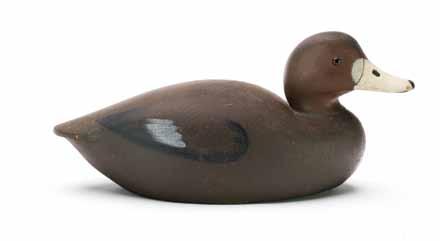
443 Keyes Chadwick (1865-1958), Oaks Bluff, Massachusetts. Merganser hen with reared back head and extended crest feathers. Round inlaid weight on underside. Measures 19.5” long. Original paint with minor wear; very good structurally.
(2,500 - 3,500)
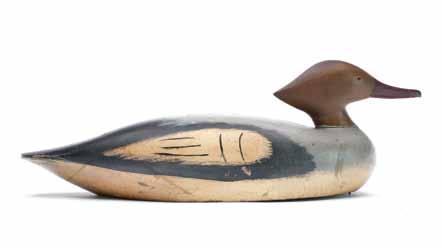



444 Unknown maker, Massachusetts, 20th century. Pair of greenwing teal with glass eyes and slight crest carving. Ted Harmon attributed these decoys to William Dugan of Martha’s Vineyard. Measure 10” and 10.5” long. Original paint with moderate flaking and wear; under an early coat of varnish; lightly hit by shot; hen’s bill was cracked down and professionally reset; drake’s bill is professional replacement.
Provenance: Ted and Judy Harmon collection. (3,000 - 5,000)
445 Luther Nickerson (1874-1951) Cotuit, Massachusetts. Goldeneye hen with relief wing carving and slightly turned head. Measures 14.75” long. Original paint with moderate wear; under an early coat of varnish; minor roughness on edge of tail and at each wing edge; small losses at knots in body; lightly hit by shot; neck is a professional replacement.
Provenance: Ted and Judy Harmon collection. (2,000 - 3,000)
446 Unknown maker, Martha’s Vineyard, early 20th century. Hollow carved widgeon with carved eyes. Measures 14.25” long. Original paint with moderate crazing and minor wear; old chip in underside of bill was touched up; minor roughness on tip of tail; head swivles.
Provenance: Ted and Judy Harmon collection. (800 - 1,200)
447 Benjamin Smith (1866-1946), Oak Bluffs, Martha’s Vineyard, Massachusetts. Merganser hen with slightly turned and reared back head. Tack eyes. Measures 17.25” long. Mix of original and early in use repaint; lightly hit by shot; half of the bill is a professional replacement.
Provenance: Ted and Judy Harmon collection. (1,500 - 2,500)
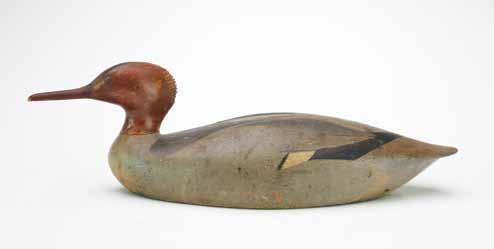
448 Unknown maker, Mattapoisett/ Marion area, Massachusetts, early 20th century. Black duck with tack eyes and wide cheek carving. Two piece body with 1” bottom board. Measures 17” long. Original paint with minor to moderate gunning wear; lightly hit by shot; thin line of filler and touchup at neck seat.
Provenance: Ted and Judy Harmon collection. (1,000 - 1,500)
449 Gordon Mann (1871-1958), Rockland, Massachusetts. Mallard with relief wingtip carving. “GM” stamped in underside. Measures 16.5” long. Original paint with very minor wear; under a thin coat of varnish that has darkened with age; very good structurally.
Provenance: Ted and Judy Harmon collection. (1,500 - 2,500)
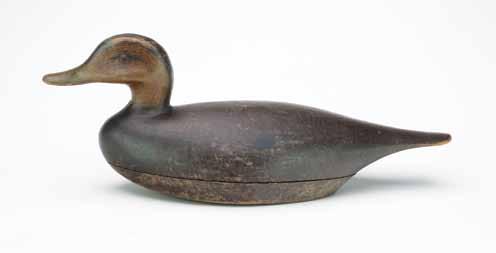
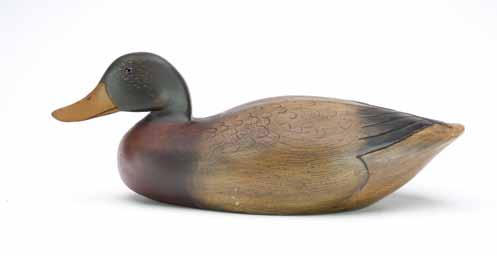
450 Joseph Lincoln (1859-1938), Accord, Massachusetts. Nesting set of five white wing scoters. Five pairs of nesting silhouettes. Each board is approximately 26” long. Decoys are 18”. All are in original paint with moderate wear from use.
Provenance: Ted and Judy Harmon collection. (1,500 - 2,500)
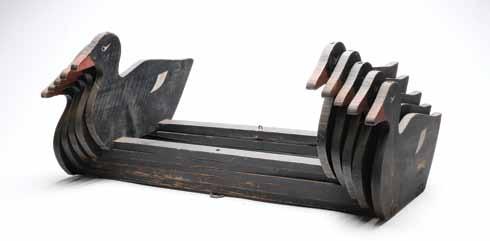
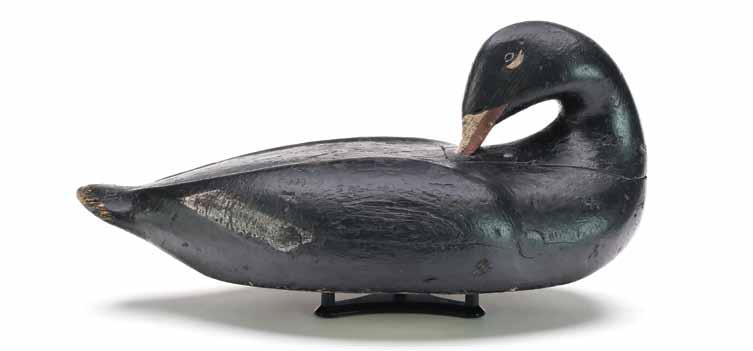
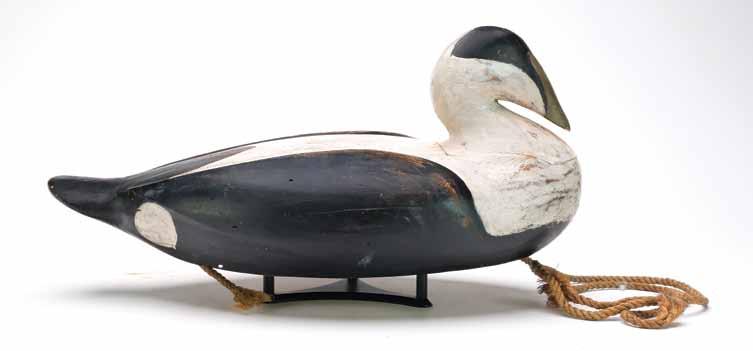
451 Augustus “Gus” Wilson (1864-1950), South Portland, Maine. Early Monhegan style preening scoter with relief wing carving and large inlet neck seat. Measures 16” long. Old in use repaint with moderate flaking and wear; many dents and shot marks; shallow chipping and roughness on edge of tail; body was made from two pieces of wood with separation at the seam.
Provenance: Martin and Deborah Maloy collection. (4,000 - 6,000)
452 Augustus “Gus” Wilson (1864-1950), South Portland, Maine. Early Monhegan style eider with relief wing carving and inlet neck seat. Relief bill carving and carved eyes. Measures 18.5” long. Much of the black appears to be original; white areas have had an early second coat taken down; lightly hit by shot; small chip on edge of tail; otherwise very good structurally.
Provenance: Martin and Deborah Maloy collection. (4,000 - 6,000)
453 Augustus “Gus” Wilson (1864-1950), South Portland, Maine. Very rare oversized scoter. Relief wing carving and large inlaid neck seat. Wilson’s earlier Monhegan style. Measures 24” long, 12” wide. Early in use repaint; many cracks and defects in wood; two wooden patches in back; some loss to heart wood on underside; old chip in tail.
(1,500 - 2,500)
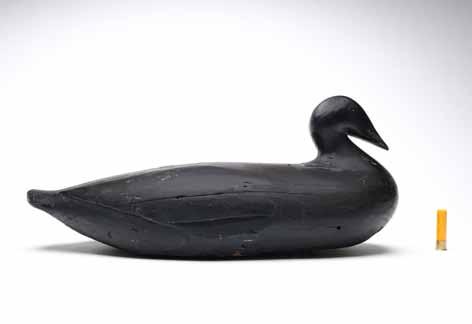
454 Unknown maker, Maine, circa 1900. Eider drake with wide body, slightly raised neck seat, and upswept tail. Measures 19.5” long. Original paint with moderate flaking and wear; thin wash to the white areas likely done in the making; small dents and shot marks; chipping and roughness on edge of tail; slight separation at neck seat.
Provenance: Martin and Deborah Maloy collection. (3,000 - 5,000)
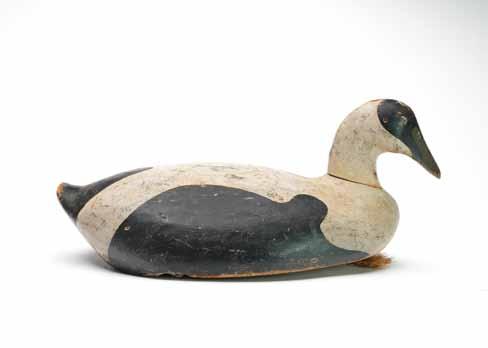
455 Augustus “Gus” Wilson (1864-1950), South Portland, Maine. Early Monhegan style goldeneye. In slightly forward head pose. Relief wing carving and inlet neck seat. Measures 20.5” long. Original paint with moderate flaking and wear; small dents and hairline drying cracks; typical defect in wood under tail area; with a small knot missing on one edge of tail; crack through neck; drying crack above one eye in one side of head; 1/3 of the bill is replaced.
Provenance: Martin and Deborah Maloy collection. (2,000 - 3,000)
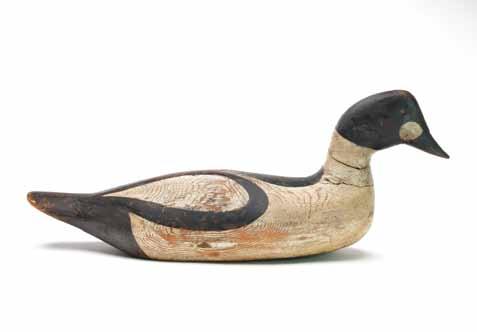
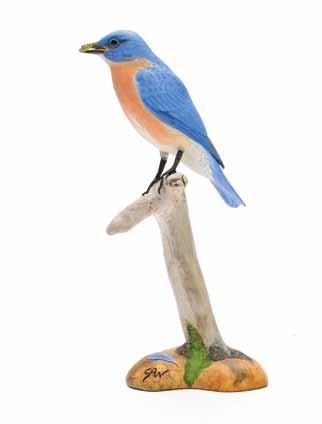
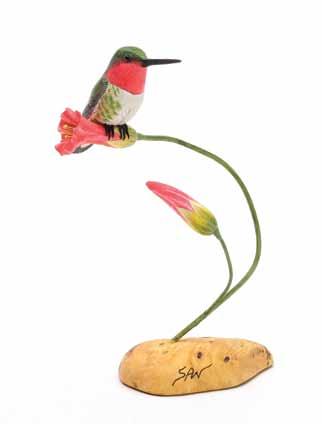
456 Steve Weaver (b.1950), Cape Cod, Massachusetts. Standing bluebird with larva in beak. Titled “Spring Fever”. Relief wingtip and detailed feather carving. Signed on the underside and initialed on base. Stands 9.5” tall. Excellent and original. (2,000 - 3,000)
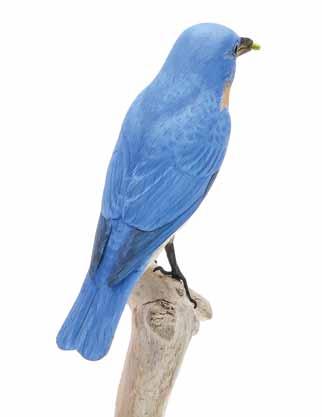
457 Steve Weaver (b.1950), Cape Cod, Massachusetts. Hummingbird perched on carved wooden flower. Signed and dated 2022 on underside. Stands 6.25” tall. Excellent and original. (2,000 - 3,000)

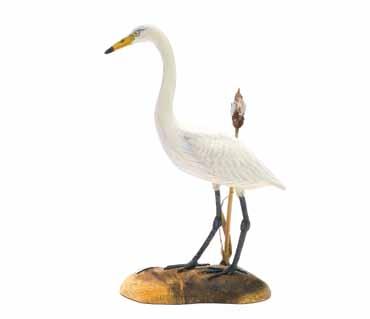
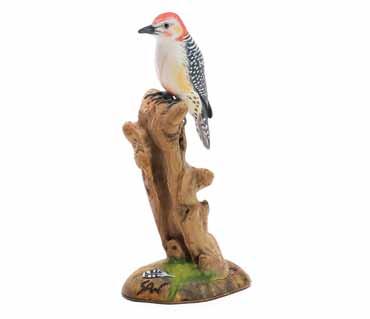
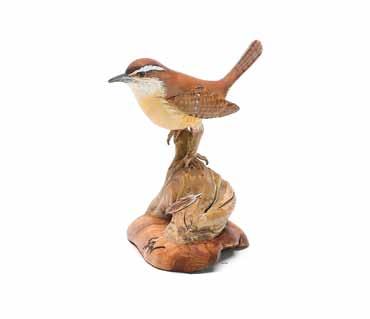

458 Steve Weaver (b.1950), Cape Cod, Massachusetts.
Miniature standing white heron. Titled “Lying in Wait”. Relief wing feather carving. Signed on underside and initialed on base. Stands 6.25” tall. Excellent and original.
(1,200 - 1,800)
460 Steve Weaver (b.1950), Cape Cod, Massachusetts.
Miniature Carolina wren with dropped wing carving and upswept tail. Signed on the underside and initialed on base. Stands 2.75” tall. Excellent and original.
(1,000 - 1,400)
461 Steve Weaver (b.1950), Cape Cod, Massachusetts. Miniature red bellied woodpecker with raised crossed wingtips. Signed on the underside and initialed on base. Stands 4.75” tall. Excelent and original. (1,000 - 1,400)
462 Steve Weaver (b.1950), Cape Cod, Massachusetts. Miniature spotted sandpiper. In walking pose with relief wingtip carving. Signed on underside and initialed on base. Measures 3” long, Excellent and original.
(1,000 - 1,400)
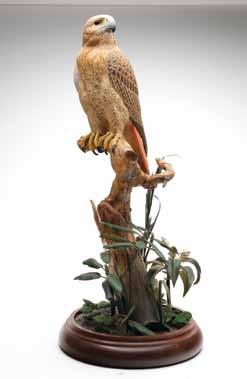
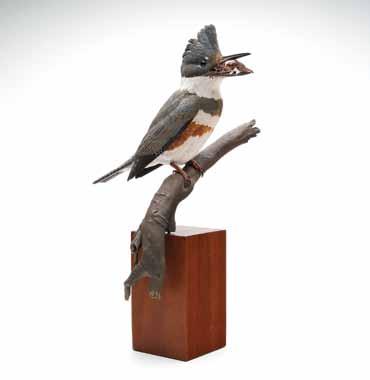
463 Unknown maker, late 20th century. Decorative redtailed hawk. Stands on natural wood perch with other plant life on base. Head is turned 90 degrees. Relief wing carving with extended wingtips. Detailed feather carving. Stands 31.5” tall. Excellent and original. (1,000 - 1,500)
464 Peter Kaune, Gig Harbor, Washington. Decorative belted kingfisher with cray fish in bill. Dropped wingtips and extended tail feathers. Highly detailed feather carving. Stands 16” tall. Tiny paint rubs on tip of beak and a few crest feathers, otherwise excellent and original. (800 - 1,200)

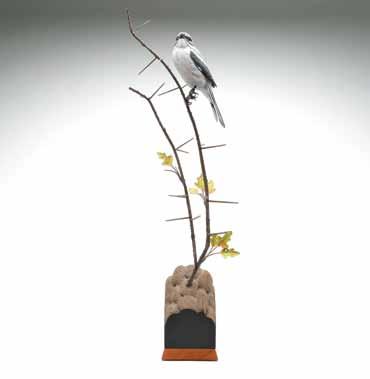
465 James E. “Jim” Hazeley (b.1986), Lancaster, Pennsylvania. Decorative scissor tail fly catcher. With fly in beak. Raised wingtips and extended tail feathers. Head is slightly turned. Signed and dated 1993 on underside. Measures 13.5” tall. Excellent and original. (800 - 1,200)
466 Peter Kaune, Gig Harbor, Washington. Decorative loggerhead shrike. Slightly turned head and extended wingtips. Highly detailed feather carving. Stands 26” tall. Excellent and original. (600 - 900)

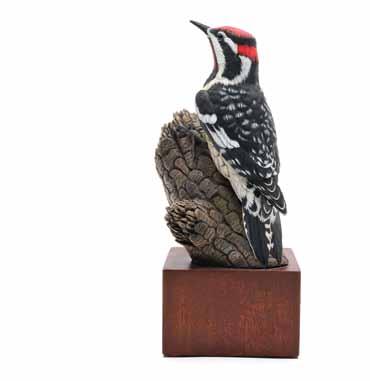
467 Gary Eigenberger (b. 1960), Green Bay, Wisconsin. Decorative eastern bluebird. Raised, crossed wingtips and detailed feather carving. Identified, signed, and dated 10/03. Stands 16.5” tall. Excellent and original. (2,000 - 3,000)
468 Peter Kaune, Gig Harbor, Washington. Decorative red-naped sapsucker. Raised crossed wingtips and highly detailed feather carving. Signed and dated 9/97. Measures 9.75” tall. Excellent and original. (600 - 900)
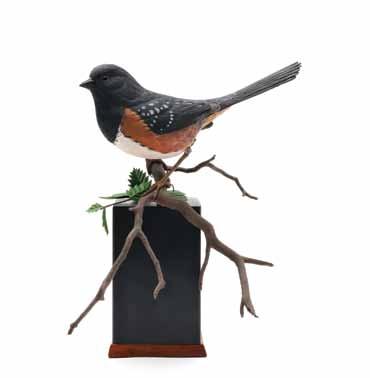
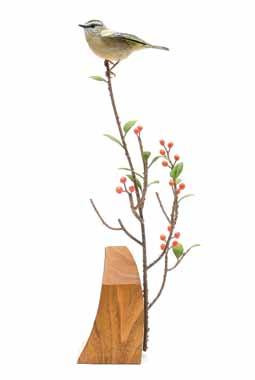
469 Peter Kaune, Gig Harbor, Washington. Decorative spotted towhee. Slightly turned head and upswept tail. Detailed feather carving throughout. Signed and dated 5/88. Stands 9.25” tall. Two tiny chips on one side of tail, otherwise excellent. (600 - 900)
470 Peter Kaune, Gig Harbor, Washington. Decorative golden crown kinglet. Outstretched wings and detailed feather carving. Signed and dated 7/2013. Stands 13.5” tall. Excellent and original. (600 - 900)
471
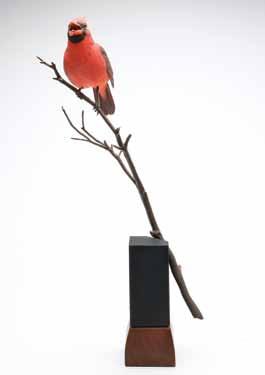
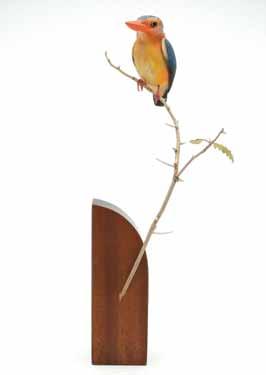
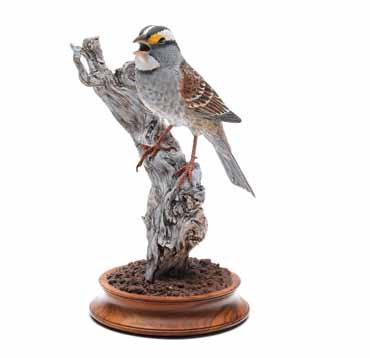

James E. “Jim” Hazeley (b.1986), Lancaster, Pennsylvania. Decorative northern cardinal. With open beak and carved tongue. Dropped wings and detailed feather carving. Signed and dated 1995. Measures 18.5” tall. Tiny paint rub on tip of crest feather; otherwise excellent. (500 - 800)
472 Gary Eigenberger (b. 1960), Green Bay, Wisconsin. Decorative African pygmy kingfisher. Relief wing and detailed feather carving. Signed and dated 9/06. Stands 14.75” tall. Excellent and original. (1,000 - 1,500)
473 Cindy Lewis and Mark Holland. Decorative white throated sparrow. Open beak and raised wingtips. Detailed feather carving. Signed on back of branch. Stands 8” tall. Excellent and original. (600 - 900)
474 Peter Palumbo, Bay Shore, Long Island. Decorative sandpiper on beach scene. Resting plover with highly detailed feather carving. Standing on one leg. Top of base with sand attached. Sandpiper measures 5.25” long, base is 17” wide. Small chip on one tip of base; otherwise excellent. (600 - 900)
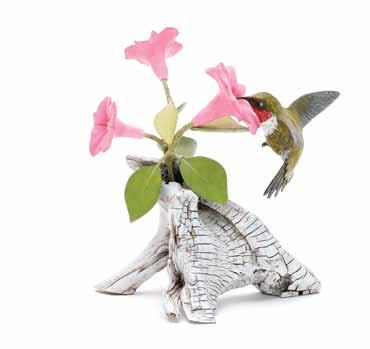

475 Cindy Lewis and Mark Holland. Decorative hummingbird and flowers. Outstretched wings and fanned out tail. Signed on base. Stands 7” tall. Excellent and original.
Provenance: Martin and Deborah Maloy collection. (400 - 600)
476 Cindy Lewis and Mark Holland. Decorative sunflower with three feeding chickadees. One with outstretched wings and one with sunflower in beak. Signed and dated 2010 on underside. Measures 10” across, stands 5” tall. Excellent and original.
Provenance: Martin and Deborah Maloy collection. (700 - 1,000)
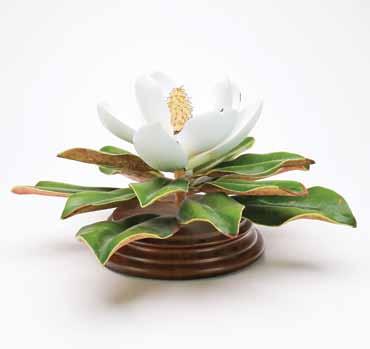
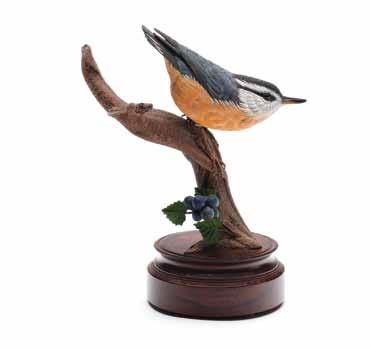
477 Cindy Lewis and Mark Holland. Outstanding decorative waterlily carving. Very realistic carving. Signed under one leaf. Measures 17” wide, stands 8” tall. Excellent and original.
Provenance: Martin and Deborah Maloy collection. (600 - 900)
478 Peter Kaune, Gig Harbor, Washington. Decorative nut hatch. Raised, crossed wingtips and detailed feather carving. Signed “Kaune” on lower branch. Maker’s name branded in underside. Measures 6.5” tall. Tiny paint rub on tip of beak; otherwise excellent and original. (600 - 900)
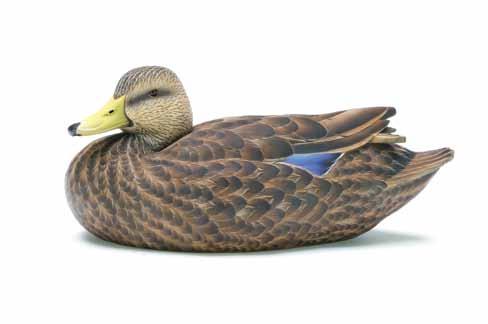


479 Dennis Schroeder, Trinity Alps, California. Excellent decorative black duck with slightly turned and tucked head. Raised, crossed wingtips and excellent paint detail. Signed and dated 2013, as well as the maker’s brand on underside. Measures 13” long. Excellent and original. (1,200 - 1,800)
480 Jimmie Vizier (1933-2010), Galiano, Louisiana. Pair of gadwall with slightly turned heads and raised, crossed wingtips. Signed and dated 2000 on underside. Measure 13.5” and 14.5” long. A few tiny paint rubs on bill tips; otherwise very good and original. (1,000 - 1,400)
481 Peter Palumbo, Bay Shore, Long Island. Curlew with slightly turned head and relief wing carving. Signed and dated 2012 on the underside of base. Measures 13.25” long. Excellent and original. (800 - 1,200)
482 Clarence Miller (b. 1936), Smiths Falls, Ontario. Decorative swimming merganser hen with relief feather carving and extended crest. Writing on underside says it won first place at the 1969 National Decoy Show. Measures 18.5” long. Original paint with a few tiny rubs; a thin coat of varnish has darkened with age; excellent structurally.
Provenance: Martin and Deborah Maloy collection. (1,000 - 1,400)
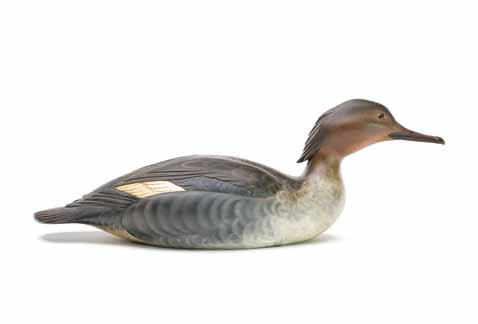
483 Wendell Gilley (1904-1983), South West Harbor, Maine. Half size decorative Canada goose. Outstretched neck and open bill carving. Raised wingtips and relief feather carving. Signed and dated ‘76 on back of base. Measures 20” long. Original paint with spots of discoloration under tail area; small spot of touchup on edge of one wing and on one cheek patch.
(3,000 - 5,000)
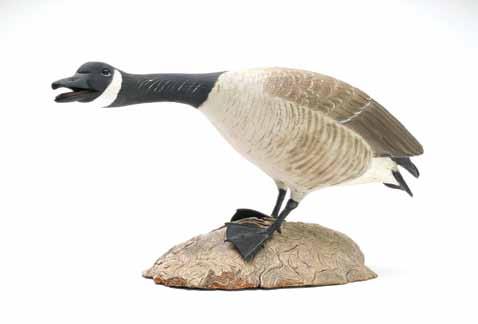
484 Leo McIntosh (1953-2007), Adams, New York. Black duck with scratch feather paint detail and slightly turned head. “McIntosh” stamped in underside. Measures 16.5” long. Minor paint rubs on edge of tail and tip of bill; otherwise mint.
(800 - 1,200)
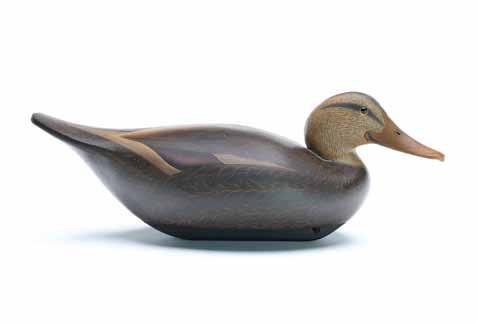
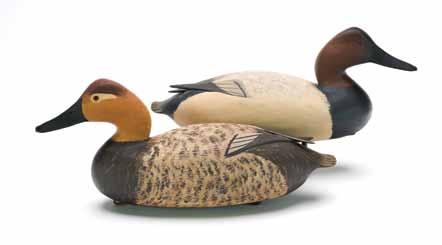
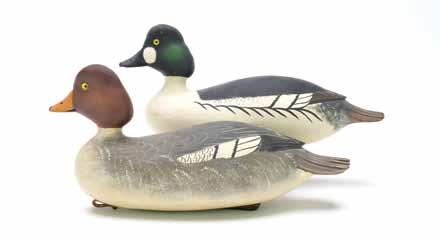
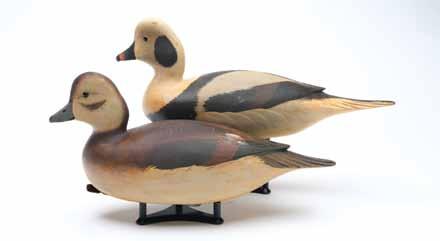

485
486
Bob White (b. 1939) Tullytown, Pennsylvania. Pair of canvasbacks. Hollow carved with extended, raised and crossed wingtips. Signed on the undersides and with the maker’s quail embossed weight. Measure 16” long. Excellent and original. (2,000 - 3,000)
487
Bob White (b. 1939) Tullytown, Pennsylvania. Pair of goldeneye. Hollow carved with slightly turned heads. Raised “V” wingtip carving and relief tail feathers. Signed on the undersides and with the maker’s quail embossed weights. Measure 14.5” long. Excellent and original. (1,500 - 2,500)
488
Bob White (b. 1939) Tullytown, Pennsylvania. Rigmate pair of longtailed ducks. Both have slightly turned heads, raised wingtips and carved tails. Drake measures 17.5” long. Both are excellent and original with some darkening to the varnish and a rub at one side of hen’s wing patch.
(1,200 - 1,800)
Bob White (b. 1939) Tullytown, Pennsylvania. Hollow carved black duck with slightly turned head. Raised “V” wingtips and deep relief tail feather carving. Signed and dated 1990. Also with maker’s quail embossed weight. Measures 17.25” long. Near mint. (1,000 - 1,400)
489 Robert Moreland. Large white heron. ‘RDM 97” carved in underside. Measures 54” long. Reglued chip at tip of bill, otherwise excellent. (1,000 - 1,400)
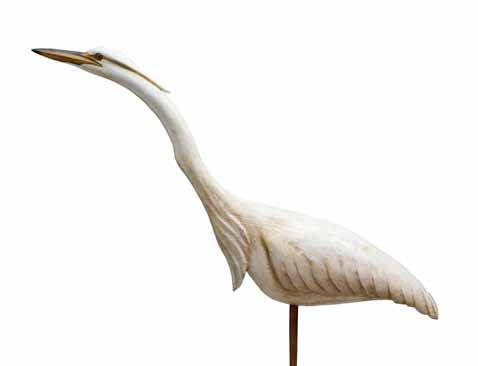
490 John McLoughin (1911-1985), Bordentown, New Jersey. Appealing gull. Thinly hollowed with relief wing carving. Signed on the underside. Wooden keel was removed. Measures 17.5” long. A few small dents and paint rubs, otherwise excellent and original. (1,000 - 1,400)
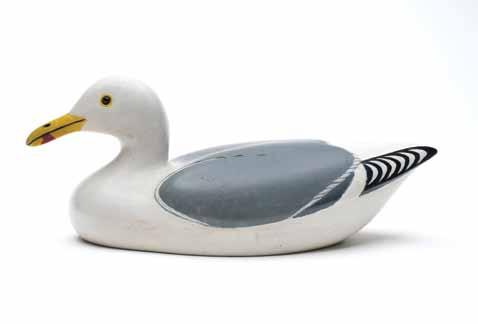
491 John McLoughin (1911-1985), Bordentown, New Jersey. Hollow carved wood duck with slightly turned head and relief wingtip carving. Signed on the underside. Measures 13” long. A few small spots of sap bleed, otherwise excellent and original. (500 - 800)
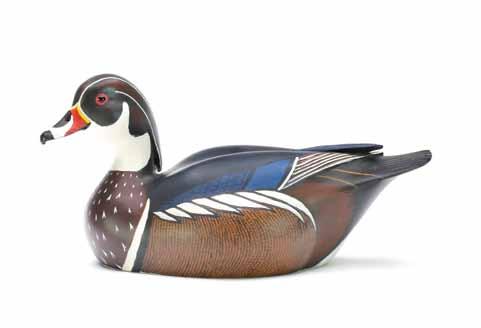
George Boyd’s first venture into the world of work was, like so many other men of the day, associated with the local shoe industry. He was, however, never very far from the salt marshes of Seabrook and these, along with the surrounding fields and forest, were his long-time favored hunting and fishing grounds. These provided not only sport but were also important sources of food and income. He began his carving career in a very practical way by producing duck, geese and shorebird decoys meant to be shot over. Others were doing the same but, like in any area, some men excelled at their craft and George’s work fit nicely into that category. Eventually he was producing greater and greater numbers of decoys for sale locally, as well as in a few select retail operations, such as Iver Johnson in Boston.
An avid hunter, George Boyd was a frequent guest at the “Port of Missing Men”, a gunning stand (formed 1929) on New Hampshire’s Great Bay. Another frequent guest was Edward V Papin (1869 –1955), an affluent summer resident of Rye, NH. Papin became a staunch friend and patron of Boyd and, reportedly, it was he that encouraged Boyd to begin carving miniatures.
As noted by Joe Ellis in his “Birds in Wood and Paint”:
“Like Crowell and Lincoln before him, Boyd recognized by the late 1920s that carving miniatures was faster and more lucrative than producing decoys, and by the early 1930s he had quit shoe manufacturing to concentrate exclusively on his carving, focusing primarily on miniatures”.
He worked out of a small workshop behind his home on Collins Street that formerly housed his cobbler business. His small ducks and geese were, like Joe Lincoln, tiny versions of his full size, working decoys. Like his decoys, many had the head carved separately from the body and then attached with a tiny dowel. He rarely changed the basic body form and relied instead on
his painting detail to identify individual species. Unlike Lincoln who was a minimalist, and Crowell with his delicately blended paint, Boyd used up to hundreds of individual tiny paint strokes to achieve the look he desired in the plumage. Unlike Lincoln, who is not known to have ever carved anything but miniature ducks and geese, Boyd, like Crowell, carved a wide variety of waterfowl, shorebird and upland species with only a few, very rare, miscellaneous species, such as his hummingbirds and passenger pigeons. In total, Ellis lists 60 different species that Boyd is known to have carved and Jim Cullen, through his exhaustive research, has expanded that list to 69 species. He sold his carvings not only at his own small shop in his backyard, but through Abercrombie and Fitch and Macy’s. He priced his carvings at only $.50 apiece and the retail outlets realized a nice profit by selling them at $25.00 apiece. His total lifetime production was rather limited. His daughter estimates that her father only produced about 700 miniatures while his grandson raises that estimate to about 1000 pieces, both small numbers compared to other noted miniaturists of his day.
George Boyd received relatively little fame or recognition in his lifetime. He did not advertise his work and there was not even a sign on his shop. He declined solicitations to be included in Abercrombie and Fitch exhibitions in New York, as well as offers to participate in the State of New Hampshire Exhibit at the World’s Fair in New York in 1939. As late as 1965, when Bill Mackey published his “American Bird Decoys”, Boyd’s working shorebirds were still referred to as being by “ - - - a prolific but unknown maker”. It was only due to a chance auction and a later exhibit in the late 1970s did a world far beyond the borders of Seabrook, New Hampshire begin to recognize and appreciate Boyd as the outstanding artist that he was. When his daughter was asked what he would think about the auction prices for his work today, she replied, “I guess he’d just laugh”.
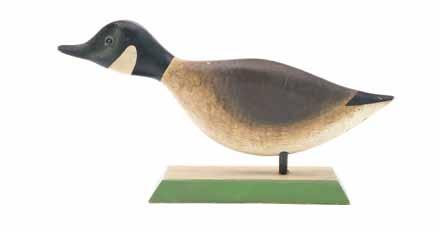

492
493
George Boyd (1873-1941), Seabrook, New Hampshire. 1/4 size standing Canada goose. Tack eyes and excellent paint detail. Measures 13” long, 1.25” wide. Dry original paint with very minor wear on tip of bill and tip of tail.
Provenance: Dan Graf collection. (4,000 - 6,000)
George Boyd (1873-1941), Seabrook, New Hampshire. Very rare 1/2 size black duck. “FPM” stamped in underside. Measures 11.75” long. Original paint with minor wear; roughness on edge of tail; minor chipping on edge of bill; tiny spot of glue visible at neck seam; dent in one lower side.
Provenance: Dan Graf collection. (2,500 - 3,500)

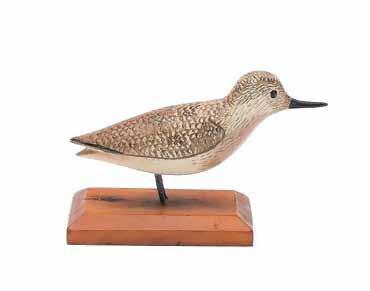
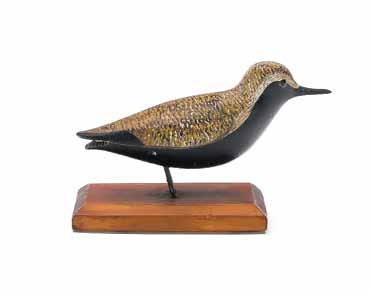
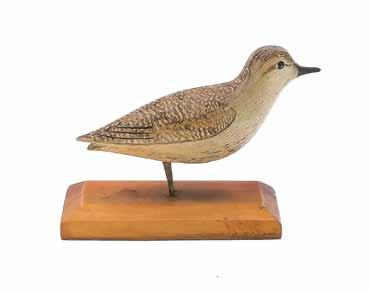
494 George Boyd (1873-1941), Seabrook, New Hampshire. Miniature ruddy turnstone. Identified on the underside. Measures 4.5” long. Original paint under a thin coat of varnish; very tight crazing on one wing patch; otherwise excellent and original.
Provenance: Dan Graf collection. (1,500 - 2,500)
495 George Boyd (1873-1941), Seabrook, New Hampshire. Miniature golden plover. Measures 4” long. Very good and original.
Provenance: Dan Graf collection. (1,500 - 2,500)
496 George Boyd (1873-1941), Seabrook, New Hampshire. Miniature dowitcher. Measures 3.75” long. Near mint.
Provenance: Dan Graf collection. (1,500 - 2,500)
497 George Boyd (1873-1941), Seabrook, New Hampshire. Miniature knot in winter plumage. Measures 3.5” long. Excellent and original.
Provenance: Dan Graf collection. (1,200 - 1,800)


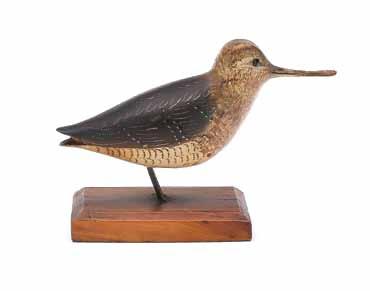
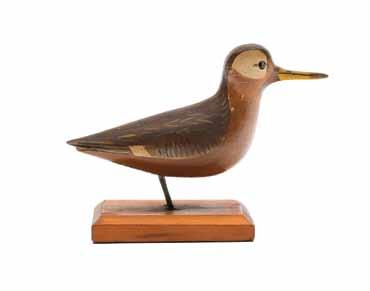
498 George Boyd (1873-1941), Seabrook, New Hampshire. Miniature snipe. Measures 3.75” long. Excellent and original.
Provenance: Dan Graf collection. (1,200 - 1,800)
499 George Boyd (1873-1941), Seabrook, New Hampshire. Miniature jacksnipe. “Jack” written on underside. Measures 4” long. Half of the bill is a professional replacement; otherwise excellent and original.
Provenance: Dan Graf collection. (1,200 - 1,800)
500 George Boyd (1873-1941), Seabrook, New Hampshire. Miniature godwit. Identified on the underside. Measures 5” long. Near mint.
Provenance: Dan Graf collection. (1,200 - 1,800)
501 George Boyd (1873-1941), Seabrook, New Hampshire. Miniature phalarope. Identified on the underside. Measures 4” long. Original paint with a thin coat of varnish added to breast and underside; a few tiny paint rubs; otherwise excellent.
Provenance: Dan Graf collection. (1,200 - 1,800)

502 George Boyd (1873-1941), Seabrook, New Hampshire. Extremely rare pair of miniature pheasant. Measure 5” and 6” long. Original paint protected under a thin coat of varnish; tiny chip at tip of hen’s beak; otherwise near mint.
Provenance: Dan Graf collection.
(4,000 - 6,000)
503 George Boyd (1873-1941), Seabrook, New Hampshire. Miniature standing cormorant. Deep relief wing carving. Head turned 90 degrees. Stands 5.75” tall including base. Small amount of glue visible where legs are inserted in to base; otherwise excellent and original.
Provenance: Dan Graf collection.
(2,000 - 3,000)
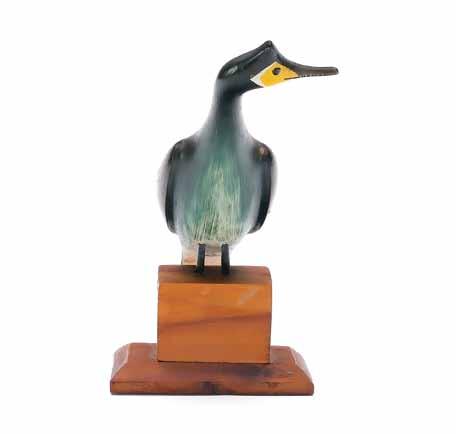
504 George Boyd (1873-1941), Seabrook, New Hampshire. Pair of miniature Canada geese. One in swimming pose. Measure 4.75” and 6” long. A few small paint rubs; very fine seam in swimmer’s neck where it was tightly reset.
Provenance: Dan Graf collection.
(3,000 - 4,000)
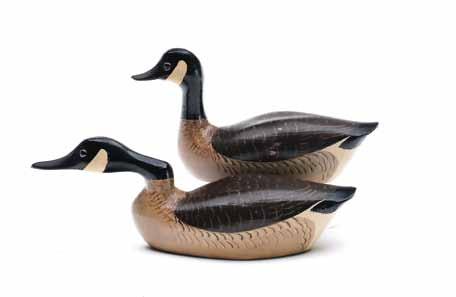
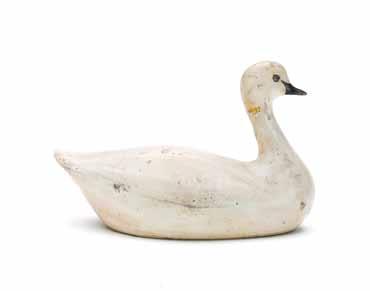
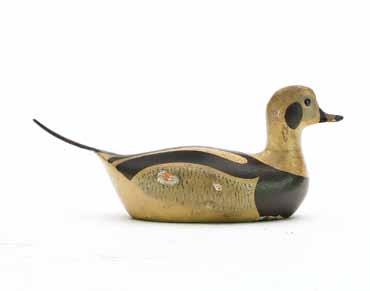
505 George Boyd (1873-1941), Seabrook, New Hampshire. Miniature swan with reared back head. Measures 4.25” long. Original paint with minor discoloration and rubs; spot of orange paint on one side of neck; excellent structurally.
Provenance: Dan Graf collection. (1,500 - 2,500)
506 George Boyd (1873-1941), Seabrook, New Hampshire. Miniature long-tail duck with inset wooden tail sprig. Identified in pencil on underside. Measures 4.75” long. Original paint that has darkened slightly with age; scattered paint rubs; excellent structurally.
Provenance: Dan Graf collection. (1,200 - 1,800)
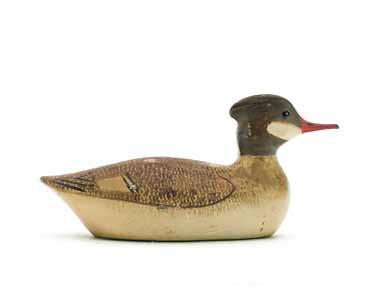
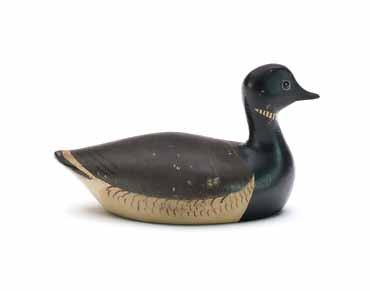
507 George Boyd (1873-1941), Seabrook, New Hampshire. Miniature American merganser hen. Extended crest carving. Identified on the underside. Measures 4.25” long. Original paint with a few minor rubs, otherwise excellent.
Provenance: Dan Graf collection. (1,500 - 2,500)
508 George Boyd (1873-1941), Seabrook, New Hampshire. Miniature brant. Identified in pencil on the underside. Measures 3.75” long. Original paint with a few very minor rubs; excellent structurally.
Provenance: Dan Graf collection. (1,500 - 2,500)

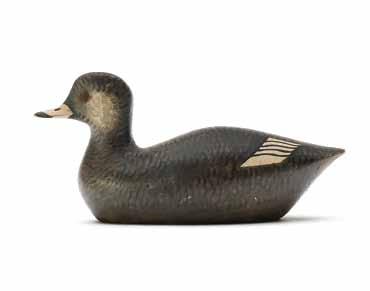
509 George Boyd (1873-1941), Seabrook, New Hampshire. Miniature canvasback. Identified in pencil on the underside. Measures 4.5” long. Original paint with a few minor rubs; two spots where paper wrapping has stuck to the body.
Provenance: Dan Graf collection. (1,500 - 2,500)
510 George Boyd (1873-1941), Seabrook, New Hampshire. Miniature labrador duck hen. Identified in pencil on underside. Measures 4” long. Minor rust staining on tack eyes; otherwise excellent.
Provenance: Dan Graf collection. (1,500 - 2,500)


511 George Boyd (1873-1941), Seabrook, New Hampshire. Miniature shoveler hen. Slightly turned head. Measures 3.75” long. Original paint with minor rubs; excellent structurally.
Provenance: Dan Graf collection. (1,200 - 1,800)
512 George Boyd (1873-1941), Seabrook, New Hampshire. Miniature mallard with slightly turned head. Identified in pencil on the underside. Measures 4.25” long. Original paint that has darkened slightly with age; very fine crazing; excellent structurally.
Provenance: Dan Graf collection. (800 - 1,200)
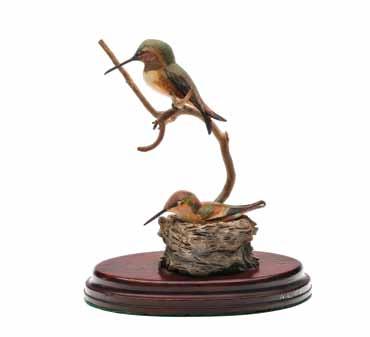
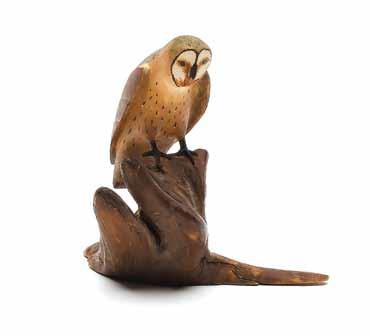
513 Horace “Hi” Crandall (1892-1969), Westwood, California. Pair of miniature hummingbirds. Male perched on a branch with dropped wingtip carving. Female is nesting in a carved wooden nest. Signed on one side of base. Piece measures 5” x 6” tall. Very good and original. (1,200 - 1,800)
514 Harold Gibbs (1886-1970), Barrington, Rhode Island. Miniature owl with deep relief wing carving and raised wingtips. Signed on underside. Stands 4” tall. Some touchup where legs meet base, otherwise excellent. (500 - 800)
515 Harold Gibbs (1886-1970), Barrington, Rhode Island. Miniature osprey with deep relief wing carving and raised wingtips. Signed on the underside. Stands 3.5” tall. Tiny chip at tip of beak; small chips in jesso toes; some filler and touchup at front of legs. (400 - 600)
516 Harold Gibbs (1886-1970), Barrington, Rhode Island. Miniature walking godwit with dropped wing
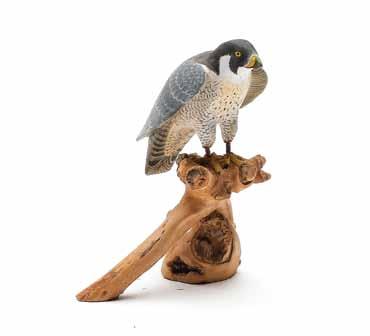

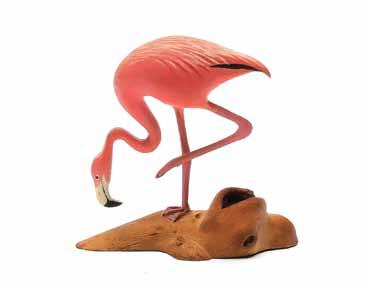
carving. Signed and dated 1964. Bird measures 3.75” long. Excellent and original. (500 - 800)
516A Harold Gibbs (1886-1970), Barrington, Rhode Island. Miniature wading flamingo. Signed and dated 1966. Stands 3.75” tall. Small amount of touchup where leg meets base, otherwise excellent. (500 - 800)
517 A. Elmer Crowell (1862-1952), East Harwich, Massachusetts. Miniature wood duck with extended crest. Maker’s ink stamp on underside. Very nice paint detail. Measures 3.75” long. Excellent and original. (1,000 - 1,500)
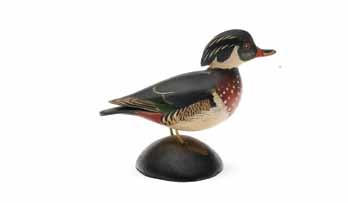
518 A. Elmer Crowell (1862-1952), East Harwich, Massachusetts. Miniature bluewing teal with unmarked base. Measures 4” long. Excellent and original. (1,000 - 1,400)
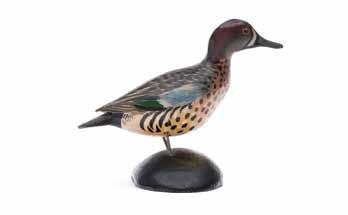
519 A. Elmer Crowell (1862-1952), East Harwich, Massachusetts. Miniature running brant. Maker’s rectangle stamp on underside. Measures 5.75” long. Excellent and original. (1,000 - 1,400)
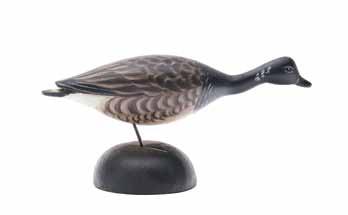
520 A. Elmer Crowell (1862-1952), East Harwich, Massachusetts. Miniature long-tailed duck. Maker’s rectangle stamp on underside. Measures 4” long. Original paint under a thin coat of varnish that has darkened slightly; tiny paint rub on tip of bill and a few on lower edge of base. (800 - 1,200)
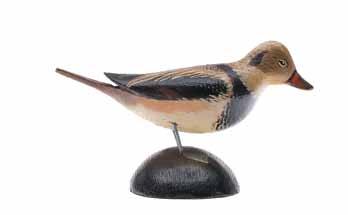
521 A. Elmer Crowell (1862-1952), East Harwich, Massachusetts. Miniature redhead with unmarked underside. Measures 4.5” long. Original paint; spots of touchup on top of head, bill tip, and breast. (800 - 1,200)

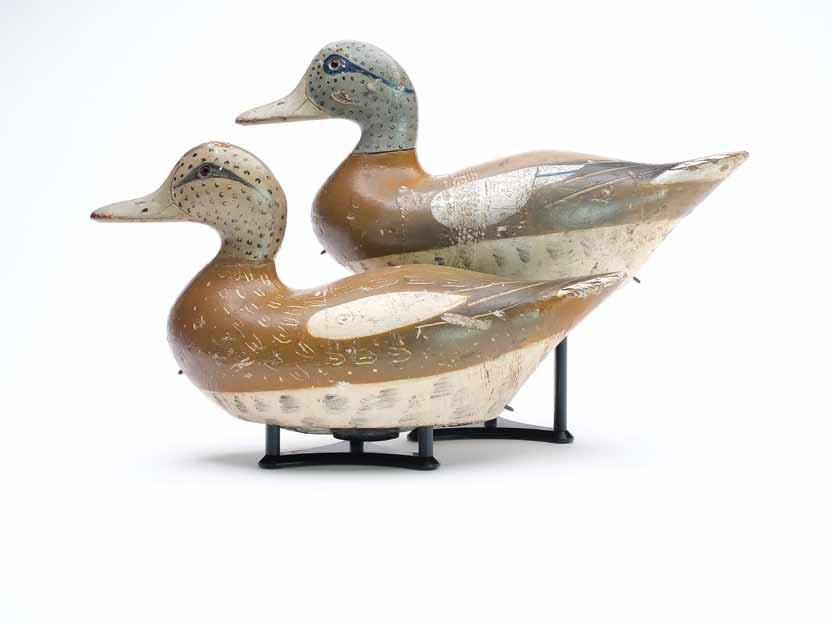
522 Charles Bergman (1856-1946), Astoria, Oregon. Rare pair of widgeon. With scratch feather paint detail on hen. “HL” carved in underside of drake. Measure 14” and 14.5” long. Original paint with minor to moderate wear under an early coat of varnish; some scattered dents and a few shot marks, otherwise very good structurally. (12,000 - 18,000)

Charles Bergman enjoyed duck hunting and it may be possible that, while it was legal, he sold some of his excess game in the Portland (OR) markets. There were few, if any, locally produced decoys at the time so Bergman’s earliest decoys were Mason factory birds. His first attempts at making his own decoys clearly reflect the Mason influence but he rapidly developed a unique style of his own.
Citing Miller and Mortensen, all of Bergman’s decoys are hollow and very light. All were carved from the locally available western red cedar. Until about the age of 70, the bulk of Bergman’s production was for his own use but, upon his retirement, he began to carve in earnest for the commercial trade. His grandson estimates that
he produced about a dozen decoys per week that he sold for $1.25 each. He carved a variety of species, all noted for their table quality and, as such, only one rig of bluebills (locally considered trash ducks) is known. Bergman’s work is widely recognized for the quality of his carving and construction, but he is probably best known for his outstanding painting. His plumage is crisp and accurate but often varies decoy to decoy within the same rig. As pointed out by Hugh Chatham, “It is ironic that a man may labor all his life at ‘serious’ work but be best remembered for a few artifacts created while ‘at play’”.
His craftsmanship speaks volumes about a man who took great pride in his work. His lasting legacy rests firmly, not only on his own efforts, but on the influence he had on regional carvers to follow. His work was the subject of a year long exhibit at the Columbia River Maritime Museum and was included in an exhibit at the Houston Museum of Natural Science (TX). His carvings are a part of the prestigious permanent collection of the Shelburne Museum (VT) and are represented in numerous, well known, private collections.
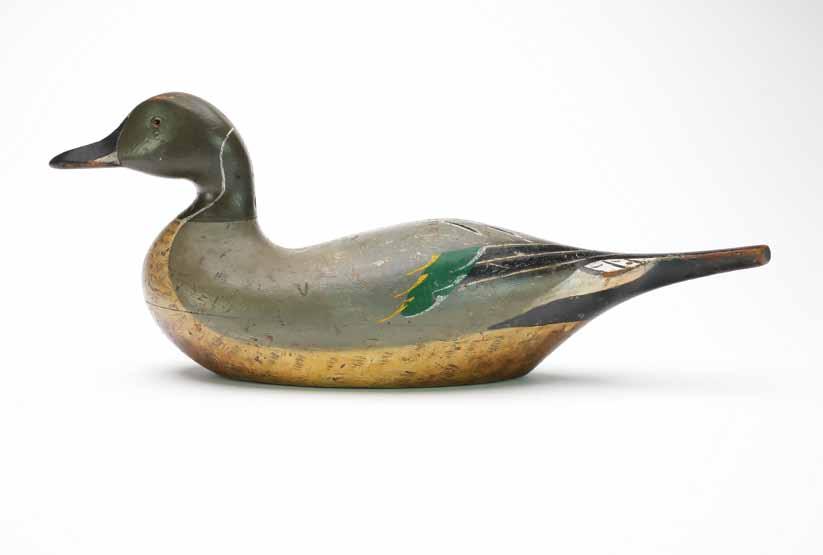
523 Charles Bergman (1856-1946), Astoria, Oregon. Hollow carved pintail with raised neck seat and extended tail sprig. Measures 19.5” long. Original paint with minor to moderate wear; area of discoloration on lower breast and under tail; scattered shallow dents; minor roughness on edge of bill; crack through neck was professionally reset with thin line of touchup.
(2,500 - 3,500)
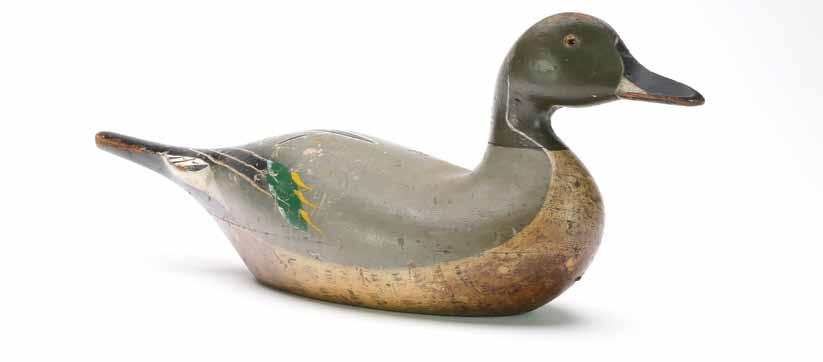
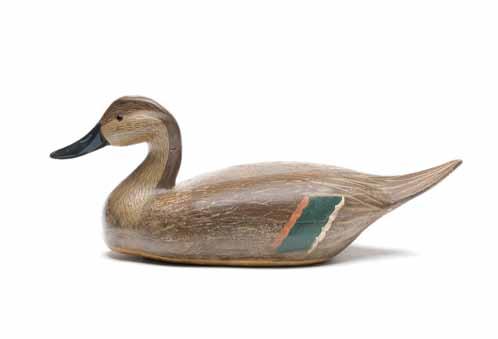
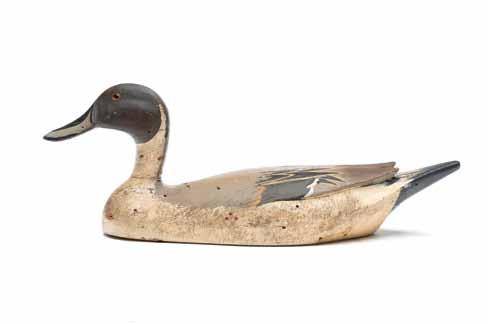
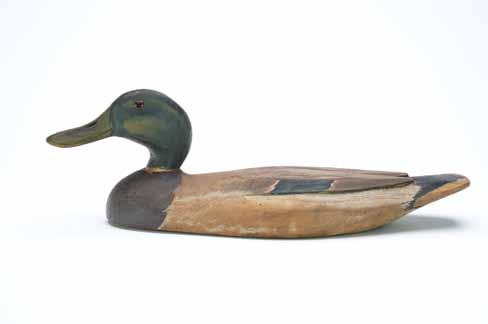
524
John William Luedtke (1901-1958), Stockton, California. Very rare pintail hen. Measures 15.5” long. Original paint with very minor wear; reglued crack through neck; very minor roughness on tip of tail and top edge of head.
(3,000 - 5,000)
525 Horace “Hi” Crandall (1892-1969), Westwood, California. Pintail drake. 1st half 20th century. Slightly turned head with raised wingtips. Strong original paint; very tight crack in neck; several shot scars, mostly on one side; rough area at wing tip. (4,000 - 6,000)
526 Horace “Hi” Crandall (1892-1969), Westwood, California. Mallard with slightly turned head and relief wing carving. Thin body style was rigged but never weighted. Measures 15” long. Original paint with minor wear; significant wear to lower sides and edges of tail.
(2,000 - 3,000)
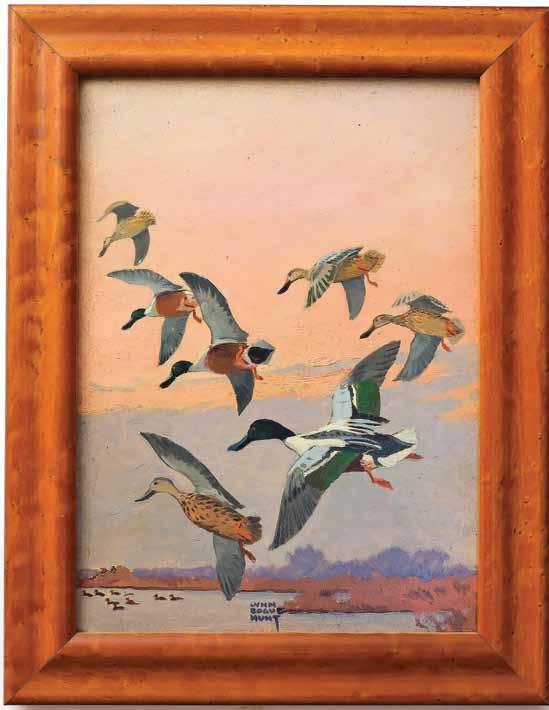
527 Lynn Bogue Hunt (1878-1960), oil on board. Image measures 11.5” x 8.5”. Signed. Shovelers landing in marsh. With hunters in blind in foreground. As viewed under uv light painting remains excellent and original. (8,000 - 12,000)
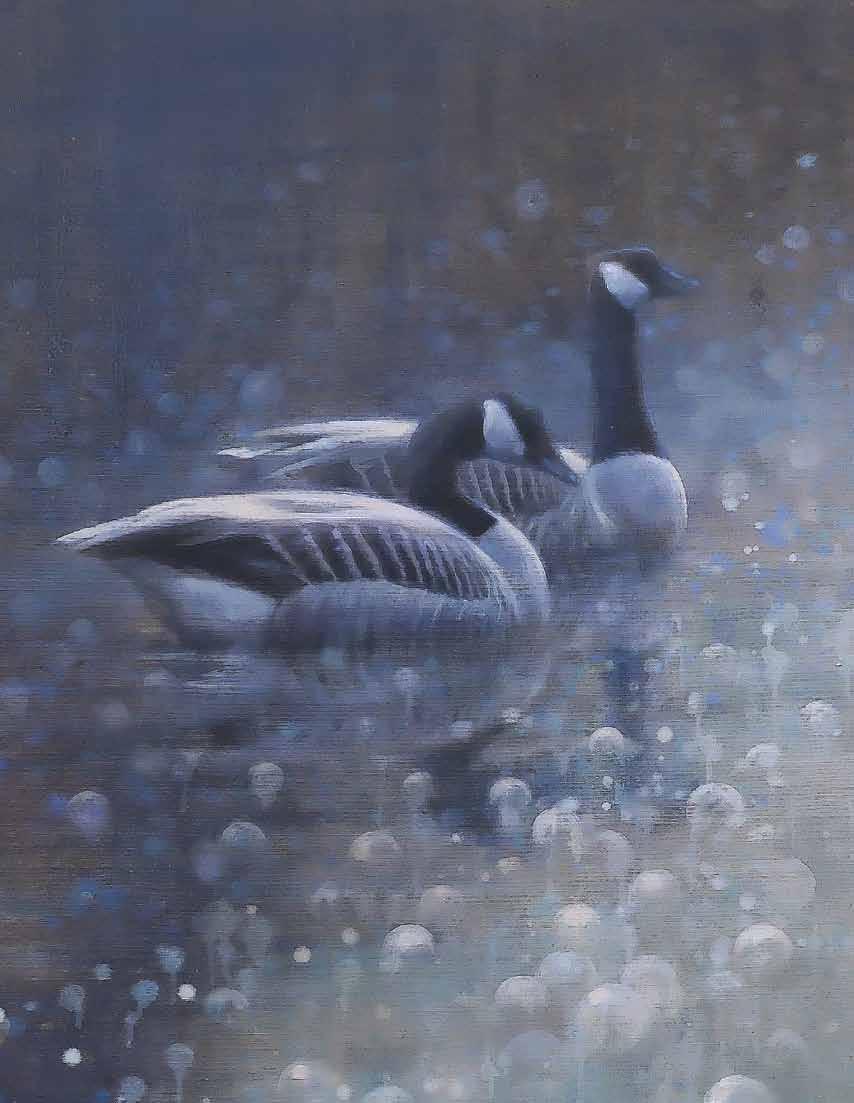
“The inspiration of this work comes from a couple of Canada geese here in The Netherlands. There is a small lake where they often rest. I see them early in the morning while walking my dog. They sleep preferably in the shallow water so the foxes can’t get to them. Here I have painted them resting in an early morning fog.”
- Ewoud de Groot
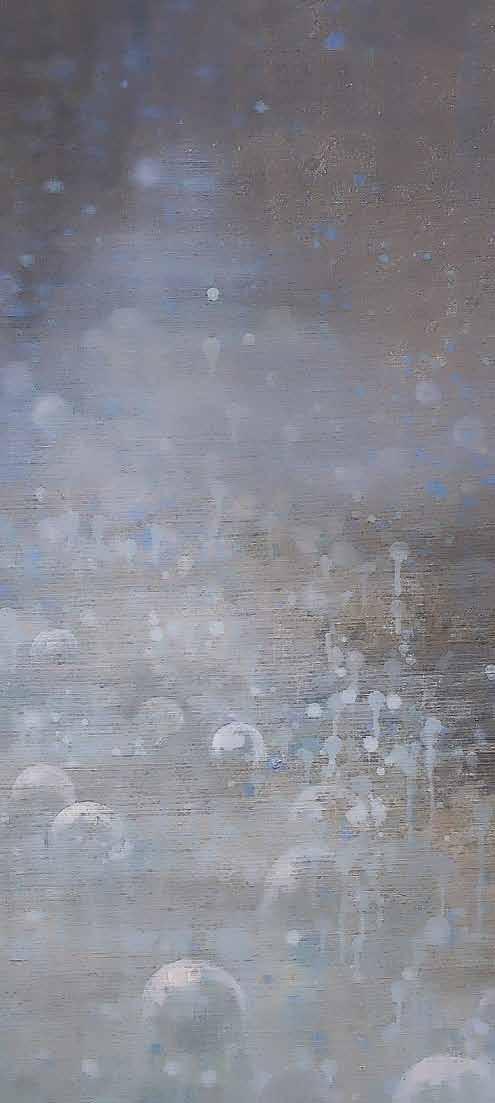
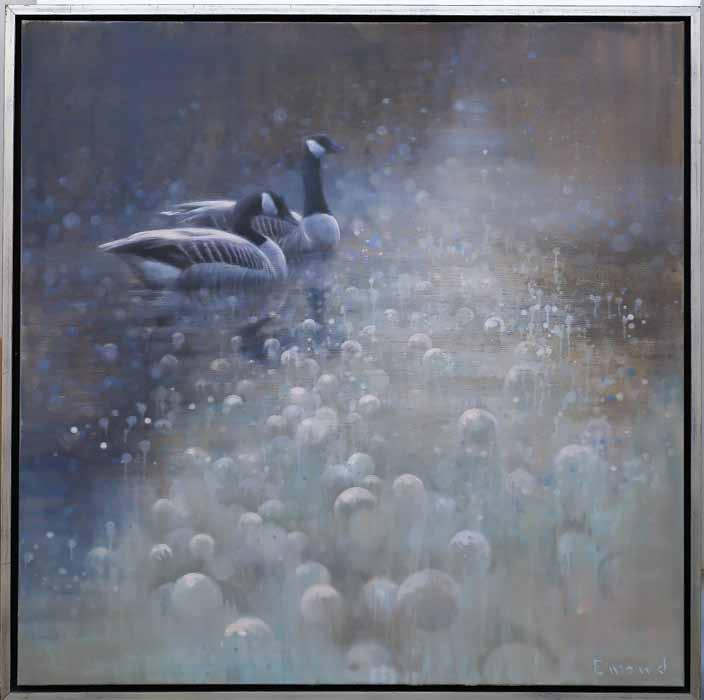
528 Ewoud de Groot (b.1969, Netherlands), oil on linen. Measures 47” x 47”. Signed. In a floating frame that measures 49.5” x 49.5”. Excellent and original. (10,000 - 14,000)

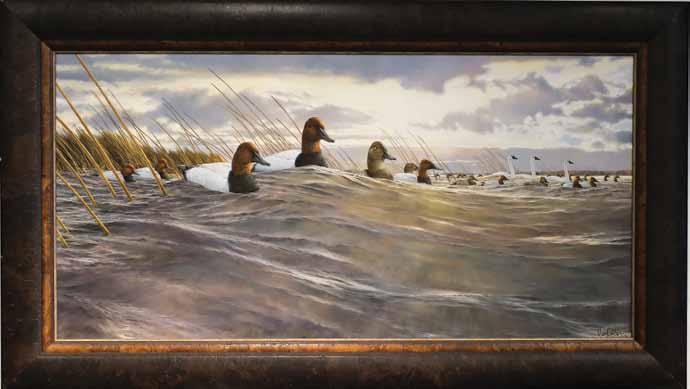
Ron Van GIlder
large acrylic on board. Image measures 36” x 72”. Signed. A migration of bluebills and canvasbacks. Titled “Grand Passage”. Large quality decorative frame. Excellent and original. (4,000 - 6,000)
530 Ron Van GIlder (b.1946), acrylic on canvas board. Image measures 23” x 47”. A great example of Van Gilder’s work as he is known for his translucent water paintings. Presented in high quality frame. Excellent and original (2,500 - 3,500)
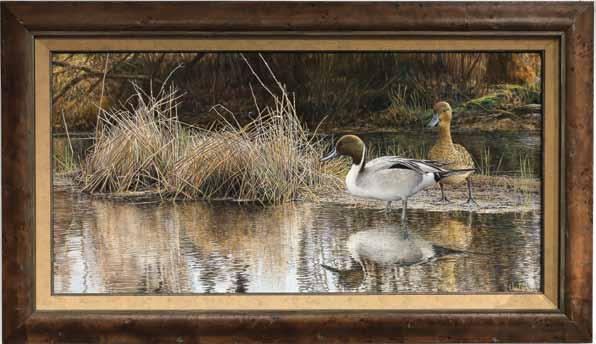
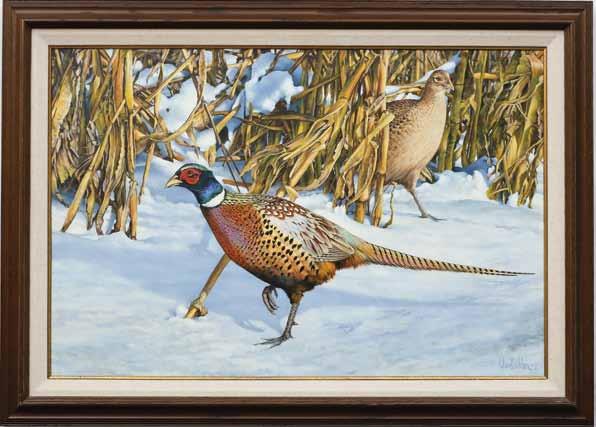
Ron Van GIlder (b.1946),
on canvas board. Image measures 21” x 43”. Signed. Presented in high quality frame. Excellent and original. (1,500 - 2,500)
532 Ron Van GIlder (b. 1946), acrylic on canvas board. Titled “Winter Walk”. Image measures 19.5” x 29.5”. Signed and dated ‘92. Pair of walking pheasants in corn stubble. Presented in high quality frame. Image remains excellent and original. (1,500 - 2,500)
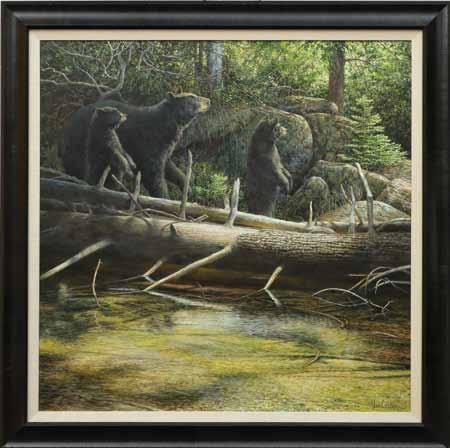
measures 31.5”
in high quality frame. Image remains excellent and original.
(1,500 - 2,500)
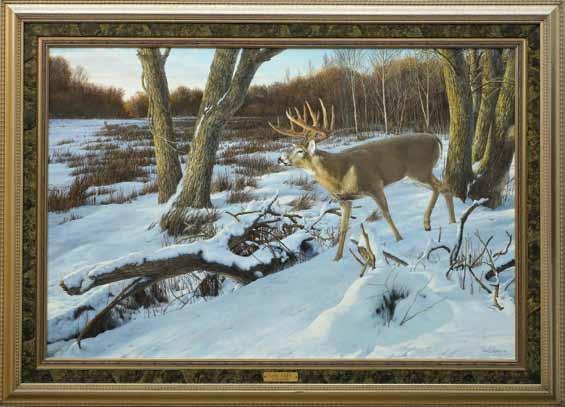
(1,500 - 2,500)
535 Ron Van GIlder (b. 1946), acrylic on canvas board. Image measures 20” x 31”. Titled “Northern Treasure”. Signed. Presented in high quality frame. Image remains excellent and original.
(1,000 - 1,500)
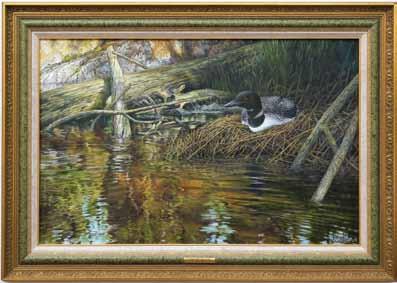
536 Rob Leslie (b.1947), acrylic on board. Of pintails. Signed lower right. Image measures 16.25” x 24.25”. Excellent and original. (800 - 1,200)

537 Rob Leslie (b.1947), acrylic on board. Of Canada geese. Signed lower right. Image measures 11.25” x 15.75”. Two faint scratches, otherwise excellent. (800 - 1,200)
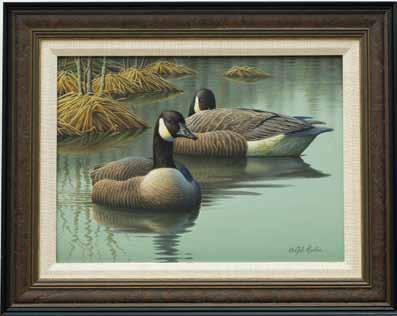
Barbers by trade, the Ward brothers, universally recognized as two of the most talented decoy carvers in North America, also possessed an often-minimized breadth of artistic talents that extended far beyond the crafting of fine waterfowl sculpture.
The pair, living in what, initially, was an isolated backwater hamlet, were practically isolated from outside artist and wildfowl reference material. Their talents were innate and, for the most part, self-taught. Reportedly, Lem enrolled in an art correspondence
course in the 1920s but, other than that, neither individual received any formal artistic training.
Both brothers greatly enjoyed singing and would often break into song regardless of where they were located or what they were doing. In 1927, they formed a barbershop quartet that performed throughout the region. They acquired a love of poetry from their mother and both penned numerous poems of their own. Lem had an extremely retentive mind and could repeat lengthy verses of his favorite poems, purely from memory.

538 Lem Ward (1896-1984), oil on canvas. Image measures 29.5” x 35.5”. Signed and dated 1977. Titled the “Beach Combers”. As viewed under uv light there are a few small spot of restoration and inpainting.
Provenance: Dean Hyde collection. (3,000 - 5,000)
By the 1950s, the widespread introduction of decoys made of plastic and other “modern” materials forced the brothers to focus their talents on more decorative and complicated carvings and the demand for their work spread far beyond the hunting community. As the daily challenge of creating multitudes of birds began to wear on the team, both brothers sought respite in other forms of artistic expression. Steve began to experiment with producing other related objects such as bookends, jewelry boxes and other decorative items. Lem, although he had painted some pieces earlier, such as a vase of roses in 1935, expanded his repertoire to include landscapes and images of his beloved waterfowl in their natural habitat. His tools were frugal and those that he was accustomed to – a coffee can full of brushes and palettes of clam and oyster shells. These delightful paintings clearly reflect his love for, and thorough knowledge of, his subjects.
Ultimately, age and sickness were to take its inevitable toll on both men. Steve’s eyesight began to fail, and he slowly began to exit carving. Lem suffered a stroke in his 76th year and, with the encouragement of Jack Schroeder, his recovery included the execution of more and more accomplished pencil sketches which he continued to draw until the end.
For the vast, multitalented abilities of the brothers, and in recognition of their cultural impact on the wider Chesapeake community, Salisbury State College, for the first time in its history, conferred honorary degrees on six eastern shoremen including Steve and Lem. Both Received Doctor of Letters Degrees. A worthy recognition for two, self-proclaimed “dumb ole country boys”.
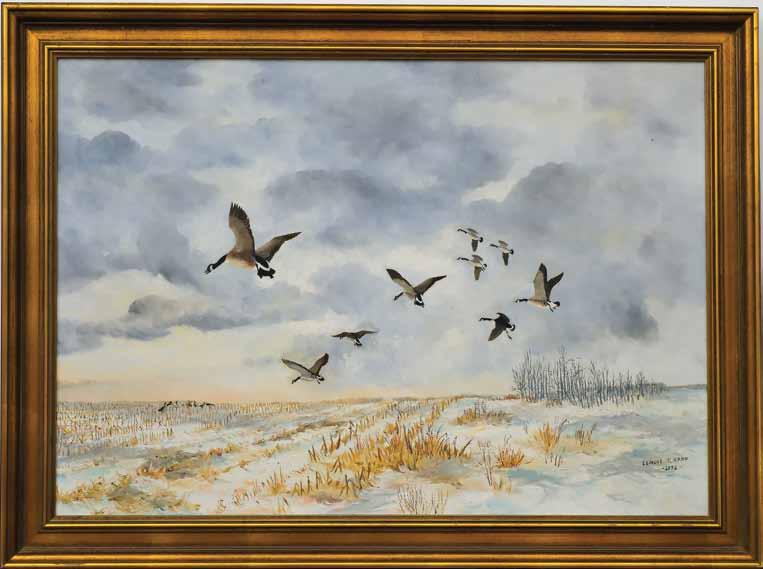
539 Lem Ward (1896-1984), oil on canvas. Of landing geese in a winter cornfield. Signed and dated 1972 lower right. Image measures 23.25” x 33.25”. Very minor yellowing to varnish layer; a few tiny spots of discoloration; otherwise very good and original.
Provenance: Dean Hyde collection. (3,000 - 5,000)
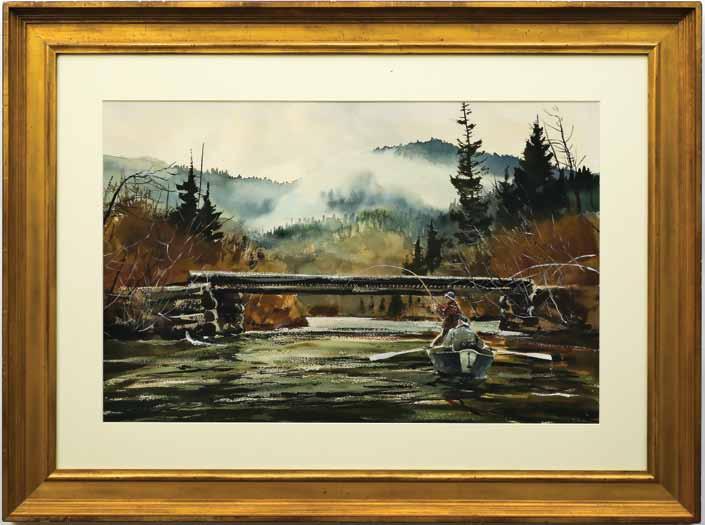
540 Chet Reneson (b. 1934), watercolor. Fishing scene. Likely a Maine scene of two men approaching a wooden bridge. One having just hooked a jumping salmon. Signed and dated ‘76 lower right. Image measures 18.5” x 28.5”. Very minor toning; small spot on matting behind glass. (4,000 - 6,000)
541 Chet Reneson (b. 1934), watercolor. Caribbean scene. Signed and dated 05 lower right. Image measures 14” x 20”. Very good and original.
(3,000 - 4,000)
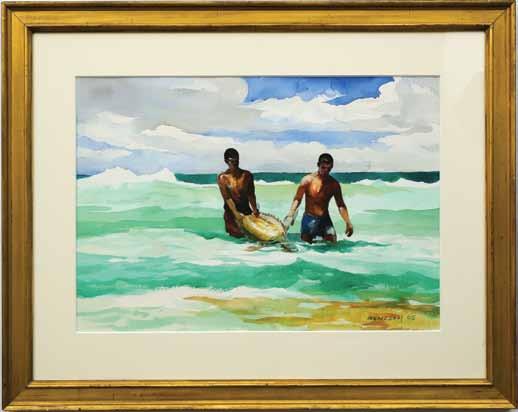
542 Chet Reneson (b. 1934), watercolor. Caribbean scene with fishermen. Signed and dated 02 lower right. Image measures 14” x 20”. Very good and original. (3,000 - 4,000)

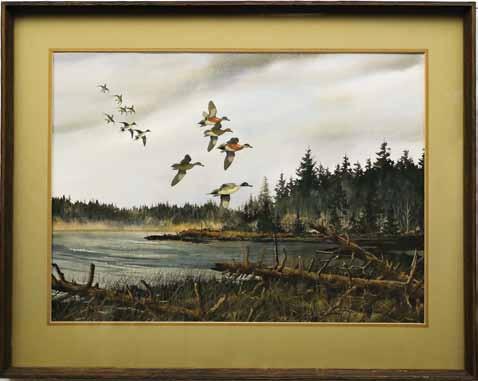
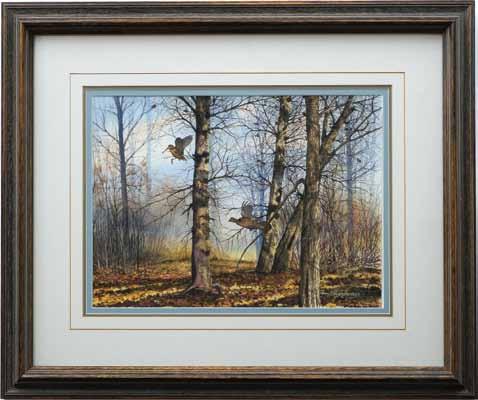
543 David Hagerbaumer (19212014), watercolor on paper. Of landing pintails and widgeon. Signed lower right. Image measures 20.75” x 29”. Very minor toning and faint spots of foxing in sky, otherwise excellent.
(3,000 - 5,000)
544 David Hagerbaumer (19212014), watercolor on paper. Of flying grouse and woodcock. Highly detailed autumn scene. Signed lower right. Image measures 13.25” x 18.25”. Excellent and original. (2,000 - 3,000)
545 David Hagerbaumer (1921-2014), watercolor on paper. Depicting incoming mallards. Signed and dated 1981 lower left. Image measures 22” x 29”. Excellent and original. (3,500 - 5,500)
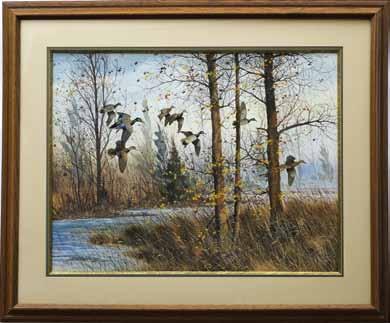
546 Herb Booth (1942-2014), watercolor on paper. Signed. Image measures 14” x 20.5”. Very detailed image of mallards lifting out of wooded marsh. Professionally framed and matted.
Provenance: Martin and Deborah Maloy collection. (600 - 800)

547 R.J. Nelson, watercolor. Of flying canvasbacks. Signed lower left. Image measures 17.5” x 26.5”. Excellent and original. (300 - 500)

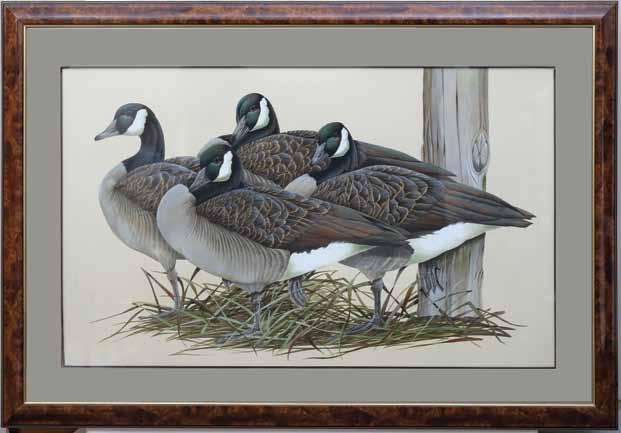
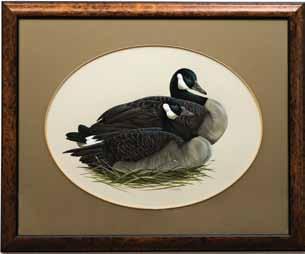
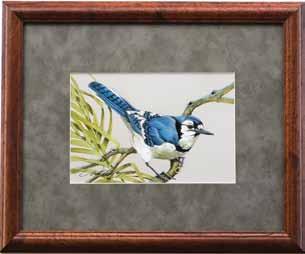
548 Art LaMay (b.1938), watercolor on paper board. Very large watercolor of Canada geese. Measures 31.5” x 52”. Very good and original. (800 - 1,200)
549 Art LaMay (b.1938), watercolor on paper board. Image measures 24” x 32”. Frame measures 36” x 44”. Canada geese. Signed. Professionally framed and matted. Excellent in all respects. (800 - 1,200)
550 Art LaMay (b.1938), watercolor on paper board. Well executed blue jay. Professionally framed and matted. Signed. Image measures 6” x 9.25”. Excellent and original. (300 - 500)
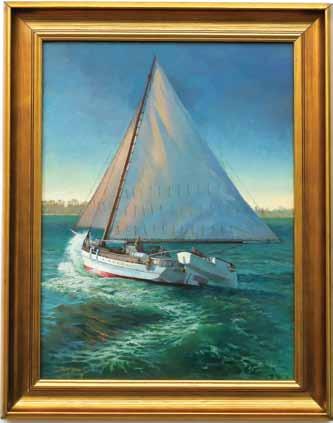
552 Larry Haines, acrylic on board. Image measures 23.5” x 31.5”. Signed. As viewed under uv light painting has two small spots on lower edge that have been restored; there is a visible scratch that runs approximately 12” to the center of the boat that has been repaired; artist may have changed or removed the name of the boat, that area has been inpainted. (800 - 1,200)
551 Lloyd Cargile (b.1938), oil on board. Image size 23.5” x 17.5”. Signed and dated 2014. Image remains excellent and original. (1,500 - 2,500)
553 Arthur D. Fuller (1889-1966), watercolor. Black ducks. Signed lower right. Image measures 9” x 13.25”. Very good and original. (1,000 - 1,400)

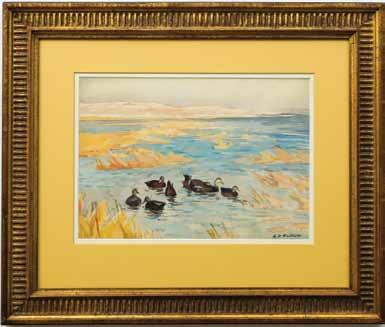
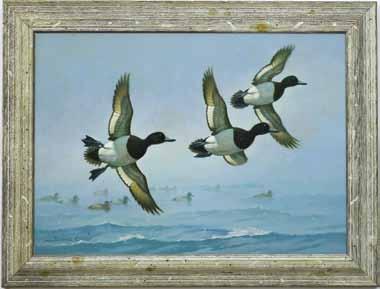
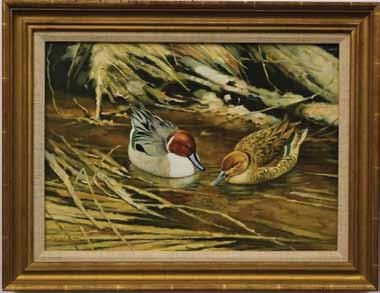

554 Daniel Loge (b.1954), oil on board. Of bluebills and snowfall. Signed lower left. Image measures 19.5” x 27.5”. Very good and original.
Provenance: Dean Hyde collection. (600 - 900)
555 Daniel Loge (b.1954), oil on canvas. Pair of pintails. Signed lower left. Image measures 14.5” x 20.5”. Excellent and original.
Provenance: Dean Hyde collection. (500 - 800)
556 Daniel Loge (b.1954), oil on canvas. Flying goldeneye. Signed lower right. Image measures 11.5” x 20.5”. Very good and original.
Provenance: Dean Hyde collection. (300 - 500)
556A Dr. Edgar Burke, oil on canvas board. Image measures 7.25” x 9.5”. Slight crackalature and darkening varnish; Signed. As viewed under uv light remains struturally good. (600 - 900)
556B Dr. Edgar Burke, oil on canvas board. Image measures 7.5” x 9.5”. Signed. Slight darkening to varnish, otherwise very good and original. (500 - 800)
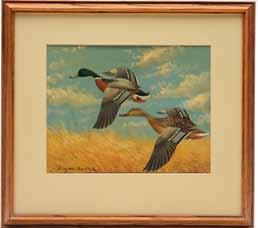

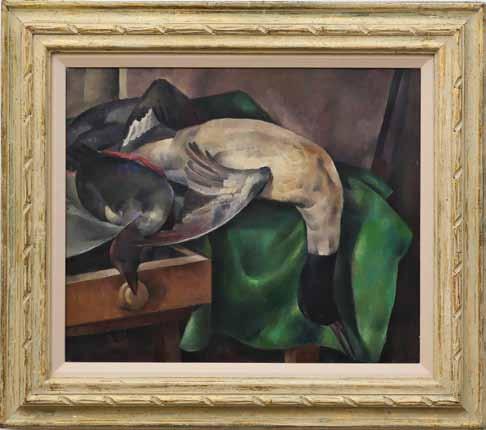
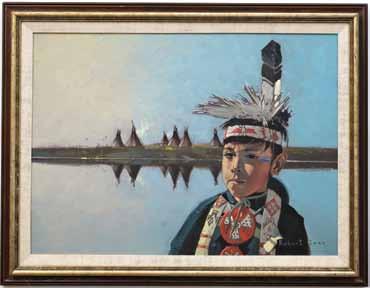
558 Robert Genn, oil on canvas. Image measures 21.5” x 29.5”. Signed. Native American boy in headdress with teppee camp in background. Titled “A Call to Told Poetry Bill Window-Rock” Painting remains very good and original with only very slight darkening to varnish. (1,500 - 2,500)
557 Bror Nordfeldt (1878 - 1955), oil on canvas. Image measures 19.5” x 23.5”. Signed lower left. Titled “Dead Ducks”. Gallery sticker from Gerald Peters on backside. Dead game image of a pair of American mergansers draped over table with shotgun in background. One small repair with inpainting about the size of a dime against the edge on the right side. (5,000 - 8,000)
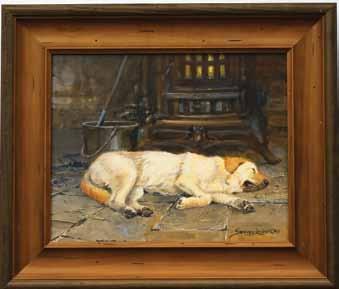
558A John Seery Lester, oil on board. Image measures 7.75” x 9.75”. Signed. Titled “Pooped”. Remains excellent and original.
Provenance: Martin and Deborah Maloy collection. (800 - 1,200)

560 William Schmedtgen (18621936), oil on canvas. Of a bass taking fly. Signed lower left. Image was used on the cover of the June 2013 issue of Sporting Classics, issue included. Image measures 19.5” x 13.5”. Small spot of inpainting, lower left and on very margin top left, otherwise excellent and original.
(1,000 - 1,400)
559 Ralph Crosby Smith (1907-1962), oil on board. Of pilgrims shooting turkey out of their roost. Exact image was used in “The Story of American Hunting and Firearms” by the editors of Outdoor Life published in 1959. Book included. Image measures 21.75” x 16”. Inpainting to a scratch lower left and a few small spots on rock in leaves. (2,500 - 3,500)

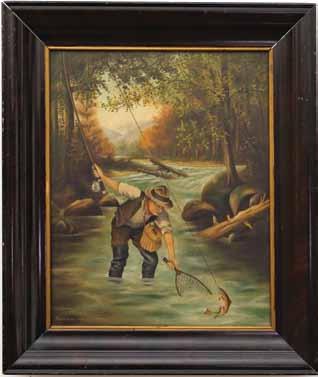
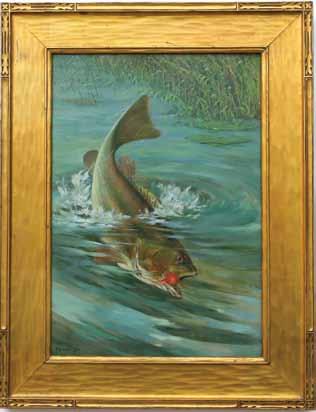
561 Agnes Lawrence, oil on canvas. After Oliver Kemp. Fly fishing scene of a man netting a trout. Signed lower left. Image measures 19.5” x 15.5”. Two tiny flakes, otherwise excellent. (800 - 1,200)


562 Unknown artist, late 19th century, Folk art depiction of shorebird hunting. Likely Massachusetts. Unsigned. Image measures 15.5” x 19.5”. Scattered crazing and a small paint flake in lower sky; old varnish layer has yellowed somewhat; no tears on inpainting visible under uv light.
Provenance: Ted and Judy Harmon collection.
(1,200 - 1,800)
563 John Dawson Watson, watercolor and gauche on paper. Image measures 15” x 20”. Initialed JDW and dated 1870. Early duck hunter holding an early fowling gun. Remains in original frame with wooden backing and early label from GRINDELEY. Glass is broken, but painting remains in very good to excellent condition.
(800 - 1,200)


564 Jerome Howes (b.1955), acrylic on board. Harbor scene with clipper ships at dusk. Signed lower right. Image measures 15.5” x 25.5”. Some small spots of discoloration otherwise very good and original.
Provenance: Ted and Judy Harmon collection.
(600 - 900)
565 Jerome Howes (b.1955), acrylic on board. Of ships and lighthouse at dawn. Signed lower left. Image measures 23.5” x 29.5”. Very good and original.
Provenance: Ted and Judy Harmon collection.
(600 - 900)
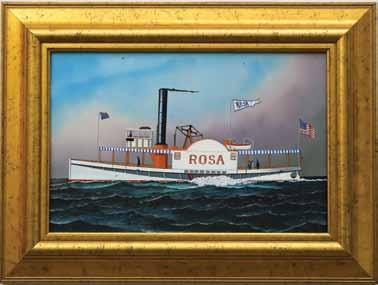

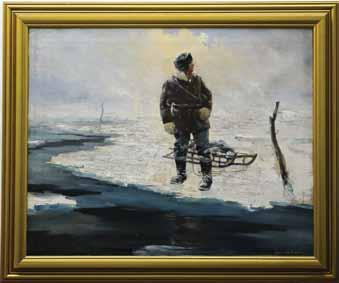

566 Jerome Howes (b.1955), acrylic on board. Of the paddle wheeler “Rosa”. Unsigned. Image measures 11.5” x 17.5”. A few tiny spots of discoloration, otherwise excellent and original.
Provenance: Ted and Judy Harmon collection. (500 - 800)
567 Massachusetts waterfowl stamps and print. Framed print and incomplete set of Massachusetts state waterfowl stamps. Frame measures 23.5” and 27.5” Slight wear to frame, not examined out of frame. (300 - 500)
568 Anton Otto Fischer (1882-1962), oil on canvas. Man pulling sled, trapped at ice end. Signed. Image measures 24” x 30”. As viewed under UV light painting remains in excellent condition; stretcher marks are slightly visible on right and left side. (1,500 - 2,500)
569 Willey Crockett, oil on canvas. Measures 35.5” x 48”. Signed and dated 1984. Remains very good and original. (800 - 1,200)
570 William Crockett, watercolor. Of flying ducks in snow fall. Signed and dated ‘79 lower left. Image measures 16.5” x 22.5”. Very good and original. (300 - 500)
571 Group of five federal duck stamp prints. All framed identical and in very good original condition. Includes 1958 by Les Kouba, 1948 by Maynard Reece, 1957 by Edward Bierly, 1969 by Maynard Reece, and 1968 by Gigi Pritchard.
Provenance: Martin and Deborah Maloy collection.
(500 - 800)
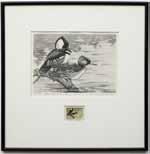
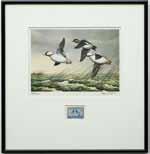
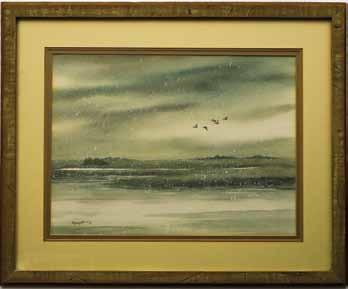

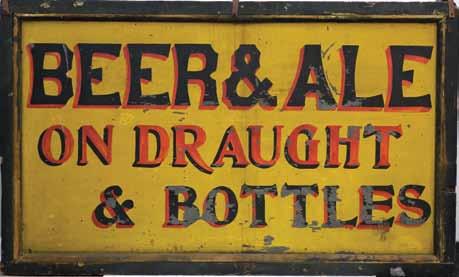
572 Early trade sign, pre-prohibition. Painted on lead, framed in wood. With original hangers so in can be used to show both sides. Measures 36” x 60”. Original condition that has flaked on sign to expose lead and natural wear to wood. (1,500 - 2,500)
573 Frank Benson (1862-1951). Two unframed etchings, one titled “The Punter,” accompanied by an old gallery hang tag, image measures 11.75” by 7.75” and another titled “Supper,” and dated 1920, image measures 6.75” by 5” Very good with minimal discoloration to matting.
(1,000 - 2,000)
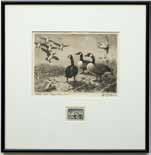
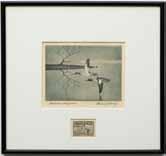
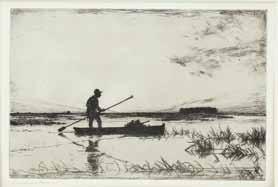
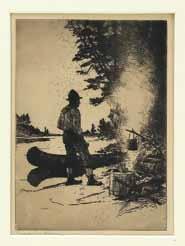

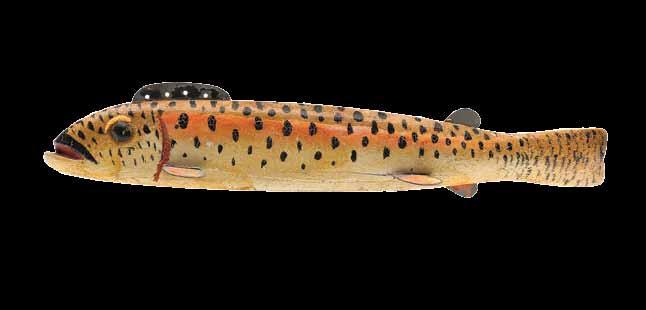

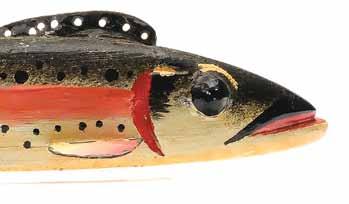
574 Oscar Peterson (1887-1951), Cadillac, Michigan. Rainbow trout, 1st half 19th century. Tack eyes. A rare 10” model. 1.25” tall x .75” wide. Excellent original paint; small stress crack near anal fin; covered with a light coat of varnish; small paint loss around fins.
(4,000 - 5,000)
575 Oscar Peterson (1887-1951), Cadillac, Michigan. Rainbow trout with tack eyes and rare paint pattern. Measures 9” x 1.25” tall x .75” wide. Strong original paint protected by a coat of varnish; both paint and varnish are crazed lightly; some paint loss at fins.
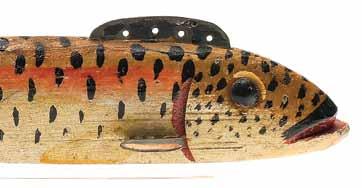
(2,500 - 3,500)
576 Oscar Peterson (1887-1951), Cadillac, Michigan. Brook trout with glass eyes, 2nd half 20th century. Measures 8.25” long. Appears to be strong original paint; protected by a coat of varnish that floureces orange under black light; small portion fo tail has been broken and reset; paint loss at fins and belly weight; also displays cut gill characteristics. (1,500 - 2,500)



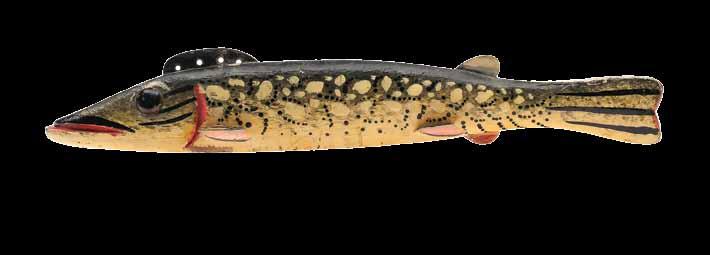
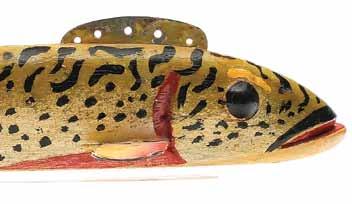
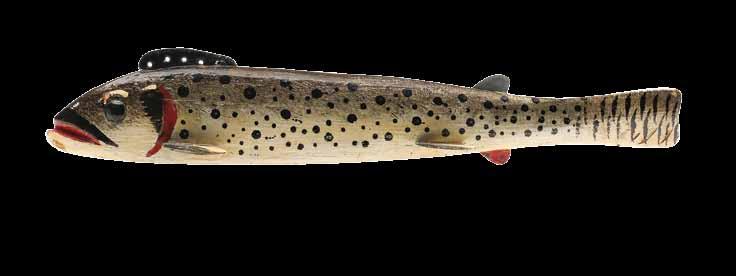
577 Oscar Peterson (1887-1951), Cadillac, Michigan. Brook trout with tack eyes and so called cut gill, 1st half 20th century. Measures 9.5” x 1.25” tall x .75” wide. Strong original paint protected by a light coat of varnish; tail has been broken and reset; small amount of paint loss at fins. (2,000 - 2,500)
578 Oscar Peterson (1887-1951), Cadillac, Michigan. Pike with tack eyes and bear paw pattern on sides. Measures 9” x 1.25” x .75”. Strong original paint with light coat of varnish; some loss at fins and belly weight; small dent at top of rear tail. (2,000 - 3,000)

579 Oscar Peterson (1887-1951), Cadillac, Michigan. Brown trout with tack eyes. Measures 10” x 1.5” tall x .75” wide. Very strong original paint protected by a light coat of varnish; small area of paint loss at tail and underside of belly weights. (3,000 - 4,000)
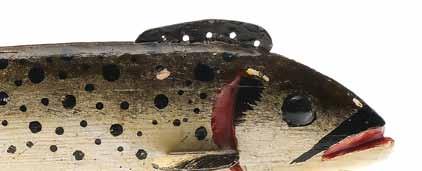

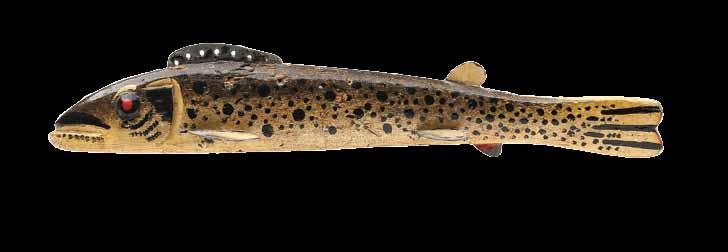

580 Oscar Peterson (1887-1951), Cadillac, Michigan. A rare muskie with painted eyes, 1st half 20th century. Measures 5.75” x 7/8” tall x .5” wide. Strong original paint protected by a light coat of varnish; small areas of paint loss at fins. (2,000 - 2,500)
581 Oscar Peterson (1887-1951), Cadillac, Michigan. Brown trout with tack eyes and gill plates painted below eyes, 1st half 20th century. Measures 8.25” x 1.25” x .75”. Strong original paint protected by a coat of varnish; loss at fins and belly weights; also a few nicks and gouges to sides of body. (2,000 - 2,500)
582 Oscar Peterson (1887-1951), Cadillac, Michigan. Brown trout with tack eyes, 1st half 20th century. Measures 7.25” x 1.25” tall x 5/8” wide. Very strong original paint protected by a very light coat of varnish; remains very good and original. (2,000 - 2,500)
583 Oscar Peterson (1887-1951), Cadillac, Michigan. Rainbow trout with tack eyes, 1st half 20th century. Measures 9” x 1.25” x .75”. Strong original paint protected by a coat of varnish; some paint loss at fins; belly weights and small areas on mostly around tail. (1,200 - 1,800)
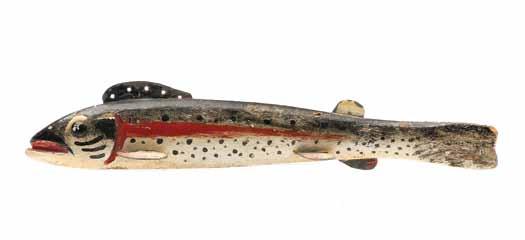
584 Oscar Peterson (1887-1951), Cadillac, Michigan. Perch with tack eyes. Measures 7” x 1.25” x .5”. Strong original paint protected by a light coat of varnish; additional fancy gold paint around eyes; small areeas of paint loss at fins and around belly weight. (1,200 - 1,500)
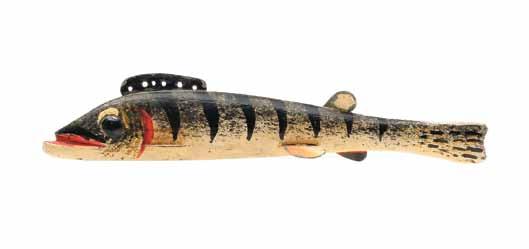
585 Oscar Peterson (1887-1951), Cadillac, Michigan. Brown trout, 1st half 20th century. Measures 8.25” x 1.25” x 5/8”. Original paint protected by a light coat of varnish; varnish has slightly worn away from one side of body; some paint loss at fins and belly weight. (1,200 - 1,800)
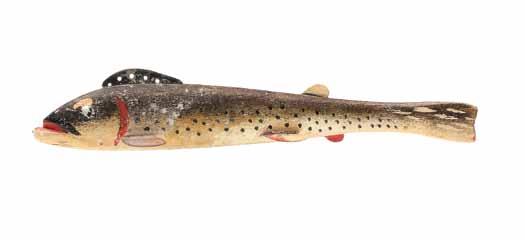
586 Oscar Peterson (1887-1951), Cadillac, Michigan. Brook trout with painted eyes and cut gill. Measures 6.25” x 1” x .5”. Remains near excellent. (1,000 - 1,500)
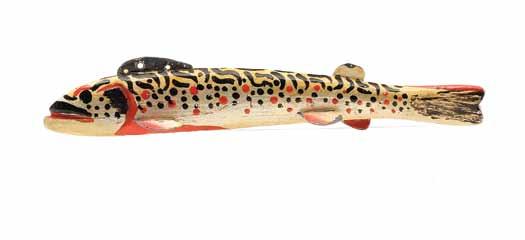

587 Outstanding patriotic folk art mirror, circa 1870s. Relief carved oak frame with implements of war to include canons, swords, bow and arrow, armor, and edged weapons. Also dueling pistols, trumpet, bible, snake, and drum. Carved spread wing eagle with shield and banner that reads “E Pluribus Unum”. Likely carved for an exhibition celebrating America’s Centennial. The master carver is unknown, but each side of the mirror is carved form a single piece of
wood. Measures 26” x 23”, and is 3.5” deep. Stained oak with a early coat of varnish; with spots of wear; some small chips and losses; separation at two corners of frame; a few broken pieces were tightly reglued; one wing of eagle was professionally reset with some touchup; top beak of eagle and handle of dueling pistol at lower left professionally restored. (8,000 - 12,000)

588 Unknown artist, late 19th century, Patriotic oil on wood panel of a spread wing eagle clutching arrows and olive branches. Two American flags and patriotic shield. Ribbon banner with “E Pluribus Unum. E.Hicks 1897” written on back. Painting measures 5.5” x 19.5”. Some small spots of inpainting on flags; appears to have had multiple coats of varnish; tiny dents and scratches.
(3,500 - 4,500)
589 Unknown maker, early 20th century. Early carved plaque of a bicycle racer. Man is wearing a red hat and sash with a multi colored ribbon pinned to one shoulder. Contemporary frame is aged to match the carving. Frame measures 25.25” x 15”. Original paint with minor flaking; an early varnish layer with an appealing crazed surface; some restoration to handle bars and billowing ribbon.
(3,000 - 4,000)
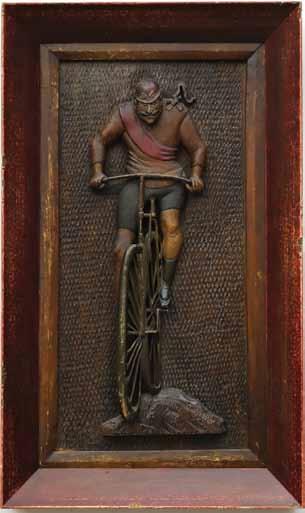


590 Michael Ringer “The Market Hunter” bronze. A
with decoys and goose returning from the field. Signed and numbered 11/100 on bronze. Hardwood and marble base that rotates is included. Bronze stands 24.75” tall. Excellent and original
Provenance: Dean Hyde collection. (3,000 - 5,000)
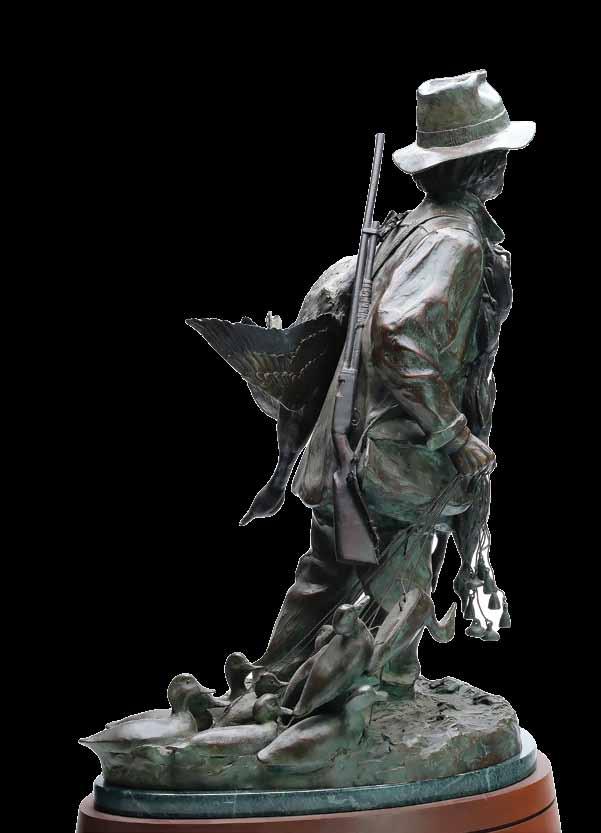
591 Bird tree with six shorebirds. Mounted on a cyprus root. Appears to be old as birds have crazing to both varnish and paint. Stands 16” tall. All birds are in original paint with a protective coat of varnish that has mellowed over time.
(500 - 700)
592 Clark Voorhees (1911-1980), Weston, Vermont. Dolphin wall plaque. Maker’s name and initials stamped on back. Measures 18.25” long. Surface has darkened under a thin coat of varnish, otherwise excellent.
Provenance: Dan Graf collection. (1,200 - 1,800)
593 Clark Voorhees (1911-1980), Weston, Vermont. Sperm whale plaque with applied metal teeth. Maker’s name and initials stamped on the back. Measures 17.25” long. Excellent original paint that has darkened under a thin coat of varnish; top half of tail is a professional replacement.
(1,000 - 1,500)
594 Unknown maker, mid 20th century. Two carved wooden horses. “Adrie” carved in underside of brown horse. Measure 14” and 12.5” long. Original paint with areas of touchup, mostly on brown horse; some restoration to cracks in legs; chip to one replaced ear on brown horse.
Provenance: Martin and Deborah Maloy collection. (500 - 800)
595 Early carved walking stick. With civil war battle history, both confederate and union battle notes carved from top to bottom of staff. Cut from the last woods of the Antietam battle field. Battle fought September 17, 1862. General R.E. Lee commander and chief of the confederate forces at Antietam which numbered 97,445 lost to 10,240. General Geo B McClellan commander and chief of the federal forces at Antietam which numbered 87,164 lost to 12,410. Cane is protected by a old coat fo varnish which has crazed with age; shows nice patina; structurally good with light wear to some surface areas.
Provenance: Howard Wedell collection. collection. Ted and Judy Harmon collection. (1,200 1,500)
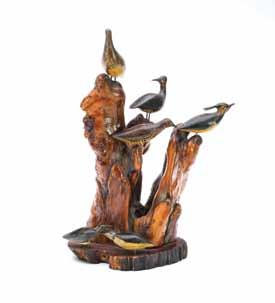

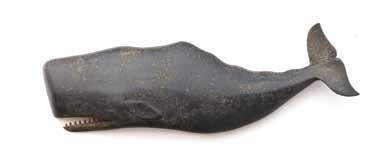
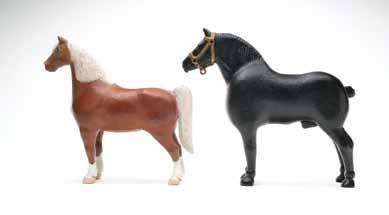





The direct descendant of Philip Livingston, signer of the Declaration of Independence, Philip Livingston Poe (18791970) was a distinguished member of the Baltimore Stock Exchange who founded investment firm Poe & Davies in 1904. His financial acumen paralleled the country’s economic rise and in his eighth decade he bought the MA & PA Railroad and took it out of debt. Long Point, historically one of the oldest brick houses on the Eastern Shore of Maryland, belonged to the Poe family. Carrol Elder, renowned artist and craftsman of Easton, Maryland created this fireplace screen as a gift to his friend Philip Livingston Poe.
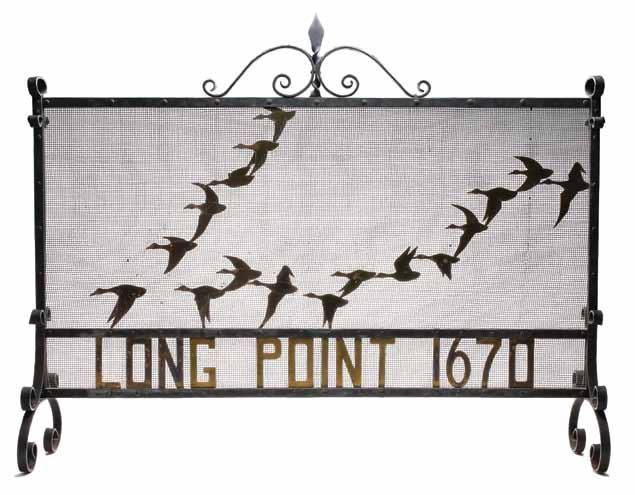
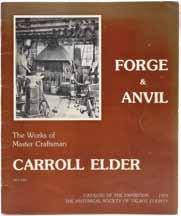
596 Carroll MacTavish Elder (1901-1965), Easton, Maryland. A group of brass decorative pieces. To include a custom fire screen, duck head door knockers, and two pair of goose head doorstops. Firescreen was made for a historic home built in 1670 at Long Point, Easton, Maryland. Firescreen measures 44.5” x 35.5”. Door knockers are 6” wide. Door stops are 13” tall. Excellent used condition. (2,500 - 3,500)
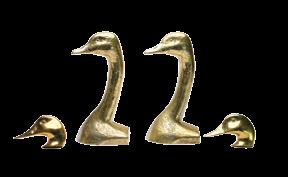

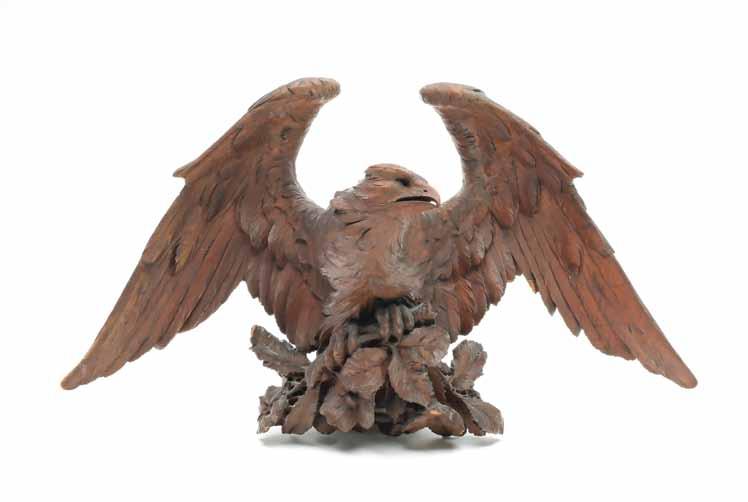
597 Unknown maker, circa 1900. Spread wing eagle architectural carving. Likely from a Baltimore, Maryland artists shop. With turned head and open beak. Deep relief feather carving. Stands 11.5” tall, with a 20.5” wingspan. Original stained oak with very minor rubs; some small chips at high points; one wingtip was cracked and reglued.
Provenance: Carving hung above a door in the Baltimore Stock Exchange and was given as a gift to Philip Livingston Poe upon his retirement.
(2,000 - 3,000)
598 Carroll MacTavish Elder (19011965), Easton, Maryland. Pair of brass goose head andirons. Stand 13” tall, log supports measure 13” long. Excellent as used condition.
(400 - 600)
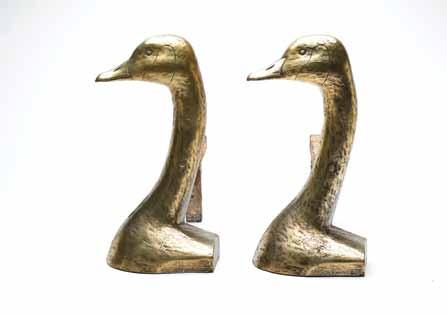

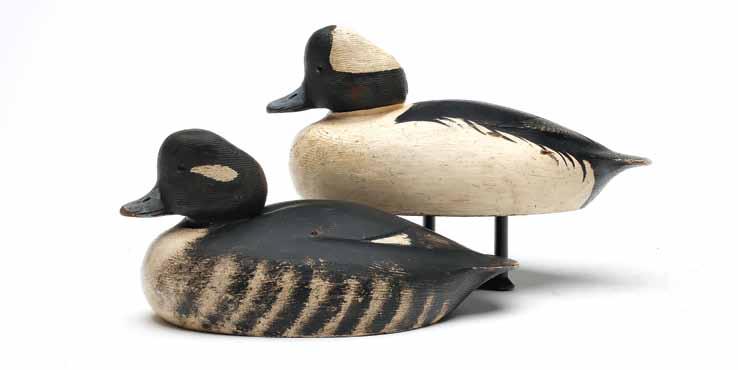
600 Ken Anger
Ontario. Thinly hollowed Canada goose with relief wing carving and extra incised feather carving on wings. Measures 22” long. Original paint with minor wear; under an early coat of varnish that has darkened with age; slight separation at neck seat; wood on underside of bill tip was shaved flat.
Provenance: Martin and Deborah Maloy collection. (6,000 - 9,000)
601 Ken Anger
Ontario. Pair of buffleheads with relief wing carving. Measure 10” and 11” long. Original paint with minor to moderate wear under an early coat of varnish; lightly hit by shot; tiny chip on tip of drake’s tail.
Provenance: Dr. Michael Shannahan collection. (3,000 - 4,000)
602 Ken Anger (1905-1961), Dunnville, Ontario. Rare bluewing teal with relief wing and incised feather carving. Decoy was never rigged or weighted. Measures 10.75” long. Excellent and original.
Provenance: Martin and Deborah Maloy collection.
Literature: “The Great Book of Waterfowl Decoys”, Joe Engers, editor, page 284, exact decoy pictured. (2,000 - 3,000)

603 Ken Anger (1905-1961), Dunnville, Ontario. Early black duck with slightly turned head and relief wing carving. Mackey collection ink stamp on underside. Also with a green Sotheby’s Park Barnett auction tag. Measures 16.5” long. Original paint with minor wear; very lightly hit by shot, otherwise excellent structurally.
Provenance: Martin and Deborah Maloy collection. (800 - 1,200)
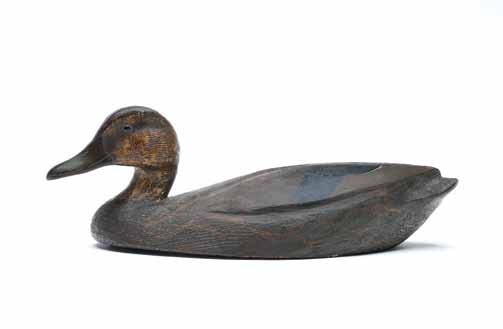
604 Unknown maker, Eastern Ontario, early 20th century. Pair of bufflehead with slightly turned heads. Gouge feather carving on bodies and incised feather carving on heads. Hen with two piece body screwed from the underside. “RAS” carved on underside of drake. Measure 10.75” long. Original paint with minor gunning wear; under a thin coat of varnish that has crazed with age; very good structurally.
Provenance: Dean Hyde collection. (2,500 - 3,500)
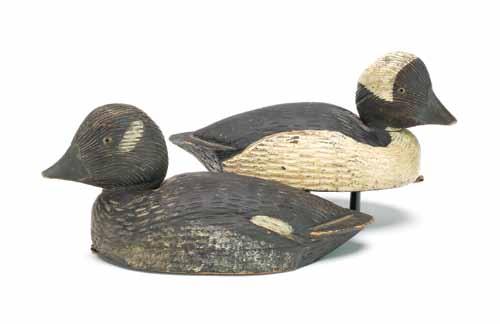

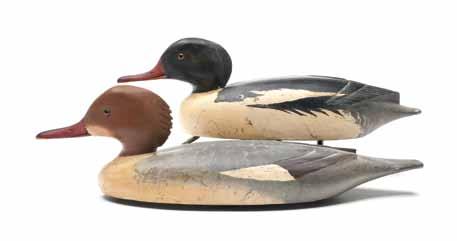
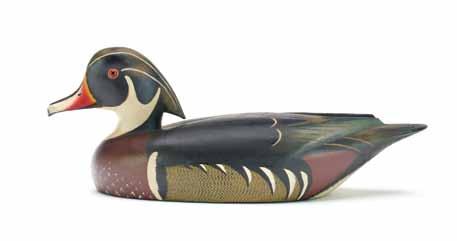
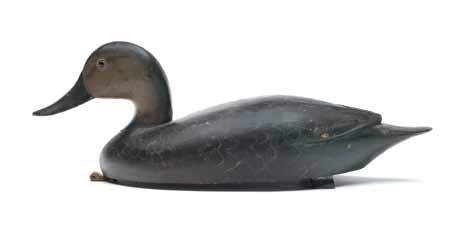
605 Gordon Baker, Jasper, Ontario. Hooded merganser with reared back head and extended crest. Signed and dated 1968 on underside. 12” long. Original paint with minor wear; tiny chip in underside of bill tip.
Provenance: Bill and Alice Walsh Collection. Obtained from Parker Conner. (600 - 900)
606
607
David W. Nichol (1890-1977), Smith Falls, Ontario. Rigmate pair of working mergansers. Deep relief wingtip carving and extended crests. “Penn 7” stamped in underside of hen. Measure 16.25” and 17.75” long. Original paint with minor gunning wear; surface has darkened with age; hen with a filled defect in wood on tail from when the decoy was made; both with green over paint on underside.
Provenance: Martin and Deborah Maloy collection. (1,500 - 2,500)
David W. Nichol (1890-1977), Smith Falls, Ontario. Wood duck drake with extended crest and slightly turned head. Relief wingtip carving. Measures 13.75” long. Excellent and original.
Provenance: Dean Hyde collection. (1,200 - 1,800)
608 David Nichols (1859-1949), Smiths Falls, Ontario. Black duck with relief wingtip carving and scratch feather paint detail. Measures 17” long. Original paint with minor gunning wear; small nail added to one side of neck seat, otherwise excellent structurally.
Provenance: Martin and Deborah Maloy collection. (800 - 1,200)
609 David W. Nichol (1890-1977), Smith Falls, Ontario. Pair of bluebill. Deep body style with relief wingtip carving and comb feather paint on drake. Hen branded “RPT”. Measure 15.5” long. Original paint under a thin coat of varnish that has darkened with age; very minor wear; excellent structurally.
Provenance: Dean Hyde collection
(1,200 - 1,800)
610 Morris Boat Works, Hamilton Bay, Ontario. Hollow carved bluebill with comb feather paint detail. Measures 12.25” long. Original paint with areas of touchup to black; separation at a thin knot in one side of breast; some filled shot strikes on other side of breast.
(2,000 - 3,000)

611 Roger Dolson (1911-1979), Mitchell’s Bay, Ontario. Pair of canvasbacks. Branded “RD” on the underside. Measure 14.75” long. Original paint that has darkened with age show s minor wear; small dents and shot marks; separation at wood grain at one side of hen secured with 3 old nails; defect in wood on drake’s breast was filled and touched up.
Provenance: Bill and Alice Walsh Collection. One obtained Julia Auction in August 1985 #548. Other Bought from Paul Brisco in Jan 1986. (1,200 - 1,800)
612 Duncan Ducharme (1912 - 1972), Delta Marsh, Manitoba. Canvasback hen with slope breast carving and metal keel. Measures 13” long. Original paint with moderate flaking and wear; tight crack through neck; filled crack along the back and in breast. (1,200 - 1,800)
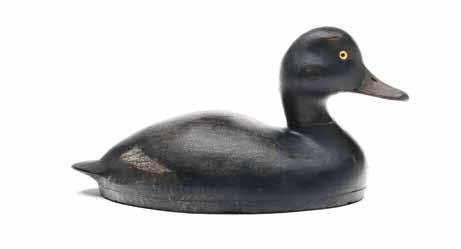
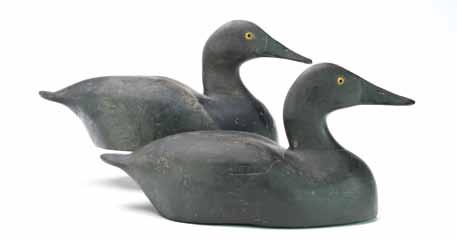
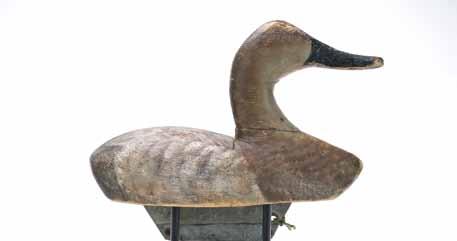
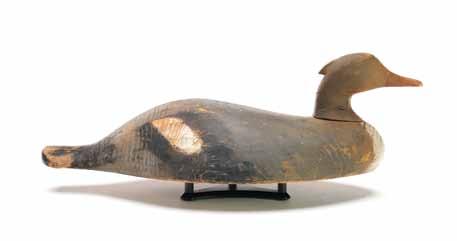
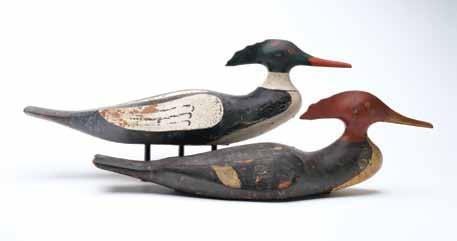


613
614
Unknown maker, Nova Scotia, early 20th century. Merganser hen, similar in style to Harold Burke, with slightly humped back and extended crest. Measures 16.5” long. Original paint with moderate gunning wear; hairline crack along back; tight cracks in one side of neck; tiny chip near wooden dowel on top of head. (600 - 900)
615
Orran Hiltz (1901 - 1978), Indian Point, Nova Scotia. Hen and drake merganser with thin extended crest and relief wing carving. Measure 19.25” and 19.75” long. Mix of original and early second coat by the maker, showing moderate wear; tiny chip at the tip of each crest, otherwise very good structurally
Provenance: Martin and Deborah Maloy collection. (1,500 - 2,500)
616
Unknown maker, Ontario, early 20th century. Long body black duck with scratch feather paint detail. Measures 18.75” long. Original paint with very minor wear; excellent structurally.
Provenance: Dean Hyde collection. (800 - 1,200)
Ken Anger (1905-1961), Dunnville, Ontario. Hollow carved mallard hen. Incised wing feather carving and slightly turned head. Measures 16” long. Original paint with minor gunning wear; tightly reglued crack in bill. (600 - 900)

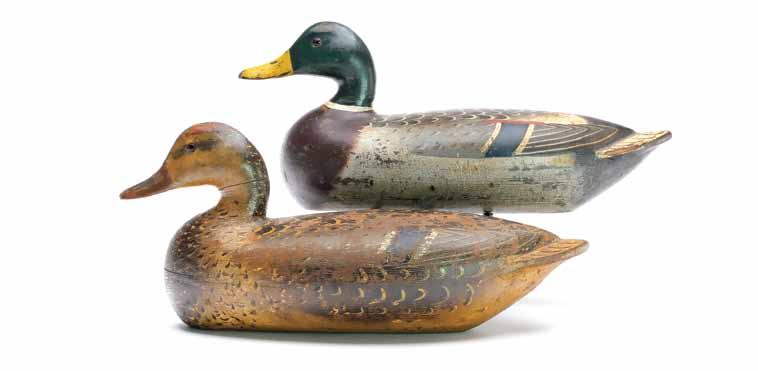
Charles Perdew (1874-1963), Henry, Illinois.
Very rare, hollow carved bluebill hen with wide cheek carving. Comb feather paint detail on sides and breast. Measures 12” long. Original paint with moderate flaking and wear under a thick coat of varnish that has darkened with age; weight was removed, otherwise very good structurally.
(2,500 - 3,500)
618 Charles Perdew (1874-1963), Henry, Illinois.
Rigmate pair of mallards. Hollow carved. Comb feather paint detail on drake. Measure 15.5” long. Original paint with moderate flaking and wear; under an early coat of varnish that has darkened with age; crack through hen’s neck; restoration around drake’s neck seat.
Literature: “Decoys of the Mississippi Flyway” by Alan G. Haid, page 161, exact decoys pictured. (3,000 - 4,000)
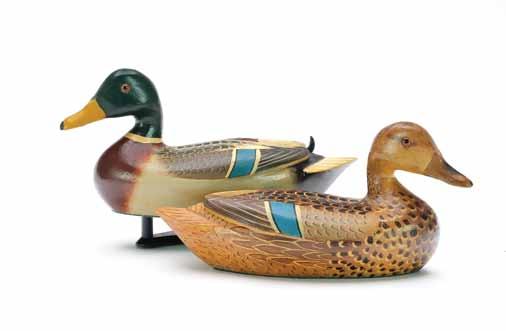
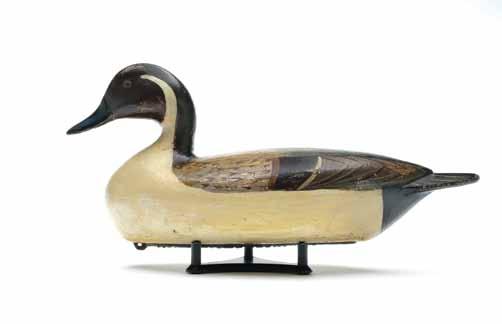

619
620
Charles Perdew (1874-1963), Henry, Illinois. Pair of 1/3 size decorative mallards. Slightly turned heads and deep relief wingtip carving. Carved wooden tail sprig on drake. Both with green felt on underside. Measures 9.25” long. The original varnish has darkened slightly with age; very fine hairline crack in one side of hen’s neck, otherwise near mint.
Provenance: Martin and Deborah Maloy collection. (1,500 - 2,500)
621
Charles Perdew (1874-1963), Henry, Illinois. Hollow carved pintail with comb feather paint detail. Retains the original Perdew weight. Measures 15.75” long. Mix of original and early paint restoration; paint on wings and back are original; white areas and most of head in a second coat of paint; some touchup on wingtips; fine hairline crack in neck, otherwise very good structurally.
Provenance: Martin and Deborah Maloy collection. (1,000 - 1,400)
Bert Graves (1880-1956), Peoria, Illinois. Pair of mallards. Hollow carved with upswept tails. Both retain the original Graves weight. Measure 16.75” long. Original paint with minor to moderate wear; minor roughness on edge of hen’s bill; large tail chip repair on hen; small dents and shot marks on each; chipping and roughenss on drake’s tail was touched up. (2,000 - 3,000)
622 Chris Powers (1902-1958), Peru, Illinois. Rigmate pair of mallards. Hollow carved with slightly turned heads. Applied metal tail sprig on drake. Measure 16.75” and 17.5” long. Original paint with minor flaking and wear; under a thin coat of varnish; tight crack through drake’s neck and one side of hen’s neck, otherwise very good structurally.
Provenance: Martin and Deborah Maloy collection. (2,000 - 3,000)
623 Hector “Heck” Whittington (19071981), Oglesby, Illinois. Rigmate pair of mallards. Hollow carved and drake with slightly turned head. Drake with comb feather paint detail on body. Hen with scratch feather paint detail on head. Measure 17” long. Original paint with very minor wear; a small spot on drakes tail where the wet paint was pulled.
Provenance: Martin and Deborah Maloy collection. (1,500 - 2,500)
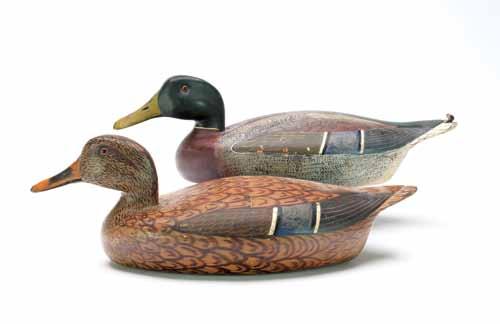
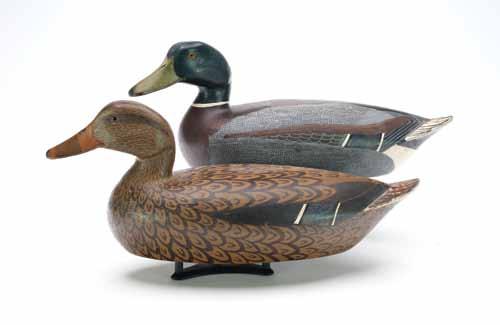
624 Fred Coleman, Hennepin, Illinois. Pair of greenwing teal. Hollow carved with comb feather paint detail. Identified in pen on the underside of drake. Measure 12” long. Original paint with minor gunning wear; drake with a tight crack through neck and spots to flaking on one side of neck; hen is missing one eye and has a vertical crack on the front and back of neck; chipping on edge of bill with early touchup.
Provenance: Martin and Deborah Maloy collection. (1,200 - 1,800)
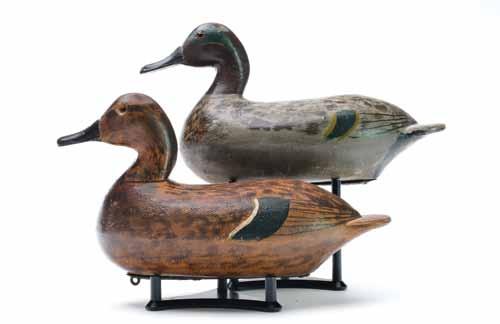
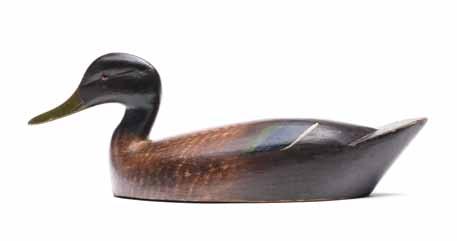
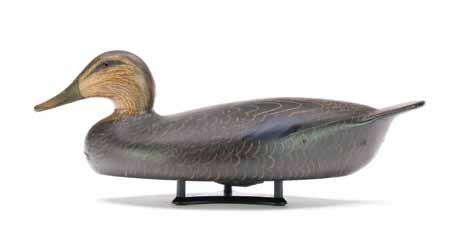
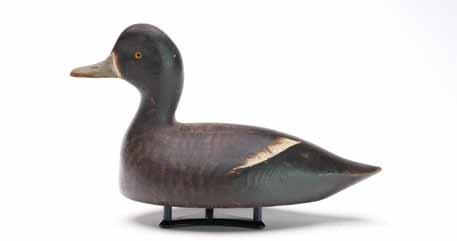

625 Chauncey Wheeler (1888-1945), Alexandria Bay, New York. Black duck with upswept tail. Measures 17.5” long. Original paint with very minor wear; under a coat of varnish; a few shot strikes; professional neck repair with touchup to most of the neck.
Provenance: Dean Hyde collection. (2,000 - 3,000)
626 Sam Denny (1874-1953) Alexandria Bay, New York. Black duck. “OLS” painted on underside. Measures 16” long. Original paint with minor wear; under a coat of varnish.
Provenance: Dean Hyde collection. (1,200 - 1,800)
627 Frank Coombs (1882-1958), Alexandria Bay, New York. Bluebill hen. Branded “C.A. Duke” Also stamped “SGH” for the collection of Somers Headly. Measures 14.75” long. Original paint with minor wear; hairline crack in back; bill was cracked down and reset with three small nails on underside.
Provenance: Bill and Alice Walsh Collection. Obtained from Somers G. Headley, March 1986. (1,000 - 1,400)
628 Unknown maker, Alexandria Bay, New York, early 20th century. Merganser hen with extended crest. Measures 13.5” long. Original paint with minor gunning wear; moderately hit by shot; hairline crack in back; one shot strike on crest was darkened.
Provenance: Dean Hyde collection. (1,200 - 1,800)
629 James Hungerford (1863-1940), Clayton, New York. Working bufflehead. Two piece body with relief wing carving and carved eyes. Measures 9.5” long. Original paint with minor flaking and wear; mostly on one side of head; fine hairline crack in upper part of bill; and along the underside.
Provenance: Bill and Alice Walsh Collection. Obtained at Julia-Guyette Auction in Salisbury Show Auction Oct. 7, 1989 #639. (600 - 900)
630 Dingman family, Alexandria Bay, New York, circa 1930. Pair of bluebills. Comb feather paint detail on drake. Measure 15” long. Original paint with moderate wear; heavily hit by shot; old chip in one side of hen’s tail; crack through drake’s neck; one of drake’s eyes is missing; each with a hairline crack in one eye.
Provenance: Chris Pitman collection. (1,000 - 1,400)
631 Chauncey Wheeler (1888-1945), Alexandria Bay, New York. Black duck with slightly raised head and feather gouging at tail. “TD” carved in underside. Measures 17.75” long. Original paint with moderate flaking and wear; heavily hit by shot; old chip in tail that was darkened; two shot strikes on head with touchup.
Provenance: Bill and Alice Walsh Collection. Obtained from Parker Conner, Richmond, VA 1976. (1,200 - 1,800)
632 Chauncey Wheeler (1888-1945), Alexandria Bay, New York. Goldeneye hen with tucked head and eye groove carving. Measures 13.75” long. Original paint with moderate gunning wear; hit by shot; minor roughness on edge of tail.
Provenance: Chris Pitman collection. (600 - 900)



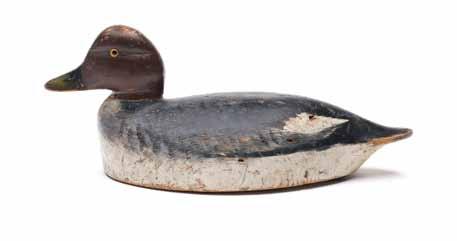
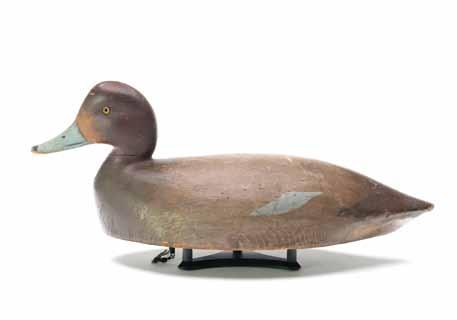

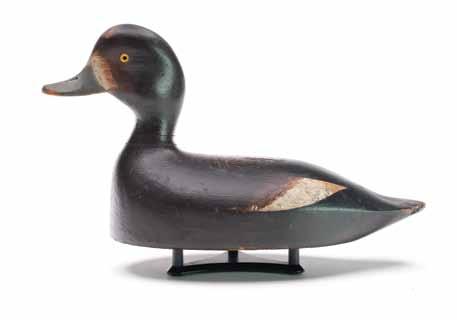
633 Sam Denny (1874-1953) Alexandria Bay, New York. Redhead hen. “JWW” painted on underside. Measures 16” long. Original paint with moderate wear; heavily hit by shot; tiny chip and roughness on tip of bill.
Provenance: Chris Pitman collection. (800 - 1,200)
634 Sam Denny (1874-1953), Alexandria Bay, New York. Pair of bluebills. Comb feather paint detail and typical eye groove carving. “OLS” painted on underside. Also stamped “CALUMET”. Measures 15.5” and 14.5” long. Original paint with minor to moderate wear; some over paint on underside of hen; very good structurally.
Provenance: Bill and Alice Walsh Collection. Obtained from Larry Lambert Nov. 9, 1982 who had had them in his collection for some time. (600 - 900)
635 Frank Coombs (1882-1958), Alexandria Bay, New York. Bluebill hen. Ward Museum exhibit sticker on underside. Measures 13.5” long. Original paint with minor wear; small chips on edge of tail; tight crack through neck; old filler added to a loss in wood on back.
Provenance: Bill and Alice Walsh Collection. Obtained November 9, 1982 from Larry Lambert who had had them in his collection for some time. (600 - 900)
637 Sam Denny (1874-1953) Alexandria Bay, New York. Rigmate pair of bluebills. Measure 13” long. Original paint with minor to moderate wear; under a coat of varnish; small dents; loss of wood along one lower side of drake appears to be from when the decoy was made.
Provenance: Dean Hyde collection (1,500 - 2,500)

638 Unknown maker, Alexandria Bay, New York. Long body black duck with scratch feather paint detail. Similar to the work of Sam Denny. Measures 18.25” long. Original paint with minor wear; very good structurally.
Provenance: Bill and Alice Walsh Collection. Bought at Salisbury 10/5/91 from Dick Smith. (800 - 1,200)
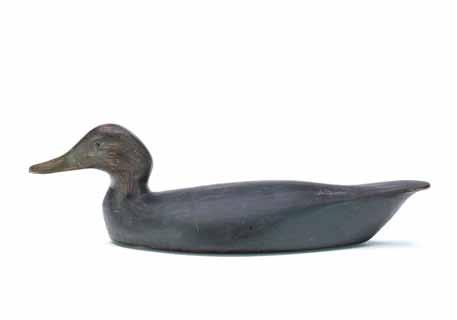
639 Unknown maker, Alexandria Bay, New York, circa 1940. Short body black duck with upswept tail. Measures 16” long. Original paint with minor wear; drying crack along back; wooden patch in one side from when the decoy was made; primitive tail chip repair.
Provenance: Bill and Alice Walsh Collection. Obtained from Parker Conner, Richmond, VA, 1975. (1,000 - 1,500)

Ackerly, Samuel 406
Anger, Ken ................................................................... 600-603,616
Bach, Ferdinand 320
Baker, Gordon 605
Barber, Joel 399,400
Barnard, Charles Nelson 167,171
Barnes, Sam 173
Beisenstein, John 272F
Bellamy, John .............................................................................. 80
Benson, Frank 573
Bergman, Charles 522,523
Birch, Charles 143,144
Blair, Sr., John 178,180
Booth, Herb 546
Bourg, Xavier .............................................................................. 346
Bowman, William ................................................ 46,47,401,402,407
Boyd, George 424,492-512
Brewer, Josh 196
Buchner, Frank 318A
Burgess, Ned 229
Burke, Dr. Edgar 556A,556B
Burr, Elisha ........................................................... 57,58,258-260,425
Bush, Walter 388
Cabot, Edward 166
Cargile, Lloyd 551
Carmadelle, Marc Alcide 347A
Chadwick, Keyes 266,271,440-443
Chambers, Thomas ...................................................... 296,297,305
Chesser, Grayson ................................................................ 207,208
Chipman Family 251
Chrysler, William 316,318
Claxton, George 109
Cobb, Elkanah 377
Cobb, Jr., Nathan 133,134
Cochran, David ......................................................................... 405
Coleman, Fred 624
Conklin, Roy 290,293-295,289,291,292
Coombs, Frank 288,627,635
Crandall, Horace “Hi” 513,525,526
Crane, Dude 386
Crawford, William Buck 310,311
Crockett, William ................................................................ 569,570
Croft, Fred 315
Crowell, A. Elmer 55,56,62-78,236-252,419,517-521
Crumb, Captain John 375
Cuffee, Chief Eugene 417
Daisey, Delbert “Cigar” 365-371
Dawson, John ................................................................................ 1
de Groot, Ewoud ....................................................................... 528
Demott, Daniel 413
Denny, Sam 284,287,626,633,637,638
Denzel 90,92
Dilley, John 43-45
Dolson, Roger 611
Doughty, Eli ................................................................................ 372
Ducharme, Duncan 612
Dudley, Lee 19,222
Dye, Ben 169
Edwards, Clyde 306
Eigenberger, Gary 467,472 Elder, Carroll MacTavish ..................................................... 596,598 English, Dan 41,180A
English, John 3-5
Finch, William 328
Finney, Frank 181-195
Fischer,
Loge, Daniel 554-556
Luedtke, John 20,524
Madara, Clark 379A
Mann, Gordon 433,449
Marter, Caleb Ridgway .................................................. 180D,180E
Martinez, Maria and Santana 123
Mason Decoy Factory, 6-8,329-343
McIntosh, Leo 484
McIntyre, Cameron 201,202
McLoughlin, John 180F,490,491
McLoughlin, Lawrence ........................................................... 180C
McNair, Mark ...................................................................... 197-200
Miller, Clarence 482
Moreland, Robert 489
Morris, Bob 228
Morris Boat Works 610
Nelson, R.J. 547
Nichol, David W. .......................................................... 317,606-609
Nichols, Fredrick Melville 42A
Nickerson, Fred 32
Nickerson, Luther 445
Nordfeldt, Bror 557
O’Neal, Callie 227
O’Neil, George 221
O’Neil, Ike .................................................................................. 223
Palumbo, Peter 474,481
Paquette, Joseph 314
Past Time Plug Tobacco 132G Perdew, Charles 25,617-620
Peterson, Oscar 132i,574-586
Phillips, Ike ........................................................................... 373,374
Powers, Chris .............................................................................. 622
Quinn, William 39,40
Sibley, George 26A
Smith, Benjamin 447
Smith, Ralph Crosby 559
Snow, Dexter 230
Soper, Samuel .............................................................................. 36 Southard, William 59 Stein and Goldstein, 91 Sterling, Lloyd 161 Sterling, Noah 163
Harvey 318C
Albert ................................................................................ 408 Truex, Levi Rhodes ..................................................................... 385 Tully, Bud 307-309 Tyler, Lloyd 160,162,164 Van Gilder, Ron 529-535 Verity, John Henry 49 Verity, Obediah 48,60,415 Verity, Smith Clinton .................................................................. 403 Verity, Stephen 409 Vidocovich, Earnst 347 Vizier, Jimmie 480 Voorhees, Clark 592,593 Ward, Lem 538,539 Ward Brothers, 9-518,148-159A,165,360-364 Warin, George ............................................................. 298,300,303 Watts, Valentine 416 Weaver, Steve 456-462 Wells, John R. 300A,301 Wheeler, Charles E. Shang 396,397 Wheeler, Chauncey 21,22,273-281,283,285,625,631,632,634,640 Whipple, Mark ............................................................................ 344 White, Bob ........................................................................... 485-488 Whittington, Hector “Heck” 623
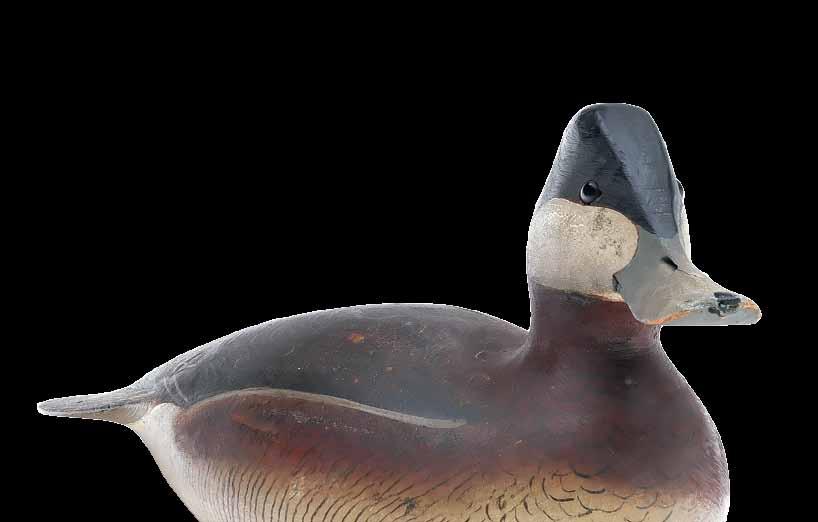
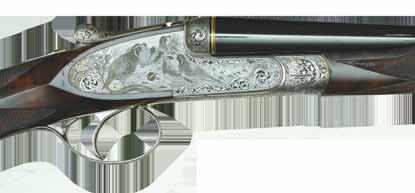
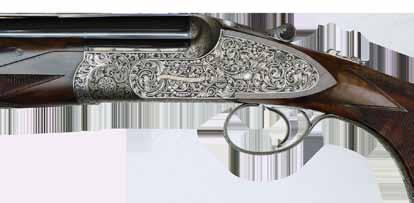
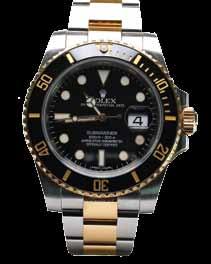
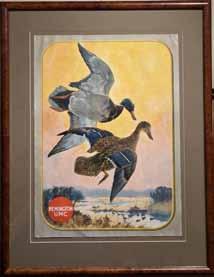
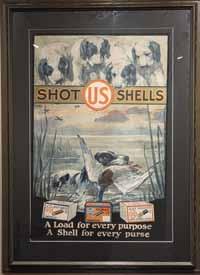
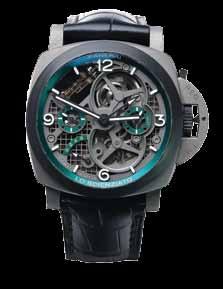


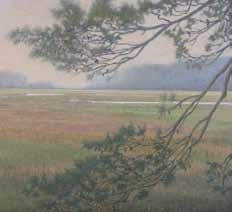
A single artist show by Cameron McIntyre
December 6, 2025 at the
Guyette & Deeter gallery
St. Michaels, Maryland


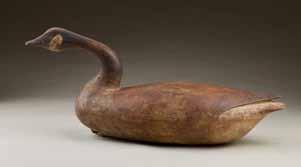
Exhibit will run from November 20 through December 6.
Item will be listed at bid.guyetteanddeeter.com on November 21, with live bidding starting on November 28 and closing on December 6 starting at 6:00pm est.
Please join us for this event at our gallery on December 6 at 5:00pm.
We ask that you RSVP if you plan to attend.
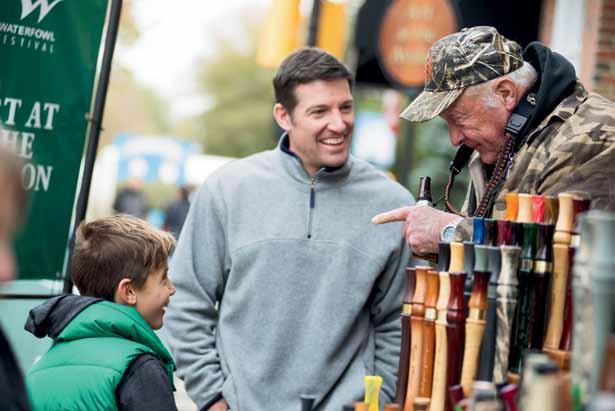










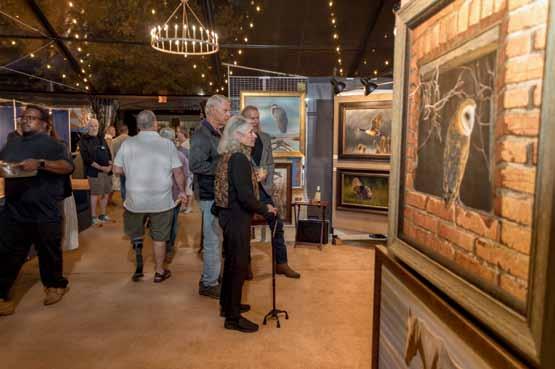
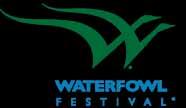

For over fifty years, our VIP guests have supported our conservation mission. At nearly six million dollars and counting, we aren’t stopping yet! Join us at the party!



Join us for the spectacular NOV. 13, 2025 NOV. 13, 2025

Join us for an exclusive evening of music, celebration, incredible art displays, and artist reception parties in each venue!
4:00 Veterans’ Salute
Tidewater Inn Entrance
4:30 Opening Ceremonies
Champagne Reception Tidewater Inn Crystal Room
Meet 2025 Featured Artist: Al Barker
Meet Federal Duck Stamp Artist: James Hautman Hall of Fame Inductions
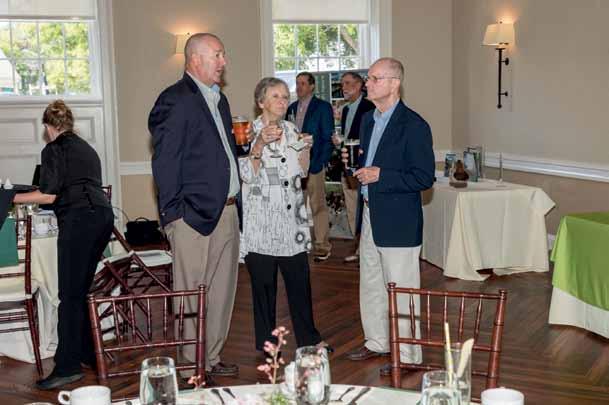
5:30-8:30 All Galleries Open
2025 Venues: Academy Art Museum, Christ Church, PNC Pavilion, Art at the Armory, Working Artist Forum, Framptom Gallery, Avalon Theatre







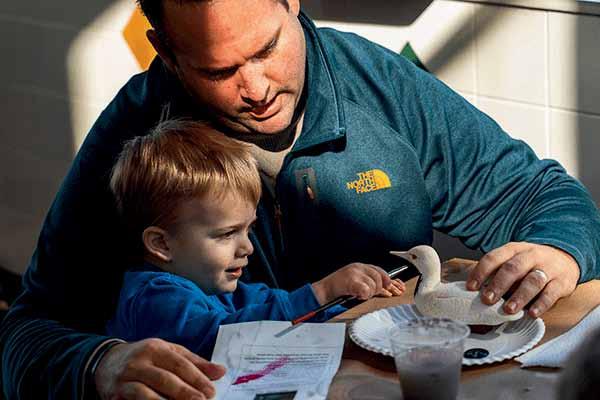

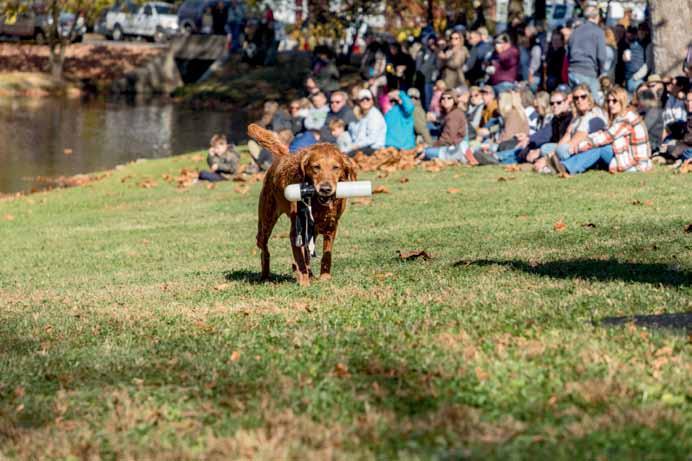









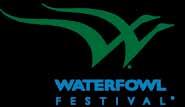
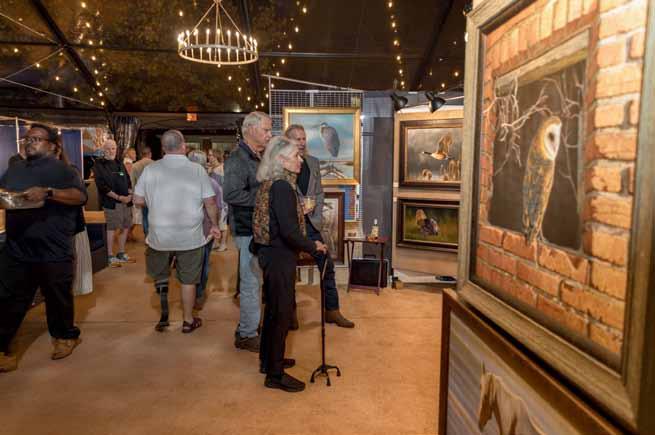
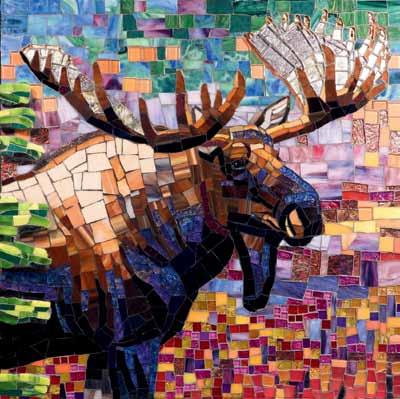







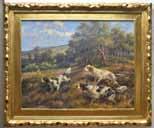
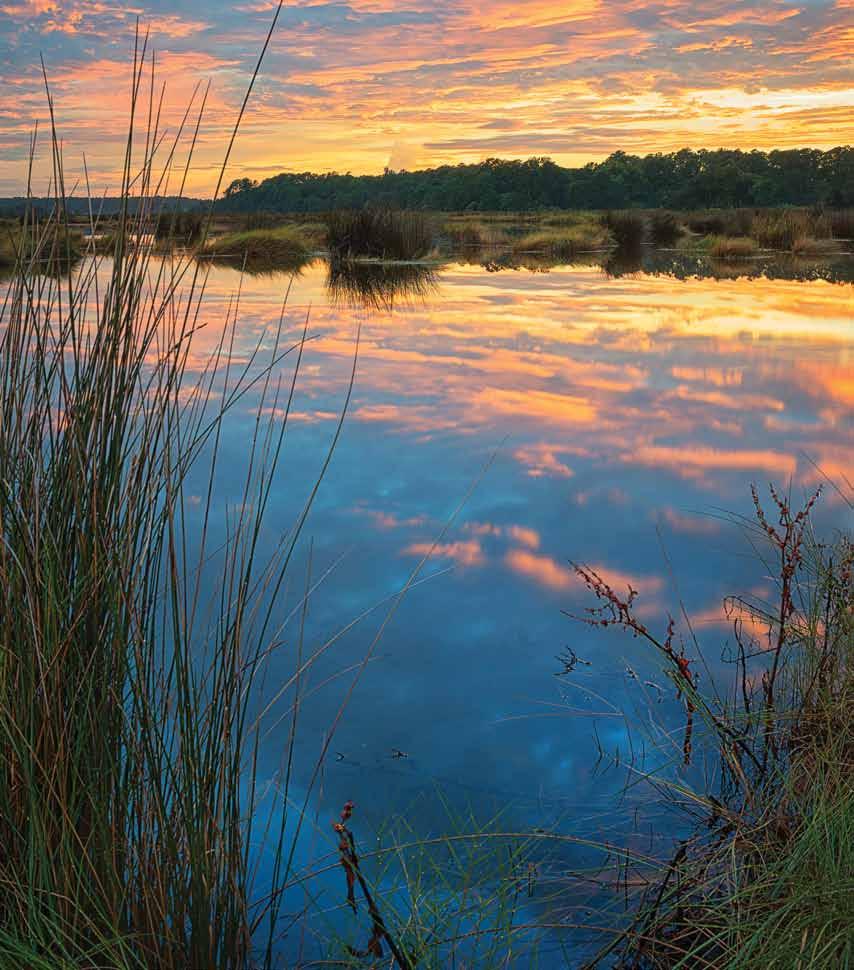



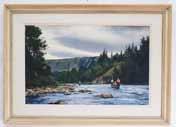
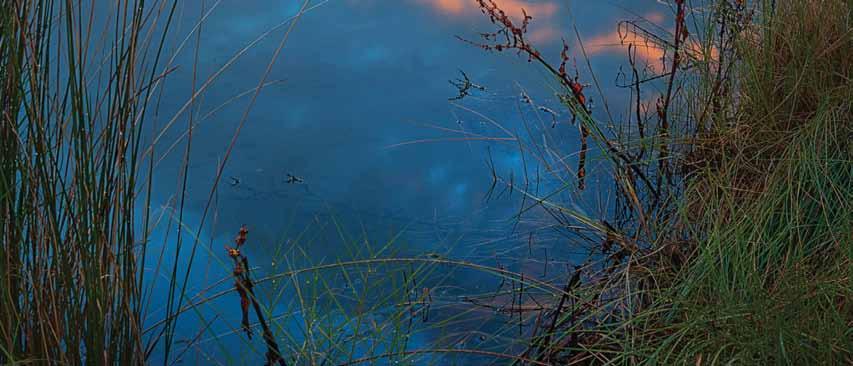
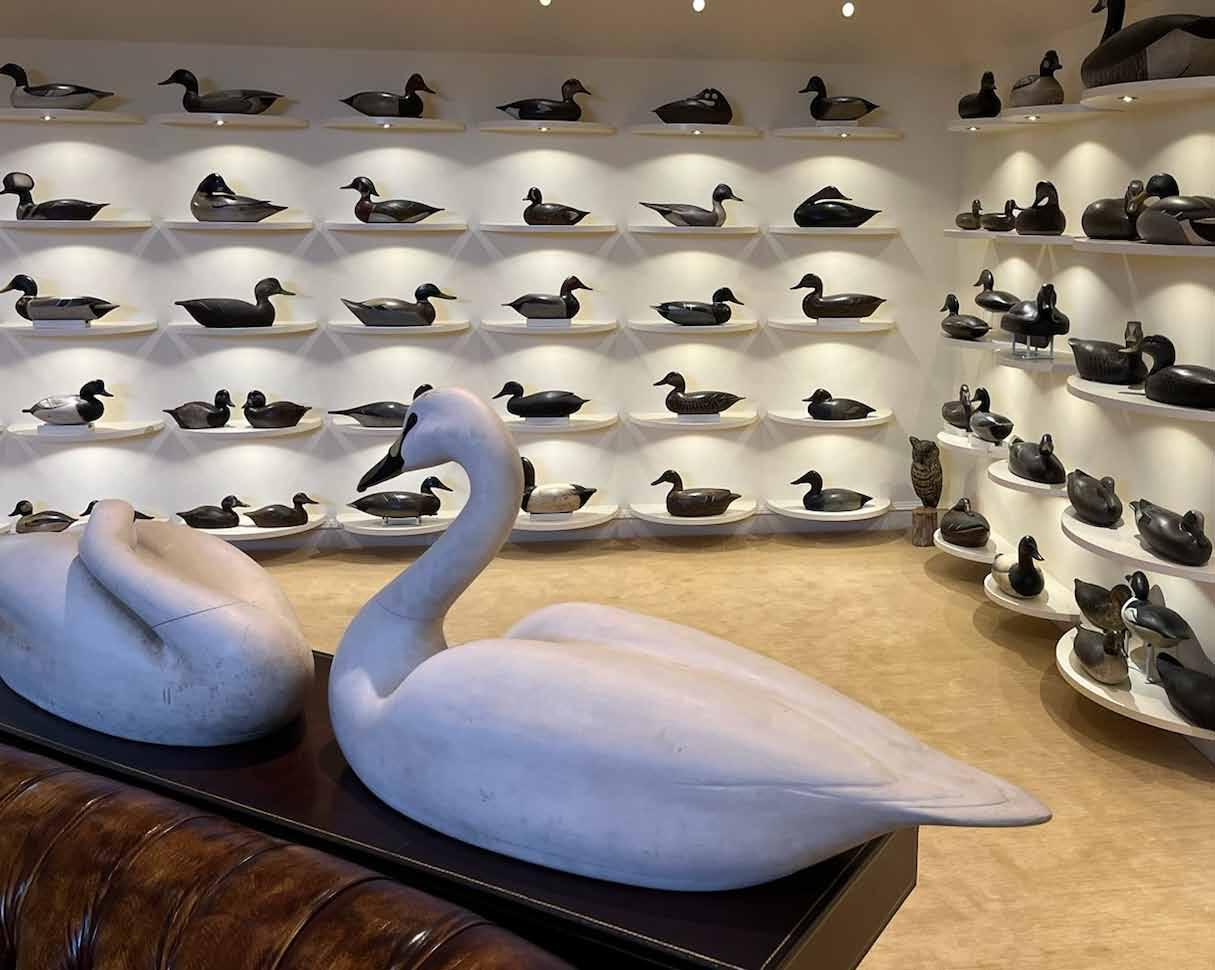
While you continue to enjoy collecting today, you can rely on Guyette & Deeter to collaborate with you on your estate planning and collection management needs. Whether it’s for tax purposes, estate planning, gifting, charitable giving, or insurance, we can develop and periodically update a comprehensive written appraisal of your collection. We have extensive experience working closely with banks, attorneys, trustees, estate officers, probate court, private clients and family members responsible for the dispersal of collections as part of larger estat es.
O ur unmatched market understanding allows us to more accurately document the value and description of each item in your collection. We know that working together to ensure that your wishes are established now will make it easier to administer your estate lat er.
Co ntact Jon or Zac to discuss our Legacy Planning Program today.
Jon Deeter | 440-610-1768
jdeeter@guyetteanddeeter.com
Zac Cote | 207-321-8091
zcote@guyetteanddeeter.com
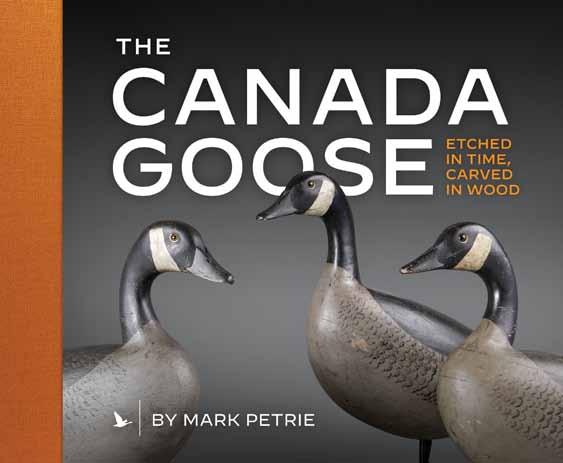
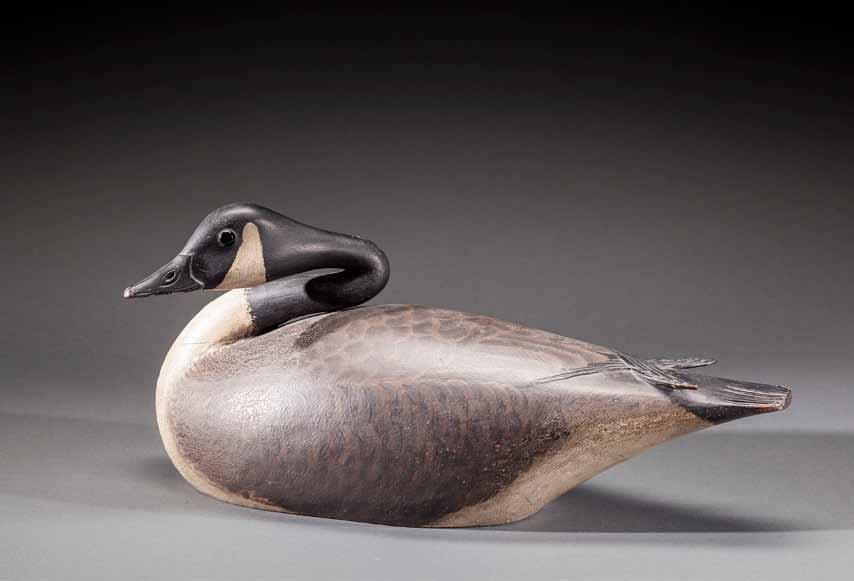
BOOK TO BE LAUNCHED FOR PUBLIC SALE AND EXHIBIT TO OPEN ON AUGUST 1, 2025 - FEATURINGDecoys from the Peterson Collection
293 large full color pages




• Black anodized aluminum construction.
• Rubber padded tops & bottoms. Will not mar your furniture or decoys.
• 3 post and 4 post styles to choose from.
• 1 in to 4 in heights in 1/4 in increments
$30 each plus shipping and handling
To order call Ken Cole at: (810) 845-2434 E-mail: kencole3@aol.com

1. GUARANTEE ‑ We have made a concerted effort to accurately catalog and describe the property to be sold. The decoys have guaranteed condition reports. Should the need arise, the auctioneer reserves the right to make verbal corrections and provide additional information from the podium at the time of the sale. Since opinions can differ, particularly in the matter of condition, the auctioneer will be sole judge in the matter of refunds. If we fail to identify a flaw that has a significant impact on the value, you can return the decoy.
2. DURATION OF GUARANTEE ‑ Requests for a refund on an item purchased through a Guyette and Deeter, Inc. auction must be made within 3 days of the time you take physical possession of your purchases. Whether your items are shipped, delivered, or picked up at the auction site, it is still 3 days from date of possession. This guarantee is null and void if payment is received or mail is postmarked more than 14 days from the sale end date. The guarantee is also null and void if you choose to not take possession of your purchases within the 30 days. If you have paid for your purchases within the 30 days but Guyette and Deeter, Inc is unable to ship your item within the guarantee period, the guarantee will be extended until 3 days from the shipping delivery date.
3. PROTESTED BIDS ‑ In the case of a disputed bid, the auctioneer is the sole determinant as to who the success ful bidder is, and at his discretion, may reoffer and resell the article in dispute. If a dispute arises after the sale, the auctioneer’s sales records shall be conclusive as to who the purchaser was, and the purchase price.
4. BIDDING BIDDING Bidding usually starts below the low estimate and advances in increments of approxi mately 10% of the opening bid subject to the auctioneer’s discretion. The auctioneer reserves the right, at his sole discretion, to refuse any bids that he deems unreasonable. The minimum bid increment guideline is as fol lows:
$500 to $1000 $25 $10,000 to $20,000 $500 $100,000 and above $2,000
$1000 to $10,000 $100 $20,000 to $100,000 $1,000
5. ABSENTEE BIDS ‑ Phone or mail bids, at the discretion of the Auctioneer, will be accepted with a 20% deposit. In such case, the auctioneer will execute such bids competitively. Absentee bids are executed by the auctioneer on behalf of the bidder in accordance with the bid increment policy shown above.
6. TERMS ‑ All items are to be paid for in U.S. funds. No items will be released until they are paid for. The Auctioneer reserves the right to hold merchandise paid for by personal check, until the check has cleared the bank. PAYMENT IS DUE UPON RECEIPT. A late charge will be accessed on all balances not paid, at the rate of 12% A.P.R. commencing 30 days after the auction. Merchandise not paid in full withing 30 days will be con sidered unsold.
7. PAYMENT FOR PURCHASES CAN BE MADE WITH CREDIT CARD (VISA, MasterCard, American Express, or Discover), CASH, CHECK, OR WIRE TRANSFER.
8. BUYERS PREMIUM The buyer’s premium, assessed on each selling lot, is 20% of the hammer price up to and including $1,000,000. For payments made using a credit card, the buyer’s premium is 23% up to and including $1,000,000.
9. TAX ‑ THERE IS AN 6% SALES TAX IN MARYLAND. TAX IS WAIVED IF BUYER PRESENTS A VALID RESALE CERTIFICATE FROM ANY STATE OR HAS PURCHASES SHIPPED OUTSIDE OF MARYLAND.
10. ACCEPTANCE OF CONDITIONS ‑ Bidding on any articles in this sale indicates your acceptance of all of the conditions of sale.
11. BIDDING AGENT RESPONSIBILITY ‑ If you are registering for someone or if you execute a bid for someone else under your number, you are responsible for the settlement of that account. You are also responsible for examining the items for your client regarding the guarantee.
12. WITHDRAWAL ‑ We reserve the right to withdraw any property before the sale and shall have no liability whatsoever for such withdrawal.
13. TITLE ‑ Title passes upon the fall of the auctioneer’s hammer. It will then be the responsibility of the buyer to make full payment, according to terms and conditions, prior to removing the goods from the premises. Removal is at the buyer’s risk and expense and must be made at the conclusion of the sale, unless other arrangements are made with the Guyette & Deeter.
14. LEGAL DISPUTE ‑ Any legal disputes arising from this auction shall be settled in the court system of the State of Maryland. UNIFORM COMMERCIAL CODE ‑ The Maine Uniform Commercial Code, Title II, Section 2328 applies to this auction.
15. Stands are not included with the decoys or weathervanes unless specified in catalog. Cases are not included with shotgun shell boxes. All dimensions are approximate and are not guaranteed. All calls are sold “As Is”.
16. Under no circumstances will we be responsible for damage to frames or glass, or damage caused by them. Paintings determined to be of high value or large size may be subject to special packaging or special delivery at the buyer’s expense. Under no circumstances will we be responsible for damage to fragile decorative carvings. These items are marked in the catalog with an *. THE OFFICE WILL NOT
1. Absentee bids are a service provided to our customers free of charge. Every effort is made to execute all absentee bids, however, in the event of an error or omission, or failure to properly execute absentee bids, the Auctioneer shall not be held liable.
2. All absentee bids must be accompanied by a 20% deposit, which will be refunded immediately after the auction if your bid is unsuccessful. If your bid is successful, the deposit will be applied to the purchase price and the balance due upon presentation of your bill. All absentee bidders are notified by mail, whether successful or unsuccessful.
3. Visa and Mastercard numbers can be given in place of a check deposit, if your bid is submitted by phone. Your card number will not be used to make payments for purchases, it is only used as collateral. Your card number will only be used to make payment for purchases if you default on payment.
4. To execute an absentee bid, fill out the enclosed form listing catalog number, description, and your top bid price (not including the 20% buyer’s premium). Send this together with your deposit as soon as possible. If your bids are sent seven days or less prior to the auction, you should call our office three days prior to the auction, to confirm that we have received your bids. If they have not been received at that point in time, we will take your bid over the phone. We cannot guarantee that bids received after the auction has started will be executed.
5. If two or more bids are received on the same item from different people, the bidding will open at the next logical raise above the second highest bid. If two absentee bids are received with the exact same amount, the first one received will take precedence.
6. All bids must be in even dollar amounts. Bids in fractions of dollars will be considered the next lower even dollar amount.
7. Bid increments: The bid increment policy, which also applies to both absentee and phone bidders, is listed under “CONDITIONS OF SALE” (item #4), in the front of the catalog.
8. Open bids, bids with no set top amount, or orders to just simply buy the lot, cannot be accepted. You must have a definite top limit before we can execute your bid. Alternatives to this are as follows:
a. To bid over the telephone. This can be done by simply sending a 20% deposit for what you wish to bid on the object. This will bind whatever bid amount you wish to bid over the telephone. (NOTE: There are only 8 phone lines into the auction room and phone bids will be handled on a first come, first serve basis.)
b. Some bidders concerned that a lot might just go for one bid above their top limit, leave a top bid plus one bid. This works as follows: the top bid submitted might be $1,000, but not wishing to lose the lot for simply $25 more, the party might bid $1,000 + 1 bid if they definitely don’t want to go over a certain price, they would indicate $1,000 +1 ($1,025) (NOTE: One possible problem that occasionally arises with absentee bids is when someone in the audience bids exactly the amount, which you specify is your limit. In such a case, we would not go one extra bid unless your bid sheet indicates “plus one” bid.).
9. If you are a successful bidder, a bill will be sent a few days after the auction. Purchasers should indicate their desired method of shipment, if such is necessary. There is a charge for shipping, labor, materials, and insurance. Please provide notice in writing if items are covered under your own insurance policy. Shipping is done on a first come, first serve basis, and can take up to 4 weeks. Please note that a certified check, Visa, Mastercard, or any other form of guaranteed funds will expedite shipping.
10. For expensive oil paintings and delicate carvings, we need a written statement from the purchaser, assuming the responsibility of pursuing any claims, in the event of damage incurred during shipping. Valuable lots need to be sent 2nd day air UPS due to values. Under no circumstances will we be liable for damage to glass or frames, or fragile decoratives, regardless of cause.
11. TERMS Phone and absentee bidders You will be notified one week after the auction of your results. Payment is due upon receipt. Interest will be charged on all balances not paid within 30 days after the bill is sent at the rate of 12% APR. If any accounts become more than 60 days overdue, the consignor will be given the name of the buyer who is responsible for holding up their funds. If an account is 75 days overdue, the items may be returned to the consignor and overdue buyer will pay the buyers premium and commission from the sale, if they wish to participate in future Guyette and Deeter auctions.
12. Bidding on any article(s) indicates your acceptance of these terms above.
13. If you would like any additional information on any of the lots, please contact: Jon Deeter at (440) 610-1768, or Zac Cote at (207) 321-8091. If you have any questions concerning absentee bids, please call us.
Zac Bookkeeper Computer Bid Builder
ADDRESS
DEPOSIT $
I Desire to bid on the following items in the sale. The bids are to be executed by Guyette & Deeter, up to but not exceeding the amount(s) specified on the below bids. All bids will be executed and accepted subject to the Terms of Sale and Absentee Bids Procedure outlined in the catalog. (Please be sure that you understand our procedures before using this Absentee and Phone Bid Form.) The office will not be open until Wednesday after the auction.
A premium of 20% will be applied to all items sold, to be paid by the buyer
